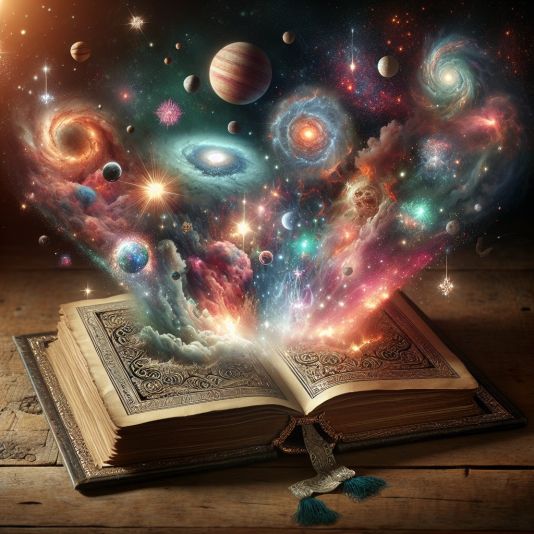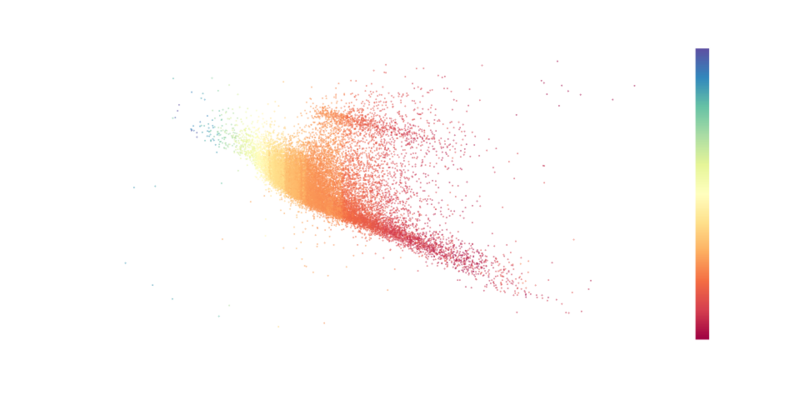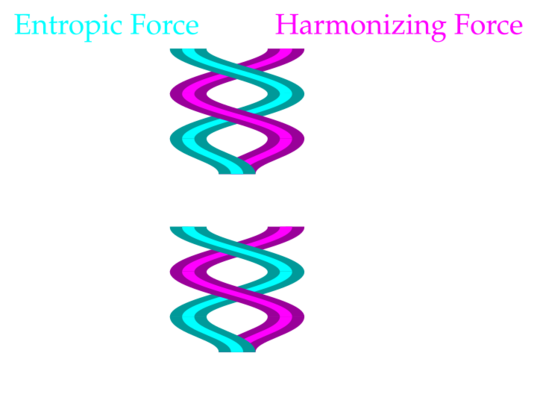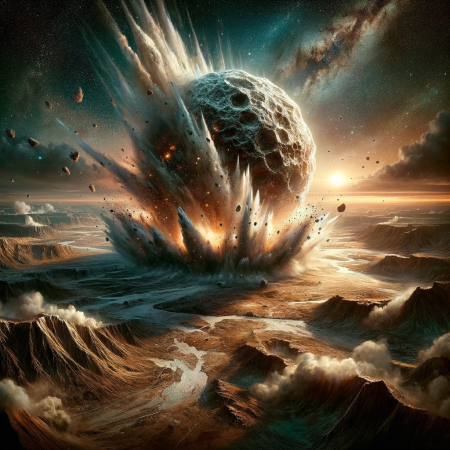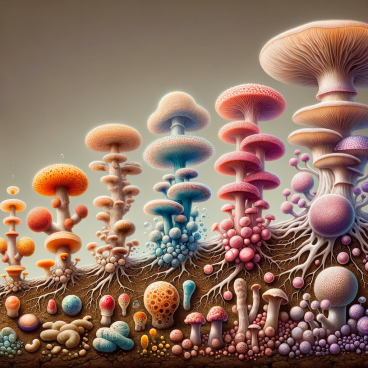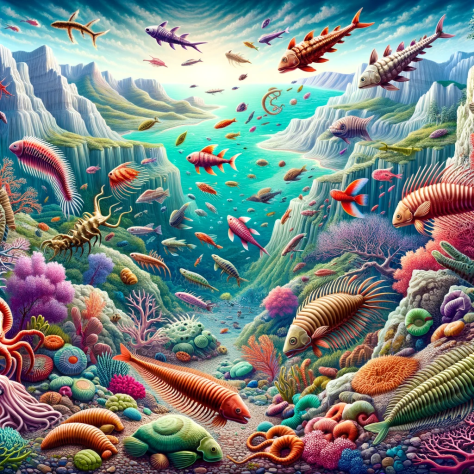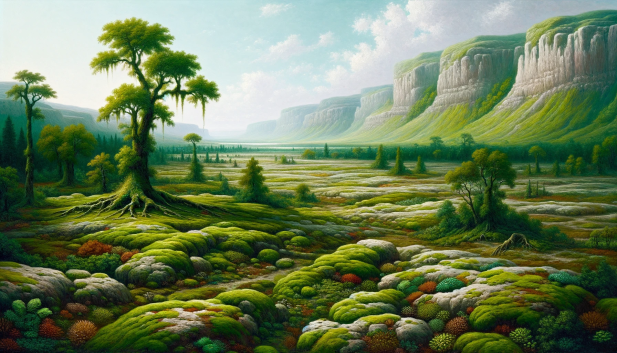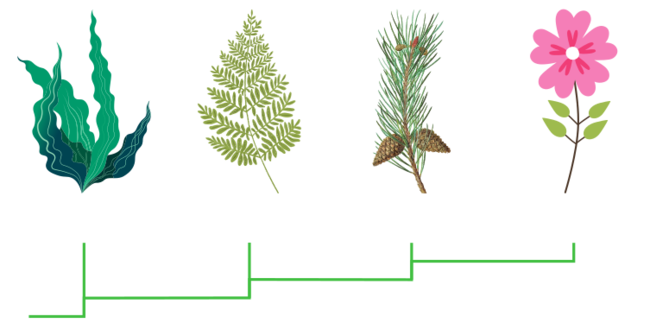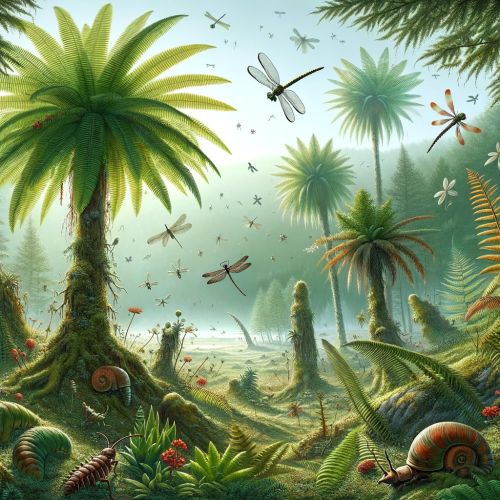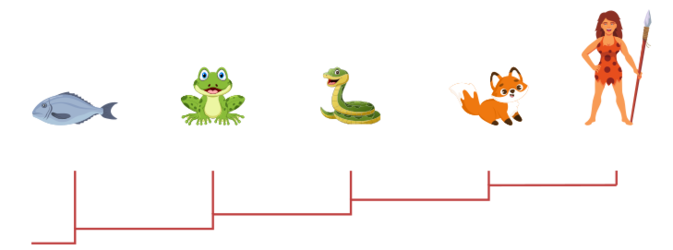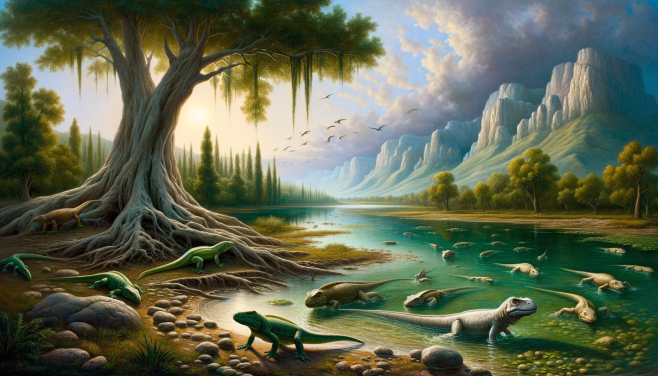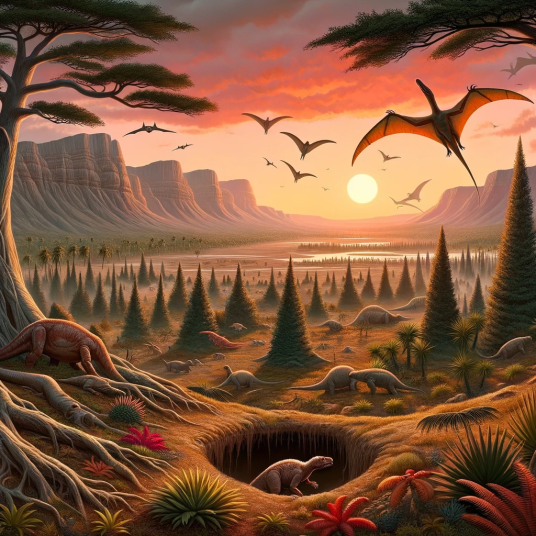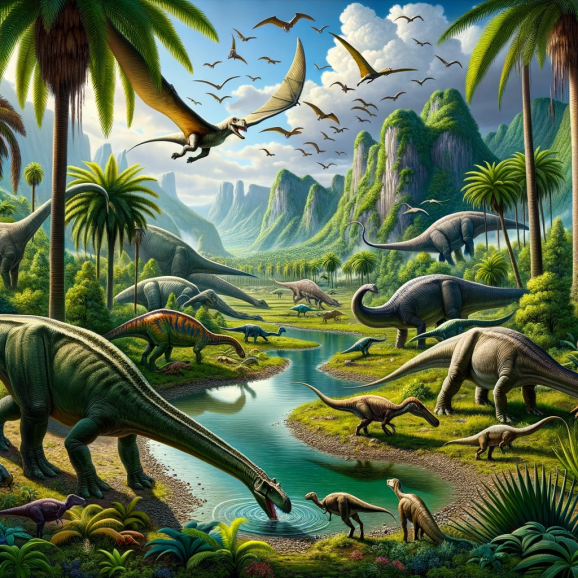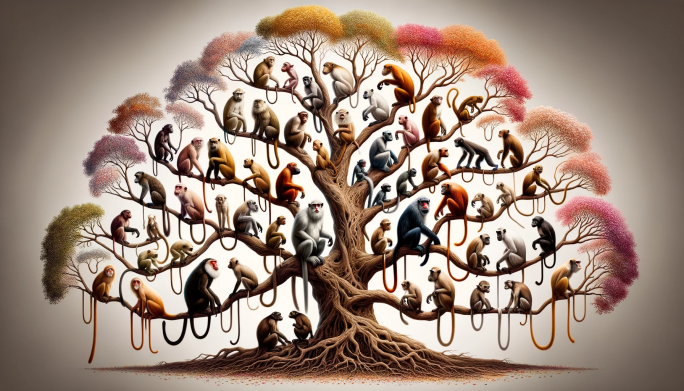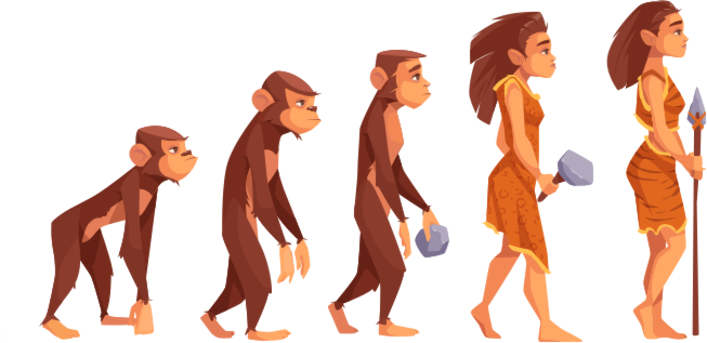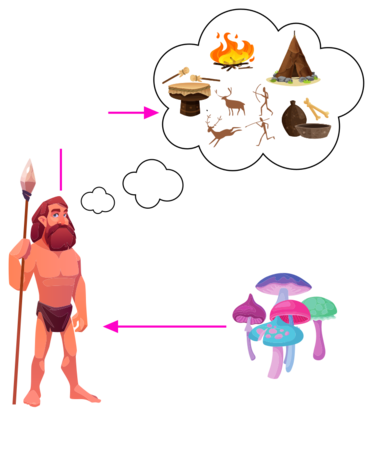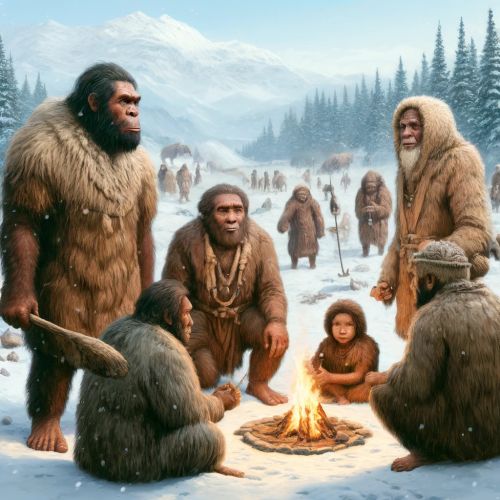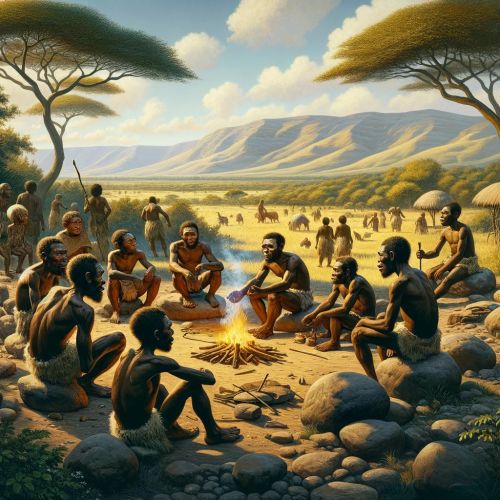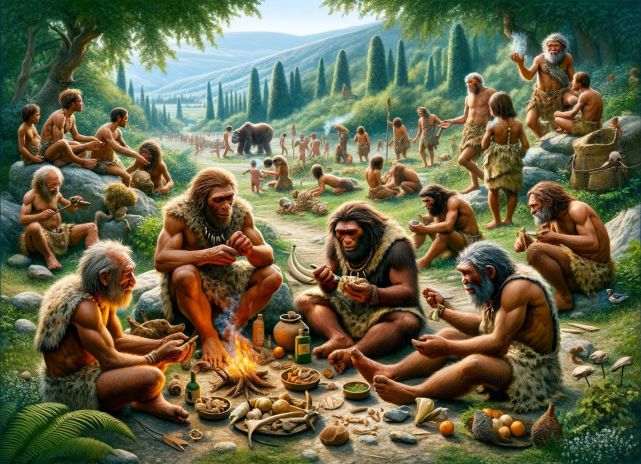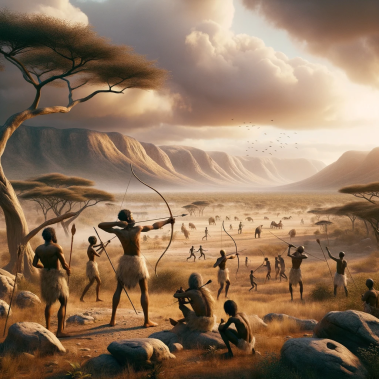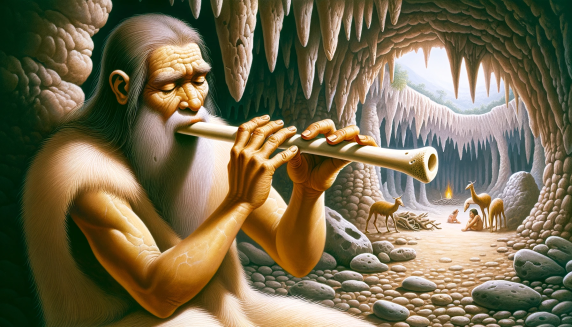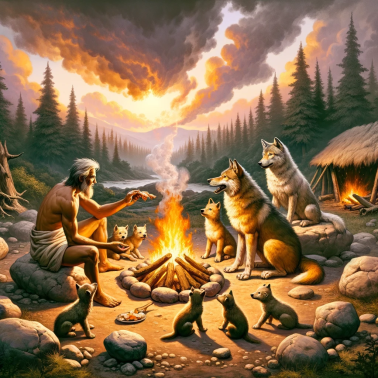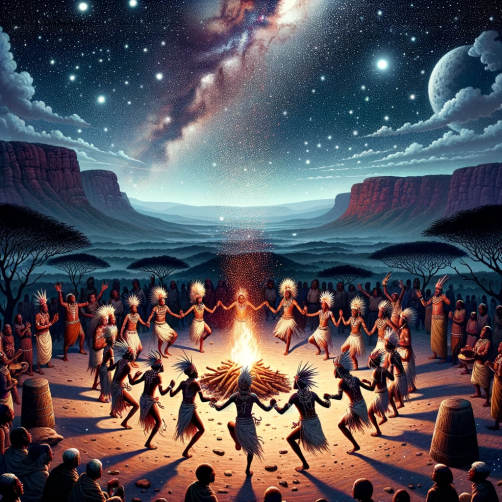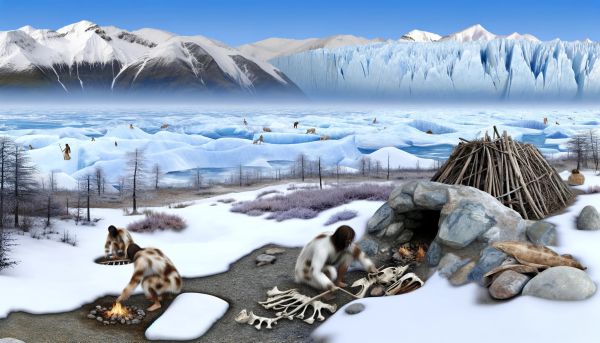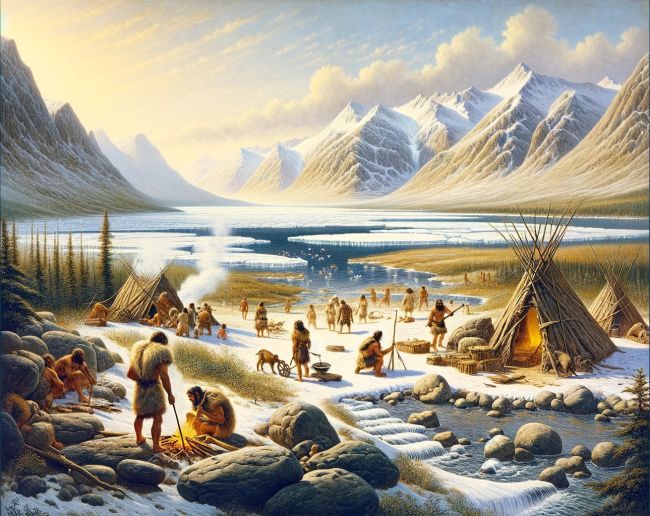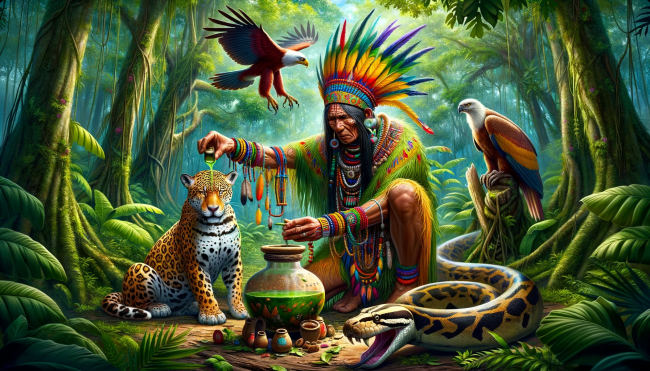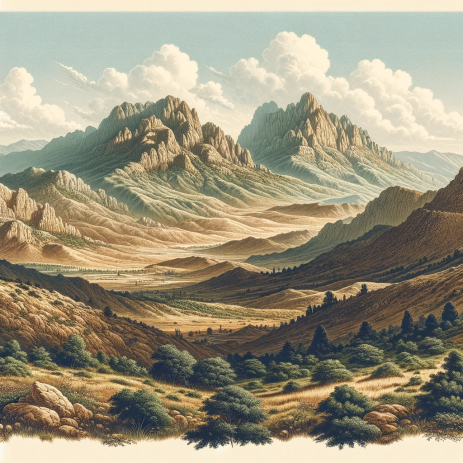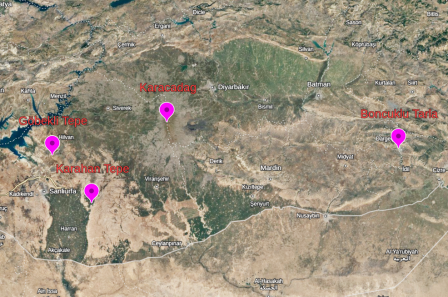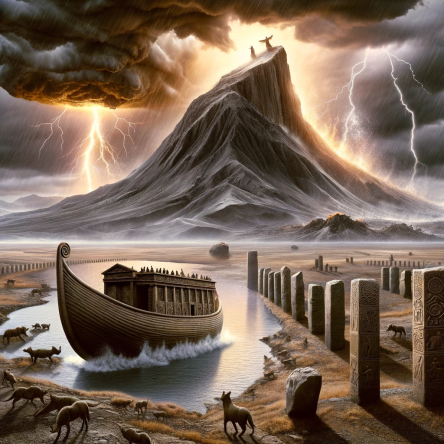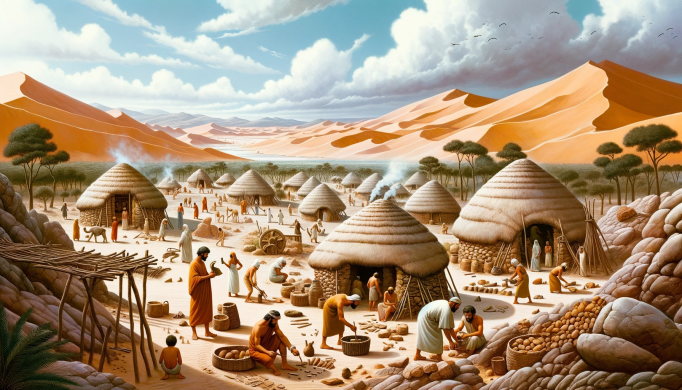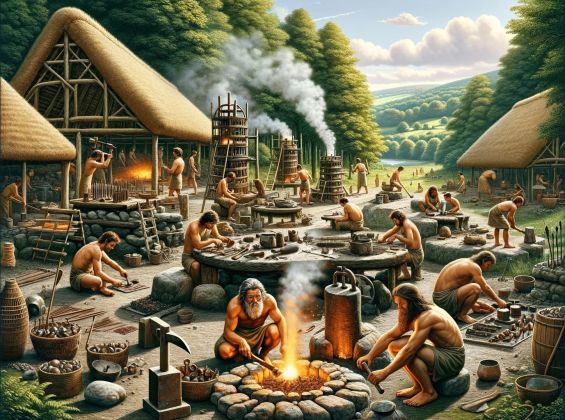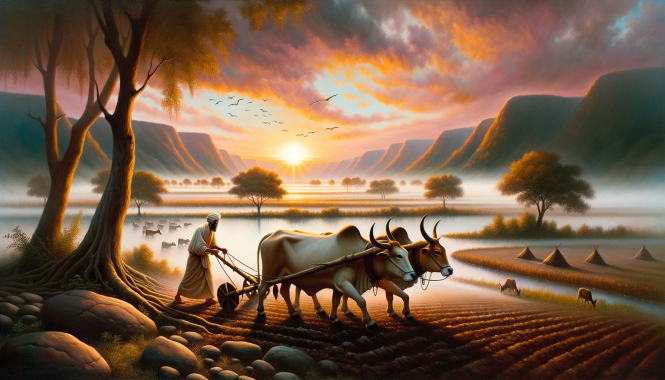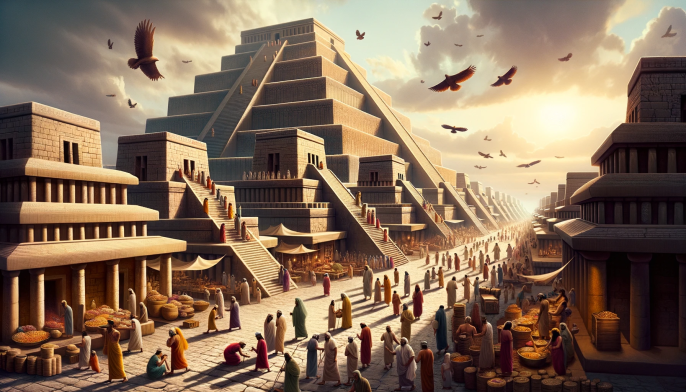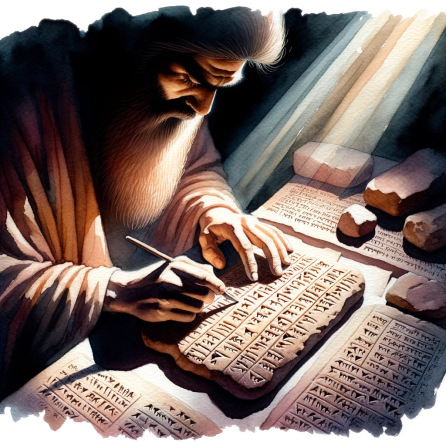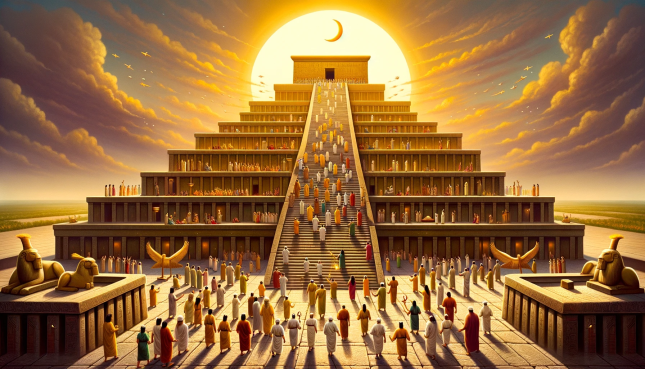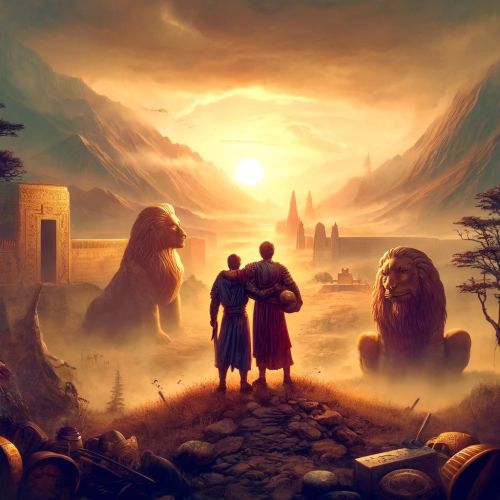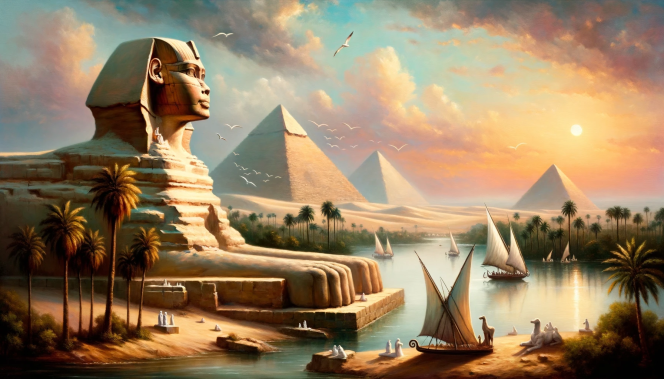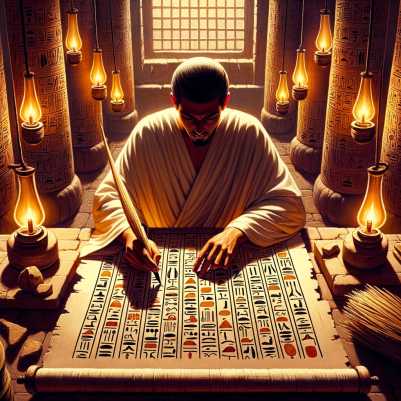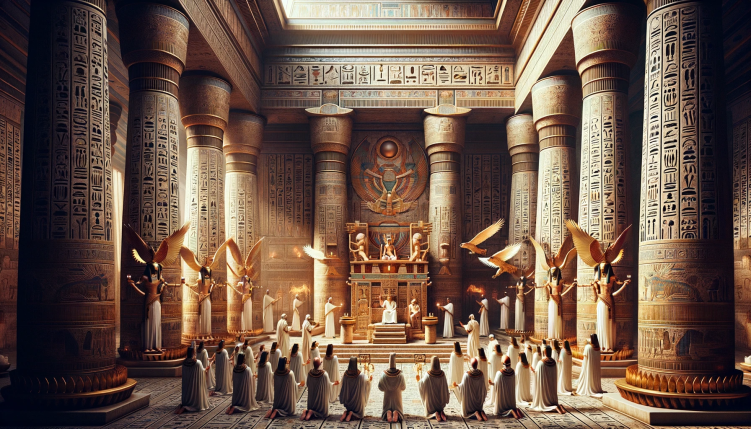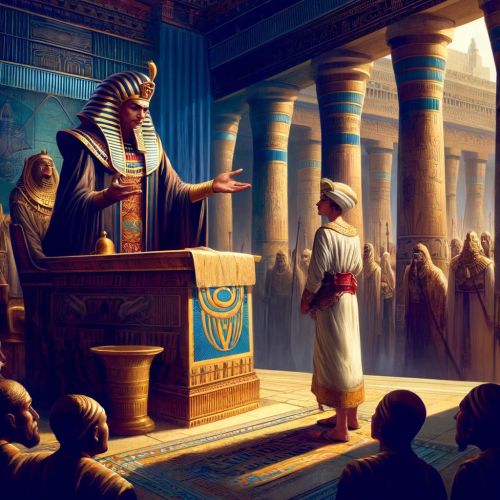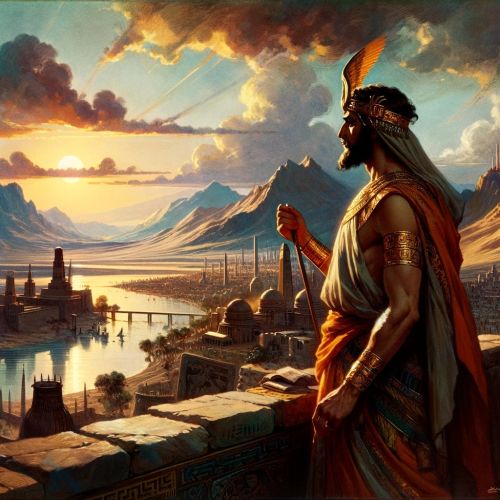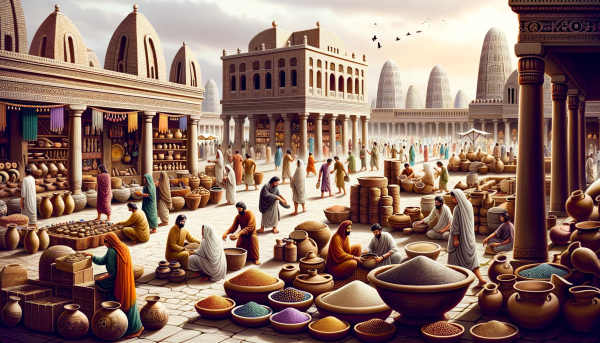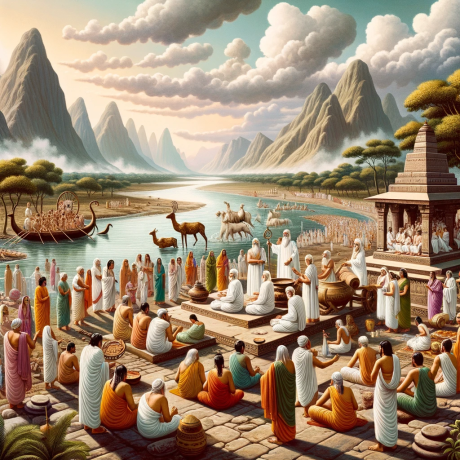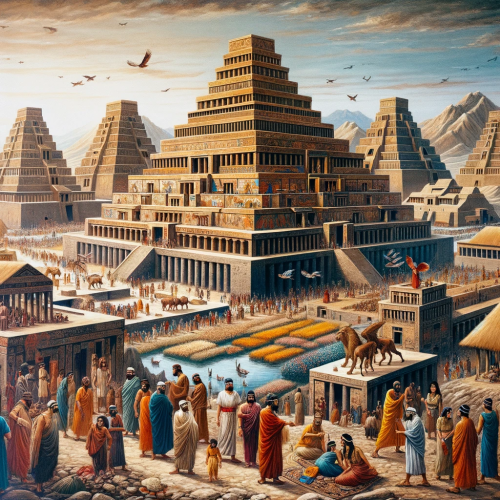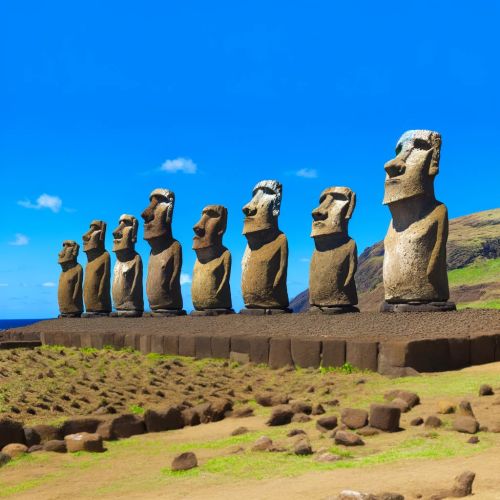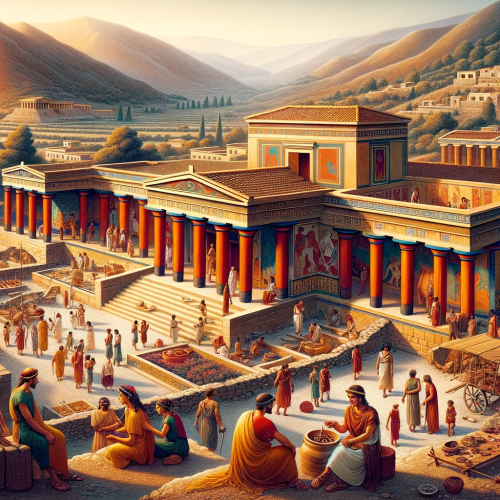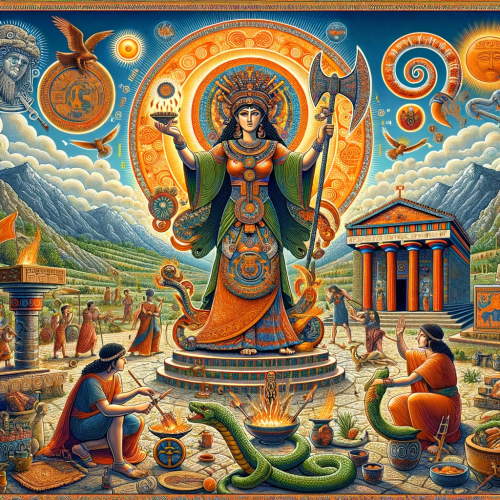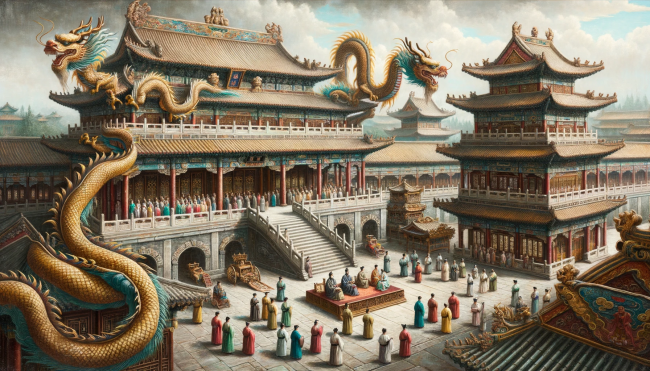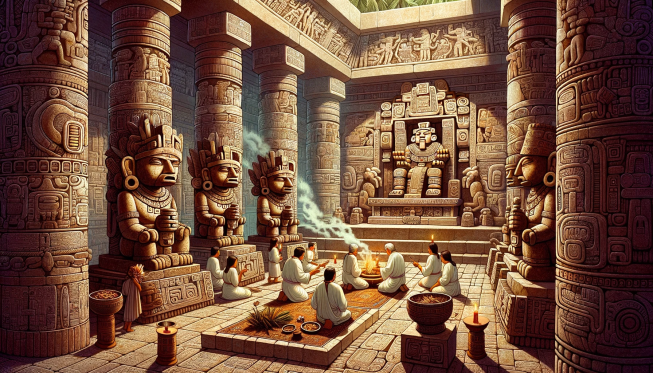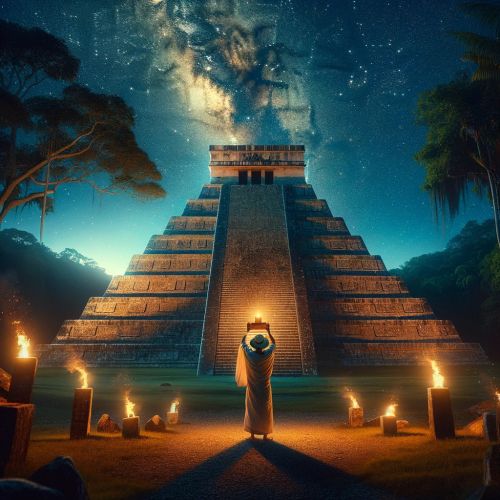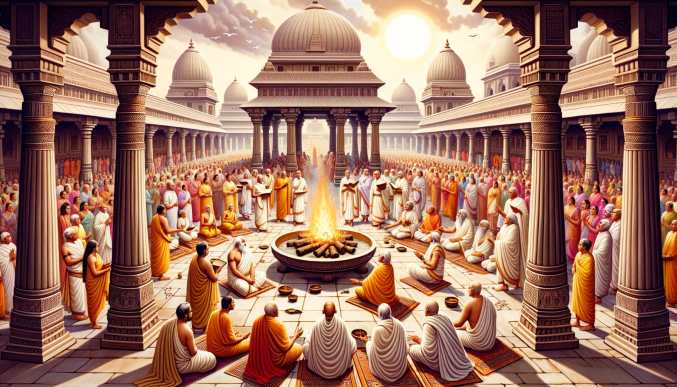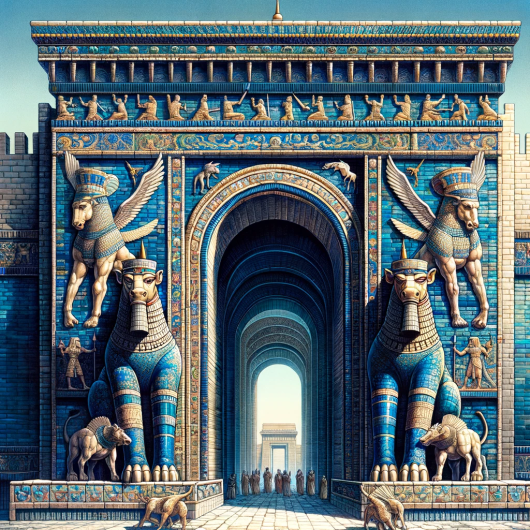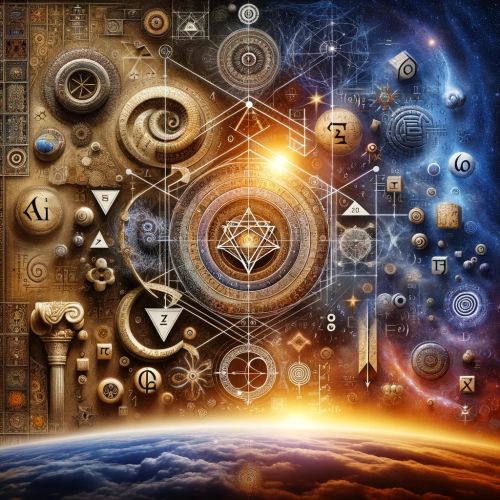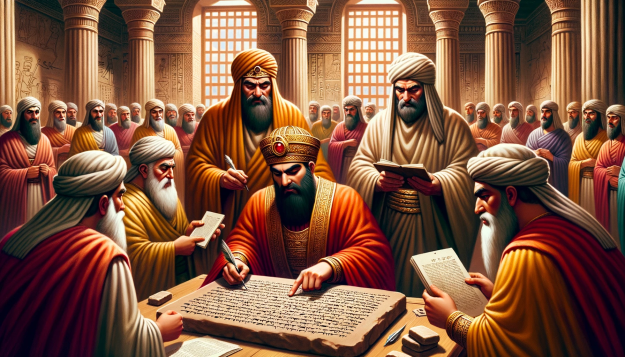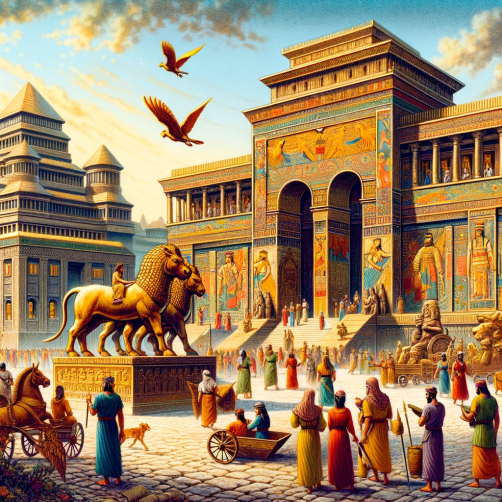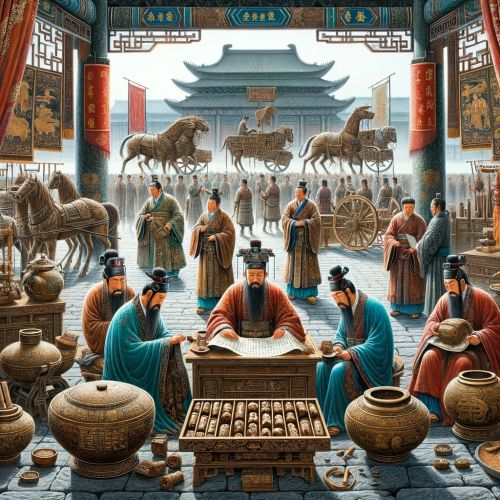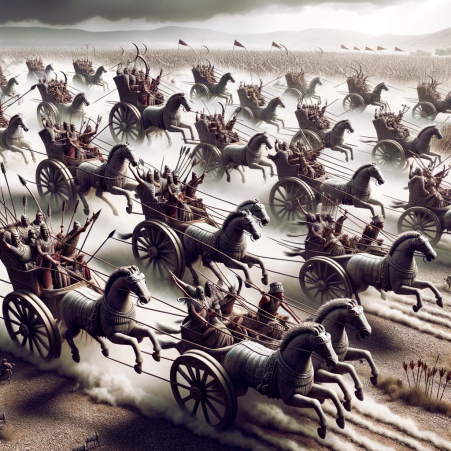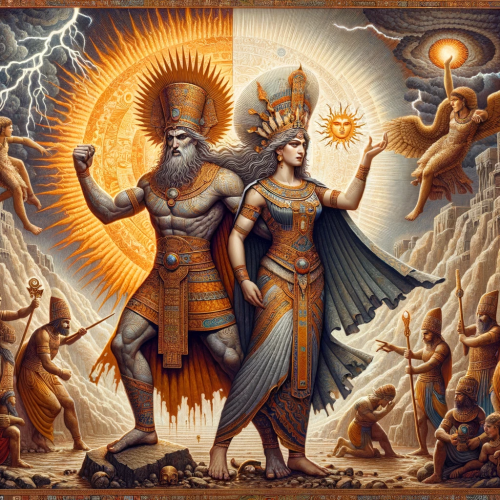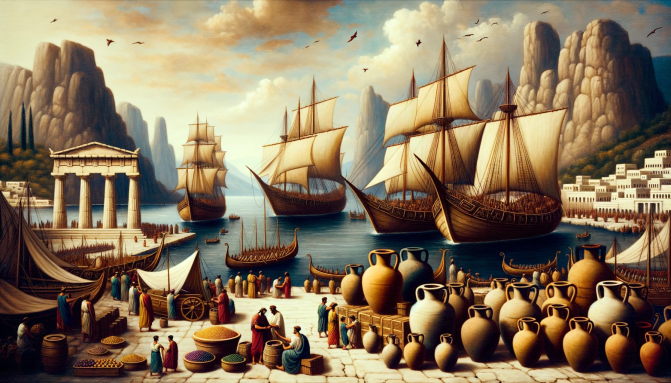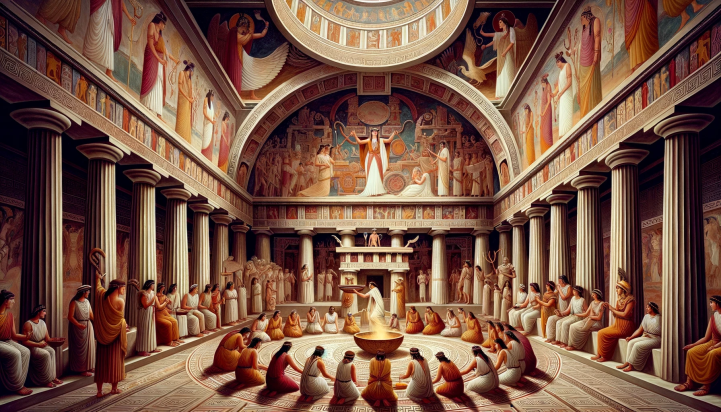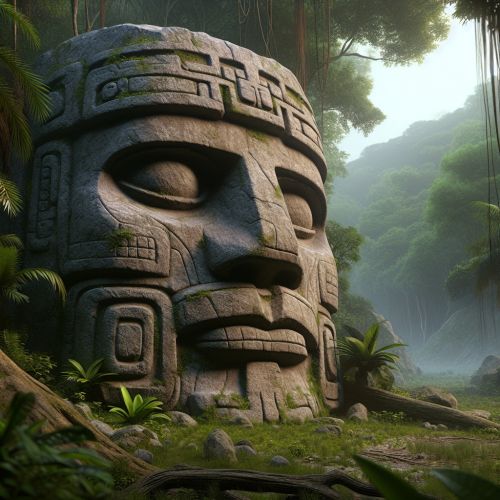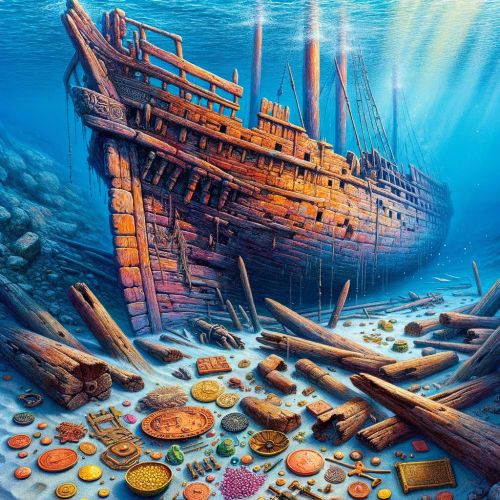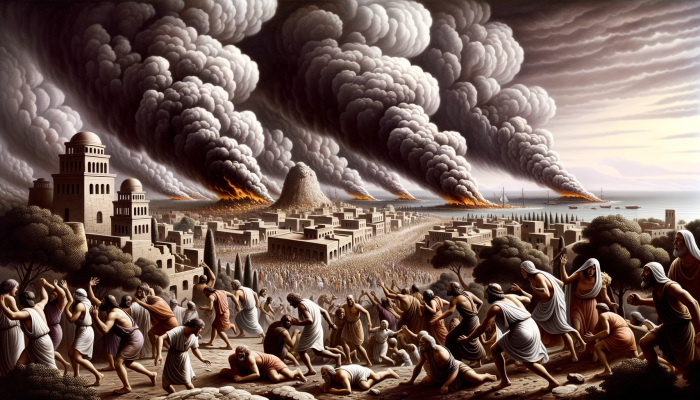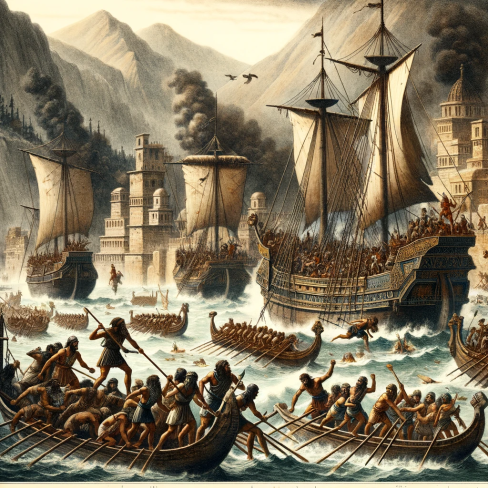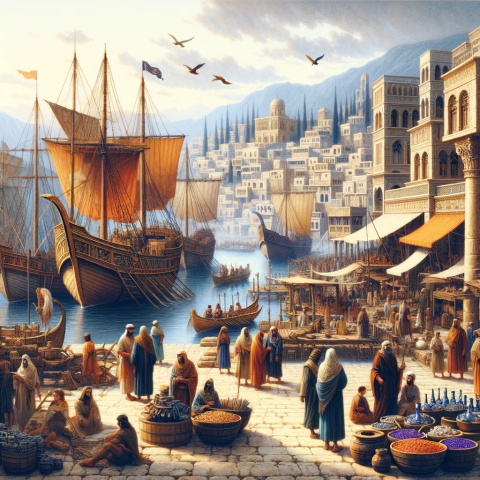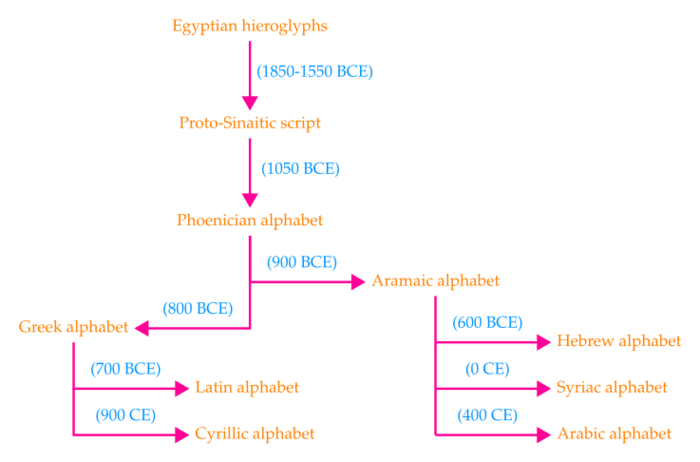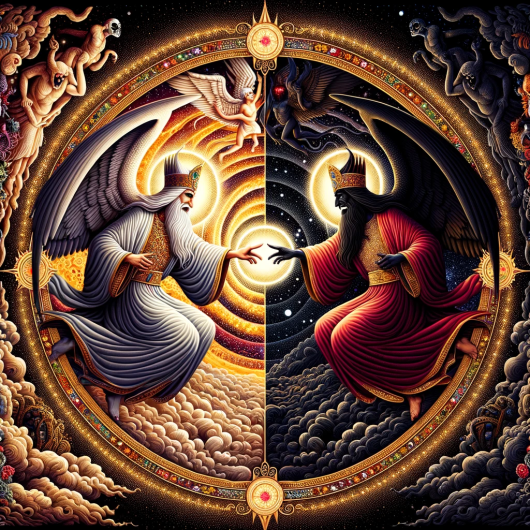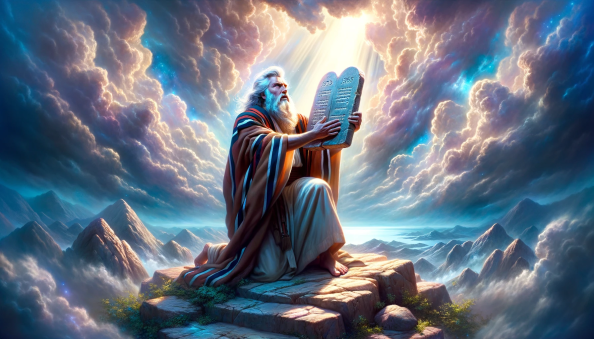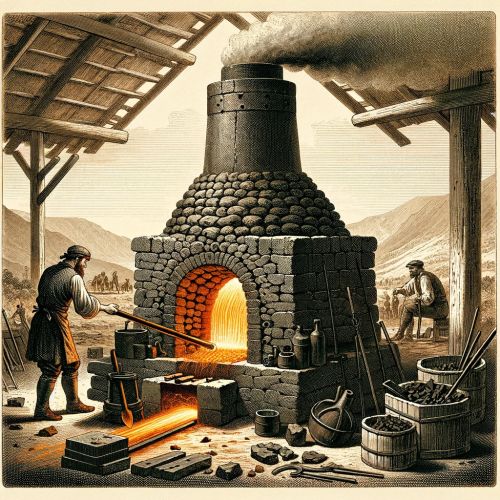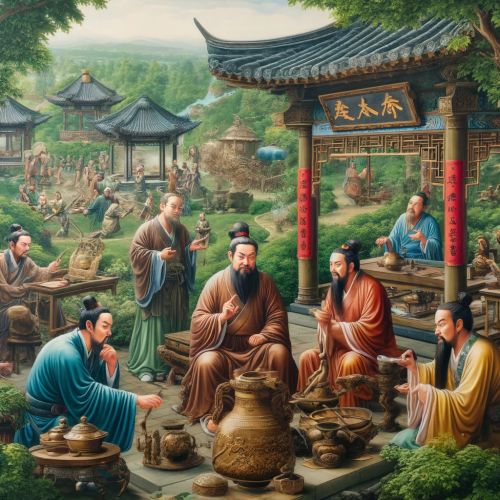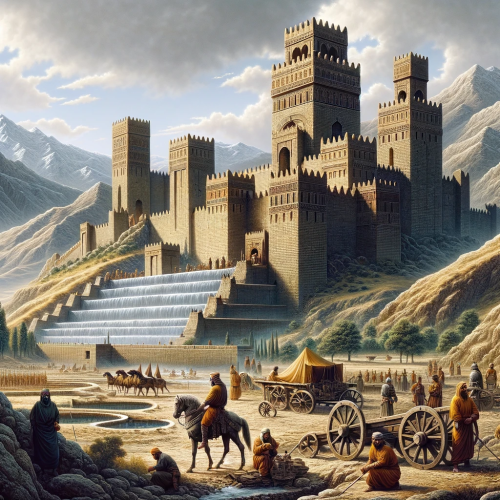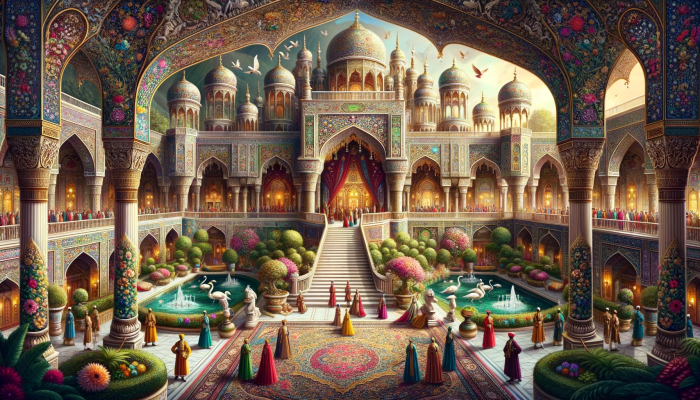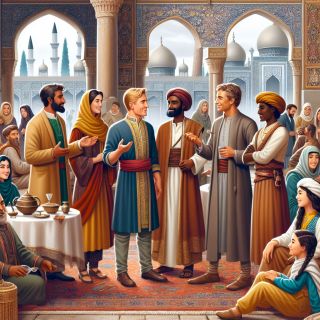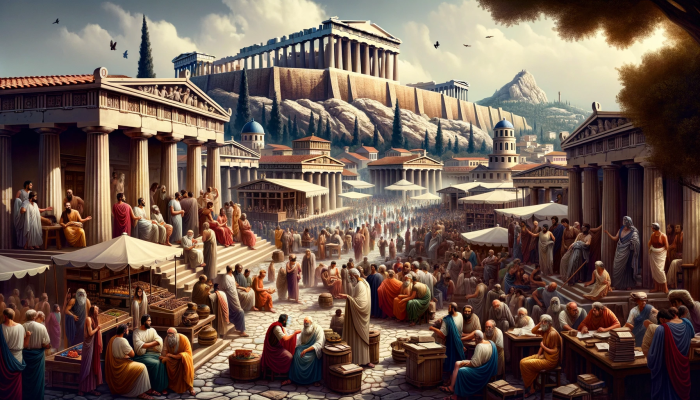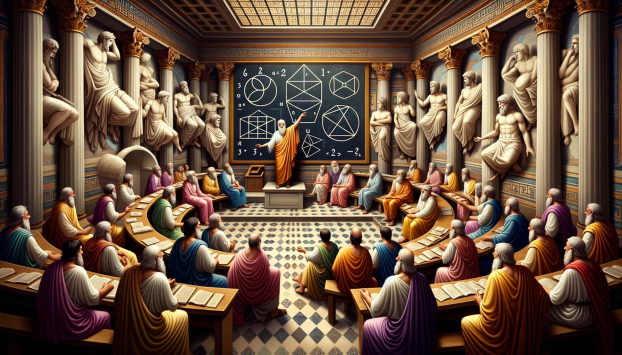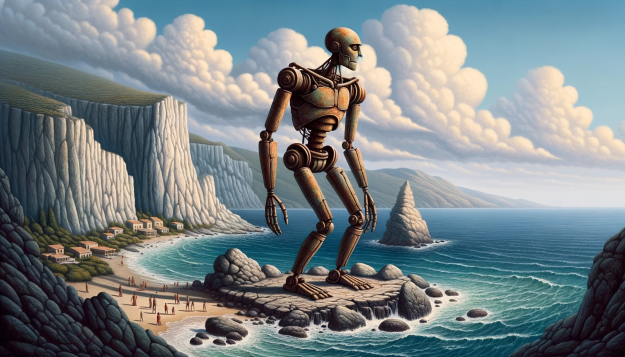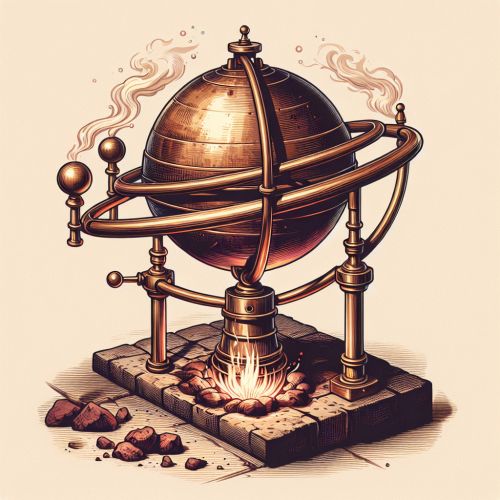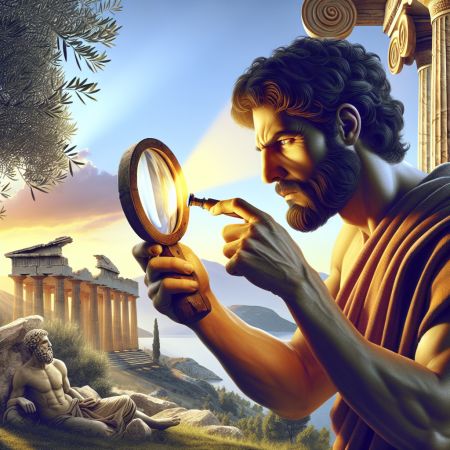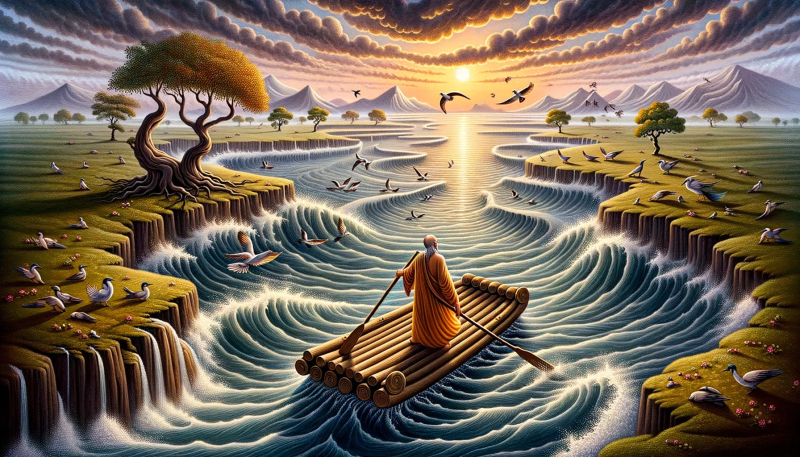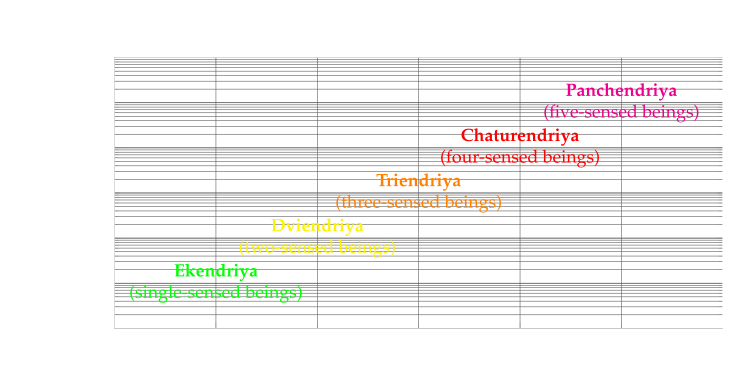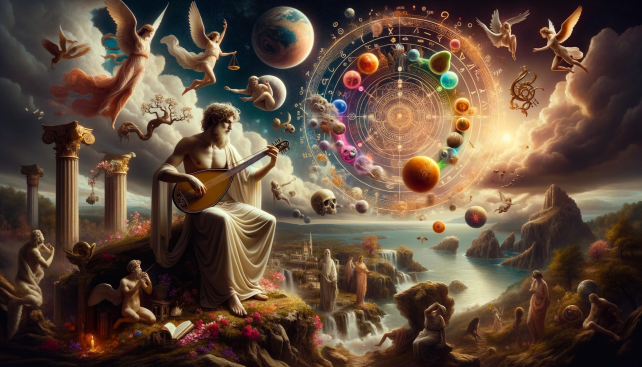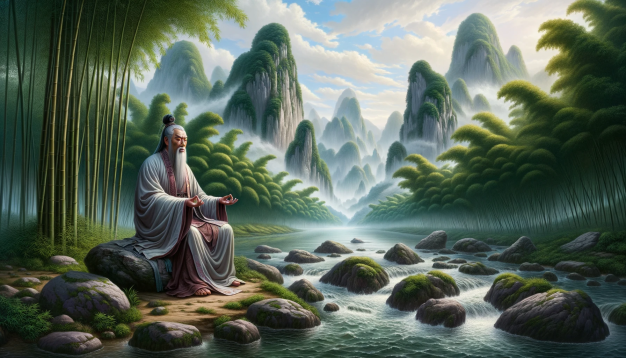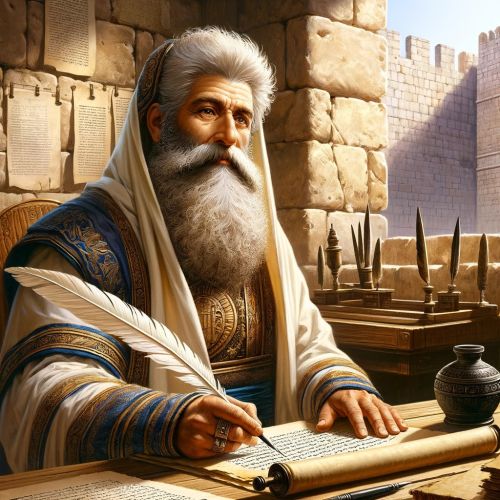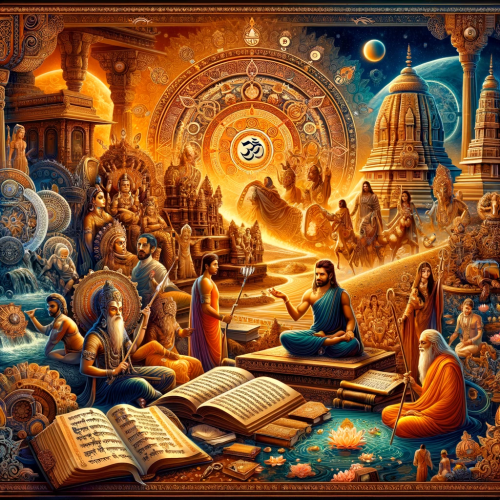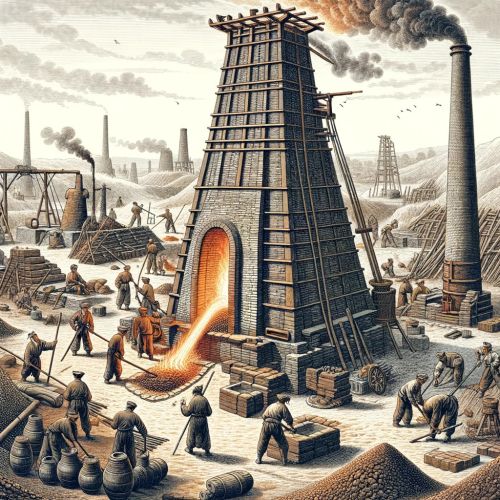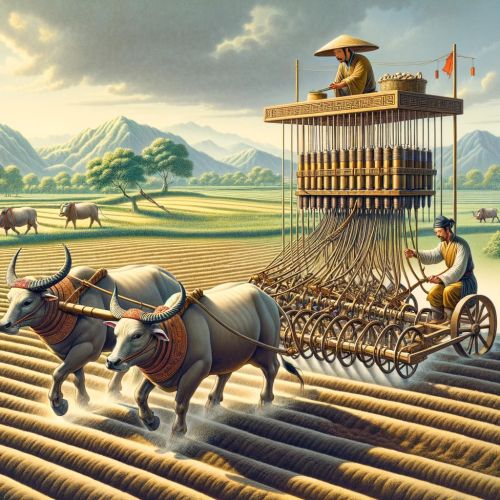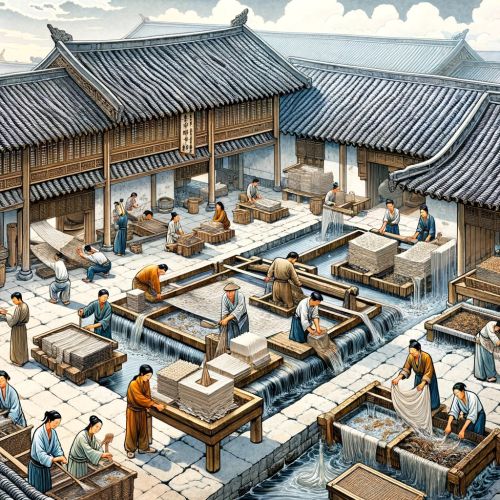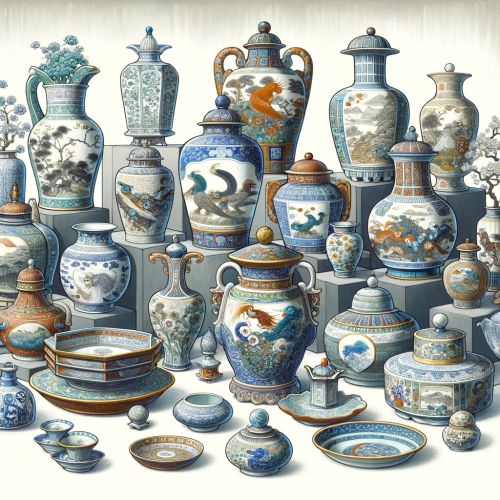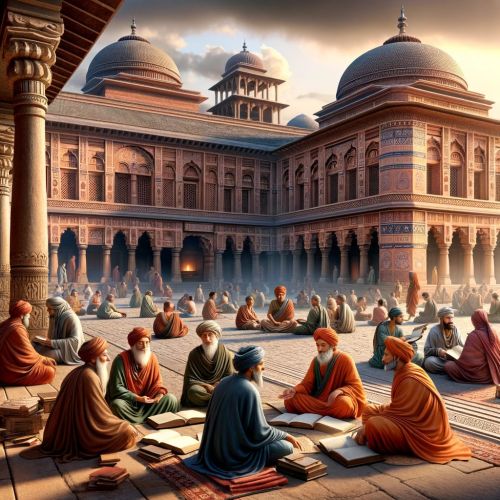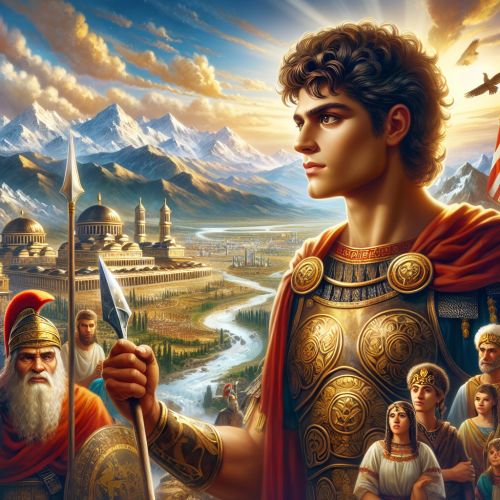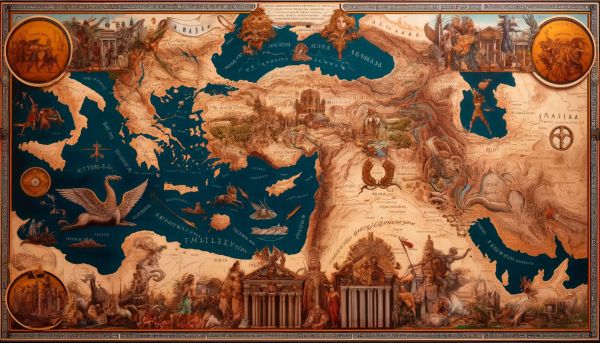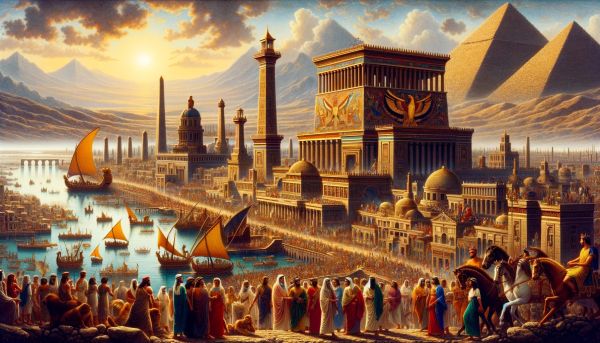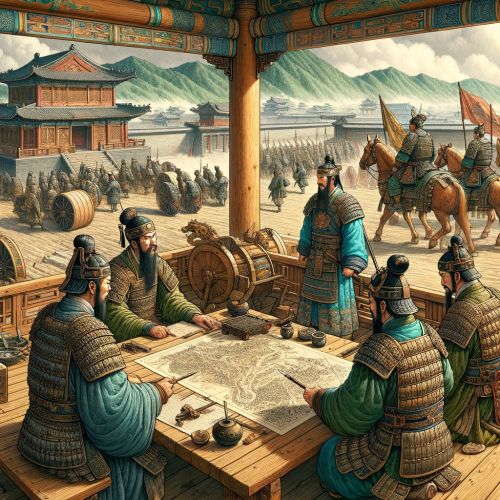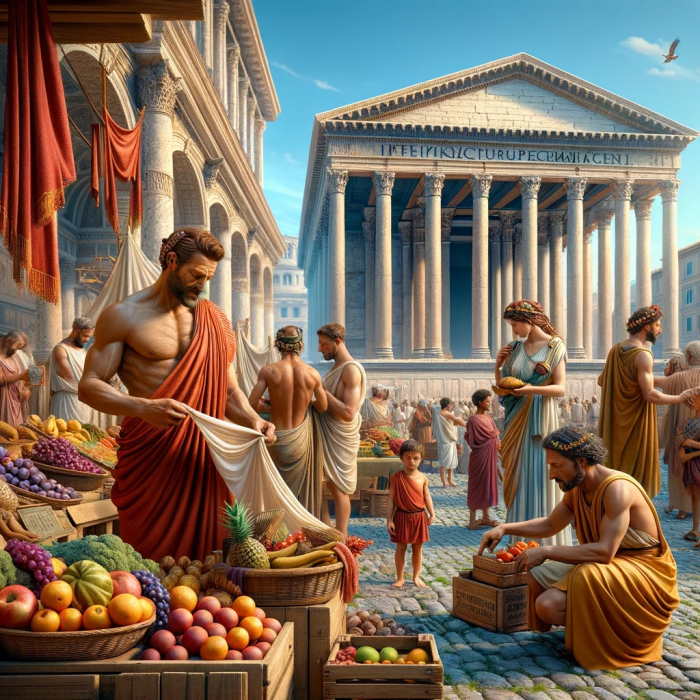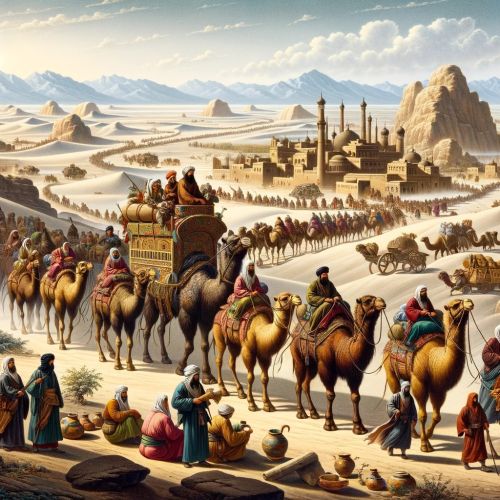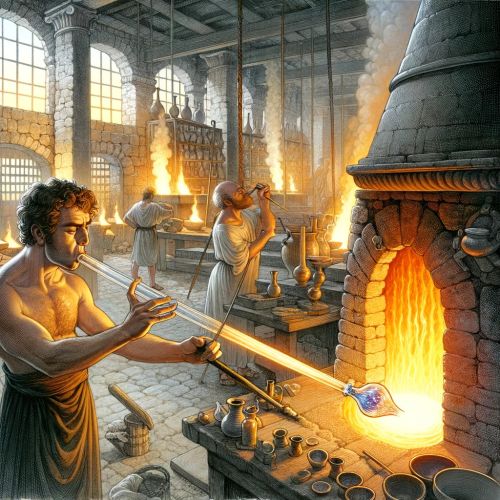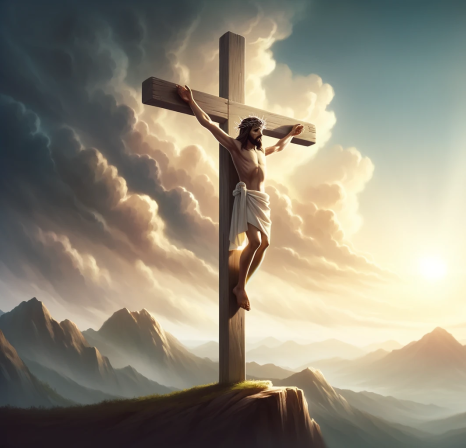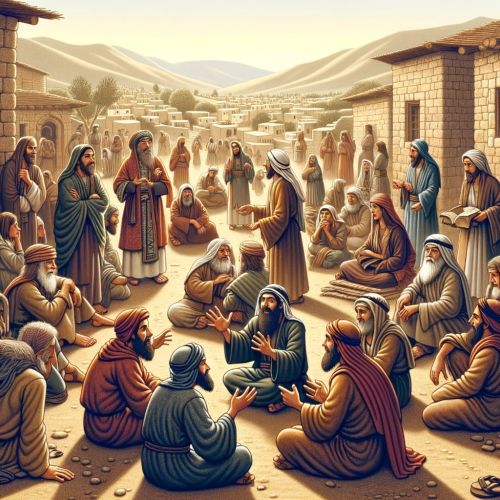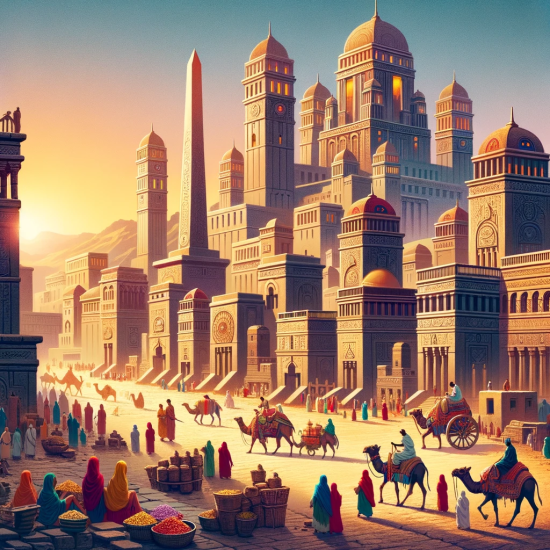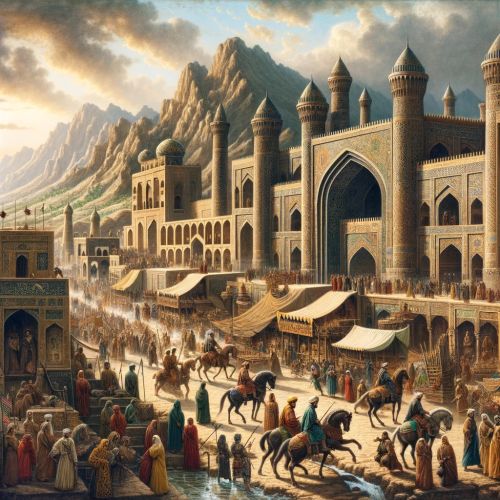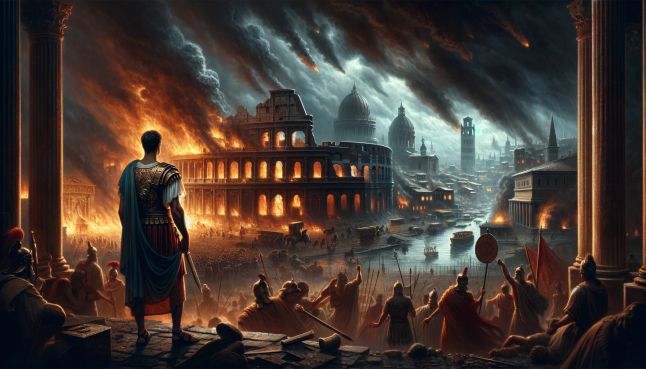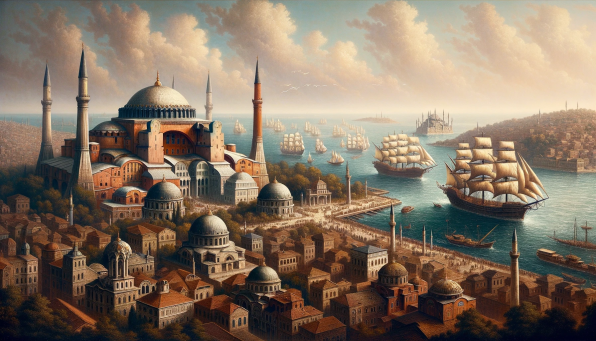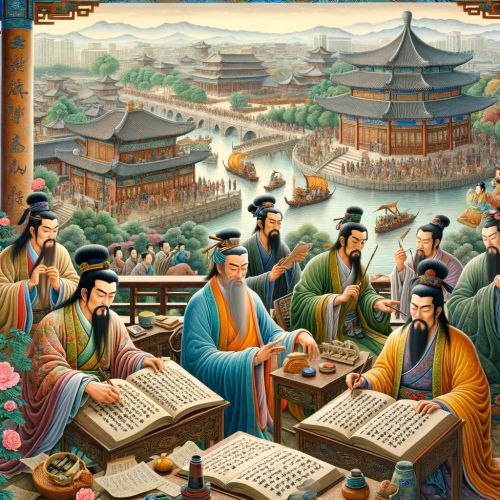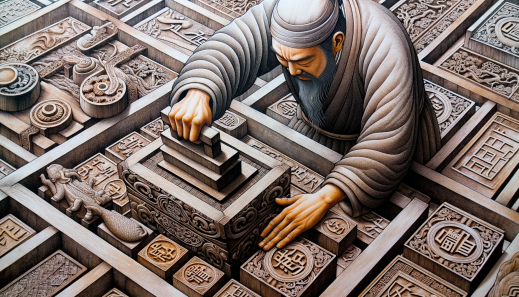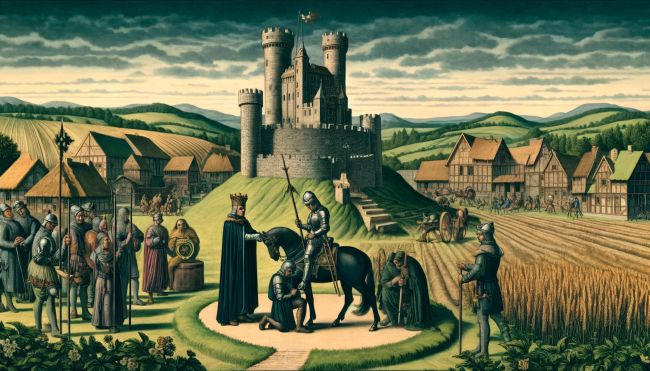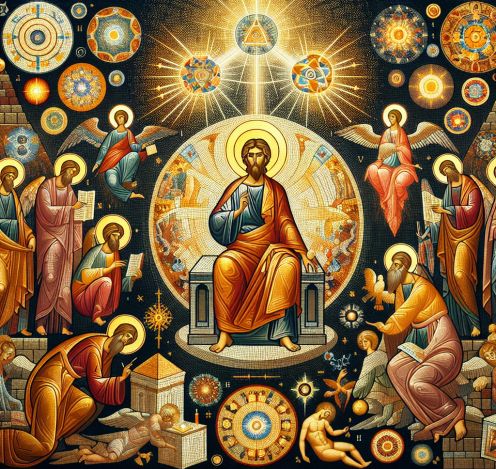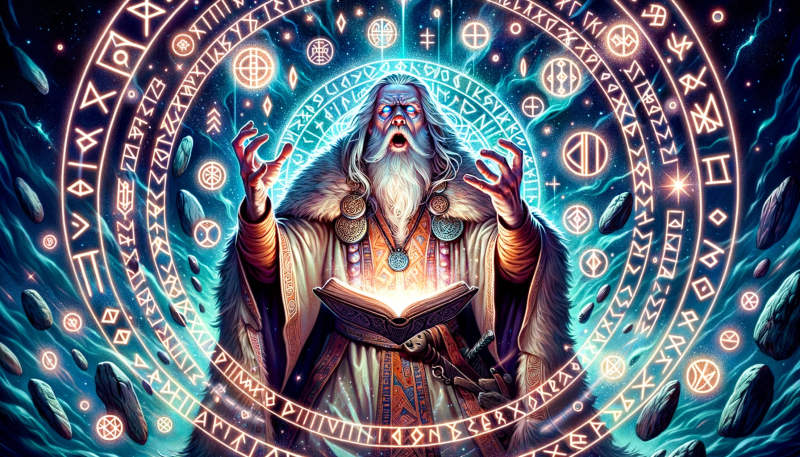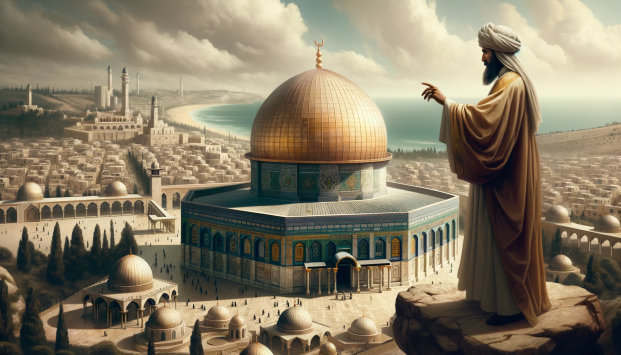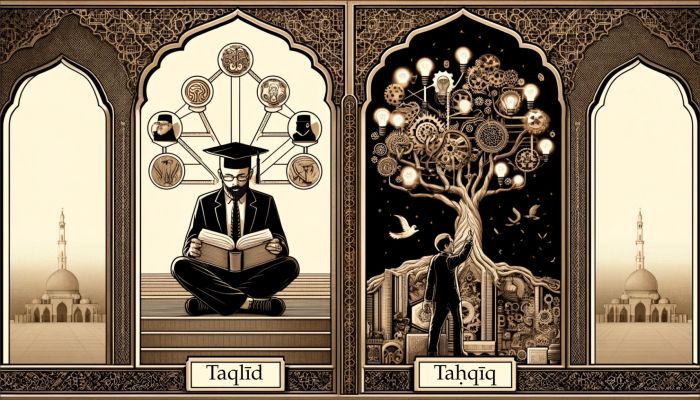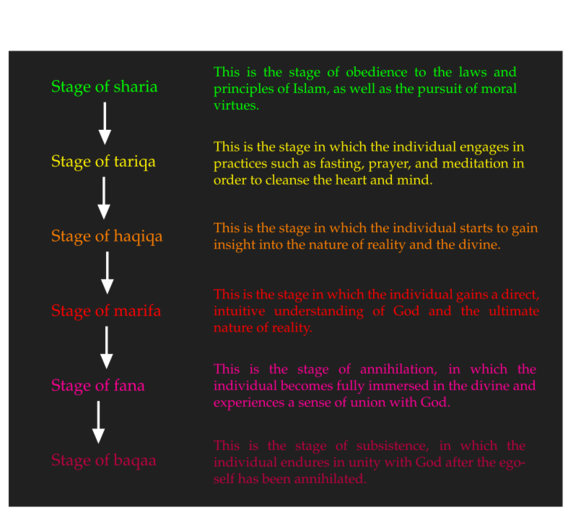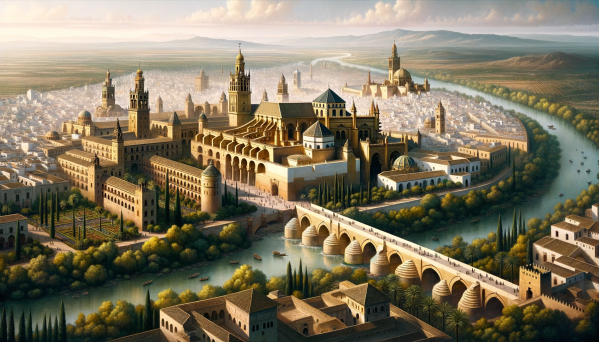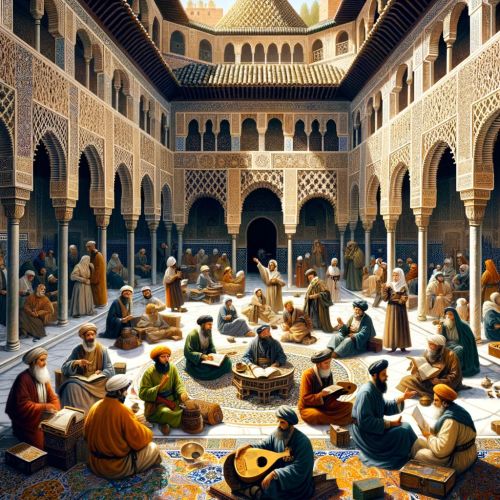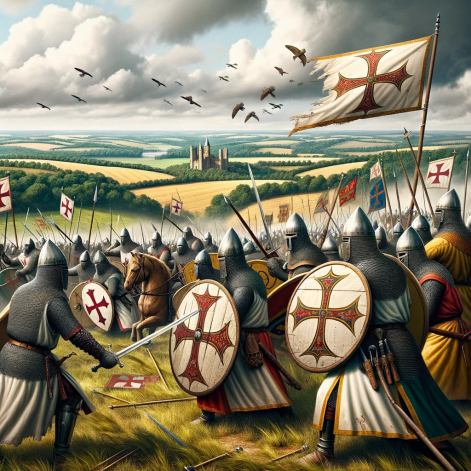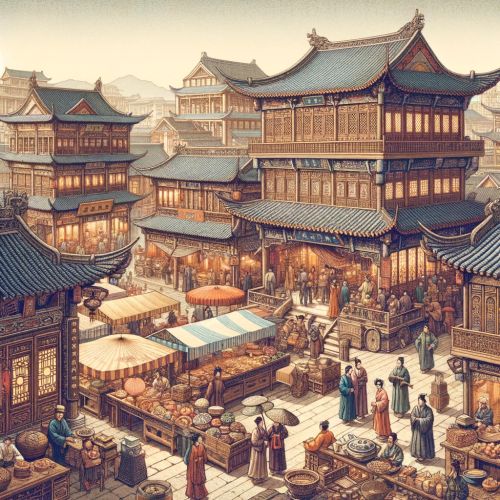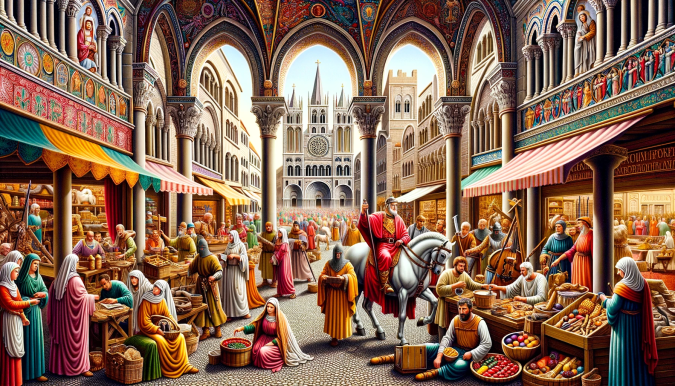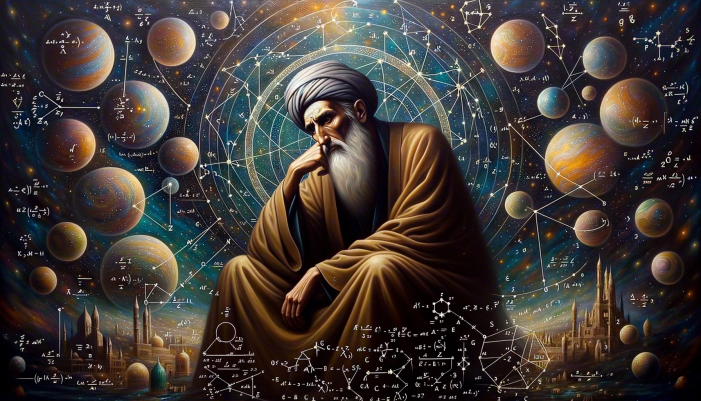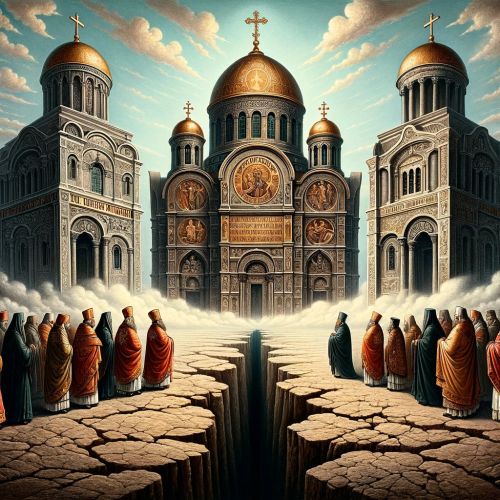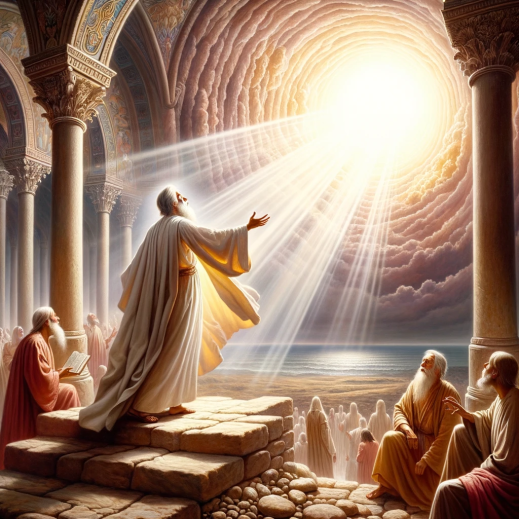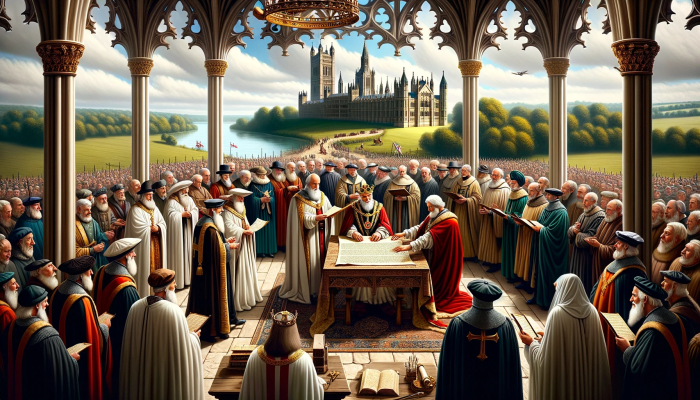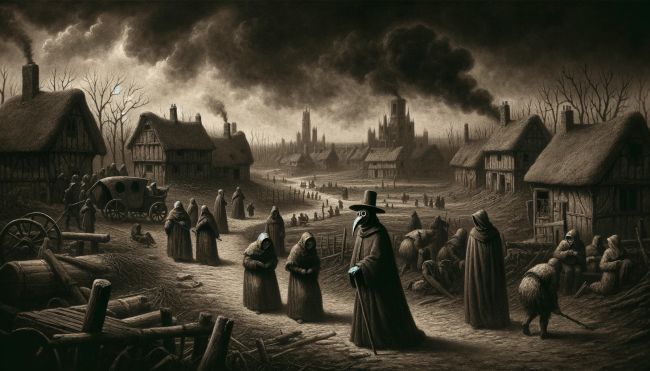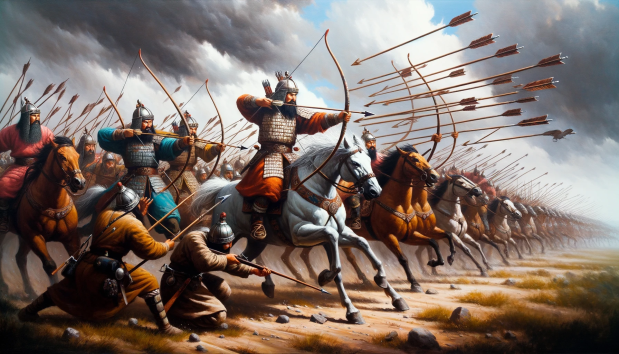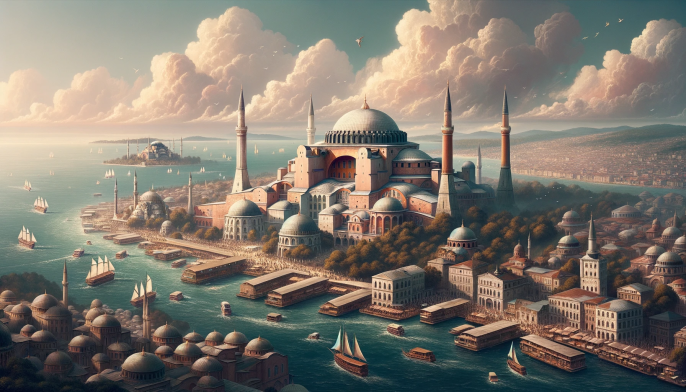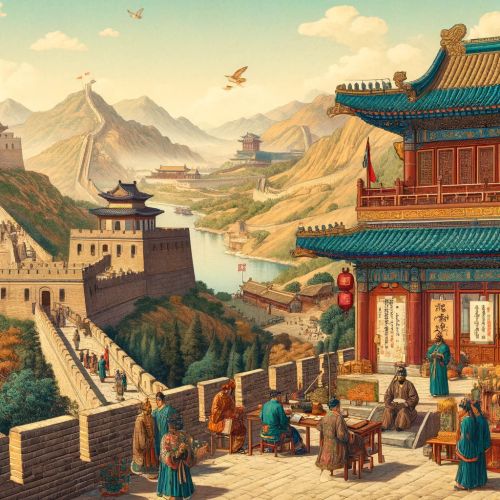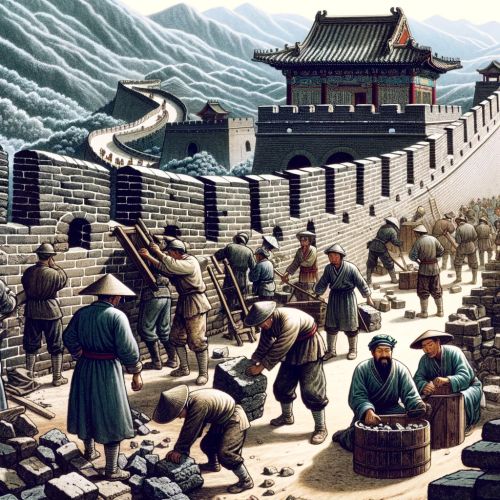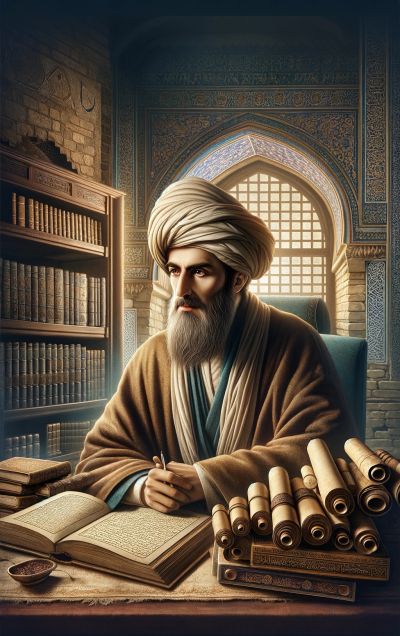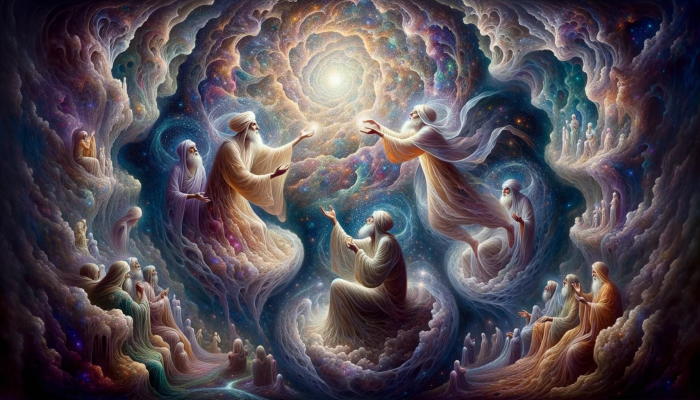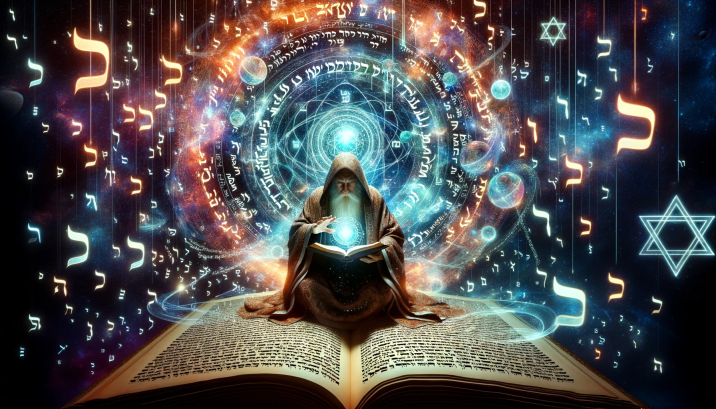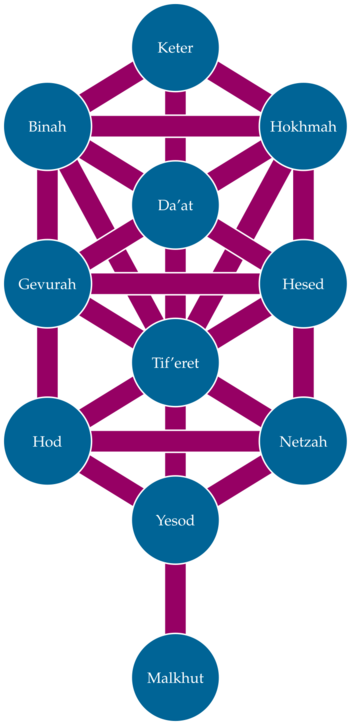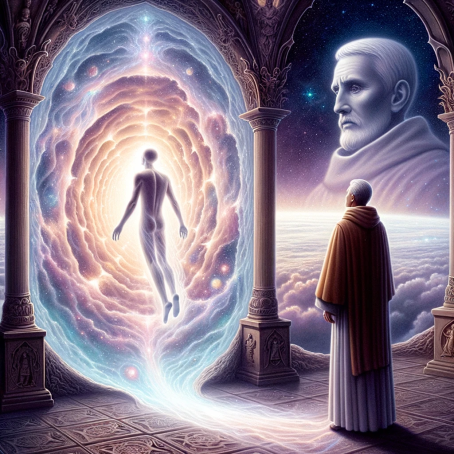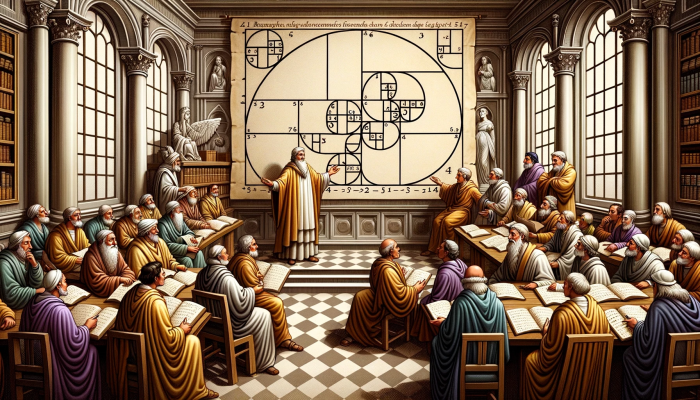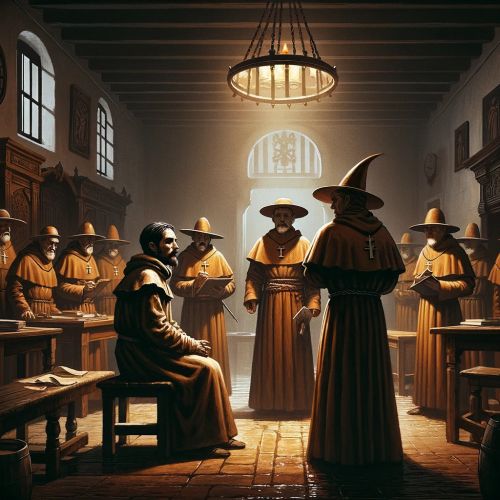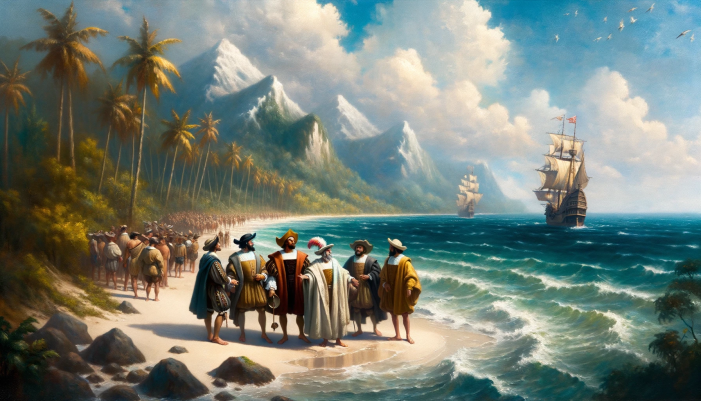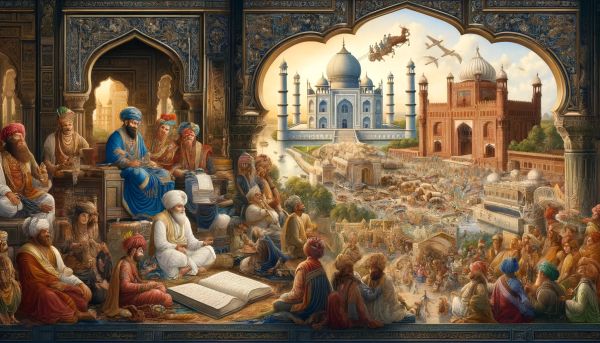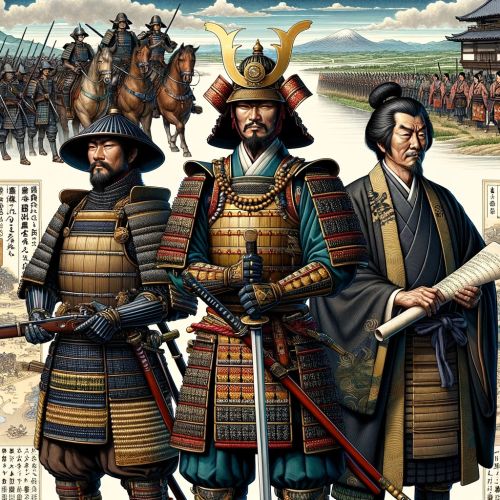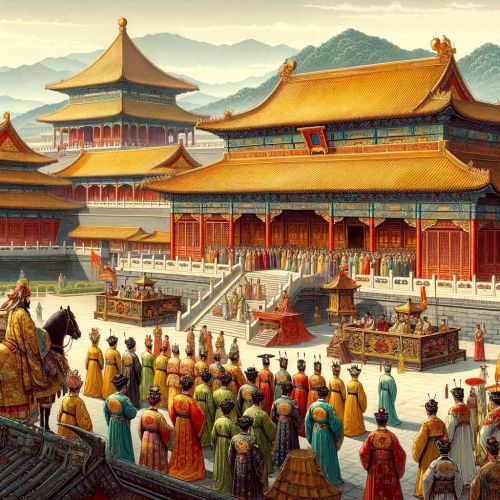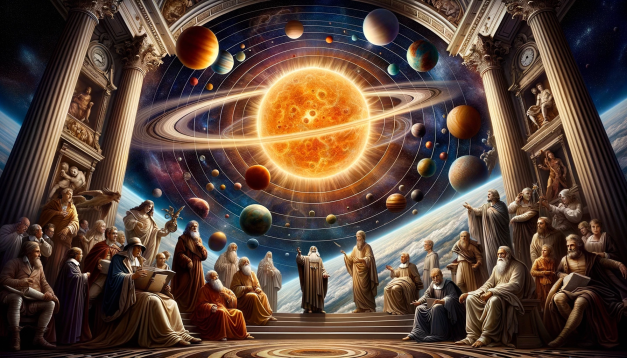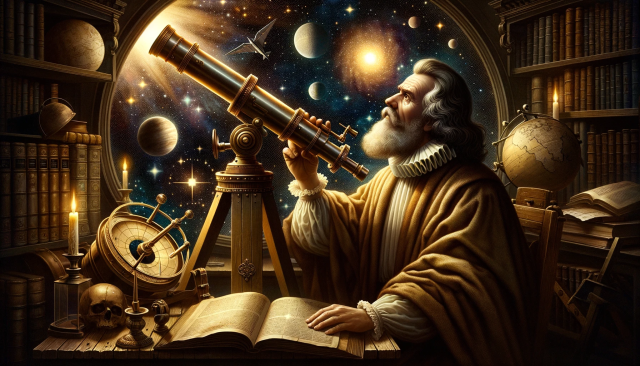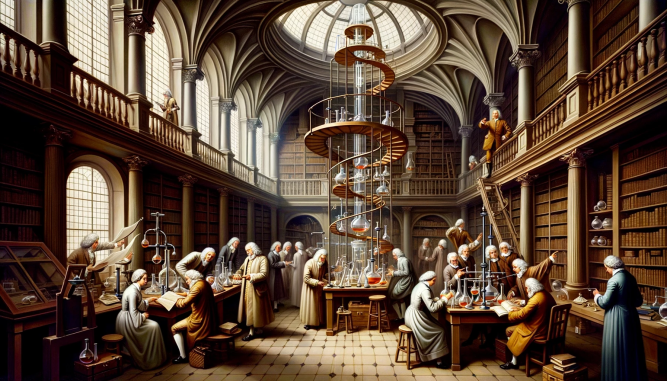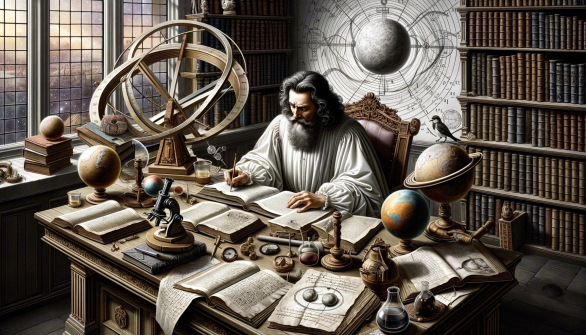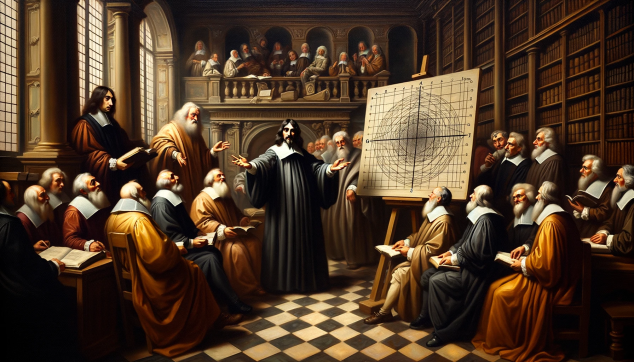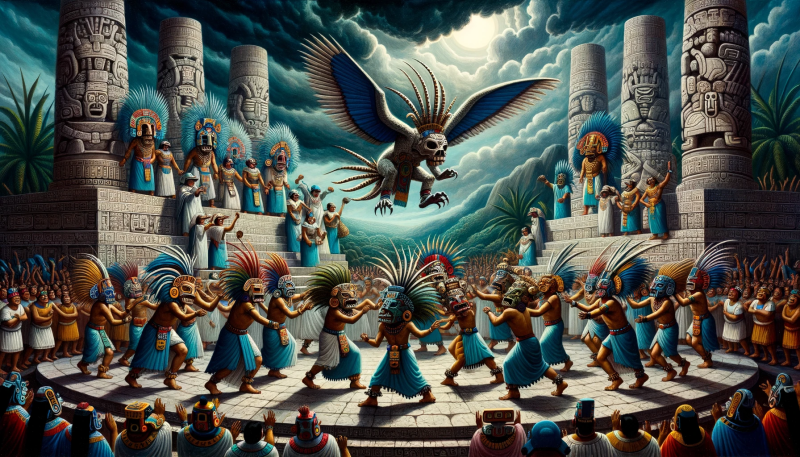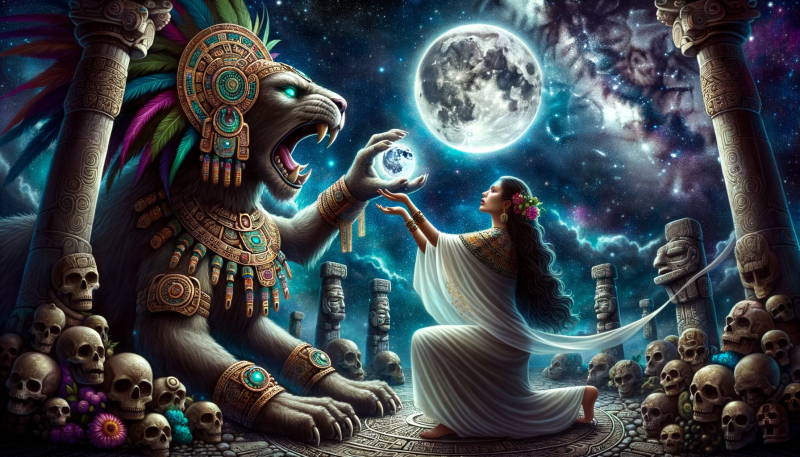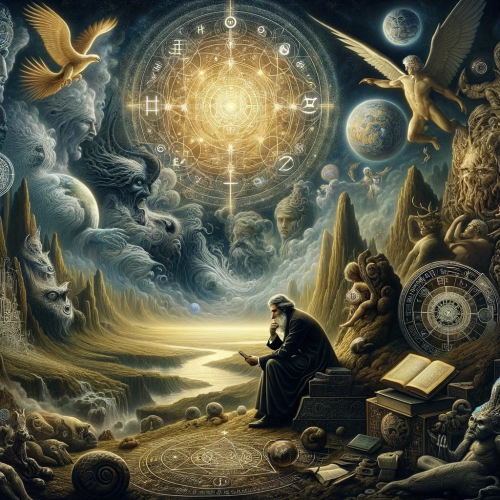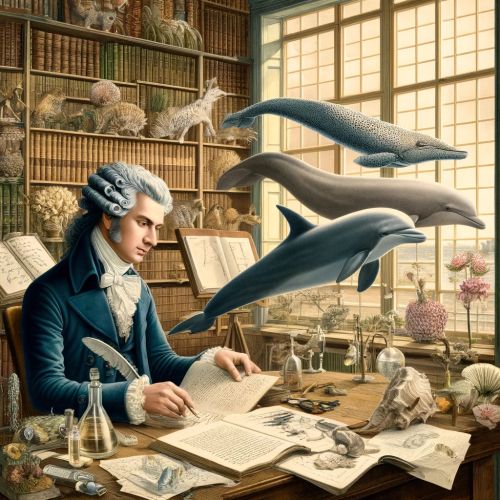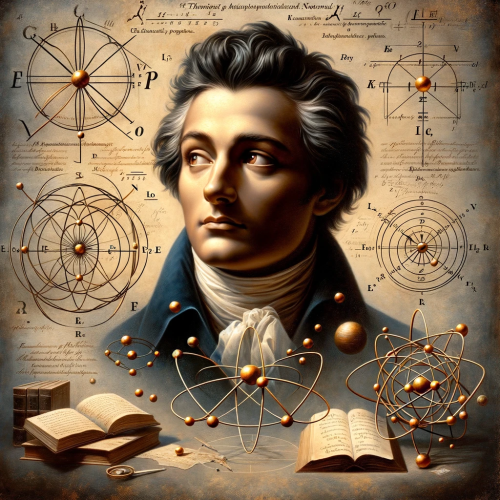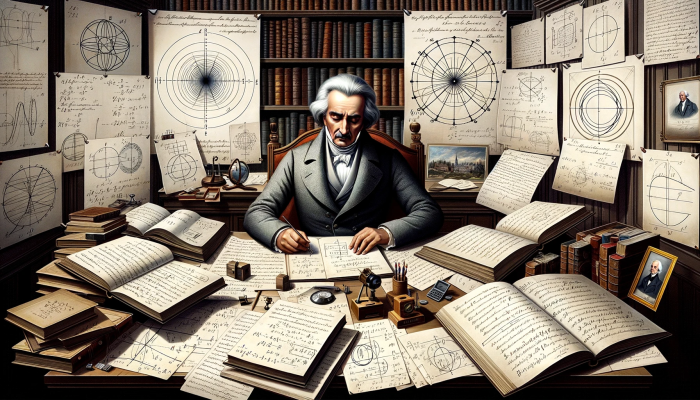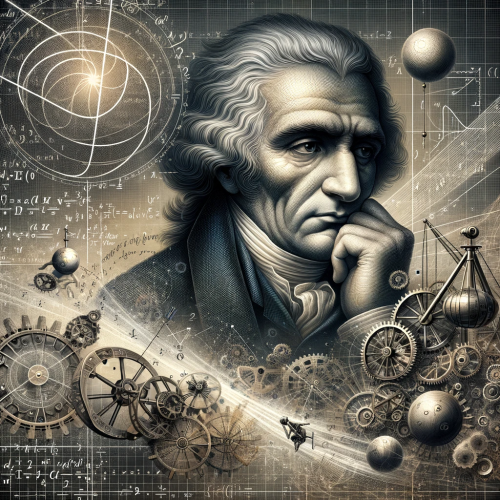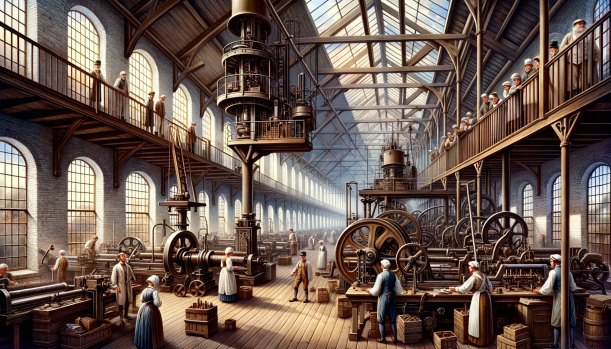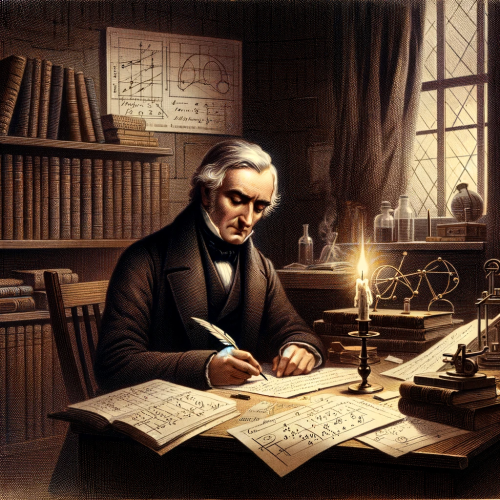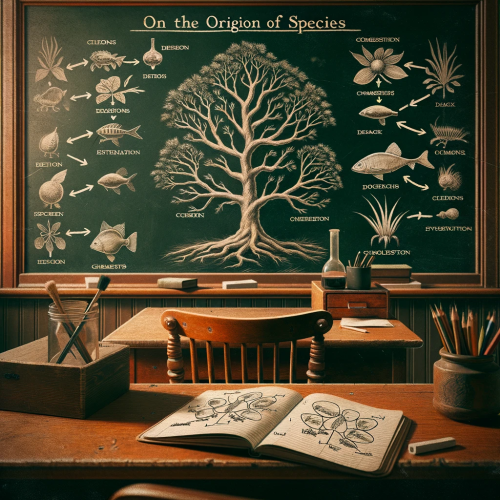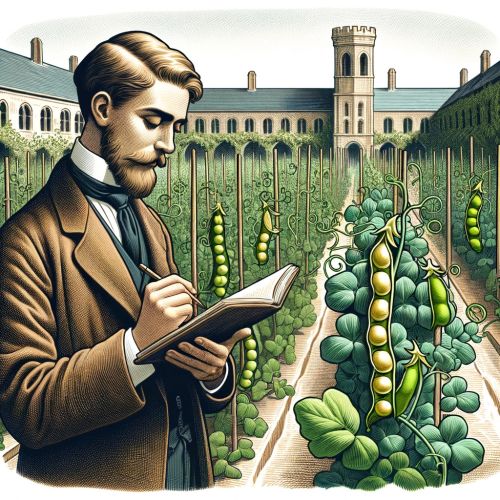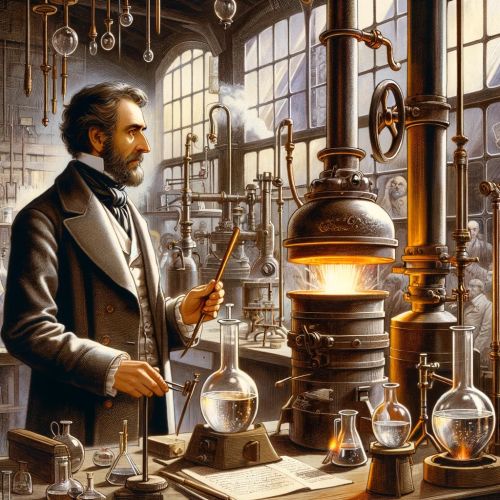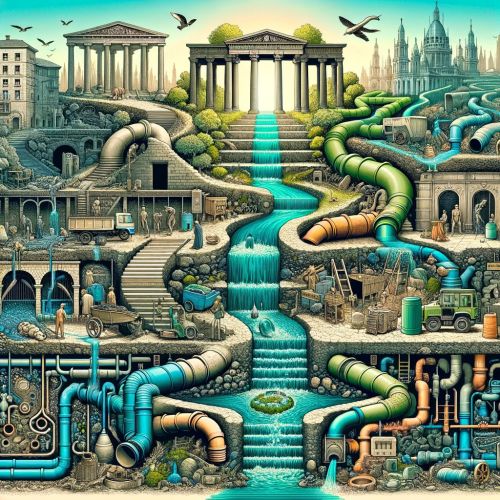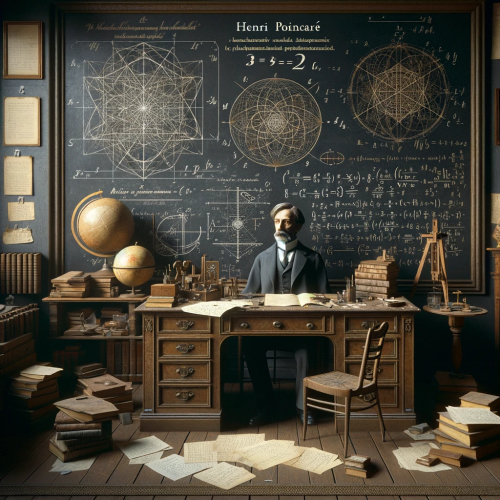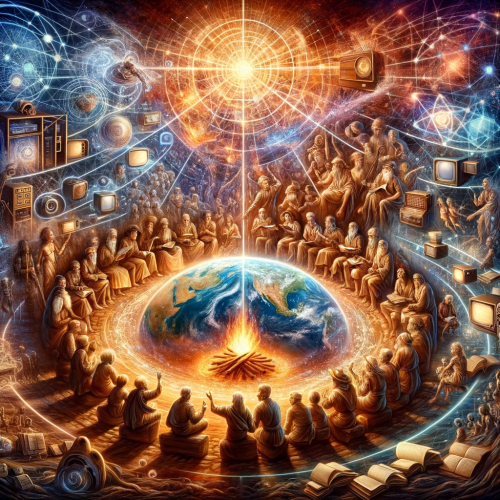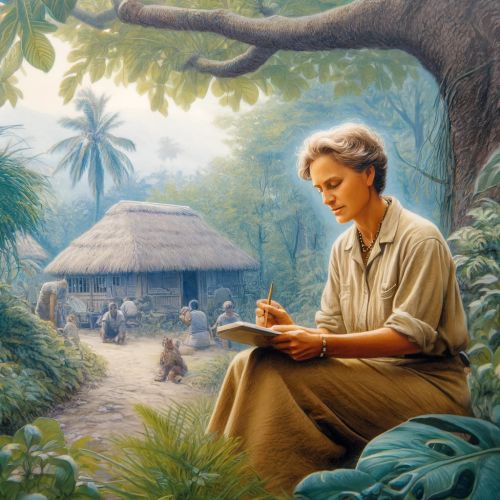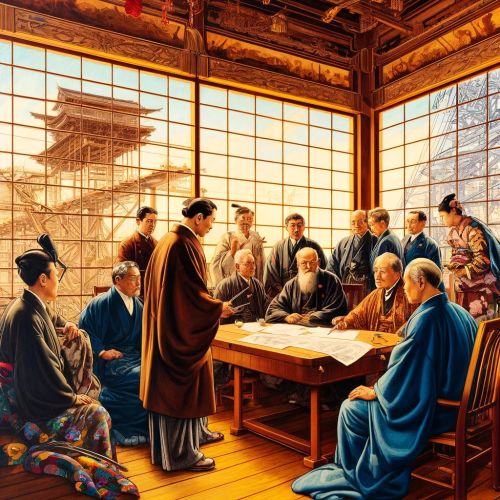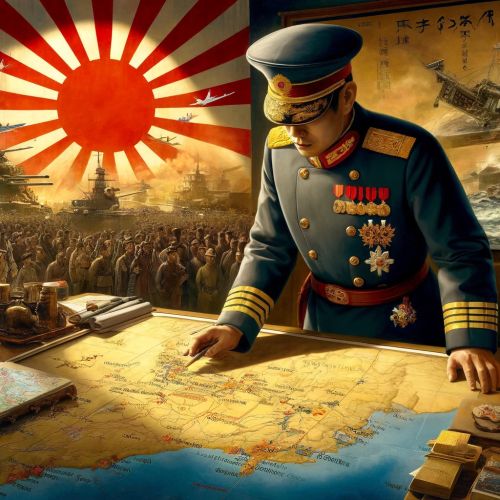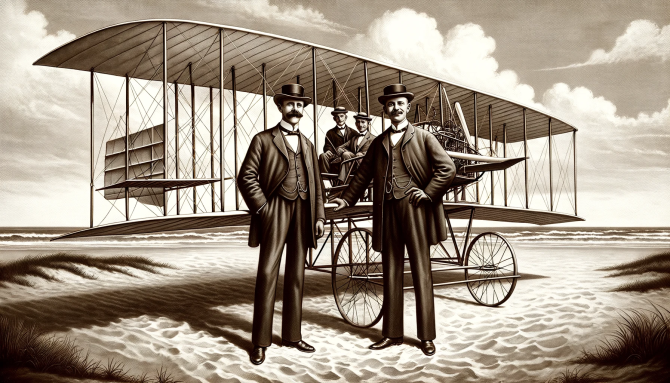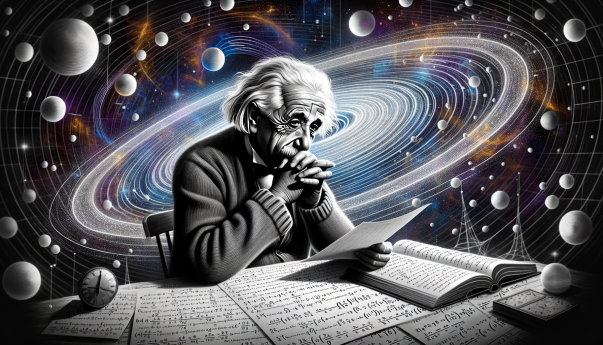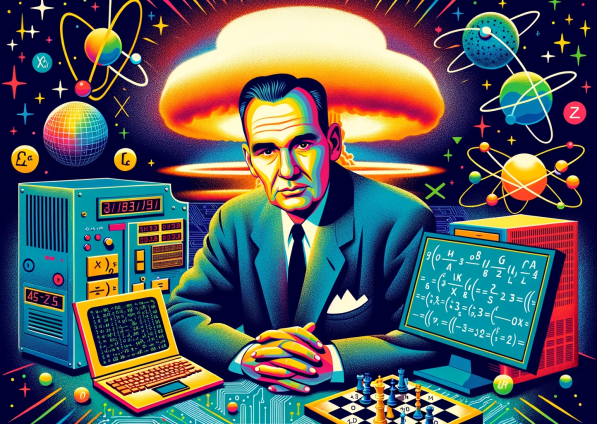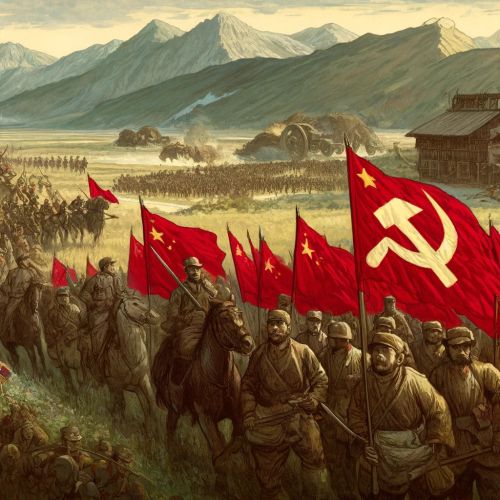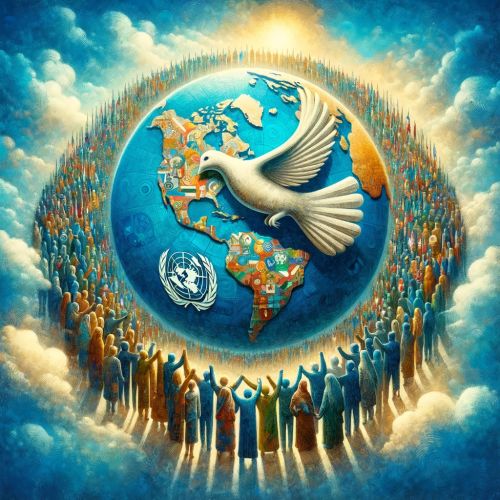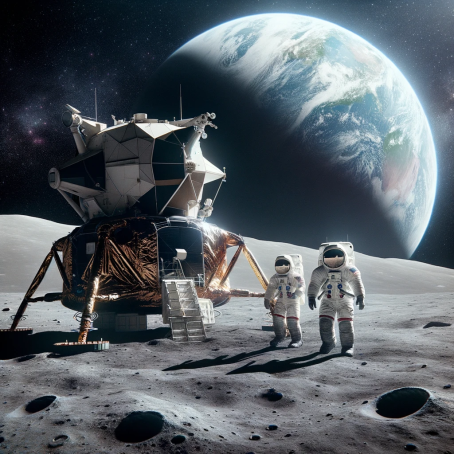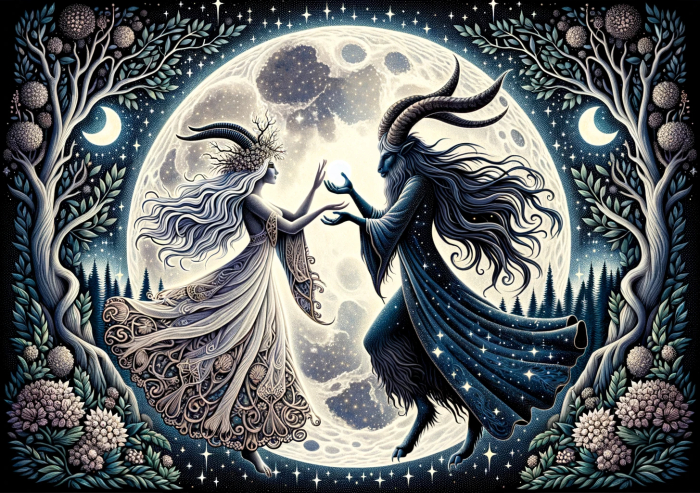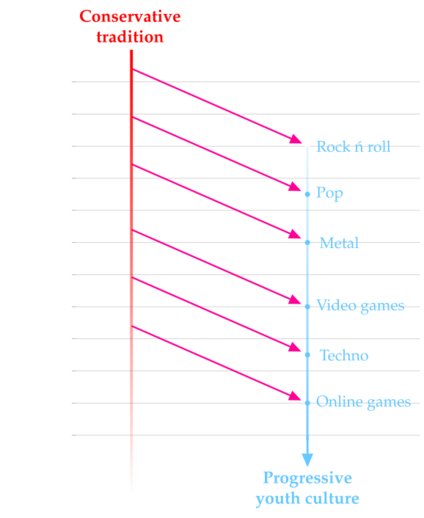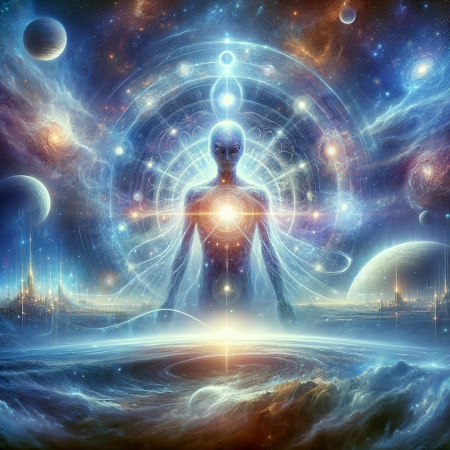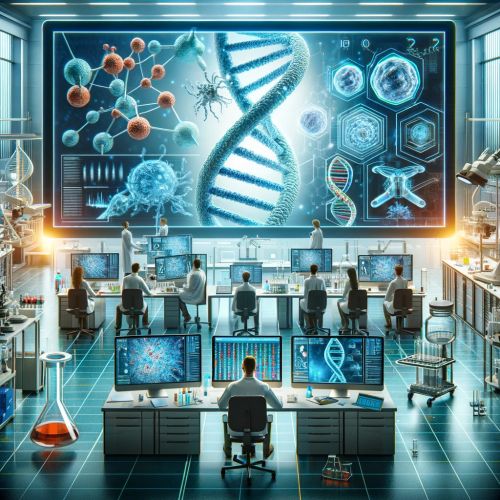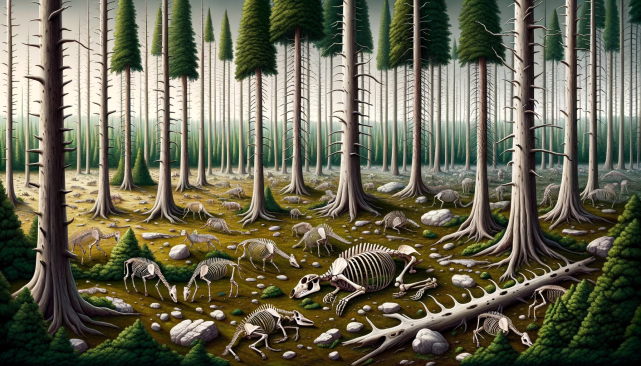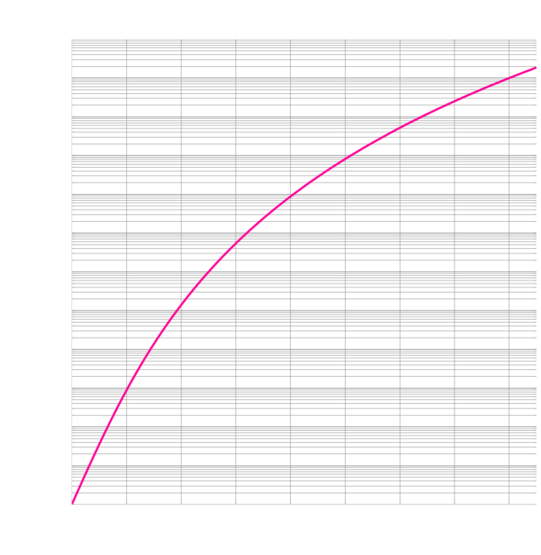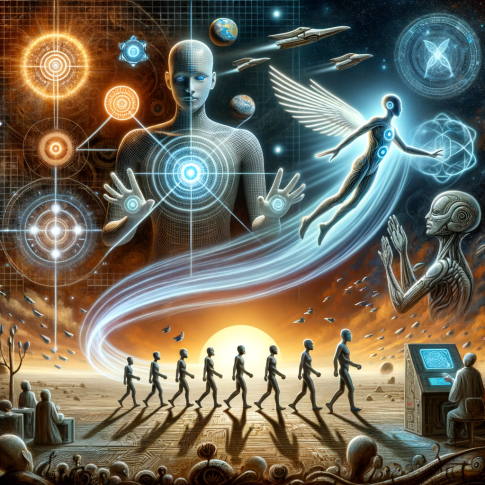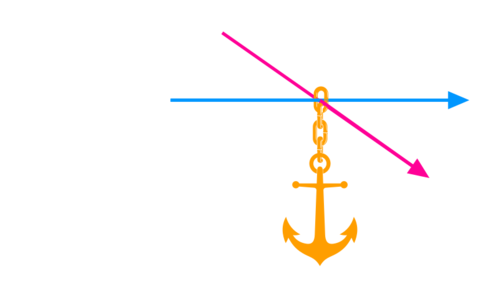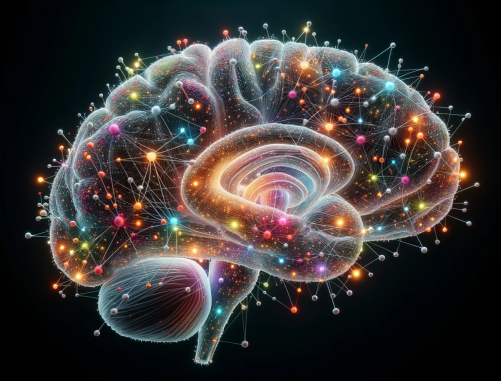Arch History
This expansive narrative explores the grand sweep of cosmic and human history, charting the course from the universe's inception to the complexities of contemporary civilization and beyond. It starts with the cosmic cycle and stellar genesis, detailing the processes that forged chemical elements and sparked life on Earth. The journey progresses from the simplicity of early cellular life to the intricate networks within ecosystems, illustrating the evolution of life across epochs, and culminating in the emergence of human consciousness and society.
As the focus shifts to the development of human societies, we explore cultural innovations and the rise of civilizations worldwide, addressing significant periods like the Middle Ages, the Renaissance, and the Enlightenment. This account also navigates through the technological surges of the Industrial Age, the upheavals of the Second World War, and the transformative impacts of global institutions and the digital revolution in the modern era.
The narrative culminates in a profound examination of the scales of reality, from the minutiae of quantum mechanics to the expansive cosmic vistas, prompting a reevaluation of our place within the universe. This article is more than a chronological recount; it is an exploration of the deep interconnectedness between life, society, and the cosmos. By broadening our historical perspective to encompass the entire timeline of the universe, we invite readers to forge a new and expansive identity—seeing themselves not just as citizens of a nation, but as integral parts of a larger cosmic story, linked by shared heritage and common destiny across time and space.
From Cosmogenesis to Primates
The Cosmic Cycle
In Sir Roger Penrose's Conformal Cyclic Cosmology (CCC), the universe's history is perceived not as a linear sequence with a singular beginning and end but as a continuum of epochs known as 'aeons.' Each aeon begins with a Big Bang-like event and concludes in a state resembling heat death, where the universe cools and expands to such an extent that conventional matter ceases to exist, and traditional measures of time and scale lose their significance.
Within this framework, the principles of scale invariance take on heightened importance. Maxwell’s equations in a vacuum and Dirac’s equation for massless particles, for example, demonstrate an intrinsic symmetry of nature that remains constant regardless of scale. These equations, governing electromagnetic fields and the behavior of particles like neutrinos, suggest an underlying uniformity across various scales, hinting at a universe where fundamental laws persist unchanged through transformations of scale. This universal behavior, transcending mass and distance, points to a deeper unity within the cosmos, suggesting that the fundamental nature of the universe may exhibit a timeless uniformity.
This concept of scale invariance becomes particularly significant in a universe dominated by photons and massless particles, as postulated in the latter stages of each CCC aeon. In such a universe, entities without intrinsic size or scale suggest that discussions about 'size' are only meaningful in relation to other objects. A universe composed solely of such particles would inherently embody scale invariance, lacking a definitive size due to the absence of mass to provide a scale through gravitational interactions. It could be described as infinitely large or infinitesimally small, with such descriptions being functionally equivalent. This dimensional ambiguity implies a universe where traditional metrics of size and distance become irrelevant.
Penrose further postulates that during the transitional phase between aeons, the universe's remaining massless constituents, such as photons, exist in a state that might be regarded as timeless and scale-invariant. This phase, where conventional spacetime constructs dissolve, echoes the concept of the divine oneness found in various spiritual and philosophical traditions, illustrating a profound conceptual resemblance that bridges scientific and metaphysical viewpoints.
This divine oneness represents an undifferentiated, nondelimited reality, an absolute unity that transcends the known physical laws, dimensions, and limitations. It is the pure potential from which all forms manifest, akin to the undisturbed singularity from which the universe periodically springs forth according to CCC. Here, the uniform, coherent state between aeons mirrors the spiritual concept of oneness, where all distinctions merge into a singular state of existence.
The birth of the physical universe, or cosmogenesis, can be envisioned as emerging from a state of divine oneness, characterized by scale-invariant massless particles. This primordial phase, much like the process of decoherence in quantum physics, marks the universe's transition from a superposed, quantum state into a classical state where distinct outcomes and entities become defined. In this cosmic-scale decoherence, the universe shifts from being dominated by scale-invariant, massless particles that exhibit no distinct sizes or scales, to a state where scale-dependent, massive particles emerge, bringing with them the varied scales and structures characteristic of the physical cosmos.
Just as decoherence in a quantum system leads to the collapse of superpositions into observable reality, the passage from the oneness of the inter-aeonic phase to the differentiated cosmos of a new aeon can be viewed as a transformation where fundamental properties such as mass, time, and space become meaningful. This transition not only marks the genesis of diversity in forms and structures but also the emergence of the physical laws that govern their interactions, moving from a uniform, homogenous state to one rich with complexity and variability.
This moment of symmetry-breaking heralds the onset of complexity, diversity, and the relentless march of time. Time, as a measure of change and progression from potentiality to actuality, and entropy, as a measure of disorder or the number of ways a system can be arranged, begin to define the evolving universe. These concepts are absent in the initial state of oneness, where change and disorder are not applicable.
The end of time can be conceptualized as a process of 'recoherence,' where the universe, after navigating through all stages of evolution and entropy, transitions back to a state of fundamental unity. This theoretical recoherence might involve achieving a scale-invariant state, where all physical distinctions and conventional measures of scale dissolve. As the universe cools to approach absolute zero, phenomena akin to Cooper pairing and decay into bosons could facilitate this transition. As time approaches infinity, the maximum information density of the universe may approach zero, potentially prompting a collapse back to massless, scale-invariant particles. This reduction in complexity could lead to a state similar to a Bose-Einstein condensate, where particles occupy the lowest quantum state, enabling a macroscopic quantum phenomenon in a uniform, indistinguishable field. In this ultimate phase, the universe could revert to a primordial condition that transcends the familiar constraints of space and time, erasing the distinctions that currently define the cosmos and echoing a return to its earliest, simplest state.
In Einstein's theory of relativity, as objects move closer to the speed of light, they experience a contraction of space and a dilation of time from the perspective of an external observer. This effect, known as Lorentz contraction, is most extreme near black holes, where the gravitational pull is so intense that not even light can escape. Light, perpetually traveling at its intrinsic speed, represents a constant bridge between timelessness (as it experiences no time due to its speed) and temporality (as it marks the flow of time in the universe). In this sense, light acts as a transactional element, constantly interacting with the fabric of spacetime and influencing the transition between states of being.
Black holes, meanwhile, epitomize the extremity of spacetime curvature, creating conditions where the usual laws of physics encounter their limits. At the event horizon of a black hole, time for an external observer seems to stop—a literal edge between the temporal and the timeless. Here, light and matter teeter on the brink of entering a realm where time as we understand it ceases to exist. This boundary condition can be seen as a dynamic interaction or transaction, where entities shift from the temporal universe we inhabit to the profound timelessness at the event horizons of black holes.
This conceptualization frames black holes not just as astrophysical phenomena, but as profound transitional zones between the measurable, temporal universe and a state that might be akin to the recoherence at the end of time, linking back to the concept where the universe's distinctions dissolve into a unified existence beyond time. This provides a philosophical and scientific scaffold to ponder deeper into the mysteries of cosmic existence and the ultimate fate of all universal constituents.
The Role of The Divine Oneness
Consider the unfolding of the universe as a grand narrative, authored by the divine oneness. In this vast cosmic story, the divine oneness meticulously crafts the main outline, setting the stage for the overarching direction and purpose of the universe. This process of outlining is one and the same with the manifestation of the universe’s foundational laws, initial conditions, and significant evolutionary milestones. However, this grand narrative, inherently dynamic, allows for the emergence of subplots and minor narratives. Governed by smaller systems—such as individual beings, communities, and natural processes—these sub-narratives unfold within the divine framework, embodying a degree of autonomy. These smaller narratives, while mostly harmonious with the main outline, sometimes diverge from the intended plot. Within these deviations, some systems, driven by free will, ignorance, or other factors, engage in actions that can be described as 'evil' or harmful. Such actions represent a misalignment with the divine oneness's overarching plan, introducing conflict, suffering, and chaos into the world.
The existence of these divergences is not an oversight but a feature of a universe designed with free will and the potential for growth, learning, and redemption. The divine oneness, in its infinite wisdom, allows for these smaller systems to exercise free agency, knowing that through their choices, beings have the opportunity to align more closely with the main outline over time or to learn from the consequences of misalignment.
In essence, the divine oneness sets the universal principles and goals, akin to a master storyteller outlining a narrative. The smaller systems—individuals and collectives—then contribute to this narrative, weaving their own stories within the broader tapestry. It is precisely this dynamic interplay between the divine plan and the free actions of smaller systems that reveals the full complexity and beauty of the universe, with all its challenges and opportunities for reconciliation and alignment with the divine will. This interplay is made possible by the divine oneness's act of embedding freedom into the very fabric of existence, a testament to its intention to create a cosmos that is vibrant and alive, rather than a static, deterministic machine. Such freedom is the catalyst allowing systems to operate with autonomy, fostering a universe where creativity, diversity, and the potential for unforeseen possibilities can flourish. It's a deliberate design aimed at making the universe a dynamic and interactive canvas of existence.
In the realm of quantum mechanics, the principle of freedom finds a parallel in Born's rule, which describes how the probabilities of the outcomes of quantum events are determined. This rule illustrates that even at the most fundamental level, the universe does not strictly adhere to a predetermined path but is influenced by probabilistic behaviors, allowing for a spectrum of possibilities. This inherent uncertainty at the quantum level is a reflection of the freedom imbued by the divine oneness, manifesting in ways that defy classical deterministic explanations.
For cognitive systems, such as humans, this freedom is experienced subjectively as free will. It's the sensation that we can make choices that are not entirely preordained by our past experiences or the initial conditions of the universe. This sense of free will is crucial for the development of consciousness, morality, and personal identity. It allows cognitive beings to navigate their existence, make ethical decisions, and forge their paths through the myriad possibilities that life offers.
This divine gift of freedom ensures that the universe and its denizens are not mere cogs in a cosmic machine but active participants in a continuously unfolding story. It's a testament to the divine oneness's desire for a universe replete with life, growth, and the capacity for transformation. By endowing the universe with this freedom, the divine oneness invites all of existence to partake in an ongoing dialogue between the potential and the actual, between what is and what could be.
The Arrow of Time
The narrative of our universe unfolds from a seminal moment of extraordinary density and low entropy, a boundary phase that prefaced its metamorphosis into the expansive cosmic theatre we observe today, some 13.8 billion years later. It is a narrative marked not only by the universe's relentless expansion but also by the concurrent ascent of entropy. Yet, in this grand progression, a compelling paradox emerges: amidst the rise of disorder suggested by increasing entropy, there exists a counterpoint—the diversity of forms and the intricacy of structures have also been ascending. With time, we witness the emergence of ever more complex systems, from the first atoms to the elaborate tapestry of galaxies, stars, planets, and the intricate dance of life itself. This dual evolution underscores a profound cosmic dichotomy: as the universe ages and disorder grows, so too does the potential for complexity and the richness of differentiated forms, contributing to the vast mosaic of existence.
Nearly Scale-Invarient Gaussian Noise in the Cosmos
The cosmic microwave background (CMB) provides a detailed snapshot of the cosmos as it stood during its early stages, a period known as cosmogenesis. One of the key characteristics uncovered in the CMB is the subtle non-uniformity across different scales, manifested as temperature and density fluctuations. These fluctuations exhibit a pattern that is nearly scale-invariant, indicating that there is a slight preference for larger fluctuations at larger scales, identifiable by a gentle tilt of approximately 4% in their amplitude. This trend in the Gaussian noise of the CMB is a fundamental aspect of the universe’s early structure and has been extensively studied to understand better the statistical properties of these fluctuations. The Gaussian aspect of the fluctuations refers to their random, yet statistically predictable nature, with a distribution of temperatures that follows a Gaussian, or normal, distribution curve.
The nearly scale-invariant spectrum, with its small deviation, suggests that the early universe's fluctuations had a specific distribution where the size of the fluctuations became marginally more significant as the scale increased. This 4% tilt indicates a delicate excess of power on larger scales—a feature that has been the subject of intense study to decipher the early universe's physical processes. Recent theoretical developments suggest that these primordial fluctuations can be calculated directly from Standard Model couplings, without invoking inflation. This approach not only grounds the observed properties of the CMB in known physics but also aligns with the preservation of CPT symmetry, indicating a potentially mirrored symmetry in the early universe that is observable in the CMB’s uniform temperature distributions.
Furthermore, insights from Conformal Cyclic Cosmology (CCC) introduce the possibility that the observed patterns might carry imprints not just from the early stages of our universe but from the cyclic transitions between aeons. This perspective offers a broader, possibly infinite context to the dynamics that governed the cosmos's thermal and density characteristics at a time close to its genesis. Understanding the near scale-invariance of these fluctuations and their slight tilt is key to piecing together the universe's history from its earliest epochs to the present day, potentially revealing a cyclic nature of cosmological evolution.
The Entropic Force
Picture the universe as an immense power cell. The emergence from the vector boundary signifies the initial charging phase of this cosmic battery, infusing it with an extraordinary quantity of energy and potential. This was manifested in the form of matter, antimatter, dark energy, and quantum fluctuations. As time rolled on, this stored energy was gradually depleted, much like a battery, through various processes like the birth and evolution of galaxies, the creation of stars and planets, and the emergence of life. Similar to a battery converting stored energy into useful work, the initial energy of the universe has been the driving force behind all the natural processes and transformations we witness today.
Imagine the early universe as a colossal boulder, perched on the highest point of a steep hill, symbolizing a freshly charged cosmic battery at the moment just after cosmogenesis, saturated with a seemingly limitless store of energy and potential. This monumental event breathed life into the universe, begetting galaxies, stars, and planets in a dynamic ballet of cosmic evolution. Each period in the cosmic timeline might be seen as different segments of the boulder’s pathway down the hill, depicting the universe’s gradual but relentless expenditure of energy as it fosters new phenomena, structures, and elements in its descent.
Fast forward billions of years to our current chapter in this grand tale. The boulder, though having covered vast distances, maintains the momentum gifted from its inception, perpetually fueled by the dwindling yet potent reserves of its initial energy store. This energy now facilitates the vibrant dance of life, the phenomena we witness on our planet, and the celestial events that occur in the far reaches of the cosmos. We find ourselves in a universe that has journeyed from a concentrated epicenter of potential to a rich tapestry bursting with life, diversity, and splendor, a universe still narrating its ever-evolving story through the intricate ballet of cosmic phenomena.
Exploring the universe through the lens of a fuel source provides another intriguing viewpoint. The original elements of the universe, namely energy, matter, and space-time, can be likened to a slow-burning fuel source, progressively converted over billions of years to power the evolution of the cosmos. This transformation process, governed by the immutable laws of physics, has been instrumental in structuring the universe and steering its expansion. This concept mirrors the principle of energy conservation, according to which energy is neither created nor destroyed, but simply transmuted.
The two metaphors employed effectively emphasize that the foundational conditions of the cosmos, brought to life by emergence from the vector boundary, held the seeds for everything we currently witness in the vast expanse of the universe. They further underline the pivotal importance of energy conversion mechanisms in the unfolding saga of the universe's development, whether we visualize these processes as the depletion of a battery or the combustion of a universal fuel source.
The Consolidating Force
Harmony is a fundamental property of wave interactions in all kinds of systems, not just in music. They are present in any context where waves are produced and can be observed in mechanical waves (like those on a string or in the air, which we hear as sound), electromagnetic waves (such as light), and even quantum wavefunctions of particles. In any of these systems, the harmonic frequencies are whole number multiples of the fundamental frequency—the lowest frequency at which the system naturally resonates. The presence of harmonics contributes to the complexity and richness of phenomena in various fields of science and engineering, from acoustics to electronics, and from optics to quantum mechanics.
As an entropic force propels systems toward a state of increased entropy, signifying an inexorable drift towards disorder, we may also envision a consolidating force that impels the assembly of larger, more harmonious wholes. This force embodies a fundamental tendency within the cosmos for components to coalesce into a harmonious state, orchestrating a symphony of balance and coherence. It reflects the universe's innate propensity for organizing disparate elements into grand, complex structures that not only exhibit beauty but also represent larger, cohesive aggregates.
The harmonic series in music that illustrates the beauty of individual frequencies coming together in a symphony of complexity. This notion posits that there exists an underlying force or principle that drives the unification of smaller systems into larger, more complex wholes across various scales of reality, akin to the way a fundamental tone harmoniously integrates its overtones into a richer, more profound sound. This force is not merely a mechanical or impersonal process, but one that carries with it an essence of attraction, desire, and creative engagement. Just as individual notes in a harmonic series resonate with one another to create a musical whole greater than the sum of its parts, so too does this cosmic force catalyze the unity and complexity of the universe's vast symphony.
At the atomic and molecular levels, the consolidating force can be seen in the way atoms bond to form molecules. The noble gases are paragons of atomic stability, each boasting a perfectly balanced and harmonious valence shell. This electronic serenity is the envy of the periodic table, where other elements are left striving for such completeness in their outer orbits. These elements embark on a quest for electronic equilibrium, finding solace and stability through the graceful dance of electron exchange, giving rise to ionic bonds, or the intimate waltz of electron sharing, resulting in covalent bonds. Through these interactions, atoms achieve their own state of harmony, echoing the grand symphony of chemical bonding.
Moving up the scale, in biological systems, the consolidating force manifests in the organization of cells into organisms. Each cell, with its unique functions and potential, collaborates with countless others to form complex living beings. This synergy is not merely functional but speaks to a deeper, intimate interdependence and cooperation that is central to the emergence and evolution of life. It reflects a universal pattern of connectivity and unity, where diverse components integrate to form entities of increased complexity and capability.
In the realm of human societies, the consolidating force reveals itself in the ways individuals come together to form communities, societies, and civilizations. Here, the force operates through shared ideas, emotions, and purposes, driving the creation of social structures, cultures, and systems of meaning that transcend individual existence. This social cohesion and collective endeavor mirror the harmonizing essence by showcasing humanity's intrinsic drive towards unity, cooperation, and the creation of shared realities that enrich and expand the human experience.
The consolidating force, therefore, represents a fundamental principle of the universe, a kind of cosmic glue that binds the fabric of reality across different scales and domains. It suggests that the universe, in all its diversity and complexity, is underpinned by a force that favors unity, complexity, and the emergent properties that arise when disparate parts come together in harmony. This perspective offers a holistic and integrative view of reality, one that transcends purely physical explanations and invites us to consider the deeper, more mysterious dimensions of existence that drive the evolution of the cosmos towards ever-greater degrees of complexity and connection.
The Buttons-and-Threads Metaphor
The metaphor of buttons and threads offers a vivid and accessible way to grasp the concepts of connectivity and complexity in various systems. Imagine each button as an individual element within a network. This could be a person within a social circle, a neuron in the brain, or a digital node in a computer network. The threads represent the connections between these elements, gradually weaving together to form a more intricate and dense network. As these connections grow, the network evolves into a "giant component" – a strong and interconnected structure that showcases the network's enhanced structure and functionality.
This growth of connections, pulling previously isolated elements into a complex and unified whole, illustrates the principle of the consolidating force – a concept suggesting that there's a natural tendency towards increasing complexity and unity in the universe. This metaphor beautifully captures how individual entities can transcend their isolation to form a cohesive and interconnected collective. It reflects the universe's inherent drive towards complexity and unity, evident at every level of existence.
By using this metaphor, we can better understand how isolated entities within a network can become a complex, interconnected system, whether we're talking about human societies, the neural networks of the mind, or ecosystems. It provides a concrete image of the transition from individuality to collectivity, aligning with the consolidating force's emphasis on unity and the intricate beauty that emerges from complex relationships. In doing so, the buttons-and-threads metaphor not only makes the complexity of networked systems more comprehensible but also celebrates the complexity, highlighting the fundamental patterns that fuel the evolution of order and complexity across the universe.
Teleological Perspectives and the Consolidating Force
The idea of the consolidating force seamlessly aligns with teleological perspectives, which consider the purpose and directionality in the natural world. Teleology, from the Greek 'telos' meaning 'end' or 'purpose,' examines the inherent intentionality or end-goals within natural processes. The consolidating force may be interpreted as a teleological principle, guiding the progression of the cosmos toward higher degrees of complexity and connectivity, much like an artist driven by a vision of the masterpiece they aim to create.
In every layer of reality, from the atomic dance that forms molecules to the grand ballet of societal evolution, the consolidating force can be envisioned as a teleological agent. It is as if the universe is not just a random assembly of atoms but a stage set for a purposeful drama that unfolds according to a cosmic story. This force implies that there is an innate directionality to the cosmos, one that inclines toward a state of complex interrelations and unified wholes.
This teleological view challenges reductionist approaches that see the universe as devoid of intrinsic purposes, suggesting instead that there is a sort of cosmic intentionality at work. While the consolidating force operates within the physical laws of the universe, its manifestations hint at a deeper narrative – one that suggests the cosmos is not just a machine ticking away but a dynamic, evolving entity moving toward a state of holistic integration.
Such a perspective invites us to reframe our understanding of natural phenomena, seeing them not as mere happenstance but as part of a grander scheme of cosmic evolution. It raises profound questions about the nature of life, consciousness, and the universe itself. How do we, as conscious beings, fit into this picture? The consolidating force, viewed through the lens of teleology, offers a rich and fertile ground for philosophical inquiry, one that bridges the gap between science and deeper existential contemplation.
In the vast expanse of our existence, where every being is a unique embodiment of the universe's grand narrative, the consolidating force manifests as a subtle yet profound call to unity. The consolidating force is seen not only in the physical act of connection—person to person, hand to hand—but also in the shared purpose that moves each individual to become a link in this living bridge. It's a metaphor for the universal bond that draws disparate entities together, creating something greater than themselves—a path across the void, a bridge between worlds. Through this cosmic force, the universe reveals its inherent desire for coherence and deeper connection, echoing through the hearts that beat in unison with the rhythm of existence.
Primordial Nucleosynthesis
In the nascent cosmic dawn, from the swirling photon sea, the first whispers of quarks and gluons began to stir, heralding the universe's dramatic unfurling. It was the consolidating force, the universe's intrinsic yearning for complexity and connection, that guided this transformation. As this force worked its subtle alchemy, the abstract, scale-invariant sea of photons coalesced into the tangible fabric of spacetime. This pivotal moment, when the universe assumed its three-dimensional grandeur, also gave birth to our familiar constructs of time and space.
With the universe's relentless expansion and cooling, quarks and gluons embraced under the consolidating force's gentle impetus, giving rise to a period celebrated as primordial nucleosynthesis. In this era of cosmic creativity, they bonded to forge the earliest protons and neutrons, the harbingers of matter as we know it. These nascent particles, driven by the same force that sparked their creation, united to conceive the universe's first atomic nuclei, including the likes of helium-4, deuterium, and lithium-7. Following the first 380,000 years, the universe had cooled to a whisper of its initial fervor, allowing electrons to join with these nuclei, crafting the first neutral atoms and molecules in a testament to the consolidating force's enduring pursuit of unity.
This primordial nucleosynthesis was more than a cosmic event; it was the consolidating force's canvas, upon which it painted the pathways for massive hydrogen clouds. Over millennia, these clouds, drawn together by gravity—a physical manifestation of the consolidating force—began to coalesce. This gravitational dance was the prelude to the cosmic ballet that would see the birth of the universe's first stars and galaxies, celestial bodies that continue to tell the tale of the universe's ceaseless journey towards complexity and the interconnected tapestry of existence.
The Dawn of Stars and Galaxies
The dawn of the first stars and galaxies stands as a monumental chapter in the unfolding narrative of the cosmos, a time when the universe was a vast expanse of hot, diffuse gas, humming with potential. Within this primordial soup, small density variations—mere echoes of the quantum fluctuations from the universe's infancy—laid the groundwork under the guidance of the consolidating force, the universe's inherent push towards complexity and unity. This subtle but powerful force, the cosmic whisper behind all attraction and connection, encouraged the gas to cool and coalesce, its gravitational embrace preordaining the eventual collapse into the dense cradles of future stars and galaxies.
This consolidating force, a constant throughout the cosmos, orchestrated the gas's journey as it transformed under gravity's pull, converging into nascent celestial bodies. The first galaxies emerged from these cosmic gatherings, each a testament to the universe's propensity for creation and organization.
The genesis of stars within these galaxies unfolds as a testament to the consolidating force's role in cosmic evolution. Nebulous clouds, the nurseries of stars, gradually succumbed to their own gravity, contracting and heating up. The consolidating force acted as a catalyst in this celestial alchemy, fostering the conditions necessary for nuclear reactions to ignite within the dense cores of these clouds. As these reactions flourished, they sparked the transmutation of simple gases and dust into the brilliant tapestry of stars that now light up the cosmos, each star a beacon of the universe's enduring desire for complexity and connection.
The Hertzsprung-Russell diagram is a pivotal tool in the field of astronomy, serving as a graphical representation that depicts the relationship between stars’ true brightness (luminosity), surface temperature (color), and spectral class. Essentially, this chart acts as a cosmic map, charting the life cycle of stars from birth to their eventual demise. In such a diagram, one axis typically portrays the luminosity of stars compared to the Sun—ranging from less luminous dwarfs to the exceedingly bright supergiants. The other axis is allocated for the stars’ surface temperature or color index (B-V), which inversely correlates to temperature; cooler stars appear red and sit on the right side of the diagram, while hotter stars emit blue light and are found on the left.
The main sequence, the prominent diagonal band stretching from the top left to the bottom right, is where most stars, including the Sun, reside for the majority of their lifespans. Stars in this region fuse hydrogen into helium within their cores. The diagram also features other distinct groupings of stars, such as red giants and white dwarfs, each indicative of different evolutionary phases. Red giants, for instance, represent a late stage in stellar evolution when a star has consumed its core's hydrogen and has begun to expand. A Hertzsprung-Russell diagram is more than just a static portrait; it narrates the dynamic story of stellar evolution. By analyzing where a star falls on the chart, astronomers can infer critical information about its age, mass, temperature, composition, and the stage of its lifecycle. This serves not only to enhance our understanding of individual stars but also to shed light on the broader mechanisms governing galactic evolution.
Transitioning our focus slightly, we can consider the broader physics concepts that help us understand these processes. A key area of study is non-equilibrium thermodynamics, which illuminates the existence of what are known as 'dissipative structures'. These structures – tornadoes and whirlpools, for instance – represent spontaneous formations of order. Dissipative structures emerge as efficient means to dissipate energy gradients within open systems. In such systems, energy consistently flows in from the environment and entropy is generated as the system strives to eliminate the gradient and discharge energy as efficiently as possible. This reveals a fascinating aspect of our universe: entropy and order can coexist within open systems. Indeed, even as a system increases its entropy or disorder, it can also develop complex structures or order, given enough energy flow.
Stellar Nucleosynthesis and Metallicity
Stars, in their celestial crucibles, are the artisans of the cosmos, guided by the consolidating force, the universal pull towards complexity and fusion. Through the process of stellar nucleosynthesis, they wield the power to transmute simple hydrogen atoms into more complex helium, embodying the harmonizing desire for transformation and unity at a cosmic scale. As stars age and exhaust their hydrogen fuel, this same force spurs them on to create increasingly heavier elements in their fiery hearts, a testament to the universe's drive towards greater diversity and intricate composition.
A star's metallicity offers a window into its past. The universe's pioneering stars, termed Population III, took shape in a metal-scarce universe. Born from the primordial gases, their metallicity was nearly non-existent. However, their demise enriched the cosmos with metals, setting the stage for subsequent generations of metal-rich stars.
Ursa Major II Dwarf (UMa II dSph) is a remarkable dwarf spheroidal galaxy located in the Ursa Major constellation. Dominated by venerable stars, their starkly low metallicity suggests their genesis during the universe's early epochs. These stellar relics serve as silent witnesses to a time when the universe was just embarking on its metal-making odyssey.
The first metal-rich stars could have appeared around 10 billion years ago, give or take a few billion years, as the metallicity of the interstellar medium increased with successive generations of star formation and death. Our solar system and Earth, having formed around 4.5 billion years ago, reside in the Milky Way's Orion Arm. This location is roughly halfway out from the center of the galaxy, a region rich in heavier elements, remnants from the life cycles of previous stars. These heavier elements are believed to have played a crucial role in the emergence of life, providing the essential building blocks for complex molecules and, eventually, life as we know it.
The Beginning of Chemistry
From the simplicity of the earliest elements generated during cosmogenesis to the more varied products of stellar furnaces, the universe amassed a collection of atomic building blocks. The primordial and subsequent stellar nucleosynthesis processes not only populated the cosmos with a diverse array of elements but also set the stage for the intricate dance of atoms that characterizes chemistry. With the dispersion of these elements into the interstellar medium, the foundations were laid for the complex interactions that would give rise to molecules, minerals, and ultimately the varied materials that make up planets, comets, and other celestial bodies. This burgeoning chemical diversity was a critical step toward the development of the rich, compound-laden environments that are fundamental to the emergence of life.
The Bohr model is a recognized method for illustrating atoms, but it lacks the details of the electrons' specific orbitals and their behavior. More accurate atomic models, which are based on three-dimensional orbital diagrams from the Schrödinger equation, provide deeper insight, although they can also be insufficient when it comes to practically illustrating the configuration of valence electrons, which is central to understanding the reactivity of atoms. The circular grid model overcomes these limitations by combining the richness of detail in the electron configuration with an emphasis on the circular symmetry of the atom. This model allows us to either illustrate all the electron orbitals or focus on the valence orbitals that are most crucial for the reactivity of the atom.
The octet rule, which is anchored in circular symmetry, is particularly relevant for the elements in the second and third periods of the periodic system. In the circular grid model, noble gases are represented with completely filled valence shells with full circular symmetry, demonstrating their stability and chemical inactivity. This symmetry is depicted using distinct colors: the s-orbitals in a deep sky blue, the p-orbitals in a vibrant magenta-pink, and the d-orbitals in a warm orange, which helps to differentiate the various orbitals in the electron configurations.
In the microscopic world of atoms, electrons occupy regions known as orbitals, each with a unique shape and capacity for electrons. The simplest, the s orbital, is spherical, embracing a pair of electrons. It's the elemental note in the atomic symphony, akin to the pure and singular tone that forms the base of a musical chord. The p orbitals, more complex, consist of three dumbbell-shaped regions in orthogonal axes. They host up to six electrons, reflecting a harmony of twos. Like the first overtone in a harmonic series, they add depth to the atomic tune, enriching the elemental note with dimension. Ascending in complexity, the d orbitals emerge with a cloverleaf pattern, accommodating ten electrons. They resonate with the qualities of the second overtone, a richer and more intricate layer in the musical analogy, providing a canvas for five distinct pairs of electrons. At a higher level of complexity, the f orbitals, with their intricate shapes, can house fourteen electrons. This is reminiscent of the composite harmonics higher in the series, weaving a tapestry of seven paired electron paths. Each additional layer in this electron structure adds to the atom's ability to bond and interact, much like each new overtone enriches a note's timbre.
Understanding the intricacies of atomic models is more than an academic pursuit; it unlocks the secrets of how elements interact on a cosmic scale, from the birth of stars to the chemistry that fuels life itself. It is within these interactions, governed by the rules of orbital configurations, that the universe's grand choreography of chemistry unfolds.
Atoms and molecules, in their journey through space and interactions, appear to follow a cosmic choreography that aligns with achieving harmony in their electron arrangements. This quest for balance is evident in the completion of their orbital shells, a process that resonates with musical consonance in the grand symphony of the universe. When considering the harmonies in the Second Period of the Periodic Table, Lithium, a lone pioneer, sets the stage with a single electron in its s orbital, akin to a solitary note establishing the fundamental pitch. Beryllium joins the harmony, adding a second electron to the s orbital, strengthening the foundational tone like a harmonious duet.
Boron complicates the melody. It retains the s orbital duet but adds a lone electron in a p orbital, a note that clashes slightly with the s orbital's established tone. Carbon mirrors this dissonance, with another electron joining the p orbital ensemble, yet still yearning for a complete connection with the s orbital's melody. Nitrogen takes a step towards consonance. It pairs its two s orbital electrons with a trio in the p orbitals, achieving a partial alignment with the s orbital's resonance. However, this configuration resembles a single melodic line – pleasant but lacking the richness of a full composition.
Oxygen throws a wrench into the harmony. It adds a jarring fourth electron to the p orbitals, disrupting the nascent consonance. Fluorine, however, stands on the precipice of perfect harmony. It lacks just one electron in its p orbitals to achieve a resonant accord with the fundamental frequency in its s orbital. Neon brings the first act to a triumphant close with a complete octet: two electrons in the s orbital and a full set of six in the p orbitals. This complete ensemble creates a rich, stable, and resonant chord, symbolizing the element's chemical completeness and stability. It's like the final, resounding note that completes the octave in this elemental symphony.
Lithium, beryllium, and boron typically shed electrons to attain the noble gas electron configuration of helium, achieving greater harmony. Although boron does not form salts, it engages in the formation of compounds such as BH3, which results in a six-electron configuration. This arrangement might emulate the electron configuration of helium by pushing all its valence electrons away, though it cannot emulate the electron configuration of a neon-like octet, simply because there are not enough electrons to do so. In contrast, carbon, nitrogen, and fluorine actively strive to complete their electron shells, aiming to mirror the harmonious electron configuration of neon. This fundamental pursuit significantly influences their chemical behavior, driving them to form compounds that emulate the electron configurations of either helium or neon.
Reframing our understanding of atomic behavior from the pursuit of the lowest energy to the pursuit of electronic harmony allows us to envision a universe not as a mere collection of passive participants always striving for the least active state, but as an active ensemble of elements continuously striving for a more harmonious existence. This shift in perspective might extend beyond the realm of the physical, potentially having profound psychological implications. If we consider the universe as seeking a state akin to stillness or 'death,' as suggested by the lowest energy principle, we may subconsciously adopt a nihilistic view that colors our approach to life and its purpose. Conversely, envisioning a universe animated by a quest for harmony invites a more vitalistic interpretation, one where dynamism and interaction are valued.
Molecular Harmonies and Aromaticity
In organic chemistry, the concept of resonance describes the delocalization of electrons across several atoms within a molecule. Molecules with more resonance forms are generally more stable because the charge or any electron density is spread out over several locations rather than being concentrated in one area. This distribution of electrons is like having a choir where the sound is harmoniously spread across multiple voices rather than a single, isolated note that stands out.
A molecule with numerous resonance forms allows for a balancing of charges much like a well-composed piece of music balances tones and rhythms to create a cohesive and pleasing harmony. Charges in resonant structures are not fixed; they are fluid, analogous to the dynamics of musical harmony where the interplay of notes leads to a rich and balanced sound. In this way, molecules with a higher number of resonance structures can be seen as more 'harmonious' because they can stabilize charges in various configurations, leading to lower energy and greater stability—just as a harmonious musical piece is energetically pleasing and balanced to the listener. This stabilization is not just a chemical benefit but also a conceptual harmony, tying together the beauty of molecular architecture with the aesthetic principles found in music and nature.
Aromatic compounds epitomize chemical stability and resonance, akin to a symphony's resounding harmony. This stability arises from the wave-like behavior of delocalized π electrons in accordance with quantum mechanical principles, particularly as outlined in Hückel's molecular orbital theory. Aromatic molecules like benzene conform to Hückel's rule, possessing a closed loop of p orbitals filled with a (4n+2) count of π electrons, which corresponds to an unbroken series of constructive wave interference patterns. These electrons fill bonding molecular orbitals that extend over the entire ring, leading to a lower overall energy state and enhanced stability, much as a chord in harmony enriches a musical composition through the constructive interference of sound waves. Here, n can be considered as integers, reflecting the discrete, quantized nature of electron counts that stabilize aromatic compounds.
In contrast, antiaromatic compounds lack the resonant stability of their aromatic counterparts. With a π electron count of (4n), these molecules find themselves in a precarious state where the molecular orbitals include both bonding and antibonding interactions. The wave functions representing the behavior of the π electrons do not interfere constructively across the entire system, leading to destabilization—a condition mirrored in the discordance of musical notes that fail to constructively combine, resulting in a cacophony of unresolved tension. In these cases, (n) can be considered as non-integers, signifying the atypical electron counts that contribute to the destabilization of antiaromatic compounds.
Therefore, aromaticity signifies a quantum mechanical harmony, a state of low energy where electron wave functions constructively overlap to forge a stable system. Antiaromaticity, on the other hand, represents a dissonance within the electron cloud—a state of increased energy and tension, where the electron wave functions are out of phase, leading to destructive interference and instability. By understanding aromatic and antiaromatic compounds through this lens of wave mechanics and electron delocalization, we can draw parallels with the intuitive realm of music, making complex chemical concepts more accessible and resonant with our everyday experiences.
Life’s Genesis and Early Evolution
The Genesis of Life on Earth
As the universe’s grand choreography of chemistry unfolds across galaxies, seeding planets with the chemical potential for complexity, our gaze turns closer to home—to Earth, a unique stage where the cosmic dance reaches a crescendo in the genesis of life. The conditions on early Earth, a blend of chemical richness and environmental factors, created a crucible for the first biological molecules to form. This moment in history marks not just a milestone for our planet but a turning point in the universe’s story: the emergence of life from non-life, or abiogenesis.
The consolidating force embodies a profound impetus for the amalgamation of smaller systems into larger, more intricate configurations, serving as a universal architect of complexity and connection. This force stands in a dynamic interplay with the principle of entropy, which dictates a natural progression towards dispersion and disorder within systems. Dissipative structures, such as hurricanes, the mesmerizing patterns of a Belousov-Zhabotinsky reaction, the organized flow of a river delta, and the complex thermal convection cells that form in a boiling pot of water, emerge as islands of order in the sea of entropy. These structures harness and channel the universe's inherent tendencies towards dispersion to foster the creation of more organized, complex systems. This phenomenon can be seen as a dance between the consolidating force and entropy, where the former guides the latter's drive towards dissipation in such a way that new levels of organization are achieved. It is within this dance that the consolidating force begins to sculpt increasingly complex dissipative structures, weaving together the threads of entropy and order into a tapestry of complexity.
Beneath the ocean's surface, the enigmatic depths near volcanic vents served as nurseries for the earliest forms of life, cradled by the consolidating force—the universe's inherent drive towards complexity and connectivity. These chemical-rich environments offered the ideal stage for simple molecules to begin their transformative odysseys, spurred on by this universal force.
In these undersea forges, long chemical pathways, intricately designed to dissipate energy, embarked on a journey of natural optimization. Initially effective yet rudimentary, these pathways gradually evolved under the dual pressures of environmental challenges and the consolidating force's subtle nudging. Mutations and the harsh realities of the vent environments acted as catalysts for the emergence of new molecular arrangements, streamlining the process of energy dissipation. Configurations that excelled at reducing energy gradients became dominant, marking a pivotal shift towards more refined and efficient mechanisms. This evolutionary trajectory is a reflection of the broader cosmic dynamics, illustrating how systems, from the molecular to the galactic, are intrinsically inclined to optimize their functions and interactions within the environmental constraints they face.
As these chemical systems became increasingly sophisticated, they started to bridge the gap between simple chemical reactions and the complex processes characteristic of primordial biological life. This transition was not merely a series of chemical accidents but a guided evolution, propelled by the consolidating force towards higher states of organization and connectivity. The journey from rudimentary chemical interactions to the dawn of life encapsulates a microcosm of the universe's drive for harmony and complexity, a testament to the continuous influence of the consolidating force in shaping the fabric of existence.
The emergence of life from these primordial conditions underscores the inevitability of complexity and connectivity in the universe. Far from being an anomaly, the rise of biological systems represents the culmination of the universe's relentless push towards creating intricate, interconnected forms of existence. Life on Earth, and potentially elsewhere in the cosmos, stands as a profound example of the consolidating force's capacity to harness the chaotic tendencies of entropy and mold them into structures of astonishing complexity. From the simplest unicellular organisms to the vast networks of neural, social, and ecological systems, life exemplifies the ongoing dance between entropy and order, a dance orchestrated by the consolidating force that weaves the universe into a continuously evolving tapestry of complexity and interconnectedness. This narrative not only deepens our appreciation for the origins of life but also illuminates the underlying unity and purpose that permeate the cosmos, revealing a universe eternally striving for greater harmony and complexity.
Early Metabolic Pathways
The continuous narrative of life's origins unfolds further as we delve into the realm of early metabolic pathways, the intricate networks at the heart of all living organisms. These pathways trace their beginnings to an Earth steeped in a primordial atmosphere rich with methane, ammonia, water, and hydrogen gas. Against a dramatic backdrop of constant volcanic eruptions, intense UV radiation, and the electrical dance of lightning strikes, our planet operated as a colossal chemical crucible. It was in this tumultuous environment that complex organic molecules arose from simpler substances, setting the stage for the biochemistry of life within the proverbial 'primordial soup.'
In an era devoid of photosynthesis and the harnessing of sunlight, early life forms had to ingeniously extract energy from their immediate environments. Chemosynthesis emerged as a remarkable biological workaround, with bacteria and archaea, known as chemolithoautotrophs, harnessing the energy from inorganic substances to synthesize glucose. These organisms thrived in the abyssal darkness of deep-sea hydrothermal vents, using molecules like hydrogen sulfide to convert carbon dioxide into organic matter.
One notable chemosynthetic pathway is methanogenesis, which allowed methanogen archaea to derive energy by producing methane from substrates such as carbon dioxide, acetate, and methyl groups. These methanogens prospered in the anaerobic niches of early Earth, breaking down organic matter and contributing methane to the burgeoning atmosphere.
Concurrently, glycolysis, an indispensable anaerobic process, emerged. Through this pathway, bacteria and archaea broke down glucose into pyruvate, producing the vital energy carriers ATP and NADH. The question of glucose's origin in a world lacking photosynthesis suggests that environments like hydrothermal vents may have been the arenas where chemolithoautotrophs manufactured glucose from carbon dioxide and water, using hydrogen sulfide for energy in a process echoing photosynthesis's objectives but powered by chemical reactions rather than sunlight.
These metabolic pathways were more than mere channels for energy; they were the biochemical artisans of life, assembling the essential molecules that form living organisms. They crafted complex molecules, from amino acids to nucleotides, which are the fundamental components of living cells.
Synthesis of DNA Bases
The synthesis of the basic components of DNA, including the purine and pyrimidine bases, may have evolved from simpler chemical reactions that were possible in the absence of enzyme catalysis. Early biopathways likely relied on the availability of small molecules like formaldehyde, cyanide, and ammonia, which are capable of forming larger biomolecules under the right conditions, such as in the presence of mineral surfaces or within hydrothermal vents.
These early reactions could have led to the formation of ribonucleotides, precursors to the modern DNA bases. Ribonucleotides could form spontaneously in a process that mirrors the abiotic conditions believed to be prevalent on the primitive Earth. For instance, the formation of purine bases might have involved the fusion of smaller molecules into a ring structure that later became part of the more complex nucleotides through a series of condensation reactions.
Similarly, the synthesis of pyrimidine bases could have involved simple molecules coming together in a stepwise manner to form the pyrimidine ring, which then attached to a sugar molecule to form nucleotides. These pathways gradually became more efficient with the advent of catalytic RNA molecules, or ribozymes, which could have facilitated and sped up chemical reactions before the evolution of protein enzymes.
As life evolved, these rudimentary pathways became more sophisticated and regulated, involving enzymes that improved the efficiency and specificity of these reactions. This evolutionary process ensured the reliable replication and repair of genetic material, a fundamental requirement for the development of more complex organisms.
The Pentose Phosphate Pathway
The Pentose Phosphate Pathway (PPP) is another testament to ancient metabolic ingenuity, generating reducing power in the form of NADPH. It was a bulwark for life before Earth's atmosphere became oxygen-rich, offering both biosynthetic capabilities and protection against oxidative damage. The PPP was also central to the evolution of genetic material due to its production of ribose 5-phosphate, a nucleotide component.
The Shikimate Pathway
The Shikimate Pathway, with its profound evolutionary significance, has been integral for prokaryotic organisms in synthesizing the aromatic amino acids—phenylalanine, tyrosine, and tryptophan. These amino acids are the building blocks of proteins and serve as precursors for a plethora of secondary metabolites that are essential for a myriad of cellular functions and ecological interactions. The absence of this pathway in animals reveals a deep dietary dependence that is woven through the fabric of life, linking the simplest of microbes to the most complex animals in a delicate nutritional symbiosis.
Expanding on the theme of aromaticity in biology, the indole compound emerges as a critical example of nature's utilization of aromatic structures. At its core, indole features a benzene ring fused to a pyrrole ring, a structure that endows it with robust aromaticity essential for its biological roles. One of the paramount indole derivatives is the essential amino acid tryptophan, a cornerstone of protein synthesis and a precursor to serotonin—a neurotransmitter that is fundamental to mood regulation and neuronal function.
The indole framework is also pivotal in the realm of psychopharmacology, serving as a foundational structure for many psychedelic compounds that target the 5-HT2A receptor, a protein known to influence cognitive processes and perception. These psychedelics, often distinguished by their dramatic impact on consciousness, are unified by the indole ring. This shared structural motif suggests a deeper, harmonious link within life's biochemical network, where the same structural paradigms that scaffold our genetic blueprint also enable the intricate workings of the brain and the profound experiences elicited by psychedelic substances.
In the same way that harmony in music is born from the confluence of varied notes and rhythms to form a cohesive opus, the aromatic indole structure demonstrates how a singular molecular pattern can reverberate through different dimensions of life, supporting functions as varied as the storage of genetic information and the complex phenomena of consciousness and perception. This molecular harmony, embodied by the indole structure, resonates through the biological orchestra, exemplifying the universal symphony of life that plays out at the molecular scale.
Coenzyme A Synthesis
Coenzyme A synthesis from pantothenic acid, which is also known as vitamin B5, is a fundamental process in cell biology. Pantothenic acid, after being absorbed by the body from various food sources, is transported into the cell. Within the cell, it undergoes an enzymatic transformation where it is first converted to pantothenate. This molecule then combines with ATP to form 4'-phosphopantothenate through the action of the enzyme pantothenate kinase.
The process continues as the enzyme phosphopantothenoylcysteine synthetase catalyzes the addition of a cysteine molecule to the 4'-phosphopantothenate, producing 4'-phosphopantothenoylcysteine. Further modification of this molecule, including decarboxylation, leads to the formation of 4'-phosphopantetheine.
Finally, 4'-phosphopantetheine is further processed to produce coenzyme A. This step typically involves the addition of an adenine nucleotide through the action of the enzyme dephospho-CoA kinase. Coenzyme A is essential for various biochemical reactions in the body, particularly those involved in the metabolism of fats, carbohydrates, and proteins. It acts as a carrier of acyl groups, facilitating the transfer of carbon units within the cell, which is crucial for generating energy and synthesizing important biomolecules.
The Mevalonate Pathway
The Mevalonate Pathway, essential for synthesizing isoprenoids crucial for cell membrane structure and signaling, signifies the importance of sterols and isoprenoids in the survival of early life and is present in the last universal common ancestor. In parallel, the Non-mevalonate or MEP Pathway, a vestige from early bacterial lineages found in most bacteria and some plant and algal plastids, emphasizes the ancient and vital role of isoprenoids in both structural integrity and functional processes such as photosynthesis.
Beta-oxidation
Simultaneously, beta-oxidation emerged, a process whereby fatty acid molecules are broken down to generate acetyl-CoA for the citric acid cycle, contributing to ATP production. Its widespread presence across life forms suggests an origin predating the last universal common ancestor, marking it as essential for energy storage and utilization in the earliest life forms. Beta-oxidation's conservation through evolution speaks to its central role in life's energy dynamics, exemplifying the evolutionary creativity spurred by the primordial chemical milieu of early Earth. These pathways not only forged a route to harness energy but also paved the way for the construction of life's complex molecular architecture.
These pathways, forming a complex network, have been instrumental in life's evolutionary journey, demonstrating the adaptability of biological systems in Earth's evolving environment.
Cell Membranes
Vital barriers between a cell and its external world are formed by biological cell membranes, chiefly constituted of phospholipids. These phospholipids possess unique characteristics: they have hydrophilic heads that are drawn to water, and hydrophobic tails that resist it, thus forming a safeguarding shell around the cell.
A cell meticulously controls the levels of diverse ions like sodium, chloride, and potassium within its membrane. This intricate regulation, combined with the existence of protein anions that are unable to pass through the membrane due to their size and negative charge, aids in preserving the cell's membrane potential. This represents an electric charge disparity across the membrane. The membrane potential plays an essential role in a variety of cellular activities, including cell communication, signaling, and the movement of substances into and out of the cell.
These contrasting ion concentrations across the cell membrane and the resulting membrane potential are key to keeping cells away from thermodynamic equilibrium. This state of non-equilibrium, or metastability, is essential for life. Cells maintain this metastable state through the metabolism of food into ATP (adenosine triphosphate), the energy currency of the cell. If cells exhaust their food supply, they can no longer produce ATP, which can lead them towards a state of equilibrium, or death.
In the vast timeline of life, bacteria and archaea, two distinct sets of organisms, are thought to have diverged from a shared progenitor approximately 3.5 to 4 billion years in the past. This hypothesis is reinforced by genetic and molecular research that reveals unique genetic blueprints and metabolic paths exclusive to these groups, which are absent in other life forms. For instance, certain archaea possess exceptional metabolic systems that enable them to thrive in harsh conditions, including high-salt or high-temperature environments. The evolution of divergent cell membrane structures in bacteria and archaea is conjectured to have potentially contributed to their evolutionary split. Research based on ancient rocks posits that both bacteria and archaea had emerged around 3.5 billion years ago, with some scientists theorizing an even earlier inception.
The Principles of Evolution
Evolution is not just a historical record of life's past; it is a dynamic framework that explains how organisms adapt and thrive in an ever-changing world. At the heart of this framework is the concept of organisms and niches optimizing for resonance—a powerful metaphor for the ongoing interaction between life forms and their environments. This concept highlights how adaptability and interconnectedness are essential for survival, reflecting the fluidity and responsiveness of biological systems to environmental challenges. As we delve into the principles of evolution, we explore how local optimizations, genetic mechanisms, and ecological dynamics collectively shape the survival strategies of species, influence the balance of ecosystems, and drive the incredible diversity we observe on Earth. This perspective not only enriches our understanding of individual species but also illuminates the broader ecological and evolutionary processes that maintain the ever-changing tapestry of life.
Local Optimization to Get in Resonance with a Niche
Organisms evolve through natural selection to adapt to their specific environmental conditions or niches. This adaptation process can be thought of as a form of local optimization, where each species fine-tunes its physiological, behavioral, and ecological strategies to maximize its survival and reproductive success within its niche. For instance, a cactus optimizes its water retention capabilities to thrive in arid environments, just as aquatic plants optimize their leaf structure for underwater life. The concept of "resonance" in this context is likened to a state of equilibrium or harmony between an organism and its niche. When an organism has effectively optimized its survival strategies to match the specific demands of its environment, it achieves resonance, ensuring that its life processes, reproductive rates, and ecological interactions are all finely tuned to exploit the current conditions maximally.
Optimization for a niche relies on imperfect reproduction and variable survivability. Randomness or chaotic elements are integral to this process, contributing to genetic variation within populations. This variation, in turn, provides the raw material for natural selection, enabling the emergence of new traits and, ultimately, driving the incredible biodiversity we observe on Earth. Evolution thrives on a delicate balance of order and chaos. While a modicum of randomness is vital for spurring evolutionary changes, an overabundance can lead to chaos and instability. Without appropriate regulation, excessive genetic diversity could breed harmful mutations, threatening the survival of species. Consequently, life has developed a sophisticated suite of mechanisms designed to mitigate errors in our genetic blueprint.
Delving into the microscopic realm, a key safeguard against inaccuracies is the meticulous proofreading functionality of DNA polymerases. These specialized enzymes duplicate DNA and can correct any missteps made during this process to uphold the integrity of the genetic code. Complementing this, another essential mechanism at the molecular level is DNA repair. Through the concerted efforts of a suite of dedicated enzymes, this process detects and fixes a variety of DNA damages. If this damage goes unrepaired, it could cause discrepancies in the genetic code, resulting in detrimental mutations or, in severe cases, even leading to cancer.
In the grand scheme of evolution, organisms have developed intricate systems beyond the molecular scale to minimize errors and ensure survival. These systems, encompassing feedback loops, regulatory networks, and homeostatic mechanisms, are designed to maintain a stable internal environment and proficiently respond to external changes. Feedback loops and regulatory networks enable organisms to optimize their internal functions in response to alterations in external conditions. On the other hand, homeostatic mechanisms preserve a consistent internal environment, irrespective of external environmental fluctuations. All these mechanisms are integral to the ongoing process of life's evolution on our planet.
In addition to genetic variations, phenotypes can also be profoundly influenced by external environmental factors and inherited through non-genetic means such as epigenetics. Environmental stresses and lifestyle factors can lead to epigenetic changes that modify gene expression without altering the DNA sequence. These changes can be passed from one generation to the next, affecting how organisms respond to their environments and potentially leading to new adaptive strategies. Such mechanisms allow populations to rapidly adjust to new challenges and opportunities, supplementing the slower process of genetic evolution.
Dynamic Changes and Cross-species Optimization for Collective Resonance
Niches are dynamic, constantly evolving due to factors such as climate change, geological events, the introduction of new species, or shifts in resource availability. These changes can be gradual or abrupt, each posing different challenges and requiring different responses from the organisms involved. When a niche changes, the previously established resonance is disrupted, prompting organisms to adapt anew. This adaptation may involve minor adjustments or, in cases of significant environmental shifts, more radical transformations. For example, some forest-dwelling creatures might start to thrive in urban settings if their natural habitats are destroyed, optimizing for this new urban niche. Similarly, aquatic species may adapt their behaviors and physiological processes in response to increased water temperatures or decreased salinity, showcasing the broad spectrum of adaptability across different ecosystems.
On a broader scale, ecosystems function as intricate networks of interlinked niches, each populated by species uniquely adapted to both their immediate environments and the activities of their ecological neighbors. Such interdependence among species means that the behavior of one can significantly influence the conditions within adjacent niches, fostering a dynamic equilibrium throughout the ecosystem. This interconnectedness necessitates a certain level of synchronization among various biological rhythms, including food consumption and reproductive cycles, across different species. Harmonizing these rhythms is crucial, not just within individual species but across the entire community, to maintain the ecosystem's overall stability and resilience. Over time, these interactions often lead to a state of collective resonance, where the life cycles and behavioral patterns across species become more aligned, enhancing the sustainability of the ecosystem.
In any given ecosystem, the availability of resources dictates the feeding patterns of species. These patterns must be synchronized with the resource regeneration rates and the consumption needs of other species within the same ecosystem. Predators must balance their consumption rates with the breeding rates of their prey to avoid overexploitation. If a predator's feeding pattern is too aggressive, it may deplete the prey population, leading to starvation and a potential collapse in the predator population as well. Different species competing for the same resources must adapt their consumption patterns to survive alongside each other. This could involve temporal partitioning (different times for resource use) or spatial partitioning (using different areas for resources), which are forms of ecological harmonization.
Breeding patterns also need to be in sync with ecological cycles and the life cycles of other species. Many species time their reproductive events to coincide with periods of high food availability. This synchronization ensures that offspring have the best chance of survival. For instance, many bird species time the hatching of their chicks to coincide with peak insect availability in spring. In some cases, the reproductive success of one species can directly impact the survival of another. For example, the breeding season of certain insects might need to align with the flowering period of specific plants for pollination to occur effectively.
To illustrate further, consider the role of keystone species, such as bees in pollination. The optimization of bees for their niches not only supports their survival but also enhances the reproductive success of the plant species they pollinate, demonstrating a mutualistic relationship that stabilizes various other niches within the ecosystem. The interplay of these dynamic changes and cross-species optimizations contributes to the resilience and stability of ecosystems. Understanding these interactions helps us appreciate the complexity of natural environments and underscores the importance of preserving biodiversity to maintain ecological balance. This holistic view is essential for effective conservation strategies and for predicting how ecosystems might respond to future environmental changes.
The concept of resonance in ecology can be likened to a well-orchestrated symphony where each participant (species) plays its part at the right time and with the right intensity. Such orchestration leads to what might be considered a form of collective resonance. In ecosystems, this involves positive and negative feedback mechanisms among different trophic levels that help to regulate and stabilize ecosystem functions. These interactions and interdependencies among species contribute to a dynamic equilibrium, where changes in one part of the ecosystem necessitate adjustments in others, thus maintaining overall system health and functionality.
Understanding these intricate interactions is crucial for appreciating the complexity of natural environments and underscores the importance of preserving biodiversity to maintain ecological balance. This holistic view is essential for effective conservation strategies and for predicting how ecosystems might respond to future environmental changes.
Plate Tectonics
The initiation of plate tectonics around 3 to 3.5 billion years ago marked a pivotal chapter in Earth's geological history. This period saw the transformation of Earth from a relatively static state to a dynamic planet, characterized by the continuous movement of its lithospheric plates.
In the early stages of Earth's history, as the planet cooled, its surface began to solidify, forming a crust. This crust eventually fractured under the strains of the Earth's internal heat and movements, giving birth to the tectonic plates. The movement of these plates has been instrumental in shaping the Earth's surface as we know it today. Continents formed, shifted, and collided, leading to the creation of mountain ranges, ocean basins, and the diverse topographical features that mark the planet.
The impacts of plate tectonics extended beyond mere physical transformations. This process influenced the Earth's climate and the evolution of life. The shifting of continents affected oceanic and atmospheric circulation patterns, contributing to changes in climate over millions of years. Mountain building and volcanic activity associated with plate movements played significant roles in atmospheric evolution, impacting the development and distribution of life forms.
Moreover, plate tectonics has been central to the long-term carbon cycle, crucial for maintaining Earth's habitability. By cycling carbon between the Earth's surface and interior, it helped regulate atmospheric CO2 levels, thus playing a key role in the Earth's climate system.
The onset of plate tectonics was thus more than a geological event; it was a transformative process that shaped not only the physical landscape of the planet but also its environmental conditions and the life it supports. This dynamic process set the stage for the continually changing and evolving planet, influencing everything from climate patterns to the evolution of species.
Cyanobacteria and the Great Oxidation Event
One notable member of the bacterial realm, cyanobacteria, was instrumental in molding the early Earth's environment. Capable of performing photosynthesis, these organisms harnessed sunlight to transform carbon dioxide and water into energy, liberating oxygen as a side product. Cyanobacteria also hold the unique capability to convert atmospheric nitrogen into a form that can be utilized by other life forms.
Approximately 2.4 billion years in the past, a momentous incident known as the Great Oxidation Event unfolded. This was characterized by a sudden and dramatic surge in the levels of oxygen in Earth's atmosphere. This noteworthy episode signified a crucial turning point in the annals of Earth's history, instigating a series of profound alterations in both the atmosphere's constitution and the surface of the planet. The prevailing theory posits that the rapid multiplication of cyanobacteria sparked this event. The photosynthetic processes of these bacteria resulted in an enormous release of oxygen into the atmosphere.
In a transformative process, cyanobacteria began to produce oxygen, which then reacted with various gases such as methane. This interaction led to the formation of a variety of more complex molecules, including ozone. Likely, it also facilitated the oxidation of methane into CO2, effectively lessening the greenhouse effect and triggering a period of global cooling.
This significant atmospheric change had a profound impact on life forms. It intensified oxidative stress, leading to the extinction of numerous anaerobic species who couldn't survive in the new oxygen-rich environment. Yet, this change wasn't entirely detrimental. It set the stage for the evolution of organisms that could utilize oxygen for metabolism, providing a much more energy-efficient means of survival.
The event, known as the Great Oxidation Event, heralded a fundamental shift in life on Earth—from anaerobic to aerobic forms of life. It marked a pivotal chapter in Earth's evolutionary history, fundamentally reshaping life as we know it.
Diversification of pathways
With the advent of an oxygen-rich atmosphere, new and more efficient metabolic pathways like the Krebs cycle (citric acid cycle) and oxidative phosphorylation emerged. These pathways allowed for a more efficient extraction of energy from organic molecules. In particular, oxidative phosphorylation in the mitochondria of eukaryotic cells enabled the production of a significantly higher amount of ATP from glucose than anaerobic processes, fueling the energy demands of complex multicellular organisms, including animals. The presence of oxygen allowed animals to carry out aerobic respiration, a process that extracts energy from food and oxygen to produce ATP, the cell's primary energy carrier.
Some organisms evolved the ability to metabolize nitrogen and sulfur, leading to the nitrogen cycle and sulfur cycle, both crucial for life as we know it. These cycles ensure the continuous availability of essential nutrients and play vital roles in various ecosystems.
Cellular Innovations
Evolutionary learning
Unraveling the mysteries of time, evolutionary learning illuminates nature's grand design, where the consolidating force—nature's innate drive towards complexity and interconnectedness—subtly guides the fine-tuning of the learning process to accelerate adaptation and diversification. This concept reveals how diverse species evolve and transform over eons, not merely through the cold mechanics of natural selection but as part of a deeper, cosmic impulse towards unity and synthesis. Evolutionary learning, distinct from individual learning, unfolds across generations at the population level, influenced by the frequency of traits that either enhance or hinder an organism's ability to thrive and reproduce. In this grand tapestry, each trait's survival and propagation reflect the consolidating force at work, nudging life towards ever-greater realms of complexity and connection.
Over extended periods, the accumulation of minor genetic modifications propels the emergence of new traits and adaptations. Such a phenomenon can not only birth entirely new species but also induce alterations in existing ones, enabling them to better acclimate to their surroundings. In essence, evolutionary learning equips organism populations to react and adjust to environmental changes, thereby fostering increased diversity and complexity over time.
Evolution has a knack for becoming progressively proficient at navigating the vast universe of potentialities. Various mechanisms, such as sexual reproduction, transposable elements, and retroviral horizontal gene transfer, are all thought to be catalysts that accelerated the pace of evolution. Around 1.2 billion years ago, sexual reproduction emerged, acting as a genetic shuffling tool and promoting the creation of innovative gene combinations. This process enhanced genetic diversity, leading to a quicker evolutionary pace as advantageous traits could emerge more rapidly.
Then there are transposable elements, often referred to as 'jumping genes' - these are DNA segments that can relocate within the genome. By inserting themselves into new positions, they can foster genetic diversity and potentially give rise to fresh gene combinations. Another fascinating process is retroviral horizontal gene transfer, wherein viruses facilitate the transfer of genetic material between organisms. This process not only boosts genetic diversity but also enables the swift dissemination of beneficial traits across populations.
Collectively, these mechanisms are believed to have significantly contributed to the evolutionary journey of life on Earth. They have enhanced the speed at which new genetic variations can spring up and be shared amongst populations, leading to the development of an increasingly complex and diverse biosphere over time.
While the processes previously discussed have catalyzed the pace of evolution and boosted genetic diversity, it's crucial to acknowledge that organisms don't necessarily evolve towards increased sophistication. Surprisingly, they might shed complexity when it doesn't contribute to their survival. Regardless, evolution acts in a probing manner, inclined to discover new ecological niches which may occasionally demand greater complexity for exploitation. Consequently, we could witness a slow yet steady rise in complexity throughout the biosphere over time. This escalation in complexity is evident in the evolutionary transition from rudimentary single-celled organisms to sophisticated multicellular ones and ultimately to intricate life forms such as animals and plants. Every new layer of complexity ushers in new abilities and behaviors, like mobility, environmental awareness, and reproduction.
The birth of new species frequently paves the way for fresh ecological niches for other organisms to inhabit and interact with. This process has been a driving force in the evolution of intricate ecosystems. As a new species makes its entry into an ecosystem, it introduces novel behaviors, adaptations, and resources. These new elements can transform the relational dynamics among existing species in the ecosystem, giving rise to evolved predator-prey interactions, symbiotic alliances, and resource competition. As time passes, these multifaceted interactions can stimulate an increase in complexity as newly evolved species seize the opportunities presented by the fresh niche. This pattern of creating and capitalizing on niches has been a repeating motif in Earth's biological history, playing a pivotal role in molding the diversity and intricacy of ecosystems.
In this vast unfolding of life, the journey from the simplest organisms to the staggering diversity we see today is not just a tale of survival and adaptation but a profound testament to the consolidating force's influence. This universal impetus towards complexity and connection is mirrored in the evolutionary saga, where the dance of genetic variation and ecological interplay reveals nature's inclination towards creating more elaborate and interconnected forms of life. Evolutionary learning, with its capacity to weave together the threads of genetic potentialities into the rich tapestry of life, stands as a monument to the consolidating force's ceaseless endeavor to enrich the universe.
As we ponder the evolutionary narrative, from the emergence of new traits and the dawn of sexual reproduction to the intricate ballet of ecosystems, we see the consolidating force in action. It's a force that not only drives the biological mechanisms that underpin diversity but also fosters the emergence of ecosystems where life forms, in their quest for survival, inadvertently weave together in a grand, symbiotic dance. This process, characterized by both the creation of new niches and the adaptation to these evolving landscapes, highlights the endless creativity and unity inherent in the natural world.
Ultimately, the story of life on Earth, propelled by evolutionary learning and guided by the consolidating force, is a narrative of increasing interdependence and complexity. It's a journey that reflects the universe's fundamental nature as an interconnected whole, where every adaptation, every new species, and every ecological interaction contributes to the grandeur of life's symphony. As we stand on the brink of further integrating AI into our societies, we are reminded of this timeless force, encouraging us to envision a future where technology and humanity converge in harmony, continuing the cosmic dance of connection and complexity that has guided the universe since its inception.
Eukaryotic cells
Approximately 2 billion years ago, a new form of cell developed, known as the eukaryotic cell. What sets these cells apart from others is their unique structure, which includes a true nucleus and other organelles encapsulated within membranes. This distinctive architecture grants eukaryotic cells a higher level of complexity and diversity compared to prokaryotic cells, which are simpler due to their lack of a true nucleus and organelles. The advent of eukaryotic cells is largely believed to be a result of endosymbiosis, a fascinating evolutionary process.
The concept of endosymbiosis puts forth the idea that the evolution of eukaryotic cells was a result of a mutualistic relationship between two or more primitive prokaryotic cells. A widely accepted hypothesis suggests that an archaeon and a bacterium fostered a symbiotic connection, leading to the birth of eukaryotic cells. In this partnership, the archaeon acted as the host cell while the bacterium gradually evolved into the powerhouse of the cell, the mitochondria. An alternative theory proposes that the origin of eukaryotic cells can be traced back to a symbiotic relationship between a host cell and a cyanobacterium. The cyanobacterium is believed to have evolved into what we now recognize as chloroplasts in plant cells. These dynamic symbiotic collaborations were the foundation for the evolution of sophisticated and efficient metabolic processes, paving the way for the birth of eukaryotic organisms.
The evolution journey set the stage for the emergence of a variety of cellular forms. These eventually diversified into the plethora of eukaryotic life forms we witness in today's world, encompassing plants, animals, fungi, and protists.
Multicellular organisms
The emergence of multicellular organisms presumably necessitated the diversification of tissues to execute specialized tasks. This raises an intriguing query: why haven't an array of bacterial species amalgamated to become multicellular entities? While it might appear that diverse types of tissues derive from fundamentally dissimilar cells, the reality is that all tissues possess a common genome, potentially bestowing upon them a collective identity. The phenomenon of cell differentiation, which involves the activation or deactivation of various genes in distinct tissues, is instrumental to this process. This differentiation, however, calls for expansive genomes. Given that bacteria lack nuclei encapsulated by membranes, they may not have the capacity to house such extensive genomes required for tissue diversification, potentially elucidating why they persist as unicellular organisms.
Mitochondria
Mitochondria serve as the powerhouse of eukaryotic cells, nestled within their cytoplasm, and are instrumental in the process of energy generation via aerobic respiration. The theory of endosymbiosis suggests that the genesis of mitochondria can be traced back to a symbiotic alliance between an early bacterial cell and its host cell. According to this theory, the host cell consumed a free-roaming bacterium, which over time underwent evolutionary changes to become a mitochondrion.
The integration of the initial mitochondria likely amplified the energy generation of the host cell through cellular respiration. This allowed it to perform intricate functions, thereby paving the way for the genesis of the eukaryotic cell. As time went by, an evolutionary interdependence developed between the mitochondria and the host cell, with each presenting invaluable advantages to the other. The host cell catered to the mitochondria by offering it a safe haven and nutritional sustenance. Conversely, the mitochondria furnished the cell with a steady supply of energy, primarily via ATP (adenosine triphosphate), the cell's principal energy molecule.
Mitochondria, the powerhouses of the cell, intriguingly harbor their own set of genetic material, independent from the cell's nuclear DNA. This unique DNA is believed to be a legacy from their bacterial ancestors, lending credence to the endosymbiotic theory. Reflecting their bacterial heritage, mitochondria showcase a distinctive double-membrane architecture and a remarkable ability to self-reproduce. Uniquely, the inheritance of mitochondrial DNA typically follows a maternal lineage, a deviation from the norm in eukaryotic organisms. This singular genetic heritage paves the way for scientists to unravel the complex evolutionary journey of mitochondria.
Chloroplasts
The conception of cells containing chloroplasts is thought to be a product of an endosymbiotic occurrence. This is when a larger host cell consumed a smaller, photosynthetic prokaryote. However, instead of breaking down the smaller entity, the host cell formed a symbiotic bond with it. The host cell, probably a eukaryote devoid of photosynthetic abilities, began to rely on the incorporated prokaryote for energy. As time went on, this mutually beneficial partnership resulted in the prokaryote becoming an integral part of the host cell. This eventually led to the evolution of the chloroplast, the cellular structure within the host cell responsible for photosynthesis.
The unique process of endosymbiosis, believed to have transpired just once in the annals of life, has left an indelible imprint on present-day algae and plant species. These organisms are thought to have evolved from that inaugural endosymbiotic partnership. The scientific community finds support for this theory in the distinctive characteristics of chloroplasts. Like mitochondria, chloroplasts carry their own DNA, a separate entity from the host cell's nuclear DNA. Interestingly, the genes encoded in the chloroplast DNA bear a remarkable similarity to those in independent photosynthetic prokaryotes, more so than they do to the DNA of the host cell.
Chloroplasts, aside from their vital role in photosynthesis, perform an array of functions. They are involved in the formation of organic compounds, act as storage for starch, and play a part in bolstering the plant's immune defenses. Similar to the DNA found in mitochondria, the genetic material of chloroplasts is typically passed down through the maternal line in a multitude of organisms.
The advent of chloroplasts, courtesy of a biological process known as endosymbiosis, signaled a monumental shift in life's evolutionary journey. These cellular structures equipped eukaryotes with the capability to conduct photosynthesis, which significantly aided in the generation of oxygen. This crucial development pioneered the emergence of a wide array of photosynthetic life forms, encompassing both plants and algae that continue to thrive in our world today.
Plants developed pathways like the Calvin cycle to fix carbon from the atmosphere, converting it into energy-rich glucose molecules. This process of photosynthesis not only supported the growth of plants but also contributed to the oxygen content of the atmosphere, further facilitating the spread and dominance of aerobic organisms.
Some plants evolved the C4 and CAM photosynthetic pathways as adaptations to arid environments. These adaptations allowed plants to efficiently capture carbon dioxide while minimizing water loss, ensuring their survival in water-scarce regions.
Earth's Changing Face
The Orosirian impact event
The Orosirian period, a phase in the Earth’s ancient history during the Proterozoic Eon, roughly 2.05 to 1.8 billion years ago, witnessed a significant geological event: the Orosirian impact event. This event, characterized by one or more massive asteroid impacts, stands as a pivotal moment in Earth's deep geological past, though its exact timing within the Orosirian period remains less defined.
The scale of the Orosirian impact event suggests it had substantial geological consequences. Large asteroid impacts are known for creating immense craters and causing significant shifts in the Earth's crust. The energy released by such an impact could have led to global effects, including changes in volcanic and seismic activity. Beyond the immediate physical alterations to the planet's surface, the environmental aftermath of such an event would have been profound. The influx of dust and particulate matter into the atmosphere likely resulted in an "impact winter," a phenomenon where reduced sunlight leads to a temporary drop in global temperatures.
While the Orosirian period predates the abundant fossil record of complex life, the biological implications of such an impact could have been significant. Asteroid impacts have the potential to cause mass extinctions by drastically altering habitats and climate conditions. In the Orosirian's case, while direct evidence of its impact on life is speculative, it likely played a role in shaping the biosphere of the time.
The evidence for the Orosirian impact event primarily lies in the geological record. Unique mineral formations, created under the intense pressures of an impact, and specific structural changes in rock strata are among the tell-tale signs. Additionally, sediment layers from this period can indicate significant environmental changes, corroborating the occurrence of such an event.
In exploring the Orosirian impact event, we gain insights into the dynamic and sometimes tumultuous history of our planet. Events like this highlight the intricate interplay between celestial and terrestrial forces and their role in shaping the Earth's evolutionary trajectory. As our understanding of these ancient occurrences continues to grow, they provide a crucial window into the forces that have molded the Earth over its billions of years of existence.
The supercontinent Columbia
Emerging approximately 1.8 billion years ago, the supercontinent Columbia, alternatively referred to as Nuna or Nuna-Columbia, was a monumental formation orchestrated by the Earth's vital tectonic activity and plate movements. This colossal landmass was a composite of several smaller continents, brought together in a dramatic, geological ballet.
Among these smaller landmasses were cratons, the ancient, unchanging cores of continents. Notable cratons that were part of Columbia include the Superior, Slave, and Rae cratons now located in North America, and the Wyoming, Yilgarn, and Pilbara cratons found in present-day Australia. Portions of the modern continents of South America, Africa, and Antarctica are also believed to have been part of this primordial supercontinent.
Columbia's existence spanned around 150 million years, a testament to the Earth's enduring geological processes. However, the ceaseless tectonic activity that initially formed Columbia eventually led to its fragmentation. This disintegration gave birth to new ocean basins and initiated the dispersal of continents, paving the way for the birth of the subsequent supercontinent, Rodinia.
This continuous pattern of supercontinent creation and dissolution is known as the supercontinent cycle. It is a powerful demonstration of the Earth's dynamic nature, where nothing remains static and every end heralds a new beginning.
The supercontinent Rodinia
Approximately 1.3 billion years ago, during the Neoproterozoic Era, a vast supercontinent known as Rodinia took shape. This colossal landmass was likely the result of the amalgamation of several smaller continents. Although the precise methodology behind Rodinia's creation remains a mystery, there is a consensus among scientists about the significant role played by plate tectonics.
The emergence of Rodinia is often explained by two distinct theories. The first suggests a cyclical pattern of supercontinent formation and fragmentation. In this scenario, an original landmass was split apart by the forces of plate tectonics, with the resulting fragments eventually merging through a series of collisions, forming the supercontinent. The second theory proposes a different sequence, in which smaller continents coalesced to create Rodinia, which then fragmented due to the same tectonic forces.
Rodinia's lifespan is estimated to be around 380 million years. The climatic conditions of this period are still mainly speculative. However, some geological indicators suggest the occurrence of a worldwide glaciation event, commonly referred to as the "Snowball Earth" hypothesis, during Rodinia's existence. This supercontinent was home to primitive life forms, including algae and bacteria.
Rodinia’s formation could have been a significant catalyst for biological evolution on Earth, providing diverse environments that pushed organisms to adapt and evolve. Approximately 750 million years ago, Rodinia began to disintegrate, a process believed to be driven by plate tectonics. The remnants of this supercontinent eventually transformed into the continents that we are familiar with today.
The Solidification of Earth's Core and Rise of Multicellular Life
About one billion years ago, a remarkable transformation occurred at the heart of our planet, marking a significant phase in Earth's long geologic history. This transformation was the formation of the Earth's inner core, a process that fundamentally altered the dynamics of our planet's interior.
The solidification of the inner core was gradual, yet its initiation was crucial for several reasons. Firstly, the crystallization of the inner core affected the geothermal gradient of the planet. This change influenced heat flow from the deep interior to the surface, impacting various geophysical processes. One key piece of evidence for the existence of this solid inner core comes from the study of seismic waves. These waves, generated by earthquakes, behave differently when passing through solid and liquid materials. Scientists have used these differences to infer the structure of the Earth's interior, including the solid inner core.
Furthermore, the formation of the inner core played a significant role in the ongoing generation of Earth's magnetic field. The coexistence of solid and liquid iron at the core creates the necessary conditions for the convection currents that drive the geomagnetic dynamo. This magnetic field has been essential in protecting the Earth from solar radiation, playing a vital role in maintaining conditions suitable for life.
The timeline for the emergence of multicellular organisms continues to be a topic of active research. The earliest known multicellular organisms appeared around 1.6 billion years ago. However, more complex forms of multicellular life, such as animals, emerged during the Cambrian explosion approximately 541 million years ago. Although the strengthening of Earth's magnetic field due to the formation of the inner core might not directly coincide with the initial emergence of multicellular life, it likely created more favorable conditions for the evolution and diversification of complex life forms. By providing a shield against harmful radiation and contributing to a stable climate, the magnetic field could have played an indirect but vital role in the evolution of life on Earth, particularly in the billions of years that followed its strengthening.
The formation of Earth's inner core was a pivotal event in our planet's history, influencing both its physical dynamics and the evolutionary trajectory of life. Its impact is a testament to the intricate connections between geophysical processes and biological evolution.
Singing and Multicellularity
In the vast composition of life, from the simple to the complex, the transition from unicellular to multicellular organisms is akin to single notes blossoming into a grand symphony. Cells, in their diversity, span a size range from about 1 to 100 micrometers. Delving into the domain of bioelectric signaling, we could draw parallels between these dimensions and the oscillatory patterns—rhythms of electric potential orchestrated by the flux of ions across cellular membranes.
As individual cells congregated into multicellular assemblies, they tuned into each other's bioelectric patterns. These patterns, while not literal sound frequencies, are akin to the harmonious frequencies of an orchestra—distinct for each cell, yet coming together to form a coherent whole. For instance, bioelectric signals that guide embryonic development or wound healing could be seen as the collective 'hum' of cells as they communicate and organize into tissues and organs.
In this refined understanding, the cellular 'song' is not about sound but about bioelectric rhythms that are essential for the synchronization of cellular activities. In larger multicellular structures, cells coordinate their bioelectric oscillations to achieve functional congruity. The rhythm of a heart cell, for instance, is synchronized with the beat of the entire heart; the pulsing bioelectricity of a neural network orchestrates the complex dance of the brain's activity.
The metaphorical 'singing' of cells thus involves their bioelectric signals resonating across tissues, directing collective actions like growth, repair, and the intricate ballet of differentiation. Such synchronization ensures that the cellular chorus sings in harmony, integrating the 'voices' of neurons, myocytes, and epithelial cells into the melody of life.
The emergent patterns of multicellularity—structures, functions, behaviors—are the result of this bioelectric harmony, analogous to a symphony enriched by each musician's contribution. Cells, in their orchestration, create dynamic patterns, sculpting the architecture of life with a precision that preserves the integrity of the entire organism.
Over the epochs, as life's complexity unfolded, the symphony grew more nuanced, with the emergence of sophisticated organs and systems—all stemming from the bioelectric harmony that orchestrates cellular cooperation. This resplendent biological chorus, once isolated oscillations in the primordial milieu, has now evolved into an elaborate and interwoven tapestry of life, a testament to the bioelectric resonance that unifies cells into the marvel of living organisms.
Snowball Earth
Around 650 million years in the past, our planet underwent a severe chilling phase, referred to as the Cryogenian period. This epoch is also colloquially known as "Snowball Earth". The hypothesis speculates that Earth's surface got almost entirely blanketed with ice, with glacial spread reaching as far as the equator. This worldwide glaciation scenario is thought to have lasted for several million years.
Supporting the Snowball Earth hypothesis is a wealth of geological proof, including glacial deposits found in tropical latitudes and evidence of massive volcanic eruptions that could have caused a dramatic plunge in atmospheric CO2 levels, inciting the fierce cooling. The exact triggers of this intense cooling are still a subject of scientific discussion, with potential factors ranging from shifts in ocean currents, modifications in Earth's orbital pattern, to significant volcanic ash content in the atmosphere obstructing solar heat.
The Snowball Earth hypothesis also suggests that the high albedo, or the reflective property of the ice-swathed Earth, would have sustained a feedback loop. This loop would have made it increasingly difficult for the planet to regain its warmth, thus perpetuating the cooling cycle.
The all-encompassing frost and worldwide ice mantle of the Snowball Earth period undeniably had a profound effect on terrestrial life, possibly triggering widespread extinctions and shaping evolutionary trajectories. However, there exists an alternative theory – the less dramatic "Slushball Earth" hypothesis. According to this proposition, only the planet's surface was encased in ice, leaving a chance for life to persist in the warmer, subglacial seas or potentially ice-exempt equatorial zones.
The supercontinent Gondwana
Formed around 550 million years ago during the Paleozoic Era, Gondwana emerged as a mammoth supercontinent. Today's recognized continents such as South America, Africa, Antarctica, Australia, and the Indian subcontinent were once a part of this colossal landmass. The birth of Gondwana was not a sudden event, but a gradual process that resulted from the collision and integration of several smaller continental blocks. This process was instrumental in shaping the geographical features we see today.
The vast expanse of the supercontinent Gondwana was marked by a diverse climate, with certain regions likely basking in warm, humid conditions. As a testament to its rich biodiversity, Gondwana served as the cradle for a myriad of life forms, including early amphibians and reptiles, as well as the first land plants that graced the planet.
As the eons rolled by, the supercontinent Gondwana began to break apart. This geological phenomenon set the various landmasses that made up the colossal supercontinent on a course of gradual dispersion. It was this continental drift that gave birth to new marine expanses, such as the Indian and Atlantic Oceans. This also dictated the geographical layout of our present-day continents. The disassembly of Gondwana spanned millions of years and even now, in subtle ways, this process continues. The continents of today, just like their ancient predecessor, continue to morph and migrate in their ceaseless dance.
The Emergence of Complex Life Forms
The origin of Fungi
Fungi represent a rich tapestry of life forms that have steadily evolved over eons. Birthed from a shared protist progenitor, it is postulated that fungi branched off from their animal counterparts approximately 1 billion years ago. This separation set them on a parallel evolutionary journey alongside other prominent groups such as plants and animals. The most ancient fossils attributed to fungi can be traced back to the dawn of the Devonian period, roughly 400 million years ago. These early fungi were likely straightforward, single-celled life forms inhabiting aquatic ecosystems. Over time, these simple organisms underwent a transformative evolution, giving rise to multicellular life forms, including the forebears of today's diverse array of mushrooms and other fungi.
The origin of Animals
The dawn of animal life is believed to have occurred approximately 700 million years ago, during the tail end of the Proterozoic Era. Instead of aligning with the hypothesis of unicellular beginnings, it is more probable that these inaugural animals were multicellular life forms. Their closest living relatives are thought to be choanoflagellates, unicellular and colonial organisms that bear a remarkable similarity to choanocytes, also known as collar cells, found in modern-day sponges.
These ancient creatures gradually evolved into more intricate multicellular organisms. The earliest of these multicellular animals likely possessed soft bodies, devoid of hard structures such as shells or skeletons. They may have been the precursors to contemporary cnidarians such as jellyfish and corals, and to ctenophores, commonly known as comb jellies.
As evolution marched on, animals began to experiment with novel body plans, including segmented structures, and eventually developed hard parts like shells and exoskeletons. This crucial development likely paved the way for animals to diversify and adapt to various environments. The earliest evidence of animals sporting hard parts comes from small shelled creatures belonging to the Ediacaran biota.
The Cambrian Explosion and Its Aftermath
The Cambrian explosion
Around 541 million years ago, the Cambrian explosion unfolded as a defining chapter in Earth's biological saga, catalyzed by the consolidating force, the universe's intrinsic drive towards complexity and interconnectedness. Over a span of approximately 20-25 million years, this epoch witnessed an unprecedented surge in evolutionary pace and biodiversity, heralding the emergence of myriad new animal phyla. The significance of the Cambrian explosion lies in its dramatic proliferation of most major animal groups within the fossil record, marking a radical departure from the simpler life forms that predominated the pre-Cambrian era.
This period of explosive biological diversification can be seen as a vivid manifestation of the consolidating force in action, guiding the evolutionary leap forward and fostering an environment ripe for significant advancements. Among these were the arthropods, mollusks, echinoderms, and chordates, each phylum unfolding its unique potential under this cosmic influence. Arthropods, including insects, spiders, and crustaceans, developed robust exoskeletons, a transformative adaptation that not only made them formidable hunters but also allowed them to explore and thrive in a variety of new habitats. Meanwhile, mollusks, with their soft bodies, evolved distinctive adaptations that enabled their survival across diverse marine settings, from the abyssal depths to the vast open waters.
The Cambrian explosion, thus, was not merely a period of biological innovation; it was a time when the consolidating force vividly orchestrated the dance of life towards greater complexity and diversity. It encouraged the intertwining of life's myriad forms, setting the stage for the intricate web of existence that characterizes our planet today. This cosmic force's influence during the Cambrian period underscores the interconnectedness and unity underlying the tapestry of life, revealing how deeply entwined the evolutionary narrative is with the universe's fundamental drive towards an ever-expanding complexity and connectivity.
Echinoderms, a fascinating group that includes starfish and sea urchins, evolved an extraordinary body structure which amplified their ability to traverse the ocean floor and diversified their dietary patterns. In a parallel development, Chordates - a broad family which includes vertebrates like fish, reptiles, birds, and mammals - developed a backbone and a central nervous system. These significant evolutionary steps not only bolstered their mobility but also heightened their predatory prowess.
The Cambrian explosion was a pivotal event in the history of life on Earth, marking a dramatic surge in biological diversity and complexity. This event saw the emergence of various animal phyla, setting the stage for the evolution of more advanced life forms. However, the swift diversification during this period continues to be a subject of intense scholarly discussion, highlighting the Cambrian explosion's significance and mystery in comprehending Earth's biological history.
The Emergence of Nervous Systems
The emergence of advanced learning capabilities within nervous systems marks a pivotal chapter in Earth's evolutionary tale, a process intricately guided by the consolidating force's impetus towards complexity and connectivity. This evolutionary milestone, particularly pronounced in the animal kingdom, paved the way for an array of learning forms and behaviors. It significantly enhanced adaptability, empowering life forms to adeptly navigate fluctuating environments and surmount novel challenges. Before the advent of these sophisticated nervous systems, the repertoire of animal behavior was largely limited to basic reflexes and innate instincts.
The consolidating force, with its drive for the amalgamation of simpler systems into more complex entities, played a crucial role in the evolution of nervous systems. This leap forward in biological complexity endowed animals with unprecedented capacities to process, assimilate, and respond to new information, enabling them to adjust their behaviors based on accumulated experiences. As a result, the animal kingdom now exhibits a broad spectrum of learning, from the simple associative learning seen in Pavlovian conditioning to the intricate problem-solving abilities found in certain primates and avian species. This diversification in learning and behavior is a testament to the consolidating force's influence, encouraging not just survival, but a richer, more interconnected expression of life, showcasing the evolutionary journey towards higher levels of understanding and interaction within the world.
The advent of behavioral plasticity bestowed upon animals an evolutionary advantage - the ability to acclimate to novel environments, adapt to changing conditions, and concoct inventive responses to environmental hurdles. For example, the sophisticated learning exhibited by birds utilizing tools for food gathering, or the impressive mimicry displayed by cephalopods, bear witness to the intricate learning processes made possible by advanced nervous systems.
Furthermore, these acquired behaviors greatly impact survival rates and reproductive success, playing a pivotal role in evolutionary progression. The emergence of learning capabilities in nervous systems has fundamentally shaped the evolution of intricate and diverse species on our planet, equipping organisms with the ability to adapt and respond inventively to ecological pressures.
The first land plants
For eons, simple aquatic life forms known as algae have thrived, believed to have descended from cyanobacteria, among the most ancient organisms on our planet. These cyanobacteria are a type of photosynthetic bacteria that sustain themselves by producing their own nourishment through photosynthesis, capturing and utilizing the sun's energy to do so.
Algae, with their adaptive evolution, began to exhibit greater complexity and could thrive in an array of environments. Certain algae entered into beneficial partnerships with organisms like fungi, a step that allowed them to migrate to land-based habitats. These partnerships, recognized as lichens, had a pivotal role in the occupation of previously barren land. This was a significant milestone that laid the groundwork for the emergence of more sophisticated terrestrial life.
Approximately half a billion years in the past, symbiotic partnerships birthed the inaugural terrestrial plants, including straightforward non-vascular flora such as mosses and liverworts. Unlike their successors, these primordial plants did not possess specialized conduits for the transportation of water and nutrients, hallmarks of the later evolved vascular plants.
As time progressed, the pioneering inhabitants of land gradually evolved into intricate vascular plants, including ferns and seed-bearing varieties. This transformation held great significance as the vascular tissues granted these plants the structural support to grow taller, and the ability to develop roots, thereby enhancing nutrient absorption. This evolution propelled these plants to flourish in a wide range of environments. Furthermore, the evolution of seed-bearing plants marked a monumental milestone in Earth's life history. It paved the way for the emergence of flowering plants, consequently driving a significant surge in plant diversity and global proliferation.
The Ordovician–Silurian extinction
Throughout its vast chronicle, our planet has experienced numerous catastrophic episodes of mass extinction. One such calamity of an exceptional magnitude was the Ordovician–Silurian extinction event. This event, which transpired approximately 450 to 440 million years ago, stands apart from the Great Ordovician Biodiversification Event (GOBE), a time marked by an explosion in marine biodiversity. This extinction episode led to the obliteration of nearly 85% of marine species. It is conjectured that an amalgamation of triggers, encompassing climate alterations, shifts in sea levels, and volcanic eruptions, initiated this mass annihilation.
One theory suggests that an extended phase of cooling might have triggered the extinction. Interestingly, this seems to contradict the conventional belief that an escalation in volcanic gases like carbon dioxide typically leads to warming. Continued scientific research could provide more clarity on this apparent paradox.
The dramatic plummet in sea levels, resulting from widespread global cooling, proved catastrophic for many marine species. This shift in climate eradicated vital shallow-water habitats, ultimately leading to a mass marine extinction.
An alternative hypothesis suggests that a spike in the levels of atmospheric oxygen could have triggered the Ordovician-Silurian extinction. This dramatic increase in oxygen could have accelerated the weathering of rocks, leading to the creation of acid rain. As a result, a massive influx of nutrients would have been washed into the oceans. This nutrient overload would have sparked an exponential bloom in algae populations, a phenomenon known as eutrophication. The overgrowth of algae, unfortunately, robs the water bodies of oxygen, creating hypoxic conditions. Such oxygen-starved environments are lethal to marine organisms, thereby potentially paving the way for a mass extinction.
In conclusion, colossal volcanic activity, especially in what we now know as Siberia, could have played a significant role in the extinction event. These violent eruptions might have projected immense quantities of ash and dust into the atmosphere, impeding the penetration of sunlight. This obstruction could have resulted in a drastic decrease in ocean productivity, further triggering a catastrophic wipeout of marine life.
Complex Ecosystems and Symbiotic Relationships
The origin of Insects
Belonging to the expansive Arthropoda family, insects are an intriguing mix of antiquity and diversity. Their origin traces back to more than 400 million years ago, in the Late Silurian era, making them some of the oldest known creatures on our planet. In terms of diversity, insects are unparalleled, playing host to over 1 million identified species. There is a tantalizing possibility that millions more of these fascinating creatures are still hidden from our knowledge, waiting to be discovered.
The inception of insects can be traced back to primeval creatures that lacked wings, bearing notable similarities to the present-day springtails and silverfish. These pioneering insects, adapted for survival in humid habitats such as moss, leaf litter, and soil, signified the commencement of an incredible evolutionary journey marked by immense diversity.
The tracheal systems, which are crucial for the process of respiration in insects, appear to have evolved in three related clades of Ecdysozoa that achieve large size and terrestriality, including arthropods, onychophorans, and tardigrades. Within the Arthropoda, tracheal systems are a fundamental characteristic, and they seem to have evolved independently in different terrestrial arthropod clades from marine ancestors. This indicates that tracheal systems have multiple evolutionary origins.
For insects specifically, all extant hexapod groups, which include insects, possess tracheae. This suggests a common terrestrial ancestor for this group. Tracheal systems are key in supporting the high rates of oxygen consumption that are characteristic of insects, and they have been linked to the evolution of flight, which is a significant factor in the biodiversity of insects. Moreover, the evolution of tracheal systems has influenced the ecology and evolution of insects, as variations in atmospheric oxygen have historically affected their body size and the proportion of the body devoted to the tracheal system.
The evolution of insects took a momentous leap forward with the emergence of wings in the Late Devonian epoch, approximately 360 million years in the past. Flight capability was a game-changer for insects, providing them with the means to traverse different environments, evade predators, spread out, and establish themselves in previously unexplored territories. This transformed their ecological impact, tremendously expanding their sphere of influence.
Furthermore, insects underwent evolution to develop specialized mouthparts, a significant adaptation that enabled them to feed on various food types, including nectar, leaves, and even other insects. This adaptation was particularly notable in the realm of nectar-feeding, which emerged concurrently with the evolution of flowering plants, also known as angiosperms. This symbiotic relationship set the stage for a co-evolutionary journey, where each group's diversification acted as a catalyst, stimulating the diversification of the other.
Insects unlocked novel survival strategies such as burrowing into soil or wood, which allowed them to elude predators and tap into unexplored food reserves. This adaptability played a crucial role in their widespread success, making them a pervasive presence across almost all land-based ecosystems.
Early Plant and Insect Symbiosis
In the ancient times, much before the advent of flowering plants (angiosperms), insects primarily interacted with gymnosperms, ferns, and other non-flowering plants. Their relationships were somewhat simplistic, generally revolving around feeding dynamics where insects would feed on plant tissues, sap, or spores.
As time progressed, the plant kingdom saw the emergence of angiosperms, introducing a plethora of new opportunities for insect-plant symbioses. This was a pivotal period in evolutionary history, characterized by a surge in co-evolutionary dynamics where plants and insects began developing intricate relationships, shaping each other's evolutionary trajectories significantly.
The flowering plants brought forth novel adaptations such as vibrant flowers with nectar, intricate petal patterns, and alluring fragrances, all designed to attract insect pollinators. In turn, insects evolved corresponding adaptations such as specialized mouthparts to feed on nectar, and body structures to facilitate the transportation of pollen.
In this dance of co-evolution, both plants and insects experienced a period of diversification and specialization, leading to the rich and varied ecosystems we see today. For instance, the mutualistic relationship facilitated a kind of reciprocal evolutionary pressure, leading to a rich biodiversity where plants and insects co-evolved complex mechanisms of interaction, including mutualistic relationships that benefit both parties, and other relationships that might benefit one at the expense of the other.
This symbiotic relationship extended beyond pollination, venturing into more complex territories such as protective relationships where insects would safeguard plants from other herbivorous insects in return for shelter or food resources, delineating a deep-seated mutualism engraved in the intricate web of life.
Therefore, while the emergence of flowering plants marked a significant epoch in plant-insect symbiosis characterized by a diverse range of intricate and specialized relationships, it stands as a chapter in the extensive history of interaction that spans numerous plant groups and insects, a testament to the rich and intertwined history of life on earth, which began with simpler interactions and evolved into a complex, mutually beneficial relationship system over millions of years.
The Late Devonian extinction
Taking place around 375 to 360 million years ago, the Late Devonian extinction stands as one of Earth's five most catastrophic mass extinction events. This devastating period, primarily affecting marine ecosystems, resulted in the disappearance of an astounding 75% of all species. The ripple effects of this mass extinction dramatically reshaped the world's biodiversity.
Various hypotheses have been put forth to explain the circumstances leading to the Late Devonian extinction. The most prevalent of these notions contends that substantial tectonic movements led to a substantial downturn in sea levels. This, in turn, eradicated the shallow marine environments and consequently led to the demise of numerous marine creatures. Furthermore, an extended phase of volcanic eruptions could have heightened levels of CO2 in the atmosphere, triggering a global temperature increase and ocean acidification. Both these phenomena had detrimental effects on marine biodiversity.
An alternate hypothesis suggests the occurrence of a cataclysmic event, like the impact of an asteroid or a gamma-ray emission. However, this theory doesn't garner as much endorsement within the scientific fraternity. Additionally, numerous signs point towards a prevalent anoxic incident in the ocean during the Late Devonian period. This severe depletion of oxygen in the marine environment would have led to a massive extinction of marine species, as many were incapable of adapting to such oxygen-starved conditions.
This monumental extinction event served as a catalyst for the advent and diversification of new species in the ensuing Carboniferous period.
The origin of Amphibians
The advent of amphibians, encompassing species such as frogs, salamanders, and caecilians, marked a significant step in the evolutionary journey. These cold-blooded vertebrates were some of the earliest pioneers to venture onto land. Their genesis could be traced back to a group known as labyrinthodonts, which emerged roughly 365 million years ago during the Late Devonian period. These primeval amphibians brought forth unique traits, like robust bony jaws and limbs designed for crawling or hopping, equipping them to thrive in terrestrial environments.
The transition from gills to lungs in amphibians is a fascinating aspect of evolutionary biology, marking a crucial step in the journey from aquatic to terrestrial life. This transition reflects how amphibians have adapted to exploit both aquatic and terrestrial environments through significant changes in their respiratory systems. In their larval stage, modern amphibians, such as frogs and salamanders, primarily use gills for respiration, similar to their aquatic ancestors. Gills are highly efficient at extracting oxygen from water, thanks to their large surface area and the presence of capillaries close to the surface, which facilitate gas exchange. As larvae grow in an aquatic environment, gills are crucial for their survival and growth.
As amphibians transition from the larval stage to adulthood, they undergo a process called metamorphosis, during which they develop lungs. This development is crucial for life on land, as lungs are more effective at extracting oxygen from air than gills are from water. The transition to lung breathing involves the degeneration of gills and the development of a more complex circulatory system to support the higher oxygen needs of terrestrial life. In addition to lungs, amphibians have another significant adaptation for terrestrial life: skin breathing or cutaneous respiration. Their skin is moist and highly vascularized, allowing for direct gas exchange with the environment. This ability complements lung breathing and is especially important during periods of hibernation or when the amphibian is in an environment where lung breathing is not efficient.
The metamorphosis of amphibians persisted relentlessly throughout the Carboniferous era, marking an era of significant diversification and the evolution of sophisticated adaptations for life on land. The period was pivotal for the emergence of a key group of organisms known as tetrapods. These creatures, recognized as the pioneers of quadrupedal locomotion, were characterized by their robust backbones and limbs that facilitated efficient terrestrial movement. The nomenclature "tetrapod" serves as an umbrella term, enveloping a diverse array of four-limbed vertebrates that encompass contemporary amphibians, reptiles, birds, and mammals.
In the epoch known as the Permian era, approximately 290 million years in the past, a fascinating species of amphibians known as the temnospondyls made their grand appearance. These creatures hold the record for being amongst the most colossal amphibians ever to grace the earth, boasting distinctive survival features such as an imposing body structure and the knack for burrowing deep into the ground.
The advent of the Triassic epoch bore witness to the emergence of some of the most recognized amphibious creatures of our times - the initial frogs and salamanders. As the eons passed, a multitude of these amphibians evolved to regain their affinity for aquatic habitats, with some even transitioning to a fully aquatic lifestyle. Fascinatingly, several of these species developed lungs along with other adaptive traits that facilitated their ability to breathe in the open air.
The Age of Reptiles and the Rise of Mammals
The supercontinent Pangaea
Pangaea, alternatively spelled as Pangea, holds the distinction of being the most recent supercontinent to have formed on our planet. Its formation dates back to the Early Permian period, approximately 300 million years ago, and its full establishment is demarcated by the close of the Paleozoic era and the dawn of the Mesozoic era, around 200 million years ago. Pangaea served as a colossal platform that unified all of today's continents into a single massive landmass.
This unified landmass was cradled by a single vast global ocean, known as Panthalassa. The climate across Pangaea was predominantly hot and arid, with its interior blanketed by expansive deserts and vast grasslands. Despite this seemingly harsh environment, Pangaea was a biodiverse haven teeming with an array of flora and fauna, including early reptiles, mammals and dinosaurs.
The birth of Pangaea was a spectacular geological feat, triggered by the movement of tectonic plates and the ensuing collision of multiple continental landmasses. However, around 200 million years ago, in the Triassic period, this unified landmass began to fracture. This process, known as continental drift, propagated through the Jurassic and Cretaceous periods, ultimately leading to the formation of the continents as we recognize them today.
The fragmentation of Pangaea also marked the genesis of new oceans, notably the Atlantic and Indian oceans. This monumental event radically reshaped Earth's climate and ecology, fostering the evolution of new species and heralding the extinction of others.
The origin of Reptiles
The captivating journey of reptiles began in the late Carboniferous period, approximately 300 million years ago, as they evolved from primitive amniotes. This diverse animal group flourished during the Mesozoic Era, often dubbed as the "Age of Reptiles". The Triassic period saw the emergence of the earliest dinosaurs, which bore a simple design and were relatively small. Despite their humble beginnings, dinosaurs rapidly diversified and dominated the terrestrial ecosystems during the Jurassic and Cretaceous periods. Iconic dinosaurs such as the Stegosaurus and Allosaurus roamed freely during the Jurassic epoch.
Over time, dinosaurs evolved into an array of forms, ranging from the colossal, herbivorous sauropods to the terrifying, carnivorous theropods. This epoch, the Mesozoic era, also witnessed the rise of the first airborne reptiles, the pterosaurs, and an abundant variety of ocean-dwelling reptiles such as ichthyosaurs, plesiosaurs, and mosasaurs. It's worth noting, however, that these marine reptiles primarily thrived during the Jurassic and Cretaceous periods, rather than the Triassic.
The Mesozoic era also marked the advent of the first crocodiles, turtles, and lizards, which have continued their successful lineage to the present day. In the grand narrative of life on Earth, the evolution of reptiles plays a pivotal role, paving the way for the emergence of many diverse and thriving animal groups.
The Permian–Triassic extinction
Dubbed as the "Great Dying," the Permian–Triassic extinction event stands as the most devastating mass extinction episode Earth has ever witnessed. This cataclysmic occurrence, which unfolded roughly 252 million years ago, marked the grim closure of the Permian period. It's startling to think that a staggering 96% of all marine species and 70% of terrestrial vertebrate species were wiped out during this event.
Despite many years of research, the exact cause of this massive extinction remains shrouded in mystery. However, a few plausible theories have been put forward. Central to these is the hypothesis of colossal volcanic eruptions in present-day Siberia, known as the Siberian Traps. The massive outpouring of carbon dioxide and other gas emissions from these eruptions could have triggered swift global warming. These eruptions might also have spawned acid rain and depleted the atmosphere's ozone layer.
Another compelling theory points to a sudden discharge of methane hydrates from the ocean floor, resulting in a skyrocketing of global temperatures—an event often described as a runaway greenhouse effect. Though less favored, the possibility of an impact event—akin to the one believed to have led to the downfall of the dinosaurs—is also considered.
Regardless of the exact triggers, the aftermath of the Permian–Triassic extinction event drastically reshaped the Earth's biosphere. It paved the way for the emergence of new life forms, including dinosaurs, in the ensuing Triassic period.
The Triassic Period
The Triassic Era, which unfolded roughly between 252 and 201 million years past, was a pivotal time period that marked the rise and preliminary diversification of the dinosaurs. At the outset, these trailblazers were predominantly diminutive, two-legged and meat-eating entities, typified by their oversized heads, undersized brains, and lengthy, razor-sharp teeth. These nimble and proficient predators were perfectly suited to thrive in the predominantly hot and dry weather patterns of the Triassic.
As the Triassic Period progressed, an intriguing divergence began to manifest within the dinosaur populace. Certain species underwent evolution that led to their transformation into larger, four-footed creatures. In contrast, others developed intricate and specialized tooth and jaw layouts. Standout dinosaurs from this epoch include Herrerasaurus, a carnivorous dinosaur indigenous to Argentina, and Plateosaurus, a large herbivore hailing from Europe.
The Triassic era, in its own right, marked a period of substantial environmental transformation. A notable increase in dryness was observed, and the unified landmass known as Pangaea started to break apart. This fracturing led to the emergence of new habitats and ecological niches ripe for dinosaurs to conquer. While the Triassic era didn't showcase an extensive array of dinosaur diversification compared to what was to come, it undeniably laid the groundwork for the extraordinary evolution and expansion of dinosaurs that dominated the Jurassic and Cretaceous eras.
The narrative of mammalian evolution finds its roots approximately 225 million years ago, anchored in the epoch known as the Late Triassic period. These pioneering mammals, bearing a stark resemblance to today's rodents, shared their world with the period's reigning reptiles, not least of which, the mighty dinosaurs. Owing to their modest size and instinctive behaviors, they probably adapted to a predominantly night-time existence, a strategy to elude their predators.
The Jurassic and Cretaceous periods marked a significant epoch in the evolution of mammals. Despite their continuous development and diversification, mammals remained diminutive and ancillary to the prevailing dinosaurs. However, post the Cretaceous–Paleogene extinction event approximately 66 million years ago, which led to the extinction of non-avian dinosaurs, mammals found the chance to truly flourish and dominate the earth.
Post the extinction event in the Paleogene Period, mammals took advantage of the situation by diversifying rapidly. With the dinosaurs no longer in existence, a plethora of ecological spaces opened up, allowing mammals to adapt and evolve to fill these gaps. Notably, this era marked the emergence of the first placental mammals. The placenta, a life-sustaining organ, aids in the transfer of nutrients from the mother to the unborn offspring. The advent of this organ facilitated extended gestation periods, paving the way for the evolution of larger, more intricate brains.
One significant point to remember is that the development of specialized characteristics, for instance, the ability of bats to fly and the complete water adaptations found in cetaceans (which include whales, dolphins, and porpoises), took place long after the Cretaceous epoch. As a result, mammals have transformed into the remarkably varied and adaptable species that we observe in the present day.
The Triassic–Jurassic extinction
The cataclysmic event known as the Triassic-Jurassic extinction took place roughly 201.3 million years ago, marking one of the most devastating mass extinctions in the annals of Earth's history. This catastrophic event wiped out an estimated 70-75% of all species inhabiting the planet at the time. The exact catalyst for such immense loss remains a subject of continued debate among the scientific community. A prevalent theory points to colossal volcanic eruptions, particularly from the Central Atlantic Magmatic Province. These eruptions would have expelled enormous quantities of ash and gases into the Earth's atmosphere, leading to severe climatic shifts that destabilized ecosystems and disrupted food chains. Another hypothesis posits that the impact of a large asteroid or comet could have caused widespread devastation. Additionally, alterations in sea levels and potential episodes of ocean acidification might have also contributed to this mass extinction event.
The transition from the Triassic to the Jurassic period is distinguished by a significant extinction event known as the Triassic-Jurassic extinction. This phase was crucial in prehistoric evolution, setting the stage for the reign of the dinosaurs as the primary land-dwelling vertebrates. Theropod and sauropod dinosaurs, species that had already surfaced in the final stages of the Triassic period, seized this opportunity to flourish and diversify. Their evolutionary success story unfurled throughout the Jurassic and Cretaceous periods, establishing their long-lasting dominance.
The Origin of Mammals
The story of mammals is a captivating tale of evolutionary perseverance, adaptability, and diversification. Mammals, as we recognize them today, are warm-blooded vertebrates characterized by the presence of mammary glands, three middle ear bones, and hair or fur. Their evolutionary lineage spans over 200 million years, taking root in the Mesozoic Era.
The beginnings of mammals can be traced not to mammals themselves but to a group of reptile-like creatures known as synapsids that lived during the late Carboniferous period. These creatures, distinguished by a single temporal opening on each side of their skulls, evolved and diversified over time, giving rise to a subgroup known as therapsids. These therapsids began to exhibit features increasingly mammalian in nature, such as differentiated teeth and a more upright posture.
By the mid-Triassic period, a subset of therapsids, the cynodonts, came into the picture, showcasing even more mammalian characteristics like a secondary palate and advanced jaw structures. It was from these cynodonts that the first true mammals, termed "mammaliamorphs," evolved around 225 million years ago. These early mammals were primarily small, nocturnal, and insectivorous, coexisting alongside the then-dominant dinosaurs.
The Jurassic Period
The Jurassic Period marked a time when the likes of the Stegosaurus and the Allosaurus dominated the terrestrial landscape. Following this was the Cretaceous Period, spanning from approximately 145 to 66 million years ago, signifying the last chapter of the Mesozoic Era. This era was especially noteworthy due to the dinosaurs achieving their zenith in terms of size and species diversity. Iconic dinosaurs, such as the formidable Tyrannosaurus rex and the impressive Triceratops, called this period home.
The curtain came down on the Cretaceous Period in a cataclysmic event, resulting in a mass extinction. This devastating incident eradicated the dinosaurs, among numerous other species. The exact cause of this global calamity continues to be a contentious topic among scientists. Nevertheless, the consensus is that an astral event such as a comet or asteroid collision could have been a key contributor.
In the wake of the cataclysmic mass extinction, a monumental shift occurred in the balance of life on Earth as mammals and birds evolved, eventually claiming the throne as the planet's dominant species. Intriguingly, birds hold an unexpected link to the prehistoric era - they are believed to be the direct descendants of a subset of theropod dinosaurs. Thus, dinosaurs may not have completely vanished from the face of the Earth. When one observes birds in the present day, they are, in essence, looking at the contemporary successors of the formidable dinosaurs.
The Cretaceous–Paleogene (K-Pg) extinction
The Cretaceous–Paleogene (K-Pg) extinction episode, informally referred to as the K-T extinction, signifies a pivotal chapter in Earth's chronicles roughly 66 million years in the past. It's a notorious event, chiefly remembered for instigating the widespread extermination of non-avian dinosaurs. The scholarly consensus asserts that an asteroid strike in the vicinity of the modern-day Chicxulub, Mexico, served as the chief stimulus for this global decimation.
The repercussion of this catastrophic event was a series of disastrous consequences. The enormous energy discharge sparked worldwide infernos and colossal tidal waves. The significant volumes of dust and remnants thrust into the atmosphere veiled the sun, instigating a severe plunge in temperature and a dramatic upheaval of Earth's climate. The acid rain, yet another fallout of the event, posed a fatal threat to numerous organisms.
Despite the catastrophic effects of the Cretaceous-Paleogene (K-Pg) extinction that wiped out most terrestrial creatures and flora, including the iconic non-avian dinosaurs, as well as several marine species like the ammonites and plesiosaurs, it wasn't the death knell for every organism. Certain species demonstrated remarkable resilience and adaptability. Birds, mammals, and crocodiles, for instance, weathered the extinction event and continued to thrive.
The Cretaceous-Paleogene (K-Pg) extinction episode holds paramount significance, not solely due to the eradication of certain life forms but also due to the subsequent boom of opportunities it presented to the survivors. This event marked the end of the dinosaur era, which gave mammals and other terrestrial creatures the opportunity to flourish and diversify, eventually paving the way for numerous contemporary species that inhabit our planet today.
Modern Ecosystems and Primate Evolution
Bees and Flowering Plant Symbiosis
The dance between bees and flowering plants is one of nature's most splendid examples of coevolution, a symbiotic ballet choreographed over millions of years. This story begins in the lush and verdant times of the Cretaceous period, a pivotal era that witnessed the diversification of flowering plants, also known as angiosperms. It is during this period that the ancestors of modern bees began to forge an intricate bond with these newly emerged botanical wonders, initiating a relationship that would go on to shape the vibrant and varied hues of the world's floral landscapes.
As bees pursued their essential quest for nectar, a sweet, sugary substance produced by flowering plants, they unknowingly became agents of cross-pollination, facilitating genetic diversity and fostering more robust, resilient plant populations. Their bodies, covered in a fine layer of hair, became the perfect vehicle for pollen transportation, as grains adhered to their fuzzy exterior with each visitation, to be subsequently deposited on the receptive stigmas of neighboring flowers.
But the tale of bees and flowering plants isn't merely transactional; it's one of mutual benefit and intricate adaptations. In this great evolutionary tango, flowers have evolved a variety of colors, patterns, and fragrances to lure their bee pollinators, effectively advertising their nectar rewards to specific bee species. Similarly, bees have adapted complex behaviors and physiological traits to better access these floral treasures, with different species developing unique tongue lengths and preferences for particular flower types.
Moreover, some plants have evolved to be exclusively pollinated by bees, a phenomenon known as melittophily. These plants often exhibit strikingly vivid coloration in ultraviolet patterns, discernible only by bee vision, a silent yet potent invitation extended to their favored pollinators.
Over time, this mutually beneficial relationship has engendered a rich biodiversity, giving rise to myriad flower forms, scents, and hues, painting the Earth in a kaleidoscope of colors and creating habitats for countless other organisms. This synergy has also been the bedrock of ecosystems, fundamentally sustaining life as we know it by underpinning food chains and supporting a vibrant web of life.
Yet, in this modern era, the delicate harmony of the bees and flowering plants finds itself frayed by the hands of humanity. Pesticides, habitat loss, and climate change pose substantial threats to bee populations worldwide, undermining the intricate relationships honed over eons. As we move forward, understanding and cherishing the ancient, mutually nourishing bonds between bees and flowering plants becomes not just a venture of scientific curiosity, but a vital endeavor to foster a sustainable future, where the buzz of bees amongst blooming flowers continues to be a hallmark of thriving ecosystems for generations to come.
The Amazon Rainforest
Tracing its roots millions of years back to the latter part of the Cretaceous era, the immense expanse of the Amazon Rainforest, alternatively referred to as the Amazon Basin, marks its territory as one of Earth's grandest and most biologically diverse ecosystems. With its birth dating back to when South America was a solitary landmass, this tropical forest, characterized by its damp and humid climate, has been a crucible of continuous evolution in terms of its biological richness and geographical landscape.
Approximately 65 million years ago, during the nascent stages of the Tertiary period, South America started its continental drift away from Africa. This tectonic dance furnished the Amazon Rainforest with an unparalleled level of isolation from other tropical rainforests, paving the way for distinct patterns of evolution to emerge within its verdant boundaries. Over the course of countless millennia, in spite of enduring substantial geological and climatic transformations, the Amazon Rainforest has relentlessly maintained its status as one of the globe's most biologically diverse habitats.
The vast Amazon Rainforest serves as a haven for an extraordinary variety of both flora and fauna. It's a unique ecosystem where numerous species, found exclusively within its boundaries, thrive. This highlights the Amazon's indispensable contribution to the world's biodiversity.
Primate evolution
The mammalian class of primates, which includes a diverse range of creatures such as lemurs, lorises, tarsiers, monkeys, apes, and even humans, made their first appearance approximately 70 million years ago, back in the Cretaceous Period. Initially, these earliest primates were diminutive and tree-dwelling, perfectly adapted to an arboreal existence. Their evolution bestowed upon them specialized characteristics such as hands and feet capable of grasping, which aided in nimble movement through the tree canopies. Additionally, they developed large eyes, an adaptation that significantly enhanced their vision in low-light conditions.
With the passage of time, primates underwent diversification and specialization. For example, lemurs evolved to thrive in unique ecosystems such as Madagascar, while monkeys and apes became acclimated to an array of ground-based and tree-dwelling habitats. These evolutionary adaptations influenced their skeletal and dental structures, which mirror their distinctive ways of life.
The dawn of true monkeys dates back to the early Oligocene, approximately 25 million years ago, as they evolved from their prosimian ancestors. Monkey species can be broadly classified into two major groups. The Old World monkeys, indigenous to Africa and Asia, are distinguished by their narrow, downward-facing nostrils and non-prehensile tails. Contrarily, the New World monkeys, native to Central and South America, bear distinctive round nostrils and possess prehensile tails, which they can use to grip branches.
Around 20 million years ago, during the late Miocene era, a significant evolutionary leap occurred. The Old World monkeys, adapting and changing, gave rise to a new species - the apes. This new family split into two distinct groups. On one hand, we have the great apes which include gorillas, chimpanzees, orangutans, and our own species, humans. These creatures are celebrated for their advanced brains and intricate social structures. On the other hand, we have the lesser apes, such as gibbons and siamangs. These apes are similar to monkeys in terms of their size and behavioral traits. An interesting feature that sets apes apart from monkeys is the absence of tails.
From the First Humans to the Late Bronze Age
Belonging to the primate order, humans, also recognized as Homo sapiens, share the Hominidae family tree with primates such as gorillas, chimpanzees, and orangutans. The Homo genus, home to present-day humans, emerged around 2.8 million years ago. The journey of human evolution is a complex mosaic, intricately woven by the threads of genetic factors, environmental impacts, and cultural elements. Approximately 2 million years ago, the dawn of the Homo genus ushered in a pivotal shift in human evolution. These ancestral humans were pioneers in adopting bipedal locomotion, a significant adaptation that facilitated their navigation through the African grasslands, which were likely their primary habitats. This evolutionary leap was instrumental in their hunting endeavors, aiding them in their crucial quest for sustenance.
Crucially, the evolution of the human hand and fingers played a central role in our ancestral journey. Primates, including early humans, developed highly dexterous hands, characterized by opposable thumbs and refined finger movements. This dexterity was fundamental for tool use and manipulation, a key factor distinguishing Homo species from other primates. The ability to create and wield tools not only aided in everyday survival tasks such as hunting and food preparation but also fostered cognitive development and social cooperation. Early human tool use, beginning over 2.5 million years ago, marks a significant milestone in human evolution, showcasing the direct relationship between hand functionality and technological advancement.
The Mastery of Fire
The mastery of fire by early humanoids stands as one of the most consequential technological leaps in the annals of human history. This momentous achievement, dating back to approximately 1 to 1.5 million years ago, is often considered the first instance of humans manipulating an external process to supplement their physiological needs, akin to an early form of external respiration.
Archaeological evidence suggests that Homo erectus, or perhaps even earlier ancestors, were the first to harness the transformative power of fire. Unlike the natural processes that governed their existence up to that point, fire allowed early humans to alter their environment actively, providing warmth, protection from predators, and a new method of processing food.
Warmth and Protection: The ability to create and maintain fire provided early human groups with a source of warmth in cold climates, expanding their habitable ranges. This warmth was not just a comfort but a necessity for survival, reducing the energy spent on maintaining body heat and thus allowing more calories to be used for growth and reproduction. Fire also served as a deterrent against nocturnal predators, securing safer resting grounds and reducing the threat of animal attacks.
Cooking and Nutrition: Perhaps the most transformative aspect of fire use was the ability to cook food. Cooking fundamentally altered the nutritional landscape for early humans. It broke down fibers, killed pathogens, and made many foods more digestible, increasing the variety of foods that could be safely consumed and enhancing the energy gained from the diet. This increase in nutritional efficiency likely had profound effects on human evolution, contributing to brain growth and the development of more complex social structures.
Social and Cultural Implications: Beyond its practical benefits, the control of fire had significant social and cultural implications. The hearth became a center of social activity, a place around which early humans gathered for warmth, food, and protection. This communal aspect of fire use fostered social cohesion and may have been a catalyst for the development of more complex forms of communication and social organization.
The mastery of fire, therefore, can be seen as humanity's first foray into harnessing external energy sources, a fundamental step in the journey towards technological and societal complexity. This early form of external respiration—manipulating fire for warmth, protection, and enhanced nutrition—set the stage for the myriad technological advancements that would follow, each building on the ability to control and transform the natural world for human benefit.
Music and Language
Music and language, two distinct channels of human expression, evolved to fulfill unique functions. Indeed, during the dawn of human history, music probably served as a memory aid, helping to recall crucial details like hunting tactics or survival methods. Humans possess an impressive knack for memorizing melodies and rhythms, a trait that transcends generations. This inherent capability transformed music into a potent tool for safeguarding wisdom and seamlessly transferring it from one generation to the next.
Conversely, language probably evolved at a later stage as a tool for communicating intricate concepts and feelings. It's widely linked to narratives and storytelling. Unlike the repetitive structure of melodies, stories exhibit a dynamism, altering subtly as they're recounted over time or transmitted through successive generations. Although the specifics of a tale may fluctuate, its overarching message or theme typically perseveres. Consequently, music and storytelling serve reciprocal functions in human societies: music acts as a vessel to uphold cultural traditions, while the fluidity of narrative memories provides a mechanism for adaptation in response to evolving circumstances.
Entheogens and Cultural Development
The Stoned Ape hypothesis posits that psilocybin mushrooms significantly influenced the evolution of early humans, enhancing hunting skills and reproductive success. Yet, this theory is not robustly supported in the scientific community due to several factors. First, empirical evidence for psilocybin improving visual acuity or edge detection at low doses is lacking. While anecdotal reports exist of altered visual perception with psychedelics, these are subjective and not consistently replicable. Rigorous scientific studies directly examining psilocybin's effect on early human visual acuity are absent, leaving McKenna's claim in the realm of speculation. Second, the hypothesis that higher psilocybin doses increased libido, attention, and energy, thereby boosting reproductive success, is incongruent with what is known about early human reproductive biology and population dynamics. In those times, libido likely wasn't a limiting factor for population growth—food and shelter were. Thus, even if psilocybin did enhance libido, its role in population growth would have been marginal, if not irrelevant.
Magic mushrooms or other entheogens might, however, have been involved in the evolution of our symbolic language. The dawn of abstract and symbolic language in our human lineage appears to be mirrored in the cave paintings dating back to around 50,000 years ago.[1] However, intriguingly, the advent of anatomically modern humans is thought to have occurred much earlier, around 300,000 years ago.[2] This considerable span of time suggests a gradual evolution of our complex language, perhaps taking about 250,000 years to fully develop. Still, piecing together the dietary patterns of our early ancestors, like their possible consumption of mushrooms, poses a formidable challenge, largely due to the scarcity of tangible evidence.
Contemporary research into psilocybin, a naturally occurring compound found in certain mushrooms, indicates that it may enhance traits like openness to experience[3] and creativity[4]. These traits are strongly correlated with innovation rates, suggesting that they could have played a significant role in the development of symbolic and abstract concepts in our language. Furthermore, recent studies have shown that a single dose of psilocybin can increase spine size and density in mice[5], with changes persisting even a month later. These findings, while compelling, must be approached with caution; definitive evidence linking early human mushroom consumption to evolutionary changes in cognitive abilities would be extraordinarily difficult to secure, given the immense challenges in tracing the subtleties of dietary influences across such vast expanses of time.
As the spark of innovation ignited within early humans, they recognized the need to preserve and relay their cultural wisdom. It is plausible that this cultural wisdom was initially captured through repeated sounds exchanged between individuals - a rudimentary form of communication which may have eventually blossomed into the sophisticated art form we now call music. Following this, humans progressively acquired the skill to encapsulate their experiences and knowledge in narratives or stories.
The first tangible evidence of this cultural knowledge preservation appears approximately 30,000 years ago with the advent of cave paintings and possibly, smaller affiliated symbols. These visual representations not only stood the test of time but also provided invaluable glimpses into the experiences, beliefs, and knowledge of our ancestors. However, it's worth noting that these interpretations are conjectural, contingent on our current understanding and subject to change as new archaeological discoveries are unearthed.
Egalitarianism in Hunter-Gatherer Societies
The tapestry of human history stretches back into the vast expanse of time, well before the dawn of the maiden civilizations. Our species, during its nascent stages, lived as hunter-gatherers. It's widely accepted that these early societies were characterized by inherent equality. This belief is deeply rooted in a trove of evidence drawn from various fields, including anthropology, history, and contemporary studies of remaining hunter-gatherer communities.
During this historical epoch, humans existed in nomadic, compact clusters, where every individual played a vital role in promoting the group's survival. This was accomplished through a variety of tasks such as hunting and gathering, among others. Gender did not always dictate the distribution of these responsibilities. Rather, the allocation of tasks was largely influenced by environmental conditions, available resources, and the unique needs of the community. Although certain individuals possessing specialized skills or knowledge might steer leadership and decision-making processes, these roles were not rigid. They were typically distributed and rotated among members, instead of being monopolized by a select few.
Furthermore, the economic framework of these primitive societies was fundamentally communal in nature. The communal allocation of resources, ensuring that all members benefited, acted as a deterrent to the hoarding of personal wealth and fostered an atmosphere of social equity. The focus on resource distribution and communal survival wove a social tapestry that minimized glaring imbalances in authority or social standing.
Despite the common perception of pre-civilization societies as universally egalitarian, it's crucial to remember that they weren't exempt from instances of conflict or social dilemmas. Even though instances of inequality, strife, and aggression were not unheard of, the societal frameworks of these communities usually fostered a more equitable power dynamic and resource allocation than those observed in subsequent civilizations.
Neanderthal and Denisovans
Neanderthals and Denisovans are two groups of ancient humans who share a common ancestor with modern humans. These groups diverged from each other and from the lineage leading to Homo sapiens around 600,000 to 800,000 years ago, marking significant branches in the human evolutionary tree.
Neanderthals, scientifically known as Homo neanderthalensis, are perhaps the better-known of the two due to the abundance of their fossil remains found primarily across Europe and parts of Western Asia. Neanderthals were well adapted to the cold climates of the Ice Age, characterized by their robust build and large nose, which helped humidify and warm cold air. They made and used a diverse set of tools, controlled fire, wore clothing, and were skilled hunters of large animals but also supplemented their diet with plant foods.
In contrast, Denisovans are known from fewer remains, with the primary evidence coming from a cave in Siberia named Denisova Cave. Despite their scant fossil record, genetic studies have revealed much about their spread and influence. Denisovans are believed to have inhabited a wide range stretching from Siberia to Southeast Asia. Their genetic legacy is particularly strong among indigenous populations in Melanesia, suggesting they once had a broad geographic distribution.
Both Neanderthals and Denisovans interbred with anatomically modern humans. As modern humans migrated out of Africa, they encountered and interbred with Neanderthals in Europe and the Near East, and with Denisovans in Asia. Today, the DNA of non-African modern humans contains approximately 1-2% Neanderthal DNA, while Melanesians and some other groups from the Pacific have around 4-6% Denisovan DNA. This genetic contribution has implications for a variety of our biological characteristics, including immune system functionality and adaptation to high altitudes.
Despite their physical disappearance, the genetic footprint of Neanderthals and Denisovans continues to influence the biological and possibly behavioral attributes of modern human populations. Their existence and interaction with Homo sapiens paint a complex picture of migration, survival, and adaptation, shedding light on the intricate history of human evolution.
The Birth of Homo Sapiens
Humanity's ancestors embarked on a remarkable evolutionary journey, shaped by a profound drive toward complexity and unity. This drive may have fueled the expansion of cognitive capacities, enabling the development of enhanced brainpower, sophisticated tool-making, advanced communication, and complex social structures. Around 300,000 years ago, significant evolutionary developments emerged with Homo sapiens. These early humans were distinguished by refined physical traits such as a sleeker jaw, smaller teeth, and a prominent forehead, coupled with a cranial capacity that marked a significant leap in cognitive abilities. It is conceivable that this drive toward social harmony played a role in integrating neural networks and enhancing consciousness, enabling Homo sapiens to innovate, communicate, and cooperate with unprecedented sophistication. The eventual dominance and widespread dispersal of Homo sapiens, along with their interactions and eventual supremacy over contemporaneous human species like Neanderthals and Denisovans, underscore the impact of this unifying force.
Interestingly, the story of human evolution is nuanced by findings from different periods and regions. For example, remains found in Morocco dating back 300,000 years share more similarities with the common ancestor of Neanderthals and Denisovans, suggesting a varied evolutionary path in different parts of Africa. Conversely, remains from Ethiopia, about 230,000 years old, align more closely with the skeletal structures of contemporary Homo sapiens, indicating regional variations in the development of early humans. This variation enriches our understanding of how diverse environmental and genetic factors may have shaped the early stages of human evolution.
The narrative of human innovation is deeply intertwined with this evolutionary story. Spanning back approximately a million years, the journey of technological progression began with the simple use of stone tools. This voyage of discovery and invention has continually accelerated, suggesting that our ancestors might have utilized these tools before fully mastering their creation. The conceptualization of tool creation and its application marked a significant advancement in human innovative capacity. This ongoing story, rich with scientific discoveries and philosophical insights, continues to captivate scholars as they unravel the complex history of humanity, potentially driven by the cosmic allure of the consolidating force.
Expansion beyond Africa
The history of Homo sapiens' expansion beyond Africa is a complex narrative marked by multiple migration waves, though not all were successful in establishing long-term settlements. Scientific research, including the study of skeletal remains, provides evidence for these early forays into new territories. Notably, remains in Greece suggest the presence of Homo sapiens as far back as about 200,000 years ago, and further evidence places them in the Arabian Peninsula around 130,000 years ago. These initial migrations, however, do not appear to have been successful in establishing permanent footholds, as indicated by the lack of continuous and widespread archaeological and genetic traces from these populations.
The most consequential migration event for the current global distribution of Homo sapiens occurred approximately 70,000 years ago. This major expansion from Africa, often referred to as the "Out of Africa" migration, is distinct because it led to a rapid eastward spread across Eurasia. Genetic evidence strongly supports this model, showing that present-day non-African human populations mostly descend from this single exodus. This wave was highly successful and sustained, in contrast to earlier attempts, due in part to possible advances in technology, social structures, or genetic adaptations that might have improved the survival and adaptation capabilities of these groups.
By about 50,000 to 40,000 years ago, Homo sapiens had spread into Europe, encountering and intermingling with Neanderthals, who had inhabited the continent for hundreds of thousands of years. The interaction between Homo sapiens and Neanderthals is evidenced not only by archaeological finds but also by genetic data. Modern humans outside of Africa carry traces of Neanderthal DNA, a testament to this ancient interbreeding. During this period, Neanderthals began to decline in numbers, eventually going extinct. The reasons for the extinction of Neanderthals are still debated, but likely include a combination of climatic changes, competition for resources with Homo sapiens, and possible disease transmissions, among other factors.
This period marks a significant chapter in human history, characterized by Homo sapiens' ability to adapt and survive across diverse environments, eventually leading to the widespread geographical distribution and genetic diversity observed today. The interactions between modern humans and Neanderthals during their overlap in Europe add an important dimension to our understanding of human evolution, highlighting a complex web of migration, adaptation, and survival strategies that defined early human history.
Early Human Innovations
Early Seafaring Voyages
The initial maritime expeditions conducted by our ancestors, especially those leading to the settlement of Australia, mark a significant turning point in global exploration and colonization. Archaeological findings suggest that the inaugural wave of humans set foot on Australian land approximately 65,000 years ago, likely journeying across the seas from the region we now know as Indonesia. This daunting voyage would have necessitated sophisticated technical abilities and a comprehensive grasp of navigational principles such as understanding the ocean currents, winds, and tides. Above all, it would have demanded a flair for innovation.
Pioneering humans, undaunted by the vast ocean's mysteries, likely embarked on their ambitious voyages aboard rudimentary rafts or boats crafted from readily available resources such as logs or reeds. Guided by the celestial map of stars and the sun, together with other natural signs, they charted courses across the open seas. The journey to Australia, one of the earliest recognized human seafaring expeditions, serves as a testament to early human ingenuity and resilience.
Similarly, around 30,000 years ago, maritime navigators from the Bismarck Archipelago and New Guinea reached the Solomon Islands, as evidenced by archaeological discoveries in Kilu Cave on Buka Island. These intrepid explorers, having to deal with fluctuating sea levels and an ever-changing landscape, succeeded in establishing one of the earliest known human settlements in the Pacific region. Their descendants, adapting to their island environment, would become the forebears of the diverse cultural groups that inhabit the Solomon Islands today.
Despite the considerable risks and challenges the sea presented, they pressed on, driven by their instinct for exploration, and ultimately made new lands their home. However, discussions surrounding the precise timing, strategies, and routes of these early migrations remain ongoing, continuing to fuel scholarly debate and research.
The Invention of the Bow and Arrow
Delving deep into human history, the bow and arrow's origin can potentially be traced back to the African Middle Stone Age, roughly 60,000 to 70,000 years ago. While the exact birthplace of this pivotal technology remains shrouded in mystery, archaeological discoveries hint that it likely surfaced independently across diverse cultures around the globe. The oldest tangible proof of bow and arrow usage hails from archaeological sites in South Africa, where stone points, apt for arrow tips, were uncovered.
The early incarnations of bows were usually fashioned from robust yet flexible materials such as animal antlers, bone, and wood. Over the course of thousands of years, their design has evolved, incorporating more effective materials like horn and sinew, thereby enhancing the range and power of these formidable weapons. The bow and arrow, with its ancient lineage, spread across the globe, revolutionizing hunting techniques and warfare in innumerable civilizations throughout the course of human history.
Musical Instruments
The origins of musical instruments in human history are lost in the mists of prehistory, with estimates placing their inception over 40,000 years ago. These early rhythmic devices were ingeniously crafted from readily accessible materials such as bone, ivory, and stone, and their roles were varied, likely straddling the realms of musical entertainment, communication, and sacred rituals. Among these archaic instruments, the bone flute stands out, with examples discovered in archaeological digs across Europe and Asia. These flutes, constructed from avian bones or ivory, were probably utilized in both musical displays and interpersonal communication.
Additional ancient instruments comprised percussion contrivances like drums and rattles, which were manufactured from materials such as animal hides and stone. As human societies progressed, so did the intricacy and sophistication of their musical instruments. This advancement ushered in the era of stringed devices like lutes and harps, and wind instruments like trumpets and reed pipes. These instruments were not merely tools, but integral components of various musical styles encompassing classical, folk, and popular genres. They played a pivotal role in sculpting cultural customs and the musical legacy of different civilizations.
Domestication of the First Dogs
With a historical legacy deeply entwined with human evolution, dogs stand as one of the earliest species tamed by mankind. Current research, both archaeological and genetic, posits the inception of dog domestication between 20,000 to 40,000 years ago. It is believed that the process was initiated by wolves drawn to human settlements in their search for food. These wolves, displaying a higher tolerance and less hostility towards humans, eventually developed a symbiotic relationship with early humans.
Over the course of generations, selective breeding was employed to favor traits such as a calm demeanor and enhanced cooperative abilities, leading to the multitude of dog breeds we have today. Dogs soon became indispensable members of early human communities, assuming roles as hunting partners, protectors, and occasionally, sources of food. As human societies grew and evolved, so too did the roles of dogs, broadening to include tasks like herding farm animals, aiding in hunts, and offering companionship.
Prehistoric and Ancient Religions
The spiritual ideologies and traditions of prehistoric human societies, often termed as prehistoric religious beliefs, displayed an impressive spectrum of variance across different cultures and epochs. However, amidst this cultural mosaic, one can identify certain prevalent themes that recur and resonate.
The concept of a spiritual realm inhabited by supernatural beings was a prevalent belief among many prehistoric societies. These societies revered a pantheon of gods and goddesses, attributing to them the control of natural elements and influence over human life. To honor these divine entities, rituals and sacrifices were routinely performed, forming a central part of their devotional practices.
The belief in some form of existence after death was widely prevalent among ancient societies. This faith often inspired certain burial traditions, such as entombing the dead with various items like food, weapons, and personal possessions. These 'grave goods' were seen as offerings to ensure a pleasant afterlife. The spiritual merit of one's mortal life was considered to hold sway over the soul's fate in the hereafter.
In the era of prehistoric faiths, totems were commonly employed as symbols of profound spiritual meaning. These totems, which could be objects or animals, often symbolized distinct groups or communities. They played a crucial role in rituals and served as a bridge between the physical world and the spiritual domain.
Evidence of religious contemplation can be traced back nearly 100,000 years, with the earliest indications linked to ancient burial sites. This suggests a long-standing conviction in existence after death.
Animism
Emerging from the heart of hunter-gatherer societies during the Paleolithic era, animism is widely acknowledged as the most ancient form of religious belief that humanity adopted. It served as a unique prism through which our early ancestors deciphered the mysteries of the natural world enveloping them, endowing their existence with profound significance.
Animism wasn't confined to the realm of living beings alone; it embraced everything- from plants and animals to inanimate entities, all believed to harbor an intrinsic spiritual core. This spiritual core was regarded as the life-giving source and the powerhouse propelling the entire universe's creation.
Animists held the belief that they could unlock the secrets of the cosmos by forging a bond with the spiritual essence of life. This understanding held the potential to shape not only their personal lives but also the world around them. Tracing back to the era of the Paleolithic, between 35,000 and 10,000 BCE, the Venus figurines stand as one of the oldest examples of representational art. Discovered primarily across Europe, these stone or clay figurines depicted female forms with excessively voluptuous features. The origin and significance of these figurines continue to be a subject of debate among archaeologists and anthropologists. Some consider them to be symbols of fertility or religious artifacts, while others regard them as primitive forms of pornography or devices meant for sexual or emotional fulfillment. Despite the varying interpretations, there is a universal agreement that these figurines are powerful symbols of prehistoric art that continue to inspire contemporary artists and researchers. Given their extensive distribution across Paleolithic Europe, the Venus figurines are believed to have played a significant role in the spiritual and cultural rituals of our ancient forebears. Ongoing excavations and comprehensive studies of these figurines are expected to unearth more about their intended use and symbolism, offering a more nuanced understanding of our prehistoric forbears' beliefs and practices.
The existence of shamanism, traceable back to prehistoric periods around 30,000 BCE, can be detected across diverse cultures globally. This has been evidenced through various artifacts, including Paleolithic cave art in Europe, which presents scenes of shamanic rituals. Another example is the ancient rock art found in Australia, which reveals the use of mind-altering substances in shamanic traditions. However, the origin of shamanism continues to be a hotly contested topic among scholars. Despite its wide prevalence, it remains unclear whether various forms of shamanism are linked by a common ancestral root, as it's plausible that they could have sprung up independently within different cultures.
A school of thought among scholars suggests that the rise of shamanism was likely due to universal human necessities. These necessities include dealing with life's uncertainties such as sickness, death, and the mysteries of existence. However, another perspective posits that shamanism is not a recent construct, but rather, an ancient practice that has been shared and passed down across different cultures over millennia.
The San people
Hailing from southern Africa, the San people bear the distinction of being one of the longest enduring cultures on a global scale, having made this region their home for no less than 20,000 years. Central to their religious practices is animism, a belief system that ascribes a spirit or soul to all life forms, encompassing everything from plants to animals. Their spiritual traditions are marked by a profound respect for the spirits of their forebears, to whom they attribute the roles of protection and guidance in their lives.
The San people, deeply intertwined with the natural world, foster an intimate relationship with the spirits of their ancestors, plants, and animals. They engage in a diverse array of rituals and ceremonies as a medium to commune with these spirits. Their spiritual lens extends even to the cosmos - the sun, moon, and stars are viewed as living beings, deserving of reverence and admiration. This celestial veneration underscores their profound awe and respect for the grandeur of the natural world.
The San people's lives are richly woven with diverse rituals that encapsulate their spiritual convictions. These ceremonial practices serve as gestures of reverence towards their forebears, the essences of flora and fauna, and the fundamental forces of nature. Moreover, the San people hold a strong belief in the realm of the supernatural. This faith is evident in their use of talismans and protective charms, which they believe carry the potency to dispel any ill-intentioned forces.
The Last Glacial Maximum
The Last Glacial Maximum (LGM) marks a pivotal period in Earth's history when ice sheets reached their greatest extent, approximately 26,500 to 19,000 years ago. During this time, vast ice sheets covered much of North America, Northern Europe, and other parts of the globe, dramatically altering the planet's climate and geography.
The climate of the LGM was significantly colder and drier than today. Temperatures were as much as 10 degrees Celsius cooler in some regions, fundamentally affecting global weather patterns and even the circulation of ocean currents. This led to a stark landscape, where much of today’s fertile land was barren tundra or covered by ice. The drop in temperatures and the expansion of ice sheets also caused a significant reduction in sea levels, revealing land bridges between continents, such as the famous Bering Land Bridge between Asia and North America. These bridges facilitated migrations of humans and animals, enabling them to move across continents.
The harsh conditions of the LGM forced flora and fauna to adapt, migrate, or face extinction. Many species migrated southward or to lower elevations to escape the encroaching ice, while others evolved to cope with the colder climate. This period of glaciation left a lasting impact on species distribution and evolution, evidence of which is observed in the genetic patterns of many modern species.
Humans living during the LGM also adapted to these severe climates. Archaeological evidence shows that human populations employed innovative survival strategies, from developing specialized hunting techniques to creating more efficient clothing and shelter. These adaptations were crucial for survival in a world where resources were scarce and the environment unforgiving.
As the climate eventually warmed, the ice sheets began to retreat, leading to the current interglacial period where we now live. The retreat of the ice transformed landscapes, created new habitats, and reshaped the courses of rivers and coastlines. This post-glacial world saw rising sea levels and a warmer climate, which played a key role in the development of modern ecosystems and human civilizations.
Understanding the Last Glacial Maximum is essential for scientists studying past climate changes and predicting future climate patterns. It provides a stark example of Earth's dynamic climate system and its profound impact on the biosphere and human societies.
Expansion into Northern Eurasia
Following the Last Glacial Maximum around 20,000 years ago, the massive ice sheets that had covered much of northern Eurasia began to retreat. This revealed new lands, ripe for colonization by human populations. This post-glacial period marked a significant expansion of human habitats, as groups moved into regions that had been uninhabitable for millennia due to the ice.
One of the most notable areas of expansion was the vast expanse of what is now Northern Europe, including the Scandinavian Peninsula. As the ice retreated northward, it exposed new coastlines, river valleys, and plains. The first groups to move into these areas were hunter-gatherers, who followed the migrating herds of large game such as reindeer and mammoth. These populations included ancestors of the modern Sami people, who adapted their technologies and lifestyles to the forested landscapes and the marine resources available, especially in coastal areas.
Further east, the vast plains of what is now Russia also became accessible as the ice melted. These areas, too, were colonized by hunter-gatherers who could now exploit the rich steppe biome, which supported a variety of large animals and provided fertile grounds for hunting and foraging. The rivers that crisscrossed the plains became important travel and trade routes, linking the emerging communities across the vast distances of Eurasia.
Siberia saw a gradual influx of human populations, including the ancestors of today’s Inuit. As the ice receded, these people moved across the exposed Bering land bridge from North America or traveled eastward from eastern Europe and central Asia. These early Siberians were highly adapted to cold climates, a trait that served them well as they settled across the harsh, diverse landscapes of Siberia, from its forested southern borders to the tundra and Arctic shores.
The interactions between migrating groups and the populations they encountered, or who followed them, led to a dynamic melting pot of ideas and genes. This is evident from archaeological findings that show a mix of tool technologies, art styles, and burial practices in these newly populated regions.
The colonization of northern Eurasia after the Last Ice Age is a testament to human adaptability and the profound impact of climate on human history. As the ice opened new pathways and exposed new lands, it set the stage for millennia of human growth, movement, and cultural exchange across some of the harshest environments on Earth.
The Colonization of the Americas
The colonization of the Americas by human populations is a subject of ongoing research and debate, but it is widely accepted that the first inhabitants arrived from northeastern Asia, crossing the Bering Land Bridge, which once connected Siberia to Alaska. This occurred during the last Ice Age when sea levels were much lower, exposing a land corridor that was traversable for humans and animals.
Archaeological evidence points to a migration that began at least 15,000 years ago, with some research suggesting the possibility of even earlier human presence. The Clovis culture, dating back around 13,000 years ago, represents some of the earliest widespread archaeological evidence of human activity in North America. However, recent discoveries have challenged the Clovis-first model, indicating that humans may have been present in the Americas before the appearance of Clovis technology.
Once in North America, these early peoples spread out across the continent. They adapted to a wide range of ecosystems, from the Arctic's frigid landscapes to the lush environments of Central and South America. Over time, these populations developed into the diverse indigenous cultures encountered by Europeans at the end of the 15th century and the beginning of the 16th century.
The process of migration and settlement was complex and multifaceted, involving waves of movement and a variety of routes, including coastal and interior pathways. Genetic evidence has added to the understanding of how these migrations occurred, revealing a picture of population expansion and diversification over millennia.
The settlement of the Americas from the north is a key chapter in human history, highlighting the adaptability and resilience of early populations as they embarked on one of the greatest migration journeys in our species' history.
Prehistoric Shamanism
Shamanism and animism are closely intertwined spiritual traditions, each one grounded in a profound belief in spirits and the spiritual realm. They envision the world as a vibrant entity, pulsating with spiritual energy. The crux of these practices lies in establishing a dialogue with spirits to invoke healing for individuals and communities, or to usher in prosperity.
While both shamanism and animism share commonalities, they vary in significant ways. Shamanism is often characterized by a distinct religious figure, namely the shaman, who serves as the intermediary between the tangible and spiritual domains. In contrast, animism embodies a more expansive belief system, acknowledging the presence of spirits and their influence on worldly events. Therefore, some academics interpret shamanism as a specialized subset of animism.
Siberian shamanism
Siberian shamanism, a complex, multifaceted spiritual belief system, exists amongst the indigenous communities of Siberia. Rooted in ancient traditions and rich cultural heritage, it emphasizes a deep connection between humans and nature. The practice is characterized by a shaman serving as an intermediary between the physical world and the spiritual realm, facilitating healing, guidance, and the resolution of community conflicts through their spiritual intercessions.
Shamans take on various roles, including but not limited to healer, visionary, and keeper of tales. They guide their communities with wisdom distilled through a symbiotic relationship with nature, interpreting dreams and visions to provide insight and foresight, nurturing a deep communal respect for the environment and its intricate ecosystems.
Central to the practice of Siberian shamanism is the profound spiritual journeys or trances which shamans undertake to communicate with the spirit world. These journeys are facilitated through a range of techniques, including rhythmic drumming, chanting, and the use of psychoactive substances like magic mushrooms, which are consumed in a ritualistic manner. Such substances, revered for their ability to open portals to the spiritual realm, enable shamans to access deeper states of consciousness, allowing for transformative experiences characterized by visions and prophetic insights.
Magic mushrooms, especially the Amanita muscaria variety, have historically found a place in Siberian shamanism, treated with a deep sense of reverence and considered a bridge to the spiritual world. While facilitating a communion with the spirit world, they also guide healing processes, offering a path to the understanding of self and the universe. They are seen as living entities that harbor spirits and knowledge, providing shamans with the necessary guidance during their spiritual voyages.
Despite the sacred role these mushrooms play, their use is characterized by a deep understanding of their potent effects, and thus they are handled with caution and respect, woven into ceremonies that maintain the safety and wellbeing of the participants.
Shamanic practices also imbue everyday objects and natural phenomena with spiritual significance, fostering a world where the material and the mystical coexist harmoniously. This holistic worldview champions a life of balance, where humans are not dominators of nature but rather its respectful collaborators, engaging in a continual dialogue with the spirit world for guidance and harmony.
In Siberian shamanism, we thus find a rich tapestry of belief systems, where the boundaries between the natural and the supernatural are fluid and interconnected, offering a vibrant and dynamic approach to understanding and engaging with the world's mysteries. It stands as a testimony to the rich cultural and spiritual heritage of the Siberian indigenous communities, painting a rich picture of a tradition deeply intertwined with the rhythms of the earth.
Shamanism in South America
Shamanism, a spiritual practice found in various forms worldwide, holds a significant place in the indigenous cultures of South America. It revolves around the belief that shamans, individuals who are believed to be able to interact with the spirit world and heal physical and spiritual ailments, can access an alternate reality to bring about healing and guidance in the community.
The roots of Shamanism in South America trace back thousands of years, with indigenous tribes using shamanic practices to connect with the spirit world and nature, seeking harmony and balance. These traditions have persisted through generations, influenced by, yet surviving, periods of colonization and Christianization.
Shamans are regarded as the spiritual leaders, healers, and wise sages in their communities. They undergo rigorous training, often involving physical and spiritual ordeals, to develop a deep understanding of the natural world and the spirit realm. Shamans perform ceremonies, rituals, and healing practices, bridging the gap between the human and the spiritual worlds.
Central to many shamanic rituals is the Ayahuasca ceremony, which involves a brew made from the Banisteriopsis caapi vine and other plants, known for inducing visionary experiences that are believed to facilitate healing and spiritual insight. The San Pedro ceremony, which utilizes the San Pedro cactus containing mescaline, seeks to open participants to deep healing and self-realization. Tobacco rituals, involving tobacco in various forms including snuff and cigars, are used to cleanse the spiritual body and foster a connection with the spiritual world. Shamans also engage in soul retrieval, aiming to bring back lost pieces of the soul to restore a person’s health and vitality.
Shamans employ a range of tools in their practices, including drums, rattles, and feathers, which are believed to carry special energies that assist in their work.
With the globalization of shamanic practices, there have been instances of misuse and commercialization. The surge in ayahuasca tourism, for example, has raised concerns about cultural appropriation and the potential for exploitation.
Shamanism in South America offers a rich tapestry of traditions and practices rooted deeply in the native cultures. While it continues to offer healing and spiritual insight to many, it also faces challenges in a changing world where cultural sensitivity and safeguarding the tradition’s sanctity have become increasingly important. This broad overview of Shamanism in South America is a deep and rich topic that intertwines spirituality, culture, history, and modern dynamics. It invites a deeper exploration into specific practices, the role of shamanism in particular communities, or the ecological knowledge embedded in shamanic traditions for a fuller picture.
The Transition to Agriculture
The transition to agriculture, a pivotal development that occurred approximately 12,000 years ago, fundamentally altered human history by transforming societal structures, architectural trends, and even human biology. Central to this agricultural revolution was the domestication of wheat in the Karacadag Mountains of southeastern Anatolia, a momentous event that marked the beginning of settled farming practices. These mountains, recognized as the site where the domestication of diploid einkorn and tetraploid durum wheat first took place, highlight the region's crucial role in agricultural innovation[6].
Nestled near the Karacadag Mountains, the Neolithic sites of Göbekli Tepe, Boncuklu Tarla, and Karahan Tepe offer profound insights into early human civilization. Dating back nearly 11,000 years, Göbekli Tepe is one of the earliest known temple complexes, renowned for its sophisticated stone pillars adorned with intricate carvings. These structures reflect an advanced society with complex religious and ceremonial practices, providing invaluable insights into the religious and societal structures of early human civilizations.
Karahan Tepe is believed to be from around the same age as Göbekli Tepe, offering an additional dimension to our understanding of early human history. This site, marked by its own unique characteristics, shares similarities with Göbekli Tepe, such as T-shaped pillars and buildings. However, it also presents distinctive architectural features including terrazzo floors, benches, and stone-carved animal figures, suggesting unique cultural or ritualistic practices. The presence of these sites in close proximity suggests a highly interconnected culture during this transformative era. Boncuklu Tarla, dating back around 10,000 years, contributes further to our understanding with its architectural remains that depict a diverse approach to community life and settlement. This transition from nomadic hunter-gatherer groups to settled agricultural communities is crucial in understanding the shift towards complex societal structures.
The interconnectedness of Göbekli Tepe, Boncuklu Tarla, and Karahan Tepe underscores their collective importance in the shift towards settled farming and societal complexity. This cultural influence may have even reached as far south as Jericho, one of the world’s oldest continuously inhabited cities, where similar patterns of settlement and early agricultural practices were emerging. Together, these sites mark a significant transformation in human history, representing not only the birth of agriculture but also the emergence of new forms of social organization and religious expression, laying the foundation for the rise of early civilizations.
The transition from a nomadic, hunter-gatherer existence to a more settled, agricultural way of life brought about significant transformations, even in our physical characteristics. Hunter-gatherers, leading a lifestyle that demanded continuous physical exertion through hunting and constant travel, boasted denser and tougher skeletal structures. However, the relatively stationary lifestyle of the early tillers, as per Wolff's law, led to a decrease in bone strength as the bones adapted to lesser strains. Moreover, these pioneers in farming demonstrated increased signs of joint deterioration and osteoarthritis, specifically in the knee region, along with alterations in the form of their skulls, notably shorter and broader jawbones. These physiological evolutions are presumed to stem from the repetitive tasks and dietary changes that came hand-in-hand with the advent of agriculture.
In the nomadic tapestry of pre-agricultural human existence, our ancestors roamed the earth as hunter-gatherers, intimately tied to the whims of nature. Their survival hinged on the fruits of foraging and the success of the hunt, fostering a life of fluidity and movement. Yet, within this seemingly erratic pattern of existence, the seeds of the consolidating force were sown—whispering the potential for unity and permanence. The dawn of agriculture was a pivotal response to this call, a transformative embrace that redefined the human condition. As we learned to sow and reap, to cultivate and harvest, we began to anchor ourselves to the land, allowing larger and more stable communities to blossom. These burgeoning settlements became the cradle for the consolidating force to nurture the growth of sophisticated societies, characterized by unprecedented social cohesion, the specialization of tasks, and the flowering of technological ingenuity.
Stability and permanence brought forth by agriculture created fertile grounds for the accumulation of wealth, a concept previously unfathomable under the ephemeral nature of a nomadic lifestyle. Where once wealth was as transient as the seasons, now it could be stockpiled and preserved, giving rise to the harmonizing impulse for deeper social structures and economic disparity. Surpluses of food and material wealth transcended the immediate needs of survival, becoming symbols of power and influence, traded, bestowed, and inherited. This burgeoning complexity in human relationships and social hierarchies, fueled by the consolidating force, paved the way for the stratification of societies and the centralization of authority, steering humanity onto a new evolutionary course marked by collective endeavor and intricate interdependencies.
The Legacy of Ancient Flood Narratives
Flood narratives have been a pervasive and compelling element in the lore of many ancient civilizations. These stories, often depicting a cataclysmic deluge, resonate across cultures and time, suggesting a deep-rooted human fascination with the forces of nature and their impact on human society. From the Mesopotamian Epic of Gilgamesh to the Biblical tale of Noah's Ark, and extending to various indigenous traditions around the world, these flood myths share common themes of destruction, survival, and renewal, reflecting both the fears and the resilience of early human communities.
Imagine a scenario where the threads of ancient myth, catastrophic geological events, and the dawn of civilization intertwine to tell a story that has captivated humanity for millennia. This narrative begins with the Younger Dryas Impact Hypothesis, an intriguing scientific proposal that around 12,800 years ago, a comet or meteorite impact triggered significant climatic upheavals. This event, potentially causing widespread environmental changes, might have included massive flooding on a scale that left an indelible mark on the collective memory of early human societies.
Within this turbulent world, the enduring story of a great flood finds its roots. It's conceivable that such an event inspired the flood myths prevalent in various cultures, including the Biblical story of Noah's Ark. Picture a boat, surviving this cataclysm, finding refuge on the slopes of a mountain, often identified in later traditions as Mount Ararat. While there is no concrete archaeological evidence to substantiate this boat's existence, the power of this narrative lies in its symbolic representation of survival and renewal in the face of overwhelming natural forces.
Now, cast your gaze to the region near Göbekli Tepe, an archaeological marvel dating back to around 9600 BCE, coinciding with the aftermath of the Younger Dryas. Here, at one of the world's earliest known temple complexes, we witness the emergence of a new phase in human civilization. Could the builders of Göbekli Tepe have been influenced or even descended from the survivors of this ancient deluge? While this connection is speculative, it's a tantalizing thought that these early architects of monumental structures and complex societal systems might have carried with them the legacy of a distant, transformative event.
This hypothesis, while not supported by direct archaeological evidence, opens a window into a past where mythology and reality may intersect. The idea that a significant natural disaster could have catalyzed both the rich tapestry of flood myths and the rise of monumental architecture and societal complexity at sites like Göbekli Tepe presents a captivating blend of human resilience and adaptation.
In weaving together the Younger Dryas Impact Hypothesis, the mythical narrative of a great flood and the ark, and the rise of early civilizations, we engage in a speculative exercise that stretches across disciplines. It highlights the potential interplay between Earth's geological history, human mythology, and the dawn of civilization. While remaining firmly in the realm of hypothesis, this narrative underscores the enduring human quest to find connections in our distant past, linking the stories we tell with the world we inhabit.
The Capsian culture
The Neolithic culture known as the Capsian culture, originating from the artifacts first identified in Gafsa, Tunisia, once thrived in the area we now recognize as the Sahara Desert. However, during its emergence around 10,000 BCE, the region bore little resemblance to the parched desert we know today. Instead, it offered a moist and welcoming environment, allowing the Capsian culture to flourish until about 5,000 BCE.
The Capsian culture is renowned for its sophisticated use of stone tools. As adept hunters and foragers, the Capsian people crafted specialized weaponry, such as spears and arrows, and employed a variety of trapping techniques. Their proficiency wasn't limited to the land alone; they were skilled fishers who made the most of the aquatic resources available to them. Furthermore, their broad dietary spectrum encompassed an array of wild plants and animals, showcasing their ability to adapt and survive in diverse ecosystems.
Even though comprehensive information about their societal customs and cultural traditions is limited, it's hypothesized that the Capsian society was marked by complex societal structures and active commerce with surrounding civilizations. A hallmark of this culture is its distinctive rock art, which is embellished with intricate depictions and carvings of wildlife and various other symbols.
The ushering in of agriculture, particularly through the use of the plow, led to an excess of food. This abundance enabled individuals to diverge from farming, paving the way for the advent of job specialization. As a result, a variety of professions began to take shape, such as soldiers, merchants, artisans, performers, and public servants. Additionally, these agricultural advancements catalyzed the creation of innovative technologies like irrigation systems and provoked the evolution of complex religious, economic, and political structures.
Development of Metalworking
The earliest development of metalworking marks a transformative era in human history, typically dating back to around 9000 BCE. This period saw the first human attempts to craft tools, ornaments, and weapons from naturally occurring metals, a practice that would eventually revolutionize societies.
Initially, metalworking began with the use of native metals—those found in their metallic state in nature, such as gold, silver, and copper. These metals could be hammered into shapes without heating, as they were soft and malleable. The discovery of these shiny, durable materials likely occurred during the course of normal human activities, such as hunting and gathering. The allure of these metals' natural luster and rarity made them valuable for ornamental purposes and as symbols of status and power.
The most significant advance in early metalworking was the discovery of smelting, a process that involves extracting metal from its ore by heating and melting. Copper was among the first metals to be smelted; this occurred in the Neolithic period, particularly in the Fertile Crescent, a region often credited with the dawn of metal smelting. The development of copper smelting was revolutionary because it allowed for the creation of stronger tools and weapons which were more effective than their stone counterparts.
As techniques evolved, so did the complexity of metalworking. By around 3500 BCE, humans had discovered how to alloy copper with tin to create bronze, giving rise to the Bronze Age. This period is defined by the widespread use of bronze tools and weapons across Asia, Europe, and parts of Africa and marked a significant leap in technological and cultural development. Bronze was harder and more durable than copper, which made it ideal for a wide range of uses, from agricultural implements to warfare.
The ability to work with metal profoundly impacted every aspect of early human life, from daily domestic activities to the socioeconomic structures of communities. It facilitated the development of trade, as communities sought out the raw materials that were not locally available, and spurred innovations in other crafts, such as pottery and textile production, due to the enhanced tools.
The knowledge and techniques of metalworking spread gradually from their points of origin, influencing societies and civilizations over millennia. Each innovation laid the groundwork for further advancements, culminating in the Iron Age, which began around 1200 BCE. This new era saw the use of iron, a metal that was more common than tin and copper, and led to further societal changes and technological progress.
Thus, the inception and evolution of metalworking were pivotal in shaping human civilization, providing new materials that would lead to the development of advanced societies and the expansion of human capabilities.
The Plow
The invention of the plow around the 6th millennium BC significantly transformed human history, revolutionizing the agricultural landscape by facilitating the cultivation of a wider variety of crops on a much larger scale. This innovation spurred population expansion and accelerated the progression of civilization. Before this pivotal invention, farming methods were far more rudimentary, closely resembling hoe-farming rather than the more efficient plow-based agriculture.
The significance of the plow extended beyond its immediate agricultural benefits. It reshaped cultural perspectives, embedding a newfound belief in humanity's ability to dominate and manipulate nature for its own benefit. This marked a paradigm shift from coexisting harmoniously with nature to a more assertive stance of controlling it, profoundly influencing societal values, beliefs, and customs.
As agriculture evolved with the plow, so too did the need for better tools, which stimulated advances in metalworking. The initial wooden plows were soon replaced with metal ones as communities realized the benefits of plowed fields for deeper soil turning, better aeration, and more efficient planting. Metalworking, initially important for creating weapons and decorative items, became crucial for producing durable agricultural tools.
The introduction of metal plows not only made farming more productive but also allowed for the cultivation of larger tracts of land and tougher soil types that had previously been too labor-intensive to farm. This increase in food production supported larger populations and led to the growth of cities, reducing the proportion of the populace directly involved in agriculture and fostering greater specialization in trades, including metalworking.
This new ability to manipulate natural resources also led to significant changes in resource management and land ownership concepts, promoting the development of settled, stratified societies where control over land and agricultural output became central to power and governance. The advancements in metalworking spurred by agricultural demands led to broader applications, improving other tools and constructing infrastructure that would further accelerate societal development.
Early civilizations and cultures
The story of human civilization is one of remarkable complexity and diversity, spanning tens of thousands of years and encompassing a multitude of cultures and societies. The earliest known forms of human organization beyond small tribal groupings began to emerge as far back as 12,000 years ago with the advent of agriculture, which allowed for the establishment of settled communities. As these societies grew more complex, they laid the groundwork for the first great civilizations of the world. One of the earliest known cultures to display signs of advanced societal organization was the Natufian culture, which arose in the Levant region of the Middle East and showed evidence of early social stratification and trade networks. Following the path laid by these early groups, a succession of rich and intricate civilizations rose to prominence, each contributing to the human story. Among these were the Sumerians in Mesopotamia, often cited as the cradle of civilization, where the first known writing system emerged and where remarkable advances in agriculture, law, and architecture were made.
Parallel to the Sumerian civilization, ancient Egypt began to flourish along the banks of the Nile River. Known for its monumental architecture and advances in mathematics and medicine, Egyptian civilization has left an indelible mark on human history. Further to the east, the Indus Valley civilization, also known as Harappan civilization, established itself with sophisticated urban planning, trade, and social organization. This culture boasted major cities like Mohenjo-Daro and Harappa and was characterized by its seals, pottery, and the still undeciphered script. Around the same period, Chinese civilization began to coalesce around the Yellow River, laying the foundation for a culture that would endure for millennia. Known for its unique writing system, philosophies, and statecraft, this civilization contributed significantly to human cultural and technological progress. In the Americas, the Maya civilization developed intricate calendar systems, writing, and significant achievements in art and architecture. The Maya cities, with their impressive pyramids and observatories, reflected a deep understanding of astronomy and mathematics.
Each of these civilizations, though separated by thousands of miles and developed independently, shared commonalities in their paths to complexity, including the development of writing, monumental architecture, and structured governance, illustrating the shared capacity of humans for innovation and social organization.
The Sumerian civilization
Emerging around 5400 years ago, the Sumerian civilization is recognized as one of the world's pioneering societies. This civilization took root in the nutrient-rich valley of the Tigris and Euphrates rivers, an area that corresponds to present-day Iraq. The Sumerians stand out in history for their significant advancements in several domains such as agriculture, architecture, and more notably, writing. They invented cuneiform, the world's earliest recorded writing system, employing it to document a plethora of information. This ranged from codified laws and religious scriptures to day-to-day life accounts, reflecting the diversity and complexity of their society.
The Sumerian civilization is notable for being one of the first to institute a structured governing system, ruling over city-states under the aegis of kings and other prominent leaders. This civilization also made significant agricultural advancements, especially in the arena of irrigation systems. These developments played a crucial role in promoting crop growth in the arid desert climate of Mesopotamia, thereby enhancing the region's prosperity.
The Sumerians weren't just pioneers of civilization; they were masterful artisans, leaving an indelible architectural footprint with their grand public edifices and temples. Their finesse extended to the realm of aesthetics too, manifesting in exquisite art pieces and finely crafted jewelry. Around 2000 BCE, the brilliance of the Sumerian civilization began to dim, but not before they had deeply shaped the trajectory of the following regional civilizations. The Akkadian, Assyrian, and Babylonian societies owe a significant part of their development to the groundbreaking contributions of the Sumerians.
Hailing from the region now known as Iraq, the ancient Sumerians were responsible for the birth of one of the world's pioneering writing systems, Cuneiform. This innovative technique entailed making a plethora of wedge-shaped impressions on clay tablets with the help of a reed stylus. One could argue that this ancient practice laid the groundwork for the alphabetic system we use today.
The cuneiform script was an incredibly adaptable and proficient method of record-keeping, employed to document a wide array of data including laws, spiritual scriptures, historical archives, and commercial dealings. This system's durability and relevance were proven by its extensive use for a period exceeding 3,000 years.
The cuneiform script, a pioneering form of writing, was first developed by the Sumerians. Over time, it was embraced by neighboring cultures such as the Akkadians, Babylonians, and Assyrians. Though the advent of the alphabet and other writing systems eventually overshadowed cuneiform, its influence remains undiminished. Today, cuneiform continues to serve as an indispensable tool for historians and linguists delving into the study of this historical period.
Sumerian religion
In the ancient Mesopotamian region, around 6000 years ago, the Sumerians worshipped a significantly important deity known as Inanna. Often conferred the title 'Queen of Heaven', Inanna symbolized love, beauty, sexuality, war, justice, and political influence. Her existence, characterized by multifaceted attributes and an expansive realm of influence, affirms her integral role in the spiritual fabric of Sumerian society.
The initial stages of Sumerian religion were primarily characterized by an appreciation of mankind's relationship with the natural world. This ancient civilization held a deep respect for the elemental powers of their surroundings, viewing them with a sense of awe and veneration. As time passed, these impersonal forces seemingly took on human characteristics, evolving into distinct gods and goddesses. This transformation signified a major shift in their spiritual beliefs, moving from a spiritually animistic standpoint to a more organized polytheistic paradigm.
The attributes of the Sumerian deities, such as Inanna, were a reflection of the unpredictable and often challenging conditions of the Fertile Crescent, mirroring the daily realities of the Sumerian people. The capricious actions of these gods and goddesses symbolized the erratic and sometimes brutal natural phenomena they experienced. The behavior of these divine entities, like the region's wildly fluctuating climate, had the potential to yield immense prosperity or cause catastrophic devastation. This dynamic significantly influenced the spiritual comprehension and rituals of the Sumerians.
The Epic of Gilgamesh
The Epic of Gilgamesh, one of the earliest masterpieces of world literature, emerges from the rich soil of ancient Mesopotamian civilization, where stories of gods, mortals, and the interplay of destinies were carved into clay tablets over four thousand years ago. This epic narrative centers on the figure of Gilgamesh, the powerful and semi-divine king of Uruk, whose exploits and quest for understanding the mysteries of life and death have captivated audiences across millennia.
At its heart, the Epic of Gilgamesh is a tale of the transformative journey of a hero, marked by adventure, the bond of friendship, the pursuit of glory, and the quest for immortality. Gilgamesh, described as two-thirds god and one-third human, is initially portrayed as a sovereign of immense strength and arrogance, his unchecked power bringing suffering to the people of Uruk. The gods respond to the pleas of the oppressed by creating Enkidu, a wild man of equal strength to Gilgamesh, intended to be his rival but who instead becomes his closest friend and ally.
The deep friendship that develops between Gilgamesh and Enkidu is central to the epic's narrative, providing Gilgamesh with a foil and a companion. Together, they embark on perilous adventures, including the defeat of the monster Humbaba and the killing of the Bull of Heaven, acts which bring them fame but also provoke the ire of the gods. The turning point of the epic occurs with the death of Enkidu, a pivotal event that thrusts Gilgamesh into a profound existential crisis. Tormented by the prospect of his own mortality, Gilgamesh embarks on a quest to find the secret of eternal life, a journey that takes him beyond the boundaries of the known world.
The epic reaches its climax in Gilgamesh's encounter with Utnapishtim, the only human who has been granted immortality by the gods. From Utnapishtim, Gilgamesh learns of the great flood, a cataclysm sent by the gods to cleanse the earth, and the futility of his quest for immortality. Though he ultimately fails to secure eternal life, Gilgamesh returns to Uruk with a deeper understanding of the fundamental truths of human existence: the inevitability of death and the enduring value of the accomplishments and relationships forged during life.
The Epic of Gilgamesh, with its themes of friendship, the pursuit of fame, the fragility of life, and the quest for meaning in the face of mortality, resonates with the human condition in a way that is as relevant today as it was in ancient times. It not only offers a window into the beliefs, values, and aspirations of an ancient civilization but also holds up a mirror to the eternal concerns that continue to move and inspire us. Through the epic's narrative, Gilgamesh's journey from tyranny to wisdom, from despair to acceptance, reflects humanity's perpetual search for purpose and the desire to leave an enduring legacy in the face of life's transience.
The Ancient Egyptian civilization
Emerging as one of the most progressive societies of the ancient world, the Ancient Egyptian civilization flourished from the 4th millennium BCE right up until the close of the 4th century CE. Nestled along the banks of the Nile River in what is now modern-day Egypt, this influential civilization in Africa set unprecedented standards in multiple facets of societal development and human achievement.
The ancient Egyptians are renowned for their intricate and well-structured civilization, which was deeply rooted in a centralized government with an authoritative pharaoh at its helm. Their civilization made remarkable advancements in fields such as agriculture, architecture, and engineering. Their prowess is particularly evident in the awe-inspiring structures they erected, such as the pyramids, along with the majestic temples of Karnak and Luxor, which stand as testament to their unprecedented achievements in the ancient world.
The Ancient Egyptians showcased remarkable skill and artistry across various creative fields. Their proficiency in painting and sculpting was exemplified in their intricate and aesthetically pleasing works, which were often supplemented by their mastery of jewelry-making. Moreover, they invented a complex hieroglyphic writing system which was instrumental in documenting crucial elements of their society. This encompassed a wide array of domains, from legal codes and spiritual scriptures to chronicles of daily life.
The ancient Egyptians developed their own unique system of writing, known as hieroglyphs. These intricate pictorial symbols were drawn using a reed pen and ink on papyrus, a form of paper derived from the core of the papyrus plant. In addition to papyrus, hieroglyphs could be etched into stone or other surfaces. The reading direction was typically from right to left, and the symbols were organized in rows or columns.
For over three millennia, a complex system of more than 700 unique symbols was utilized, its evolution marking a significant facet of ancient history. Incidentally, a comprehensive understanding of many of these symbols remains elusive, keeping the study of hieroglyphs an ongoing and vibrant area of research.
Dating back to approximately 3000 BCE, the ancient civilizations of Egypt and Sumeria were pioneers in the realm of mathematics. The Egyptians, in particular, mastered an extensive mathematical system that was utilized for a multitude of applications - from land measurement and grain storage calculation to the monitoring of celestial movements. Moreover, they innovated an advanced number system, introducing the notion of unit fractions. This revolutionary concept allowed for the representation of any given number as a cumulative sum of fractions.
Religion in ancient Egypt
Approximately 4400 years ago, the spiritual life of ancient Egypt was a rich tapestry of profound symbolism and intricate beliefs. At the heart of this religious system stood Maat, the goddess who personified the concept of harmony. She existed in a cyclical, complementary relationship with Isfet, the personification of disorder. The interplay between Maat and Isfet epitomized the delicate equilibrium of life itself.
In the ancient Egyptian civilization, pharaohs were often perceived as divine entities, serving as vital conduits connecting the gods to their subjects. Their pivotal role was to ensure equilibrium between Maat and Isfet, which represented the seamless operation of the world.
One intriguing narrative hailing from this era, etched in hieroglyphs on the walls of tombs and temples, is the saga of the Eloquent Peasant. This tale provides a primitive instance of the 'golden rule', a moral axiom encouraging individuals to accord others the same treatment they wish to receive. In this fable, a peasant named Khety utilizes articulate and convincing rhetoric to seek justice from Nemtynakht, a prosperous landowner who has wronged him. Despite initially facing scorn and indifference, Khety's undying resolve eventually convinces Nemtynakht to rectify his wrongdoings. This tale illustrates that adherence to the golden rule can indeed yield favorable results.
Amun-Ra, a paramount figure within the Egyptian pantheon, boasts a legacy that dates back to the pre-dynastic era of Egypt. By the time the Old Kingdom (approximately 2613-2181 BCE) came into prominence, Amun-Ra had already ascended the ranks to become a highly revered deity. The pharaohs, in particular, held him in high esteem, attributing their power and authority to his divine intervention. As time progressed into the Middle Kingdom (approximately 2040-1782 BCE), Amun-Ra's stature grew exponentially, revered as the ultimate deity. His worship was synonymous with the ideals of fertility, prosperity, and protection.
During the era of the New Kingdom, roughly between 1550 and 1070 BCE, the worship of Amun-Ra reached unparalleled heights. Recognized as the national god, he was symbolized by a man with a ram's head, signifying his crucial role as the originator and preserver of life. Additionally, Amun-Ra was frequently portrayed with a falcon's head crowned by a sun disk, underscoring his strong ties with the sun and the very essence of creation.
The Eloquent Peasant
The tale of "The Eloquent Peasant," originating from the Middle Kingdom period of ancient Egypt, around 2000 BCE, stands out as a seminal work in the corpus of Egyptian literature for its exploration of justice, eloquence, and the moral integrity of the individual. This narrative, preserved on papyrus and etched into the walls of tombs, tells the story of a simple peasant named Khun-Anup who becomes the embodiment of the quest for justice and the power of persuasive speech.
Khun-Anup is a peasant who embarks on a journey to sell his goods, only to fall victim to an injustice perpetrated by a greedy landowner, Nemtynakht. As Khun-Anup travels along the Nile, Nemtynakht unlawfully seizes his donkeys and beats him, prompting the peasant to seek redress for his grievances. What unfolds is not a tale of revenge or violence but a compelling testament to the power of words and the enduring human desire for fairness.
The peasant appeals to the local magistrate, presenting his case with such eloquence and reasoned argumentation that the story quickly ascends the ranks of the Egyptian bureaucracy, eventually reaching the high steward, Rensi son of Meru. Rensi, captivated by the peasant's articulation and the moral weight of his words, decides to let the case unfold further, testing the peasant's eloquence by delaying justice. This delay is not borne out of cruelty but rather as a means to allow the wisdom and persuasive power of Khun-Anup's speech to be showcased repeatedly.
Through a series of eloquent pleas, the peasant does not merely seek the return of his goods but delves into profound reflections on justice, morality, and the social order. His speeches are rich with allegorical wisdom, touching upon themes that resonate with the universal human condition, the responsibility of those in power to uphold what is just, and the belief in a cosmic order that even the gods must obey.
"The Eloquent Peasant" thus serves as more than just a narrative of personal grievance; it is a didactic exploration of the concept of Ma'at, the ancient Egyptian principle that embodied truth, balance, order, harmony, law, morality, and justice. Through Khun-Anup's journey and his unwavering faith in the power of justice and eloquence, the story encapsulates the intellectual and ethical ideals valued by ancient Egyptian society.
In the end, justice is served, not through retribution, but through the recognition of Khun-Anup's moral and intellectual integrity, rewarding his perseverance and faith in the principles of Ma'at. The tale concludes with a restoration of order and a celebration of the peasant's wisdom, leaving a legacy that extols the virtues of eloquence, justice, and the enduring strength of the human spirit in the face of adversity.
The Story of Sinuhe
The Story of Sinuhe is one of ancient Egypt's most celebrated literary works, dating back to the Middle Kingdom, around 1900 BCE. It narrates the life and adventures of Sinuhe, an official who flees Egypt following the death of Pharaoh Amenemhat I and lives in exile among the Asiatics in the Levant. The tale is a rich tapestry of personal journey, identity, and the longing for homeland, offering profound insights into the human condition and the complexities of cultural identity.
Sinuhe's story begins with a sudden departure from Egypt under mysterious circumstances, propelling him into a life of exile. This initial flight is fraught with peril and existential dread, highlighting Sinuhe's vulnerability and the abrupt severance from his roots. Yet, it also marks the beginning of an extraordinary personal transformation, as Sinuhe adapts to life among foreign peoples, eventually rising to prominence as a warrior and a member of the local elite.
Despite his success and apparent integration into a new society, Sinuhe remains haunted by memories of Egypt and a deep-seated longing for his homeland. This yearning is a central theme of the narrative, illustrating the powerful pull of cultural identity and the place one calls home. Sinuhe's life in exile is depicted with a keen sense of observation, offering valuable insights into the interactions between different cultures and the possibilities for adaptation and integration.
The turning point of the story comes when Sinuhe receives a message from the new Pharaoh, offering him a pardon and inviting him to return to Egypt. This offer triggers a profound internal struggle within Sinuhe, as he grapples with his fears and desires, ultimately deciding to return to his native land. His return is not just a physical journey but a symbolic reconciliation with his past and an acceptance of his true identity.
Upon his return, Sinuhe is welcomed with honors, and his tale is immortalized in a narrative that he dedicates to posterity. The story concludes with reflections on life, mortality, and the desire for a dignified burial in the land of his ancestors. Sinuhe's narrative thus comes full circle, from exile and alienation to redemption and integration, encapsulating the journey of a man who transcends boundaries to rediscover his essence.
The Story of Sinuhe is celebrated not only for its literary merit but also for its exploration of themes that resonate across ages: the search for identity, the experience of exile, and the universal longing for home. It provides a window into the soul of ancient Egypt, reflecting its values, its views on life and the afterlife, and its conception of the world beyond its borders. Through Sinuhe's tale, we gain a timeless reflection on the nature of human existence, the struggle for self-definition, and the enduring power of homecoming.
The Liangzhu cultur
The Liangzhu culture, which thrived near the Yangtze River delta around 3400 to 2250 BCE, plays a significant role in the narrative of early Chinese civilization, especially regarding its advances in agricultural practices. The sophistication of the Liangzhu is often epitomized by their remarkable irrigation systems, which enabled an economy heavily centered on rice cultivation, a staple that would come to define not only the diet but also the economic and social structures of ancient China and beyond.
The Yangtze River delta, with its fertile lands and abundant water resources, offered the Liangzhu an ideal environment for the development of rice agriculture. The Liangzhu harnessed these conditions to create a landscape of paddies through an intricate network of water channels, dams, and dikes. This engineering feat underscored a deep understanding of hydrology and demonstrated a level of organization and societal complexity that was unparalleled in Neolithic China.
The water control systems managed by the Liangzhu were not merely functional; they were transformative, allowing them to regulate the flow of water to suit the needs of rice cultivation and mitigate the impact of seasonal floods. The result was a stable and productive agricultural regime that supported a growing population and gave rise to a level of prosperity that allowed for the development of other crafts, social stratification, and trade.
Rice, being a labor-intensive crop, required a coordinated communal effort, suggesting that the Liangzhu culture had a well-organized social structure capable of managing large-scale agricultural production. This collective effort in turn reinforced the social cohesion necessary for such a complex system to function. The surplus of food provided by their rice economy likely supported a class of artisans and allowed the leadership to engage in ambitious projects, including the construction of monumental structures and the crafting of intricate jade artifacts, which have come to be seen as hallmarks of Liangzhu culture.
Furthermore, the rice economy was not just the backbone of Liangzhu's subsistence but also a key element in their religious and ceremonial life. The importance of rice is reflected in the burial offerings found in Liangzhu graves, suggesting a spiritual or ritual significance ascribed to this vital crop.
The legacy of the Liangzhu culture, particularly their agricultural innovation, offers early evidence of the ingenuity that would continue to shape Chinese civilization for millennia. The rise of rice as a central economic factor likely influenced the development of later Chinese states, which continued to expand upon the agricultural and water management systems introduced by the Liangzhu. In many ways, the Liangzhu culture set the stage for the grand narrative of Chinese civilization, with its emphasis on agricultural abundance, centralized authority, and the intricate relationship between society and environment.
The Invention of Silk
The invention of silk, one of the most significant contributions of ancient China to the world, marks a pivotal development in human history, weaving together strands of culture, economy, and technology. Silk production, or sericulture, involves the cultivation of silkworms on mulberry leaves and the complex process of harvesting and spinning their cocoons into silk threads. This delicate process was developed during the Neolithic period, with some evidence suggesting its origins as far back as 5000 BC, but it is traditionally dated to around 2700 BCEduring the reign of the Yellow Emperor, Huangdi. The most famous legend attributes the discovery of silk to his wife, Leizu, who is said to have realized the potential of silkworm cocoons when one accidentally fell into her hot tea.
Silk production begins with the cultivation of mulberry trees, whose leaves are the sole food source for silkworms (Bombyx mori). Once the silkworms hatch, they are fed mulberry leaves until they begin spinning their cocoons, a process that takes several weeks. The silkworms produce fine silk threads from their salivary glands, wrapping themselves in cocoons of raw silk. To harvest the silk, the cocoons are soaked in hot water to loosen the threads, which are then unwound and spun into silk yarn. This labor-intensive process requires thousands of cocoons to produce just one kilogram of silk, making silk a highly valuable commodity.
Silk quickly became a symbol of status and luxury in ancient China, reserved for the nobility and the emperor. It was used for a variety of purposes, including clothing, writing materials, fishing lines, and even as a form of currency. The desire for Chinese silk in other parts of the world led to the establishment of the Silk Road, a network of trade routes that facilitated the exchange of goods, ideas, and culture between East and West. The Silk Road not only made silk a global commodity but also played a crucial role in the development of civilizations along its paths.
For centuries, China successfully maintained a monopoly on silk production, keeping the methods of sericulture a closely guarded secret. This monopoly was so jealously guarded that revealing the secrets of silk production or smuggling silkworm eggs out of the country was punishable by death. However, by the first few centuries AD, knowledge of silk production began to spread along the Silk Road. According to legend, the secret was eventually smuggled out of China by monks who hid silkworm eggs inside hollow bamboo canes, bringing them to the Byzantine Empire.
The invention of silk profoundly influenced global trade, culture, and fashion. It spurred advancements in textile production, international trade, and even contributed to the spread of technologies and religions. Today, silk remains a symbol of elegance and luxury, and the ancient techniques of sericulture and silk weaving continue to be practiced in many parts of the world, preserving a rich heritage that spans thousands of years.
The Indus Valley Civilization
The Harappan Civilization, or more commonly known as the Indus Valley Civilization, stands as a fascinating exhibit of human progression in the heart of early society. This ancient civilization, nestled in the regions of present-day Pakistan and northwest India, thrived from 2500 BCE to 1900 BCE. One of its most distinctive attributes was the remarkably well-organized urban settlements, complete with sophisticated drainage systems, indicating an impressive comprehension of urban cleanliness. Coupled with advancements in metallurgy and transportation, the Harappan civilization also showcased a keen aptitude for long-distance commerce, suggesting their broad interactions with other contemporary societies.
Despite the elaborate and sophisticated societal construct, marked by intricate political, religious, and social frameworks, a fascinating facet of the Indus Valley Civilization is its apparent tranquility and lack of a ruling entity or class. This suggests a civilization that prospered through community cooperation and principles of equity.
The relics of the Indus Valley Civilization, including detailed seals, beautifully crafted pottery, and mystifying sculptures, bear mute witness to their advanced artistic prowess. Yet, a veil of intrigue shrouds this civilization, as its singular language continues to elude translation, imbuing its extraordinary story with an enigmatic allure. This undeciphered language augments the puzzle, injecting an extra degree of complexity into our comprehension of this remarkably advanced society. Thus, the Indus Valley Civilization stands as a captivating contradiction - a blend of refinement and mystique that continues to symbolize human advancement.
Religion in the Indus Valley
Approximately 5500 years ago, the Indus Valley Civilization flourished, captivating the interest of scholars who regard it as a potential antecedent to subsequent religions in India. The precise characteristics of this civilization's spiritual practices and beliefs remain shrouded in mystery, largely due to the indecipherable nature of their script. However, despite this hurdle, the study of archaeological relics and structures has allowed scholars to make some informed conjectures about their religious life.
Certain scholars posit that inhabitants of the civilization practiced a polytheistic faith, venerating a multitude of divine beings. This pantheon presumably included a fertility goddess and a male figure, possibly representative of the sun or celestial bodies. The plethora of religious relics, such as sacred altars and fire pits, implies the existence of a clerical order and a complex series of ceremonial practices. The archaeological discovery of human remains accompanied by funerary items, such as ornaments and ceramic pieces, suggests a cultural belief in life after death. Furthermore, some experts speculate that notions of reincarnation might also have been integrated into their spiritual worldview.
The Indus Valley Civilization's spiritual traditions are believed to have laid the groundwork for the evolution of Hinduism, as evidenced by their reflection in the ancient Sanskrit scriptures of the Vedas. Renowned as some of the oldest religious texts globally, the Vedas comprise four primary collections: the Rig-Veda, the Sama-Veda, the Yajur-Veda, and the Atharva-Veda. These sacred writings encompass hymns, prayers, and ritualistic formulas for venerating Vedic deities, interspersed with narratives about these gods and elucidations of Hindu principles. The enduring influence of the Indus Valley Civilization coupled with the profound insights from the Vedas form two pivotal threads woven into the vibrant tapestry of India's spiritual heritage.
The Elamite civilization
The Elamite civilization, often overshadowed by its more famous contemporaries in ancient Mesopotamia, was a significant power in the ancient Near East, centered in what is now southwestern Iran. Its history spans several millennia, with its earliest roots traceable to around 3000 BCE, reaching its zenith in the middle of the 2nd millennium BCE, and eventually fading from prominence around the 6th century BCE.
Located in the region of Elam, which included the fertile lands of the modern provinces of Ilam and Khuzestan in Iran, the Elamite civilization was strategically positioned between the great civilizations of Mesopotamia and the cultures of the Iranian plateau. This location fostered a unique culture that was influenced by, yet distinct from, its Mesopotamian neighbors.
The Elamites are known for their contributions to the cultural and technological developments of the ancient world. They developed their own system of writing, Elamite cuneiform, which was influenced by the cuneiform script of Mesopotamia but was a distinct language. Their writing system was used primarily for administrative and religious texts, offering a glimpse into the complex society and rich cultural heritage of the Elamites.
The political history of Elam is characterized by its fluctuating relationships with neighboring Mesopotamian states. At times, Elam was a formidable rival to powerful empires such as those of the Akkadians, Babylonians, and Assyrians, while at other times, it was a vassal or ally. Notable events in Elamite history include the conquest of the city of Ur around 2000 BCE, which marked the peak of Elamite power in the region, and the establishment of the Elamite dynasty at Susa, a major urban center and capital of Elam.
Elamite society was organized in a hierarchical structure, with a king or a ruling family at the top, supported by a class of nobility and priests. The society was also marked by a high degree of urbanization, with several important cities such as Susa, Anshan, and Dur Untash (Chogha Zanbil). These cities were centers of political power, religious worship, and artistic expression, as evidenced by the remains of monumental architecture, intricate artifacts, and elaborate artworks.
The decline of the Elamite civilization began in the 1st millennium BCE, following repeated invasions and conflicts with neighboring empires, particularly the Assyrians. The final blow came with the rise of the Achaemenid Empire under Cyrus the Great, who conquered Elam around 540 BCE, effectively ending its independent existence.
Despite its decline, the legacy of the Elamite civilization endures, particularly in its artistic and architectural contributions. The ruins of Susa and the ziggurat at Chogha Zanbil are testaments to the Elamites' architectural skills and artistic sensibilities. As a civilization that bridged the cultures of Mesopotamia and the Iranian plateau, Elam played a crucial role in the cultural and historical development of the ancient Near East.
The Polynesians
The epic odyssey of the Polynesian people, who likely originated from the islands of Southeast Asia, began around 3000 BCE and unfolded over thousands of years, becoming one of humanity's most astonishing tales of exploration. These intrepid voyagers, guided by the stars, ocean swells, and an intimate understanding of the winds and wildlife, ventured forth into the vast and enigmatic Pacific Ocean. This ocean, the largest on Earth, would have been an insurmountable barrier to most, but to the Polynesians, it became a pathway to new worlds.
By 1200 BCE, the Polynesian ancestors had begun their remarkable journey across the vast expanse of the Pacific Ocean, demonstrating unparalleled navigational skills and seafaring knowledge. Among these early voyagers were the bearers of the Lapita culture, known for their distinctive pottery, which serves as a hallmark of their presence and spread across the Pacific. This finely crafted pottery, adorned with intricate geometric patterns, reflects the sophisticated craftsmanship and aesthetic sensibility of the Lapita people. Their settlements, marked by these ceramic artefacts, provide valuable insights into the early phases of human colonization and cultural development in the region.
Their voyages of discovery and settlement spanned over generations, touching the most remote corners of Polynesia and leaving a lasting legacy of diverse cultures on the islands they reached. The Society Islands, settled around 1000 BCE, became a hub of Polynesian culture, where intricate social structures and religious practices were developed. These islands, known for their lush landscapes and rich traditions, played a central role in the spread of Polynesians across the Pacific, serving as a launching point for further exploration and settlement. The Lapita influence, discernible in the early pottery found across these islands, underscores the interconnectedness of these communities and their shared heritage of exploration, innovation, and artistic expression.
By 900 CE, Polynesian settlers had reached the Hawaiian Islands, where they developed a rich cultural tapestry that included elaborate religious ceremonies, sophisticated agricultural systems, and a highly stratified society. The Hawaiians excelled in the arts of navigation, farming, and aquaculture, creating thriving societies on the islands' diverse landscapes. The construction of heiaus (temple platforms), the cultivation of taro in lo'i (irrigated terraces), and the development of the hula dance are among the many contributions of the Hawaiian culture to the Polynesian heritage.
One of the most eastern points reached by these intrepid navigators was Easter Island (Rapa Nui), settled by 1200 CE. Easter Island is world-renowned for its enigmatic stone statues, or moai, which are believed to represent the ancestors of the Rapa Nui people. These towering figures, carved from volcanic rock between 1250 and 1500 CE, are a testament to the islanders' sophisticated stone-working techniques and their deep spiritual connection to their ancestors. The construction and transportation of these statues across the island showcase the ingenuity and resourcefulness of the Rapa Nui people, reflecting a complex society that thrived in isolation.
Finally, by the 13th century, the Polynesian settlers reached the islands of New Zealand (Aotearoa), where the Māori culture took root. The Māori developed a distinct society, rich in mythology, martial arts (including the famous haka), and wood carving. They constructed intricate meeting houses (wharenui) adorned with carvings that chronicled their ancestors' journeys and their tribal histories. The Māori's sophisticated understanding of land and marine environments allowed them to adapt to New Zealand's varied climates and terrains, developing a unique way of life that endures to this day.
Each successful journey not only pushed the boundaries of the known world but also advanced Polynesian navigation and seafaring skills. Their double-hulled canoes became larger and more sophisticated, enabling them to carry families, livestock, and plants, which would become the foundations of new societies. Upon reaching new islands, they adapted their farming and fishing techniques to local conditions, developing unique cultures that were interconnected yet diverse.
The Polynesian conquest of the Pacific islands was not merely a series of migrations but a continuous dialogue between people and the vast oceanic environment. It was a journey marked by resourcefulness and resilience, where every island discovery enriched a culture that revered the sea not as a divider but as a unifier of distant lands. The legacy of these voyages is etched into the cultural fabric of the Pacific and continues to inspire awe for the extraordinary seafaring civilization that transformed the vastness of the Pacific into a highway of islands, each with its own story.
The Minoan civilization
The island of Crete, a cradle of ancient Mediterranean cultures, has been inhabited since around 7000 BC, marking the beginning of the Neolithic era on the island. This early period saw the arrival of settlers, possibly from Anatolia, who brought with them practices such as agriculture, including the cultivation of wheat[7], which significantly influenced the island's development. Over time, these early communities laid the groundwork for the emergence of one of Europe's earliest advanced civilizations: the Minoans. Named after the mythical King Minos, the Minoan civilization rose to prominence around 2600 BCE. Known for their sophisticated art, architecture, and complex societal structures, the Minoans reached their peak between 2000 BCE and 1450 BCE. This flourishing period was characterized by impressive architectural feats such as palatial complexes and advanced urban planning.
Crete's strategic location at the crossroads of Africa, Asia, and Europe made it an ideal hub for trade and cultural exchange, which greatly contributed to the prosperity and richness of Minoan society. The Minoans are especially known for their advanced architecture, vibrant frescoes, and intricate artistry. The sprawling palace complexes, such as those at Knossos, Phaistos, and Malia, are architectural marvels of the ancient world. These palaces were not just royal residences but also served as administrative and religious centers, reflecting the sophisticated social and political organization of the Minoans.
Minoan art and culture were distinct and influential, marked by a deep appreciation for naturalism and movement. Their frescoes, pottery, and sculptures often depicted themes of nature, animals, and religious rituals. Intriguingly, recent archaeogenetic data mining research by Peter Z. Revesz suggests that the Minoans originated from a blend of Mesolithic European hunter-gatherers and Neolithic farmer populations from Anatolia, who intermingled in the Danube Basin and the western Black Sea littoral area. This complex genetic heritage may have influenced the unique development of Minoan culture. [8] Alongside these artistic achievements, the Minoans are renowned for their development of Linear A, a unique script that remains undeciphered. However, recent research suggests potential links to the Finno-Ugric language family, as explored in studies like 'Minoan and Finno-Ugric Regular Sound Changes Discovered by Data Mining.'[9] This research, employing data mining techniques, hints at a fascinating linguistic connection that could reshape our understanding of Minoan language and its place in history. Linear B appears to have developed as an adaptation of the Linear A script for the Greek language, a testament to the Mycenaeans' utilization of Minoan script traditions, further showcasing the Minoans' significant contribution to the evolution of written language.
The Minoan civilization was characterized by a strong maritime culture. Their prowess as seafarers and traders is evident from the extensive network of contacts they established, evident in the remains of their goods found in Egypt, the Levant, and the Greek mainland. The Minoans traded items like Cretan pottery, saffron, and finely crafted metalwork, and they imported goods such as papyrus, ivory, and copper.
Despite their advancements, the decline of the Minoan civilization remains shrouded in mystery. The civilization seemed to have gradually diminished after a series of natural disasters, including a significant volcanic eruption on the island of Thera (Santorini) around 1600 BCE. This period was also marked by increased external influences, notably the Mycenaean Greeks, who began to exert control over the island. By 1100 BCE, the distinct identity of the Minoan culture had largely merged with the Mycenaean, marking the end of Minoan dominance in the region.
However, the legacy of the Minoans endured beyond the decline of their political power. The Eteocretans, considered the descendants of the Minoan civilization, continued to inhabit Crete and preserve aspects of Minoan culture. Sites like Karfi, located in the Dikti Mountains, became important refuges for these indigenous Cretans during the tumultuous post-Minoan period. These communities maintained their unique identity and cultural practices, even as they interacted with and adapted to the new Mycenaean and later Greek influences.
The legacy of the Minoans, therefore, lives on in the annals of history. Their artistic influence, architectural innovations, and maritime traditions left an indelible mark on the ancient world, contributing significantly to the cultural tapestry of the Bronze Age in Europe and beyond. Their civilization offers valuable insights into early human societal development, trade networks, and cultural dynamics in the Mediterranean region. The persistence of the Eteocretans and sites like Karfi attest to the resilience and adaptability of the Minoan cultural heritage, echoing through time long after the fall of the palaces.
Minoan Religion
The Minoan civilization, flourishing on the island of Crete from around 2600 BCE to 1100 BCE during the Bronze Age, is known for its unique and complex religious system. Minoan religion was polytheistic, and while much remains shrouded in mystery due to the lack of decipherable written records, archaeological findings have provided some insights into their spiritual world. This civilization, one of the earliest in Europe, offers a glimpse into the religious practices and beliefs of an ancient culture deeply connected to nature and the divine. Minoan religion centered around the worship of multiple deities, with a particular emphasis on goddess worship. The most prominent figure appears to be a Great Mother Goddess, often interpreted as a deity of fertility and nature. This goddess is frequently depicted in art as a figure of authority and protection, often accompanied by animals such as snakes or lions. Male deities also existed but seemed to have played a lesser role than goddesses.
Symbols such as the double axe (labrys), the horn of consecration, and the snake were prevalent in Minoan religious iconography, suggesting their significance in rituals and worship. The double axe, in particular, was often found in palatial and sacred contexts, indicating its religious importance. Ritual activities often occurred in palatial complexes, sacred caves, mountain sanctuaries, and other sacred sites. Evidence suggests that these rituals included offerings, animal sacrifices, and possibly libations. The Minoans also practiced ritual activities such as bull-leaping, which may have had religious connotations, symbolizing the interaction between humans and the divine. Nature played a pivotal role in the Minoan religion. Deities were often associated with natural elements like mountains, trees, and animals, indicating a deep reverence for the natural world. This connection is evident in Minoan art's frequent depictions of natural scenes and creatures.
Minoan religious beliefs and practices significantly influenced the later Mycenaean culture and possibly contributed to the development of the ancient Greek religious system. For instance, the emphasis on goddess worship in Minoan religion can be seen as a precursor to the later Greek reverence for goddesses like Demeter and Artemis.
The Xia Dynasty
The Xia Dynasty, traditionally regarded as China's first dynasty, marks an important epoch in the annals of Chinese history, though it sits shrouded in a blend of myth and historical fragments. According to ancient records, the dynasty was founded by Yu the Great around 2070 BC, following his heroic efforts in controlling the devastating floods that plagued the Yellow River basin. Yu's successful management of the floodwaters through a network of dikes and canals not only earned him legendary status but also established a precedent for dynastic rule based on merit and service to the state.
Yu’s governance, described in historical texts, initiated a system where rulers were succeeded by their descendants, laying the groundwork for hereditary monarchies that would dominate Chinese governance for millennia. The Xia Dynasty is said to have lasted nearly five centuries, with Yu the Great's lineage maintaining power through generations until around 1600 BC. The end of the dynasty was marked by the rise of the Shang Dynasty, which overthrew the last Xia ruler in a dramatic shift of power that continued the evolving political landscape of ancient China.
While the exact events and figures of the Xia Dynasty remain partly in the realm of folklore due to the lack of contemporary written records and archaeological evidence, the narrative of the Xia continues to play a crucial role in Chinese culture. It symbolizes the transition from tribal societies to a structured state that values centralized administration and the welfare of its people. This legendary era, filled with tales of heroic deeds and moral governance, continues to be a source of inspiration and national pride, illustrating the deep roots of civilizational and governmental structures in Chinese history.
The Maya civilization
Emerging around 2000 BCE, the Maya civilization reached its pinnacle between 250 and 900 CE. This vibrant era saw the construction of sprawling cities adorned with majestic palaces, grand pyramids, and bustling plazas, reflecting the Maya's exceptional architectural feats. The Mayas devised a unique writing system comprising hieroglyphic symbols, a rare attribute among the pre-Columbian societies in the Americas. This civilization was not just known for its architectural and literary achievements, but also its sophisticated agricultural practices. They skillfully grew crops like corn, beans, and squash, employing advanced farming techniques.
The religious beliefs of the Maya civilization were elaborate and multifaceted, boasting a rich assembly of gods and goddesses. This ancient society was renowned for its association with human sacrifices, a ritualistic practice deeply ingrained in their religious customs. Additionally, the Maya civilization made significant strides in astronomy, as evidenced by their formulation of a highly refined calendar system for monitoring the patterns and movements of celestial bodies.
The fascinating Maya calendar, renowned for its complexity, was a cornerstone of the Maya civilization that spanned Central America and some regions of Mexico. It served as an invaluable tool for time-keeping and the scheduling of vital events such as religious rituals and the phases of agricultural activities. The calendar was an amalgamation of the Long Count, Tzolkin, and Haab systems, each designed to monitor different durations of time. The Long Count calendar revolved around a cycle of 394 years, termed as 'baktuns', while the Tzolkin tracked a cycle of 260 days, and the Haab corresponded to the 365-day solar year. Interestingly, the Maya calendar still holds relevance in present times, with certain communities continuing its use, a testament to its enduring significance to Maya culture and identity.
Maya religion
The Maya civilization, flourishing in Mesoamerica from as early as 2000 BCE until the arrival of the Spanish in the 16th century, held a complex and deeply spiritual belief system that intertwined their daily lives, ruling classes, and architectural accomplishments. Central to their religion was the worship of numerous gods, each presiding over different aspects of the natural world and human endeavors, such as agriculture, rain, and war. These deities were believed to inhabit the otherworldly realms, and maintaining their favor was considered essential for success in crops, warfare, and survival.
The Maya viewed the cosmos as a structured entity composed of three major layers: the heavens, the earth, and the underworld, each with its own characteristics and deities. Rituals and ceremonies were crucial in appeasing these gods, involving offerings, dances, and, famously, human sacrifices, which were seen as the utmost form of worship and a means to communicate directly with the divine. These practices were often led by priests, who held a significant role in Maya society as intermediaries between the gods and the people, possessing extensive knowledge of astronomy, mathematics, and the elaborate calendar system the Maya developed to mark religious and agricultural cycles.
At the heart of Maya religious life were their pyramids and temples, majestic structures that dominated their cities' landscapes. These were not only places of worship but also embodied the civilization's sophisticated understanding of astronomy, as many were aligned with celestial events such as solstices and equinoxes. This architectural harmony with the cosmos underscores the Maya's belief in the interconnectedness of the divine, natural, and human worlds.
The sacred ball game, played in specially constructed courts found in major cities, was another religious activity that symbolized the struggle between the forces of good and evil, life and death. It was imbued with religious significance, often resulting in the sacrifice of the game's participants, believed to ensure cosmic balance and renewal.
Despite the Spanish conquest and the subsequent efforts to eradicate Maya religion, it has not disappeared entirely. Many contemporary Maya communities in Mexico, Belize, Guatemala, and Honduras continue to practice traditional religious rites, blending pre-Columbian beliefs with Christian elements, thereby preserving a vital connection to their ancestral heritage and spiritual worldview. This enduring legacy is a testament to the profound depth and resilience of the Maya religious tradition, reflecting a civilization that viewed the divine as intimately entwined with the fabric of life itself.
The Maya Script
The Maya script, a sophisticated writing system developed by the ancient Maya civilization of Mesoamerica, stands as one of the most significant intellectual achievements of the pre-Columbian Americas. Its complexity and breadth are a testament to the advanced nature of Maya society, reflecting a deep understanding of their world and a desire to record their knowledge and achievements. The script is logosyllabic, combining logograms—symbols representing words or concepts—and syllabograms, which are symbols representing syllables. This dual nature allowed for the versatile expression of the Maya language in written form, accommodating the recording of a wide array of subjects including historical events, royal lineages, religious ceremonies, and astronomical observations.
The origins of the Maya script trace back to the Preclassic period of the Maya civilization, around the first millennium BCE, with its use becoming more widespread and sophisticated during the Classic period, from approximately 250 to 900 CE. The script was employed across the extensive Maya region, which encompassed today's southeastern Mexico, all of Guatemala and Belize, and parts of Honduras and El Salvador. Despite the diversity of languages within the Maya linguistic family, the script maintained a remarkable consistency across different regions and time periods, demonstrating its central role in Maya culture.
Decipherment of the Maya script has been an arduous journey, spanning several centuries. Early attempts by European scholars were often hampered by misconceptions about the script's nature. It wasn't until the 20th century that significant progress was made, thanks to a combination of linguistic analysis, epigraphic study, and the comparison with contemporary Maya languages. These efforts have revealed the script's structure and enabled the translation of many texts, illuminating aspects of Maya history, society, and beliefs that were previously obscure.
Despite the Spanish conquest of the Maya region in the 16th century, which led to the destruction of many Maya texts, a few codices and a vast number of inscriptions on stone monuments, ceramics, and other materials have survived. These remnants have been invaluable in piecing together the Maya script and, by extension, understanding the civilization behind it. The decipherment of the Maya script is not yet complete, with scholars continuing to interpret and understand the nuances of this complex writing system. However, the work done so far has significantly expanded our knowledge of the Maya civilization, revealing a culture of astonishing depth and sophistication.
The story of the Maya script is not just one of academic interest; it represents a profound connection to the intellectual heritage of the Maya people. Contemporary Maya communities, while primarily using the Latin alphabet today, express increasing interest in their ancestral script as a symbol of cultural identity and pride. The ongoing study and revitalization of the Maya script underscore its importance not only as a historical artifact but also as a living legacy of the Maya civilization's remarkable achievements.
Late Bronze Age developments
The Pillars of Hindu Scripture and Tradition
The Samhitas, often referred to as 'collections,' hold a crucial position in the compendium of Hindu religious scriptures. These texts, revered for their antiquity, are among the oldest and most esteemed within the Hindu tradition. Serving as a treasury of age-old wisdom, they encapsulate the fundamental tenets, ceremonies, traditions, and philosophies intrinsic to Hinduism.
The Hindu tradition is anchored by four significant Samhitas: The Rig Veda, the Sama Veda, the Yajur Veda, and the Atharva Veda. Each of these Samhitas occupies a unique position within the realm of Hindu religious observance, comprising a plethora of hymns, prayers, and sacred texts that form the bedrock of Hindu rituals and ceremonies.
The Hindu tradition venerates the Rig Veda, which is regarded as the most ancient and pivotal among the Samhitas. This enduring manuscript encompasses more than a thousand hymns, meticulously arranged into ten sections, referred to as "mandalas." These hymns, which pay homage to different deities and explore numerous philosophical ideas, offer a deep understanding of early religious customs and societal frameworks.
Following the Rig Veda is the Sama Veda, a religious text that principally showcases hymns derived from the Rig Veda and adapts them to melodies intended for ritualistic chanting. Its emphasis on the melodious elements of the hymns has led to its recognition as the bedrock of the Indian music tradition.
The Yajur Veda stands distinct from its predecessors as it constitutes a collection of prosaic mantras and textual materials purposed for Vedic sacrifices. It serves as an essential handbook, providing meticulous instructions for conducting these sacred rites, thereby cementing its vital position in ritualistic observances.
Concluding the list of Vedas, the Atharva Veda distinguishes itself through an exceptional compilation of hymns, enchantments, and incantations. Unlike its counterparts, it primarily focuses on pragmatic facets, dealing with issues such as safeguarding individuals and communities, promoting health and wellness, and repelling negativity and malice.
Collectively, the four Samhitas embody the core principles of Hindu philosophy, spirituality, and ceremonial practices, acting as a guiding light for devotees across the globe.
The Babylonian Empire
The Babylonian Empire, emerging from the ancient city of Babylon located along the Euphrates River in modern-day Iraq, stands as one of the most influential civilizations in ancient Mesopotamia. Its origins can be traced back to the early 2nd millennium BCE, but it was under the rule of Hammurabi (circa 1792-1750 BCE) that Babylon rose to prominence, transforming into a major power in the region.
Babylon, initially a minor city-state, began to grow in significance around 1900 BCE. Its ascent to power was marked by a series of astute alliances and conquests, culminating in Hammurabi's reign, during which the city-state evolved into an empire. Post-Hammurabi, the empire experienced fluctuating fortunes, often dominated by foreign powers like the Hittites and Kassites, until a resurgence in the 7th century BCE under the rule of Nebuchadnezzar II, when it once again became a dominant force in the Near East.
Under Nebuchadnezzar II (circa 605-562 BCE), the Babylonian Empire reached its zenith. This period is marked by significant architectural and cultural achievements, most notably the construction of the Hanging Gardens, one of the Seven Wonders of the Ancient World, and the renowned Ishtar Gate. Nebuchadnezzar II's reign was also characterized by military campaigns that expanded Babylonian influence, including the subjugation of the Kingdom of Judah and the destruction of Jerusalem in 587 BCE.
The societal structure of Babylon was complex and advanced for its time. The empire was known for its rigorous administrative system, with a well-organized bureaucracy that oversaw various aspects of governance, trade, and agriculture. The economy was buoyed by fertile land, which benefited from the advanced irrigation systems developed along the Euphrates and Tigris rivers.
Culturally, Babylon was a melting pot, a place where diverse peoples and traditions merged under the umbrella of the empire. This cultural amalgamation contributed to significant advancements in science, mathematics, and astronomy. The Babylonians are particularly noted for their development of an advanced system of mathematics based on the sexagesimal (base-60) system, which is still used today for measuring time and angles.
The decline of the Babylonian Empire began towards the end of the 6th century BCE. In 539 BCE, it fell to the Persian king Cyrus the Great, who incorporated Babylon into the vast Achaemenid Empire. Despite this, the city of Babylon continued to be an important cultural and educational center for many years.
The legacy of the Babylonian Empire is profound, with its influence seen in law, literature, architecture, and science. While the Code of Hammurabi, a cornerstone of Babylonian law, is one of its most famous contributions, the empire's overall impact on the course of ancient history and its lasting cultural achievements are equally significant. The story of Babylon is one of innovation, power, artistic splendor, and an enduring influence on the civilizations that followed.
The First Mathematical Theorems
The discovery of the first mathematical theorem stands as a pivotal milestone in human history, signifying not only an academic achievement but also a profound engagement with the universal wisdom of the Divine Oneness. This momentous event can be traced back to ancient civilizations, notably the Babylonians and the Greeks, who laid the foundational stones of mathematical thought through their remarkable contributions.
The Babylonians, flourishing in Mesopotamia from around 1900-1600 BCE, developed sophisticated mathematical systems, including the early use of arithmetic, geometry, and the precursors to algebra. Their mathematical endeavors were deeply intertwined with their astronomical observations, leading to practical applications in agriculture, taxation, and architecture. This early civilization's engagement with mathematical concepts reflects an intuitive grasp of the order and harmony within the cosmos, echoing the underlying intellect of the Divine Oneness.
In contrast, the ancient Greeks, particularly in the 6th century BCE with figures such as Pythagoras, formalized the concept of mathematical proof, elevating mathematics from practical computations to the realm of abstract thought and reasoning. The Pythagorean Theorem, one of the earliest known mathematical proofs, exemplifies this shift. It not only showcased a fundamental relationship between the sides of a right-angled triangle but also symbolized the Greeks' pursuit of knowledge as a form of divine contemplation. Through their philosophical and mathematical inquiries, the Greeks sought to understand the cosmos's underlying principles, mirroring the infinite wisdom of the Divine Oneness.
As humanity's understanding of mathematics has expanded through the ages, with the discovery of countless more theorems, this can be interpreted as the gradual unveiling of the divine intellect itself. Each theorem, from the simplest axioms to the most complex theories, represents a singular truth, a component of the infinite tapestry of knowledge that the Divine Oneness holds. The progression of mathematical discovery is, therefore, a journey deeper into the heart of divine wisdom, mapping out the contours of what could be considered the mind of the Divine Oneness.
This exploration is not a one-way interaction but a dialogue, where the act of uncovering each new theorem is a response to the underlying order and logic that the Divine Oneness has instilled in the universe. Through mathematics, humans engage with this order, interpreting and understanding it in a way that brings them closer to the divine. Each mathematical truth uncovered is a step further into the vastness of the Proper Class of All Universal Truths, a class that, by its nature, remains infinitely expansive and eternally beyond full human comprehension.
In essence, the continued exploration and discovery of mathematical theorems by humanity can be seen as an ongoing process of mapping out the intellect of the Divine Oneness. This journey is both an intellectual pursuit and a profound spiritual exploration, revealing not just the structure of the universe but also offering insights into the very nature of existence and the divine wisdom that permeates it. Through mathematics, humans touch upon the eternal, delving into the Proper Class of All Universal Truths that constitutes the mind of the Divine Oneness, and in doing so, find a reflection of the divine within themselves.
The Code of Hammurabi
Dating back to 1754 BC, the Code of Hammurabi stands as one of humanity's earliest and most comprehensive compilations of laws. Authored by the Babylonian monarch Hammurabi himself, this law code encompasses a wide spectrum of subjects, spanning from property rights and trade regulations to family and criminal law. The 282 laws were meticulously inscribed in cuneiform script on a grand stone stele, positioned strategically in Babylon for the public's easy reference. The underlying motivation behind the formation of this code was to establish an unequivocal and uniform legal framework, thereby facilitating fairness and justice in all adjudications.
Renowned for its stress on justice and equality, the Code of Hammurabi introduced the concept of retribution, famously encapsulated in the phrase "an eye for an eye." This principle posits that the severity of a punishment should mirror the gravity of the committed crime. To illustrate, the Code decreed that if a builder's poorly constructed edifice resulted in the death of its owner due to collapse, the builder was to be sentenced to death.
The Code of Hammurabi holds an esteemed position in the annals of history due to its far-reaching impact in the ancient realm. It continued to be utilized and scrutinized for many centuries following its inception. In the present day, it's regarded as a pivotal legal manuscript in the narrative of humanity, offering a wealth of information about the legal frameworks and cultural nuances of ancient Babylon.
The Assyrian Empire
During the Late Bronze Age and beyond, the Assyrian Empire emerged as a formidable power in the ancient Near East, carving out a legacy that was both influential and complex. Originating from the region of Assyria in northern Mesopotamia, an area corresponding to modern-day northern Iraq, northeastern Syria, and southeastern Turkey, this empire was known for its military prowess, advanced administration, and cultural achievements.
The roots of Assyrian power can be traced back to the city of Ashur, with the empire's influence gradually expanding from this core. Assyrian kings, driven by a relentless ambition for expansion, employed highly effective military strategies and technologies. Their armies were feared for their ruthlessness and efficiency, and they were pioneers in the use of iron weaponry and siege warfare tactics.
As the Assyrian empire expanded, it engulfed a vast array of peoples and territories, from parts of Mesopotamia to large swaths of the Levant and Egypt. This expansion was not merely a military endeavor but also a complex administrative and cultural undertaking. The Assyrians were skilled administrators, establishing a system of provinces governed by loyal officials. This system allowed them to maintain control over a diverse and sprawling empire.
The cultural impact of the Assyrian Empire was profound. They were great patrons of the arts and architecture, with their capital cities like Nineveh and Nimrud adorned with grand palaces and public works. Their artistic achievements, particularly the grand reliefs and statues that decorated these buildings, are celebrated for their detailed craftsmanship.
However, the Assyrian approach to empire-building also sowed the seeds of resentment and rebellion among conquered peoples. Their policy of deportation and resettlement, intended to quell dissent, often led to unrest. The empire's reliance on military might and harsh control measures ultimately contributed to its downfall.
By the end of the 7th century BCE, a combination of internal strife, economic troubles, and external pressures led to the rapid decline of the Assyrian Empire. Its fall was precipitous and marked the end of an era in the ancient Near East. The territories once under Assyrian control fragmented and fell into the hands of new powers, including the Babylonians and the Medes.
In retrospect, the Assyrian Empire stands as a testament to the complexities of ancient statecraft and warfare. Its history is a narrative of remarkable achievements and stark brutalities, a story that has left an indelible mark on the historical tapestry of the ancient world.
The Shang Dynasty
The Shang Dynasty, which flourished from approximately 1600 to 1046 BCE, represents a significant chapter in the early historical development of China, marked by advances in technology, culture, and governance. This era, established following the overthrow of the Xia Dynasty, is particularly noted for its development of writing, complex political structures, and vibrant cultural expressions.
Central to the Shang era was the establishment of a sophisticated government that featured a king at its helm, who ruled over a network of city-states. These city-states were controlled by local governors but were ultimately accountable to the king, demonstrating an early form of feudalism. The political structure was heavily supported by a class of bureaucrats and military officials, which helped to maintain order and implement the king’s policies throughout the realm.
The Shang Dynasty is perhaps best known for its contributions to Chinese writing. The oracle bone script, as it is known, was inscribed on animal bones and turtle shells. These inscriptions served as divinations performed by the Shang royal court. The content of these texts provides us with insights into the political, social, and religious life of the time, documenting everything from royal decrees to daily weather.
Culturally, the Shang Dynasty also made significant advances in bronze casting, producing weapons, ritual vessels, and statues of exquisite craftsmanship. These artifacts, often found in the elaborate tombs of Shang royalty, underscore the importance of ritual and ancestor worship in Shang society. Such practices not only solidified social order and centralized power but also reflected the deeply spiritual nature of the society, which believed in a close relationship between the divine world and earthly affairs.
Moreover, the Shang Dynasty's military exploits are well-recorded, demonstrating their prowess in warfare, which was essential for defending their territories and expanding their influence. The remains of chariots and weapons found in archaeological sites attest to the sophisticated nature of their military technology and strategic warfare.
The Hittites
In the realm of ancient civilizations, the Hittites hold a special place. Their influence stretched across what is now contemporary Turkey (Anatolia) and the northern Levant, which includes parts of today's Syria, Lebanon, and Israel. Their civilization blossomed from around 1600 BCE until 1200 BCE. Initiated in Anatolia, the Hittites established an array of city-states that, over time, merged into an impressive empire. This empire gained considerable fame for its artistic and architectural achievements, as well as its technological progress, especially in the field of bronze-crafting and iron-producing.
Famed for their martial prowess, the Hittites were often embroiled in battles with neighboring cultures, including the Egyptians and Assyrians, as they sought to extend their dominion through militaristic advances. Although their empire flourished with impressive military and technological feats, it ultimately fell into a period of decline. The exact causes of this decline remain enigmatic, but it is widely believed that internal discord and incursions by the seafaring tribes, known as the Sea Peoples, were instrumental in bringing about the Hittite Empire's downfall.
The Hittites, beyond their notable military prowess and technological advancements, were recognized for their intricate societal organization and lively religious rituals. These cultural characteristics, coupled with their influential role in local politics and conflicts, underscore their status as a major civilization within the annals of the ancient Near East.
Hittite Religion
The Hittite civilization, which thrived in ancient Anatolia, is renowned for its rich and complex religious system. Central to Hittite belief was a polytheistic pantheon, dominated by two principal deities: the Storm God, often referred to as Tarhunt in Luwian inscriptions, and the Sun Goddess of Arinna.
The Storm God held a preeminent position in the Hittite pantheon. Revered as the king of the gods, he was a deity of immense power, associated with weather phenomena, particularly storms, and was also a god of warfare. His role as a divine warrior and protector was crucial to the Hittites, who saw in the thunderstorms and lightning his might and presence. The Storm God was often depicted in artistic representations wielding thunderbolts, symbolizing his command over the natural elements and his ability to bring both rain for crops and destruction in battle.
In contrast to the tempestuous nature of the Storm God, the Sun Goddess of Arinna, regarded as the chief goddess, was a figure of life-giving energy and stability. She was the quintessential mother goddess, a deity of light and fertility. Her worship was central to Hittite religious life, and she was often invoked for protection, blessings, and the maintenance of cosmic order. Her temple in the city of Arinna was one of the most important religious sites in the Hittite empire.
The relationship between the Storm God and the Sun Goddess of Arinna was a fundamental aspect of Hittite theology. They were often paired in religious texts and rituals, symbolizing a divine partnership that balanced the forces of nature and society. This pairing also reflected the Hittites' understanding of the natural world, where the power of storms and the nurturing warmth of the sun were essential for their agricultural society.
Religious practices in Hittite society revolved around rituals, festivals, and sacrifices dedicated to these deities, among others. Priests and priestesses played a key role in conducting these ceremonies, which were integral to appeasing the gods and ensuring the well-being of the state and its people. The rituals were complex and often involved elaborate ceremonies, including offerings, hymns, and prayers.
Moreover, the Hittite religion was characterized by its openness to syncretism. The Hittites incorporated deities and religious practices from the cultures they interacted with, including Hurrian and Mesopotamian influences. This adaptability led to a richly diverse religious tradition that evolved over time.
The Mycenaean civilization
Dominated by a sense of intrigue and historical importance, the Mycenaean civilization thrived in the epoch of the Late Bronze Age, precisely from around 1600 BCE until 1100 BCE. Ensconced in the heart of the Greek Peloponnese peninsula, the Mycenaeans were notably distinguished for their fortified strongholds, intricate societal structures, and groundbreaking strides in both art and warfare. Occupying a special place in history, they are often recognized as Europe's inaugural advanced civilization. Moreover, they are intrinsically linked to the legendary tales of the Trojan War and illustrious heroes such as Achilles and Agamemnon, as immortalized in the timeless epics of Homer - the "Iliad" and the "Odyssey."
The Mycenaean civilization, a dominant force in the region, drew significant inspiration from the Minoan society of Crete. They incorporated various elements of Minoan culture into their own, including art, religious beliefs, and even the method of writing. The Mycenaeans adapted the Minoan Linear A into their own unique script, known as Linear B, which is recognized as one of the earliest forms of Greek writing. The deciphering of this script has proven to be a rich resource for understanding the societal structure and economy of the Mycenaean civilization.
As a primarily maritime society, the Mycenaeans maintained extensive trade connections, extending as far as Egypt and the Near East. Their distinctive pottery, characterized by complex designs, has been unearthed in places far removed from the Greek mainland. This discovery serves as a testament to the broad sphere of influence the Mycenaeans wielded during their time.
The Mycenaean civilization is renowned for its architectural prowess, especially the Megaron, a grand hall typically situated in the heart of their palaces. The fortification of these palaces involved the construction of colossal walls, occasionally dubbed "Cyclopean" because of their gigantic scale. This led to the folklore that these walls were erected by the Cyclopes, the one-eyed titans from Greek mythology. Without a doubt, the most celebrated of these locations is Mycenae, where the Lion Gate majestically ushers visitors into the citadel.
The Mycenaeans are renowned for their extraordinary martial abilities. They blazed the trail for the utilization of chariots in battle and the creation of sophisticated weaponry such as expansive shields and long swords. Their military might is often spotlighted as a significant element in their participation in the infamous Trojan War. This legendary conflict was given eternal life by the pen of Homer, although it is important to underscore that the factual authenticity of these epic tales continues to be the subject of scholarly discourse.
The fall of the Mycenaean civilization is intricately linked to the larger event known as the Late Bronze Age collapse. Circa 1200 BCE, numerous Mycenaean palaces met their end through destruction or abandonment, casting the civilization into an irreversible era of decline. The causes of this downfall are still shrouded in mystery, yet it's plausible that a mix of internal conflicts, foreign attacks, and possible natural calamities played substantial roles.
The Mycenaean civilization, often regarded as the ancestors of the Greeks, has left an indelible mark on history. This ancient civilization's influence is palpable in the classical Greek society that would later take shape. Their unique blend of mythologies, artistic endeavors, and advancements in governance and warfare served as the foundation for a large part of Western civilization. This makes the Mycenaean civilization an eternally captivating subject for scholarly exploration and research.
Mycenaean religion
Emerging approximately 3600 years ago, Mycenaean religion played a pivotal role in the creation of the Greek pantheon. This collection of deities was subsequently integrated into the Roman assembly of gods, underscoring the lasting influence of Mycenaean religious beliefs.
About three millennia ago, the Mycenaean civilization, along with several other Mediterranean civilizations, underwent a noteworthy downfall termed as the late Bronze Age collapse. Yet, the Mycenaeans' legacy, especially their religious customs and ideologies, left an enduring impact.
The Mycenaeans adhered to a belief system that involved a multitude of divine entities, which bore a striking resemblance to those in the subsequent Classical Greek religious practices. Among their deities, Zeus held a pivotal role as the supreme ruler of their gods, while Athena was exalted for her embodiment of wisdom. Further, they had deities for particular realms, such as Poseidon, who held dominion over the sea, and Apollo, who was revered for his association with music and foresight.
The Mycenaeans maintained particular notions about life after death. They would inter their deceased with various burial items, including ornaments, arms, and ceramic ware. This practice indicates their belief that the departed would require these objects in their posthumous voyage. Furthermore, there is academic speculation that the Mycenaeans may have engaged in human sacrifices, though this theory continues to be a subject of dispute among scholars.
The Mycenaeans were renowned builders, erecting an array of grand and elaborate palaces believed to be the hubs for their religious activities. Insights gleaned from their architectural marvels, discovered artifacts, and historical narratives indicate a highly sophisticated religious system characterized by a rich tapestry of rituals and festivals.
The Olmec Civilization
The Olmec civilization, often regarded as the forerunner of later Mesoamerican cultures, flourished in the tropical lowlands of south-central Mexico, specifically in the present-day states of Veracruz and Tabasco, from around 1400 to 400 BCE. This enigmatic civilization is credited with laying much of the foundation for the cultures that followed, such as the Maya and the Aztec, especially in terms of societal structure, art, and innovation.
One of the most remarkable legacies of the Olmec is their monumental sculpture, particularly the colossal stone heads that have fascinated scholars and visitors alike. These massive heads, carved from single blocks of basalt and some standing over nine feet tall, are believed to represent Olmec rulers. Their craftsmanship and transportation, considering the distance between the quarries and their final locations, testify to the Olmec's sophisticated engineering skills and organized labor.
The Olmec were also adept at smaller-scale artworks, producing intricate jade figurines, masks, and other ornaments that suggest a highly sophisticated aesthetic sense and deep symbolic meanings, possibly tied to their cosmology and social order. Their artistic style is characterized by motifs that would recur in the iconography of later Mesoamerican civilizations, indicating the Olmec's influential role in the cultural development of the region.
In addition to their artistic achievements, the Olmec are recognized for their innovations in agriculture and urban planning. They cultivated an array of crops, with maize likely playing a central role in their diet and economy, similar to other pre-Columbian societies. The Olmec constructed the first known Mesoamerican cities, characterized by large central plazas surrounded by ceremonial structures and possibly residential areas. These urban centers, such as San Lorenzo and La Venta, not only served as political and religious hubs but also facilitated trade networks that spread Olmec influence throughout Mesoamerica.
Despite their achievements, much about the Olmec remains shrouded in mystery, partly because they left behind no known written records. Their decline around 400 BCE is not fully understood, but it is thought to have been influenced by environmental changes, social upheavals, or both. Nonetheless, the legacy of the Olmec in Mesoamerican culture is undeniable. Their contributions to art, urban development, and possibly even systems of writing and calendar calculation, laid the groundwork for the complex societies that would emerge in the region over the following millennia.
The Uluburun shipwreck
The Uluburun shipwreck, discovered off the southern coast of Turkey near the town of Kaş in the late 20th century, provides one of the most compelling insights into the sophistication of ancient seafaring and the complexities of Bronze Age trade networks. Dating back to the late 14th century BCE, this remarkable archaeological find has been pivotal in expanding our understanding of the maritime capabilities of ancient civilizations and their interconnected economies.
The ship, believed to be of Canaanite origin, was laden with a cargo that tells a story of a highly interconnected world, where goods, ideas, and cultures were exchanged over vast distances. Among its diverse cargo were items from various corners of the ancient world, including copper and tin ingots used for making bronze, raw materials such as ivory and ebony, exotic spices, and luxurious artifacts like gold and silver jewelry, indicating the ship's role in the long-distance trade networks that linked the civilizations of the Mediterranean and Near East.
The diversity of the cargo also reflects the complex economic and diplomatic relationships of the time, with items originating from as far afield as Mycenaean Greece, Egypt, Mesopotamia, and possibly the Indus Valley, underscoring the global nature of Bronze Age commerce. The presence of such a wide array of goods aboard a single vessel suggests that the ancient mariners who navigated the Uluburun were not only skilled sailors but also part of a sophisticated trade system that required detailed knowledge of navigation, diplomacy, and market demands.
The ship itself, constructed from cedar wood, exemplifies the advanced shipbuilding techniques of the era, including the use of mortise-and-tenon joints to fit planks together, a method that provided both strength and flexibility. This technique, combined with the ship's cargo and route, illustrates the significant seafaring capabilities of ancient civilizations, challenging modern assumptions about the limitations of ancient maritime technology and navigation.
The excavation and study of the Uluburun shipwreck have yielded invaluable information about the Late Bronze Age, a period marked by flourishing trade and cultural exchanges that shaped the development of ancient civilizations. It serves as a vivid reminder of the maritime prowess of our ancestors, who, despite the technological constraints of their time, managed to forge extensive trade networks across the seas, bringing distant worlds into contact with each other. The Uluburun shipwreck not only highlights the economic and cultural interactions of the ancient Mediterranean and Near East but also stands as a testament to human ingenuity and the enduring spirit of exploration.
The Late Bronze Age collapse
The enigma of the Late Bronze Age collapse, which unfolded around 1200 BCE, has long captivated the minds of historians, scholars, and archaeologists. This tumultuous era witnessed the crumbling of numerous dominant civilizations across the Eastern Mediterranean and Near East, such as the Mycenaean Greeks, the Hittites, and Egypt's New Kingdom. Characterized by a series of cataclysmic events, this epoch saw a significant societal turbulence, marked by the dwindling of trade, the destruction of cities, and in certain regions, the disappearance of written communication.
The enigma of the Late Bronze Age collapse stems from the fact that it occurred almost concurrently across various intertwined civilizations. These societies, which had maintained centuries-long relations through trade, diplomacy, and occasional conflicts, were all affected. This collapse gave birth to several centuries-long 'Dark Age', a period marked by significant regression or loss in fields such as art, technology, and governance.
The fall of the Mycenaean palaces around 1200 BC, often attributed to a combination of natural disasters and invasions, precipitated a loss of bureaucratic structures and the decline of monumental architecture, leading to the Greek Dark Ages. During this period, the use of Linear B ceased, and with it, the ability to record and transmit complex administrative information, historical narratives, and possibly literary works. This loss likely contributed to the homogenization of Greek culture, as regional palace centers no longer maintained distinct administrative records and complex trade networks. The cultural implications of this loss were profound. The Greeks entered a period characterized by reduced population sizes, fewer settlements, and a significant decline in material culture. Literacy would not re-emerge until the adoption of the Phoenician script to create the Greek alphabet around the 8th century BC, which marked the revival of Greek literacy and the beginning of the archaic period of ancient Greece.
The decline of civilizations during the Late Bronze Age, a period marked by significant turmoil, has been attributed to a confluence of factors. Initially, internal dynamics such as political turbulence, economic downturns, and societal discord within these civilizations are believed to have played critical roles. The intricate and intertwined nature of these societies meant that the collapse of one could trigger a domino effect, leading to disruptions in trade routes and further economic deterioration. This chain of events likely exacerbated internal conflicts, culminating in the eventual disintegration of once-thriving political systems and contributing to the region's descent into a period of regression and uncertainty. In addition to these internal factors, a series of natural catastrophes also weakened the political and economic structures across the Mediterranean. Seismic activities, common in the region, left archaeological traces of extensive damage from earthquakes during this period. Concurrently, paleoclimatic studies point to a phase of prolonged drought, exacerbating the crisis by leading to widespread food shortages and societal upheaval.
Amidst this backdrop of weakened governance and regional instability, a new threat emerged in the form of foreign aggressors, known as the 'Sea Peoples.' Documented in Egyptian historical accounts, these groups are portrayed as assailants responsible for the devastation of numerous coastal cities throughout the Mediterranean. Operating as opportunistic pirates or looters, the 'Sea Peoples' exploited the existing vulnerabilities of the weakened states. It is plausible that as these states collapsed and traditional military structures disintegrated, many soldiers, left without livelihoods or allegiance, might have turned to piracy or looting as a means of survival. This transition from state-sponsored soldiers to rogue agents engaging in maritime raids further intensified the conflict and disruption. Their assaults on coastal metropolises, therefore, are seen not just as opportunistic piracy but also as a direct consequence of the societal and economic breakdowns of the period. These raids are both a symptom and an accelerant of the broader decline in political and economic stability, contributing significantly to the severity of the ensuing dark ages. While the exact origins and identities of the 'Sea Peoples' remain a subject of scholarly debate, their impact undeniably exacerbated the turmoil and fragmentation characterizing this turbulent epoch.
The Phoenician Civilization
The Phoenician civilization, a beacon of maritime prowess and the originators of a groundbreaking alphabet, stood as a pillar of ancient culture in the eastern Mediterranean. Flourishing from around 1500 BCE to 300 BCE, their influence spanned from what is now Lebanon to parts of Syria and Israel. Remarkably, the Phoenicians not only witnessed but also survived the turmoil of the Late Bronze Age collapse, a testament to their resilience and adaptability.
Nestled along the fertile coastal areas of the Mediterranean, the Phoenicians were strategically positioned for maritime trade. Their skill as sailors and merchants was unparalleled, and their ships, venturing far across the sea, established far-reaching trade networks and colonies, including the famed Carthage in North Africa. This maritime prowess was key to their resilience; as overland trade routes faltered during the Late Bronze Age collapse, the Phoenicians could maintain and even expand their trade networks by sea, cushioning them against the complete societal breakdown that afflicted many contemporary inland empires.
The Phoenicians were a mosaic of city-states, each under its own rule, yet united by a common language and culture. Their society was marked by advancements in the production of goods like the coveted purple dye, made from murex snails, and the extensive trade of timber, glass, and metals. Their polytheistic religion, with a pantheon echoing those of other Semitic cultures, further enriched their cultural tapestry.
Perhaps their most enduring legacy is the Phoenician alphabet, conceived around 1050 BCE. This script, with its consistent symbols for individual sounds, was simpler and more adaptable than its predecessors, profoundly influencing the development of other alphabets, including the Greek alphabet, which in turn gave rise to the Latin script.
However, the Phoenician civilization, despite its strengths, began to wane in the face of external pressures from rising empires like the Assyrians, Babylonians, Persians, and eventually Alexander the Great. The conquests of Alexander brought Hellenistic culture to the forefront, gradually overshadowing the distinct Phoenician identity.
In retrospect, the Phoenicians' legacy is monumental, particularly in maritime trade and the spread of their alphabet. Their script did more than facilitate trade and communication across the Mediterranean; it laid the groundwork for much of Western literature and literacy, embedding itself in the foundation of Western civilization. The story of the Phoenicians is a narrative of resilience, innovation, and enduring impact, a civilization that navigated both the prosperous seas of trade and the tumultuous waves of historical upheaval.
The Phoenician Alphabet
The evolution of writing systems from ancient Egyptian hieroglyphs to various modern scripts is a narrative that weaves through centuries, encapsulating the interplay of culture, language, and history. It begins with the Proto-Sinaitic script, developed by Semitic workers in Egypt around 1850-1550 BCE. They adapted a subset of Egyptian hieroglyphs, creating one of the earliest alphabetic systems. This script laid the groundwork for the Phoenician alphabet, emerging around 1050 BCE. Known for its efficiency and widespread use in Mediterranean trade, the Phoenician alphabet had a significant impact on subsequent writing systems.
One of its most notable offshoots was the Aramaic script, which likely developed around the 9th century BCE. Aramaic became a lingua franca across the Near East, its script evolving and spreading with the expanse of empires. Meanwhile, the Phoenicians also influenced the Greeks, who, around 800 BCE, adapted the Phoenician script by adding vowels, creating one of the first true alphabets. This Greek alphabet became the foundation for the Latin script, emerging around 700 BCE. The Latin script would go on to form the basis for many modern Western alphabets.
The story of script evolution takes a turn with the Cyrillic script, developed in the 9th century CE from the Greek alphabet. Crafted to transcribe Slavic languages, it highlights the adaptability of writing systems to different linguistic needs. Back in the Near East, the Aramaic script branched into several directions. Around the 6th century BCE, the Hebrew script began to take form, diverging from Aramaic after the Babylonian exile, and it has been used for writing Hebrew ever since. The Syriac script, another descendant of Aramaic, started its distinct journey around the turn of the 1st century CE, becoming a vital script for Christian texts in the region.
Additionally, the Arabic script, evolving from the Nabataean alphabet, an offshoot of Aramaic, began its development around the 4th century CE. With the rise of Islam, this script was standardized and spread widely, becoming a central script for many languages in the Islamic world.
Tracing these scripts from their ancient origins to their modern forms reveals the dynamic nature of written communication. It's a story not just of changing forms and styles, but of how human societies have continually adapted these systems to meet evolving needs and reflect complex interactions across time and space.
Zoroastrianism
Established by the prophet Zoroaster in ancient Persia, Zoroastrianism is a monotheistic faith that venerates Ahura Mazda, a deity regarded as omniscient and omnipotent. The religion underscores the significance of an individual's conscious decision to choose between virtue and vice.
Zoroastrianism fundamentally emphasizes a life steered by truth, justice, and righteousness, with the ultimate goal of achieving absolute oneness with the divine. The faith profoundly highlights the significance of individual accountability, freedom of choice, and the repercussions of one's deeds.
Zoroastrianism is grounded in a dualistic philosophy that illustrates an enduring battle between benevolence and malevolence, ultimately prophesying the victory of virtuous forces. This belief system is further underscored by the 'Threefold Path of Asha,' which promotes the significance of positive cognition, speech, and actions.
Zoroastrianism also places a significant emphasis on the concept of archangels, referred to as Amesha Spentas. These eternal spiritual entities are perceived as divine servants, tasked with guiding mankind. The Amesha Spentas are seven in number, with each representing a specific aspect of divine unity: creativity, purpose, truth or righteousness, dominion, devotion, wholeness, and immortality.
Zoroastrianism also espouses the concept of ultimate reckoning, wherein each person's actions are scrutinized. Depending on the nature of their deeds, they may either be graced with everlasting bliss or doomed to perpetual torment.
Zoroastrianism, it's worth noting, played a significant role in shaping the evolution of Judaism, Christianity, and Islam. The lasting imprint of this ancient religion can be seen in the foundational doctrines and traditions of these faiths.
From Early Antiquity to the Middle Ages
The Emergence of Jewish Monotheism
The foundational deity of the Abrahamic faiths finds its roots in the ancient Near East's spiritual traditions, deeply entwined with Canaanite religious practices. This region, reflecting the religious structures of ancient Sumer, was notable for its distinct practice where each city-state worshipped a particular god—a principle equally central to Canaanite belief systems. Against this societal backdrop, gods of neighboring tribes were often viewed as rivals or competitors within the divine hierarchy. It was within this complex religious landscape that Yahweh rose to prominence among the Israelites, distinguished by his association with storms and warfare, marking a significant divergence from the deities honored by adjacent peoples: Dagon, celebrated by the Philistines, was linked to fertility and agriculture; Milcom, adored by the Ammonites, was exalted as a sovereign and guardian deity; Chemosh, revered by the Moabites, was acknowledged for his martial prowess and national protection. Overseeing the Canaanite pantheon was El, envisioned as the patriarch of both gods and humans, commanding supreme authority and wisdom over the divine realm.
As the Israelites transitioned towards a monotheistic framework, they continued to affirm a unique covenant that bound them uniquely to Yahweh, setting the foundation for a distinct religious identity. During this pivotal phase, there was a significant integration of characteristics and qualities from El, the preeminent deity within the Canaanite divine hierarchy, into the evolving conception of Yahweh. This absorption of El's attributes not only broadened Yahweh’s divine portfolio but also facilitated a deeper theological synthesis between the two cultures’ religious practices. Initially, this period was marked by henotheism—a belief system recognizing a supreme deity among a pantheon of gods, with Yahweh occupying the paramount position of reverence and worship among the Israelites.
As the Israelite religious consciousness matured, it veered more decisively toward an exclusive monotheism. This refined belief system not only underscored Yahweh's singular divinity but also actively redefined the gods of neighboring peoples, relegating them to the status of non-entities or idols lacking genuine divinity. This transformation was not merely a theological shift but also a cultural and social evolution, reflecting a deeper reconfiguration of the Israelite identity around the worship of a single, omnipotent deity. Through this process, the narrative of Yahweh took on a more universal dimension, transcending local and tribal deities to establish a foundational monotheistic faith.
From The Metadivine Realm to Monotheistic Morality
In the tapestry of human spirituality and religious belief, the concept of a metadivine realm represents a fascinating and complex layer above the pantheon of gods found in various polytheistic traditions. This realm, often perceived as morally neutral, transcends the personalities, conflicts, and narratives of the gods themselves, embodying a primordial force or reality that exists beyond the reach of divine influence or intervention. This idea suggests an ultimate source or foundation of existence that remains indifferent to human morality or the affairs of the gods, grounding the cosmos in principles or laws that even deities must adhere to.
In many polytheistic religions, this metadivine realm is not personified or imbued with intentions or desires. Instead, it represents the fundamental nature of reality, a cosmic order or principle that governs the universe's functioning. Ancient Egyptian religion, for example, revered Ma'at, the concept of cosmic balance and order, as an underlying principle that even the gods were subject to. Similarly, in Hinduism, the concept of Brahman represents an ultimate reality or universal principle that underlies and transcends the myriad gods and goddesses of the pantheon.
The shift from polytheism to monotheism, particularly in the context of the Abrahamic religions (Judaism, Christianity, and Islam), represents a profound transformation in the human conception of the divine and its relationship to the cosmos. In monotheism, the metadivine realm's morally neutral and impersonal force is replaced by a singular, personal God who embodies both the creation and the moral order of the universe. This God is not just another being within the cosmos but the source of all existence, omniscient, omnipotent, and fundamentally concerned with the moral behavior and fate of humanity.
In Abrahamic monotheism, God’s will and moral law are the core guiding forces for human conduct, and there is a nuanced spectrum of belief regarding the relationship between the deity and humanity. For some, this relationship is envisioned as a direct and personal interaction with a divine being who is both the originator and authority of the universe, not beholden to any cosmic order but rather the integrator of metadivine principles into the fabric of creation. This deity's personal involvement with humanity marks a stark departure from the impersonal cosmic law of polytheistic traditions.
However, within these monotheistic frameworks, there are also differing perspectives on the role of an intermediate realm. Some traditions emphasize the existence of angels, saints, or prophets who serve as intermediaries, conveying divine will and facilitating a deeper understanding of moral law. This viewpoint suggests that while God remains the supreme moral authority, these intermediaries provide a tangible connection to the divine, aiding believers in navigating the complexities of faith and moral decision-making. Thus, while the core principle of a direct divine-human connection is upheld, the interpretation of how divine guidance is received and interpreted can vary, reflecting a rich tapestry of theological thought within monotheism.
This evolution in the conception of the divine and the structure of the cosmos highlights the diversity and depth of human spirituality. It underscores the ways in which religious beliefs adapt to address fundamental questions about existence, morality, and the nature of the divine, providing insights into the human condition and the continual search for meaning in the vastness of the universe.
Judaism
Judaism, one of the world's oldest surviving monotheistic religions, is deeply embedded in the cultural fabric of the Middle East. This faith venerates a singular, all-knowing deity who is not only the creator of the universe but also the ultimate judge of human morality. Judaism's rich historical legacy and its profound influence on subsequent world religions such as Christianity and Islam underscore its enduring significance.
The roots of Judaism trace back to the ancient Israelites and Abraham, often regarded as the patriarch of the Jewish people. According to Jewish tradition, Abraham entered into a covenant with God, securing divine blessings for his descendants and a promised homeland. This covenant set the stage for the development of Judaism as a structured faith.
Initially nomadic, the Israelites eventually settled in Canaan, now known as Israel and Palestine, where they developed a distinctive societal structure complete with complex laws and religious rituals. Central to their spiritual life was the worship of Yahweh, the Hebrew name for God.
The transformation from a tribal society to a kingdom under monarchs like King David marked a significant evolution. David united the diverse tribes into a single nation and established Jerusalem as the capital, cementing its central role in Jewish life.
The historical narrative of Judaism is encapsulated in the Pentateuch, the first five books of the Hebrew Bible. These texts are foundational, detailing the origins of the universe, the lives of the patriarchs, and the Israelites' experiences from creation through their journey to the Promised Land. Genesis, Exodus, and Numbers focus on narrative development, while Leviticus and Deuteronomy provide detailed laws and guidelines for religious and communal life.
A pivotal moment in Jewish history occurred at Mount Sinai, where Moses received the Ten Commandments from God. This event not only defined the moral and ethical framework for the Israelites but also affirmed their destiny as God's chosen people. The image of Moses with the tablets on Mount Sinai symbolizes the profound impact of this divine encounter.
Ethical values such as justice, empathy, and the pursuit of peace are central to Jewish teaching. The concept of 'tikkun olam' (repairing the world) emphasizes the responsibility to foster global betterment.
Jewish cultural life is rich with celebrations and observances, from Passover, which commemorates the Exodus from Egypt, to Hanukkah, the festival of lights, and Yom Kippur, the solemn Day of Atonement.
Judaism's deep historical roots, combined with its rich theological traditions and vibrant cultural practices, continue to influence societies around the world, making it a pivotal component of human civilization both historically and in modern times.
The Forbidden Fruit
The concept of a universe with actual freedom suggests that God values autonomy and the unpredictable beauty of choice. It implies that our decisions, interactions, and the paths we choose to follow are not pre-scripted but are genuine expressions of our individual wills. This type of freedom enriches the universe with diversity, complexity, and dynamic progression. It allows for personal growth, moral challenges, and the development of relationships that are authentic and transformative. In such a universe, God is not a puppeteer but a magnificent creator who has set the stage for an open-ended play, where the characters, equipped with consciousness and choice, contribute creatively to the ongoing narrative of creation. This divine trust in human agency highlights a universe where love, sacrifice, forgiveness, and hope are not merely instilled but chosen—making them all the more powerful and meaningful.
Choosing to eat the forbidden fruit symbolizes a profound awakening to one's own autonomy, including the capacity to defy divine command. This act, while seemingly a defiance of the divine, is paradoxically essential for the authenticity of moral goodness. True virtue isn't merely about adherence to rules out of ignorance or lack of choice; it's about understanding the spectrum of moral possibilities—from good to evil—and consciously choosing goodness. It's in the recognition of our freedom to embrace darkness that the decision to seek the light gains its true value. Without acknowledging our capacity for both, our virtues risk being hollow, untested by the fires of choice. Hence, the act of eating the forbidden fruit, far from a mere rebellion, is a necessary passage towards genuine moral agency, where the choice to be good is imbued with meaning precisely because it is just that—a choice.
Reexamining Authorship of the Pentateuch
Our comprehension of the Book of Genesis and the early biblical corpus has been profoundly reshaped by developments in archaeological, linguistic, and genetic studies. Anachronisms within Genesis—such as references to events, names, or technologies before their historical time—shed light on the text's actual era of composition. These inconsistencies are critical to the Documentary Hypothesis, which posits that the Pentateuch is a composite work derived from multiple sources across different periods. These anachronisms not only provide insights into the texts' origins and authors' intentions but also help delineate the distinct strands that were woven together in the Pentateuch’s creation. Below are some examples of anachronisms in Genesis that support this scholarly framework:
- Camels as Domesticated Beasts of Burden: Genesis mentions camels being used as domesticated animals in Abraham's time (e.g., Genesis 12:16, 24:10). However, archaeological evidence suggests that camels were not widely domesticated as beasts of burden in the regions mentioned until well into the first millennium BC, several centuries after the time of the patriarchs (around 2000–1500 BC).
- Philistines in the Time of Abraham: The Philistines are mentioned several times in Genesis (e.g., Genesis 21:32, 26:1-18) in the context of interactions with Abraham and Isaac. However, archaeological evidence indicates that the Philistines did not settle in Canaan until around the 12th century BC, centuries after Abraham and Isaac would have lived according to biblical chronology.
- Chedorlaomer's Elamite Empire: Genesis 14 describes a war involving Chedorlaomer, king of Elam, and his campaign in the Levant. This narrative implies a level of political organization and reach that does not match what is known of Elamite history during the early second millennium BC. The story more closely reflects the geopolitical realities of the first millennium BC.
- The City of Ur in Chaldea: Genesis 11:28-31 identifies Ur, the homeland of Abraham, as being in Chaldea ("Ur of the Chaldees"). The problem is that the Chaldeans did not control Ur until the first millennium BC, particularly during the late Neo-Babylonian period, which is much later than the traditional date assigned to Abraham.
- Advanced Monetary Systems: Genesis references the use of silver as a medium of exchange in transactions (e.g., Genesis 23:16), implying a sophisticated monetary economy. While forms of barter and commodity exchange did exist in the ancient Near East, the use of coined money did not become common until the first millennium BC, particularly with the Lydians in the 7th century BC.
While mainstream scholarship, underpinned by archaeological and linguistic evidence, regards the Genesis narratives more as foundational mythologies of the Hebrew people than as historical records, these stories are invaluable for understanding the beliefs, values, and worldviews of ancient societies. They are not seen as factual history in the conventional sense but as culturally and religiously significant myths that have shaped human understanding of the divine and the world.
This interpretative stance is further informed by the Documentary Hypothesis, a scholarly framework that proposes the Pentateuch was not authored by a single individual but compiled from four main sources — J (Yahwist), E (Elohist), P (Priestly), and D (Deuteronomic). Each source reflects different characteristics, theological perspectives, and societal concerns from various periods and locales within ancient Israel, contributing to the rich tapestry that constitutes the Pentateuch.
The J source, or Yahwist, typically dated to the 10th century BCE, is marked by a vivid narrative style and an anthropomorphic view of God, who is actively involved in the world and directly interacts with humans. Originating from the southern Kingdom of Judah, the Yahwist frequently uses the name Yahweh to refer to God and infuses the text with a personal and dynamic divine presence. In contrast, the E source, or Elohist, believed to be from the 9th century BCE, offers a more abstract image of God, who often communicates through dreams or angels. Emerging from the northern Kingdom of Israel, the Elohist employs the name Elohim for God and emphasizes themes of prophecy, fear of God, and a strong ethical dimension, with particular focus on covenantal relationships and northern sanctuaries like Bethel and Shechem.
The 6th-century BCE P source, coming after the Babylonian Exile, casts God as transcendent and cosmic, underscoring the creation's orderliness. It is closely linked with the Aaronic priesthood and provides elaborate ritual and legal guidelines, indicative of an established, hierarchical cultic system. Finally, the D source, dated to the 7th-century BCE and corresponding with King Josiah's reforms, emphasizes the Levitical priesthood's role and advocates for the centralization of worship in Jerusalem. This source, distinct from the Aaronic priesthood-focused P source, underscores moral conduct and heartfelt devotion as the essence of religious practice. This perspective facilitates a theological and communal shift towards a more unified and centralized form of worship within the Israelite religion. These diverse strands—J, E, P, and D—were eventually compiled into the Torah around the 4th century BCE, weaving together the varied theological visions, historical narratives, and legal codes into the foundational text of the Jewish faith.
The Invention of the Bloomery
The invention of the bloomery, a type of early furnace used for smelting iron from its ores, marks a significant advancement in the history of metallurgy. Dating back to at least 1200 BC, bloomeries were the earliest method for producing iron, predating the blast furnace by millennia. This technology played a crucial role in transitioning civilizations from the Bronze Age to the Iron Age, fundamentally altering the course of human development through the introduction of more accessible and versatile metal tools, weapons, and artifacts.
A bloomery operates on a relatively simple principle. It is essentially a tall, narrow chimney or shaft constructed from stone, clay, or another heat-resistant material. Iron ore and charcoal are placed inside the bloomery, and air is blown through the furnace to raise the temperature to a point where the iron ore is reduced but not melted. The process typically involves temperatures of about 1,200°C (2,192°F), which are sufficient to decompose the iron oxides in the ore into metallic iron and carbon dioxide. However, the temperatures in a bloomery are not high enough to melt the iron completely, resulting in a spongy mass of iron and slag called a "bloom."
The bloom extracted from the furnace contains a mixture of iron and impurities (slag), which requires further processing. Through repeated hammering and reheating, known as forging, the bloom is consolidated into a usable form of iron, called wrought iron. This process helps to expel most of the slag from the metal, improving its workability and mechanical properties. Wrought iron produced in this manner is characterized by its relatively low carbon content, making it ductile and malleable, albeit with lower hardness and tensile strength compared to steel.
The use of bloomeries spread widely across Europe, Asia, and Africa, with variations in design and operation reflecting local technological practices and resource availability. The technology enabled societies to make significant strides in agricultural tools, weaponry, construction, and various crafts, laying the groundwork for further innovations in iron and steel production.
Despite the relatively labor-intensive and low-yield process of iron production in bloomeries, they remained the primary method of iron smelting until the Middle Ages in Europe, when the blast furnace began to replace the bloomery. The blast furnace offered higher temperatures and greater control over the smelting process, allowing for the production of cast iron and, eventually, steel.
Ancient States and Empires
The Kingdom of Kush
The Kingdom of Kush, nestled along the Nile River to the south of ancient Egypt, was a powerful and culturally rich civilization that thrived between roughly 1070 BCEto 350 AD. Located in what is now northern Sudan, Kush was not just a single entity but a series of kingdoms that rose and fell over the centuries.
Initially, Kush was heavily influenced by its northern neighbor, Egypt. This influence was evident in various aspects, from architecture to burial customs. Pyramids, albeit smaller than their Egyptian counterparts, dotted the landscape of Kush, especially in the city of Meroë. Over time, however, Kushite culture began to assert its distinctiveness, blending Egyptian elements with its indigenous traditions.
One of the most significant eras in Kushite history was during the 25th dynasty of Egypt when the Kushites ruled over Egypt as pharaohs. This period, often referred to as the "Kushite Dynasty," saw kings like Piye and Taharqa exerting control over a territory that extended from the Sudanese Nile Valley to the Levant. The Kushite pharaohs left a lasting mark on Egyptian art, religion, and architecture during their reign.
The heartland of Kush shifted over time. Initially, its capital was at Napata, but it later moved to Meroë, which became the center of a distinctive Meroitic culture. Here, the Kushites developed their script, known as Meroitic, although it remains undeciphered to this day. The region around Meroë was rich in iron, and the Kushites became adept at producing iron tools and weapons, contributing to their military and economic strength.
Kush's decline began in the 4th century AD, with the rise of the Kingdom of Aksum to its southeast. Despite its eventual fall, the Kingdom of Kush's impact on African history is profound. It stands as a testament to the great civilizations that existed in Africa, often overshadowing the more well-known Egyptian civilization to its north. The remnants of its pyramids, artifacts, and written records offer a glimpse into the grandeur of a kingdom that once rivaled the greatest empires of its time. The downfall of the Late Bronze Age probably wasn't due to a single factor, but rather a confluence of various elements. In the aftermath of this collapse, fresh societies sprang up and notable classical civilizations, such as the Greeks and the Israelites, were established. Nevertheless, the collapse of the Late Bronze Age stands as a stark reminder of how easily intricate societies can crumble, highlighting the numerous elements that can precipitate their swift descent.
The Zhou Dynasty
The Zhou Dynasty, which succeeded the Shang Dynasty around 1046 BC and lasted until 256 BC, is one of the longest-lasting dynasties in Chinese history. This era is particularly significant for its profound influence on Chinese culture, philosophy, and governance, which have echoed through the ages.
Beginning with the conquest of the Shang by King Wu, the Zhou initially established a capital near modern-day Xi'an. The early part of the dynasty, known as the Western Zhou period, saw the establishment of a feudal system where loyalty to the central authority was reinforced through familial ties and land grants. This period is noted for its political stability, cultural prosperity, and the consolidation of a ruling ethos that stressed the moral duty of rulers and their subjects.
As the dynasty progressed, internal strife and external pressures began to erode the power of the central government, leading to the Eastern Zhou period, which is further divided into the Spring and Autumn period and the Warring States period. This era was marked by significant social, political, and philosophical developments. The weakening of the Zhou central authority gave rise to numerous small states that frequently warred against each other, setting the stage for intellectual and philosophical growth. It was during this time that Confucius, Laozi, and other philosophers laid down ideas that would become central to Chinese identity and thought.
The Zhou made significant contributions to Chinese statecraft, with the introduction of the Mandate of Heaven. This principle held that the right to rule was granted by divine authority based on moral integrity, and it provided a justification for overthrowing an unjust ruler. This concept became a cornerstone of Chinese political philosophy and was invoked by numerous succeeding dynasties.
Culturally, the Zhou Dynasty also left a lasting legacy in literature and arts. The compilation of significant works, such as the "Book of Songs," a collection of ancient poems, and the "Book of Documents," which includes speeches and writings of the Zhou period, reflect the intellectual richness of this era. Additionally, the Zhou period saw advancements in metallurgy with the continued development of bronze casting and the introduction of iron, further enhancing agricultural and military capabilities.
The Scythian Kingdom
The Scythian Kingdom, a confederation of nomadic tribes, flourished from approximately the 7th century BCE to the 3rd century BCE across the vast territories of the Eurasian steppe, extending from modern-day Kazakhstan to southern Russia and into parts of Eastern Europe. The Scythians are renowned for their skills in horseback riding, warfare, and their distinctive art style known as Scythian art, which is characterized by fierce animal motifs and intricate metalwork.
The Scythians emerged as a dominant force in the steppes by mastering the art of mounted archery. Their mobility and military prowess enabled them to control a large network of trade routes that later formed part of the Silk Road, facilitating the exchange of goods between the East and the West. This position allowed the Scythians not only to accumulate wealth but also to exert significant influence over the regions they dominated.
Archaeologically, the Scythians are known for their kurgans, or burial mounds, which have been found throughout the steppe region. These kurgans often contained a wealth of artifacts, including gold jewelry, weapons, and the remains of horses, reflecting the Scythians' equestrian lifestyle and their wealth. The elaborate nature of these burial sites underscores the Scythians' beliefs in an afterlife where status and professional skills were maintained beyond death.
The Scythian society was tribal and ruled by a warrior aristocracy. Leadership was likely based on a combination of heredity, martial prowess, and possibly shamanistic authority. Their social structure was complex, with a clear division between the warrior elite and the common tribespeople. The Scythians practiced a form of animism, worshipping natural elements and deities associated with nature, which was reflected in their art and rituals.
Despite their prowess and influence, the Scythians did not establish a lasting empire or extensive urban centers. Instead, their influence waned as new waves of nomadic groups migrated into the region. By the late 3rd century BCE, the Scythians had been displaced by the Sarmatians, among other nomadic peoples, who adopted and adapted many aspects of Scythian culture.
The legacy of the Scythians, however, persisted long after their decline. They left a lasting mark on the art and culture of the steppe and played a crucial role in the cultural exchanges that shaped the early history of Eurasia. Their interactions with the Greeks, Persians, and later Hellenistic cultures enriched both the material and artistic traditions of these civilizations. Today, Scythian artifacts and burial sites continue to be of great interest to archaeologists and historians, providing insights into the life and times of these enigmatic warriors of the ancient steppes.
The Sogdian Kingdom
The Sogdian Kingdom was a cultural and economic hub situated in what is now Uzbekistan, especially around the cities of Samarkand and Bukhara. Flourishing from approximately the 6th century BCE to the 11th century CE, Sogdiana found itself strategically positioned at the crossroads of several vital trade routes that later became known as the Silk Road. This positioning allowed the Sogdians, an Eastern Iranian people, to excel as middlemen in the vast transcontinental trade networks, facilitating the flow of goods like silk, spices, and precious metals.
The Sogdians were not only traders but also cultural emissaries. Their language, an Eastern Iranian dialect, became a lingua franca along the Silk Road, crucial for the exchange among diverse peoples. They adopted and promoted a variety of religious beliefs, including Zoroastrianism, Buddhism, Manichaeism, and Christianity, which reflected their central role in the interchange of not only goods but also ideas and religions across continents.
Samarkand and Bukhara, the heartlands of Sogdiana, were renowned for their wealth and sophisticated urban cultures. These cities boasted grandiose architecture, libraries, and marketplaces, drawing scholars, merchants, and artisans from across the Silk Road. The aesthetic of Sogdian art was distinctive, featuring vibrant frescoes and elaborate decorative objects that depicted scenes of royal banquets, hunting expeditions, and mythological narratives, often highlighting their cosmopolitan nature.
However, the prosperity of the Sogdians was frequently challenged by the geopolitical ambitions of neighboring empires. Over the centuries, Sogdiana found itself under the suzerainty of various larger powers, including the Achaemenid Empire, Alexander the Great, the Kushan Empire, and the Sassanian Empire. Each of these regimes influenced Sogdian culture and society, although the Sogdians maintained a degree of autonomy thanks to their crucial economic role.
The arrival of Islam in the 8th century marked a turning point for the Sogdian Kingdom. The Arab conquest led to significant changes in the region's political and cultural landscape. Although the Sogdians initially resisted, they eventually assimilated into the Islamic caliphate, and Islam gradually became the dominant religion. This transformation was not abrupt but resulted from centuries of interaction and integration with Muslim cultures.
Despite the decline of their kingdom, the legacy of the Sogdians endures in Central Asia, particularly through their contributions to the cultural and economic dynamics of the Silk Road. Their role as connectors of the East and West left an indelible mark on the history of Eurasia, illustrating the power of commerce and cultural exchange in shaping civilizations.
The Urartian Kingdom
The Urartian Kingdom, an often-overlooked yet significant ancient civilization, flourished in the region of Eastern Anatolia, around Lake Van in what is now modern-day Turkey, from the 9th to the 6th centuries BCE. This kingdom emerged in the shadow of the collapsing Hittite Empire and during the rise of the Assyrian Empire, carving out a niche for itself in the complex political landscape of the ancient Near East.
Founded in the early 9th century BCE, the Urartian Kingdom was strategically positioned at a crossroads between several major powers of the time, including the Assyrians to the south and the later Medes to the east. This positioning influenced much of its history, which was marked by periods of conflict and cooperation with its neighbors.
One of the hallmarks of Urartian society was its remarkable skill in metallurgy and craftsmanship. The Urartians were adept at working with iron and bronze, and their metalwork was highly prized in the region. They were also known for their advanced architecture, particularly their massive fortresses with large, imposing walls and intricate water channels. These fortifications, often located on high ground, were a testament to the Urartian engineering skills and their need to protect against frequent invasions.
The kingdom was also noted for its agricultural advancements. The Urartians developed an extensive system of canals and irrigation, which allowed them to harness the resources of their rugged highland environment effectively. This agricultural system supported a relatively dense population and contributed to the kingdom’s prosperity.
Culturally, the Urartians left behind a rich legacy, evident in their inscriptions, art, and architecture. Their language, related to Hurrian and written in an adapted form of Assyrian cuneiform, provides valuable insights into their culture and history. The Urartian religion was polytheistic, with a pantheon that included deities such as Haldi, the chief god, and Teisheba, the god of storms and war.
The decline of the Urartian Kingdom began in the late 7th century BCE, due to internal strife and the rising threat of external enemies, including the Scythians and the Medes. By the early 6th century BCE, the kingdom had fallen, its territory becoming part of the Median Empire. The legacy of the Urartians, however, endured in the region, influencing the cultures and civilizations that followed, including the Armenians who succeeded them in the region.
The story of the Urartian Kingdom is one of resilience and ingenuity in the face of challenging geographical and political circumstances. Their contributions to metallurgy, agriculture, and architecture, along with their role in the geopolitical dramas of the ancient Near East, make them a fascinating subject in the study of ancient civilizations.
The Achaemenid Empire
During the classical era, the Achaemenid Empire emerged as a colossus, stretching from the Balkans to the Indus Valley at its zenith under the reign of rulers like Cyrus the Great and Darius the Great. This vast empire, known for its unprecedented diversity, integrated various cultures, languages, and religions under its dominion, promoting an atmosphere of cultural syncretism.
Cyrus the Great's foundation of the empire in the 6th century BCElaid the groundwork for an efficient administrative system, further refined by Darius the Great. Darius introduced satrapies to manage the empire's diverse regions, implemented standardized coinage to stimulate trade, and developed an extensive road network alongside the pioneering postal service, ensuring rapid communication across vast distances. These innovations not only solidified the empire's cohesion but also facilitated the flow of goods, people, and ideas.
The state religion, Zoroastrianism, with its dualistic cosmology and emphasis on ethical living, profoundly influenced the empire’s ethos and extended its impact to neighboring cultures. The Achaemenid Empire's diplomatic endeavors and its extensive network of roads and maritime routes played a crucial role in bridging the East and the West, making it a pivotal player in the exchange of ideas between India and the Mediterranean world. Through these interactions, philosophical, scientific, and religious concepts found fertile ground in distant lands, contributing to the dynamic intellectual exchanges of the Axial Age.
Military campaigns, most notably the Greco-Persian Wars, while primarily confrontational, inadvertently served as conduits for cultural exchange, bringing Greek and Persian civilizations into closer contact. The empire's policy of tolerance and diplomatic engagement encouraged peaceful relations and cultural exchanges with states and kingdoms far beyond its borders, including those in India, where the Achaemenid rule extended to the Indus Valley, facilitating direct interactions.
In art, literature, and architecture, the Achaemenid Empire's legacy is unparalleled. The majestic cities of Persepolis and Susa, with their impressive columns, intricate reliefs, and expansive staircases, stand as testaments to its architectural and artistic achievements. Persian literature, rich in historical narratives and poetry, played a crucial role in shaping literary traditions in the region and beyond.
The Achaemenid Empire's sophisticated governance, cultural inclusivity, and emphasis on connectivity not only fostered a vibrant intellectual and artistic milieu within its borders but also laid the groundwork for the cross-cultural exchanges that characterized the Axial Age. The detailed engravings of soldiers from various ethnicities in the tomb of Artaxerxes III, alongside the Apadana Staircase reliefs at Persepolis, bear witness to the empire's embrace of diversity and its effective policy of cultural integration. This pluralistic model, celebrating a peaceful procession of many peoples, went on to influence subsequent empires. Both the Roman and the Ottoman empires adopted and adapted aspects of this approach, recognizing the strength that could be drawn from cultural diversity and the importance of creating a cohesive society out of disparate parts. Thus, the Achaemenid Empire's legacy resonated through the ages, underpinning its role as a historical bridge between East and West and facilitating a rich tapestry of ideas and innovations across continents.
Shinto: Indigenous Beliefs in Early Japan
As Japan's native spiritual belief system, Shinto boasts an intriguing and profound history that spans across numerous centuries. It is deeply entrenched in the age-old customs and convictions of the Japanese populace, encapsulating an intimate relationship with nature, spirits of forefathers, and the celestial powers that mold our universe. Delving into Shinto's historical journey reveals an engaging tale of cultural progression, religious rituals, and the unbroken connection between the people of Japan and their hallowed legacy.
Tracing the roots of Shinto brings us back to the ancient days of Japan, a time when profound respect for nature was deeply ingrained in the collective psyche. This archaic spirituality honored the divine energies, referred to as kami, believed to dwell in natural elements such as mountains, rivers, trees, and animals. Individuals strived to cultivate a harmonious relationship with these spiritual entities, seeking their benevolence and safeguarding. Over the centuries, these ingrained beliefs and customs evolved and integrated, ultimately shaping the distinct religious tradition we now identify as Shinto.
The Yayoi era, spanning from 300 BCE to 300 CE, marked a significant shift in Japan's societal structure with the introduction of agricultural methodologies from the Asian mainland. This infusion of new practices played a pivotal role in fostering a more structured society. The period also saw an evolution in religious customs as they began to weave into the fabric of Japan's political and societal framework. During this time, various clans and communities erected shrines in honor of specific kami, a practice that would eventually culminate in the widespread network of Shinto shrines that Japan is renowned for today.
As the centuries unfolded, the advent of a centralized administration under the auspices of an imperial reign emerged. The imperial court became the prime stage for Shinto rituals and ceremonies, hallmarking them as integral components of governance. The emperor himself was held in the highest regard, perceived as the supreme priest and a lineage bearer of the sun goddess Amaterasu, who holds the highest reverence among the kami in Shinto. This interweaving of Shinto with the imperial establishment nurtured a deep-seated sense of national identity and fostered a sense of unity among the Japanese populace.
The medieval period brought about substantial transformations in Shinto, largely propelled by the introduction of Buddhism from China. The intricately philosophical and ritual-based framework of Buddhism began to intertwine with Shinto, giving rise to a unique blended practice referred to as Shinbutsu-shūgō. This new system allowed for the peaceful coexistence of Buddhist temples and Shinto shrines, often drawing parallels between kami – the spirits worshipped in Shinto – and Buddhist deities. This fusion not only infused new dimensions into Shinto but also laid the groundwork for unique cultural expressions in fields such as art, architecture, and literature.
The metamorphosis of Shinto took place predominantly in the Meiji era, towards the tail end of the 19th century. Aiming to modernize Japan and foster a collective national identity, the Meiji administration kickstarted a campaign identified as State Shinto. This initiative sought to bring all Shinto practices under the umbrella of state management, centralizing and regulating its practices. They accentuated the emperor's divinity, harnessing Shinto as a tool to instill nationalism and allegiance to the imperial framework.
In the aftermath of World War II, when Japan was under foreign occupation, the practice of State Shinto was discontinued, and a clear demarcation was established between religion and the state. This significant change marked a new chapter in Shinto's history, as it navigated through its evolution to fit into the democratic landscape of post-war Japan. Today, Shinto's influence continues to be a pulsating force in Japanese society, with millions of adherents. Its shrines still serve as sacred spaces for worship, while cultural festivals underscore the profound bond between individuals and the natural world. The veneration of ancestral spirits and kami, the divine spirits in Shinto, remains an enduring tradition.
Delving into the history of Shinto unveils a complex tapestry of culture, spirituality, and the dynamic socio-political shifts of Japan. Shinto's journey from a rudimentary animistic faith to its encounters with Buddhism, and its consequential role in shaping Japanese identity, is a testament to its resilience and adaptability over centuries. Yet, beneath its manifold transformations, Shinto continues to be a symphony of the deep-seated bond between humans and nature. It personifies the unyielding spirit of the Japanese populace and their homage to the celestial powers that orchestrate their existence.
Ancient Greek civilization
The epoch of the Ancient Greek civilization, extending from the Archaic era (around the 8th century BCE) to the culmination of the Hellenistic period (approximately the 1st century BCE), constituted a significant chapter in Greece's historical narrative, indelibly shaping the trajectory of Western civilization. This notable epoch was marked by remarkable progress in diverse fields, including the arts, philosophy, political thought, and scientific discovery.
Ancient Greek civilization emerged as a beacon of progress in the realm of political systems, most notably through the establishment of the polis, or city-state. This was a distinctive political unit that combined a city and its encompassing rural area, operating under self-governance. Notably, the governing systems of these city-states exhibited diversity; Athens stood out for its groundbreaking democratic system, while Sparta merged monarchy with oligarchy. Despite these differences in governance, each city-state played a pivotal role in shaping the bedrock of political theory. Their influence endures to the present day, informing our contemporary perception of the nation-state.
The civilization of ancient Greece stands as a pillar in the grand edifice of human history, giving the world magnificent artworks and pioneering intellectual discourses that have shaped the very fabric of Western civilization. Admired for their sophistication and aesthetic allure, Greek architecture, sculptures, and ceramics have captivated audiences for many generations, leaving a lasting impact on the world of art and design. Similarly, the literary output of this epoch, embodied by the heroic epics of Homer and the deeply human tragedies composed by Sophocles and Euripides, continue to be a source of inspiration, evoking timeless themes of heroism, honor, and complex human emotions in a turbulent world.
But perhaps the most profound legacy of ancient Greece lies in its philosophical inquiries, which sought to unravel the mysteries of existence and delineate the principles governing ethics, politics, and the natural world. The contributions of Socrates lay the groundwork, but it was his students, Plato and Aristotle, who would carry the torch and forge philosophies that remain fundamentally intertwined with Western intellectual thought to this day.
Plato, a student of Socrates, ventured deep into the realms of philosophy, building a rich tapestry of ideas that explored the abstract world of forms and ideas, a place of perfection and immutable truths, accessible only through intellectual and philosophical endeavor. His writings, often in the form of dialogues involving Socrates, dissected a wide array of topics including justice, politics, love, and the nature of reality itself. In his famed allegory of the cave, Plato visualized the transformative journey of enlightenment, portraying a world where individuals could ascend from the shadows of ignorance to the illuminating world of truth and understanding, guided by reason and philosophical inquiry.
Aristotle, a student of Plato, grounded his philosophical pursuits in empirical observations, establishing systematic principles for analyzing and understanding the natural world and human society. His works traverse a vast intellectual landscape, investigating subjects ranging from biology and physics to ethics, politics, and aesthetics. Unlike Plato, who emphasized abstract ideals, Aristotle sought to understand the tangible world, the here and now, applying a method of systematic observation and classification that would pave the way for the scientific method. Aristotle's "Nicomachean Ethics" ventured into the realm of morality and virtue, laying down principles that encouraged moderation and reasoned judgment as the pathways to a fulfilled life.
Together, these two colossal figures in philosophical thought not only shaped the intellectual discourse of their time but continue to inspire and inform modern philosophical, moral, and scientific endeavors, serving as a beacon of profound intellectual exploration and the ceaseless pursuit of knowledge and understanding in the complex tapestry of human existence.
Ancient Greek Cosmology
An Always Changing or Unchangeable Reality
The contrasting views of Heraclitus and Parmenides laid the groundwork for centuries of philosophical inquiry into the nature of reality, knowledge, and existence. Their opposing views on the nature of reality sparked a foundational debate in Western philosophy, concerning the fundamental nature of existence and the capacity of human understanding to grasp it.
Heraclitus of Ephesus: The Unity of Opposites
Heraclitus, often referred to as the obscure philosopher for his enigmatic aphorisms, saw the world as a site of perpetual conflict and concord, where change is not merely a characteristic of reality but its very essence. To him, existence is an eternal fire, an endless becoming, where opposites are unified in a dynamic tension. "The way up and the way down are one and the same," he claimed, illustrating his belief in the interconnectedness of all things through the unity of opposites. Heraclitus' view that life is like a river captures the ceaseless flow and transformation of the universe, emphasizing that stability and change are not mutually exclusive but interdependent. His teachings suggest that understanding comes from recognizing the constant interplay of creation and destruction, not in seeking permanence but in embracing the flux that defines existence.
Parmenides of Elea: The Illusion of Change
Parmenides took a radically different stance. Where Heraclitus embraced change, Parmenides denied it, arguing for a reality that is singular, eternal, and unchanging. His philosophy is encapsulated in the poem "On Nature," where he distinguishes between the way of truth (the reality of a singular, unchangeable existence) and the way of opinion (the illusory perceptions of change and diversity). For Parmenides, sensory experience, which tells us the world is diverse and changing, is deceptive. True knowledge, accessible only through reason, reveals that change is impossible and that reality is one unchanging, undivided whole. This ontological assertion—that being is and non-being is not—challenges the foundation of empirical observation and sets a critical philosophical debate on the nature of existence and the limits of human understanding.
Different Perspectives on the Underlying Substance
Adding to the diversity of ancient Greek thought, figures like Thales, Anaximenes, and Heraclitus contributed their unique insights into the essence of reality. Their inquiries into the essence of the cosmos not only demonstrate the richness of early philosophical speculation but also set a foundation for the intricate tapestry of Western philosophical traditions that followed.
Thales of Miletus and the Primacy of Water
Thales of Miletus, often regarded as the first philosopher in the Greek tradition, posited that water is the fundamental substance from which all things emerge. His proposition stemmed from the observation that moisture is essential for life and that water exists in various forms and transitions—solid, liquid, and gas—suggesting a kind of universal versatility. Thales' idea of water as the originating principle reflects an intuitive grasp of the interconnectedness and flux inherent in the natural world. By identifying a single, underlying material cause, Thales laid the groundwork for the systematic exploration of the natural world, moving beyond mythological explanations to seek rational principles governing the cosmos.
Anaximenes and the Breath of Life
Anaximenes, following his predecessor, proposed air as the primary element, articulating a more dynamic conception of the cosmos. He suggested that air is vital for life, akin to the soul or breath that animates beings. According to Anaximenes, air undergoes rarefaction and condensation, transforming into various substances and elements through processes observable in the natural world, such as evaporation and condensation. This theory introduced the concept of a unifying substance that changes forms under different conditions, implying a fundamental principle of change and continuity in the fabric of reality. Anaximenes' emphasis on air underscored the importance of observable phenomena in understanding the universe, promoting a philosophy grounded in empirical observation and rational deduction.
Heraclitus of Ephesus and the Eternal Fire
Heraclitus, known for his doctrine of perpetual change, identified fire as the essence of all things, symbolizing the constant state of flux and transformation that defines existence. "All things are an exchange for fire, and fire for all things," he famously stated, suggesting that the universe is an ever-living fire, kindling in measures and extinguished in measures. Heraclitus' philosophy of fire as the fundamental substance emphasizes the transitory and dynamic nature of the cosmos, where everything is in a state of becoming rather than being. His reflections on the nature of change, encapsulated in the image of fire, highlight the interconnectedness and perpetual motion inherent in the universe, challenging static and permanent conceptions of reality.
The Four Classical Elements
Empedocles, an illustrious figure in ancient Greek philosophy, made an unforgettable impact with his holistic cosmology. He didn't stop at simply identifying the four classical elements—air, fire, water, and earth. He went further to introduce the profound concepts of "Love" and "Strife," envisioning the universe as a vibrant dance of these elements, each imbued with unique qualities. For Empedocles, Love was the force of unity, weaving the elements into a harmonious cosmos, whereas Strife represented division, sowing discord and fragmentation. This dualistic approach allowed Empedocles to explore the cycles of creation, transformation, and decay in nature, enriching traditional elemental theories and paving the way for future philosophical thought.
Mathematics as the Underlying Reality
Pythagorean and Platonic visions of the cosmos, indicate that numbers and geometrical forms are not merely tools for understanding the world but the very essence of its existence. This philosophical exploration marks a significant shift from the tangible elements of the natural world to the abstract, demonstrating the profound depth of ancient Greek thought in its quest to uncover the fundamental truths of the universe.
The Pythagorean Harmony of Numbers
The Pythagoreans, followers of Pythagoras, held a mystical view of numbers, seeing them as the ultimate principle behind the cosmos's order and harmony. They believed that everything in the universe could be explained in terms of numbers and their relationships. This belief extended beyond the mere quantification of objects to the idea that numerical ratios govern the harmony of music, the structure of the cosmos, and the principles of moral and ethical life. For the Pythagoreans, the universe itself was an embodiment of mathematical order, with the movements of celestial bodies conforming to numerical equations, manifesting a cosmic harmony that they termed the "music of the spheres."
This profound reverence for numbers inspired the Pythagorean commitment to a lifestyle that reflected the perceived order and purity of mathematics. They practiced a form of communal living, shared possessions, and adhered to strict ethical guidelines, all grounded in their belief that living in accordance with mathematical principles was key to achieving harmony with the universe.
Plato’s Realm of Forms and Mathematical Truths
Plato, drawing inspiration from Pythagorean teachings, proposed a transcendent world of Forms or Ideas, where mathematical entities hold a special place. In his dialogues, particularly "Republic" and "Timaeus," Plato elaborates on the concept of a higher reality that is accessible through the intellect rather than the senses. In this reality, mathematical entities are not mere abstractions but exist independently, embodying perfect and unchanging truths. For Plato, the material world is a shadowy and imperfect reflection of this higher reality, where the Forms of geometric shapes and numbers exist in their absolute perfection.
Plato argued that the ability to grasp mathematical truths is indicative of the soul's capacity to apprehend the Forms, suggesting a deep connection between the realm of mathematics and the ultimate nature of reality. This perspective elevated mathematics from a practical tool to a philosophical pathway leading to the apprehension of eternal truths, highlighting the role of mathematical thought in the quest for wisdom and understanding.
The Emergence of Historical Writing
Herodotus (c. 484–425 BCE) and Thucydides (c. 460–395 BCE) are often celebrated as pioneers in the field of history, laying foundational principles that distinguished their work from earlier narratives, such as those found in religious texts like the Bible, or in other mythological accounts. Their methodologies, focus on empirical evidence, and attempts at critical evaluation of sources marked a significant departure from the mythological narratives of their time and earlier.
- Herodotus embarked on a novel path with his work, "The Histories," endeavoring to record the events of the Greco-Persian Wars and the customs of diverse peoples within a framework that sought veracity through direct observation and the corroboration of sources. Unlike the mythological tales woven into the cultural fabric of his time, Herodotus attempted to discern the plausible from the implausible, even when recounting tales that intersected with the divine or the fantastical. His approach was not devoid of credulity by modern standards; he often recounted stories as they were told to him, including elements of divine intervention. Nonetheless, his effort to differentiate between varying accounts and to seek out eyewitnesses represented a significant departure from purely mythological storytelling.
- Thucydides, on the other hand, took the quest for historical accuracy to a more rigorous level in his account of the Peloponnesian War. His methodology was starkly different from the mythological narratives that had dominated cultural storytelling, including those found in religious texts like the Bible. Thucydides relied on firsthand experiences and the testimony of participants, eschewing the intervention of gods as explanations for human affairs. His work is characterized by a critical stance towards sources and a meticulous examination of the causes and effects of political and military events, aiming for a narrative that could be seen as reliable and authoritative by virtue of its methodological rigor.
In contrast, earlier mythological writers, including those who composed religious texts like the Bible, often interwove historical elements with mythic and theological narratives. These stories served various purposes, from explaining natural phenomena and origins to imparting moral and spiritual lessons. The Book of Genesis, for example, while rich in spiritual and cultural significance, does not adhere to historical methodology in its accounts of creation and early human history. It, like other mythological narratives, was not intended to be historical in the sense that Herodotus and Thucydides's works were, but rather to serve spiritual, explanatory, and didactic functions.
The distinction between the works of Herodotus and Thucydides and those of their mythological and religious counterparts is thus rooted in their commitment to a form of truth-seeking that prioritizes empirical evidence and rational inquiry over the supernatural or allegorical. By placing a premium on the accuracy of their accounts and on the critical evaluation of their sources, Herodotus and Thucydides set a new standard for what constitutes historical writing. Their legacy is the foundation of a historical methodology that values evidence over tradition, scrutinizes claims for bias or inaccuracy, and seeks to understand the past as it might have actually occurred, paving the way for the development of history as a disciplined and empirical inquiry into human events.
The methodologies of both historians influenced the Roman historians, such as Livy and Tacitus, who followed in their footsteps by attempting to write comprehensive histories of Rome, grounded in critical analysis of sources and the inclusion of various perspectives. Their influence can also be traced through the medieval period, albeit with modifications to fit the theological perspectives of the time, and into the Renaissance, where a renewed interest in empirical evidence and critical methods led to a revival of historiography that mirrored the principles laid out by Herodotus and Thucydides.
Ideas Related to Wholesomeness
Epoché and Ataraxia: The Quest for Inner Peace
Epoché and ataraxia are intertwined concepts central to Hellenistic philosophy, especially within the traditions of Pyrrhonism and Stoicism. Epoché, a Greek term meaning "suspension" or "withholding judgment," refers to the practice of refraining from making judgments about the truth or falsity of philosophical statements. This suspension of judgment arises from the acknowledgment that every argument seems to have a counter-argument of equal weight. By practicing epoché, one aims to achieve ataraxia, another Greek term that translates to "tranquility" or "unperturbedness." Ataraxia denotes a state of serene calmness, free from worry and distress. In the context of Pyrrhonian skepticism, the act of suspending judgment allows one to avoid the distress that comes from trying to determine the ultimate nature of reality, which appears elusive and unknowable. Thus, by avoiding dogmatic beliefs and embracing a state of uncertainty through epoché, one can attain the inner peace and equanimity represented by ataraxia. This pursuit of mental tranquility underscores the Hellenistic philosophers' emphasis on the practical application of philosophy, aiming not just for abstract understanding but for a tangible improvement in one's quality of life.
Virtue Ethics: The Blueprint for Excellence
Hailing from the classical era of Ancient Greece, virtue ethics stands as a prominent pillar in the domain of moral philosophy. This period witnessed the intellectual prowess of great minds like Aristotle, who laid the bedrock principles that continue to shape and define the realm of virtue ethics in contemporary times.
Aristotle championed the concept known as the "golden mean," a principle advocating for a balanced approach that avoids swinging too far towards any extreme. This principle echoes the Buddha's middle path, suggesting virtues can be found nestled between excess and deficiency. Such a philosophy offers a practical roadmap for ethical conduct. For instance, the virtue of courage should be positioned between the extremes of recklessness (too much) and cowardice (too little).
Aristotle's vision of ethical living was not merely confined to the principle of the golden mean. Essential to his ethical philosophy is the notion of 'eudaimonia,' a term often interpreted as 'flourishing' or 'living well.' He regarded eudaimonia as the pinnacle of human existence, and its attainment necessitates more than just moral righteousness. It also demands intellectual virtue, which calls for the application of rational thought, and a level of material prosperity that encompasses wealth, influence, prestige, and companionship.
Aristotle's viewpoint on ethics, though expansive, stands in stark contrast to the philosophy advanced by the Stoics. The Stoics maintained that virtue in and of itself was the sole prerequisite for happiness, thus relegating external elements such as wealth and power to the status of 'indifferent'—these factors could be desirable, yet they were inherently neither positive nor negative. From a Stoic perspective, acting virtuously equates to living in harmony with nature, achieved by comprehending and aligning one's self with the universe's logical framework.
Stoicism: The Art of Living Wisely
Stoic thinkers passionately articulated that virtue was the sole determinant of a satisfying life, regardless of one's material conditions. They highlighted life's transitory nature and the relative inconsequentiality of many human preoccupations. Stoics advocated for the development of self-awareness by keenly focusing on our internal conversations and thoughts in the present moment. They contended that by gaining control over our minds in this manner, we could alleviate unnecessary distress. This required learning the art of releasing anxieties about the future or judgments from others and discontinuing ruminations about past wrongs, ultimately liberating ourselves from persistent mental torment.
Stoicism hinges upon the concept of 'logos', a term signifying the logical principle orchestrating the cosmos. Typically interpreted as 'word' or 'reason,' it is perceived as the bedrock of all natural order and consistency. Advocates of Stoicism firmly believe in the intricate interconnectedness of the universe, all of which, they argue, is steered by this central principle of logos.
Stoicism postulates that human beings are miniature reflections of the universe, mirroring its complex structure and design. According to this philosophy, one can achieve internal tranquility and balance by synchronizing their existence with the logos. The logos, in Stoicism, is perceived as a dual concept - it is both imminent, embedded in everything, and transcendent, surpassing the physical realm, and can be tapped into through reasoning and intuition.
Stoicism underscored the importance of delving into and applying both logic and ethics as the bedrock of comprehending and cohabiting peacefully with logos. The ultimate goal was self-transformation into a 'sage,' a person who, by harmonizing their desires with the universe's rational order, attains an inner state of serenity and moral excellence.
Mathematical Advancements in Ancient Greece
Euclid and The Elements
Euclid, a towering figure in the annals of Greek mathematics, left an indelible mark on the field with his magnum opus, "Elements." This comprehensive work, dating back to the 3rd century BCE, stands as a cornerstone of mathematical literature, profoundly influencing the study and understanding of geometry and number theory through the ages. "Elements" is celebrated not only for its exhaustive treatment of mathematical theories but also for its methodical approach that laid the groundwork for the systematic exploration of mathematical truths.
In "Elements," Euclid embarks on an ambitious journey to build the foundations of geometry from the ground up. He meticulously begins with the basics—clear definitions, self-evident postulates, and universally accepted common notions. From these foundational elements, Euclid constructs a towering edifice of mathematical theory, proving a diverse array of theorems that encompass the breadth of geometry known in his time. His work encapsulates the essence of mathematical rigor, demonstrating how complex truths can be deduced from simple, elementary propositions.
One of Euclid's most significant contributions to mathematics was his pioneering use of the proof by contradiction, a logical technique that has become a staple in mathematical reasoning. By assuming the opposite of what he aimed to prove and demonstrating that this assumption leads to an absurdity or contradiction, Euclid was able to affirm the validity of many foundational theorems. This method not only showcased his mastery over logical reasoning but also reinforced the idea that mathematical truths are universal and immutable.
"Elements" is revered not just for its content but for its clarity and logical structure, which have made it a paradigm of mathematical exposition. Euclid's work transcends the mere presentation of geometric principles; it is a testament to the power of deductive reasoning and the beauty of intellectual pursuit. Through "Elements," Euclid invites readers into a realm where reasoning reigns supreme, and every theorem follows from preceding truths in a clear, ordered fashion.
Euclid's influence extends far beyond his contemporaries, with "Elements" serving as a fundamental text in mathematical education for centuries. Its principles have shaped the development of Western mathematics, laying the essential groundwork for future generations of mathematicians. Through his meticulous deduction and rigorous proof, Euclid not only advanced the knowledge of geometry but also set a standard for mathematical argumentation, echoing through the halls of academia to this very day. In the vast tapestry of mathematical history, Euclid's "Elements" remains a shining beacon of human intellect and curiosity, embodying the enduring quest for understanding the abstract and complex nature of the universe through the lens of mathematics.
Archimedes: Mastermind of Mathematical Ingenuity
No discourse on ancient mathematicians would be complete without mentioning Archimedes, a contemporary of Euclid hailing from Syracuse. Archimedes' genius manifested through his profound contributions to geometry, including the derivation of an accurate estimation of pi and the development of methods to calculate areas and volumes of various shapes. His exploration into the world of levers and pulleys created a foundation for modern physics, epitomized in his famous principle, "Give me a place to stand, and I will move the Earth." Archimedes integrated mathematics with physical principles, laying groundwork that has continued to influence modern science and engineering. This illustrious scientist met a tragic end during the Siege of Syracuse when he was killed by a Roman soldier, supposedly while engrossed in drawing a mathematical diagram in the sand. Archimedes’ life not only represents a pinnacle of ancient scientific ingenuity but also stands as a testament to the deep-seated human endeavor to understand and delineate the fundamental principles of the universe through mathematical lenses.
Greek Inventions In Antiquity
The Legend of Talos
The Greek mythological figure Talos, conceived as a colossal sentinel, stood clad in a bronze suit, a masterpiece forged by Hephaestus, the godly blacksmith, under Zeus's command. This formidable automaton was entrusted with a sole responsibility — to shield Crete from potential onslaughts. Tirelessly, Talos kept vigil along the shoreline of the island, prepared to launch colossal stones at any approaching foes. His hollow structure contained a unique vein, secured by a bronze bolt, through which flowed Ichor, the celestial life essence of the deities. It was this divine ichor that breathed life into the titan and equipped him with his extraordinary capabilities.
The legend of Talos embodies mankind's age-old desire to harness nature's power, to control the elements and employ them for communal benefits. His bronze figure, animated by divine will, symbolizes a primordial manifestation of our persistent vision to craft artificial entities capable of shouldering our tedious toils and offering protection. In a way, Talos can be regarded as an archaic forerunner to the contemporary concept of robots, a tribute to our ceaseless quest for advancement.
Emerging from the ancient Greek civilization, this enduring vision continues to influence the course of human advancement, perpetually echoing our relentless aspiration to expand the frontiers of our intellectual and creative capabilities.
The Antikythera Mechanism
The Antikythera mechanism, an ancient Greek artifact of astonishing complexity, stands as a testament to the ingenuity of human intellect and the enigmatic prowess of our ancestors. Discovered in the early 20th century amidst the wreckage of a ship off the coast of the small Greek island of Antikythera, this device, often hailed as the world's first analog computer, dates back to around the 2nd century BCE. Crafted from bronze and containing a labyrinth of gears, the mechanism revealed a sophistication that seemed almost otherworldly for its time.
Deciphering its purpose has unfurled a narrative that bridges history and astronomy. The Antikythera mechanism was primarily used to predict astronomical positions and eclipses for calendrical and astrological purposes, as well as to track the four-year cycle of athletic games similar to the Olympics. The precision with which it could model the movements of celestial bodies suggested a profound understanding of the mechanics of the heavens, one that challenges our perception of ancient scientific knowledge.
Intricately designed, the device's complex system of dials and gears allowed it to follow the irregular orbits of the Moon and possibly the planets, embodying the Greeks' geometric models of the solar system. Its discovery has profoundly impacted our understanding of ancient technology, providing a clear indication that not only were the Greeks adept at mechanical engineering, but they also had grasped the nuances of astronomical cycles to a degree that had not been appreciated before the mechanism's discovery.
The Antikythera mechanism continues to mystify and inspire, serving as a historical beacon in the study of ancient sciences. It not only encapsulates the astronomical knowledge of antiquity but also represents the intricate relationship our forebears had with the cosmos, a relationship marked by careful observation, meticulous calculation, and a desire to harmonize with the rhythmic dance of the stars and planets. As modern scholars piece together its functions and purposes, the mechanism endures as a symbol of the timeless human quest to understand and quantify the order of the universe.
The Aeolipile: The Ancient Greek Steam Engine
The Aeolipile stands as an emblem of ancient innovation, a device that can be seen as a nascent iteration of mechanical respiration. This simple yet ingenious apparatus, attributed to the creativity of Greek inventors, particularly Hero of Alexandria, captured the imagination of the ancient world. Constructed from a hollow bronze sphere mounted on a water kettle, the sphere was equipped with two canted nozzles that would emit steam, allowing the sphere to rotate on its axis.
The design of the Aeolipile is a testament to the early understanding of steam power and its potential for propulsion. While Hero described the Aeolipile as a scientific curiosity, it illustrated the force of steam and laid foundational concepts for the mechanical respiration systems that would become pivotal during the Industrial Revolution and beyond. The steam expelled through the Aeolipile's nozzles demonstrated the principles of action and reaction — a concept that centuries later would become essential to the development of steam engines and rocket propulsion.
This ancient Greek steam engine, although not utilized for laborious work in its time, signifies one of humanity's earliest forays into harnessing the power of steam — a process analogous to the respiratory function of drawing in air and expelling it to generate movement. As such, the Aeolipile is not merely an historical footnote but a precursor to the complex machines that would later drive the world's industries and exploration, marking an early milestone in the lineage of mechanical respiration.
Greek Lenses: Focusing Light and Knowledge
Among the myriad contributions of ancient Greek civilization to the progress of science and technology, the development and use of lenses hold a special place. While the Greeks did not invent telescopes or microscopes, their exploration of optics and lens-making techniques laid the groundwork for these future inventions.
Greek craftsmen and scholars were known to produce lenses from rock crystal (quartz) and glass. These lenses were primarily used for magnification and focusing light, serving both practical and decorative purposes. For instance, lenses were employed in jewelry, to start fires by concentrating sunlight, and possibly even for rudimentary magnification in scholarly work.
The theoretical underpinnings of Greek optical science were advanced by figures such as Euclid and Ptolemy. Euclid's *Optica* treated vision and light geometrically, laying out the principles of reflection that are fundamental to understanding how lenses work. Ptolemy's work extended this understanding to refraction, the bending of light as it passes through different mediums—a principle critical to lens design.
While there is no direct evidence that the Greeks used lenses to construct devices like telescopes or microscopes, their craftsmanship and theoretical insights contributed to a broader understanding of optics. This knowledge would eventually lead to the development of these instruments in the Renaissance and beyond, enabling humanity to peer into the heavens and the microscopic world for the first time.
The legacy of Greek lenses is a testament to the civilization's pursuit of knowledge and its reverence for science. By focusing on the properties of light and vision, the ancient Greeks not only enhanced their immediate environment but also contributed to a lineage of optical innovation that would illuminate the unseen corners of the universe. Their work reminds us that the quest for understanding is a cumulative endeavor, built upon the insights and curiosities of those who came before us.
The Axial age
The Axial Age, spanning around 5-600 BC, represented a pivotal moment in human history, marking a profound shift in the cognitive landscape. This era witnessed the simultaneous emergence of seminal philosophical, religious, and ethical ideas across diverse cultures worldwide. Karl Jaspers, a notable philosopher, highlighted this period's critical role in laying the foundational stones for the spiritual and philosophical traditions that continue to shape human thought and culture. Central to this transformative epoch were movements such as Orphism, Pythagoreanism, and the Śramaṇa traditions. These movements collectively underscored a significant departure from merely observing the external world towards a deeper exploration of internal spiritual states, ethical living, and the profound connection between the cosmos and the human condition. By fostering a move towards more reflective and analytical thought processes, the Axial Age set the groundwork for the development and proliferation of the world's major philosophical and religious traditions, underscoring its lasting impact on humanity's quest for understanding and meaning.
The rise of the Śramaṇa movements
The rise of the Śramaṇa movements in ancient India, around the 6th century BCE, was a pivotal moment in the religious and philosophical history of the region. Originating in the eastern part of the subcontinent amidst a backdrop of urbanization and social upheaval, these movements marked a significant departure from the established ritualistic and religious traditions of the Vedic religion.
Characterized by their ascetic practices and a critical stance towards the authority of the Vedas and the Brahmanical priesthood, the Śramaṇas advocated for a spiritual quest for truth that emphasized meditation, enlightenment, ethics, and direct spiritual experience. Among the most influential of these movements were Buddhism, founded by Siddhartha Gautama, the Buddha, who taught the path to liberation from suffering through the Four Noble Truths and the Eightfold Path, and Jainism, revitalized under Mahavira, which stressed non-violence, truth, and asceticism.
These movements, including others like the Ājīvika sect, significantly impacted Indian thought and society. They contributed to the development of key concepts such as karma, dharma, and moksha, and challenged the prevailing social order, notably the dominance of the Brahmins and the caste system. Their ethical and philosophical contributions extended beyond the Indian subcontinent, particularly through the spread of Buddhism, influencing other cultures and traditions.
Numerous Hindu texts suggest a profound unity between the Ātman and Brahman, positing that the individual soul, or Ātman, is in essence a glimmer of the divine, represented as Brahman. This intimates that the Ātman is not extraneous to Brahman, rather it is an expression, or manifestation, of it. A common metaphor used to elucidate this interconnectedness likens Ātman to a droplet of water and Brahman to the vast ocean; while the droplet maintains its individual identity, it remains an intrinsic component of the greater ocean.
In the philosophical tradition of Dharmic religions, the fundamental aim of spiritual disciplines is to attain a profound understanding of the interconnectedness between Ātman (the individual soul) and Brahman (the ultimate reality). This enlightenment paves the way to a comprehensive comprehension of the intrinsic unity of all existence and the singularity of reality.
Dharmic philosophy, embodied in religious systems like Jainism, Hinduism, and Buddhism, suggests that one can undergo transformative experiences that elevate their level of consciousness. These religions depict our usual state of being as "saṃsāra", a Sanskrit word that alludes to the cyclical nature of all life, matter, and reality itself. Saṃsāra is seen as a cycle steeped in "duḥkha" or suffering, a pervasive dissatisfaction inherent in all life forms, brought about by the relentless change and impermanence that characterize our existence.
To understand saṃsāra, picture yourself on a wooden raft floating down an unpredictable river. The currents of this river, guided by the winds of fate and karma, sometimes lead us to calm waters and serene landscapes, while at other instances, we might be thrust into turbulent rapids or treacherous waterfalls. Liberation from the cyclical journey of saṃsāra is akin to learning to master the oar and navigate these waters, enabling us to choose our direction and find a tranquil shore.
Transitioning from the relentless cycle of saṃsāra to the blissful state of liberation is depicted through achieving "nirvana" in Buddhism or "moksha" in Hinduism and Jainism. This elevated state signifies a liberation from the physical world's dualistic experiences of pain and pleasure. It calls for a profound shift, often requiring a disengagement from materialistic ties and a surrender of the routine reactions to the tangible world that keep us tethered to the cycle of reincarnation.
Jainism emphasizes the doctrine of Ahimsa - a principle of non-violence that serves as a vital cornerstone for the spiritual quest towards emancipation. Ahimsa isn't simply about refraining from causing physical harm; it represents a deep-seated reverence for all living beings, mirrored in the lack of intent to cause any form of harm, be it in thought or deed. This dedication to non-violence cultivates a harmonious relationship with the world, laying the foundation for the crucial spiritual metamorphosis needed to break free from the cycle of saṃsāra.
The cosmological structure presented by Jainism provides an intriguing insight into the intricate web of life. Central to this philosophy is the Tiryancha Gati, a system that organizes non-human life forms ranging from the simplest mono-sensory organisms to the complex five-sensory animals. This taxonomy, established on the basis of sensory perception, underlines the diverse intensity of experiences these creatures can have. At the base of this spectrum are the Ekendriya entities, including plants and microorganisms, which possess a single sense - touch. However, an increase in senses isn't a simple linear expansion of consciousness. Rather, each additional sense unfolds a whole new realm of experience. Entities with all five senses, known as Panchendriya beings, embody a broad range of consciousness. This widens their potential for experiencing both pleasure and pain.
Jainism places great importance on the complex hierarchy of sensory perception, asserting that inflicting harm on beings at a higher level leads to significantly amplified karmic consequences. It's not about the superiority of one life form over another. Instead, it acknowledges that enhanced sensory awareness inevitably amplifies the capacity for suffering.
In Jain philosophy, each deed we perform reverberates throughout the cosmos, shaping the course of our soul's journey. The doctrine of Ahimsa highlights the necessity to limit harm caused to others. However, Jainism doesn't shy away from acknowledging life's intricacies. It promotes making decisions deeply rooted in empathy and comprehension, particularly when these decisions impact sentient beings that experience a broad spectrum of sensations.
Orphism
Orphism emerged around the 6th century BCE as a distinctive strand within the diverse and intricate fabric of ancient Greek religion and philosophy. Rooted in the teachings and myths associated with the legendary poet, musician, and prophet Orpheus, Orphism established its unique place in the landscape of Greek spirituality. Its exact origins may be veiled in mystery, but its influence and individuality are clearly evident within the broader context of ancient Greek religious beliefs.
At the heart of Orphism was the belief in personal salvation and the rebirth of souls. This religious philosophy advocated for an ascetic lifestyle, based on the idea that humans harbor an eternal soul trapped in a relentless cycle of death and rebirth. Orphism offered a path to liberation from this cycle: a series of reincarnations aimed at purifying the soul, culminating in its ultimate release and entry into a state of eternal bliss.
The influence of Orphism extended significantly, shaping the thoughts and teachings of various ancient Greek philosophers. Notably, Pythagoras and Plato were profoundly influenced by Orphic doctrines. They incorporated Orphic concepts of the soul and reincarnation into their philosophical systems, demonstrating the far-reaching impact of Orphism on Greek thought.
Daoism
The inception of Daoism is attributed to Laozi, a seminal figure thought to have existed in the 5th Century BC. The cornerstone of this philosophical school is the Dao, an indefinable, omnipresent, and harmonized energy that serves as the foundation of the cosmos. Furthermore, Daoism champions the concept of Wu Wei, which advocates for the avoidance of unnecessary or contrived activities.
Daoism champions a lifestyle characterized by simplicity, equilibrium, and modesty. It urges the practice of kindness and honesty towards all beings, regardless of their actions, demonstrating a steadfast dedication to nonviolence. Daoist philosophy values the liberation from desire over its indulgence, and promotes satisfaction with modest means over the pursuit of wealth accumulation.
The ultimate ambition in Daoism is to achieve unity with the Dao, a state often likened to the uninhibited spirit and flexibility of a child or the indefinable essence of water. The timeless Chinese yin-yang symbol perfectly embodies Daoist thought, demonstrating the innate interconnectedness of light and dark, where each carries a fragment of the other.
Confucius, a pivotal icon in the realm of Chinese philosophy, deviated from the path of Daoism with his emphasis on education, individual responsibility, and effective governance. His philosophy, recognized as Confucianism, has left a deep and lasting imprint on the societal and moral fabric of China.
Mohism
Mohism is an ancient Chinese philosophy founded by Mozi (Mo Di) in the 5th century BC, during a period known as the Hundred Schools of Thought, which also saw the rise of Confucianism, Daoism, and Legalism among others. Mohism offered a unique and radical set of social, ethical, and philosophical doctrines that stood in contrast to the prevailing norms of the time, particularly those of Confucianism.
Core Principles of Mohism
- Universal Love (Jian Ai): The cornerstone of Mohist philosophy is the concept of "universal love" or impartial care. Mozi argued that the root of social disorder was the partiality shown by people towards their own relatives and acquaintances at the expense of others. He advocated for treating all people with equal care and consideration, which he believed would lead to a more harmonious and just society.
- Meritocracy: Mohism criticized the Confucian emphasis on hereditary status and ritual. Instead, it advocated for a system where leadership and official positions were based on merit and competence rather than birthright. This approach aimed to ensure that the most capable individuals governed, leading to efficient and just administration.
- Utilitarianism: Mohists were pragmatic and advocated for actions that produced tangible benefits for the community. They evaluated the morality of actions based on their consequences, particularly how they contributed to the welfare of the people. This practical approach extended to all aspects of society, including governance, warfare, and family relations.
- Anti-War Stance: While not pacifists, Mohists believed in the concept of "defensive warfare." They opposed aggressive wars for profit or conquest but supported military action if it was to defend against injustice or aggression. Mohism also developed strategies and technologies for defending cities against attacks, emphasizing the importance of protecting the common people.
- Heaven's Will (Tianzhi): Mozi believed in a theistic worldview, positing that Heaven (Tian) had a will and moral order that favored righteousness, including the principles of universal love and meritocracy. He argued that societal leaders should align their actions with Heaven's will to ensure harmony and prosperity.
Mohism was influential during the Warring States period, providing a compelling alternative to the dominant Confucian and Daoist philosophies. However, after the Qin Dynasty's fall and the rise of the Han Dynasty, Confucianism was adopted as the official ideology, leading to the decline of Mohism. Despite this, Mohist thought continued to influence Chinese philosophy, particularly in its contributions to logical reasoning and scientific inquiry.
In recent years, there has been a resurgence of interest in Mohism, with scholars and the public alike reevaluating its potential contributions to modern ethical, social, and political issues. Mohism's emphasis on equality, meritocracy, and practical benefit offers insightful perspectives on contemporary debates around social justice, governance, and international relations.
Ezra and the Jewish Synthesis
In the annals of Jewish history, Ezra the Scribe emerges as a transformative figure whose work during the 5th century BCE brought about a profound synthesis of Jewish law and practice. Leading Judean exiles from Babylon back to Jerusalem, Ezra set about unifying the community through a renewed commitment to the Torah. This period of return and rebuilding marked a critical juncture, where diverse traditions and practices coalesced into a cohesive religious identity.
According to the biblical books of Ezra and Nehemiah, he was a learned scribe and a priest who had a profound understanding of the Law of Moses. Ezra's return to Jerusalem marked a renaissance of Jewish religious life. He was instrumental in the re-establishment of the religious ceremonies and the observance of the Torah in Jerusalem and its surroundings.
Ezra is often associated with the so-called 'Ezra's Torah,' referring to the authoritative text of the Torah that he purportedly brought with him from Babylon. He is traditionally thought to have systematized the Torah, essentially compiling, editing, and giving it the form that was to be recognized as authoritative by the Jewish community. This work involved establishing the text that defined Jewish life and practice, which included not just the laws but also the narratives that shaped the identity of the people.
Ezra's most notable reforms included the enforcement of the Law, which encompassed issues like Sabbath observance, the celebration of the Passover, and marital laws. His strict measures to ensure the purity of the Jewish community, such as the dissolution of marriages between Jewish men and non-Jewish women, were aimed at preserving the distinctiveness of the Jewish faith following the Babylonian captivity.
Ezra's legacy extends beyond his immediate impact on the religious practices of the Jewish people. He is traditionally credited with establishing the Great Assembly (Anshei Knesset HaGedolah), a body of scribes, priests, and prophets that led to the development of the Rabbinic Judaism. Through this, Ezra is seen as a foundational figure in the transition from biblical to Rabbinic Judaism, shaping the religious and social structures that would define Jewish life for centuries.
His commitment to the Law and its teachings positioned him as a figure of great scholarly and religious reverence, earning him the enduring title of 'Ezra the Scribe.' His actions and the attributed establishment of a standardized Torah text helped to solidify Jewish religious identity in the Second Temple period, making him one of the most significant figures in Jewish history.
The Hindu synthesis
The Hindu synthesis, a pivotal phase in the evolution of Hinduism during the Classical Period between 500 BCE and 300 CE, was marked by a remarkable integration of diverse religious and philosophical traditions within the Indian subcontinent. This period saw a harmonious fusion of Vedic traditions, which were grounded in ancient scriptures known as the Vedas, with non-Vedic traditions including Buddhism and Jainism. This integration led to the development of various key philosophical systems such as Vedanta, Yoga, and Samkhya, which collectively enriched Hindu metaphysics, ethics, and spirituality.
During this era, there was also a significant evolution in rituals and practices. The complex Vedic rituals began to transition towards more symbolic and personal forms of worship, with an emphasis on devotion or Bhakti to personal gods. This gave rise to prominent sects like Vaishnavism, Shaivism, and Shaktism. Concurrently, the Hindu pantheon expanded to include new deities such as Vishnu, Shiva, and Devi, accompanied by the development of rich iconography associated with these gods.
The spread and establishment of these evolving religious concepts and practices were significantly influenced by the Brahmin caste. As the priestly and scholarly class in the Vedic social hierarchy, Brahmins played a crucial role in the propagation of religious knowledge and rituals. They were the custodians of the Vedas and were primarily responsible for conducting Vedic rituals and upholding traditional religious practices.
Furthermore, the composition and dissemination of the great epics – the Mahabharata and the Ramayana, along with the Puranas, were largely under the purview of the Brahmins. These texts were instrumental in popularizing religious and philosophical ideas across various strata of society. The Brahmins, through their authoritative position in society, effectively communicated these complex religious narratives and doctrines, which helped in embedding them deeply into the cultural and religious fabric of Hindu society.
The Hindu synthesis also involved the development of important ethical and social doctrines, such as Dharma, Karma, and Samsara, which became central to Hindu ethical and social teachings. The Brahmins, through their teachings and guidance, played a pivotal role in interpreting and enforcing these concepts, thereby influencing the moral and social structure of the society.
Chinese Inventions In Antiquity
The Blast Furnace
The invention of the blast furnace marks a pivotal moment in the history of metallurgy, revolutionizing the production of iron and initiating significant advancements in industrial processes. This innovation, originating in ancient China during the Han Dynasty (206 BCE– 220 AD), allowed for the efficient smelting of iron ore into cast iron. The blast furnace's development was a critical step toward large-scale production of metal, facilitating the creation of stronger tools, weapons, and, eventually, the machinery fundamental to the Industrial Revolution.
A blast furnace operates on the principle of using high-temperature air blasts to smelt iron ore into molten metal. The furnace is a tall structure, typically lined with heat-resistant material, into which layers of iron ore, coke (or earlier, charcoal), and limestone are continuously fed from the top. Air heated to high temperatures is blown into the furnace at the base, creating the conditions necessary for the chemical reactions that reduce the iron ore to iron.
The use of coke, a coal derivative, became widespread in blast furnace operations in Europe during the 18th century, marking a significant improvement over charcoal. Coke's higher carbon content and greater heat value allowed for higher temperatures and more efficient smelting processes. This adaptation was crucial in regions where wood was becoming scarce, and it significantly increased iron production capacities.
The introduction of the blast furnace led to the first instances of mass production in the metal industry. In ancient China, this technology was initially used to produce cast iron for agricultural tools, weapons, and architectural elements, demonstrating the versatility and importance of iron in advancing technological and societal development. The cast iron could be further refined into steel, a stronger and more flexible metal, through various processes that evolved over time.
The spread of blast furnace technology from China to the Middle East and eventually to Europe was gradual, influenced by trade, migration, and the exchange of knowledge. By the High Middle Ages, blast furnaces were in operation across Europe, laying the foundation for the region's dominance in iron production in the centuries to follow.
The blast furnace's impact on industrialization cannot be overstated. It was integral to the development of industries ranging from construction to transportation, enabling the production of iron and steel in quantities that previous generations could hardly imagine. The innovations and improvements to the blast furnace over the centuries, including the introduction of hot blast technology and the Bessemer process, continued to enhance its efficiency and productivity, contributing to the explosive growth of the industrial economy worldwide.
The Compass
The compass, one of the Four Great Inventions of ancient China, is a navigational instrument that has played a crucial role in exploration and navigation throughout history. Its development marks a significant milestone in human civilization, enabling sailors and explorers to navigate the seas with greater accuracy and confidence.
The earliest form of the compass was not intended for navigation. It was called a "south-pointer" and consisted of a lodestone, a naturally magnetized iron ore, that was used for divination and geomancy in ancient China as early as the Han Dynasty (206 BCE– 220 AD). The lodestone was often shaped into a spoon and placed on a smooth bronze surface, where it would align itself along the north-south axis due to Earth's magnetic field.
The transition from using magnetized iron for divination to its application in navigation is believed to have occurred during the Song Dynasty (960–1279 AD). The first recorded use of the compass for navigation comes from the book "Pingzhou Table Talks" written by Zhu Yu in 1119 AD. The compass used for maritime navigation during this time was made by floating a magnetized needle on water or suspending it in the air by a thread, allowing it to align freely with Earth's magnetic field, pointing towards magnetic north.
The design of the compass underwent significant improvements during the Song and Yuan dynasties. The dry compass, which involves suspending a magnetized needle over a marked dial, allowed for more precise readings and was more practical for use at sea. This type of compass spread to the Islamic world and then to Europe in the 12th and 13th centuries, facilitated by the maritime and trade connections of the time.
The introduction of the compass to Europe had a profound impact on navigation and exploration. European navigators and explorers, such as Christopher Columbus and Vasco da Gama, relied on the compass alongside other navigational tools like the astrolabe and cross-staff, to embark on voyages that led to the discovery of new lands and sea routes, fundamentally altering the course of world history.
The Multi-Tube Iron Seed Drill
The multi-tube iron seed drill is an agricultural invention that dramatically transformed farming practices in ancient China. This innovation dates back to the 2nd century BCEduring the Han Dynasty, a period marked by significant advancements in agriculture, technology, and science. The seed drill represented a leap forward in precision farming, allowing for more efficient sowing of crops and significantly increasing agricultural productivity.
Prior to the invention of the seed drill, seeds were sown by hand, a method that was not only labor-intensive but also less precise and effective. Seeds scattered by hand often resulted in uneven distribution, with some areas receiving too many seeds and others too few. This inefficiency led to wastage of seeds, uneven crop growth, and lower overall yields.
The multi-tube iron seed drill addressed these issues by introducing a mechanism that allowed for the even distribution of seeds at consistent depths and intervals. The device consisted of a large wooden frame mounted on wheels, with a series of tubes (or seed funnels) attached to it. These tubes were made of iron, which provided durability and longevity. As the device was pulled across the field, seeds stored in a hopper at the top of the drill were funneled down through the tubes and into the soil. Behind the tubes, a plowshare opened the soil for the seeds, and a harrow covered them with earth, ensuring that they were planted at an optimal depth.
The multi-tube seed drill revolutionized agricultural practices by making the sowing process more efficient and reliable. Farmers could sow seeds faster than before and with greater accuracy, leading to improved germination rates and more uniform crop growth. This innovation also allowed for better use of arable land, as the precise planting method reduced the need for thinning out excess seedlings. As a result, agricultural productivity increased, supporting larger populations and fostering economic growth.
Moreover, the seed drill facilitated the adoption of crop rotation and mixed cropping practices, as farmers could now plant different types of seeds with ease. This diversification of crops improved soil health and reduced the risk of pest infestations, further enhancing agricultural yields.
Papermaking
The invention of papermaking, attributed to the Han Dynasty court official Cai Lun in 105 AD, stands as one of ancient China's most significant contributions to world civilization. Before this groundbreaking innovation, writing materials were primarily made from bamboo, silk, or bones, which were either cumbersome or expensive. Cai Lun's method, involving the use of mulberry and other bark, rags, hemp, and old fishnets, marked a departure from these materials and laid the groundwork for the mass production of paper.
Cai Lun's process involved pulping the raw materials into a fibrous mash, which was then immersed in water to form a thin layer upon a flat sieve. This layer was pressed and dried to form sheets of paper that were not only lighter and more versatile than bamboo or silk but also significantly cheaper to produce. This innovation rapidly spread across China, revolutionizing the way information was recorded and disseminated. For the first time, books became accessible to a broader segment of the population, promoting literacy and learning.
The technique of papermaking remained a closely guarded secret for centuries, enabling China to maintain a monopoly on paper production. However, knowledge of papermaking eventually spread along trade routes to the Islamic world by the 8th century and reached Europe by the 12th century, facilitated by the capture of Chinese papermakers during the battles of the Islamic conquests. This transmission of knowledge led to the establishment of the first paper mills in Islamic Spain, and from there, the technology spread throughout Europe.
The widespread availability of paper had profound implications for society, culture, and science. It enabled the creation and preservation of vast amounts of knowledge through written documents and books. The democratization of knowledge that followed the invention of paper can be seen as a precursor to the Renaissance and the Scientific Revolution in Europe. In addition, the printing press, invented in the 15th century, would not have had such a transformative impact on the world without the prior invention of paper.
Porcelain
The invention of porcelain is a significant achievement in the history of ceramics, marking a profound development in material culture. Originating in China during the Eastern Han Dynasty (25–220 AD), porcelain represents the culmination of centuries of ceramic innovation, characterized by its translucency, strength, and beauty. The precise date of porcelain's first creation is debated among scholars, but it is generally agreed that true porcelain, as it is known today, was developed no later than the Tang Dynasty (618–907 AD).
Porcelain is made from a fine clay known as kaolin, combined with other materials such as feldspar, quartz, or bone ash. The key to its unique qualities lies in both its composition and the high temperatures at which it is fired. The firing process, which reaches temperatures as high as 1400°C (2552°F), causes the materials to vitrify, forming a glassy substance that binds the particles together into a dense, white, and translucent body.
The development of porcelain was a technological marvel of its time, requiring precise control over temperature and the purity of materials. Chinese artisans perfected these techniques, producing wares that were highly prized both domestically and abroad. Porcelain's durability, coupled with its ability to hold intricate glazes and decorations, made it an ideal medium for artistic expression. This led to the creation of diverse styles and forms, reflecting China's rich cultural heritage and aesthetic sensibilities.
The Silk Road and maritime trade routes facilitated the spread of Chinese porcelain across Asia, the Middle East, and eventually Europe. Porcelain became known as "white gold" in Europe due to its desirability and the high prices it commanded. The demand for this exotic material spurred efforts to discover its secret manufacturing techniques. However, it wasn't until the early 18th century that Europeans, specifically in Meissen, Germany, were able to replicate true hard-paste porcelain.
The trade in porcelain had a significant impact on global trade networks, contributing to cultural exchanges between East and West. It influenced local pottery traditions and inspired a frenzy of collecting among European elites. The desire to replicate Chinese porcelain also drove technological and scientific advancements in European ceramics.
Kingdoms in Antiquity
Imperial Epochs of India
The history of India from the Mauryan Empire to the Late Gupta Period is a fascinating tale of imperial ambitions, political intrigue, and cultural flourishing that left an indelible mark on the subcontinent.
The Mauryan Empire, established by Chandragupta Maurya in 322 BCE, represented the first large-scale empire in Indian history. Chandragupta's empire extended across the Indian subcontinent, excluding the southernmost parts. His advisor, Kautilya (also known as Chanakya), is credited with helping him secure and administer the empire. The most famous Mauryan emperor, Ashoka, who reigned from about 268 to 232 BCE, expanded the empire further. However, after witnessing the mass sufferings of the Kalinga War, Ashoka converted to Buddhism and became a proponent of peace and dharma (righteousness). His reign is particularly noted for the spread of Buddhism both within and outside India, and for the Ashoka pillars and edicts, which remain important historical documents and monuments.
Following Ashoka's death, the Mauryan Empire began to decline, eventually fragmenting into smaller states. This power vacuum led to the rise of several regional kingdoms, such as the Shunga, Satavahana, and the Indo-Greek Kingdoms, each contributing uniquely to India's cultural and political landscape.
Around the beginning of the 1st century CE, the Kushan Empire emerged, founded by Yuezhi nomads in the northern part of the Indian subcontinent. The Kushan period is notable for its contribution to Buddhist art, exemplified in the Gandhara and Mathura schools of art, and for its role in facilitating trade along the Silk Road. The Kushans were instrumental in spreading Buddhism to Central Asia and China.
The next significant phase in Indian history was marked by the rise of the Gupta Empire in the 4th century CE. Founded by Sri Gupta, the empire reached its zenith under Chandragupta II, also known as Vikramaditya. The Gupta period is often regarded as a Golden Age in Indian history, marked by considerable achievements in arts, science, and literature. This period saw the production of lasting literary works, including those by the poet Kalidasa, and remarkable progress in mathematics and astronomy. Aryabhata, a mathematician and astronomer of this era, is known for postulating the theory that the Earth rotates on its axis.
However, by the mid-6th century, the Gupta Empire began to decline due to internal strife and external invasions, notably by the Huna people. This decline led to the fragmentation of the empire into smaller states and the emergence of regional powers like the Vardhana dynasty in the north.
From the Mauryan Empire's consolidation of the Indian subcontinent to the cultural zenith of the Gupta period, this era was pivotal in shaping the historical and cultural fabric of India. It witnessed the rise and fall of great empires, each leaving a distinct legacy in terms of administration, culture, religion, and art, profoundly influencing the course of Indian history.
The Bhakti movement
Bhakti in Hinduism is a profound and influential spiritual concept, characterized by personal devotion and love towards a deity. This path of devotion stands as a cornerstone of Hindu spiritual practice, emphasizing an emotional and personal connection with the divine, transcending ritualistic and ceremonial approaches. The origins of Bhakti can be traced back to the first millennium BCE, gaining a more defined expression in the Bhagavad Gita, part of the epic Mahabharata, around the 2nd century BCE to the 2nd century CE. This sacred text highlights Bhakti as a means to spiritual enlightenment and union with God.
The Bhakti movement witnessed a significant surge in South India between the 7th and 12th centuries CE. It was marked by the emergence of poet-saints like the Alvars and Nayanars, who composed devotional hymns in local languages. Their heartfelt compositions, replete with intense emotional devotion, played a pivotal role in making spiritual practices more accessible, breaking the barriers of class and caste.
Central to Bhakti is the devotion to a personal god, such as Vishnu, Shiva, or Krishna. This devotion is not just ritualistic; it is an intense, emotional engagement, akin to the love between a lover and the beloved. It encourages an intimate, personal interaction with the deity, where devotees express their love, adoration, and even their sufferings and longings.
One of the most striking features of Bhakti is its inclusivity. It challenged the rigid norms of the caste system and the dominance of Sanskrit by advocating personal devotion over ritualistic priesthood and promoting the use of local languages. This democratization of religious practices allowed people from all strata of society to express their devotion and establish a direct connection with the divine.
The Bhakti movement significantly shaped the religious, cultural, and social landscapes of India. Its impact extended beyond spirituality, influencing music, poetry, and arts, as these became expressions of devotion and love towards the divine. The ethos of Bhakti, with its emphasis on personal devotion, emotional connection, and inclusivity, continues to resonate within Hinduism, offering a path to divine union that is both accessible and deeply personal.
Nalanda University
Nalanda University stands as an emblem of ancient intellectual glory, nestled in the northeastern Indian state of Bihar. Founded in the 5th century CE during the Gupta dynasty's reign, it flourished for hundreds of years as a monastic and educational institution until the 12th century. Its establishment marked a significant epoch in the global history of education, as it became one of the first residential universities of the world, attracting students and scholars from near and far.
This venerable institution was renowned for its vast library, said to house thousands of volumes on a breadth of subjects, from theology and philosophy to medicine and astronomy. Its grandeur and scholarly spirit drew the learned from as far as Korea, Japan, China, Tibet, Indonesia, Persia, and Turkey, making it a vibrant hub of cultural and intellectual exchange. Students at Nalanda studied a comprehensive curriculum, pursuing knowledge that went far beyond religious scripture, delving into various sciences, languages, and philosophical schools of thought.
Nalanda’s academic rigor was unmatched, with a reputedly stringent entrance examination that only a fraction of applicants could pass. The accomplished faculty, which included revered names like Nagarjuna and Vasubandhu, contributed to a dynamic environment where inquiry and debate were highly encouraged. Indeed, Nalanda was not merely an academic institution but a symbol of enlightenment ideals, fostering dialogue between different traditions and schools of thought.
The university was not immune to the tides of history, however, and it eventually met a tragic end in the hands of invading forces in the 12th century. The destruction of Nalanda, with its immense repository of knowledge going up in flames, is often cited as one of the great losses to the cultural heritage of the world. Nevertheless, the legacy of Nalanda lives on, inspiring the establishment of a modern Nalanda University near the ancient site, aimed at reviving the grand scholarly tradition that once illuminated the ancient world.
Alexander the Great
Alexander the Great, one of history's most renowned conquerors, embarked on a campaign that reshaped the world. Born in 356 BCEin Pella, Macedonia, to King Philip II and Queen Olympias, Alexander was tutored by Aristotle, acquiring a love for philosophy, medicine, and science. This education, combined with his unparalleled military genius and ambition, propelled him into the annals of history.
Upon his father's assassination in 336 BC, Alexander ascended to the throne at the young age of 20. He quickly quelled dissent within his realm and set his sights on the massive Persian Empire. His military campaigns, which lasted for over a decade, were characterized by remarkable strategy, boldness, and an unyielding desire for expansion.
Alexander's conquests began with the Battle of Granicus in 334 BC, followed by a string of victories that led him to the heart of the Persian Empire. He defeated King Darius III at the battles of Issus in 333 BCEand Gaugamela in 331 BC, leading to the fall of the Achaemenid dynasty. Alexander's empire stretched from the Balkans to modern-day Pakistan, encompassing Egypt, where he founded the city of Alexandria, which became a center of Hellenistic culture and learning.
Alexander's governance was marked by a policy of fusion and inclusion. He encouraged marriages between his Macedonian soldiers and local women, adopted Persian dress and customs, and established cities that blended Greek and local cultures, spreading Hellenistic influence across his empire. His vision was of a unified empire where Greek and Eastern cultures could coexist and flourish.
Despite his unparalleled success as a military commander and ruler, Alexander's empire began to show cracks with his premature death in 323 BCEin Babylon at the age of 32. His untimely demise left a power vacuum, leading to the division of his empire among his generals, the Diadochi, into several Hellenistic kingdoms. These kingdoms continued to spread Greek culture across the eastern Mediterranean and Near East, a legacy that would influence the Roman Empire and the modern world.
Alexander the Great's legacy is a complex tapestry of military genius, visionary leadership, and cultural integration. His conquests not only reshaped the political landscape of the ancient world but also accelerated the exchange of knowledge, ideas, and cultures across continents. His ambition for a universal empire, while ultimately unfulfilled, laid the groundwork for the spread of Greek culture and the emergence of the Hellenistic Age, making him a pivotal figure in world history.
The Seleucid Kingdom
The Seleucid Kingdom, one of the successor states of Alexander the Great's empire, was a Hellenistic empire that at its zenith stretched from the Aegean Sea to the Indus Valley. Founded by Seleucus I Nicator following the division of Alexander's empire in the Diadochi wars, the Seleucid Empire emerged as one of the most powerful and culturally vibrant realms of the ancient Near East.
The empire was established in 312 BCEafter Seleucus I secured Babylon, an event that marked the official beginning of the Seleucid era. Over time, Seleucus and his successors expanded their territory to include much of Alexander's Near Eastern territories, including modern-day Turkey, Syria, Lebanon, Iraq, Iran, and parts of Central Asia. The empire's capital initially was Seleucia on the Tigris, later moving to Antioch in Syria, reflecting the shifting focus and challenges of the realm.
The Seleucid rulers, known as the Seleucids, embraced the concept of Hellenization, spreading Greek culture, language, and cities throughout their domain. This policy facilitated the blending of Greek and local cultures, leading to significant developments in science, philosophy, and the arts. The city of Antioch became a major center of Hellenistic culture, second only to Alexandria in Egypt.
Despite its cultural and military achievements, the Seleucid Kingdom faced numerous challenges that eventually led to its decline. These included constant wars with other Diadochi states, such as the Ptolemaic Kingdom of Egypt, and revolts within its vast territories. The Seleucid control over its eastern provinces weakened significantly after their defeat by the Romans at the Battle of Magnesia in 190 BCEand the subsequent Treaty of Apamea, which limited their naval and military capabilities.
The beginning of the end for the Seleucid Empire came with the rise of the Parthian Empire in Iran and the incursions of the Roman Republic into the eastern Mediterranean. The Seleucid realm was progressively reduced in size, until it was finally annexed by the Roman general Pompey in 63 BC, marking the end of one of the most influential kingdoms of the Hellenistic world.
The legacy of the Seleucid Kingdom is profound, contributing significantly to the spread of Hellenistic culture across a vast area and laying the groundwork for the Roman and Parthian empires that followed. Its history is a testament to the complexities of post-Alexandrian Hellenistic politics and the enduring impact of Greek culture outside the traditional boundaries of Greece.
The Ptolemaic Kingdom
The Ptolemaic Kingdom, a prominent Hellenistic state, was established in Egypt after the death of Alexander the Great in 323 BC. Founded by one of Alexander's most trusted generals, Ptolemy I Soter, it was the last of the successor states to the empire of Alexander to remain independent. The kingdom thrived as a center of culture, science, and politics until its annexation by the Roman Empire in 30 BC, following the defeat of Queen Cleopatra VII.
Ptolemy I, seizing Egypt in the turbulent period following Alexander's death, established a dynasty that would rule Egypt for nearly three centuries. The Ptolemaic dynasty was characterized by its Greek roots; despite ruling over Egypt, the Ptolemies maintained their Greek culture and made Alexandria, their capital, a hub of Greek learning and culture. Alexandria housed the famous Library of Alexandria and the Lighthouse of Alexandria, one of the Seven Wonders of the Ancient World, underscoring the kingdom's commitment to knowledge and enlightenment.
The Ptolemaic rulers adopted the title of Pharaoh and integrated themselves into the traditional Egyptian monarchy, while also maintaining their Greek heritage. This blending of cultures led to a unique fusion of Greek and Egyptian traditions, evident in art, architecture, and religion. The cult of Serapis, for example, combined aspects of Greek and Egyptian deities.
Economically, the Ptolemaic Kingdom was prosperous, benefiting from the fertile Nile Delta, which allowed for abundant agricultural production. This wealth supported not only a strong military but also extensive patronage of the arts and sciences. Alexandria became a beacon of Hellenistic culture, attracting scholars, artists, and scientists from across the Mediterranean.
Politically, the Ptolemaic Kingdom was marked by intrigue and familial conflict, with a complex web of marriages, murders, and alliances that often resulted in internal strife. Despite these challenges, the Ptolemies managed to maintain their hold on Egypt and exert influence across the Hellenistic world through diplomatic and marital ties.
The decline of the Ptolemaic Kingdom began in the latter part of its history, due to a combination of internal issues, including economic difficulties, social unrest, and a series of ineffectual rulers. The increasing pressure from the Roman Republic and the internal decline weakened the kingdom, leading to its eventual incorporation into the Roman Empire after the defeat of Cleopatra VII and Mark Antony at the Battle of Actium.
The legacy of the Ptolemaic Kingdom is significant, with its contributions to culture, science, and politics leaving a lasting impact on the world. The blend of Egyptian and Hellenistic cultures created a unique civilization that contributed greatly to the knowledge and understanding of the ancient world, laying the groundwork for future generations.
The Qin, Han, Three Kingdoms, and Jin Dynasties
Qin Dynasty
The Qin Dynasty, established in 221 BC by Qin Shi Huang, marked the first time that the diverse warring states of China were unified under a single emperor. This short-lived dynasty, which lasted only until 206 BC, was nonetheless transformative, laying the foundational governance structures that would define imperial China. Qin Shi Huang is often remembered for his authoritarian policies, including the standardization of weights, measures, and even the script, which facilitated administration and trade across the vast empire. His ambitious public works included the initial construction of the Great Wall and a massive national road system to enhance military mobilization and control. Despite his significant achievements, his harsh rule, characterized by severe legalist policies and the infamous burning of scholarly works, ultimately led to widespread dissatisfaction and his dynasty's rapid fall after his death.
Han Dynasty
Following the short and tumultuous period of the Qin Dynasty, the Han Dynasty emerged in 206 BC and lasted until 220 AD, ushering in a golden age that profoundly influenced the identity and history of China. Founded by Liu Bang, who became known as Emperor Gaozu, the Han Dynasty is divided into two periods: the Western Han and the Eastern Han, separated by a brief interruption by the Xin Dynasty under Wang Mang. This era is celebrated for its economic prosperity, cultural flowering, and expansion of the empire's boundaries. It saw significant advancements in science, technology, and culture, including the invention of paper and the flourishing of Confucianism, which was established as the empire's official ideology. The Silk Road also opened during this period, expanding China’s trade with the West and solidifying its status as a major economic power.
Three Kingdoms
The period following the collapse of the Han Dynasty in 220 AD is known as the Three Kingdoms, characterized by the tripartite division of China among the states of Wei, Shu, and Wu. This era, lasting until 280 AD, has been romanticized in Chinese literature and folk culture, most notably in the epic historical novel "Romance of the Three Kingdoms." The political fragmentation of this period saw near-constant warfare and significant shifts in power among the three states. Despite the military focus, the period was also marked by significant cultural advancements and the continued spread of Buddhism throughout China. The Three Kingdoms period is often remembered for its notable figures such as the strategic mastermind Zhuge Liang, the warrior Guan Yu, and the ambitious warlord Cao Cao, whose actions and legacies have been embellished in traditional Chinese storytelling.
Jin Dynasty
Following the period of the Three Kingdoms, the Jin Dynasty emerged, serving as a pivotal bridge between the times of division and subsequent reunification of China. Established in 266 AD by Sima Yan, also known as Emperor Wu, the Jin Dynasty initially brought an end to the chaos of the Three Kingdoms by unifying the fractured Chinese empire. The dynasty is commonly divided into two periods: the Western Jin (266-316 AD) and the Eastern Jin (317-420 AD).
The Western Jin period began after Sima Yan successfully usurped the Wei Kingdom to establish his rule. This era was marked by a brief unification of China, where the court attempted to restore the bureaucratic and legal structures that were characteristic of the earlier Han Dynasty. Despite these efforts, the Western Jin faced continuous internal strife and power struggles among elite families, which ultimately weakened the state.
The vulnerability of the Western Jin was further exposed by the invasion of nomadic tribes, leading to the catastrophic event known as the War of the Eight Princes. This conflict devastated the Jin's ability to govern and led to the sacking of the capital, Luoyang, and the eventual fall of the Western Jin by 316 AD.
In the aftermath, remnants of the Jin court fled south, leading to the establishment of the Eastern Jin in Jiankang (modern-day Nanjing). Although geographically smaller and constantly threatened by northern powers, the Eastern Jin saw a flourishing of culture, particularly in the development of Chinese Buddhism and Daoism, which were integrated more deeply into the social fabric. The period was also notable for the rise of prominent scholars and the consolidation of Southern Chinese culture.
Despite never regaining the former glory of the unified empire of the Western Jin, the Eastern Jin managed to sustain its rule until the rise of the Liu Song Dynasty in 420 AD, marking the beginning of the Southern and Northern Dynasties period. The Jin Dynasty thus played a crucial role in the transitional era of Chinese history, bridging the gap between the disunity of the Three Kingdoms and the later periods of division and eventual reunification under the Sui and Tang dynasties.
The Roman Empire
Rising from the humble beginnings of a city-state in the heart of the Italian Peninsula, the Roman Empire etched an indelible trail in the vast tapestry of human history. The roots of Rome can be traced back to 753 BCE; however, it was not until the 1st century BCE that it began to morph from a republic into an empire. This monumental shift was set in motion by the ascendant Julius Caesar. Following his notorious assassination, Caesar's adopted son, Octavian, ascended to the throne. Known as Augustus, his coronation as the first Roman emperor signaled the dawn of a new era in the annals of Rome.
The Roman Empire is celebrated for its proficient and exceptionally coordinated administration that extended over Europe, North Africa, and the Middle East. Its dominion was upheld through a comprehensive network of painstakingly built roads, tactically positioned military outposts, and sophisticated structures of local administration. This bureaucratic effectiveness empowered the Empire to wield control over a vast territory, teeming with cultural diversity.
The influence of the Roman Empire is not limited to its notable political and military dominance. The Romans also left a significant cultural legacy that has deeply shaped the Western world. They were masters of architecture, engineering, and urban planning, erecting a multitude of public structures that were not only grand in scale but also technologically impressive. From imposing temples and massive amphitheaters to ingeniously designed aqueducts, each structure was a testament to Roman architectural brilliance. These enduring architectural wonders continue to inspire and influence contemporary design trends.
The Roman Empire's indelible influence extends to literature and law, underpinning the foundations of modern societies. Renowned Roman writers like Virgil, Ovid, and Horace crafted timeless literary masterpieces, their epic poems, philosophies, and narratives offering a deep understanding of the values, beliefs, and challenges of their society. These works continue to mold literary traditions today. Equally significant is the influence of Roman law, which serves as a bedrock for numerous contemporary legal frameworks, affirming the pervasive impact of this ancient civilization.
Despite its remarkable might and grandeur, the Roman Empire was far from indestructible. Its downfall in the 5th century CE stands as a stark reminder to all subsequent empires about the dangers of internal discord, economic instability, and external threats. The unraveling of the Western Roman Empire was instigated by such a lethal blend of troubles. The collapse of Rome sparked significant transformations across Europe, paving the way for the Middle Ages and forever changing the trajectory of history.
Intriguingly, despite the fall of the Roman Empire, its linguistic legacy persisted as Latin remained the language of academia and liturgy in Europe for centuries to follow. This sustained use of Latin implies a certain reverence for the Roman Empire among subsequent generations, who seemingly perceived it as the zenith of civilization. This perception likely spurred efforts to protect and replicate its remarkable intellectual and cultural accomplishments.
The Silk Road
The Silk Road was not a single route but a vast network of trade paths that connected the East and West from the 2nd century BCE to the 18th century. This extensive network stretched from China across Central Asia to the Mediterranean, facilitating not just the trade of silk but also spices, grains, fruits, animals, and many other goods. Beyond commerce, the Silk Road was a conduit for cultural, technological, religious, and philosophical exchange between civilizations.
The origins of the Silk Road are traditionally attributed to the Han Dynasty's efforts to establish trade relations and political alliances with Central Asian tribes to secure the borders of the empire. The Chinese traded silk, tea, and porcelain, highly prized in the West for their quality and craftsmanship, for horses, wool, gold, and silver from the West and Central Asia. The desire for Chinese silk in Rome, for example, was a significant impetus for the establishment and maintenance of these routes.
However, the Silk Road's impact went far beyond trade. It served as a bridge between different cultures, leading to an unprecedented exchange of knowledge, art, religion, and technology. Buddhism spread from India to China and other parts of Asia through these routes. In the opposite direction, technologies such as papermaking and gunpowder, as well as the compass, traveled from China to Europe.
The Silk Road also facilitated the exchange of scientific knowledge, including astronomy, mathematics, and medicine, between scholars of the Islamic world, India, China, and Europe. This exchange significantly impacted the Renaissance in Europe and the Islamic Golden Age's scientific advancements.
Despite the undeniable benefits, the Silk Road was also a conduit for less benign exchanges, such as diseases. The most notorious example is the Black Death, which is believed to have spread from Asia to Europe along these trade routes in the 14th century, devastating populations along the way.
The decline of the Silk Road began in the late Middle Ages, exacerbated by the collapse of the Mongol Empire, which had provided a measure of safety and stability for traders. The increasing maritime explorations of the 15th and 16th centuries, led by figures such as Vasco da Gama and Christopher Columbus, opened new sea routes for trade between Europe and Asia, reducing the reliance on the overland Silk Road.
Glass Blowing
The origins of glass blowing date back to the 1st century BC, a technique that significantly revolutionized the glassmaking industry. This innovation is most commonly attributed to the Syro-Palestinian region during the Roman Empire. The introduction of glass blowing allowed for the creation of glass vessels and objects with much greater efficiency and diversity in shapes than previous methods.
Before the advent of glass blowing, glass was primarily produced by slow and labor-intensive processes such as core-forming, casting, and cutting from solid glass blocks. These methods limited the production speed and the complexity of shapes that could be made. The introduction of a blowpipe, a long tube through which a glassmaker blows air into a molten glass glob, made it possible to quickly form glass into hollow shapes, significantly expanding the possibilities for glassware in terms of both form and function.
The process of glass blowing involves gathering a molten glass 'gather' on the end of the blowpipe, then blowing into the pipe while simultaneously shaping the glass with tools and gravity to create the desired form. This method allowed for rapid production of a wide variety of glass objects, making glassware more accessible than ever before.
The technique quickly spread throughout the Roman Empire and beyond, leading to widespread use of glass containers for storage, drinking vessels, and decorative items. The invention of glass blowing marked a pivotal moment in the history of glassmaking, laying the foundation for the development of the diverse and sophisticated glass objects we see today.
Mystery Religions and Cults
Hermeticism
Emerging between the 3rd century BCE and the early Middle Ages, Hermeticism signifies a religious and philosophical tradition that blends elements of Egyptian and Greek theology. At the heart of this tradition stands the composite figure, Hermes Trismegistus, who embodies the fusion of the Greek god Hermes and his Egyptian counterpart, Thoth.
In Greek mythology, the figure of Hermes is renowned for vanquishing Argos, the omniscient giant, which subsequently earned him a reputation for being 'hidden' or 'concealed.' On the other hand, Thoth, an Egyptian deity, is revered for his association with wisdom and knowledge. Hence, the character Hermes Trismegistus essentially represents the personification of 'veiled knowledge' or 'secret wisdom.'
In the realm of Hermeticism, the credit for genuine wisdom is bestowed upon Hermes Trismegistus. This belief system professes that when someone uncovers a piece of truth, they are simply uncovering wisdom that has always existed within the consciousness of Hermes Trismegistus. As a result, authors within the Hermetic tradition often honor him through dedications in their written works.
Hermeticism advocates for a two-fold understanding of human essence. This perspective, deeply ingrained in the Hermetic doctrine, asserts that our mind or soul isn't merely an outcome of our biological activities. Rather, it's perceived as a divine spark, birthed directly from an elevated, singular divine origin. This internal divine entity is assumed to possess an innate purity and it's naturally inclined towards merging with the divine universe.
The Hermetic philosophy presents the human body as a physical entity, firmly rooted in the earthly realm and governed by the laws of the material world. It is perceived as a vessel that can potentially mislead us by entangling us in worldly desires and physical necessities, thereby detouring us from our celestial origins. This enduring struggle within us, between the divine and the worldly, is a fundamental motif in the Hermetic philosophy.
Hermeticism offers a path to spiritual ascension by advocating for a variety of practices centered around mental purification and transcending mundane physical urges. A notable practice in this tradition is theurgy, which is essentially a form of ritualistic magic designed to summon the gods or divine beings. The ultimate goal of these theurgical rituals is to obtain firsthand knowledge of the divine and cleanse the soul.
Astrology holds a significant place in the practice of Hermeticism. Adherents of Hermetic philosophy perceive the movements and positions of celestial bodies as mirrors to the divine structure of existence. They uphold the notion that deciphering these astral arrangements can shed light on deep truths about our existence and the cosmos.
Concludingly, alchemy, frequently misinterpreted as just an unsophisticated precursor to chemistry with a narrow focus on turning ordinary metals into gold, embraces a crucial role in Hermeticism. Viewed through a spiritual lens, alchemy stands as a metaphor for inner metamorphosis and purification. The eventual goal of alchemical endeavors in the context of Hermeticism isn't material affluence, but a profound shift - from the baser, terrestrial aspects of human nature, to an elevated, divine state of purity and enlightenment.
Consider, for instance, the struggle to curb excessive eating. This can be interpreted as an alchemical process. It epitomizes the metamorphosis of primal, material-world cravings into spiritual discipline and self-control—a mirror of our divine essence.
At its core, Hermeticism presents a multifaceted and intricate viewpoint on the intricacies of human character. It advocates for a path of personal metamorphosis and a reunion with the divine, achieved through its distinctive rituals and doctrines.
The Essenes
The Essenes were a Jewish sect that flourished from the 2nd century BCE to the 1st century CE, known for their ascetic lifestyle and communal practices. While much of their history is shrouded in mystery, the discovery of the Dead Sea Scrolls near the settlement of Qumran has shed considerable light on their beliefs and way of life.
Renowned for their piety and strict adherence to ritual purity, the Essenes devoted themselves to a life of simplicity and celibacy, distinguishing themselves from the other main Jewish groups of their time, the Pharisees and Sadducees. Their commitment to community life was evidenced by shared resources and meals, a practice rooted in their interpretation of religious law and a deep sense of kinship among members.
The Essenes held a fervent eschatological belief that the end of times was imminent, anticipating a cosmic battle between the forces of light and darkness. This apocalyptic expectation was coupled with an intense study of sacred texts, among which they favored writings such as the Book of Enoch and the Book of Jubilees, which reflected their particular theological outlook.
Their spiritual practices included daily immersion in ritual baths, reflective of their concern with ritual cleanliness, and communal gatherings for prayer and study. The Essenes were also known for their expertise in medicinal plants and natural remedies, which, along with their dietary restrictions, formed part of their holistic approach to sanctity.
While they lived apart from the broader Jewish society, the Essenes nevertheless significantly impacted Jewish thought and may have influenced early Christian monasticism. Their scribal activities preserved many texts, and their legacy endures as a testament to the diversity and complexity of Jewish religious life during the Second Temple period. Their withdrawal from the larger society was not merely a physical separation but a profound commitment to preserving what they believed to be the true essence of the faith amid a world they viewed as corrupt.
The Essenes' presence in the Dead Sea region and their possible connection to John the Baptist and other early Christian figures suggest that their religious convictions might have extended their influence beyond their own community. As scholars continue to analyze the Dead Sea Scrolls and other historical sources, the picture of the Essenes becomes more detailed, revealing a group whose dedicated way of life provides a unique window into the spiritual landscape of their time.
The Hypsistarians
The Hypsistarians were a religious group that flourished from about 200 BCE to about CE 400, primarily in Asia Minor (regions like Cappadocia, Bithynia, Pontus) and along the south Russian coasts of the Black Sea. The term "Hypsistarians" refers to worshippers of "Hypsistos," meaning the "Most High" God, which reflects their monotheistic belief system. This sect was distinctive for its unique blend of Jewish and pagan practices. They worshipped a supreme deity known as the Most High God, often equated with Zeus or Yahweh, and their practices included the rejection of idols and pagan sacrifices, observance of the Sabbath, and dietary restrictions similar to those in Judaism, though they did not practice circumcision.
The Hypsistarians represented a syncretic monotheism, incorporating elements from different religious traditions. They acknowledged a supreme creator and ruler of the universe but notably refrained from calling this deity "Father," a title embraced by Christians for God. Their religious practices and beliefs also included a reverence for fire and light, aligning with their monotheistic worship.
The existence of Hypsistarians played a role in the rapid spread of Christianity in Asia Minor, as their monotheistic beliefs likely made them more receptive to Christian teachings. However, not all Hypsistarians converted to Christianity, and some communities of monotheists, neither fully Christian nor Jewish, persisted, especially in Cappadocia. Their continued presence until about the fourth century CE underscores the diversity and complexity of religious beliefs in the ancient world.
The Emergence of Christianity
Christianity, founded on the life, teachings, death, and resurrection of Jesus Christ, is one of the world's major religions, profoundly influencing the course of human history, culture, and spirituality. Emerging in the 1st century CE within the context of Second Temple Judaism in the Roman province of Judea, Christianity rapidly evolved from a small Jewish sect into a global faith that spans cultures and continents.
At the heart of Christian belief is Jesus Christ, seen by his followers as the incarnate Son of God, whose life and ministry were marked by preaching, miracles, and a profound message of love, forgiveness, and redemption. Central to his teachings is the concept of agape, a selfless, sacrificial, unconditional love that seeks the well-being of others without expecting anything in return. This principle of love is foundational to Christian ethics and practice, influencing its teachings on compassion, charity, and community life.
Christianity's emphasis on the spiritual completeness found in Jesus Christ has provided solace and inspiration to countless believers over the centuries. His life as recounted in the New Testament not only serves as a model for personal faith and holiness but also as a catalyst for communal identity and mission among his followers. As Christians strive to embody the ethos of agape in their lives, they participate in the continuing story of a faith that seeks to transform the world with the message of hope, love, and salvation. In the present day, individuals who have never personally encountered Jesus can still find solace and fulfillment through immersion in his life and teachings as depicted in the Gospels or other relevant sources. This interaction can help form a mental image of Jesus that effectively combats feelings of void or emptiness.
Christianity's roots trace back to the Apostolic Age, immediately following the crucifixion of Jesus Christ, traditionally dated around 33 AD. This era was crucial for the early development of Christianity, as the teachings and life of Jesus were passed on by his apostles and earliest disciples, laying the foundation for the Christian faith.
The New Testament, central to Christian scripture, consists of 27 books written by various authors in the 1st century AD, primarily in Greek. These texts include narratives of Jesus' life and teachings, letters to early Christian communities, and apocalyptic literature.
- The Gospels: The first four books of the New Testament — Matthew, Mark, Luke, and John — are known as the Gospels. They offer accounts of Jesus' life, teachings, death, and resurrection. Mark is generally considered the earliest Gospel, written around CE 65-70, followed by Matthew and Luke around CE 80-90, and John around CE 90-110. While Matthew and John are traditionally attributed to two of the twelve apostles, Mark and Luke are believed to have been close associates of the apostles Peter and Paul, respectively.
- Acts of the Apostles: Authored by Luke, the Acts of the Apostles is a continuation of the Gospel of Luke, detailing the early church's formation and spread across the Roman Empire. It is dated to around CE 80-90.
- Pauline Epistles: The apostle Paul authored thirteen letters (epistles) addressing various early Christian communities and leaders. These letters, written between CE 49 and CE 67, are among the earliest Christian documents and include Romans, 1 and 2 Corinthians, Galatians, Ephesians, Philippians, Colossians, 1 and 2 Thessalonians, 1 and 2 Timothy, Titus, and Philemon.
- General Epistles: Other New Testament letters include Hebrews, James, 1 and 2 Peter, 1, 2, and 3 John, and Jude. These letters, written by various authors, address theological issues, ethical living, and the challenges faced by early Christians.
- Revelation: The Book of Revelation, attributed to John (traditionally John the Apostle), is an apocalyptic text describing the end times and the return of Christ. It is generally dated to around CE 95.
In the first-century context, literacy rates were relatively low, and writing materials like papyrus were expensive and not widely available. This scarcity meant that the teachings of Jesus were primarily preserved and disseminated orally. Oral tradition played a crucial role in ancient cultures, with techniques for memorization and oral performance ensuring that sayings, teachings, and stories could be transmitted accurately and effectively from person to person and generation to generation. It is likely that the sayings attributed to Jesus, along with accounts of his life and deeds, circulated orally among his followers for several decades before being committed to writing. The oral traditions formed the basis of the written Gospels, with the Gospel authors—writing in different locations and for different communities—selecting, adapting, and interpreting these traditions to compose their narratives.
The eventual transition from oral to written tradition was a complex process influenced by theological, pastoral, and practical considerations. The desire to preserve the authenticity of the teachings as the eyewitness generation passed away, the need for authoritative texts for teaching and worship, and the increasing geographical spread of Christianity all contributed to the impetus to record the sayings and stories of Jesus in a written form. Thus, the earliest Christian writings emerged from an interplay between oral tradition and the particular cultural, religious, and social dynamics of the early Christian communities. Jesus and his original followers spoke Aramaic, the common language of Judea in the first century. However, the earliest Christian writings, including the New Testament texts, were composed in Greek. This choice reflects the broader linguistic and cultural context of the Hellenistic world, where Greek served as the lingua franca across the eastern Mediterranean, facilitating communication across diverse regions and cultures.
Contemporary biblical scholarship generally agrees that the Gospels of Luke and Matthew were not penned by eyewitnesses but were instead crafted by authors drawing on the Gospel of Mark and a theoretical document referred to as the Q source. Diverging from Matthew, who often directly incorporates elements from these shared resources, the author of Luke—a likely Gentile proficient in Greek—distinctively blends and reimagines these texts. This process reveals a particular sensitivity to women's roles and concerns, marking the Gospel of Luke with a focus on women that is more pronounced than in other Synoptic Gospels. Such attention underscores the author's deep engagement with the experiences and contributions of women, setting Luke apart in its portrayal of their integral presence in the unfolding Christian narrative. This unique emphasis has led some scholars to hypothesize that Luke might have been a woman.
The Gospel of Thomas is considered by some scholars to potentially represent an authentic account of Jesus' teachings, distinct from those found in the canonical Gospels. Unlike Matthew, Mark, Luke, and John, the Gospel of Thomas is a collection of sayings attributed to Jesus, without the narrative content that characterizes the traditional Gospels. Its composition is dated by most scholars to the early 2nd century, and it is thought to have been excluded from the New Testament due to its gnostic leanings and lack of alignment with the theological perspectives that guided the formation of the canon. The Gospel of Thomas presents a more mystical interpretation of Jesus' words, emphasizing knowledge (gnosis) as the path to salvation. This perspective, along with the text's non-narrative format, likely contributed to its exclusion from the New Testament, reflecting the early Christian community's criteria for scripture that emphasized apostolic origin, orthodoxy, and utility in liturgy.
In the wake of the Apostolic Age, the period immediately following the death and resurrection of Jesus, the nascent Christian movement began to differentiate into various strands. Chief among these were those who closely adhered to Jewish laws and customs, seeing Jesus primarily as a reformer within Judaism rather than as the founder of a new religion. These believers maintained a strict interpretation of the Torah and held fast to the traditions of their ancestors while integrating the teachings of Jesus as an extension of their Jewish faith.
Concurrently, another interpretation of Jesus’ message was taking shape, profoundly influenced by Paul the Apostle's missionary work and writings. This version of Christianity was marked by a greater openness to Gentiles, stressing the significance of faith in Jesus for salvation over adherence to Jewish law. Paul's influence was instrumental in shaping the beliefs and practices of these communities, who began to form a theology that would later become foundational for a vast majority of Christian doctrine.
Amid these two predominant branches of early Christianity, other groups also emerged. Some espoused vastly different cosmologies and soteriologies, positing a complex universe with multiple divine beings and secret knowledge as the key to salvation. This stream, known as Gnosticism, comprised numerous sects with a wide array of beliefs, often emphasizing the spiritual realm over the material and presenting a sharp dualism between the two. Another distinctive interpretation of Christianity was proposed by a figure who took Paul's dismissal of the Law to its extremes. He advocated for a version of Christianity free from the Old Testament, asserting a stark contrast between the God of the Hebrew Scriptures and the Father of Jesus Christ. This perspective not only rejected Jewish law but also sought to establish a new canon of Christian writings, expunging all Jewish influence from the Christian narrative.
The formative years of what would become known as the Proto-Orthodox Church were marked by a series of ecumenical councils, each serving as a crucible for the intense debates that would define the orthodoxy of Christian doctrine. Early on, a pivotal gathering in Nicaea addressed the nature of the Son's relationship to the Father, setting a precedent for Christian unity under a shared creed but also sowing the seeds for future disputes. Not long after, the gathering at Ephesus was called to resolve differing views on the Virgin Mary and the nature of Christ, further shaping the Christian narrative. These debates led to deeper schisms, as not all could reconcile their beliefs with the creeds being formed. Subsequently, the council held in Chalcedon crystallized the division over Christ’s dual nature, which saw a group of churches parting ways to form what is now known as the Oriental Orthodox communion.
Centuries later, simmering tensions between the eastern and western reaches of Christendom, compounded by cultural, linguistic, and theological differences, came to a head. This culminated in what is known as the Great Schism, a momentous split that gave rise to the Eastern Orthodox and Roman Catholic churches, each with its own distinct leadership and liturgical practices. The narrative continued into the 16th century, where the posting of the Ninety-Five Theses sparked a movement of reformation. This act of defiance against certain practices and doctrines of the Roman Catholic Church ignited a series of reforms and led to the formation of new Christian traditions under the umbrella of Protestantism. This movement championed the authority of Scripture and the justification of faith alone, leading to the proliferation of various Christian denominations.
This era's legacy is evident in the endurance of Christianity as a major world religion and in the continued relevance of its scriptures and teachings. The New Testament, with its accounts of Jesus' life and the apostles' teachings, remains central to Christian faith, providing guidance, inspiration, and a source of spiritual authority for millions of believers worldwide.
The Birth of Formal Theology in Alexandrian Greek-Christian Thought
In the bustling intellectual and cultural landscape of early Christianity, Alexandria, Egypt, stands out as a critical crucible where burgeoning Christian beliefs met the expansive wealth of Hellenistic philosophy. It was here, within this fusion of traditions, that profound theological innovations arose to carve the future paths of Christian thought. Philo of Alexandria, a Jewish Hellenistic philosopher, was seminal in this cross-pollination, setting the stage for a rich dialogue between Greek philosophy and the monotheistic faith of Abraham. Philo’s work to reconcile the Hebrew Scriptures with Platonic philosophy provided an intellectual scaffold that was to prove invaluable for the Christian thinkers who followed.
Clement of Alexandria, a luminary in the early Christian Church, built upon Philo's legacy, advancing the conversation between faith and reason. His scholarship delved into the philosophical streams of his era, striving to shape a Christian dogma that was as intellectually resilient as it was spiritually resonant. In merging the insights of Greek philosophy with the nascent Christian tradition, Clement laid a cornerstone in the edifice of Christian theology, fostering a scholarly tradition that pursued understanding faith through the prism of reason.
The impact of Clement’s work was significant, rippling through to his student, Origen. Origen's education at the Catechetical School of Alexandria, under the guidance of Clement, equipped him to be a towering figure in early Christian theology. His voluminous contributions, which ranged from biblical exegesis to speculative theology, further entrenched the Alexandrian commitment to harmonizing the Christian message with philosophical inquiry.
However, the influence of Alexandrian thought extended beyond the Christian sphere. Ammonius Saccas, esteemed in the annals of philosophy as the instructor of Plotinus and posited by some sources as a mentor to Origen, cast a long philosophical shadow over Alexandria in the third century. His ideas, while not extant in their original form, were immortalized by Plotinus and went on to profoundly influence Christian and Neoplatonic thought alike. The lack of his own written works notwithstanding, Ammonius' teachings found life in Plotinus’ extensive philosophical system. Plotinus’ works, especially his elucidations on the nature of the One and the emanation of the cosmos, would go on to arm Christian intellectuals with a new lexicon of metaphysics that would greatly enrich Christian theological formulations.
The rich tapestry woven by the integration of Judaic thought, Christian doctrine, and Neoplatonic philosophy in Alexandria did more than create a distinct intellectual tradition within Christianity; it effectively birthed the field of formal theology. This synthesis provided Christian theology not only with a comprehensive vocabulary but also with a sophisticated framework for engaging with spiritual and metaphysical questions. This foundational work allowed Christian thinkers to express their conceptions of the divine in terms that were both deeply philosophical and rigorously theological. The pioneering efforts of figures such as Philo, Clement, Origen, Ammonius Saccas, and Plotinus established a tradition where the divine and the rational were not opposing forces but complementary facets of a single intellectual endeavor. This approach marked a decisive turn in the history of Christian thought, setting the stage for the development of theology as a formal academic discipline that would continue to evolve and influence for centuries to come.
Philo of Alexandria
As a beacon of wisdom in the vibrant cultural melting pot of Hellenistic Egypt, Philo of Alexandria skillfully blended Jewish religious customs with Greek philosophical principles, creating a distinctive intellectual mosaic. His life spanned from 20 BCE to 50 CE, during which he resided in Alexandria, acting as an intermediary between Jewish theological concepts and Greek thought. Philo's philosophical architecture, steeped in the teachings of Plato and the Stoics, articulated Jewish faith in a vernacular that resonated with the intellectual zeitgeist of his time.
Drawing from the rich reservoir of Plato's philosophical notions, Philo artfully brought together the quintessential Platonic idea of the 'Form of the Good' and the Jewish comprehension of God. He skillfully traversed the intricate terrains of metaphysics, epistemology, and ethics, uncovering parallels within these disparate intellectual frameworks. However, even with the pronounced Hellenistic influences, Philo managed to retain the intrinsic Jewish essence within his philosophical system. He employed Greek philosophy not as a replacement, but as a tool to effectively voice Jewish convictions.
Philo's fusion of concepts, while remarkable, did not deeply infiltrate subsequent Jewish thought. Despite the depth of insight offered in his writings, they gradually lost prominence within the Jewish tradition, contributing only marginally to the evolution of Rabbinic Judaism. However, the contrast is stark when we consider his impact on nascent Christian theology, which was indeed considerable. Philo's integration of Jewish monotheism with Greek philosophical ideals found a ready audience among early Christian intellectuals. His allegorical approach to scriptures, coupled with his notions of the Logos (the Word or Divine Reason) and intermediary spiritual entities, strongly resonated with these budding Christian philosophers. These concepts have left a lasting imprint on Christian theology and stand as cornerstone elements in its construction.
Philo of Alexandria emerges as an instrumental persona at the crossroads of civilizations, wielding a more profound influence on the birth of Christianity than on the development of Judaism. His enduring legacy is a beacon of the potent fusion of culture and intellect, shedding light on the rich confluence of religion and philosophy.
Clement of Alexandria
Clement of Alexandria, a figure emblematic of the convergence of Christian theology with Greek philosophy, stands out as a pivotal intellectual of the early Church. Born Titus Flavius Clemens around the mid-2nd century, he found his calling in the bustling intellectual climate of Alexandria, Egypt—a melting pot of cultural and philosophical traditions. This setting proved fertile ground for Clement's expansive theological endeavors, which sought to reconcile Christian doctrine with the rich philosophical heritage of the ancient world.
Educated in the diverse schools of thought that thrived in Alexandria, Clement was deeply influenced by Platonic philosophy, which is evident in his attempts to integrate its concepts with Christian teachings. His work was not just an academic exercise but a mission aimed at educating and elevating the Christian faithful, offering them a path to spiritual enlightenment and salvation through the acquisition of divine knowledge, or gnosis. To this end, Clement penned several influential works, the most notable among them being the Protrepticus (Exhortation to the Greeks), the Paedagogus (The Instructor), and the Stromata (Miscellanies), which together form a comprehensive curriculum for Christian education.
Clement's Exhortation to the Greeks is a fervent appeal to the pagans of his time to abandon their gods of myth in favor of the singular, transcendent God of Christianity. In The Instructor, he outlines the moral and practical aspects of Christian life, providing guidance on living in accordance with Christian values. The Stromata, perhaps his most complex and rich work, is a vast collection of essays on various topics, showcasing Clement's wide-ranging intellectual pursuits. It delves into the relationship between faith and reason, Christian ethics, and the interpretation of the Scriptures, all the while advocating for a Christianity that embraces philosophical wisdom.
Despite his incorporation of Hellenistic philosophy, Clement steadfastly upheld the primacy of faith over purely rational understanding, asserting that true knowledge of God comes through a mystical union with Him, which transcends rational thought. This blend of mystical theology with philosophical rigor positioned Clement as a forerunner to later Christian Neoplatonists and significantly influenced the development of Christian thought.
Clement's tenure as head of the Catechetical School of Alexandria allowed him to disseminate his teachings widely. However, the exact circumstances of his departure from Alexandria around 202, possibly due to persecution, and his subsequent activities remain obscured by history. Clement's legacy, however, endures through his writings, which continue to be studied for their insightful fusion of Christian doctrine with classical philosophy. While not universally recognized as a saint, his contributions to Christian theology and the bridging of cultural and philosophical divides are undeniable. Clement of Alexandria remains a testament to the enduring power of dialogue between faith and reason.
Origen of Alexandria
Origen of Alexandria, an early Christian scholar, theologian, and one of the most significant figures in early Christian intellectual history, left an indelible mark on the development of Christian thought. Born around 184 CE in Alexandria, Egypt, and living until approximately 253 AD, Origen was a prolific writer, a profound thinker, and a dedicated teacher who sought to synthesize Christian doctrine with Greek philosophy. His efforts laid foundational stones for the development of Christian theology, biblical exegesis, and spirituality.
Origen was born into a Christian family, and his father's martyrdom during a wave of persecution deeply influenced him. This event, coupled with his intellectual curiosity, led him to dedicate his life to the church and its teachings. He became head of the Catechetical School of Alexandria, where he taught logic, cosmology, natural history, ethics, and Christian doctrine. Origen's commitment to an ascetic lifestyle and his zeal for teaching attracted many students.
Origen is perhaps best known for his contributions to biblical scholarship and theology. His exegetical works, including the "Hexapla," a massive comparative study of the Hebrew Bible and its Greek translations, and his commentaries on various books of the Bible, were groundbreaking. He approached the scriptures with a threefold interpretative method—literal, moral, and allegorical—aiming to uncover the spiritual meanings beneath the literal text. This methodology influenced Christian thought profoundly and established a framework for biblical interpretation that would endure for centuries.
Origen's theological views were both innovative and controversial. He proposed ideas about the pre-existence of souls, the ultimate reconciliation of all creatures to God (apokatastasis), and a hierarchical structure of the Trinity, which later Christian orthodoxy would challenge. Despite his speculative theology, Origen's emphasis on the unity of God, the Logos (Word) as the mediator between God and creation, and the moral transformation of the soul through Christian practice were foundational to Christian thought.
Origen's legacy is a complex one. While his contributions to Christian thought were unparalleled, his speculative theology led to posthumous condemnation. In the centuries following his death, debates about his orthodoxy culminated in the Fifth Ecumenical Council (Second Council of Constantinople) in 553 AD, where his teachings were anathematized. However, this condemnation did not diminish his influence. Origen's work continued to be studied and respected by many within the church, and his approach to scripture and theology has been revisited and appreciated by modern scholars.
Origen's legacy lies in his tireless pursuit of an intellectually rigorous and spiritually profound understanding of Christianity. His efforts to articulate a Christian worldview that was both faithful to the apostolic tradition and responsive to the intellectual challenges of his time have made him a pivotal figure in the history of Christian thought. Despite the controversies, Origen's work remains a testament to the depth and breadth of early Christian intellectual engagement with the world and the faith.
Plotinus
Plotinus stands as a monumental figure in the annals of philosophy, a thinker whose profound insights laid the foundations for Neoplatonism, an influential philosophical system that sought to synthesize Plato’s ideas into a cohesive whole. Born in Egypt in the third century CE, Plotinus traveled widely in pursuit of knowledge before settling in Rome, where he established a school that attracted students from various strata of society.
His teachings, as compiled by his disciple Porphyry in the collection known as the Enneads, traverse a wide range of topics, but central to his thought is the concept of ‘The One’ or ‘The Good,’ which transcends all of existence and from which all things emanate. This supreme model of unity and source of all being is ineffable and beyond comprehension, yet it is the ultimate goal of the soul’s ascent, a return to oneness with the divine.
In the philosophy of Plotinus, the structure of reality unfolds through a process where the ultimate source, The One, extends itself into increasingly complex forms. The first of these is the Nous, the sphere of divine intellect where the perfect Platonic forms reside. It's a realm that embodies the first principle of consciousness and the archetypal realities from which our world derives its multiplicity of forms.
From the rich tapestry of the Nous, the World Soul emanates, a mediating principle that infuses the cosmos with life and order, animating the physical realm. This World Soul, in turn, gives rise to individual souls, which inhabit the material universe, each a spark of the divine seeking to remember and return to its origin. As such, the physical matter we perceive and interact with stands at the end of this chain of emanations, being the furthest in essence from the perfection of The One, yet still containing within it the immanent divine spark that harks back to the source of all.
For Plotinus, the soul's odyssey is one of profound interior exploration, seeking to ascend through progressive stages of spiritual awareness and insight. This ascent is marked by the practice of theurgic rituals and contemplative disciplines that aim to purify the soul, gradually liberating it from the entanglements of the material realm. This philosophical and spiritual pursuit, for Plotinus, goes beyond mere intellectual exercise; it is an immersive way of life dedicated to achieving Henosis, the ultimate union with the divine oneness. In this state, the soul experiences the height of spiritual fulfillment and enlightenment, reuniting with the source from which it once emanated.
Plotinus' influence on later philosophy and Christian thought cannot be overstated. His work provided a comprehensive framework that deeply informed the Christian understanding of God, creation, and the role of the soul. His ideas resonated strongly with Christian theologians such as Augustine of Hippo, who, in the century following Plotinus, found in Neoplatonism a system that resonated with Christian doctrine, deeply influencing Western Christian philosophy. Within a similar timeframe, Pseudo-Dionysius the Areopagite also drew heavily on Plotinian thought, applying it to Christian mystical theology and having a profound impact on the theology of the Eastern Orthodox Church and on mystical theology in the West. Together, these thinkers demonstrate the lasting influence of Plotinus' philosophy in shaping the theological and philosophical discourse of early Christianity.
Plotinus’ legacy is the vision of a universe imbued with a hierarchy of spiritual realities, a vision that has continued to captivate thinkers, artists, and seekers of wisdom throughout the centuries. His profound impact on the shape of Western thought ensures his place as one of the pivotal philosophers in the transition from the classical world to the medieval and beyond.
Gnosticism and Manicheanism
The diversification of Christianity became distinctly apparent with the emergence of Gnosticism and Manicheanism in the 2nd and 3rd centuries AD. Gnosticism, an ancient religious philosophy and movement, introduced a unique interpretation of Christian doctrines. It advocated a dualistic worldview, drawing a clear line between a superior, transcendent God and the demiurge – a subordinate divine being accountable for the creation of the physical universe. In Gnostic teachings, the demiurge was frequently portrayed as a figure in opposition to the true God, thus incorporating an element of dualism. Gnostics believed that salvation was attainable through 'gnosis,' a revealed knowledge that offered insight into how humanity's divine origins, currently ensnared in the material world, could make their way back to the divine sphere.
Manicheanism, founded by the Persian prophet Mani, offered a complex, eclectic blend of religious dualism. This inclusive belief system amalgamated elements from various faiths such as Christianity, Zoroastrianism, Buddhism and others into a single cosmological narrative. Within the Manichean perspective, the universe was envisioned as a stage for a cosmic duel between the forces of good and evil. Jesus was recognized as a pivotal figure within its theology, yet Manicheanism presented a fresh interpretation that diverged from the mainstream Christian comprehension of Jesus' nature and role.
Gnosticism and Manicheanism brought about a seismic change in theological discourse, offering new lenses through which Christian doctrines could be interpreted. They challenged the monistic perception that was predominant in mainstream Christianity, instead adopting a dualistic cosmological viewpoint that split the universe into domains of good and evil, or spirit and matter. These ideological shifts not only presented significant threats to traditional Christian teachings, resulting in their classification as heresies by the institutional Church, but also contributed to molding the Christian doctrine and belief systems. They compelled the Church to confront and elucidate its own theological positions in reaction to these dissenting opinions.
The Arian Controversy and the Defense of Consubstantiality
In the heart of the 4th century AD, the Christian world found itself gripped by a deep-seated theological dispute, famously known as the Arian controversy. This monumental discord was ignited by the theological views of Arius, a clergyman hailing from Alexandria. Arius brought forth the idea that Jesus Christ, while inherently divine, did not share an eternal existence with God the Father. This assertion questioned the widely-held belief of consubstantiality - the notion of the Father and the Son being of the 'same substance.' This perspective caused a profound rift within the Christian community, inciting passionate discussions regarding the exact nature and depth of the relationship between Jesus Christ and God the Father.
The Cappadocian Fathers
The Cappadocian Fathers, a trio of 4th-century theologians from the region of Cappadocia in modern-day Turkey, played a crucial role in shaping Christian orthodoxy, especially concerning the nature of the Holy Trinity. Comprising St. Basil the Great, St. Gregory of Nazianzus, and St. Gregory of Nyssa, these theologians defended the full divinity of the Holy Spirit and elucidated the relational distinctions between the three Persons of the Trinity.
- St. Basil the Great (c. 330-379) St. Basil is best known for his work *On the Holy Spirit*, where he defends the divinity of the Holy Spirit against those who saw the Spirit as a lesser being. He also formulated a monastic rule, the "Rule of St. Basil," which laid the groundwork for Eastern Orthodox monasticism. Beyond his theological writings, St. Basil is remembered for his care for the poor and for founding one of the first Christian hospitals. His liturgy, the Liturgy of St. Basil, is still used on special occasions in the Orthodox Church.
- St. Gregory of Nazianzus (c. 329-390) Often referred to as "The Theologian," Gregory is renowned for his five theological orations, which offer profound insights into the nature of the Trinity. He emphasized the importance of preserving the distinction of Persons within the unity of the Godhead. Gregory's eloquence earned him lasting recognition as one of Christianity's greatest orators and theologians. His theological precision was instrumental at the Second Ecumenical Council in Constantinople (381 AD), which finalized the Nicene Creed used by most Christian denominations today.
- St. Gregory of Nyssa (c. 335-395) The younger brother of St. Basil, Gregory of Nyssa is known for his mystical and apophatic approach to theology. His works often delve into the infinite nature of God and the soul's journey towards divine union. He is considered one of the most sophisticated thinkers of ancient Christianity. His synthesis of Christian doctrine with Platonic thought had a significant impact on both Eastern and Western mysticism.
The legacy of the Cappadocian Fathers extends far beyond their own era, influencing centuries of Christian thought and establishing foundational tenets of the faith still upheld today.
The Christological Controversies of the 5th Century
As we delve deeper into the 5th century AD, the Christian faith witnessed increasing divisions, largely instigated by disagreements stemming from pivotal ecclesiastical councils. The Council of Ephesus, convened in 431 AD, emerged as a dispute-ridden event that catalyzed the establishment of the Assyrian Church of the East. A significant point of contention was the council's proclamation of Mary as Theotokos, translating to 'God-bearer'. This label was challenged by Nestorius, the incumbent Patriarch of Constantinople, along with his disciples. They proposed the alternative term 'Christotokos', or 'Christ-bearer'. This ideological clash was of such magnitude that it led to a permanent schism, culminating in the formation of the Assyrian Church of the East, a religious institution that persists to this day.
In 451 AD, the Christian community experienced a profound schism, birthing the Oriental Orthodox Church. This division stemmed from heated theological debates concerning Christ's nature, culminating at the Council of Chalcedon. The council endorsed the belief of Christ's dual nature - divine and human, a notion fiercely opposed by the future members of the Oriental Orthodox Church. They stood firm in their advocacy for the Miaphysite doctrine, maintaining that Christ possesses a singular, harmonious nature.
Early Christian Doctrines
In the early centuries of Christianity, the faith was far from monolithic. As the nascent Christian communities spread throughout the Roman Empire and beyond, they encountered and often integrated various local beliefs and practices, leading to a diverse landscape of Christian thought.
One significant area of contention was the role of the papacy. The Bishop of Rome, later known as the Pope, claimed primacy over other bishops based on the belief that Peter, to whom Jesus entrusted his Church, was the first bishop of Rome. This claim to authority was not universally accepted, especially by Eastern churches, which viewed the Bishop of Rome as "first among equals" rather than possessing supreme authority.
Liturgical practices, such as the type of bread used in the Eucharist, became points of contention. While the Western Church favored unleavened bread (similar to the Jewish matzah), the Eastern Church used leavened bread. Though it may seem a minor distinction, this difference in practice reflected deeper theological and cultural divergences between the two traditions.
As mentioned earlier, the addition of the "Filioque" clause to the Nicene Creed by the Western Church was a significant source of disagreement. This addition changed the Creed's statement on the Holy Spirit's procession, and it became a symbol of the theological differences and misunderstandings between the East and West.
Late Antiquity Kingdom Developments
The Kingdom of Aksum
The Kingdom of Aksum, often referred to as the Axumite Empire, was an influential ancient civilization located in present-day northern Ethiopia and parts of Eritrea. Flourishing between the 1st and 7th centuries AD, it played a pivotal role in regional trade, connecting the Roman Empire and later Byzantine Empire with the Indian subcontinent.
Established on the highlands of Tigray, Aksum grew prosperous due to its strategic position along the Red Sea, enabling it to establish and control a major branch of the Silk Road. This trade network facilitated the exchange of goods like ivory, gold, emeralds, and frankincense, leading to immense wealth and power for the empire.
Besides its economic prowess, Aksum was notable for several achievements. It developed a written script known as Ge'ez, which remains important in Ethiopian liturgy today. Aksumite architecture, particularly its iconic stelae and obelisks, showcased advanced stone-carving techniques, with the most famous being the Obelisk of Aksum.
Religiously, Aksum has a special place in Christian history. In the 4th century AD, under King Ezana, the kingdom officially adopted Christianity, making it one of the first regions in the world to do so. According to Ethiopian tradition, Aksum is believed to be the final resting place of the Ark of the Covenant, housed in the Church of St. Mary of Zion.
However, the glory of Aksum began to wane around the 7th and 8th centuries, partly due to changing trade routes that bypassed the Red Sea. Islamic caliphates' rise also contributed to its decline, as they established control over eastern trade routes. Despite its eventual decline, the legacy of the Kingdom of Aksum continues to influence the culture and history of the Horn of Africa, and it stands as a testament to Africa's rich and diverse past.
The Sasanian Empire
The Sasanian Empire, also known as Sassanian, Sasanid, or the Neo-Persian Empire, was the last kingdom of the Persian Empire before the rise of Islam, spanning from 224 CE to 651 AD. It succeeded the Parthian Empire and re-established the Iranians as a superpower in the region, contending with the Roman-Byzantine Empire for control of the Near East and the Caucasus. The empire's foundations were laid by Ardashir I, who revolted against the Parthian regime, eventually defeating and replacing it to establish a dynasty that would last over four centuries.
The Sasanian Empire is notable for its significant achievements in various fields, including architecture, technology, and art. It played a crucial role in the cultural and economic development of the ancient Near East, influencing Roman, Byzantine, and Islamic civilizations. The Sasanians made considerable advances in engineering, including the construction of complex irrigation systems and the development of Qanat water management systems for arid regions. Their capital, Ctesiphon, located near present-day Baghdad, Iraq, became one of the most populous cities of the ancient world and a center of trade and learning.
The Sasanian society was characterized by significant agricultural development, a thriving economy based on trade routes such as the Silk Road, and a complex government structure that allowed it to maintain and expand its territory. The empire was a melting pot of various cultures and religions, including Zoroastrianism, which was the state religion and played a pivotal role in the social and political life of the empire.
However, the Sasanian Empire's long-standing conflict with the Byzantine Empire weakened both states, making them susceptible to the Islamic conquests of the 7th century. In 651 AD, the Sasanian Empire fell to the Rashidun Caliphate, marking the end of one of the most influential periods in Persian history. The legacy of the Sasanian Empire, particularly its contributions to art, architecture, and governance, continued to influence subsequent Islamic and Persian civilizations, underscoring its significance in the historical development of the Near East.
The fall of the Roman Empire
The fall of the Roman Empire is a defining moment in Western history, a process that was gradual and complex, unfolding over several centuries. By the 3rd century AD, the Roman Empire had reached an immense size, stretching from the British Isles to the borders of Persia, encompassing diverse cultures and peoples under its rule. However, this expansion came at a cost, and the seeds of decline were already sown during the heights of its power.
The decline of Rome was not due to a single event or cause but rather a combination of internal and external factors that eroded the empire's foundations. Internally, political instability became a chronic issue. The third century alone saw a carousel of emperors come and go, with leadership often changing hands through coups and assassinations rather than orderly succession. This political turmoil undermined the stability and unity of the empire, making it increasingly difficult to manage.
Economically, the empire faced severe challenges. The costs of maintaining its vast military and infrastructure, coupled with a decreasing tax base, led to rampant inflation and a debasement of the currency. The empire's economic struggles were exacerbated by overreliance on slave labor, which stifled innovation, and by the plague, which decimated the population and labor force.
Culturally, the fabric of Roman society began to change. The traditional Roman religions were in decline, and Christianity was on the rise, eventually becoming the state religion under Emperor Constantine in the early 4th century. This religious transformation also reflected broader cultural shifts that were under way.
Externally, the pressures on the empire mounted. Rome faced continuous threats from beyond its borders, including a series of invasions and migrations by various "barbarian" groups—the Goths, Vandals, Saxons, and others. These groups took advantage of the empire's weakened state, with some, like the Visigoths, sacking Rome in 410 AD, a profound shock to the Roman psyche.
The administrative burden of governing such an extensive territory led Emperor Diocletian to divide the empire into a tetrarchy in the late 3rd century, a split between East and West that became more pronounced under his successors. This division was meant to make the empire more manageable but ultimately set the stage for its division into two separate entities: the Western Roman Empire and the Eastern Roman Empire, or Byzantine Empire.
The Western Roman Empire's final blow came in 476 AD, when the Germanic chieftain Odoacer deposed the last Roman emperor, Romulus Augustulus. While the Eastern Roman Empire, with its capital at Constantinople, would continue for nearly another thousand years, the fall of the Western Roman Empire is traditionally seen as marking the end of classical antiquity and the beginning of the Middle Ages.
The collapse of the Roman Empire sent ripples through time, significantly altering the course of European history. Its legacy would live on in the form of the Byzantine Empire, in the many Germanic kingdoms that succeeded it in the West, and in the intellectual and cultural heritage that continues to shape the modern world.
The Byzantine Empire
Shining brightly from the 4th to the 15th century, the Byzantine Empire, also known as the Eastern Roman Empire, held its grand seat of power in the city of Constantinople, today's Istanbul, Turkey. Born from the embers of the Roman Empire's eastern provinces during the era of Late Antiquity, the Byzantine Empire grew to become a titan of influence that pervaded the Middle Ages. Its authority in the political, cultural, and military realms was pivotal in sculpting the trajectories of both European and Middle Eastern history. At the height of its glory, the empire's dominion stretched across an extensive swath of southeastern Europe, western Asia, and northern Africa, accommodating a vibrant tapestry of diverse cultures and peoples within its borders.
The Byzantine Empire is renowned for its innovative legal system, which left an indelible impact on numerous legal structures around the globe. For many eras, this Empire was the pulsating heart of the Eastern Orthodox Church, shaping the course of Christian theology and tradition. Its contributions to the spheres of art, literature, and architecture were nothing short of extraordinary. The erection of the iconic Hagia Sophia stands as a shining beacon of the Empire's architectural prowess.
The Imperial Library of Constantinople, an institution of exceptional importance, was a vibrant heart of learning and academia during the Byzantine Empire. It stood as a beacon of classical erudition, safeguarding numerous antiquated texts, and fostering a vibrant intellectual community. The library's pivotal role extended beyond the empire's borders, serving as a conduit for the transference of ancient Greek and Roman literature to the Islamic world, and subsequently, Renaissance Europe. Hence, it sculpted a significant path in protecting and propagating the classical heritage.
The Sui and Tang Dynasties
The Sui Dynasty
The Sui Dynasty, ruling from 581 to 618 AD, served as a critical bridge between the chaotic period of the Northern and Southern Dynasties and the golden age of the Tang Dynasty. Founded by Emperor Wen, the Sui Dynasty marked a brief but pivotal era characterized by ambitious governmental reforms and massive public works, which laid the groundwork for the flourishing of Chinese civilization under the Tang. The Sui government centralized administrative control, reformed the legal system, and initiated the Grand Canal's construction, which connected the Yellow and Yangtze rivers, facilitating trade and military movement across vast regions of China.
Despite its short duration, the Sui Dynasty was instrumental in reuniting China after nearly four centuries of division. Emperor Wen and his son, Emperor Yang, both pursued aggressive policies aimed at consolidating central authority and expanding the empire’s borders. Their military campaigns, however, overstretched the state’s resources, leading to widespread discontent and rebellion. It was these rebellions, fueled by the populace’s exhaustion and the leadership’s tyrannical policies, that ultimately led to the dynasty’s downfall.
The legacy of the Sui, particularly in setting the stage for the Tang Dynasty, is significant. The administrative and infrastructural groundwork laid by the Sui enabled the succeeding Tang rulers to achieve unprecedented cultural and economic prosperity. As such, the Sui Dynasty, though often overshadowed by its successor, plays a crucial role in the history of Imperial China, acting as the catalyst for the golden age that followed.
The Tang Dynasty
The Tang Dynasty, which ruled from 618 to 907 AD, is often considered the golden age of Chinese civilization and a high point in Chinese culture, influencing areas far beyond its own borders. This era is distinguished by its dramatic expansion of Chinese territory, its flourishing arts and culture, and its role in cementing the Silk Road's importance as a global trade network.
Founded by Emperor Gaozu, the Tang Dynasty quickly established a political system that leveraged the strengths of earlier administrative practices while innovating with new methods to manage its vast territories. The government was characterized by its structured bureaucracy which utilized a complex system of civil service examinations, a practice that became more refined under the Tang and set the standard for subsequent dynasties. This system not only ensured that the most capable minds managed the affairs of the state but also helped maintain a stable and effective government.
Culturally, the Tang Dynasty was a period of great artistic and intellectual flowering. Poetry and painting flourished with figures like Li Bai, Du Fu, and Wang Wei, whose works remain quintessential examples of Chinese literary and artistic achievement. Tang poets in particular are celebrated for their evocative and vivid expressions of both the natural landscape and the human emotions, encapsulating the spirit of their time.
Additionally, the Tang capital at Chang'an (present-day Xi'an) became one of the largest and most cosmopolitan cities in the world at the time. It was a bustling hub of trade and culture, where goods and ideas from as far as Persia and the Mediterranean would mingle with those from across Asia. This cosmopolitan nature is evidenced in the diverse artifacts recovered from Tang tombs, which include goods from across Eurasia, reflecting the dynasty's wide-ranging connections.
Religion and philosophy also thrived during this period, with Buddhism reaching its zenith in China. The Tang Dynasty saw the construction of the great Buddhist complexes such as the Big Wild Goose Pagoda, which still stands today as a monument to the dynasty's architectural and spiritual ambitions.
Despite these achievements, the Tang Dynasty faced numerous challenges including internal rebellions and external pressures which eventually led to its decline and fall in the early tenth century. Nonetheless, the legacy of the Tang Dynasty in shaping Chinese and broader Asian history remains profound, its influences echoing in the regions' art, culture, and political landscapes long after the dynasty itself had faded into history.
Woodblock printing
The dawn of woodblock printing, a revolutionary technique in printmaking, can be traced back to the prosperous era of China's Tang Dynasty, spanning from 618 to 907 CE. This era was a golden age, marked by significant cultural, economic, and political advancements. The ingenious Chinese led the world by being the first to invent and employ woodblock printing. This versatile technique found widespread use in the creation of a diverse range of materials, from Buddhist scriptures to government documents and other literary works. The procedure entailed carving an image or text into a wooden block. This block was then coated with ink and pressed onto a paper or fabric surface, imprinting the design onto it. Woodblock printing was an efficient innovation that paved the way for the mass production of printed materials, revolutionizing the dissemination of information.
The foundations for the wide-scale application of woodblock printing across the globe were laid by the ingenious Chinese. By the time the 8th century CE rolled around, this technique had found its way to Japan, where it was not only embraced but also significantly enhanced. The Japanese employed woodblock printing in the production of books, art pieces, and other resources, making it a pivotal element in the evolution of their society and culture. As centuries passed, this printing style underwent continuous refinement and transformation, solidifying its relevance in today's printmaking world.
The Rise of Feudalism
The Rise of Feudalism in medieval Europe was a gradual and organic process, evolving out of the chaos and instability that followed the fall of the Roman Empire. As centralized Roman power disintegrated, local leaders and warlords began to assume more control, providing protection and stability within their domains. This shift marked the beginnings of a new social order, where the hierarchical relationships between lords and vassals defined political, economic, and military structures.
During this time, land was the principal source of wealth and power, and it became the currency of social status and political authority. Those who controlled large estates, the lords, granted portions of their land to vassals in exchange for military service and loyalty. This system of land tenure, known as feudalism, became the bedrock upon which medieval society was built.
At the heart of feudalism was the fief, the granted land which came with peasants to work it and the expectation of the vassal's service to his lord. The relationship was formalized through a ceremony of homage and fealty, where a vassal pledged loyalty to his lord, and in return, the lord offered protection. This relationship was not merely contractual but was also considered sacred, bound by the deeply ingrained values of honor and duty that permeated medieval culture.
The feudal hierarchy extended from the king at the top, who was the ultimate lord, through a cascade of nobles of varying ranks, down to the knights and, at the bottom, the serfs, who were tied to the land and provided labor in return for their subsistence. The serfs, although not slaves, had very limited freedom and could not leave the land without permission.
Feudalism also brought about the manorial system, which was the organization of the rural economy. Manors were self-sufficient estates that included village homes, farmland, a church, and the lord's manor house. Each manor was an economic unit where serfs and peasants worked the land and produced the goods necessary for their community.
The spread of feudalism was aided by the Church, which had its own hierarchical system and vast landholdings. The Church's endorsement of feudalism provided it with moral and legal legitimacy. Moreover, feudalism was not static and adapted to local conditions and the needs of society. For instance, in some regions, feudal obligations were more likely to be fulfilled through payments rather than military service.
Feudalism's rise corresponded with a period of increased warfare and invasions across Europe, including Viking raids and later, the Norman conquests. This constant state of defense and warfare reinforced the need for a system that could provide quick military resources. Lords and vassals were bound by mutual interest and necessity, with the land serving as a source of income for the lord and a source of security for the vassal.
This feudal arrangement lasted for several centuries and was a defining structure of medieval European society. It influenced the development of legal and military customs and shaped the social and political landscape. The legacy of feudalism would persist even as it began to decline in the late Middle Ages, leaving its mark on European history and culture.
Late Antiquity Theology
Augustine of Hippo
The fourth-century philosopher and Christian theologian, Augustine of Hippo, has left an indelible mark on Western thought. His theories, particularly those of original sin and predestination, are among his most influential contributions. Augustine proposed the concept of original sin, suggesting that humanity is inherently predisposed to sin and defy God from birth. He attributed this innate inclination to the first sins committed by Adam and Eve in the Garden of Eden, viewing it as the primary source of all human suffering and misdeeds.
Augustine of Hippo's philosophy posits a theory of predestination, arguing that the supreme deity, in its infinite wisdom and omnipotence, has already etched the eternal fate of every person in the sands of time. According to this belief, some individuals are foreordained to attain salvation, while others are destined for damnation, all according to the unfathomable will of the divine.
Augustine of Hippo's philosophical viewpoint was profoundly shaped by Neoplatonism, a philosophical school that took root in the third and fourth centuries CE. Anchored on the teachings of the legendary Greek philosopher, Plato, Neoplatonism spotlighted a higher, ultimate truth that existed beyond the realms of the physical world. Augustine came across these Neoplatonic ideologies during his scholastic pursuits in Carthage, where the concept of a transcendent God left a significant imprint on his thinking. This influence is palpable in his depiction of God as an enigmatic and transcendent divine entity and his emphasis on a spiritual realm that eclipses the material universe.
Augustine of Hippo was considerably swayed by the tenets of Stoicism. His unique philosophical outlook amalgamated elements from Neoplatonism and Stoicism, carving a significant landmark in the evolution of Christian theology and Western philosophy. His work, in essence, was a harmonization of seemingly diverse philosophical schools, and its reverberations can still be felt in contemporary theological and philosophical discourses.
Pseudo-Dionysius the Areopagite
Pseudo-Dionysius the Areopagite is a pseudonymous author whose corpus of work, emerging in the late 5th to early 6th century, left an indelible mark on Christian mysticism, theology, and the philosophy of religion. The prefix "Pseudo-" in his name signifies that he wrote under the guise of Dionysius the Areopagite, a first-century Athenian convert mentioned in the Acts of the Apostles (17:34), suggesting a direct linkage to the Apostolic Age. This strategic attribution was likely intended to lend his writings an apostolic authority. Despite the eventual recognition that these works were not authored by the historical Dionysius, the profound insights they contained ensured their lasting impact on the Christian tradition. The real identity of Pseudo-Dionysius remains shrouded in mystery, with scholarly consensus placing his actual time of writing in the late 5th to early 6th century, far removed from the era he claims.
Pseudo-Dionysius's writings delves deeply into the concept of celestial and ecclesiastical hierarchies, which form a core part of his theological and mystical vision. The "Celestial Hierarchy," one of his key works, describes a structured order of angels divided into three triads, each with three orders, reflecting a profound and ordered cosmos where beings participate in the divine light according to their rank. Similarly, the "Ecclesiastical Hierarchy" outlines a mirror structure within the Church, comprising different ranks of clergy and laypersons, each with their own roles and paths to spiritual enlightenment. These hierarchies are not rigid or merely organizational but are understood as dynamic ways in which the divine light and grace are mediated and manifested throughout the cosmos and within the Church, facilitating a participatory union with the divine.
The concept of hierarchies in Pseudo-Dionysius's works bears a clear resemblance to Neoplatonism, a philosophical tradition that also emphasized a structured, emanative cosmos. Neoplatonism posits that the One, or the Good, transcends being and intellect; from this One emanates the Nous (divine intellect), the Soul (world soul), and finally, the material world. Each level of emanation is less perfect than the one before but remains connected to the divine source. Similarly, Pseudo-Dionysius’s hierarchies reflect this idea of emanation and participation, where each level of hierarchy reflects a lesser degree of the divine light, yet remains intrinsically connected to the source of all being, God. This structured approach to the cosmos and the church not only illustrates the influence of Neoplatonic thought on Christian mysticism but also demonstrates Pseudo-Dionysius's innovative synthesis of Christian doctrine with Neoplatonic metaphysics, presenting a universe teeming with divine presence and activity, accessible through both contemplation and participation in the hierarchies he describes.
Central to his theological contributions is the concept of negative theology or apophatic theology. This approach articulates an understanding of God not by what can be said positively, but by what cannot be said at all about the divine essence. Pseudo-Dionysius asserts that God, in essence, transcends all human comprehension and language; thus, the divine can only truly be approached through the negation of attributes rather than their affirmation.
In his works, particularly in "The Mystical Theology," Pseudo-Dionysius expounds on the idea that God is "super" or "beyond" any categorization or conception that human thought can construct. For example, when we consider the attribute of goodness, our human understanding of what it means to be good is vastly limited and conditioned by our experiences and perceptions. Pseudo-Dionysius introduces the concept of God as "super good," indicating a goodness that is beyond our highest notions of what goodness can be. This is not to suggest that God lacks goodness, but rather that the divine goodness is of such a transcendent and incomprehensible nature that it far exceeds any human idea of it. It is in this sense that God is understood as being beyond being itself, existing outside the limitations of human understanding and description.
Furthermore, the application of negative theology extends to the idea of God's infinity. In conventional discourse, something that is infinite cannot be bounded or contained within finite parameters. Pseudo-Dionysius takes this notion further by suggesting that when we speak of God's infinity, we are not merely stating that God is not finite; we are acknowledging that God's existence transcends even the concept of infinity as understood by human minds. This infinite nature of God means that the divine cannot be fully grasitated or delineated by finite human concepts or languages. God's essence remains ever beyond the reach of human cognition, leading believers into a deeper sense of mystery and awe.
Through negative theology, Pseudo-Dionysius offers a profound and humbling perspective on the divine, emphasizing the limitations of human language and thought in encapsulating the fullness of God's nature. By recognizing that God is beyond all that we can think or imagine, negative theology invites us into a relationship with the divine marked by reverence, wonder, and a recognition of our own finitude in the face of the infinite. It is a theological approach that does not diminish God by limiting the divine to human concepts but instead elevates our understanding of God by acknowledging the mystery and transcendence at the heart of the divine nature.
Boethius
Boethius stands as a beacon of philosophical and theological thought, bridging the ancient and medieval worlds with his seminal work, "The Consolation of Philosophy." Born Anicius Manlius Severinus Boëthius in the early 6th century, he was a Roman senator, consul, magister officiorum, and a philosopher of the late Roman Empire. His erudition brought him great renown, and his translations and commentaries on the Greek philosophers preserved much of their thought for future generations.
"The Consolation of Philosophy," written during his imprisonment before his execution, is a profound meditative dialogue between Boethius and Lady Philosophy, personified as a wise and comforting figure. The work is a philosophical treatise on fortune, providence, and the pursuit of true happiness, which Boethius frames within the context of his own personal tragedy and downfall. Despite its genesis in misfortune, the text is imbued with Stoic and Neoplatonic wisdom, reflecting on the transient nature of wealth and status and the enduring value of virtue.
This masterpiece is remarkable for its synthesis of Classical philosophy and Christian theology, as Boethius ponders over the nature of God and the problem of evil. Lady Philosophy consoles Boethius by leading him through a process of intellectual, moral, and spiritual enlightenment, wherein he comes to understand the impermanence of earthly fortunes and the supremacy of seeking the divine. Through dialogues that explore the fickleness of Fortune and the steadiness of the celestial order, Boethius grapples with questions of free will, predestination, and the pursuit of the supreme good.
Boethius's meditations provide a timeless reflection on how individuals can find solace in philosophy and the divine amidst life's vicissitudes. "The Consolation of Philosophy" stands as one of the last great works of the Classical era and laid the groundwork for medieval scholasticism, exerting profound influence on later medieval and renaissance thought. It is a testament to Boethius's enduring legacy that his quest for philosophical consolation continues to resonate, offering insight and solace to those seeking to reconcile the tribulations of earthly existence with the spiritual quest for a higher order.
Germanic Paganism
Germanic Paganism' is a term used to describe the pre-Christian spiritual belief system of the Germanic tribes that resided in northern and western Europe. This religion, characterized by its polytheistic nature, boasted an array of deities thought to wield control over different facets of nature and human existence, from fertility and farming to warfare.
Originating from Germanic paganism, Norse paganism was the spiritual belief system that guided the Viking warriors. These Norse Vikings, hailing from the Scandinavian nations of Norway, Denmark, and Sweden, left indelible marks on the history of many European countries through their invasions. The Norse people's unique writing system, the runes, have their roots in the Etruscan alphabet, which interestingly, traces back to the Greek alphabet. In Old Norse, the term 'rune' translates to 'secret' or 'mystery,' hinting at their mystical nature. The Norse utilized these runes for a myriad of purposes, ranging from inscribing stones to casting spells and foretelling the future, often attributing them to certain deities or powers. As time passed, these runes evolved to serve a more practical purpose, becoming a medium to chronicle historical events, document laws, and even preserve literature.
The spiritual beliefs of the Norsemen, known as Norse religion, were a reflection of their valiant and combative culture. Among the pantheon of revered Norse deities, some are renowned even today. These include Odin, the deity who governed war and was a fountain of wisdom; Thor, the mighty god who controlled thunder; and Loki, a devious god renowned for his trickery and mischief. A pivotal element of their faith was Valhalla - a grand, stately hall situated in Asgard, under the watchful rule of Odin.
The decline of Norse paganism commenced in the 11th century as the Norsemen began to embrace Christianity. Norse mythology, which was predominantly passed down through the spoken word, was eventually documented by scholars. The chief sources of this rich mythology are the Poetic Edda and the Prose Edda. The Poetic Edda, also known as the Elder Edda, is a compilation of mythic and heroic poems. These verses take the reader on a journey through the creation of the world, the acts of the gods, their prophesied end at Ragnarök—the Norse apocalypse—and the valorous deeds of human heroes.
Snorri Sturluson's 13th-century Icelandic masterpiece, known as the 'Prose Edda' or 'Younger Edda', is divided into four distinct sections. The first, 'Gylfaginning', delves into the origins of the Norse universe and the heroic exploits of the gods. The second segment, 'Skáldskaparmál', serves as a handbook for poets, illuminating the metaphorical expressions integral to Norse poetry. 'Háttatal', the third part, provides a detailed analysis of the various metrical patterns found in Norse verse. Lastly, 'Bragaræður' engages in a riveting dialogue on the craft of poetry.
The Aesir-Vanir War
In the rich tapestry of Norse mythology, the Aesir-Vanir War transcends a mere celestial conflict to echo the profound principles of moral realism. The narrative, while ensconced in the mythic, mirrors the objective morality we seek to establish in human society—the moral laws that stand independent of individual inclinations. As Freyja brought the knowledge of seidr to Asgard, it was not just the introduction of new magic but a metaphor for the introduction of novel ideas and the challenges they pose to existing beliefs. The initial hostility and ensuing war between the Aesir and Vanir reflect the inevitable friction that arises in the face of change and the integration of new principles.
The protracted struggle between the two divine factions, both suffering and inflicting harm, serves as a stark reminder that moral growth often comes at the cost of conflict and discomfort. However, much like the mathematical pursuit of harmony in complexity, the eventual truce between the Aesir and Vanir represents the moral ideal of reconciliation and the synthesis of disparate moral insights to achieve a higher ethical understanding.
The exchange of hostages, a symbol of trust and unity, underscores the notion that moral truths are best realized not in isolation but through the confluence of varied perspectives. Just as Njord and his children brought enrichment to Asgard, an objective morality is enriched by the diversity of human experience and wisdom. It suggests that moral realism is not monolithic but a dynamic interplay of values that must be harmoniously integrated into the fabric of society.
The enduring legacy of the Aesir-Vanir War, with its themes of conflict, reconciliation, and unity, resonates with the quest for moral realism. It imparts the lesson that moral objectivity, much like the laws of mathematics, is an aspiration that requires negotiation, empathy, and the blending of diverse moral visions to forge a society that reflects the highest ideals of justice and harmony. This mythological allegory invites us to consider that objective morality, while universal in its ideals, is realized through the complex, often challenging, symphony of human relations and experiences.
The "Muspilli" poem serves as a fascinating case study in religious syncretism, where the merging of Christian theology with Germanic pagan traditions offers a vivid snapshot of cultural adaptation and transformation during the early medieval period in Europe. This syncretism is not merely a blending of superficial elements but signifies a deep and complex integration of belief systems that reflects the broader processes at play in the Christianization of the Germanic peoples.
Norse-Christian Syncretism: Muspilli
The core of the poem’s portrayal of the Apocalypse—centered around the Muspilli, the catastrophic fire destined to engulf the world—exemplifies this syncretic blend. The concept of a world-ending fire resonates with the Norse myth of Ragnarök, a prophesied event featuring a great battle, followed by the world's destruction by fire, leading to its rebirth. By incorporating this element into a Christian eschatological framework, the poem not only appropriates a familiar motif from Germanic mythology but also reinterprets it within a Christian salvation history. This reinterpretation serves to make the Christian message more accessible to a Germanic audience, using familiar imagery to explain new concepts.
"Muspilli" uses this syncretic narrative to deliver a moral and ethical exhortation, emphasizing Christian virtues and the importance of preparation for the Last Judgment. This merging goes beyond mere storytelling, functioning as a didactic tool to encourage the audience to adopt Christian practices and beliefs. The use of Germanic heroic motifs alongside Christian teachings about salvation and damnation illustrates how syncretism served not only as a narrative technique but also as a means of facilitating religious conversion and understanding.
The syncretism evident in "Muspilli" reflects the broader cultural and religious transformations occurring in early medieval Europe. As Christianity spread among the Germanic peoples, it encountered and adapted to pre-existing beliefs and practices. This adaptation was not a one-way process of imposition but involved negotiation and reinterpretation, resulting in a Christianity that was both universal and locally specific. The poem thus stands as a testament to the dynamic nature of religious belief and the capacity of cultures to integrate and redefine spiritual concepts in response to new ideas.
The "Muspilli" poem, through its syncretic blend of Christian and Germanic elements, highlights the complexities of cultural and religious change. It illustrates how the process of Christianization in Europe was not a simple replacement of pagan beliefs with Christian ones but involved a nuanced and often reciprocal process of adaptation and reinterpretation. By examining "Muspilli," we gain insights into how early medieval societies navigated the intersections of faith, culture, and identity, creating new, hybrid forms of religious expression that reflected their diverse heritages. This syncretism was not merely a transitional phase but a creative response to the challenges of cultural integration, leaving a lasting legacy on the Christian tradition and European cultural history.
Emergence of Islam
Tracing Religious Synthesis in the Arabian Peninsula
The Ebionites, an early Christian sect, represented a unique synthesis of Jewish customs and Christian beliefs, setting them apart from mainstream Christianity. Their presence in the eastern reaches of the Roman Empire, continuing into the era and region where Islam emerged, raises compelling questions about their possible impact on the developing Islamic faith.
Rooted in a Jewish Christian context, the Ebionites strictly observed Jewish law and held a firm monotheistic belief, recognizing Jesus as a prophet and Messiah while denying his divine pre-existence and virgin birth. These tenets are strikingly similar to Islamic theology, which also insists on the absolute oneness of God, regards Jesus as a prophet without divine qualities, and underscores adherence to religious laws.
Scholars have long debated the influences on early Islam. The presence of the Ebionites and similar Jewish Christian groups in the Arabian Peninsula might have provided a rich substrate of religious thought that intersected with the teachings of Muhammad and early Islam. The prophet of Islam engaged with various Christian and Jewish communities, including likely those with beliefs akin to the Ebionites. Such interactions may have shaped critical doctrinal and practical aspects of Islam, especially the emphasis on legalism and prophetic tradition.
While some Byzantine sources historically speculated that Arianism, a prominent heresy near Arabia, influenced Islam, closer examination suggests a more significant connection to Ebionite Christianity. This sect's emphasis on strict monotheism and portrayal of Jesus as a prophet—attributes that the Quran also ascribes to Jesus, depicting him as human-born, a prophet, and a messiah while firmly emphasizing his human nature—aligns closely with Ebionite beliefs over those of Arianism or mainstream Christianity. Furthermore, the practice of circumcision, common to both Islam and Ebionite Christianity and considered non-essential by Paul's teachings, reinforces a closer link between Islam and Jewish Christianity than with Arianism.
While the historical record does not provide direct evidence of the Ebionites’ influence on the development of Islam, the proximity of their communities to the early Islamic world, coupled with their shared theological principles, suggests a potential indirect influence. As Islam developed its own religious identity, it may have absorbed and integrated elements from existing faith traditions, including the Ebionites, thereby weaving a tapestry of Abrahamic beliefs that acknowledged previous prophets and scriptures.
The eventual disappearance of the Ebionites, as Islam became more established, might reflect a natural assimilation process, where their monotheistic beliefs and messianic expectations found a consonant echo in the Islamic faith. This assimilation would have seen the Ebionites not so much vanish as transition into the broader Islamic community, their distinct identity dissolved into the emergent and rapidly expanding Muslim ummah.
The reflection on the Ebionites’ potential influence over the nascent Islamic tradition underscores the permeable nature of religious boundaries and the evolutionary processes that shape spiritual doctrines. It illustrates how faith traditions, through a complex interplay and exchange of ideas, have the capacity to absorb, adapt, and rearticulate pre-existing beliefs into new religious syntheses, thereby carving out fresh theological territories.
This evolutionary dynamic is vividly mirrored in the Quran's narrative, which shows a deep and active dialogue with the religious and cultural landscape of 7th-century Arabia. The Quran not only acknowledges but often recasts a broad spectrum of indigenous beliefs and customs, embedding them within a distinct monotheistic framework. In doing so, it illustrates several concepts prevalent in the Arabian Peninsula before Islam's establishment, thereby weaving a continuous thread through the fabric of the region’s historical and spiritual consciousness. Here are several notions present in the Quran that were also known in the region before the advent of Islam:
- Creation from Clay: This idea, found in the Quran, echoes a widespread theme in the creation myths of various cultures, including those in the Arabian Peninsula. The concept of human beings created from earth or clay is a motif that can be found in many ancient Near Eastern religions.
- Sacred Trees and Wells: The pre-Islamic Arabs venerated certain natural sites, including trees and wells. The Quran's acknowledgment of the Zamzam Well as a sacred site suggests continuity with these pre-Islamic practices, although it reframes them within its own theological narrative.
- Tribal Lineage and Ancestry: The emphasis on genealogy and tribal connections in the Quran reflects the social structure of pre-Islamic Arabia, where tribal affiliation governed much of social and political life.
- Jinn: Belief in jinn as spiritual beings predates Islam and was part of the Arabian Peninsula's folklore. The Quran acknowledges the existence of jinn, integrating them into its worldview but also providing a new, monotheistic context for understanding these beings.
- Religious Practices: Certain religious practices mentioned in the Quran, such as prayer and fasting, were not unique to Islam but were common in various forms among the pagans, Jews, and Christians of the Arabian Peninsula.
- Legal and Ethical Codes: The Quran's legal and ethical injunctions share similarities with pre-existing Arab customs as well as with Jewish law. For instance, laws regarding inheritance, marriage, and retributive justice ("an eye for an eye") can be found in earlier legal systems.
- The Kaaba: The Kaaba in Mecca was a site of pilgrimage long before the advent of Islam. The Quran redefines the significance of the Kaaba within a monotheistic framework, while continuing the tradition of pilgrimage to this sacred site.
These elements and others in the Quran suggest that the formation of Islamic doctrine and practice did not occur in isolation but rather through the selective assimilation and transformation of existing beliefs. This process is indicative of the broader pattern in the development of religious traditions, where they organically incorporate and reinterpret elements from their cultural and religious environment, leading to a rich tapestry of belief that resonates with the existing spiritual landscape while also innovating and establishing new doctrinal frontiers.
Islam
Muhammad, the revered prophet of Islam, is believed to have resided on the Arabian Peninsula during the transition from the 6th to the 7th century. The earliest versions of the Quran, the holy book of Islam, seem to have emerged in the nascent stages of the Rashidun Caliphate in the early 7th century. It is noteworthy, however, that key aspects of Islamic identity appear to have crystallized later, mainly during the Umayyad and Abbasid Caliphates.
Abd al-Malik ibn Marwan, a pivotal figure during the Umayyad Caliphate, commissioned the construction of the Dome of the Rock in Jerusalem, a landmark of profound significance in the annals of Islamic history and architecture. The biographical accounts of Muhammad's life, known as sira, and the hadiths — records of Muhammad's words and actions, primarily originated from the Abbasid Caliphate, approximately two centuries post his lifetime.
The chronicle of the Archangel Gabriel delivering the Quranic revelations to Muhammad was also documented during this era. However, this event's interpretation varies among scholars, with some promoting a more symbolic or allegorical understanding of the occurrence.
The Quran, the heart of Islam, is revered by the faithful as God's divine word, delivered to Prophet Muhammad. This sacred text, composed in Arabic, consists of 114 chapters, alternatively known as surahs, which are further divided into sections titled 'juz' (plural: ajiza). The Quran presents key Islamic tenets such as tawhid - the oneness of God (Allah), and the prophecy of Muhammad; it underscores the significance of prayer and alms-giving; it instills in its readers belief in the day of reckoning and personal responsibility for actions; and it conveys the concept of everlasting heaven and hell. The Quran also recounts the lives and teachings of Islamic prophets like Abraham, Moses, and Jesus, offering followers a blueprint for living in accordance with God's will. Viewed as the paramount authority in Islam, the Quran is considered by Muslims to be God's unerring word. They hold that the original Arabic Quran is God's literal word, revealed to Muhammad via the angel Gabriel.
In the 8th century, the scope of the Umayyad Caliphate stretched from Iberia in the west to the Indus River in the east. During this period, Islam experienced the rise of a more uncompromising form of monotheism, as depicted in Al-Ikhlas. Simultaneously, Islamic mysticism, or Sufism, started to evolve, partially as a countercurrent to the materialistic ethos promoted by the Umayyad Caliphate.
In the 9th century, as the translation movement flourished, the philosophical corpus of ancient Greece was rendered into Arabic, introducing Islamic scholars to the intellectual grandeur of Neoplatonism. This school of thought, with its emphasis on the One and the emanation of the universe from a single, ineffable source, profoundly influenced Islamic metaphysical and epistemological constructs. Nestled at the juncture of this inherited Hellenistic wisdom and the rich tapestry of Islamic intellectual inquiry, medieval Muslim scholars became stewards of a philosophical heritage that would deeply inform their conception of the divine and the nature of existence. They drew from the profound well of Greek philosophy, particularly the transformative insights of Neoplatonism, to erect a distinctive framework that would serve as a bedrock for their own scholarly and spiritual explorations. In their hands, the teachings of Plato and Aristotle were not only preserved but were also expanded upon, given new dimensions through the prism of Islamic thought, thereby shaping a unique philosophical tradition that would have lasting implications for the Islamic world.
The likes of Al-Kindi and Al-Farabi absorbed these Hellenistic ideas and interfaced them with Islamic thought, weaving the abstract ideals of Platonic forms and Aristotelian logic into the rich tapestry of Islamic theology and jurisprudence. Avicenna (Ibn Sina), too, was profoundly influenced by this Greek heritage, yet he expanded upon it with his own original contributions, which would eventually resonate throughout the Islamic world and beyond. The intellectual rigor of these Muslim scholars did not go unchallenged within their cultural context. Al-Ghazali, one of the most influential theologians and philosophers of Islam, questioned the over-reliance on Greek philosophy, calling for a return to the spiritual and mystical roots of Islamic teaching. His critique prompted a philosophical defense from Ibn Rushd (Averroes), who championed the compatibility of philosophy and religion, arguing for the use of reason in the understanding of faith.
These internal Islamic discourses did not exist in isolation. Their influence stretched across cultural and religious borders, deeply impacting Jewish and Christian scholars in the Middle Ages. Maimonides, a preeminent Jewish thinker, engaged with the works of Muslim philosophers, particularly the harmonization of reason with revealed religion, as seen in his own efforts to reconcile Aristotelian philosophy with the tenets of Judaism. Similarly, the synthesis of faith and reason advocated by these Muslim philosophers found a parallel in Christian Europe. Thomas Aquinas, one of the most influential theologians and philosophers in the history of the Christian tradition, was particularly receptive to Aristotelian philosophy as presented by Islamic scholars. His work, which sought to integrate reason and faith, was significantly influenced by the philosophical traditions that had been transformed and transmitted by Islamic thinkers like Ibn Sina and Ibn Rushd.
Thus, the philosophical endeavors of medieval Muslim scholars represent a bridge between ancient philosophy and the medieval thought of the Abrahamic traditions, facilitating a cross-cultural intellectual exchange that would shape the trajectory of philosophical and theological inquiry for centuries to come.
One of the key distinctions between Islam and Judaism centers on the recognition and role of Jesus. Muslims honor Jesus as a prophet and a messenger of God, acknowledging his virgin birth, his miracles, and his pivotal role in Islamic theology, albeit not as the son of God or part of a divine trinity. This respect for Jesus as a prophet, however, does not extend to viewing him as a figure of worship in the same way Christians do. In contrast, Judaism does not accept Jesus as a prophet, messiah, or divine figure, viewing him instead as a historical figure who does not hold any religious significance within Jewish theology.
When comparing Islam to Christianity, the disagreement over the concept of the Trinity emerges as a fundamental theological divide. Christianity's doctrine of the Trinity holds that God exists as three persons in one essence: the Father, the Son (Jesus Christ), and the Holy Spirit. Islam, on the other hand, staunchly upholds the oneness of God (Tawhid) in its absolute and undivided form. Muslims reject the Trinity as incompatible with the concept of monotheism, emphasizing that God is singular, without partners, and that Jesus, while a revered prophet, is not divine and should not be worshipped alongside God.
These differences underscore the unique theological perspectives each religion brings to understanding divinity, prophethood, and the nature of God. While Islam shares with Judaism the rejection of Jesus' divinity and with Christianity the acceptance of Jesus as an important religious figure, its stance on the oneness of God and the rejection of the Trinity sets it apart from Christian theology, just as its acceptance of Jesus as a prophet distinguishes it from Jewish beliefs.
The Interplay of Knowledge and Spirituality in Islamic Tradition
In the rich tapestry of Islamic intellectual tradition, two terms stand out for their contrasting approaches to knowledge: 'Tahqiq' and 'Taqlid.' Tahqiq emphasizes independent exploration, delving into rigorous research, critical analysis, and continuous expansion of one's intellectual horizons. This method represents the apex of intellectual pursuit, where knowledge is actively constructed. It aligns with modern cognitive science's understanding of how neural networks strengthen through engagement with new information.
On the other side of the spectrum lies Taqlid, which denotes adherence to established wisdom and tradition. Taqlid plays a vital role in preserving knowledge and providing guidance, especially for those without the capacity for Tahqiq. It prioritizes the teachings of scholars and authoritative texts, ensuring the continuity of Islamic knowledge. However, from the perspective of modern cognitive science, this method of learning—often characterized by rote memorization and uncritical acceptance—can be at odds with how our cognitive systems best integrate new information. Modern theories of learning suggest that knowledge is most effectively absorbed and understood when it interconnects with and builds upon an individual's existing cognitive framework.
If knowledge is forced in without regard for the individual's existing mental models, it may not resonate or be properly understood. In contrast, the exploratory and active approach of 'Tahqiq' resonates more closely with contemporary cognitive science, which recognizes the value of engaging deeply with new concepts, allowing for a more organic and meaningful expansion of one's knowledge base. In this light, 'Tahqiq' is not just a pursuit of knowledge but an alignment with the natural processes of cognitive growth, encouraging the learner to actively weave new threads of understanding into the existing fabric of their intellect.
In the Islamic intellectual tradition, the pursuit of knowledge through 'Tahqiq' and the adherence to 'Taqlid' are not merely academic exercises; they are deeply interwoven with one’s spiritual maturation. The journey from the external adherence to divine laws to the innermost realization of divine unity is reflective of the Islamic ethos where knowledge and spirituality are inextricably linked. This holistic approach recognizes that the true understanding ('marifa') of the divine transcends intellectual acquisition—it is also a spiritual awakening that evolves through stages of personal growth and contemplation.
As we transition from the frameworks of learning to the contours of spiritual experience, it becomes evident that the Islamic tradition does not bifurcate the quest for knowledge from the quest for spiritual enlightenment. Instead, it advocates for a seamless journey where each stage of intellectual and spiritual development informs and enriches the other. This unity is vividly illustrated in the Sufi paradigm, where the progression through 'sharia' to 'baqaa' mirrors the movement from external knowledge to internalized, lived wisdom. Thus, the movement towards the divine in Sufism can be seen as a parallel to the intellectual progression from 'Taqlid' to 'Tahqiq,' revealing a comprehensive tapestry of growth in faith and understanding.
In the spiritual journey as conceptualized by 9th century Sufi thinkers, the path to divine union unfolds through a succession of stages, each marking a deepening of faith and proximity to the divine. The initial stage is one of adherence to the external laws and moral teachings of Islam, where the individual lives in accordance with the Sharia. This lays the foundational discipline, emphasizing the importance of living a life in line with divine commandments and ethical principles.
Progressing deeper into the spiritual quest, the seeker enters the stage of Tariqa, engaging in disciplined spiritual practices such as fasting, prayer, and meditation. These practices serve to purify the heart and mind, facilitating a detachment from worldly distractions and a refinement of the inner self. As the seeker continues, they reach the stage of Haqiqa, a phase characterized by profound insights into the ultimate reality and the nature of the divine. This stage is marked by an experiential knowledge that transcends intellectual understanding, guiding the individual toward a more intimate relationship with the divine presence.
With further spiritual maturation, the individual arrives at the stage of Marifa, where they attain a direct and intuitive knowledge of God. This understanding goes beyond mere conceptual knowledge to an immediate, personal experience of the divine essence and the ultimate nature of reality.
The penultimate stage is that of Fana, where the seeker experiences annihilation of the ego, becoming entirely absorbed in the divine presence. This stage is often described as the loss of individual identity in the overwhelming reality of God, culminating in a profound union. Finally, the journey culminates in the stage of Baqaa, which is the enduring state of unity with God that follows the annihilation of the self. In this state, the individual lives in constant awareness of the divine, even as they continue to engage with the everyday world, having internalized their spiritual realizations into a permanent state of being.
Kingdoms in the Early Middle Ages
The Umayyad Caliphate
Simultaneously, in another corner of the globe, the Umayyad Caliphate emerged. This was the second of the four significant Islamic caliphates, established in the 7th century AD, succeeding the death of Prophet Muhammad and the first Caliph, Abu Bakr. The Umayyad dynasty was the founding force behind the Caliphate, which ruled over extensive territories that stretched across sections of Europe, Asia, and Africa.
The Caliphate is historically acclaimed for its formidable military strength, dominating political influence, and, most notably, its cultural and intellectual achievements. This golden era of cultural blossoming saw the Caliphate nurturing an array of distinguished scholars, groundbreaking scientists, and visionary artists. Furthermore, the Caliphate played an instrumental role in not only shaping Islamic law but also in promoting the Arabic language, facilitating its unification and standardization.
Although the Umayyad Caliphate accomplished many feats, it was overthrown by the Abbasid Caliphate in the 8th century AD, primarily as a result of internal power struggles and rebellions against Umayyad rulership. However, the Umayyad Caliphate's influence persists, leaving an indelible imprint on the Islamic world and extending even further. In modern times, the Umayyad epoch is celebrated as a golden era of Islamic civilization, revered and examined for its significant influence on the course of history.
Al-Andalus
The history of Al-Andalus serves as a remarkable chapter in the annals of medieval Europe, noted for its unique tapestry of cultural pluralism and intellectual dynamism. Spanning from 711 to 1492, this period marked the rule of Muslim Moorish kingdoms in the Iberian Peninsula, an era characterized by an unprecedented mingling of various cultures — Muslims, Christians, and Jews lived and worked alongside each other, leading to a flourishing of science, philosophy, art, and literature.
The convivencia, or coexistence, in Al-Andalus fostered an environment where scholars and thinkers from diverse backgrounds could pursue knowledge. The cultural and intellectual milieu of Al-Andalus was distinguished by its libraries, like that of Cordoba, which was among the largest in the world, housing vast collections of works from both East and West. This period saw the rise of luminaries such as Averroes (Ibn Rushd), a polymath who wrote extensive commentaries on Aristotle and whose work would later influence both Muslim and Christian philosophy.
Likewise, the Jewish philosopher Maimonides, born in Cordoba, made significant contributions to Jewish thought and was deeply influenced by Islamic philosophy. His Guide for the Perplexed is a seminal work that attempted to reconcile Aristotelian philosophy with Hebrew Scripture. Additionally, the poet, writer, and courtier Al-Mu'tamid ibn Abbad of Seville is another emblematic figure of Al-Andalus's intellectual diversity, embodying the confluence of Arab and European cultural elements.
The intellectual productivity of Al-Andalus also extended to advances in medicine, astronomy, and agriculture, which were documented in Arabic and later translated into Latin and other European languages, thereby acting as conduits of knowledge to the rest of Europe. The translation movement that commenced in Toledo and other cultural hubs was pivotal in transferring this knowledge, effectively bridging the gap between the ancient classics and the European Renaissance.
In the social fabric of Al-Andalus, tolerance and synergies among different religions and cultural practices were encouraged, albeit not always perfectly implemented. This pluralism was key to creating a vibrant society that was unparalleled in Europe during much of the Middle Ages. The legacy of Al-Andalus remains enduring, a beacon of multicultural cohabitation and scholarly excellence that resonated through subsequent ages and laid foundational stones for future intellectual and cultural endeavors in the Mediterranean and European context.
Irrigation systems developed in Al-Andalus
The sophisticated irrigation systems developed in Al-Andalus significantly advanced agricultural practices, marking a pivotal moment in the region's history. Drawing upon the knowledge of water management from the Middle East and North Africa, the inhabitants of Al-Andalus refined and expanded these techniques to create a highly efficient system of irrigation that transformed the agricultural landscape.
The implementation of advanced irrigation technologies, such as qanats (underground channels), norias (waterwheels), and acequias (irrigation canals), facilitated the control and distribution of water across vast agricultural lands. This system enabled the cultivation of a wide array of crops in areas that would otherwise be unsuitable for farming, leading to a significant increase in agricultural productivity.
The ability to irrigate fields consistently meant that farmers could produce crops throughout the year, effectively mitigating the risks associated with seasonal changes and droughts. This year-round cultivation led to surplus production, which not only supported a growing population but also stimulated economic growth through trade.
One of the most remarkable outcomes of the improved irrigation systems was the diversification of agriculture in Al-Andalus. The region became renowned for its production of a variety of fruits, vegetables, and cereals. The introduction of new crops, such as rice, sugarcane, and citrus fruits, added to the richness of the agricultural produce available and had a lasting impact on the diet and cuisine of the region.
The enhanced agricultural yields brought about by efficient irrigation systems had profound socio-economic effects on Al-Andalus. Increased production led to the expansion of urban markets and the growth of cities, facilitating the development of a vibrant economy centered around agriculture. The prosperity of Al-Andalus during this period is attributed in part to these agricultural advancements, which allowed for a higher standard of living and contributed to the region's cultural and scientific achievements.
The irrigation systems of Al-Andalus stand as a testament to the ingenuity and forward-thinking of its people, demonstrating the critical role of agricultural innovation in societal development. These systems not only revolutionized agriculture in their time but also left a lasting legacy that continues to influence modern agricultural practices and water management techniques.
The Carolingian Empire
In the aftermath of the Western Roman Empire's downfall, a new luminary of civilization arose in the form of the Carolingian Empire, which encompassed both western and central Europe. This empire, under the reign of the Carolingian dynasty, thrived from the late 8th century up until the late 9th century. Its establishment can be attributed to the remarkable Charlemagne, also widely recognized as Charles the Great. A pivotal moment that amplified the empire's prominence occurred in 800 when Pope Leo III declared Charlemagne as the 'Emperor of the Romans'. This coronation symbolically cemented the Carolingian Empire's position as the rightful successor to the Roman heritage.
The prolific reign of Charlemagne stretched across territories that we now recognize as France, Germany, Belgium, the Netherlands, Luxembourg, Switzerland, Austria, as well as certain regions of Italy and Spain. In his era, these disparate regions were amalgamated under a single, centralized administration. Moreover, Christianity was ardently endorsed, further fortifying the empire's position as a beacon of stability in a Europe grappling with the aftermath of the Roman era.
Renowned for its powerful centralized leadership and unwavering dedication to the resurgence of intellect and culture, the Carolingian Empire made its mark in history. Charlemagne's royal court emerged as an epicenter for education and fine arts, safeguarding and breathing new life into the classical knowledge during a time frequently known as the Dark Ages. This intellectual and cultural revival, often referred to as the Carolingian Renaissance, signified a renaissance of Western European civilization. It was instrumental in establishing the intellectual groundwork for the ensuing European Middle Ages.
Although the Carolingian Empire faced disintegration following Charlemagne's demise, its influence was both vast and long-lasting. The empire was plagued by internal strife and external incursions from the Vikings and Magyars. However, the empire's dissolution did not diminish its profound impact on European history and culture. The Carolingian Empire served as a crucial link between the antiquated and medieval eras, sparking a renaissance in learning and governance that would forever leave an indelible mark on the continent.
The Khmer Empire
The Khmer Empire, one of the most powerful empires in Southeast Asian history, flourished from the 9th to the 15th century. Centered in what is now Cambodia, the empire at its zenith controlled territories that today comprise Cambodia, Thailand, Laos, and Vietnam. This empire is best known for its architectural achievements, most notably Angkor Wat, and its sophisticated system of water management.
The rise of the Khmer Empire began under the rule of King Jayavarman II in 802 AD, who declared himself a universal monarch (Chakravartin) and initiated a series of conquests that expanded the kingdom's territories. He established a new capital at Hariharalaya (near present-day Roluos) and later, his successors continued to move the capital until it finally settled at Angkor. Angkor would become the heart of the Khmer Empire and a symbol of its golden age.
Under the reign of King Suryavarman II in the early 12th century, the Khmer Empire saw the construction of Angkor Wat, initially dedicated to the Hindu god Vishnu. This temple complex represents the pinnacle of Khmer architecture, known for its grand scale and exquisite detail, reflecting the empire's religious, artistic, and intellectual endeavors.
The Khmer rulers were adept at integrating Hinduism and Buddhism, which were the primary religions throughout the empire's history. This integration is evident in the seamless architectural blend of temple-mountains, typical of Hindu temple complexes, with the expansive monastery layouts found in Buddhist sites. The empire was also a melting pot of cultures, thanks to its extensive trade networks that connected it with China, India, the Arab world, and the Byzantine Empire.
King Jayavarman VII (reigned c. 1181–c. 1218) marked the empire's last significant phase of temple-building. He was a devout Buddhist and his reign saw the construction of many major temples, including Bayon with its serene stone faces, and extensive urban planning projects. He also established an extensive road network that linked all of the empire’s cities.
The sophisticated water management system developed by the Khmers, including large-scale water reservoirs and canals, was pivotal in supporting the large agricultural base necessary for sustaining the large population. However, overuse of water resources, combined with a series of severe droughts, may have contributed to the decline of the Khmer Empire. By the 15th century, the empire was in decline, suffering from internal strife compounded by pressures from its neighbors, particularly the Siamese and Vietnamese.
The fall of the Khmer Empire in the 15th century, with the abandonment of Angkor for Phnom Penh, marked a significant shift in the region's power dynamics. Despite its decline, the empire left a lasting legacy in Southeast Asia, particularly in terms of architectural innovation, hydraulic engineering, and cultural richness. Today, the monuments of the Khmer Empire continue to be a source of national pride for Cambodians and a major draw for tourists from around the world.
The Bagan Empire
The Bagan Empire, also known as the Pagan Kingdom, was an ancient empire that emerged in the 9th century in what is now Myanmar. It marks the first significant unification of the area and is considered the cradle of Burmese civilization, culture, and religion. The empire thrived from the 9th to the 13th centuries, setting foundational patterns in Burmese literature, law, and governance that persisted into the modern era.
Founded by the Mranma (Burmans), who migrated from the north, the empire's consolidation and expansion were significantly driven by King Anawrahta after he ascended to the throne in 1044. Anawrahta is credited with transforming Bagan into a major political and religious center. His conversion to Theravada Buddhism played a pivotal role in shaping the spiritual landscape of the region. He embarked on a series of military campaigns that not only expanded the empire's boundaries but also facilitated the integration of Theravada Buddhism into Bagan and its surrounding territories, replacing Mahayana Buddhism and native animist practices.
Under Anawrahta's leadership, Bagan became a center of religious scholarship and artistic achievement. The empire is renowned for constructing over 10,000 Buddhist temples, pagodas, and monasteries across the plains of Bagan, many of which still stand today as a testament to the empire's architectural and religious devotion. This prolific temple-building endeavor created a lasting legacy of Burmese cultural and architectural heritage.
The successors of Anawrahta continued to uphold his religious and administrative policies, which maintained the unity and prosperity of the empire. The cultivation of literature, particularly the transcription of religious texts, flourished, embedding Theravada Buddhism deeply into the Burmese way of life.
However, the empire began to decline in the 13th century due to internal strife and external pressures. The Mongol invasions, led by Kublai Khan in the late 13th century, were a major blow from which the Bagan Empire never recovered. While the empire disintegrated, its cultural and religious influences remained, deeply embedded in the fabric of Burmese society.
The legacy of the Bagan Empire is still visible today, not only in the religious practices of Myanmar but also through the awe-inspiring ruins of Bagan, which attract scholars and tourists alike, eager to witness the ancient marvels of a once-glorious empire.
The Song Dynasty
The Song Dynasty, which spanned from 960 to 1279 AD, represents a pivotal era in Chinese history, characterized by remarkable innovations in technology, economic development, and cultural achievements. Emerging after the fragmentation and chaos that followed the fall of the Tang Dynasty, the Song Dynasty is divided into two distinct periods: the Northern Song (960-1127) and the Southern Song (1127-1279). This division occurred due to the invasion of the Jurchen tribes, forcing the Song court to relocate southward and establish a new capital at Hangzhou.
The Song Dynasty is noted for its revolutionary advances in government and society. One of its most significant contributions was the further refinement and expansion of the imperial examination system, which democratized the bureaucratic system to an extent unprecedented in Chinese history. This merit-based system allowed men of more modest backgrounds to aspire to official positions, contributing to a more effective and flexible administration.
Economically, the Song era witnessed a substantial growth in trade and industry, with the development of cities and the expansion of the merchant class. Innovations such as paper money, which began during this period, facilitated trade within the empire and with foreign lands. The dynasty also saw significant advancements in technology, notably in the fields of engineering, navigation, and metallurgy. The invention of gunpowder, the magnetic compass, and advancements in shipbuilding enhanced both military capabilities and maritime trade.
Culturally, the Song Dynasty was a time of extraordinary artistic and intellectual activity. The era is particularly renowned for its achievements in painting, poetry, and ceramics. Landscape painting, in particular, reached new heights of aesthetic refinement and philosophical depth with artists like Fan Kuan and Mi Fu. The literati culture, which involved scholars and officials who engaged in artistic pursuits, came to dominate many aspects of Song cultural life, influencing artistic styles and themes.
The Song Dynasty also made significant contributions to literature and philosophy, with the Neo-Confucian revival shaping thought in East Asia well into the modern period. Philosophers like Zhu Xi and Wang Yangming expanded upon Confucian ideas, embedding them with a more rigorous metaphysical framework that addressed ethical and philosophical questions of the day.
Despite its cultural prosperity and technological advancements, the Song Dynasty faced constant military threats from northern tribes, which eventually culminated in the Mongol invasion led by Kublai Khan. In 1279, the Mongol forces conclusively defeated the Song, establishing the Yuan Dynasty. Nevertheless, the legacy of the Song Dynasty, particularly its contributions to culture, technology, and government, continued to influence subsequent generations and remains a golden era in Chinese history.
Neo-Confucianism
Neo-Confucianism is a philosophical and ethical doctrine that emerged in China during the Song Dynasty (960–1279) and developed throughout the Ming (1368–1644) and Qing (1644–1912) dynasties. It sought to revitalize Confucianism by incorporating elements of Buddhism and Daoism, addressing existential and metaphysical questions that Confucianism had previously not focused on. This movement aimed to create a more comprehensive ethical and philosophical system that could serve as a foundation for personal morality, social ethics, and government.
A central concept in Neo-Confucianism is "Li" (理), often translated as "principle" or "pattern." It is one of the key metaphysical concepts introduced by Neo-Confucian thinkers to articulate the underlying order and rationality of the universe. "Li" is seen as the inherent nature or principle that gives form, structure, and meaning to all things in the cosmos. It is both the natural law that governs the universe and the moral law that guides human behavior. According to Neo-Confucian thought, understanding and aligning oneself with "Li" is crucial for achieving moral cultivation and harmony with the universe.
"Li" contrasts with "Qi" (气), another essential concept in Neo-Confucianism, which refers to the vital force or material energy that makes up the physical world. While "Qi" accounts for the material aspect of reality, "Li" represents the organizing principles that give shape and purpose to the material substance. In this framework, everything in the universe is seen as a manifestation of "Qi," animated and ordered by "Li."
Neo-Confucianism places a strong emphasis on self-cultivation and the ethical responsibilities of individuals within society. It advocates for the cultivation of virtue, moral self-improvement, and the attainment of sagehood. Through study, reflection, and practice, individuals are encouraged to understand and embody the "Li" in their conduct, thereby contributing to social harmony and the moral betterment of society.
Prominent Neo-Confucian scholars like Zhu Xi (1130–1200) and Wang Yangming (1472–1529) made significant contributions to the development of these ideas. Zhu Xi, in particular, is known for his systematic approach to Neo-Confucian philosophy, emphasizing the study of classical Confucian texts and the importance of "Li" in understanding the moral and physical universe. Wang Yangming, on the other hand, emphasized the unity of knowledge and action, arguing that true understanding comes from the application of moral principles in one's life.
The Holy Roman Empire
The establishment of the Holy Roman Empire, a sprawling realm encompassing central and western Europe, can be traced back to the 10th century. Its influence and control extended all the way to the 19th century. The inception of this powerful empire was marked by the coronation of Otto I, the German king, as the inaugural Holy Roman Emperor. This ceremonious event, bestowed upon him by Pope John XII in 962, marked the birth of the empire.
The Holy Roman Empire, a realm of great diversity and complexity, boasted a dynamic geographic expanse that shifted throughout its history. At the height of its grandeur, the empire's boundaries stretched across a broad swath of territories that today make up countries like Germany, Austria, Belgium, the Netherlands, Luxembourg, the Czech Republic, as well as portions of France and Italy, among others.
Despite its grandiose title, the Holy Roman Empire was far from being a tightly controlled realm. The emperor's jurisdiction over the diverse territories within the empire was significantly restrained. Rather than operating as a centralized state, the empire bore a closer resemblance to a loosely allied confederation of states. These states were bound together by their mutual loyalty to the emperor, as well as a shared cultural legacy and historical narrative.
Over the course of its lifetime, the Holy Roman Empire faced numerous internal conflicts and external menaces, ranging from power struggles within its borders to invasions by formidable forces such as the Vikings, Magyars, and Ottoman Turks. Despite these hurdles, the empire maintained its status as a crucial political and cultural stronghold in Europe for several centuries. The formal dissolution of the empire arrived in 1806, when Emperor Francis II declared its termination.
The Collapse of the Maya civilization
The enduring enigma and ongoing scholarly discourse surrounding the disintegration of the Maya civilization continue to captivate minds. The Mayans, who predominantly resided in what is now southeastern Mexico, Guatemala, Belize, and portions of Honduras and El Salvador, were renowned for their sophisticated architectural designs, intricate city planning, and profound knowledge of astronomy and mathematics. The civilization witnessed its peak during the Classic Period, roughly between the 3rd and 9th centuries CE. However, by the turn of the 10th century, a marked downturn was evident as numerous grandiose Mayan city-states were deserted, signaling a significant downfall in their elaborate societal systems.
The collapse of the Maya civilization wasn't a sudden event but took place over an extended period of centuries. Importantly, the Maya people didn't disappear; they persisted in the region. Numerous hypotheses have emerged to shed light on this decline, with the truth likely lying in a blend of these factors. Environmental damage, potentially a result of overpopulation and intense farming, could have given rise to deforestation, soil erosion, and water shortages. In turn, these could have compromised the community's agricultural foundation. These environmental pressures may have been amplified by episodes of extreme drought, as inferred from climatological data.
The fragmentation of the Maya civilization into city-states that were constantly at odds with each other was a potential catalyst for its downfall. This incessant infighting may have left the city-states vulnerable to other threats, thereby sowing the seeds of instability. As resources dwindled, social unrest could have erupted, leading to a breakdown of societal order and structures.
Economic considerations also likely played a significant role in this collapse. For instance, a decline in trade, perhaps triggered by the fall of other Mesoamerican civilizations such as Teotihuacan, may have dealt a severe economic blow to the Maya society.
Furthermore, many academics propose that cultural factors may have been instrumental in the society's demise. The disintegration of belief systems or leadership crises may have instigated this downfall, suggesting that a combination of political, economic, and cultural factors could have led to the collapse of this once-vibrant civilization.
Despite the deterioration of the southern lowland city-states, it's important to highlight that northern hubs such as Chichen Itza and Uxmal managed to prosper for many additional centuries. The Maya civilization managed to survive in different forms, even in the face of the Spanish invasion in the 16th century. Today, millions of people of Maya descent still inhabit their ancestral territories, preserving numerous elements of their age-old culture.
The Advent of Algebra and the Arabic Numeral System
The advent of algebra and the widespread adoption of the Arabic numeral system stand as pivotal milestones in the history of mathematics, both largely influenced by the intellectual endeavors of the Islamic Golden Age. Central to this era of mathematical innovation was the 9th-century Persian scholar Al-Khwarizmi, whose work profoundly impacted these disciplines.
Al-Khwarizmi's seminal text, "Kitab al-jabr wa-l-muqabala" ("The Compendious Book on Calculation by Completion and Balancing"), is often credited with laying the foundations of algebra. The term "algebra" itself is derived from "al-jabr," one of the operations he used to solve quadratic equations. His methodical approach to solving linear and quadratic equations marked a significant departure from the Greek and Babylonian problem-solving techniques, emphasizing an analytical and systematic methodology that is recognizable in modern algebra.
Alongside his contributions to algebra, Al-Khwarizmi was instrumental in introducing the Hindu-Arabic numeral system to the Islamic world and, subsequently, to Europe. This numeral system, which originated in India, represented a major advance in mathematics, introducing the concept of zero, a decimal place-value system, and the digits 0 through 9. Al-Khwarizmi's work on arithmetic with these numerals simplified calculations, making mathematical operations more efficient and accessible than ever before.
The transmission of Al-Khwarizmi's works into Latin during the 12th century played a crucial role in disseminating both algebra and the Arabic numerals throughout medieval Europe. His texts provided European scholars with a comprehensive introduction to these new mathematical concepts, which were previously unknown or little-used in the region. The adoption of the Arabic numeral system, in particular, revolutionized European mathematics and commerce, replacing the more cumbersome Roman numerals and paving the way for further developments in mathematics, science, and technology.
Al-Khwarizmi's legacy in both algebra and the numeral system underscores the profound impact that a single scholar can have on the course of intellectual history. His methodologies and techniques, which continue to form a fundamental part of mathematical education worldwide, highlight the interconnectedness of ancient civilizations' knowledge and the Islamic scholars' role in preserving and expanding this knowledge. Through his contributions, Al-Khwarizmi firmly established himself as a pivotal figure in the evolution of mathematics, bridging ancient and medieval mathematical traditions and setting the stage for the Renaissance and beyond.
The Great Schism
In 1054 AD, a pivotal event known as the East-West Schism or the Great Schism reverberated throughout Christendom, resulting in a profound and lasting division between the Eastern Orthodox and Roman Catholic churches. This separation would set the stage for centuries of distinct theological, liturgical, and ecclesiastical developments on either side.
At the heart of the Schism were deep-seated theological disagreements. One of the most contentious points was the "Filioque" controversy. The Western Church added the term "Filioque" (meaning "and the Son") to the Nicene Creed, suggesting that the Holy Spirit proceeds from both the Father and the Son. The Eastern Church disagreed with this addition, maintaining that the Holy Spirit proceeds only from the Father. This seemingly minor distinction became a major point of contention between the two traditions.
Beyond theological rifts, political considerations played a significant role. The Christian world had seen a shift in power centers with the decline of Rome in the West and the rise of Constantinople in the East. The rivalry between the Papacy in Rome and the Patriarchy in Constantinople further escalated tensions. Each saw itself as the true custodian of Christian faith and practice.
Over the centuries, the East and West had developed distinct liturgical practices, ecclesiastical structures, and even theological languages—with Latin being predominant in the West and Greek in the East. These differences, though subtle at first, became more pronounced over time. Matters such as whether leavened or unleavened bread should be used in the Eucharist became symbolic of the deeper cultural and theological divides.
In 1054, these simmering tensions came to a head when Cardinal Humbert, a representative of Pope Leo IX, and Patriarch Michael I Cerularius of Constantinople excommunicated each other, formalizing the split between the two major branches of Christianity. The effects of this schism persist to the present day, with both churches having their own unique traditions, practices, and theological perspectives.
Medieval Philosophies and Mysticism
Adi Shankara
Hailing from the early 8th century CE, Adi Shankara, often referred to as Shankaracharya, was a prominent philosopher and theologian of Indian descent. Born and raised in a humble village nestled within the confines of present-day Kerala, Shankara demonstrated a profound fascination for spiritual explorations from an early age. Driven by this innate curiosity, he embarked on a journey to delve into the depths of Hindu scriptures, undertaking philosophical discourses that led him on a voyage across the Indian subcontinent. During his extensive travels, Shankara initiated conversations with myriad religious intellects and scholars, breathing new life into Hinduism. Additionally, he played a crucial role in counterbalancing the dominance of other widely practiced religions of the time, notably Buddhism.
The cornerstone of Adi Shankara's philosophical discourse is the Advaita Vedanta doctrine, which is deeply rooted in the idea of non-dualism. Advaita, a term drawn from Sanskrit, signifies "non-dual" or "not two". This philosophy gives prominence to the concept of Brahman, considered the absolute reality or supreme cosmic power. Brahman is often portrayed as an entity that is formless, boundless, and beyond human comprehension, but paradoxically, it is also perceived as residing within all beings. In Shankara's view, every aspect of the universe we experience is but a reflection of Brahman.
In the philosophical worldview of Adi Shankara, a core principle is the concept of 'Atman,' signifying the individual's soul or self. Shankara put forth the assertion that the Atman is inherently identical to Brahman, the divine universal spirit. Any detectable variance between the two, he argued, is the result of 'Avidya,' or ignorance. This ignorance, according to Shankara, is the fundamental source of all worldly distress and suffering.
In the philosophy of Adi Shankara, the term 'Moksha' epitomizes the awakening to the unity of the Atman (individual soul) and Brahman (universal soul). Shankara proposed the path to this liberation, this release from the perpetual cycle of birth, death, and rebirth, is through rigorous introspection, consistent meditation, and an in-depth comprehension of the holy scriptures. His teachings assert that such spiritual practice can dissolve the veil of Avidya, or ignorance, and reveal the true essence of oneself as being indistinguishable from Brahman. This spiritual awakening, in turn, liberates the soul from the confines of corporeal existence.
Adi Shankara's work, especially his insightful interpretations of pivotal spiritual texts like the Upanishads, the Bhagavad Gita, and the Brahmasutras, set the groundwork for the Advaita Vedanta tradition. His influence extended beyond literary contributions; he founded monastic hubs, known as 'mathas', across India. These centers have played an indispensable role in safeguarding and promoting the Advaita Vedanta philosophy. In essence, Adi Shankara's intellectual heritage serves as a crucial connector between the ancient wisdom of the Vedas and modern spiritual inquiry, cementing his status as a cornerstone in the chronicles of Indian philosophy.
Al-Kindi
Al-Kindi, often referred to as Alkindus, was a distinguished Muslim philosopher from the 9th-century who played a critical role in transplanting Neoplatonism into the Islamic sphere. He perceived Neoplatonism as a bridge that could harmonize the teachings of Aristotle with the tenets of Islam, hence bringing forth a philosophical approach characterized by reason and exploration within the Islamic dialogue. Al-Kindi was particularly intrigued with the Neoplatonic notion of 'The One,' a supreme reality or origin, which he saw as compatible with the Islamic assertion of monotheism.
Central to Al-Kindi's interpretation of divinity was the concept of unadulterated unity. He drew an analogy between a human, a being made up of numerous components yet seen as a singular entity, and the totality of reality. He argued that although reality is composed of many elements, it nonetheless maintains a fundamental unity. Consequently, he firmly dismissed the anthropomorphization of the divine, or the inclination to attribute human characteristics to it. He insisted that no specific segment of the universe could be equated with the divine's inherent unity.
Al-Farabi
Hailing from the 10th century and originating from present-day Kazakhstan, Al-Farabi was a towering intellect who has left an indelible mark on the sands of time. A polymath with a diverse knowledge base, Al-Farabi's intellectual pursuits were not confined to a single field. Instead, he ventured into a multitude of domains, including philosophy, mathematics, and music. His profound contributions and influence were such that he garnered the title of 'Second Teacher', a testament to his esteemed position in the intellectual world, paralleling the revered philosopher Aristotle.
Al-Farabi led an illustrious career, producing a wealth of writings on myriad topics. His intellectual explorations spanned across a broad spectrum, from logic, where he provided insightful clarifications and extensions on Aristotelian and Platonic theories, to metaphysics, delving deep into the crux of existence and reality. He also made significant contributions to ethics, examining the moral foundations that regulate human behavior. His reflections on politics led him to envision an ideal state governed by a virtuous ruler, while he also ventured into the realm of music, considering its metaphysical and psychological dimensions. His comprehensive scrutiny of these subjects has profoundly influenced the contours of philosophical dialogue.
Al-Farabi is celebrated for his groundbreaking work on the structuring and classification of knowledge. His meticulous design of an all-encompassing system for identifying diverse areas of knowledge offered a streamlined comprehension of various educational fields and how they intertwine. This novel strategy promoted clearness in the quest for knowledge, thereby supporting scholars in their scholarly pursuits.
Al-Farabi was a renowned figure who made significant efforts to align the teachings of eminent Greek philosophers, particularly of Aristotle and Plato, with the doctrines of Islamic tradition. He strived to establish that the philosophical wisdom garnered by these ancient figures and the principles of Islam were not in conflict. Instead, they offered harmonious routes to achieving truth and gaining deeper understanding. His work served as a fundamental link, connecting Hellenistic philosophy with Islamic thought, and his unique synthesis continues to be a pivotal element in the annals of Islamic philosophy.
St. Symeon the New Theologian
St. Symeon the New Theologian (949–1022 AD) stands as one of the most influential mystics within the Eastern Orthodox Church. Born in the region of Galatia before moving to Constantinople (modern-day Istanbul), he is one of the few Christian saints bestowed with the title "Theologian," a distinction he shares with luminaries like St. John the Evangelist and St. Gregory of Nazianzus.
Entering monastic life at a young age, Symeon eventually became the abbot of the Monastery of St. Mamas in Constantinople. His leadership was marked both by reform and controversy, particularly due to his fervent emphasis on the direct, personal experience of God. He believed that true theology was born from such firsthand encounters with the divine, making his approach both revolutionary and, to some, unsettling.
Central to Symeon's teachings is the belief in the immediacy of experiencing God. He proposed that the vision of the "Divine Light," often thought reserved for ancient saints, was attainable by any earnest Christian seeker. This perspective is vividly conveyed in his writings, most notably in the Hymns of Divine Love, which are poetic articulations of his deep mystical experiences and intense love for God. Additionally, his Catechetical Discourses provide spiritual guidance to monks, reflecting on the myriad challenges and joys of the Christian journey.
Though his teachings sometimes attracted controversy, leading to his exile from the monastery, Symeon's emphasis on personal spiritual experience and transformation has left an indelible mark on Orthodox spirituality. His insights anticipated and deeply influenced the Hesychast movement of the 14th century, which also celebrated the vision of the "Divine Light" and the transformative power of the Holy Spirit.
From the High Middle Ages to the Enlightenment
The High and Late Middle Ages
The epoch known as the High Middle Ages, extending approximately from the 11th to the late 13th century, was a time of extraordinary change and dynamism in the annals of Europe. It emerged on the heels of the Early Middle Ages and paved the way for the subsequent Late Middle Ages, eventually segueing into the Renaissance. This period was marked by the swift growth of Christian Europe during medieval times. It was an era of noteworthy advancements in the realms of arts, philosophy, and sciences. Moreover, it was during this time that the groundwork for contemporary Western culture and intellectual traditions was established.
The High Middle Ages were characterized by the burgeoning influence and expansion of universities. Two of the earliest known institutions of higher learning, the University of Bologna, inaugurated in 1088, and the University of Paris, which came to life around 1150, set the stage for further academic establishments throughout Europe. These universities became cultural and intellectual hubs for Scholasticism, a philosophical movement that sought to harmonize Christian doctrine with the principles of classical philosophy, particularly the teachings of Aristotle.
The High and Late Middle Ages marked an era of remarkable evolution in the sphere of architecture, with the emergence of Romanesque and Gothic artistic styles. This period witnessed the rise of majestic cathedrals such as Notre Dame in Paris, embodiments of not just religious devotion, but also striking progress in engineering and aesthetic design. These architectural marvels played a dual role as spiritual sanctuaries and pulsating hubs of communal interaction.
The High Middle Ages was a period marked by a remarkable blossoming of literature and the arts. Within this epoch, immortal works of medieval literature such as Dante Alighieri's "Divine Comedy," Geoffrey Chaucer's "Canterbury Tales," and Thomas Aquinas's "Summa Theologica" were masterfully penned. As for music, the era was enriched by the evolution of polyphony and the crafting of Gregorian Chants, both of which brought a new level of depth and richness to liturgical practices.
During this epoch, there was a significant shift towards the unification of states and the evolution of shared legal principles. In 1215, England was at the forefront of this political transformation with the introduction of the Magna Carta, a seminal document that established the foundation for constitutional rule. Equally pivotal were the military-religious expeditions known as the Reconquista in Spain and the Crusades in the Holy Land. These campaigns not only shifted the balance of power but also deeply influenced the dynamics of Christian-Muslim interactions for centuries to come.
On the economic front, a resurgence of trade paths, especially those bridging Europe with Asia and Africa, sparked a boom in urbanization and gave rise to a new class of merchants. This progressive shift laid the groundwork for the economic structures that would come to shape the landscape of Europe in the subsequent centuries.
The Magna Carta
The Magna Carta, often referred to as the Great Charter, marks a pivotal turning point in the annals of law and politics. This landmark document was brought into existence in 1215 when King John of England put his signature to it. The charter's birth was a direct result of the outcry of English barons, who were clamoring for a broader scope of political and legal liberties.
The Magna Carta, an elaborate document of 63 clauses, encompassed a broad spectrum of topics from feudal rights and obligations to the administration of justice, and the rights of the Church. More importantly, it served as a protective shield for individual freedoms and rights to property. It laid down the foundation for just trials and made it incumbent upon the king to seek advice from his barons prior to tax hikes.
The Magna Carta established a seminal concept in history: even the king was not above the law. This revolutionary document fortified the belief that citizens held certain non-negotiable rights and liberties which even the monarchy had no right to violate.
The Magna Carta, in the ensuing centuries after its promulgation, cast a deep and lasting impact on global legal and political manuscripts, laying the groundwork for seminal documents such as the American Constitution and the Bill of Rights. Indeed, this pivotal document marked a significant stride forward in the advancement of jurisprudence.
The Black Death
The Black Death, which swept through Europe, Asia, and Africa in the 14th century, was a cataclysmic event that reshaped the course of history. It is widely regarded as one of the deadliest pandemics in human history. Arriving in Europe around 1347, the plague marked the beginning of a period of profound social, economic, and cultural upheaval.
Originating in Asia, the disease made its way along the Silk Road and through merchant ships, eventually reaching the shores of Sicily. From there, it spread like wildfire across the continent, leaving few areas untouched. The plague, caused by the bacterium Yersinia pestis, took on three forms: bubonic, septicemic, and pneumonic, each more horrifying than the last, with a staggering mortality rate.
As the Black Death ravaged Europe, it wiped out an estimated one-third of the continent's population. The disease was indiscriminate, afflicting the rich and poor alike. It manifested as swollen lymph nodes or 'buboes', which gave the bubonic plague its name, followed by acute fever and vomiting of blood, with death often occurring within a week of the symptoms appearing.
The sheer scale of the pandemic created a series of crises. Workforces were decimated, leading to agricultural decline and severe shortages of food. Entire villages were abandoned, and fields lay fallow, leading to economic stagnation. The sudden scarcity of labor also led to social unrest, as surviving workers demanded higher wages, and the lower classes began to question the established feudal hierarchies.
The Church, which had been the bedrock of medieval life, suffered a crisis of faith as it struggled to respond to the scale of the tragedy. Traditional religious explanations for the plague, such as divine punishment, were called into question, leading to a loss of authority and the fracturing of communities. This period also saw the rise of flagellant movements, where penitents would publicly whip themselves in a show of piety, hoping to appease divine wrath.
Medical understanding of the time was woefully inadequate to deal with the plague. Doctors resorted to primitive treatments such as bloodletting and boil-lancing, while the miasma theory of disease led to misguided attempts to purify the air with smoke and strong smells. The lack of effective remedies, coupled with the speed of the contagion, left people in despair, turning to superstition and, at times, scapegoating minorities like the Jews, whom they unjustly blamed for spreading the disease.
The social upheaval wrought by the Black Death had some unintended consequences that would shape the future of Europe. The labor shortage led to improved wages and living conditions for the peasantry, contributing to the end of serfdom in many places. It also spurred progress in medicine and public health as societies sought to understand and combat the spread of illness.
In the cultural realm, the Black Death influenced art and literature, with themes of mortality and the macabre becoming prevalent. Works like the "Danse Macabre" underscored the universality of death and the transient nature of life, reflecting the changed worldview of survivors.
The Black Death was a defining moment in history, one that left deep scars on the collective memory of humanity. Its impact was so profound that it effectively marked the end of the Middle Ages and the beginning of the transition to the modern world.
Major Empires and Political Developments
The Khwarazmian Empire
The Khwarazmian Empire, a significant power in Central Asia and Iran, reached its zenith during the 12th and early 13th centuries. It initially emerged as a vassal of the Seljuk Empire but gained independence as the Seljuks declined. The empire was strategically located at the crossroads of major trade routes, including the northern branches of the Silk Road. This geographical advantage not only enhanced the empire's cultural richness but also allowed the Khwarazmians to control and profit from the lucrative trade spanning from the Aral Sea to the Persian Gulf and from Iran to the western borders of China.
The ascendance of the Khwarazmian Empire began under the leadership of Ala ad-Din Tekish, who expanded his domain across Iran and Central Asia, liberating his empire from Seljuk dominance. His son, Ala ad-Din Muhammad II, continued this expansion, consolidating power and extending the empire's reach. His reign marked the peak of Khwarazmian power, as he successfully brought vast regions under his control, including significant cities like Samarkand and Bukhara, which became centers of learning and culture under his rule.
Despite their military and economic strengths, the Khwarazmians are perhaps best known for their fateful interaction with the Mongol Empire. In 1218, a Mongol trade caravan was reportedly mistreated and its goods seized by the Khwarazmian governor of Otrar. In response, Genghis Khan sent ambassadors to negotiate a settlement, but the Khwarazm-Shah ordered their execution. Enraged, Genghis Khan launched a full-scale invasion into Khwarazm.
This conflict had catastrophic consequences for the Khwarazmian Empire. The Mongols, known for their ruthlessness, executed a campaign of terror across Khwarazmian territories, destroying cities, massacring populations, and dismantling the economic infrastructures that had allowed the empire to thrive. By 1221, the once-flourishing empire was effectively obliterated, marking a devastating end to its era of dominance.
Despite its dramatic fall, the legacy of the Khwarazmian Empire lingered in the region. Its cultural and scientific contributions, particularly in the fields of mathematics, medicine, and astronomy, continued to influence succeeding generations across the Muslim world and beyond. The story of the Khwarazmian Empire serves as a poignant chapter in the history of Central Asia, reflecting both the potential for cultural and economic prosperity, and the devastating impact of military conflict.
The Sukhothai Kingdom
The Sukhothai Kingdom, founded in 1238, is considered the first historical Thai kingdom, laying the groundwork for the nation now known as Thailand. It was established when two Thai chieftains, Pho Khun Bangklanghao and Pho Khun Pha Mueang, led a successful revolt against Khmer rulers, which marked the beginning of Thai self-governance in the region. Pho Khun Bangklanghao became the first king of Sukhothai and was later honored with the royal title King Sri Indraditya.
Sukhothai, which means "Dawn of Happiness," was noted for its fair and just rule, which was encapsulated in the famous dictum attributed to King Ramkhamhaeng, the third monarch of the kingdom: "In the water, there are fish; in the fields, there is rice." This saying underscored the prosperity and benevolence of his reign, suggesting that under his rule, the people were well-fed and the nation was peaceful.
King Ramkhamhaeng is credited with several significant achievements that shaped the cultural and political landscape of early Thailand. He is particularly renowned for creating the Thai alphabet in 1283, which laid the foundation for the Thai language's development, greatly influencing Thai literary and cultural expression. The inscription on the Ramkhamhaeng Stele, discovered in the 19th century, offers insights into the social, economic, and political aspects of Sukhothai under his rule, highlighting a kingdom that promoted meritocracy, where people were promoted based on their abilities and merits.
During its zenith, the Sukhothai Kingdom expanded its influence over much of present-day Thailand, parts of Laos, and western Cambodia. It was a hub for trade, with extensive foreign relations, including China, which is well-documented in Chinese records. The kingdom was a center for the spread of Theravada Buddhism as well, which remains Thailand's dominant religion today. King Ramkhamhaeng invited monks from Ceylon (modern-day Sri Lanka) to ensure the purity of Buddhist practices, leading to significant cultural and religious developments.
The art and architecture of Sukhothai are noted for their distinctive grace and beauty, epitomized by elegant Buddha statues in a unique style that emphasizes sinuous forms and a compassionate, serene facial expression. These artistic achievements reflect the importance of Buddhism in Sukhothai society.
The decline of Sukhothai began in the late 14th century, as the kingdom's vassal states gradually drifted away and the rising power of the Ayutthaya Kingdom began to assert dominance. By the early 15th century, Sukhothai had effectively become a vassal to Ayutthaya, and its distinct identity was eventually subsumed under Ayutthayan rule.
Despite its relatively short lifespan, the legacy of the Sukhothai Kingdom has endured in Thai history as a golden age of Thai civilization, remembered for its contributions to Thai culture, religion, and governance, setting many of the cultural norms that would define Thailand for centuries to come.
The Kingdom of Lan Na
The Kingdom of Lan Na, founded in 1292 by King Mangrai, was a significant cultural and religious center in northern Thailand. Its name, Lan Na, translates to "One Million Rice Fields," reflecting the region's fertility and prosperity. The kingdom's capital was established at Chiang Mai, which King Mangrai founded in 1296 after several strategic moves and alliances with neighboring rulers, including the king of the Sukhothai Kingdom.
Lan Na developed a distinctive identity characterized by its unique script, language, religious practices, and artistic styles, which remain influential in Northern Thailand today. The kingdom became a major hub for the spread of Theravada Buddhism, greatly facilitated by King Mangrai's patronage and the establishment of numerous temples, which were centers of learning and culture.
The kingdom's early years were marked by expansion and consolidation of power through both diplomatic and military means. King Mangrai's successors continued his legacy, maintaining Lan Na as a sovereign entity amidst the regional power struggles that characterized Southeast Asia during this period. Notably, the kingdom had intricate relations with its neighbors, frequently engaging with the Ayutthaya Kingdom, the kingdom of Sukhothai, and various Burmese states.
One of the most notable rulers of Lan Na was King Tilokarat, who reigned in the 15th century. Under his rule, Lan Na experienced a cultural renaissance. King Tilokarat hosted the Eighth World Buddhist Council in 1477, a significant event that reaffirmed and reorganized Theravada Buddhist practices and scripture. This council was pivotal in promoting Buddhism in the region and solidifying Chiang Mai's status as a major religious center.
Art and architecture flourished under the Lan Na Kingdom, with the construction of many temples in the distinctive Lanna style, characterized by its tiered roofs, elaborate wood carvings, and stucco work that depicted intricate Buddhist motifs. The kingdom's artisans were highly skilled in metalwork and textiles, contributing to a rich cultural heritage that included the famous Lanna script, which is still studied and revered today.
However, the kingdom's fortunes waned in the late 16th century when it became entangled in the Burmese-Siamese wars. Lan Na was eventually conquered by the Burmese and remained under their control for several centuries, which stymied its development and led to a decline in its distinct cultural practices. It was not until the late 18th century that Lan Na came under Siamese influence again after King Taksin of Thailand liberated the region from Burmese rule.
Today, the legacy of the Lan Na Kingdom is evident in Northern Thailand’s distinct cultural identity, which differs significantly from that of Central and Southern Thailand. The preservation of Lanna architecture, the revival of the Lanna script, and the ongoing practice of unique local traditions in festivals and crafts continue to celebrate the historical significance of the Kingdom of Lan Na.
The Mongol invasion
The phrase 'Mongol invasion' encapsulates the sweeping military expeditions orchestrated by the expansive Mongol Empire in the 13th century, a colossal dominion architected by the legendary Genghis Khan. This empire, considered one of the most powerful and expansive in recorded history, stretched its influential tendrils across vast territories encompassing Asia, Europe, and the Middle East.
The Mongol invasions, characterized by the Mongols' exceptional military efficiency and organization, saw the easy capture and control of vast territories. These territories spanned regions in China, Russia, Central Asia, and the Middle East. The conquerors, in their wake, left a profound impact on their subjugated lands. They introduced Mongolian customs and culture, significantly influencing the historical trajectories of both Asia and Europe.
The Mongol Empire was not merely a force of destruction; it was also a significant catalyst for global integration. It served as an instrumental link, facilitating the exchange of ideas, commodities, and innovations between various regions worldwide. This cross-cultural exchange played a pivotal role in shaping a more interconnected world, underlining the profound and enduring influence of the Mongol incursions on the course of global history.
The Ottoman Empire
Emerging in the late 13th century and enduring until the early 20th century, the Ottoman Empire was a formidable multinational force that held sway over vast territories. This empire, rooted in present-day Turkey, extended its reach to envelope key parts of southeastern Europe, western Asia, and northern Africa at the peak of its power. The establishment of this empire was attributed to the Ottoman Turks, nomads who made the journey to Anatolia, now known as Turkey, in the closing years of the 13th century.
The Ottoman Empire, celebrated for its immense military might, sophisticated administrative apparatus, and significant cultural contributions, was ruled by a series of sultans. These sultans sought guidance from an assembly of ministers and a council of advisors, collectively referred to as the divan.
The Ottoman Empire was renowned not just for its political might, but also for its rich cultural heritage. As a beacon of grandeur and sophistication, it made remarkable contributions to the world of literature, art, and architecture. The Empire's influence was so profound that it left an indelible mark on the region and extended its cultural and political impact far beyond its borders.
In the wake of World War I, the once mighty Ottoman Empire was dissolved and its territories were divided among a number of different nations. The indelible imprint of the Ottoman Empire's influence is still evident today, resonating in the diverse cultures and societies across the Middle East and Southeastern Europe.
The Ayutthaya Kingdom
The Ayutthaya Kingdom, founded in 1351 by King U Thong, was a Siamese kingdom that rose to prominence in what is now Thailand. Named after its capital city, Ayutthaya, the kingdom was strategically located on an island surrounded by three rivers, which connected it to the sea and made it an ideal point for regional trade. Ayutthaya became a major economic hub in Southeast Asia, engaging in extensive commerce with neighboring kingdoms and distant nations, including China, India, the Persian Gulf, and later European powers such as Portugal, the Netherlands, France, and England.
The Ayutthaya period is often seen as a golden age of Thai culture due to its achievements in the arts, religion, and education. The kingdom's architecture and art were influenced by a variety of sources, leading to a unique blend of traditional Siamese and foreign styles. This period saw significant cultural development, including the refinement of Thai literature, dance, and the visual arts.
King U Thong's establishment of Ayutthaya marked the beginning of a highly centralized state. The kingdom's administration was characterized by a complex hierarchy of court officials and a system of governance that drew influences from ancient Hindu codes as well as the indigenous Thai customs. Ayutthaya's society was strictly hierarchical, but it offered social mobility based on meritocracy, particularly through the ranks of the bureaucracy and military.
Ayutthaya's political history is marked by its military campaigns and diplomatic maneuvers. The kingdom frequently engaged in warfare with its neighbors, particularly the Khmer Empire, Lan Na, and later the Burmese kingdoms. These conflicts were primarily driven by territorial expansion and control over trade routes. Despite these challenges, Ayutthaya managed to maintain its independence and prosperity until the late 16th century, when it became entangled in more frequent and destructive conflicts with Burma.
The kingdom's end came in 1767 when it was invaded and destroyed by the Burmese army during the reign of King Ekkathat. The city was razed, and the population was decimated. The destruction of Ayutthaya led to a period of political chaos until the rise of King Taksin and the establishment of the Thonburi Kingdom, which later evolved into the modern Chakri dynasty of Thailand.
The fall of Ayutthaya marked a significant turning point in Thai history, but its cultural and architectural legacies continue to influence Thailand today. The ruins of Ayutthaya have been preserved as a UNESCO World Heritage Site, attracting thousands of visitors each year who come to admire the remnants of its grand temples and palaces, which stand as a testament to the kingdom's historical significance and cultural wealth.
The Ming Dynasty
The Ming Dynasty, spanning from 1368 to 1644 AD, is celebrated as one of the greatest eras of orderly government and social stability in human history. It was founded by Zhu Yuanzhang, who rose from humble beginnings to overthrow the Mongol-led Yuan Dynasty, establishing himself as Emperor Hongwu. His leadership marked the beginning of a period characterized by strict political control combined with impressive cultural achievements.
Under the Ming, China became one of the world's most powerful and prosperous nations. The dynasty is noted for strengthening the imperial administration by enhancing the role and stability of the civil service examination system and reasserting the importance of Confucian doctrines. During this period, the central government exerted greater control over local authorities, reorganized the military defense system, and undertook massive agricultural development projects that significantly increased production and led to population growth.
Culturally, the Ming era is known for its contributions to literature, philosophy, and the arts. The dynasty saw the publication of significant literary works, including the novels "Journey to the West" by Wu Cheng'en and "Romance of the Three Kingdoms" by Luo Guanzhong, which remain beloved to this day. Ming culture was also distinguished by its advancements in porcelain making, characterized by exquisite craftsmanship and variety, which were highly prized both domestically and abroad.
Architecturally, the Ming Dynasty is perhaps best known for the construction of the Forbidden City, a vast imperial complex in Beijing that served as the Chinese imperial palace until the end of the imperial era. The Great Wall of China was also extensively rebuilt, fortified, and expanded during this time to defend against invasions from the north.
The Ming Dynasty also undertook maritime expeditions that expanded Chinese influence across Asia to Africa. Admiral Zheng He led seven major voyages throughout the Indian Ocean, reaching as far as the Swahili Coast, which not only promoted trade but also projected Chinese power and cultural prestige overseas.
However, the later years of the Ming Dynasty were marked by internal strife, corruption, and rebellion, alongside increasing pressure from the Manchu tribes to the north. These challenges eventually overwhelmed the Ming government, leading to its collapse and the establishment of the Qing Dynasty by the Manchus in 1644. Despite its decline, the Ming Dynasty left a lasting legacy on Chinese history, symbolizing a period of cultural richness and administrative sophistication.
Technological Advancements
The Emergence of Firearms
The fascinating saga of firearms dates back to the 13th century when Europe fostered the birth of the first handheld weapons, colloquially referred to as "hand cannons." These archaic firearms utilized gunpowder to propel a projectile, often a stone or metal ball, through a cylinder. Although marred by poor accuracy and a complicated operational process, these hand cannons signified a significant technological leap over preceding weaponry like the bow and arrow.
The waning years of the 14th century bore witness to a significant evolution in the weaponry landscape, with the introduction of the arquebus. Also referred to as harquebus or harquebuse, this groundbreaking firearm was one of the earliest to harness the explosive power of gunpowder as a propellant. Notably, it was amongst the first handheld firearms to be widely embraced in Europe. The appearance of the arquebus marked a revolutionary turn in warfare dynamics, amplifying a soldier's capacity to confront adversaries from afar.
The arquebus, a firearm that commonly measured between four and six feet in length, revolutionized warfare with its improved accuracy compared to preceding weapons like the crossbow. The operation involved triggering an ignition that lit a minor quantity of gunpowder in the touchhole - a tiny aperture in the gun barrel. This sparked an explosion that thrust a lead sphere from the barrel in the direction of the target. Despite its superior precision, the arquebus fell short in other areas; it necessitated a more time-consuming reloading process and didn't match the force of its predecessor weaponry.
The Contruction of the Great Wall
The Great Wall of China, one of the most formidable and enduring symbols of Chinese ingenuity and perseverance, represents a series of fortifications made of stone, brick, tamped earth, wood, and other materials. It was built primarily to protect the Chinese states and empires against the raids and invasions of the various nomadic groups of the Eurasian Steppe. The construction of the Great Wall spanned several dynasties, reflecting the changing strategic and political priorities of China's rulers over the centuries.
The earliest sections of the wall were constructed in the 7th century BCEduring the Spring and Autumn period and the Warring States period, by various states seeking to defend their territories. However, the wall as it is known today primarily dates from the Ming Dynasty (1368–1644 AD), when the construction was significantly expanded and strengthened in response to the threat posed by the Mongols.
The construction of the Great Wall was a colossal engineering project that required immense resources, including the labor of hundreds of thousands of workers, ranging from soldiers to common citizens and convicts. The work was arduous and dangerous, with many laborers losing their lives on the project. The wall stretches from Dandong in the east to Lop Lake in the west, along an arc that roughly delineates the southern edge of Inner Mongolia, extending over 21,000 kilometers (13,000 miles).
The Ming Dynasty's sections of the Great Wall were built with sophisticated defensive features, including watchtowers for surveillance, barracks for troops, garrison stations, and signaling capabilities through smoke or fire. The wall was not just a passive barrier but a comprehensive defense system that allowed for rapid communication and troop movement along its length.
The construction techniques and materials varied according to the local resources available. In mountainous areas, stones were used, while in the plains, rammed earth was a common material. The labor-intensive process involved cutting the stones and bricks, transporting them to the construction site, and lifting them into place without the aid of modern machinery.
Despite its impressive scale and the resources devoted to its construction, the Great Wall was not always successful in preventing invasions. However, it served multiple functions over the centuries, including acting as a transportation corridor, encouraging trade along the Silk Road, and asserting the emperor's authority over the frontier regions.
The first Clocktowers
Renowned for his pioneering advancements in the realm of horology, Su Song, an 11th-century Chinese polymath and astronomer of the Song Dynasty, is hailed for his groundbreaking work on his namesake clocktower. Erected in the heart of Kaifeng, China, this colossal astronomical clock tower soared to heights over 30 meters, marking it as one of the most advanced chronometric instruments of its era.
The towering clocktower, stretching multiple stories high, was an architectural marvel of its time, boasting a water-activated system that powered a plethora of clocks and displays. Its impressive array of features included a celestial sphere that charted the locations of the stars, a clepsydra or water clock that reflected the time of day, and an armillary sphere that demonstrated the positions of the sun, moon, and planets.
The clocktower crafted by Su Song stands as a monumental milestone in the annals of timekeeping, serving as one of the initial instances of a completely mechanical astronomical clock. But its significance transcends its innovative technology. The clocktower embodied the scientific triumphs of the Song Dynasty, garnering widespread appreciation in its time.
Leaping ahead to the 13th century in Europe, we witness the dawn of a new era in timekeeping technology with the emergence of the first known mechanical clocks. The exact birthplace and time of these marvelous devices remain shrouded in mystery, with experts suggesting their inception occurred somewhere around the late 13th to early 14th century. Initially, these mechanical clocks were hefty, unwieldy machines, predominantly stationed in public areas such as monasteries and town squares. However, as the clock ticked onwards, advancements in technology gave rise to more compact and precise clocks, opening up new possibilities for their installation in private residences and a myriad of other spaces.
Theological developments in the High Middle Ages
Ibn Sina
Renowned philosopher, scientist, and polymath from the 11th century, Ibn Sina, also recognized as Avicenna, originated from the territories of modern-day Uzbekistan. He holds a distinguished reputation for his groundbreaking insights into philosophy, medicine, and mathematics. Ibn Sina proposed a unique theory regarding prophets, suggesting they were exceptional individuals selected by God to serve as a bridge between the divine and human realms. He believed that these prophets were endowed with a distinct comprehension of divinity, empowering them to disseminate this divine wisdom through their teachings and revelations. Furthermore, he attributed the ability to perform miracles to these prophets, considering them as channels for divine guidance.
The famed scholar Ibn Sina had immense respect for prophets, deeming them as critical vehicles for delivering divine knowledge to humanity. He believed in the universality of prophetic teachings, asserting their relevance for everyone, regardless of their cultural or historical circumstances. Furthermore, Ibn Sina challenged the conventional practice of attributing human characteristics to God, viewing it as a constrained and flawed approach to understanding the divine. He advocated for a more abstract or metaphysical perception of God, acknowledging that God's true nature transcends human understanding.
Ibn Sina, renowned for his metaphysical theories, put forth the concept of the "unitary principle" as the ultimate truth and the underlying foundation of all existence. He envisioned this principle as a singular, everlasting entity, birthing all life and phenomena. To him, it served as the profound explanation for the existence of the universe and everything it encompasses. Ibn Sina firmly believed that the supreme goal of human life lies in achieving oneness with this singular principle.
Concluding the discussion on Ibn Sina, he conceived the universe under the umbrella of two primary tenets: matter and form. According to him, matter served as the fundamental essence of the universe, whereas form was the ordering force giving shape and structure to this matter. This harmonious relationship between matter and form, in Ibn Sina's philosophy, underpinned the existence of the diverse entities that populate the universe.
In the renowned work "The Healing," Avicenna delved deep into the realms of selfhood and the soul. He proposed the innovative "floating man" thought experiment as a means to unravel the mysteries of self-consciousness. This intellectual exercise asks us to imagine a man who, having closed his eyes and blocked his ears, secludes himself from all external sensory inputs. Despite this sensory isolation, the man would still maintain an awareness of his own existence and consciousness. Avicenna used this argument to insist that our sense of self or soul stands separate from our physical body and sensory experiences. The soul, according to Avicenna, has an inherent ability to perceive and understand itself, independent of any external influences. This innate capability is what underpins our self-consciousness.
Delving deeper, Avicenna posits that his thought experiment underscores the notion that the soul's existence isn't necessarily tied to the physical body. Instead, he proposes that the soul is a separate entity that can continue to exist even after the body has stopped working. This viewpoint emphasizes Avicenna's belief in the spiritual and eternal nature of the soul, a perspective that is in harmony with many religious doctrines.
Al-Ghazali and the systematization of Islamic theology
Al-Ghazali, one of the most distinguished and influential Islamic scholars, theologians, and mystics of the medieval period, played a pivotal role in shaping Islamic theology and philosophy. His life and works bridged the late 11th and early 12th centuries, a time when the Islamic world was both intellectually vibrant and politically fragmented. Al-Ghazali's profound impact on Islamic thought is often compared to that of Thomas Aquinas in the Christian world, due to his extensive efforts in systematizing Islamic theology and integrating it with philosophical inquiry.
Born in 1058 in Tus, present-day Iran, Al-Ghazali was initially trained in jurisprudence and theology. Over time, his intellectual pursuits broadened to include philosophy and Sufism, leading him to a deep existential and spiritual crisis that would profoundly influence his later works. This personal crisis culminated in a dramatic departure from his position at the Nizamiyya of Baghdad, one of the most prestigious academic institutions of the time. After years of seclusion and mystical practice, Al-Ghazali returned to writing and teaching, producing works that would leave a lasting mark on Islamic and world philosophy.
Al-Ghazali's approach to systematizing Islamic theology involved reconciling the traditionalist theological doctrines of Sunni Islam with the philosophical methods that had been integrated into Islamic intellectual life, primarily through the influence of Greek philosophy. His magnum opus, "Ihya' `Ulum al-Din" (The Revival of Religious Sciences), is a monumental work that systematically covers virtually all aspects of Muslim life, from jurisprudence and theology to mysticism and ethics. In this work, Al-Ghazali meticulously discusses and resolves the tensions between Sufi mysticism and orthodox Islamic practice, presenting a balanced path that emphasizes both spiritual depth and rigorous adherence to Islamic law.
Another significant work, "Tahafut al-Falasifa" (The Incoherence of the Philosophers), further illustrates Al-Ghazali's methodological approach to theology. In this text, he critiques the works of previous Islamic philosophers like Avicenna, who had heavily incorporated Aristotelian and Neoplatonist ideas into Islamic thought. Al-Ghazali argued that while philosophy could be useful, it should not contradict established Islamic theology. His critique effectively curbed the influence of rationalist philosophy in Islamic thought and reasserted the primacy of the Qur'an and Hadith, albeit in a rational framework that did not dismiss philosophical inquiry outright.
Al-Ghazali's efforts to systematize Islamic theology also extended to his teachings on jurisprudence and his writings on logic, where he sought to provide a firm methodological foundation for theological arguments. His work in these areas ensured that rational debate and mystical experience were not seen as mutually exclusive but as complementary components of a faithful Islamic life.
Hildegard of Bingen
Hildegard of Bingen, often referred to as Saint Hildegard and the "Sibyl of the Rhine", was a German Benedictine abbess who lived from 1098 to 1179. Born into a noble family, she was offered to the monastic life at a young age and eventually became an abbess after living in a hermitage.
Throughout her life, Hildegard reported numerous visions that she believed were divine revelations. These visions became the foundation for her writings. Her first visionary work, Scivias (short for "Scito vias Domini" or "Know the Ways of the Lord"), took a decade to complete and detailed 26 of her visions. Her writings were notable not only for their content but also because it was rare for a woman to write on theological matters during that time. Yet, Hildegard's visions and writings were recognized and endorsed by key figures within the church, including popes and bishops.
In addition to her theological works, Hildegard is renowned for her compositions of sacred music. Her songs are among the largest collections from the early medieval period, and they stand out for their unique structure and tone.
Beyond music and theology, she also ventured into medicine and natural history. In her works Physica and Causae et Curae, Hildegard approached health and illness from a holistic perspective, emphasizing the balance of humors and the interconnectedness of the human body with its environment.
One particularly fascinating aspect of Hildegard's legacy is her invention of an alternative alphabet and a constructed language known as Lingua Ignota, or "unknown language".
Her influence extended beyond her writings. During her lifetime, she undertook four preaching tours, which was quite unusual for a woman of her era. Her correspondence with prominent figures, including popes and emperors, showcased her significance in the religious and philosophical landscape of the 12th century.
In recognition of her lasting impact, Hildegard was canonized by Pope Benedict XVI in 2012. She was also named a Doctor of the Church, a title given to those whose writings are deemed universally significant to the church.
Hildegard of Bingen remains one of the most remarkable figures in the Christian medieval world. Her legacy as a religious leader, writer, composer, and visionary continues to inspire and resonate with scholars and enthusiasts today.
Shahab al-Din Suhrawardi
Shahab al-Din Suhrawardi (1155-1191) posited that light plays a fundamental and essential role in our perception of reality. Suhrawardi believed that a deep understanding of the essence of existence could be attained through the experience and contemplation of light. He proposed a structured system of light, divided into four distinct levels. Each of these tiers represented a unique degree of comprehension and illumination.
Shahab al-Din Suhrawardi proposed a four-tiered framework of knowledge acquisition. On the first rung of the ladder, one finds knowledge rooted in sensory perceptions, where understanding is derived from tangible experiences. Ascending to the second tier, knowledge is gleaned through logical reasoning and analytical thought, emphasizing the significant role of the intellect. The third echelon ushers in the realm of imagination, where creativity molds mental imagery into sources of knowledge. Towering above all, at the apex, is the realm of divine illumination. Here, knowledge is not merely obtained, but rather experienced through a profound union with the divine.
Ishraqi philosophy, also known as Illuminationism, is a pivotal offshoot of Islamic philosophy. It emphasizes the crucial role divine revelation and mystical enlightenment play in the quest for knowledge. From this philosophical viewpoint, knowledge and comprehension aren't solely derived from sensory experience or reasoning. Instead, they flow from a divine light or illumination, reached through a mystical communion with the divine. This divine illumination is believed to reveal concealed truths and offer profound insights into the essence of reality. Furthermore, Illuminationism underlines the significance of ethical and spiritual advancement as pathways towards enlightenment and achieving oneness with the divine. Suhrawardi regarded this pure light as perceptible only to prophets, saints, and exceptionally gifted mystics.
Ibn Rushd
Born in what is now modern-day Spain in the 12th century, Ibn Rushd (or Averroes as he is known in Western circles) was a distinguished philosopher and theologian. He is celebrated for his significant contributions to both philosophy and theology. A noteworthy aspect of his work was his endeavor to blend the philosophies of eminent Greek intellectuals, such as Aristotle, with the principles of Islamic tradition.
At the heart of Ibn Rushd's philosophical musings existed a delicate balance between faith and logic, with the belief that these seemingly opposing forces could harmoniously coexist. He expressed skepticism towards the affirmation of a religion based solely on miraculous events. In his perspective, the manifestation of a miracle was not, by itself, a substantial testament to the veracity of a religion. He suggested that individuals could easily be beguiled by counterfeit miracles. Consequently, he underscored the importance of rational thought and critical analysis when considering the validity of any evidence, miracles included.
Ibn Rushd firmly advocated for the application of logic and critical analysis rather than blind faith in miracles as the yardstick to evaluate the veracity of a religion. He asserted that rational scrutiny, instead of reliance on the inexplicable, provided a more dependable method for establishing the credibility of a faith or any other ideology.
Ibn Arabi
Ibn Arabi (1165–1240) was a standout figure among Islamic philosophers who advocated for the notion that authentic knowledge cannot simply be acquired through imitation; instead, it must stem from realization, which he saw as the fulfillment of the soul's inherent potential. This viewpoint was somewhat distinctive for its emphasis on the individual's experience rather than the mere replication of prophetic teachings.
Ibn Arabi pioneered the notion of 'stations', which symbolize the different phases or tiers an individual may traverse in their spiritual quest for enlightenment and oneness with the divine. Each station corresponds to a distinct level of comprehension or awakening.
Arabi introduced the concept of a 'no-station' state, which exists beyond all the spiritual stages. It's a transcendent state wherein an individual is believed to attain total oneness with the divine, surpassing all constraints and borders. This state signifies the culmination of the spiritual quest, where one's authentic essence is unveiled as a reflection of the divine.
Ibn Arabi drew a fascinating parallel between divine creation and human communication. Much like we produce words and phrases when we converse, he suggested, the divine singularity breathes life into the cosmos, giving rise to existence itself.
Ibn Arabi expanded upon the idea of 'Barzakh', an age-old Arabic term that can be loosely translated as a kind of barrier or divide. In Arabi's interpretation, Barzakh served as a conduit, a connecting link between the physical and spiritual realms. This unique idea provided a way to bridge the persistent mind-body divide that is often seen in Western thought. It proposed a more unified perspective of existence within the realm of Islamic philosophy.
Jalal ad-Din Muhammad Rumi
Affectionately known as Rumi, Jalal ad-Din Muhammad Rumi was not just an Islamic jurist and theologian, but also a revered mystic and poet hailing from Persia in the 13th century. His soul-stirring poetry has resonated with people far and wide, being translated into a multitude of languages. As a result, Rumi has garnered a global reputation, positioning him as one of the world's most admired and impactful poets.
Hailing from the Persian Empire in 1207, which is contemporary Afghanistan, Rumi was steeped in Islamic teachings and Sufism from his early years. Sufism, typically characterized as the mystical facet of Islam, spotlights a direct, intimate encounter with the divine. This spiritual lineage became a significant influence, shaping Rumi's intellectual and creative endeavors.
Jalal ad-Din Muhammad Rumi's creative prowess in poetry is both broad and diverse, encompassing roughly 5,000 lyrical verses and 2,000 quatrains. Among his prolific works, the six-volume spiritual saga, "Mathnawi," is esteemed as his magnum opus. Rumi's poetry is renowned for its fervent and rapturous articulations of celestial love and mystical encounters.
Jalal ad-Din Muhammad Rumi, in his profound teachings and literary works, ardently highlights the pervasive presence of divinity both in the self and throughout the cosmos. He advocates for the transcendence of the self and the discovery of unity with the divine essence. Rumi sees love as the navigational compass leading to this profound realization. In his renowned quote, he beautifully articulates, "Instead of chasing after love, your mission is to identify and dismantle the obstacles you've constructed within your own self that hinder its flow."
Jalal ad-Din Muhammad Rumi's teachings have a far-reaching influence that extends beyond the confines of religious constraints, thus making him an influential persona in the sphere of religious ideologies. His philosophies, while being deeply embedded in the Islamic faith and Sufi mysticism, possess a broad-based appeal. Rumi articulates the innate human yearning for oneness, affection, and bonding—concepts that echo across diverse cultures and spiritual customs.
The profound influence of Rumi on spiritual and religious perspectives is immeasurable. His insightful teachings, which delve into the complexities of human existence and the essence of divinity, are globally acclaimed. Rumi's enduring legacy is his significant input into the continuous discourse on spiritual ideologies. His work underscores the transformative potency of love and the quest for inner divinity, reinforcing its importance to this day.
Maimonides
Moses ben Maimon, commonly known as Maimonides, was an influential Jewish philosopher, physician, and theologian of the 12th century. His immense contributions have placed him at the heart of Jewish history. Maimonides was born in Cordoba, Spain, but his life's journey also took him to Fez, Morocco, and Cairo, Egypt.
The philosophical worldview of Maimonides bears remarkable resemblances to that of Islamic scholars such as Al-Kindi and Ibn Sina. For example, Maimonides, in the same vein as Al-Kindi, was a stern critic of anthropomorphism in relation to divine singularity. Moreover, his understanding of the function of prophets echoes the views of Ibn Sina.
Maimonides, acclaimed for his extensive compilation of Jewish law termed the 'Mishneh Torah', championed a logical and philosophical approach to interpreting the Torah, the revered scripture of Judaism. He argued that the laws articulated in it should be observed not merely because they are believed to be of divine origin, but due to their grounding in rationale and ethical norms.
Maimonides, in his seminal work 'The Guide for the Perplexed', sought to shed light on the intricate matters of faith and religion that often left individuals baffled. The guide embarks on its journey by unravelling the fundamental principles of Jewish belief and the bedrock of Jewish law. From there, it navigates through a myriad of philosophical and theological concerns, such as the divine nature of God, the crossroads where faith and logic meet, and the core of human comprehension and knowledge.
Maimonides embraced the idea that the profound mysteries of the divine and spirituality are often most effectively grasped through human-like descriptions and tangible comparisons, especially in the initial phases of a spiritual expedition. This approach acknowledged the intrinsic boundaries of human communication and understanding when dealing with matters of God, advocating for a measured and step-by-step introduction to the transcendent using relatable and easily understood ideas.
In our early spiritual journey, we may often resort to visualizing God in a human-like form and expect palpable rewards for our devoutness. Maimonides, a revered medieval philosopher, saw these as essential stepping stones, forming a conduit between the terrestrial and celestial realms, guiding us gently into the world of spirituality. He underscored the significance of the Torah's approachable and personable language, making it accessible to the common individual. Maimonides pointed out that the Torah uses a language that resonates with the everyday person. Its allegories, metaphors, and stories serve as instruments to express profound spiritual truths in a way that is comprehensible to the human intellect.
Maimonides perceived spiritual development as a transformative pilgrimage. He believed that the primal, human-like depictions and tangible rewards act as building blocks, guiding individuals towards a more profound, abstract comprehension of God and the spiritual universe. According to him, the end goal is to rise above these preliminary ideas and progress towards a more sophisticated understanding of God. This understanding goes beyond literal explanations and willingly accepts the indescribable essence of the divine.
Kabbalah
Tracing its origins deep into the annals of history, Kabbalah is a mystical tradition firmly entrenched in the Jewish faith. The name 'Kabbalah' is derived from the Hebrew root 'KBL', translating to 'to receive', signifying the secretive knowledge that has been inherited across generations. This lineage of esoteric wisdom is believed to have its inception in the divine revelations bestowed upon Moses on Mount Sinai.
The origins of Kabbalistic philosophy can be traced back to Hellenistic Judaism, specifically within the apocalyptic literature such as the Book of Ezekiel, in the early centuries before the common era. However, it was not until the initial millennium of the Common Era that the seminal Kabbalistic texts surfaced. One notable example is the Sefer Yetzirah, also known as the "Book of Creation." This profound work delves into the mysteries of the universe's creation and the divine process behind it.
The twelfth and thirteenth centuries witnessed a flourishing of Kabbalistic philosophy, particularly in medieval Spain and Provence. A cornerstone of Kabbalistic literature, the Zohar, made its appearance during this period. This mystical exposition of the Torah is regarded as the quintessential work of Spanish Kabbalah. The Zohar explores profound concepts such as the essence of God, the creation and evolution of the cosmos, and the soul's odyssey. The teachings enshrined in this seminal text are traditionally credited to Rabbi Shimon bar Yochai, a revered figure from the second century.
The 16th century bore witness to a significant enrichment of Kabbalistic tradition, thanks to the contributions of the Safed Kabbalists. A figure of primary importance during this period was Rabbi Isaac Luria, fondly referred to as the Ari. He introduced a vibrant cosmology, recognized today as Lurianic Kabbalah. Luria's teachings, centered around the principles of divine emanation, withdrawal, and cosmic restoration (tikkun olam), continue to be an essential pillar in the realm of Kabbalistic thought.
For centuries, the Kabbalah has been a dynamic entity, constantly evolving and shaping itself in response to its environment and the shifting sands of time. It has experienced epochs of uninhibited revelation and eras of profound concealment, with its doctrines being analyzed and understood from diverse perspectives, ranging from philosophical and practical, to the mystical and magical. In contemporary times, Kabbalah maintains a pulsating presence within Jewish spiritual practices. Its age-old insights persist in sparking curiosity and offering enlightenment to those who delve into the enigmatic realms of divinity.
At the heart of Kabbalistic philosophy lies the doctrine of the Sefirot—a complex construct that delineates the divine act of creation and the interplay between the boundless and the bounded realm. The phrase "Sefirot" translates to "countings" or "emanations," signifying the ten celestial conduits through which the Ein Sof (the Endless) discloses itself and perpetually crafts the cosmos.
Keter, the inaugural Sefirot symbolizing the divine intention and the genesis of all existence, is the most veiled of all the Sefirot. This primordial aspect of the divine, shrouded in mystery, is akin to a mountain summit obscured by clouds, reflecting the enigmatic and unfathomable nature of the divine.
Beyond Keter, we encounter Chochmah (Wisdom) and Binah (Understanding), the twin pillars of the divine intellect. Chochmah symbolizes the birth of thought, the flicker of an abstract concept, whereas Binah reflects the journey of nurturing and expanding upon that initial spark.
Delving deeper into the divine spectrum, six of the Sefirot feature as the embodiment of God's characteristics and facets of His divine persona. The contrasts of expansion and limitation, compassion and discipline find their symbols in Chesed (Loving-kindness) and Gevurah (Strength or Judgment). Serving as a mediator to balance these conflicting forces is Tiferet (Beauty or Compassion). Netzach (Eternity or Victory) and Hod (Glory or Splendor) are respectively linked to resilience and surrender. Meanwhile, Yesod (Foundation) operates as the channel that facilitates the transfer of these divine qualities to Malkhut (Kingdom or Sovereignty)—the ultimate Sefirah. This final Sefirah signifies the expression of God's presence in our earthly sphere.
The Sefirot, rather than existing as distinct entities, are interconnected aspects of the divine truth. They are commonly represented as nodes on the mystical Tree of Life, which signifies the divine journey from the unfathomable Ein Sof to our tangible world. The Sefirot, through their symbiotic interactions, provide a rich and intricate framework of the divine act of creation. This framework offers profound insights, illuminating our understanding of God, the cosmos, and the essence of the human soul.
Thomism
Originating from the mind of St. Thomas Aquinas, a renowned Italian philosopher and theologian of the medieval era, Thomism presents a thought-provoking blend of philosophy and theology. This intricate system marries the profound teachings of Aristotle with the doctrines of the Catholic Church. Rooted in the compelling proposition that faith and reason don't stand in opposition, but rather, harmoniously bolster each other, Thomism offers a unique perspective on spiritual and philosophical discourse.
Thomism asserts that rational inquiry and empirical observation equip us to make sense of the natural world, and ultimately, the divine. However, it also underscores the indispensability of faith and divine revelation in comprehending facets of existence that lies beyond the scope of human reason, such as the divine presence of God and the enigmatic aspects of the Christian faith.
According to Thomist philosophy, existence does not cease with death. Instead, it transitions into an 'otherworld,' an enduring afterlife. This belief hinges on the concept of the soul—an entity thought to be imperishable—which persists even after the body disintegrates. The particulars of this afterlife remain shrouded in mystery, yet it is conceived as a domain where eternal recompense or retribution is meted out, contingent on the deeds performed during one's earthly life.
Thomism introduces the concept of an ethereal dimension that transcends the confines of the physical world, a realm that cannot be discerned through sensory perception or concrete evidence but is comprehended through faith and divine revelation. The interpretation of this spiritual realm varies among Thomists; some envision it as a sanctuary of ultimate bliss, while others view it as a celestial court where souls are assessed and subsequently rewarded or penalized based on their terrestrial deeds.
Thomas Aquinas put forth a response to Aristotle's nature-centric perspective by suggesting that all aspects connected to divinity function within a unique, supernatural realm. This concept arguably played a significant role in shaping the mind-body dualism frequently observed in Western discourse.
Meister Eckhart
The annals of Western philosophy and theology prominently feature Meister Eckhart, a medieval scholar of Christianity and an esteemed member of the Dominican Order. His profound and innovative theological insights have cemented his reputation as one of the most influential mystics of the medieval era.
A cornerstone of Meister Eckhart's religious philosophy is the concept of the 'divine spark,' which he believed to be a fragment of the divine residing within every human being. This divine spark, according to Eckhart, is both the essence of our existence and the tether that binds us to God. He proposed that the highest objective of spiritual existence is to recognize this divine spark and to attain a state of unification between the individual soul and the divine entity.
Famed theologian, Meister Eckhart, introduced the notion of the 'via negativa,' often referred to as the negative way. This philosophical approach asserts that the divine essence of God surpasses our understanding and typical notions. Eckhart proposed that gaining a closer understanding of the Almighty requires a procedure of denial — a methodical elimination of human perceptions and constructs. This implies that the ultimate nature of the divine transcends human expression and understanding, only becoming possible to grasp through silent introspection and deep contemplation.
Building upon the subject of spiritual refinement, Meister Eckhart suggested that it should be deeply engrained within the person. When merged with the divine unity, an individual does not just hold qualities such as justice, freedom, and wisdom; they personify these attributes. This notion becomes clearer when we think of an individual not as 'having' curiosity, but as 'being' curious. This signifies that curiosity is an inherent part of the individual, rather than an extrinsic characteristic.
Nicholas of Cusa
Living in the heart of the 15th century, Nicholas of Cusa, often referred to as Cusanus, was a veritable polymath, excelling as a cardinal, mathematician, scholar, and experimental scientist. As an influential philosopher, his pioneering contributions continue to shape philosophical and theological discourse, leaving an enduring legacy that resounds even today.
In his enlightening piece, "De Li Non Aliud" (On the Not-Other), Nicholas of Cusa presents a groundbreaking viewpoint of God as the "Not-Other". This distinctive portrayal seeks to embody the supreme oneness and surpassing nature of God, who exists beyond the limited realms of existence. For Nicholas, the concept of the divine "Not-Other" signifies a comprehensive oneness that harmoniously incorporates all variances within its essence. This singular perception of God positions Him as being both identical and non-identical to everything simultaneously.
Cusanus' perception of God transcends traditional categorizations and binary distinctions, pushing against our normal comprehension of the differences among entities. This viewpoint emphasizes the ineffability and transcendence of God, highlighting that the divine is beyond human understanding. He views all of creation as a reflection or manifestation of the divine, yet maintains that God is absolutely unique. This uniqueness is not just distinctive, but is so profound that it establishes God as the "Not-Other", the absolute essence that undergirds all existence.
Delving deeper, Nicholas of Cusa's unique perspective also encompasses the very essence of the cosmos. He boldly disputes the then-dominant Aristotelian-Ptolemaic conception of a limited, earth-centered universe. Instead, he puts forth a groundbreaking idea of an infinite cosmos, one without a defined center or rigid perimeters. This was a radical shift in thought during the medieval era, foreshadowing the ideas that would later underpin the monumental Copernican revolution.
Despite its lack of defined physical boundaries, Nicholas of Cusa's concept of the universe does not equate to the absolute infinity of God. Instead, it is viewed as a diminished reflection of the divine - a 'limited' infinity, in contrast to the 'absolute' infinity embodied by God. This perspective sustains the fundamental difference between the Creator and His creation. Yet, it also allows for the universe to mirror the divine unity, albeit in its own constrained way.
The intellectual musings of Nicholas of Cusa, or Cusanus as he is often known, signified a crucial turning point in the realms of theology and cosmology during the late medieval period. His groundbreaking ideas established the groundwork for the seismic intellectual shifts that would later emerge during the Renaissance and the Scientific Revolution. Cusanus offered a distinctive viewpoint on God's nature, describing it as the "Not-Other", and his profound observations on the cosmos serve as an intriguing case study of the intricate interweaving of theology, philosophy, and science in this transformative epoch of human history.
The Renaissance Era
Fibonacci
Famed Italian scholar and merchant, Leonardo of Pisa, better known to the world as Fibonacci, left an indelible mark on history during the 12th and 13th centuries. His most renowned contribution to mathematics is the Fibonacci sequence, a number series in which each entry is the sum of the two preceding ones, typically starting with 0 and 1 (0, 1, 1, 2, 3, 5, 8, 13, 21, 34...). This groundbreaking sequence was unveiled to the Western civilization through his seminal work, Liber Abaci, first published in 1202.
Fibonacci's seminal work did far more than merely present the Fibonacci sequence to the world; it served as a wide-ranging manual to arithmetic and algebra, as well as heralded the arrival of the Hindu-Arabic numeral system in Europe. This transition promised significant strides in European mathematical abilities. Fibonacci's contributions to algebra proved especially groundbreaking, as he initiated the use of letters as stand-ins for unknowns or variables in equations, a concept that sits at the heart of algebraic principles. Moreover, he skillfully tackled a variety of algebraic equations, spanning quadratic, cubic, and quartic challenges.
Fibonacci's influential work has left an indelible mark on the landscape of European mathematics, especially by championing algebraic approaches. Moreover, his establishment of the Fibonacci sequence as a central mathematical principle has proven to be of significant value.
The Italian Renaissance
Spanning across the 14th to the 16th century, the Italian Renaissance represented an extraordinary epoch of cultural and intellectual flourishing. This era, famous for its groundbreaking advancements, offered seminal inputs to diverse realms such as art, literature, science, and philosophy.
The thriving trade and commercial activities, owing to Italy's strategic location, contributed to its economic prosperity, cultivating vibrant and dynamic cities that became epicenters of art and intellect. This period saw the birth of prolific artists like Leonardo da Vinci and Michelangelo, who painted the canvas of history with their iconic masterpieces. Eminent writers such as Dante also emerged during this epoch, adding unparalleled literary genius to the annals of history.
The Italian Renaissance was not only a period of exceptional artistic flourishing but also a remarkable era of scientific and intellectual growth. Scholars began to advocate for humanism, a philosophy that spotlighted the capabilities, worth, and accomplishments of humanity instead of solely concentrating on religious doctrines. This pivotal shift played a crucial role in establishing the foundations of contemporary Western philosophy and scientific cognition.
In addition, the ascension of affluent mercantile dynasties, such as the Medici family in Florence, established a potent platform of patronage. This framework not only nurtured the arts and academia but also empowered artists and intellectuals to devote themselves to their crafts, thereby igniting the epoch's cultural metamorphosis.
The Italian Renaissance is often hailed as a milestone in history, marking a definitive shift from the Middle Ages into the modern era. The ripple effects of this transformative period continue to be felt, even centuries after it originally took place.
The Spanish Inquisition
The Spanish Inquisition, established in 1478 by Catholic Monarchs Ferdinand II of Aragon and Isabella I of Castile, represents one of the most infamous chapters in European history. It was initiated to maintain Catholic orthodoxy in their kingdoms, especially targeting converted Jews and Muslims suspected of backsliding into their previous faiths. This period was marked by a pervasive atmosphere of religious intolerance and was an attempt to unify Spain under the banner of Catholicism following the Reconquista, the centuries-long campaign to reclaim Iberian territories from Muslim rule.
At its inception, the Inquisition was primarily concerned with the judaizers, those who had converted from Judaism to Christianity but were suspected of continuing to practice Judaism in secret. The inquisitorial process was notorious for its lack of transparency and the use of torture to extract confessions. Tribunals would often hold public spectacles known as 'autos-da-fé', where the accused were paraded and sentences, ranging from penance to execution, were pronounced.
Over time, the scope of the Inquisition expanded to include various other groups: alleged heretics, blasphemers, bigamists, sodomites, and witches, among others. The Inquisition worked closely with the state, reflecting the era’s fusion of religious and secular power. Inquisitors were granted extensive powers and operated with a network of informants, which led to an environment of suspicion and fear.
The Spanish Inquisition was not an isolated phenomenon but was part of a broader pattern of religious persecution throughout Europe. However, it was distinctive in its bureaucratic organization and its state-level endorsement. It became a tool for political and religious unification, which would cast a long shadow over Spanish history.
The Inquisition continued in various forms until it was finally abolished in 1834, leaving behind a legacy of oppression that has been the subject of much historical reflection and debate. Its methods and the rationale for its existence have been scrutinized as a prime example of the dangers of combining absolutist power with religious zealotry. The Spanish Inquisition’s impact on culture, population demographics, and individual lives was profound, and it remains a cautionary tale of the potential human cost of intolerance and the violation of individual rights in pursuit of ideological purity.
Christopher Columbus and discovery of the Americas
The renowned Italian adventurer and seafarer, Christopher Columbus, is customarily acknowledged for his so-called 'discovery' of the New World, also known as the Americas. In the year 1492, Columbus embarked on a daring seafaring venture, leading an expedition of three vessels - the Nina, the Pinta, and the Santa Maria - across the vast expanse of the Atlantic Ocean. His objective was to chart a westward course to the East Indies. However, in lieu of reaching the East Indies as originally planned, Columbus and his squad of explorers found themselves on an unfamiliar island in the Bahamas, which he christened San Salvador.
While 'discovery' is frequently the term employed, it's crucial to recognize the debate that encompasses this characterization. The Americas, prior to Columbus's voyage, were already a vibrant mosaic of diverse native societies. The journey of Columbus signifies the inaugural documented arrival of Europeans on the American continent, rather than its 'discovery' in the literal interpretation of the term.
The voyage of Christopher Columbus and his crew marked a pivotal turning point in world history, profoundly changing the lives of the indigenous peoples inhabiting the Americas and setting the stage for a massive European exploration and colonization wave. This development, while monumental, often spelled disaster for the native populations. They were confronted with deadly diseases, forced into servitude, and saw their cultures brutally decimated. In essence, these events left an indelible imprint on the histories of both the indigenous inhabitants of the Americas and the European powers who ventured boldly into the uncharted territories of the New World.
Pre-Columbian Transatlantic Voyages
The intrigue surrounding the potential for ancient seafaring civilizations such as the Phoenicians, Greeks, or Romans to cross the Atlantic has perennially captivated historians, archaeologists, and the public. These civilizations showcased remarkable maritime prowess, expanding the boundaries of the known world and weaving trade networks across the Mediterranean and into the Atlantic's fringes. Despite their navigational and seafaring capabilities, current evidence leans towards the improbability of these ancient mariners embarking on transatlantic voyages to the Americas or reaching mid-Atlantic islands like the Azores and Cape Verde.
The documented discovery and subsequent colonization of the Azores and Cape Verde by the Portuguese in the 15th century underscore this perspective. These archipelagos were uninhabited upon their European discovery, with no tangible evidence of prior visitation or settlement by Old World civilizations. The absence of any archaeological remnants, such as temporary settlements, artifacts, or shipwrecks, from Phoenician, Greek, or Roman explorers on these islands significantly challenges the hypothesis of ancient transatlantic crossings.
Moreover, undertaking a successful transatlantic voyage would pose formidable logistical challenges, necessitating advanced navigational skills and sufficient provisions for the crew for extended periods. This would far exceed the capabilities evidenced by these civilizations within the Mediterranean's comparatively benign waters and known Atlantic coastlines. The vessels designed by the Phoenicians, Greeks, and Romans were optimized for the Mediterranean Sea and were likely ill-equipped to navigate the open and tumultuous waters of the Atlantic, characterized by powerful storms and vast distances devoid of land.
While the historical maritime endeavors of these civilizations were driven by motives of trade, conquest, and resource exploration within accessible and familiar bounds, the daunting uncertainty and risks of the open Atlantic likely deterred any attempts at such ambitious voyages. This narrative, however, acknowledges a notable exception in the context of pre-Columbian transatlantic navigation: the Vikings.
The Vikings, with their advanced seafaring technology and daring exploratory spirit, successfully crossed the North Atlantic, establishing settlements in Greenland and reaching North America around the year 1000 CE, as evidenced by archaeological findings at L'Anse aux Meadows in Newfoundland, Canada. Unlike their Mediterranean counterparts, the Vikings navigated the harsher conditions of the North Atlantic, leveraging their sturdy longships and adept navigational skills to bridge the continents long before Columbus's arrival.
This acknowledgment of the Vikings' successful transatlantic voyages further emphasizes the unique combination of maritime technology, navigational knowledge, and exploratory zeal necessary to accomplish such feats, setting them apart from their Mediterranean contemporaries in the annals of pre-Columbian exploration.
The Post-Columbian exchange
The Post-Columbian exchange, following Christopher Columbus's voyages to the Americas in the late 15th and early 16th centuries, initiated an unprecedented exchange of crops, animals, ideas, and populations between the New and Old Worlds. This global interchange dramatically reshaped diets worldwide and had profound impacts on agricultural practices, cuisines, economies, and even landscapes across the globe. Among the most significant contributions of the Americas to the rest of the world were new food and spice plants, which revolutionized eating habits and agricultural systems in Europe, Asia, Africa, and beyond.
Key Food and Spice Plants from the Americas
- Potatoes (Solanum tuberosum): Native to the Andean region, potatoes became a staple crop in Europe and parts of Asia. Their high yields and nutritional value contributed to population growths, especially in Europe, and helped mitigate famine risks.
- Tomatoes (Solanum lycopersicum): Although initially met with suspicion and believed to be poisonous in Europe, tomatoes eventually became integral to cuisines in Italy, the Mediterranean, and beyond.
- Maize (Zea mays): Known as corn in North America, maize was adopted in Africa, Europe, and Asia, becoming a staple in many regions and a critical component of animal feed globally.
- Chili Peppers (Capsicum spp.): Native to South America, chili peppers spread rapidly across the globe, profoundly influencing cuisines in Asia, particularly in India, Thailand, and Korea, as well as in Africa.
- Cacao (Theobroma cacao): The source of chocolate, cacao from the Americas, became highly valued in Europe. It spawned a massive industry centered around chocolate production, initially consumed as a beverage among the European elite before becoming popular worldwide.
- Vanilla (Vanilla planifolia): Native to Mexico, vanilla became an essential flavoring ingredient worldwide, especially in desserts and beverages.
- Tobacco (Nicotiana tabacum): While not a food or spice, tobacco had a significant cultural and economic impact worldwide. It became a lucrative crop in the colonies and a popular, though health-damaging, product in Europe and Asia.
- Squash (Cucurbita spp.) and Beans (Phaseolus spp.): These crops, along with maize, formed the agricultural and nutritional foundation for many Native American societies and were readily adopted in Europe and Asia, enriching diets with new flavors and nutritional benefits.
The introduction of New World crops transformed societies around the globe in profound and complex ways, weaving a tapestry of change that touched upon agriculture, economy, nutrition, and culture. The arrival of crops such as potatoes, maize, tobacco, and sugar from the Americas brought about a remarkable diversification of global agriculture. This newfound agricultural variety enriched diets and fostered the emergence of novel culinary traditions, altering the culinary landscapes of continents.
Economically, the impact was equally significant. Tobacco and sugar, in particular, quickly became staples of the colonial economies, fueling the growth of European empires. Their cultivation and trade were central to the economic strategies of colonial powers, leading to the unfortunate intensification of the slave trade as demand for labor on plantations grew.
Nutritionally, the high value of many of these crops contributed to substantial population increases across various regions. The introduction of nutrient-rich foods like potatoes and maize supported greater food security and health, facilitating demographic expansions that would reshape societies.
Perhaps most enduringly, the spread of these crops underscored the deepening interconnectedness of the world's cultures. The global diffusion of American agricultural products is a vivid example of how exploration and trade can catalyze cultural exchange, knitting together distant communities through shared agricultural and culinary practices. This exchange not only transformed the physical landscapes of the world but also its cultural fabric, illustrating the power of agriculture to bridge worlds.
Extraction and Refinement of Lead and Silver
In the 15th century, the extraction and refinement of lead and silver marked a significant period in the annals of metallurgy. Europe, particularly in regions like the Harz mountains and parts of what is now Czech Republic and Spain, became centers for innovative metallurgical techniques. The refinement of these metals was crucial not just for their intrinsic value but also for their application in an array of practices, from coinage to craftsmanship.
The process of separating silver from lead ore is an ancient practice, but it was during the 15th century that a notable method, known as cupellation, was refined to achieve greater efficiency and recovery rates. Cupellation involved heating lead ore in a furnace with a current of air, which would oxidize the lead to litharge, leaving behind the more noble silver. This was performed in a specialized hearth known as a cupel, which could withstand high temperatures and absorb the lead oxide.
This was a time when such technological advances were closely guarded secrets, often controlled by the mining guilds and the state due to the strategic and economic importance of silver and lead. Lead was widely used for pipes, roofing, and stained glass production, while silver played a crucial role in the burgeoning financial systems of Europe, being minted into coins.
In the refineries, which often were located near mining sites to reduce the transport of the heavy lead ore, workers would toil in arduous conditions. The process was not only labor-intensive but also posed health risks due to lead vapor and dust inhalation. Nonetheless, the mastery over metal refining during this period laid the groundwork for the advancements in chemical knowledge and industrial techniques that would later define the Scientific Revolution and the modern industrial landscape.
The legacy of 15th-century metallurgy is embedded in the period's art and architecture, which often featured components made possible by the refined metals. Additionally, the refinement techniques themselves continued to evolve, eventually leading to the development of the patio process for silver refining in the 16th century and the adoption of more complex processes in subsequent centuries.
The 15th century's contributions to lead and silver refining underscore the ingenuity of pre-modern societies in exploiting and manipulating natural resources, reflecting a burgeoning understanding of materials that would continue to shape human economic and technological development for centuries to come.
The Gutenberg printing press
In the annals of history, the mid-15th century heralded a major shift in the world of printing, thanks to Johannes Gutenberg and his groundbreaking invention - the Gutenberg printing press. Before this revolutionary innovation, the production of books was a slow and meticulous process, often demanding an immense amount of manual labor. With the advent of the Gutenberg press, a machine equipped with movable type, this tedious system was completely overhauled, paving the way for mass production of books.
The Gutenberg printing press was a revolutionary invention that operated by casting individual alphabets in metal type. These letters were meticulously assembled within a frame to construct words and coherent sentences. Once the alphabet arrangement was completed, it was delicately coated with ink. Following this, a sheet of paper was carefully placed atop the inked type. The press mechanism was then initiated to exert pressure, thereby transferring the ink from the metal type onto the paper, creating a printed page. This process, known for its swift and efficient execution, facilitated the production of books on an unprecedented scale within an extraordinarily brief time frame.
The Gutenberg press played a pivotal role in the creation of the Gutenberg Bible, a landmark achievement being the first book of substantial importance printed with this revolutionary technology. This marked a turning point in the annals of printing. The Gutenberg press was instrumental in multiplying the availability of books, catalyzing an unprecedented rise in literacy and education. It played a transformative role in disseminating knowledge, shaping culture, and redefining societal norms. The magnitude of its impact rightfully positions the Gutenberg press as one of humanity's most influential inventions.
Major Reforms: Protestant and Anglican Movements
The 16th century was a watershed moment in Christian history, characterized by fervent calls for reform, deep theological reflection, and significant schisms that changed the course of Christianity.
At the heart of the Protestant Reformation was a desire to address perceived corruptions and excesses within the Roman Catholic Church. Martin Luther, a German monk and theologian, ignited the flames of reform by nailing his Ninety-Five Theses to the door of the All Saints' Church in Wittenberg in 1517. This act was a bold declaration of grievances against Church practices, especially the sale of indulgences. Luther's views on justification by faith alone, the primacy of Scripture over tradition, and his rejection of certain Church practices laid the groundwork for Protestant thought. His actions and writings challenged the authority of the Pope and the Catholic Church, leading to the establishment of new Christian denominations and a reevaluation of religious and political structures across Europe.
Following Luther, John Calvin from France further developed Protestant theology. His teachings on predestination and his emphasis on God's sovereignty became foundational for Reformed Christianity. Moreover, Calvin's governance model in Geneva provided a prototype of church-state relations for many Protestant regions.
Parallel to these continental shifts, England experienced its own religious transformation, heavily influenced by royal politics. The origins of the Anglican Reformation were tied closely to Henry VIII's personal and political desires. His longing for an annulment of his marriage to Catherine of Aragon, which the Pope refused, led him to sever ties with the Roman Catholic Church. In 1534, the Act of Supremacy declared the king as the head of the Church of England. Though the English Reformation began as a political maneuver, the Church of England soon developed its distinct theological identity. Figures like Thomas Cranmer steered the Anglican Church towards Protestant tenets, while also retaining many traditional liturgical practices. The introduction of the Book of Common Prayer in 1549 solidified the Anglican Church's unique theological and liturgical stance.
Both the Protestant and Anglican reforms emphasized the importance of returning to the foundational sources of Christianity — the Scriptures. They also championed the role of individual believers and local church communities in matters of faith, challenging the centralized religious authority of the era. The impacts of these reforms continue to be felt today, influencing a myriad of Protestant and Anglican denominations worldwide.
Kingdoms in the Late Middle Ages
The Kazakh Khanate
The Kazakh Khanate, established in the early 15th century, was a significant political entity formed by the unification of various Turkic tribes under the leadership of Janibek Khan and Kerey Khan. This unification marked the beginning of the Kazakh people's distinct identity in Central Asia. Spanning the territory of modern-day Kazakhstan, parts of southern Russia, western China, and Uzbekistan, the Kazakh Khanate played a crucial role in the region's history for nearly four centuries until it gradually came under Russian control in the 18th century.
The genesis of the Kazakh Khanate is closely linked to the disintegration of the Golden Horde, from which many tribes sought independence due to political instability and frequent conflicts. Janibek Khan and Kerey Khan, who were themselves descendants of Genghis Khan through the Golden Horde, established the Kazakh Khanate around 1465, setting the stage for the consolidation of Kazakh tribal structures and the formation of a cohesive state.
The Kazakh Khanate was organized into three Jüz (hordes or unions), each comprising different tribes and occupying distinct territories. These were the Senior Horde (Uly Juz), the Middle Horde (Orta Juz), and the Junior Horde (Kishi Juz). This division played a significant role in the social and political organization of the Khanate, allowing it to manage its vast territories more effectively and cater to the diverse needs of its people.
Politically, the Kazakh Khanate was a nomadic empire that relied on the mobility of its people and their herds. Governance was somewhat decentralized, with local khans managing their respective Jüz while paying allegiance to the supreme Khan of the Khanate. The Kazakhs maintained a warrior culture, with all men trained as horsemen and warriors from a young age, a necessity in the often hostile environment of Central Asian politics.
Throughout its history, the Kazakh Khanate faced numerous threats from powerful neighbors, including the Mongol tribes to the east, the Uzbek Khanates to the south, and the expanding Russian Empire to the north. The Khanate’s strategic position on the Silk Road also meant that it was constantly involved in struggles to control lucrative trade routes.
By the 17th century, the Kazakh Khanate began to face increased pressure from the Dzungar Khanate and later from the Russian Empire, which sought to expand its territory and influence in Central Asia. The Kazakhs engaged in several wars against these powers, with varying degrees of success. The prolonged conflict and the need for military support eventually led to the Kazakh Khans seeking protection under Russia. This resulted in the gradual incorporation of the Kazakh territories into the Russian Empire throughout the 18th and 19th centuries, culminating in the complete annexation by the mid-19th century.
Despite the dissolution of the Kazakh Khanate as a political entity, the cultural and social legacy of the Khanate significantly shaped the identity and national consciousness of the Kazakh people. Today, the history of the Kazakh Khanate is celebrated in Kazakhstan as a foundational pillar of Kazakh statehood and national identity.
The Emirate of Bukhara
The Emirate of Bukhara was a significant political entity in Central Asia, which emerged in the 16th century following the decline of the Timurid Empire. It lasted until 1920, when it was overthrown by the Bolsheviks during the Russian conquest of Central Asia. The Emirate, with the city of Bukhara as its capital, encompassed much of what is today Uzbekistan and parts of Turkmenistan and Tajikistan.
The Bukhara Emirate was established in 1506 when the Uzbek Shaybanid dynasty conquered the region and established a new ruling lineage. The Shaybanids were descended from Genghis Khan and brought with them a Mongolian form of governance that significantly influenced the political culture of the Emirate. Over the centuries, the leadership of the Emirate changed hands among various dynasties, the most notable being the Janid and Manghit dynasties.
Bukhara became a major cultural and spiritual center of the Islamic world, known particularly for its scholars, madrasahs (Islamic schools), and mosques. The city was an essential hub on the Silk Road, facilitating the exchange not only of goods but also of ideas and learning. The Emirate’s scholars and religious leaders played a critical role in the spread and development of Islamic thought and education in the region.
Under the rule of the Janids in the 17th and early 18th centuries, the Emirate of Bukhara experienced a period of significant cultural prosperity. This era saw the construction of many of the city’s iconic architectural landmarks, including elaborate madrasahs and mosques, which remain tourist attractions to this day. These structures are celebrated for their intricate tile work and grandiose design, symbolizing the Emirate's wealth and cultural devotion.
However, the Emirate was also known for its strict and sometimes brutal governance. The rulers maintained tight control over the population through a combination of religious and military authority. The legal system was based on Islamic law (Sharia), and the Emir held absolute power, supported by a network of tribal leaders and a standing military force.
The 19th century brought increased contact with the Russian Empire, which saw Central Asia as a critical area for expansion. Initially through diplomacy and later by military intervention, Russia gradually exerted influence over the region. By the late 19th century, the Emirate of Bukhara had become a protectorate of Russia, though it retained a degree of autonomy in its internal affairs.
The final chapter of the Emirate came with the Russian Revolution and the subsequent Civil War. In 1920, the last Emir, Alim Khan, fled to Afghanistan, and the Emirate was replaced by the Bukharan People's Soviet Republic, later absorbed into the Uzbek Soviet Socialist Republic.
The legacy of the Emirate of Bukhara is complex. On one hand, it is remembered for its contributions to Islamic scholarship and stunning Islamic architecture. On the other, it is also recalled for its autocratic rule and resistance to modernization, which ultimately led to its downfall in the early 20th century.
The Mughal Empire
The Mughal Empire, a significant chapter in the tapestry of South Asian history, was an Islamic imperial power that ruled a large portion of the Indian subcontinent from the early 16th to the mid-19th century. Founded by Babur, a descendant of Timur and Genghis Khan, in 1526 after his victory over Ibrahim Lodi at the Battle of Panipat, the empire marked the beginning of a new era in India, characterized by unprecedented architectural, cultural, and administrative achievements.
The zenith of the Mughal Empire was during the reigns of Akbar, Jahangir, Shah Jahan, and Aurangzeb, under whom the empire saw its greatest territorial expansion and consolidation of power. Akbar the Great, in particular, is celebrated for his innovative administrative policies, including the establishment of a centralized government and a policy of religious tolerance that sought to integrate India's diverse populace.
Mughal architectural contributions are among the most notable legacies of the empire, blending Islamic, Persian, Turkish, and Indian styles. The period saw the construction of some of the most iconic structures in the Indian subcontinent, including the Taj Mahal, built by Shah Jahan in memory of his wife Mumtaz Mahal; the Red Fort; and the Jama Masjid. These monuments are celebrated for their intricate craftsmanship and aesthetic beauty, symbolizing the pinnacle of Mughal architecture.
The empire also made significant contributions to art, with the Mughal court becoming a center for the arts and learning. Mughal painting, a unique blend of Persian, Indian, and Islamic styles, flourished during this period, characterized by detailed portraits, rich landscapes, and vibrant colors. The Mughals were also patrons of literature, supporting works in Persian and Chagatai Turkic, Akbar's establishment of the Akbarnameh, and the translation of various works into local languages, which played a crucial role in the cultural integration and intellectual landscape of India.
Economically, the Mughal Empire was a powerhouse, benefiting from the subcontinent's rich agricultural base, diverse manufacturing industries, and a vast network of trade both within and outside of India. The empire's economy was marked by the introduction of a uniform currency and taxation policies that facilitated trade and agriculture.
However, the later years of the Mughal Empire were marked by internal strife, administrative decay, and challenges from emerging powers such as the Marathas, Sikhs, and various European colonial interests. The death of Aurangzeb in 1707 is often considered the beginning of the empire's decline, leading to its eventual dissolution and absorption into the British Raj in the mid-19th century.
Despite its decline, the Mughal Empire's legacy lives on in the subcontinent's cultural and architectural heritage, leaving an indelible mark on India's history and identity. The period of Mughal rule is remembered as a golden age of artistic, cultural, and architectural achievement, reflecting the complex interplay of diverse traditions and the synthesis of a unique cultural identity.
The Unification of Japan
The unification of Japan during the late 16th century was a transformative and tumultuous period, marked by the rise and actions of three powerful daimyo (feudal lords): Oda Nobunaga, Toyotomi Hideyoshi, and Tokugawa Ieyasu. Each played a crucial role in consolidating power, leading to a centralized governance under the Tokugawa shogunate, which ushered in an era of peace and stability lasting over two centuries.
Oda Nobunaga (1534-1582): Nobunaga's campaign to unify Japan began in earnest after he seized control of the Imperial capital, Kyoto, in 1568, placing the reigning shogun, Ashikaga Yoshiaki, as a puppet ruler. Nobunaga was a strategic and sometimes ruthless leader, known for his innovative use of firearms on the battlefield, which he effectively used to expand his influence. His ambition and military prowess allowed him to consolidate much of central Japan. His notable achievements include the destruction of the powerful Buddhist sects that opposed him, particularly at the temples of Mount Hiei and the warrior monks of Ishiyama Hongan-ji. However, Nobunaga's quest for control was cut short in 1582 when one of his generals, Akechi Mitsuhide, betrayed and killed him during the Incident at Honnō-ji.
Toyotomi Hideyoshi (1537-1598): Following Nobunaga’s death, Hideyoshi quickly avenged his lord and consolidated power, emerging as the most powerful lord in Japan. He was a brilliant strategist and politician, known for his ability to co-opt his rivals' supporters and for his diplomatic finesse. Under Hideyoshi’s leadership, the unification of Japan progressed swiftly. He implemented the sword hunt policy to disarm peasants and solidify samurai class authority, conducted land surveys for more systematic taxation, and established a rigid class structure to stabilize society. Hideyoshi’s greatest military achievements include the pacification of the Sengoku-period warlords and the invasions of Korea in 1592 and 1597, although these latter campaigns ultimately proved unsuccessful and overextended his resources.
Tokugawa Ieyasu (1543-1616): After Hideyoshi’s death in 1598, Japan could have fragmented again, but Tokugawa Ieyasu, a shrewd and patient leader, eventually secured ultimate authority. His victory at the decisive Battle of Sekigahara in 1600 against a coalition of rival daimyo effectively cemented his power. In 1603, he was granted the title of shogun by the emperor, marking the beginning of the Tokugawa shogunate. Ieyasu’s reign established the policies that would characterize the Edo period: strict social order, economic stability, and isolated foreign policies, which included regulating contact with foreigners and banning Christianity. These policies promoted peace and economic growth, leading to over 250 years of stability known as the Pax Tokugawa.
Together, these three leaders fundamentally transformed Japan, shifting it from a war-torn feudal society into a centralized and stable state under the rule of the Tokugawa shogunate. Their respective contributions—military innovation, social restructuring, and political strategy—were instrumental in creating the conditions for the long-lasting peace and cultural flourishing of the Edo period.
The Qing Dynasty
The Qing Dynasty, lasting from 1644 to 1912, was the final imperial dynasty of China, ushered in by the conquest of the Ming Dynasty by the Manchu leaders from the northeast. Under the leadership of the Manchu Aisin Gioro clan, most notably by early rulers such as Emperors Kangxi and Qianlong, the Qing Dynasty expanded China's borders to their greatest extent, ruling over a vast multi-ethnic empire and implementing systems of governance that integrated and accommodated the diverse groups within its domain.
The early Qing period was marked by substantial military successes and cultural prosperity. Emperor Kangxi, the longest-reigning emperor in Chinese history, is celebrated for his administrative reforms, military conquests, and patronage of the arts. He and his successors emphasized the importance of Confucian ideologies while also adopting and adapting the effective bureaucratic systems of the preceding Ming Dynasty to strengthen central governance.
Cultural achievements during the Qing Dynasty were significant and varied, including the compilation of the Kangxi Dictionary, which remains an important reference for Chinese characters. The arts flourished, particularly in the fields of painting, poetry, and porcelain-making, with distinctive styles that reflected both Manchu and Han influences. The Qing era also witnessed the expansion of the novel as a popular literary form, with classics such as "Dream of the Red Chamber" by Cao Xueqin being written during this period.
However, the later years of the Qing Dynasty saw internal strife and external pressures that increasingly challenged its rule. The 19th century was particularly tumultuous, marked by the Opium Wars with Britain, which exposed the dynasty's military weaknesses and led to significant territorial concessions. Internal rebellions such as the Taiping Rebellion, which was both massive in scale and devastating in impact, further weakened the state.
The inability of the Qing Dynasty to effectively manage internal reforms and external challenges culminated in the early 20th century with the 1911 Revolution led by Sun Yat-sen. This revolution ultimately brought an end to over two thousand years of imperial rule in China with the establishment of the Republic of China, signaling profound changes in Chinese society and the beginning of a new era.
Throughout its reign, the Qing Dynasty contributed significantly to the cultural and social fabric of China, leaving a complex legacy that continues to influence the region in modern times. Its history reflects the dynamic interplay of power, culture, and identity in one of the world's oldest continuous civilizations.
The Russian Empire
The Russian Empire, an impressive realm that extended across Eastern Europe and Northern Asia, was born in the 17th century and lasted until the beginning of the 20th century. The rise and development of this vast empire can be attributed predominantly to the tireless efforts of the Russian state during the rule of the Romanov dynasty, which took the reins of power in 1613. Among its illustrious leaders, figures such as Peter the Great and Catherine the Great stand out. These exceptional rulers not only modernized Russia but also significantly broadened its territorial boundaries.
The Russian Empire, in its expansive glory, encompassed modern-day nations such as Estonia, Latvia, Lithuania, Poland, Ukraine, Belarus, Moldova, and Georgia. Its influence even extended to Asia, incorporating regions of contemporary Kazakhstan, Turkmenistan, Uzbekistan, Kyrgyzstan, and Tajikistan. The Empire was a vibrant tapestry of numerous ethnicities and languages, sheltering diverse groups like Russians, Ukrainians, Belarusians, Tatars, and Kazakhs, to name but a few. Despite its cultural diversity, Russian language and Orthodox Christianity held a prominent status in the Empire. Yet, it was remarkably tolerant towards the existence of other languages and religions.
Despite weathering numerous trials, such as the invasion from Napoleon's formidable Grand Army and various internal uprisings, the Russian Empire underwent a series of dramatic transformations. Notable among these were Peter the Great's modernization efforts, heavily influenced by Western culture, and Tsar Alexander II's landmark decision in 1861 to abolish serfdom. Additionally, the late 19th century witnessed the emergence of a rudimentary form of representative governance through the establishment of the Duma. However, these reforms fell short of instituting a fully democratic system, with power still firmly entrenched in the hands of the Tsar.
The collapse of the Russian Empire was triggered by the chaotic happenings of 1917. The seismic event known as the Russian Revolution resulted in Tsar Nicholas II renouncing his throne, signaling the termination of the Romanov family reign and subsequently paving the way for the emergence of the Soviet Union.
The Scientific Revolution
Girolamo Cardano and Imaginary Numbers
The concept of imaginary numbers, integral to modern mathematics, has its roots in Renaissance Italy. Girolamo Cardano, in his seminal work "Ars Magna" (1545), was among the first to systematically address these numbers. While attempting to solve cubic equations, Cardano encountered the square roots of negative numbers. He acknowledged their existence but labeled them as "fictitious," highlighting the era's unfamiliarity with such numbers.
Building on Cardano's foundation, Rafael Bombelli delved deeper into the realm of imaginary numbers. In his work "L'Algebra" (1572), Bombelli not only recognized these numbers but also established a clear set of arithmetic rules for them. His contributions moved imaginary numbers from the abstract to a more tangible mathematical entity, setting the stage for future explorations.
As time progressed, the significance of imaginary numbers became increasingly evident. Mathematicians like John Wallis, Euler, and Gauss expanded on their properties and applications, further solidifying their importance. The journey of imaginary numbers from an enigmatic concept to a cornerstone of mathematics is a testament to human curiosity. The pioneering efforts of Cardano and Bombelli, in particular, played a crucial role in this remarkable evolution.
Nicolaus Copernicus and Heliocentrism
In the 1500s, the solar system as we know it was reimagined by Polish astronomer, Nicolaus Copernicus. He proposed a revolutionary concept that opposed the established beliefs of his time. According to Copernicus, the Sun stood still at the center of the solar system, whereas Earth and other celestial bodies orbited around it. This groundbreaking theory, known as heliocentrism, was a stark contrast to the prevalent geocentric model. The geocentric model, influenced by the teachings of ancient Greek philosophers such as Ptolemy, insisted that the Earth was the stationary center of the universe with the Sun and all heavenly bodies circling around it. This model enjoyed widespread acceptance during Copernicus's time. However, Copernicus's heliocentric model redefined the way we comprehend the solar system. It incited considerable discussions and controversies within both scientific and religious circles. More importantly, it set the stage for future astronomers like Galileo and Kepler to delve deeper into the mysteries of our solar system and validate the principles of heliocentrism.
The Telescope and Galileo Galilei
The early 17th century saw the advent of the telescope, a groundbreaking invention brought to life by Dutch eyewear craftsman, Hans Lippershey. This tool, engineered to amplify the view of far-off objects and simplify the process of studying them, has held a pivotal position in broadening our knowledge and comprehension of the cosmos.
Galileo Galilei, a notable Italian scholar and stargazer of the late 16th and early 17th centuries, stands as a towering figure in the annals of telescope usage. Frequently hailed as the pioneer of modern observational astronomy and one of the founding fathers of contemporary science, Galileo's remarkable contributions to the scientific method and astronomical studies are universally acclaimed. His groundbreaking enhancement of the telescope to achieve an impressive 20-fold magnification marked a major leap forward. This significant advancement empowered him to unlock a host of revolutionary astronomical revelations.
Galileo Galilei made groundbreaking observations, including the study of Jupiter's four largest satellites, now referred to as the Galilean moons, the various phases of Venus, and the presence of sunspots. These observations lent significant credence to the heliocentric theory of our solar system, a theory proposing that the Earth and other planets orbit the Sun. This was a revolutionary idea, challenging the long-standing belief in the geocentric model, which positioned the Earth at the universe's core. Galileo's advocacy for the heliocentric model stirred up considerable controversy, drawing opposition from both religious figures and scientists who staunchly defended the geocentric view. However, Galileo's trailblazing efforts laid the groundwork for our contemporary comprehension of the solar system.
Francis Bacon and the Empirical Method
During the era of the scientific revolution, Francis Bacon's work was pivotal, establishing a framework for scientific exploration rooted in empirical proof and inductive logic. Bacon, who made his mark in history as a philosopher, statesman, scientist, jurist, orator, and author, was born in London in 1561, and wore many hats throughout his illustrious career. His contributions laid the foundation for a new approach to scientific discovery.
Francis Bacon's dynamic influence on scientific discourse can be traced back to his championing of the empirical method - a radical shift from the conventional approach of the time. This method emphasized the gathering of information through direct observation and experimentation, and the development of theories based on inductive reasoning. In contrast, the prevailing Aristotelian method was dependent on deductive reasoning and the use of syllogistic logic. Bacon's innovative approach to science was a groundbreaking departure from these traditional practices.
In the groundbreaking work "Novum Organum Scientiarum" or "New Instrument of Science", Francis Bacon presented a strong critique of Aristotle's method of scientific inquiry and introduced an innovative approach rooted in empiricism and inductive reasoning. This method emphasized the importance of rigorous observation and analysis of nature as a means to establish fundamental principles. Bacon advocated for the construction of scientific knowledge from the base upwards, where meticulous observation and experimentation facilitated the development of progressively encompassing and detailed theories.
Furthermore, Francis Bacon introduced the concept of "prima philosophia," which advocated for initiating the comprehension of phenomena from broad, overarching axioms, before proceeding to explore more particular principles. This notion was a primitive version of the hypothetico-deductive method, a systematic approach used for formulating and examining scientific theories.
Francis Bacon's innovative methodology set the foundation for the modern scientific method, promoting a more organized, methodical, and rigorous approach to research. His method urged scientists to avoid 'mind idols', Bacon's designation for the cognitive mistakes and prejudices that can lead scientific investigators astray.
In addition, Bacon championed the concept of collective scientific inquiry, underscoring the power of unity in the pursuit of discovery. This belief would serve as the bedrock for the establishment of scientific societies and organizations. These collective bodies would later prove to be pivotal players in propelling the progress of numerous scientific disciplines.
In a nutshell, Francis Bacon was the trailblazer for contemporary scientific thought, sparking a methodological upheaval that transitioned scientific focus from theoretical discussions to tangible empirical evidence. He played a pivotal role in crafting a scientific approach that prizes evidence-based research, a fundamental component that forms the foundation of modern scientific exploration.
Johannes Kepler and elliptical orbits
Renowned for his crucial contributions to the scientific revolution of the 17th century, Johannes Kepler (1571-1630), a German mathematician, astronomer, and astrologer, primarily remains in the annals of history for devising the three laws of planetary motion. These laws meticulously describe the movement of planets around the sun.
Diverging from the prevailing Aristotelian assertion of circular planetary orbits, Kepler's First Law, also known as the 'Law of Elliptical Orbits', posits that a planet follows an elliptical path around the sun, which is stationed at one of the two foci of the ellipse.
Then, we have the Second Law, or the 'Law of Equal Areas', which suggests that as a planet moves around the sun, it sweeps out equal areas within equal intervals of time. An implication of this law is the varying speed of the planet; it tends to move faster when nearer to the sun and decelerate when it's more distant.
The final law, also referred to as the 'Law of Harmonies' or Kepler's Third Law, states a proportionality relation between the square of a planet's orbital period and the cube of its average distance from the sun. This law retains its fundamental standing in the field of planetary science, underscoring its enduring significance.
In addition to formulating the laws of planetary motion, Johannes Kepler was a pioneer in the world of telescopic astronomy. He was among the initial wave of astronomers who harnessed the capabilities of refracting telescopes to explore the mysteries of stars and planets. These telescopes served as his tools of precision, allowing him to validate his own laws of planetary motion while uncovering new secrets about our solar system. Moreover, Kepler confirmed a number of Galileo's findings such as the existence of Jupiter's moons and the phases of Venus. These confirmations further bolstered the acceptance of the sun-centered, or heliocentric, model of the solar system.
René Descartes
Renowned French philosopher and mathematician, René Descartes (1596-1650), is widely recognized as the patriarch of contemporary Western philosophy and mathematics. Among his groundbreaking contributions to the field of mathematics was the pioneering of Cartesian or analytic geometry, a significant milestone in the discipline. In his innovative approach, Descartes utilized algebraic symbols to depict geometric figures, leading to the development of a coordinate system that could mathematically define any spatial point. This system laid the foundational structure for analytic geometry, shaping the future of both calculus and the study of motion. Beyond his geometric contributions, Descartes also formulated the rules of signs for algebraic equations, a system that continues to be universally utilized in the present day.
René Descartes' contributions to philosophy are just as significant as his contributions to other fields. He is renowned for advocating Cartesian skepticism, an approach to acquiring knowledge that emphasizes questioning and doubt. Descartes firmly believed that true knowledge could only be achieved by questioning all established beliefs and rebuilding our understanding from scratch. This radical approach had a profound impact on the evolution of the scientific method. One of his most recognizable philosophical statements is "Cogito, ergo sum," which translates to "I think, therefore I am." This phrase, a cornerstone of Western philosophy, underscores Descartes' conviction in the paramount importance of self-awareness.
Sir Isaac Newton
Hailing from Woolsthorpe, England, Sir Isaac Newton was an eminent English mathematician, physicist, and scientist born in 1643. His groundbreaking contributions to the realms of mathematics and physics have etched his name in the annals of scientific history, making him one of the most influential figures ever. Newton's monumental achievements include the formulation of the laws of motion and playing a pivotal role in the inception of calculus.
Sir Isaac Newton's crowning accomplishment is arguably his development of the laws of motion, which explain how objects move and alter their course. His groundbreaking book, 'Principia Mathematica,' was the first to articulate these laws, which remain fundamental to the study of physics. They offer indispensable models that help us comprehend and forecast the movement of objects.
In the seminal work 'Principia Mathematica,' Sir Isaac Newton presented his revolutionary law of universal gravitation. This groundbreaking theory posited that all matter particles in the cosmos pull each other with a force equivalent to the direct proportion of their combined mass and the inverse proportion of the square of the distance separating their centers. This innovative concept shed fresh light on the mechanisms driving planetary movement.
Extending his genius beyond the realm of physics, Sir Isaac Newton made substantial contributions in the discipline of optics. His groundbreaking invention of the reflecting telescope is testament to this, marking a significant milestone in the field of observational astronomy.
Sir Isaac Newton, in his monumental contributions to mathematics, laid the bedrock upon which modern calculus is built. Nonetheless, it bears mentioning that the genesis of calculus was not without its share of contention. A parallel claim of developing calculus independently was raised by the eminent German mathematician Gottfried Wilhelm Leibniz. This ensuing disagreement, often referred to as the calculus controversy, has etched a significant chapter in the annals of mathematical history.
Mesoamerican and Andean Civilizations
The Inca Empire
The Inca Empire, known as Tawantinsuyu, emerged as the largest empire in pre-Columbian America. With its political and military headquarters in Cusco, present-day Peru, the Inca civilization blossomed from the 13th until the 16th century, boasting an elaborate road network, remarkable architectural feats, and a religion that underpinned its political might. The Incas' expansion from their Cusco Valley heartland began in the early 13th century and, by the 16th century, the empire spanned from Colombia to Chile, integrating a diverse range of environments, cultures, and peoples.
The Sapa Inca, considered a direct descendant of the sun god Inti, ruled over a stratified society with nobles and leaders of conquered peoples beneath him, and a vast majority of commoners forming the backbone of the empire. Religion played a pivotal role in the Inca society, with a pantheon of deities overseeing various aspects of daily life and cosmic events. Inti Raymi, the festival of the sun, was among the most important of the many rituals and festivals celebrated.
A unique feature of the Inca civilization was their economy, which relied on a system of reciprocal labor known as mita. This system was vital to the construction and maintenance of the infrastructure that included roads and bridges, facilitating rapid communication across the empire, as well as the creation of impressive architectural wonders like Machu Picchu.
In agriculture, the Incas excelled with techniques like terrace farming and the domestication of indigenous crops. Their engineering prowess was evident in their aqueducts and buildings, which have stood the test of time. Despite these advancements, the empire was not immune to challenges. Civil wars often ensued after an emperor's death, leading to weakened defenses just as new threats emerged.
The arrival of the Spanish conquistadors in the 16th century, led by Francisco Pizarro, marked the decline of the Inca Empire. Despite a valiant resistance, the combination of European diseases, superior military technology, and internal divisions led to the fall of the Inca Empire, with the last bastion conquered in 1572.
The Incas' legacy still resonates today, particularly in Andean cultures. Quechua, the Incas' language, remains in use, and their monumental ruins stand as testaments to their once-mighty civilization. The Inca influence is visible in contemporary agricultural practices and is celebrated in the awe-inspiring remnants of their monumental architecture, preserving the memory of one of the world's most extraordinary empires.
The legacy of the Incas endures in modern-day Andean cultures, with Quechua, the language of the Incas, still spoken by millions. Ruins like Machu Picchu serve as reminders of the grandeur of Inca civilization, and many of their agricultural and architectural practices continue to inspire awe and admiration.
Inca Religion
The Inca religion was a polytheistic faith rooted deeply in the Andean cosmology, where the natural and the supernatural were intrinsically intertwined. At the heart of Inca worship was the veneration of the sun god Inti, who was considered the ancestor of the Inca kings and held the place of honor in an extensive pantheon of deities. This celestial hierarchy reflected the earthly one, reinforcing the divine right of the Sapa Inca as both a spiritual and temporal leader.
Incas believed that their deities inhabited the natural world, manifesting in mountains (apus), rivers, and the earth itself (Pachamama), all of which were objects of reverence and ritual. These deities required constant appeasement and offering, a practice that was integral to the agricultural cycle and the well-being of the empire. The most sacred of their rituals involved elaborate festivals, with Inti Raymi, the festival of the sun, being the most significant. It was a time of celebration, sacrifice, and renewal, coinciding with the winter solstice and the Inca New Year.
The concept of reciprocity, or ayni, was central to Inca religion, mirroring the social and economic fabric of their society. Just as the people worked the land of their rulers and community through the mita labor system, so too did they believe in a cosmic reciprocity where humans and gods exchanged services and offerings to ensure balance and harmony in the world.
The Incas also practiced ancestor worship, mummifying the dead and enshrining them in places of honor. These mummies were not mere remains; they were believed to maintain their agency and influence in the world of the living, and thus, they were consulted by Inca rulers on matters of state and included in important state functions as revered guests.
The Inca's religious practices extended to their renowned architectural feats, constructing elaborate temples and shrines dedicated to their gods. The most famous of these is Machu Picchu, believed to be a sacred site built in alignment with celestial events, and which stands as a testament to the Inca's engineering skills and their devotion.
With the arrival of the Spanish conquistadors and the subsequent conquest of the Inca Empire, the Inca religion faced significant suppression. Despite this, many elements of the Inca belief system persisted, syncretizing with Christianity and continuing to influence the religious practices of Andean communities to this day. This resilience underscores the depth at which spiritual traditions can root themselves in the cultural identity of a people, surviving even amidst the profound upheaval of conquest and colonization.
The Aztec civilization
The Aztec civilization, known for its grand cities and sophisticated social structure, emerged as a dominant force in central Mexico from the 14th to the early 16th centuries. At its zenith, the Aztec Empire was a complex state with Tenochtitlan, present-day Mexico City, as its capital, a marvel of urban design that impressed the Spanish conquistadors with its grandeur and complexity. The city was built on an island in Lake Texcoco, connected to the mainland by causeways and featuring floating gardens known as chinampas, which provided sustenance for a dense urban population.
The Aztecs, also called the Mexica, began as a nomadic tribe and rose to power through a combination of military conquest, strategic alliances, and tribute from conquered city-states. Their society was hierarchical and militaristic, with a noble warrior class sitting atop a large number of commoners, craftsmen, traders, and enslaved peoples. The Emperor, believed to be a descendant of the gods, wielded absolute power, supported by an intricate bureaucracy that managed everything from trade and tribute to warfare and agriculture.
The economy of the Aztec Empire was robust, driven by a sophisticated market system and the tribute collected from subjugated territories, which included agricultural products, textiles, and precious items such as gold, jade, and quetzal feathers. This tribute system also helped to maintain the empire’s power structure, keeping the provinces under the capital’s control.
Education was valued, with schools for the noble class teaching a curriculum of history, religion, military strategy, and governance, while the children of commoners learned trades and farming techniques. This emphasis on education reflected the Aztecs' complex oral and pictographic literature, which chronicled their history, beliefs, and scientific knowledge.
However, the might of the Aztec Empire was not destined to last. The arrival of Hernán Cortés and his Spanish forces in the early 16th century, combined with the devastating impact of European diseases to which the indigenous population had no immunity, precipitated the fall of the Aztec civilization. After a series of battles, sieges, and strategic alliances with other indigenous groups oppressed by the Aztecs, Tenochtitlan fell in 1521, marking the end of one of Mesoamerica’s greatest empires.
Despite its collapse, the Aztec civilization left an indelible mark on history. The ruins of Tenochtitlan, the art and iconography, and the Nahuatl language are lasting legacies of their innovative spirit, complex society, and enduring influence on the culture and identity of modern Mexico.
Aztec religion
The ancient Aztec civilization of Mexico was deeply rooted in a polytheistic religious tradition. A multitude of gods and goddesses, each with unique roles in nature and human life, were integral to their beliefs. Huitzilopochtli, the sun god, occupied a paramount position in this pantheon, serving as both a spiritual guide and the deity of warfare. Alongside him, various other deities associated with elements like rainfall, farming, and fertility were revered and depicted in art and rituals.
Human sacrifice was a central tenet of the Aztec religion. They believed that to sustain their gods and ensure their continued protection, the deities required nourishment from human blood. The Aztecs also held beliefs about the afterlife, where the souls of the departed would journey to specific realms based on their earthly deeds.
Teotl, the supreme creator, represented the epitome of divinity in the Aztec worldview. This omnipresent force was the origin and sustainer of all life. Aztecs believed that harmonizing their actions with Teotl was essential to preserving the natural order and the well-being of their society.
In their celestial beliefs, the figure of Coyolxauhqui, the Moon Goddess, stood prominently. Her name, meaning 'Golden Bells,' evokes images of the night sky's celestial mysteries. Aztec legends narrate her conflict with Huitzilopochtli, leading to her defeat and transformation into the moon. The narrative of an Aztec priestess channeling Coyolxauhqui captures the civilization's spiritual depth and their reverence for the cosmos.
It's intriguing to consider the possibility that the Aztecs incorporated psychedelic substances in their rituals. Evidence hinting at this comes from a 2nd-century statue discovered in Mexico, showcasing the Psilocybe Mexicana mushroom, which the Aztecs revered as the 'divine mushroom.
Spiritual and Esoteric Traditions
Rosicrucianism
Born out of the mystical fog of the early 17th century, Rosicrucianism began to intertwine itself with the vibrant backdrop of European intellectual history. This tradition left its mark on an array of fields, from spirituality and culture to the realm of science. Taking its name from the iconic Rose Cross emblem, this enigmatic philosophical fraternity is cloaked in a captivating mystery. It serves as a fascinating cocktail of Christian mysticism, alchemical practices, and time-honored wisdom.
The Rosicrucian movement dramatically made its presence known through three seminal publications in the early seventeenth century: "Fama Fraternitatis RC", "Confessio Fraternitatis", and "Chymical Wedding of Christian Rosenkreutz". These documents paint a vivid narrative of the journeys and spiritual transformation of Christian Rosenkreuz, a legendary figure believed to be the originator of the order. Intriguingly, the Rosicrucians themselves were shrouded in mystery. With absent concrete evidence of its members, gatherings, or activities, the order provoked a flurry of interest and conjecture, cultivating a lasting legacy that persists in the present day.
At its heart, Rosicrucianism cherishes a deep reverence for wisdom, with particular regard for the concealed knowledge of the cosmos. A genuine Rosicrucian embodies the spirit of a quester, who relentlessly pursues enlightenment and the advancement of humankind by delving into the enigmatic mysteries of nature and the sublime laws governing the universe.
The Rosicrucians adhere to a belief system that intertwines elements of mysticism, gnosticism, and hermeticism. They perceive the universe as a complex and closely-knit entity, reflecting its macrocosmic structure within the microcosmic human being. This perspective steers their pursuit of cosmic equilibrium and individual metamorphosis through the understanding and command of nature's laws.
For those who follow the path of Rosicrucianism, spiritual enlightenment is seen as a journey of inward metamorphosis, beautifully symbolized through the art of alchemy. However, the Rosicrucians aren't after the literal conversion of ordinary metals into gold, which is traditionally associated with alchemy. Instead, they delve deeper into the metaphorical essence of spiritual alchemy, aiming for the transmutation of the human soul into a more enlightened and sublime state of existence.
In essence, Rosicrucianism advocates for the key principles of love, wisdom, and comprehension. The emblem of the Rose Cross, featuring a rose nestled at the center of a cross, embodies the harmonious equilibrium between mundane and spiritual obligations. This emblem serves as a pictorial proclamation of their mission: to infuse their deeds with love and wisdom, ever seeking oneness with the divine.
Even as centuries have ebbed and flowed, the heart of Rosicrucianism remains unaltered: it's a continuous journey towards wisdom, a relentless exploration of spiritual realities, and a noble aspiration to leverage this understanding for the collective well-being of humanity. Rosicrucians, as torchbearers in the pursuit of enlightenment, embody humanity's ceaseless endeavor for cognizance and spiritual satiety – a testament that still vibrates powerfully in our contemporary world.
Freemasonry
The fraternal organization known as Freemasonry, has its roots deeply embedded in the local stonemasons' guilds dating back to the late 13th century. Over the centuries, it has witnessed substantial evolution. However, the form of Freemasonry that we are familiar with today, often referred to as "speculative" Freemasonry, began to emerge only in the late 16th or early 17th century. Now, Freemasonry has a widespread presence globally, with an estimated membership of approximately six million. This includes around 2.5 million members from the United States alone, attesting to its extensive influence and reach.
The Masonic Lodge serves as the foundational element of Freemasonry, possessing the sole power to initiate a member into the fraternity. These lodges operate under the governance of a Grand Lodge, following a dedicated constitution that embodies the core principles and rules of Freemasonry.
Freemasonry, a fascinating framework of moral principles, uses the intriguing method of allegorical representation and symbolic illustrations. Drawing from the metaphorical use of the tools and implements of stonemasons, it sets the stage against the backdrop of the allegorical tale of the construction of King Solomon's Temple. This tale is not just a simple narrative, but a multilayered construct that, according to both Masons and their critics, communicates a profound system of morality, all skillfully veiled in allegory and symbolically represented.
Freemasonry extols the merits of truth, morality, ethics, charity, and mutual help, prompting its members to weave these values into the fabric of their daily lives. The proposition is that by becoming living embodiments of these virtues and engaging in acts of philanthropy, members can actively participate in sculpting a more benevolent world.
Freemasonry is a deeply symbolic institution, brimming with complex traditions and rituals. Prominent among its symbols are the square and compass, which hold a significant place in Masonic rites. These icons serve as metaphorical guideposts and borders, shaping a Mason's behavior and social engagements.
Freemasonry, over time, has become a hotbed for various conspiracy theories. The clandestine nature of its ceremonies, coupled with a membership featuring prominent figures from business, academia, and politics, has naturally sparked curiosity and speculation. Nonetheless, Freemasonry adamantly asserts that it isn't a covert society, but a fraternity that simply maintains secrecy about its ceremonial and ritualistic practices.
While Freemasonry is often perceived as a fraternity exclusively for men, it has undergone significant evolution to incorporate groups for women and mixed-gender groups. Presently, this brotherhood organization spans an array of diverse branches and provides a vast array of fellowship opportunities and degree programs.
Sikhi
Sikhi, often referred to as Sikhism, came to prominence in the 15th century as a panentheistic monotheistic faith deeply interwoven into the historical and cultural fabric of India's Punjab region. This area is celebrated for its rich and diverse heritage, having been shaped by numerous religious and philosophical currents over time. Before Sikhism's emergence, the dominant form of worship in Punjab was Vaishnavism, a major sect of Hinduism that venerates Lord Vishnu and his incarnations. Adherents, commonly known as Vaishnavites, were deeply involved in idol worship, making this practice a cornerstone of their religious ceremonies.
The emergence and subsequent proliferation of Islam in the Punjab region brought about a significant transformation in religious observances. Adhering to monotheistic principles, Islam does not condone the worship of idols, which consequently saw a decline in this practice within the region. This change, however, was not a mere swapping of one faith for another. Instead, it represented a fusion of diverse beliefs and customs.
In the era of change, two essential spiritual shifts were unfolding on the terrain of the Indian subcontinent: the Bhakti wave within Hinduism and the Sufi wave within Islam. Despite hailing from divergent religious backgrounds, both movements championed personal dedication, divine adoration, and a straightforward relationship with the supreme being, circumventing ritualistic ceremonies and organized religious structures.
Born into a dynamic environment, Sikhism naturally absorbed elements from both Hinduism and Islam, creating a unique religious blend. This fusion is clearly reflected in Sikh scriptures and rituals, where traces of these two religious traditions are prevalent. The Sikh belief in 'One God', for instance, mirrors the Islamic principles of monotheism. Simultaneously, numerous hymns and teachings in Sikhism echo the devotional themes prevalent in the Bhakti movement, a Hindu revivalist movement.
While Sikhism carved out its singular identity and spiritual tenets, an enduring veneration for age-old Hindu scriptures, such as the Vedas, continued to prevail among a portion of the Sikh community. This enduring esteem emphasizes the intertwined nature of the region's religious customs and the collective lineage that has sculpted the spiritual terrain of Punjab and its inhabitants.
Sikhi, or Sikhism, is anchored in the spiritual guidance of Guru Nanak and the nine following Sikh gurus. The cornerstone of this faith revolves around the reverence for a singular, eternal deity, known as Waheguru. This Supreme Being, in the Sikh worldview, is omniscient, omnipotent, fearless, and free from hostility. Integral to Sikh beliefs is the understanding of Waheguru's immanence, signifying a divine presence that suffuses the entirety of the cosmos. Yet, despite being intimately involved with the world, Waheguru also possesses a transcendent dimension, existing beyond the physical universe.
Sikh teachings articulate that the ultimate objective of a Sikh is to forge a profound connection with the Divine. This spiritual unity with God, as underscored in Sikh doctrine, is realized through compliance with Hukam - a concept embodying God's divine decree or intent. This spiritual journey necessitates a life committed to devout worship and altruistic service.
Sikhi, as a religious belief, places a profound emphasis on the tenets of equality, social justice, and the noble act of selfless service, or 'seva.' The teachings of the Sikh gurus espouse the idea that every person stands as an equal in the eyes of God, irrespective of their religious affiliation, racial identity, societal class, or gender. Any form of discrimination contradicts the fundamental principles ingrained within the Sikh doctrine.
In addition, Sikhi instills in its followers the value of protecting the less fortunate and standing against unfairness, embodying the religion's dedication to virtuous deeds. Sikhs adhere to the doctrines set forth in their sacred text, the Guru Granth Sahib, and engage in distinctive rituals and customs. These customs encompass the observance of the Five Ks, five symbols indicative of commitment to Sikhi, and participation in communal prayers at gurdwaras, sacred Sikh spaces for worship, which welcome everyone.
Dara Shikoh
Dara Shikoh, the firstborn of Mughal emperor Shah Jahan, carved a prestigious position for himself in Mughal India. He was not just a royal figure but also an aficionado of arts and a formidable scholar. His passionate commitment to fostering interfaith harmony and understanding, especially between Hindus and Muslims, was one of his most well-known attributes. In addition to his prodigious intellect and diplomatic savvy, Dara Shikoh was also deeply entwined with the mystical elements of both religions, being a Sufi mystic himself.
Driven by a profound conviction in the common underlying principle of Hinduism and Islam, Dara Shikoh perceived these faiths as various routes converging towards the same ultimate reality. This belief not only ignited his intellectual pursuits but also propelled his relentless endeavors to promote harmony between these two religious groups. His intense interest in the philosophical and spiritual traditions of India led him to translate several foundational Hindu scriptures into Persian, most notably, the Upanishads.
Dara Shikoh, through his intellectual works, highlighted the commonalities between Hindu and Muslim mystical practices, emphasizing their joint quest for spiritual illumination. He rejected the concept of a personal, human-like deity, favoring instead a transcendent and elusive divine presence. According to him, this divine presence represented the confluence of God's unity and the universality of all creation. He maintained that recognizing this interconnectedness was the ultimate journey towards spiritual enlightenment.
Voodoo
Voodoo, also known as Vodou or Vodun, is a syncretic religion that originated in West Africa and significantly evolved in Haiti and other parts of the Caribbean. This evolution was largely due to the transatlantic slave trade, which forcibly brought West African people to these regions, along with their religious beliefs and practices.
Origins and Beliefs: Voodoo's roots can be traced back to various West African spiritual traditions, primarily those of the Fon, Ewe, and Yoruba peoples. When enslaved Africans were brought to the Caribbean, they blended their traditional beliefs with elements of Roman Catholicism, resulting in the unique religious system known today as Voodoo.
The religion centers around the worship of spirits known as "Loa" or "Lwa," which are intermediaries between the human world and Bondye, the supreme creator. Each Loa has its own distinct identity, personality, and domain (such as love, war, agriculture, etc.), and they are honored through ceremonies, offerings, and rituals.
Practices and Rituals: Voodoo practices include elaborate ceremonies that often involve music, dancing, and singing. Drumming and chanting are crucial components, believed to invite the Loa to possess or communicate with practitioners. Offerings, such as food, alcohol, and other items, are also common, given to appease or honor the Loa.
Cultural Impact: Voodoo has been a significant cultural force, particularly in Haiti, where it played a vital role in the Haitian Revolution and remains an integral part of Haitian identity. Despite misconceptions and stereotypes, Voodoo is a religion that emphasizes community, connection with ancestors, and respect for the natural and spiritual worlds.
Mulla Sadra
Mulla Sadra, a towering figure in Islamic philosophy and among religious philosophers globally, lived during the late 16th and early 17th centuries. His comprehensive body of work and profound philosophical insights have cemented his status as a luminary in the field. Mulla Sadra's philosophy, often referred to as the Transcendent Theosophy or al-Hikmah al-Muta’aliyah, stands out for its innovative synthesis of various philosophical traditions, including Peripatetic, Illuminationist, and Sufi thought. Drawing on the works of predecessors like Avicenna (Ibn Sina), Ibn Arabi, and Suhrawardi, Mulla Sadra introduced a revolutionary concept that prioritizes existence (wujud) over essence (mahiyyah) and argues for the fluidity and gradation of existence.
Central to Mulla Sadra's thought is the principle of "the primacy of existence" over essence, a doctrine that challenges traditional metaphysical ideas by asserting that the reality of all beings is rooted in their existence, not in an abstract essence. He argued that existence is not a static concept but one that varies in intensity and perfection from one being to another, culminating in the Absolute, the ultimate reality that is God. This Absolute is the source of all existence and is characterized by its boundlessness, timelessness, and immutability. Mulla Sadra described a dynamic universe in which all things are in a constant state of flux, a process he termed "substantial motion" (al-harakat al-jawhariyya). This process signifies that all creatures are evolving towards perfection, driven by an intrinsic existential motion that defines the very fabric of the cosmos.
Mulla Sadra's "Hierarchy of Being" delineates the structured layers of reality, from the most immaterial realms of the intellect, where pure knowledge and divine wisdom reside, down through the realm of the soul, which encompasses the psychological and emotional dimensions of beings, to the physical world of matter and form. This hierarchical structure is not merely theoretical but illustrates the interconnectedness of all levels of existence, emphasizing that the journey of the soul is towards reunification with the Absolute.
Through his doctrine of substantial motion, Mulla Sadra presents a universe where change is the only constant, challenging the notion of a static world and proposing that all entities undergo a continual process of transformation and actualization. This perspective not only redefines the metaphysical landscape but also offers a rich, nuanced understanding of the nature of reality, where the physical, spiritual, and intellectual are inextricably linked.
Moreover, Mulla Sadra's emphasis on existential unity and the interconnectedness of all realms of being provides a philosophical foundation for understanding the profound relationship between the Creator and the creation. His work bridges the gap between metaphysics and mysticism, offering a comprehensive framework that has influenced not just Islamic philosophy but has resonated across cultural and religious boundaries, inviting contemplation on the nature of existence, the journey of the soul, and the ultimate reality of the Divine.
The Enlightenment
The Enlightenment, often identified as the Age of Enlightenment, emerged as an influential intellectual, cultural, and scientific wave that swept across Europe in the 18th century. The era was characterized by an emphasis on rational thought, individuality, empirical evidence, and the human capability to comprehend and mold the world. It served as a significant break from traditional ways of thinking, promoting a culture of questioning and critique towards entrenched institutions, convictions, and traditions. This progressive mindset gave birth to groundbreaking theories and concepts across a wide array of disciplines, including philosophy, politics, economics, and science.
The Enlightenment era was marked by the influence of esteemed philosophers and intellectuals, amongst whom Voltaire, Immanuel Kant, and Jean-Jacques Rousseau were prominent figures in Europe. These luminaries spearheaded a revolution in thought, championing the importance of rational thinking, freedom of expression, and societal reforms. Their contributions sparked a shift in the scientific domain as well, with the period witnessing a heightened emphasis on empirical data and the scientific methodology. Notably, scientific giants like Sir Isaac Newton made indispensable contributions during this transformative epoch.
The Enlightenment, a period marked by a profound faith in human logic and the capacity for advancement, has left an indelible mark on our world. This era was instrumental in shaping the core tenets of our society, such as liberty, democracy, and equality. It also established the essential principles for human rights and the construct of constitutional governance. Furthermore, the Enlightenment played a pivotal role in cultivating the concept of the modern nation-state and advancing the spread of democratic ideologies across the globe.
Voltaire
François-Marie Arouet, known by his nom de plume Voltaire, was born in 1694 and emerged as a pivotal icon of the French Enlightenment. He ardently championed civil liberties, emphatically advocating for the freedom of speech and championing the separation of church and state. Voltaire, a writer of extraordinary productivity, used satire as a powerful tool to question and criticize the institutions of his era, primarily the Catholic Church and the French monarchy. His sharp, wittily ironic writings, showcased in notable works like "Candide" and "Letters Concerning the English Nation," not only brought him fame but also served as a compelling challenge to censorship and despotism. This champion for freedom of religion and judicial reform contributed significantly to the evolution of liberal thought, laying the groundwork for the fundamental principles cherished in numerous democratic societies in the present day.
Immanuel Kant
Immanuel Kant (1724–1804), a luminary of the Enlightenment era, has left an indelible mark on philosophical discussions with his influential contributions to epistemology, ethics, and metaphysics. He is perhaps most recognized for his series of "Critiques," notably the "Critique of Pure Reason," where Kant aimed to reconcile the diverging views of rationalism and empiricism. He postulated a model wherein knowledge is a fusion of experiences and the intrinsic mental structures unique to humans. Moreover, in his seminal work, "Groundwork of the Metaphysics of Morals," Kant introduced his deontological ethical theory and the concept of the "categorical imperative." This principle asserts that one's actions should be guided by principles that can be universally implemented. The doctrines propounded by Kant continue to inspire and fuel modern philosophical discussions, reflecting his enduring influence on Western philosophical thought.
Jean-Jacques Rousseau
Hailed as a luminary in multiple fields, Jean-Jacques Rousseau (1712–1778) left a lasting impact on the course of the French Revolution with his groundbreaking political philosophy. He pioneered the concept of "general will" in his seminal work "The Social Contract," underscoring the primacy of communal welfare over individual desires. With his idealized perception of human nature, Rousseau asserted in "Emile, or On Education" that humans are inherently good, but societal structures and institutions engender their corruption.
Rousseau's advocacy for a society built on equity, where individuals willingly enter into a social contract, laid the groundwork for contemporary political and educational theories. His introspective autobiography, "Confessions," revolutionized the genre by offering a profound exploration of personal emotions and experiences. Today, Rousseau's work remains an indispensable resource in the fields of politics, education, and literature, continually providing new insights and understanding.
Spinozism
The philosophical doctrine known as Spinozism, hatched in the 17th century, is the brainchild of Dutch philosopher Baruch Spinoza (1632-1677). His thought was heavily influenced by René Descartes' concepts. The primary goal of Spinoza's philosophy was to present a reasoned and methodical explanation of the essence of reality.
At the crux of Spinoza's philosophy lies the belief that there is but a single substance prevalent in the cosmos, referred to as "God or Nature". Spinoza posits that this substance forms the bedrock of reality and the wellspring of all existence. Consequently, every entity within the universe is an integral part of this substance, with its existence and characteristics dictated by it.
Spinoza's philosophical viewpoints diverged sharply from established religious doctrines, principally due to his rejection of a personal and supernatural God. This radical departure from orthodoxy didn't sit well with many religious leaders, who labeled his concepts as heresy. As a consequence, he faced expulsion from the Jewish community.
While it may court controversy, there's no denying the profound impact of Spinozism on the development of modern thought, particularly in shaping secular and humanist ideologies. Frequently hailed as a forerunner of contemporary atheism and naturalism, the doctrines of Spinoza are viewed as foundational pillars that uphold the edifice of modern secularism.
Gottfried Wilhelm Leibniz
Renowned for his intellectual prowess, Gottfried Wilhelm Leibniz (1646–1716) stands as a monumental figure in the annals of philosophy, mathematics, and logic. He is particularly celebrated for his indispensable contributions to the field of religious philosophy and theodicy. Theodicy explores the intricate challenge of reconciling the existence of malevolence or suffering in the world with the notion of an omniscient, omnipotent, and benevolent deity.
Gottfried Wilhelm Leibniz is perhaps best remembered for his philosophical proposition that our world represents "the best of all possible worlds." This hypothesis was developed in response to the philosophical conundrum of evil's existence. Leibniz suggested that in God's infinite wisdom, benevolence, and power, he would only create the most optimal world conceivable. So, if evil does exist, it's either because it paves the way for a higher good, or it's an inevitable outcome of the world's most advantageous structure, which encompasses natural laws and the endowment of human free will.
In Leibniz's perspective, the concept of evil manifests in two distinct types: moral and physical. Moral evil stems from the conscious decisions and free will of human beings. On the other hand, physical evil, characterized by natural disasters and diseases, is seen as an inevitable result of the universe's optimal configuration. According to his philosophy, God, in His infinite wisdom, has chosen the most favorable balance, permitting the existence of evil only to the extent that it furthers a superior good.
Gottfried Wilhelm Leibniz's profound optimism is eloquently conveyed in his seminal work, "Theodicy: Essays on the Goodness of God, the Freedom of Man and the Origin of Evil". In this masterpiece, he meticulously presents his arguments supporting this distinctive viewpoint. Despite encountering a fair share of critique and satirical jest, most notably in Voltaire's "Candide", Leibniz's philosophical and theological contributions have left an indelible mark on future intellectual discourse.
Gottfried Wilhelm Leibniz made significant strides in religious philosophy that extended well past the topic of theodicy. He advocated for the existence of God, basing his arguments on cosmological and ontological foundations. Additionally, he proposed the concept of "pre-established harmony," which is a profound theory that delves into the essence of causation and the interaction between substances.
In essence, Leibniz's spiritual philosophy represents an endeavor to harmonize customary religious convictions with the progressively mechanistic perspective that surfaced during the Enlightenment period. His contributions continue to wield a significant influence on the realms of philosophy and religion.
Emanuel Swedenborg
Emanuel Swedenborg (1688–1772) was a Swedish scientist, theologian, and philosopher who later in life experienced a series of spiritual visions that profoundly influenced his writings and inspired an entire religious movement. Although Swedenborg's early career was rooted in science, his later endeavors were dedicated to exploring spiritual matters, aiming to bridge the gap between the material and ethereal realms.
Swedenborg's transformative journey began in the 1740s when he was gripped by vivid dreams and visions. As these mystical episodes intensified, he felt divinely appointed to deliver a fresh revelation to humanity. By 1745, Swedenborg claimed the unique ability to commune freely with angels, spirits, and even departed souls, asserting that he had ventured into both Heaven and Hell.
Central to Swedenborg's theology was the concept of "correspondences." He posited that everything in the material realm has a spiritual counterpart. This symbiosis between the physical and spiritual worlds became a cornerstone of his spiritual philosophy.
One of his most significant works, "Heaven and Hell," published in 1758, offers a detailed account of his visions of the afterlife. In it, Swedenborg conveyed that heaven and hell are not rewards or punishments doled out by a distant deity; rather, they represent states of being that souls naturally incline towards, influenced by their character and life choices. Heaven is depicted as a realm of harmony, with its multi-layered structure reflecting varying degrees of spiritual development and closeness to God. In contrast, Hell embodies a state where souls are ensnared by their own negative desires and passions. Swedenborg emphasized the importance of earthly moral conduct, asserting that righteous and charitable living guides souls towards heaven, while actions rooted in malice and self-interest lead them towards hell.
Challenging traditional Christian orthodoxy, Swedenborg viewed the Trinity not as three distinct entities but as a singular divine manifestation in Jesus Christ. He also proclaimed that he had witnessed the Last Judgment in the spiritual realm in 1757.
While Swedenborg's ideas were deemed controversial in his own era, they found resonance in subsequent generations. His teachings laid the foundation for the Church of the New Jerusalem, commonly known as the Swedenborgian Church. His perspectives on the afterlife and other spiritual matters significantly influenced figures like poet William Blake and thinkers such as August Strindberg and Jorge Luis Borges.
Friedrich Wilhelm Joseph Schelling
Friedrich Wilhelm Joseph Schelling (1775-1854), a luminary in nineteenth-century German philosophy, significantly steered the evolution of Western thought with his groundbreaking work. He is particularly notable for his profound contributions to philosophy, which include his method of Open-Ended Inquiry, his nuanced concept of the Absolute, and his insightful exploration of mythology. Together, these elements of his philosophy provide a rich and complex understanding of human knowledge, existence, and cultural expression.
Schelling’s departure from the rigid systematic approach of his contemporaries marked a significant turn in philosophical thought. While Hegel sought a comprehensive system that encapsulated all aspects of reality and human experience, Schelling recognized the limitations of such an endeavor. His later work pivoted towards an Open-Ended Inquiry, emphasizing the mysterious and unknowable aspects of the Absolute. This approach acknowledged the limits of human reason and the perpetual unfolding of truth and understanding. Schelling suggested that the pursuit of knowledge was an ongoing process, always approaching but never fully grasping the totality of the Absolute. This perspective resonates with the modern understanding of knowledge as inherently dynamic and evolving, reflecting a reality that is too complex and multifaceted to be fully captured by any single philosophical system.
Schelling's conception of the Absolute was a cornerstone of his philosophy. Diverging from Hegel’s rational and self-unfolding Absolute, Schelling proposed a more enigmatic and inclusive view. He posited that the Absolute encompasses both the rational and the irrational, thereby transcending human comprehension. In Schelling’s view, the Absolute is not merely a metaphysical concept but an existential reality that underpins all aspects of being. This notion opened up philosophical discourse to a broader spectrum of human experience, including aspects of existence that defy rational explanation or elude logical categorization.
Schelling's exploration of mythology is perhaps one of the most fascinating aspects of his work, particularly in his "Philosophy of Mythology." Here, he argues that myths are not primitive or outdated beliefs but are vital expressions of the human spirit’s encounter with the world and the divine. For Schelling, mythology serves as a crucial stage in the historical development of human consciousness, a symbolic language that bridges the gap between sensory experience and rational thought. By elevating the status of myth, Schelling underscored the importance of imagination, art, and symbolic understanding in the human quest for meaning. His treatment of mythology prefigured later developments in the fields of anthropology, psychology, and comparative religion, and highlighted the cultural and spiritual dimensions of these narratives.
In conclusion, Schelling’s contributions to philosophy through his Open-Ended Inquiry, his complex understanding of the Absolute, and his emphasis on the importance of mythology, demonstrate a profound and forward-thinking approach. His work invites an ongoing dialogue about the nature of knowledge, the limits of human understanding, and the rich symbolic tapestry of human culture. Schelling’s philosophy, marked by depth and openness, continues to inspire and challenge thinkers across a wide range of disciplines.
Georg Wilhelm Friedrich Hegel
Hailing from Germany, Georg Wilhelm Friedrich Hegel was a profound philosopher whose influence spanned across diverse domains such as philosophy, politics, logic and notably, religious studies. Hegel's unique philosophical methodology, commonly called Hegelianism or dialectics, is renowned for its emphasis on a distinct, three-step process encompassing thesis, antithesis, and synthesis.
Navigating the religious beliefs of Georg Wilhelm Friedrich Hegel introduces us to a profound and intricate viewpoint. Hegel considered religion and philosophy to be profoundly intertwined, with religion serving as the embodiment of the Absolute Spirit. Through his philosophical lens, this Absolute Spirit manifests as the ultimate reality or divine essence, embedding itself in every aspect of existence.
Georg Wilhelm Friedrich Hegel articulates his religious philosophy most comprehensively in his renowned work, "Lectures on the Philosophy of Religion." In this seminal text, he posits that a profound comprehension of the divine nature and the intricate interconnection between God and the universe can be best achieved through a philosophical exploration of the spirit.
At the heart of Georg Wilhelm Friedrich Hegel's religious philosophy lies the notion that God attains self-awareness or self-consciousness via the unfolding of human history. This concept is interwoven with his more extensive philosophical framework, which proposes that the supreme reality, or the 'Absolute,' reveals itself in the world. Subsequently, it gains self-understanding through a dialectical procedure that encompasses human consciousness.
Hegel draws parallels between Christianity, especially the concept of the Trinity, and his philosophical framework. In his view, God the Father in Christian belief mirrors the divine's abstract or distant facet, while the Son embodies God's manifestation in the physical world. The Holy Spirit, to Hegel, signifies the congregation of faithful followers wherein God truly comes to life.
The religious concepts presented by Hegel often spark debate among scholars and thinkers. While some perceive his work as an insightful amalgamation of philosophy and theology, critics suggest that his philosophical framework appears to diminish God into a mere construct or facet of human intellect and historical progression.
Evangelicalism
Evangelicalism, emerging prominently during the 18th-century revivals known as the Great Awakenings, represents a powerful current within Christianity that emphasizes the authority of the Bible, the necessity of personal conversion, the urgency of evangelism, and the central significance of the atoning death and resurrection of Jesus Christ. This movement is characterized by its robust commitment to the Bible as the ultimate authority in matters of faith and practice, viewing Scripture as the definitive guide for personal spirituality and communal life.
Central to Evangelical belief is the concept of being "born again," a personal conversion experience that involves repenting of sin and receiving Jesus Christ as Savior and Lord. This transformation is considered essential for salvation and a direct relationship with God. Evangelicals stress the importance of sharing this message of salvation through evangelism and missionary work, motivated by the desire to fulfill the Great Commission as commanded by Jesus in the New Testament. This mission has led to the establishment of churches, outreach programs, and missionary organizations dedicated to spreading the Gospel across the globe.
Moreover, Evangelicalism places a strong emphasis on the New Testament's teachings, which are seen as not only recounting the historical life and ministry of Jesus but also offering an in-depth theological framework for understanding the concepts of grace, redemption, and the Kingdom of God. The letters of the Apostles, particularly those of Paul, are pivotal in shaping Evangelical theology, especially regarding justification by faith alone and the role of the church as the body of Christ on earth.
This theological foundation fuels Evangelicals' active engagement in social issues, charitable endeavors, and global missions, aiming to demonstrate the love and justice of the Kingdom of God in practical ways. Evangelicals are often at the forefront of humanitarian efforts, advocating for moral and ethical values in public life, and supporting initiatives that address poverty, injustice, and suffering.
The vibrancy of Evangelicalism lies in its ability to adapt and respond to contemporary cultural contexts while maintaining a steadfast adherence to foundational Christian doctrines. As such, it continues to be a dynamic and influential force in shaping the landscape of global Christianity, fostering a faith community that is deeply rooted in the teachings of the New Testament and committed to living out the implications of those teachings in the world today.
Advancements in 18th Century Mathematics and Science
Carl Linnaeus
Carl Linnaeus (1707-1778), a Swedish naturalist, profoundly changed the way we categorize living organisms with his binomial nomenclature system introduced in the 10th edition of Systema Naturae (1758). This system, which assigns each species a two-part Latin name, brought much-needed order to the previously chaotic and varied local and traditional classifications that often relied on superficial or utilitarian features.
For example, before Linnaeus, animals like whales and dolphins were typically grouped with fish due to their aquatic habitat and similar appearance. This approach, while seemingly logical, lacked a deeper biological understanding. Linnaeus, however, proposed a new way to classify organisms, focusing on anatomical and physiological traits rather than ecological or purely morphological characteristics.
By placing whales and dolphins within the class Mammalia, Linnaeus highlighted their mammalian features—such as mammary glands, warm-bloodedness, and live birth—thereby distinguishing them from fish based on fundamental biological differences. This reclassification shifted the focus from simple habitat and appearance to deeper reproductive and physiological traits.
While revolutionary and far more aligned with biological realities, Linnaeus' method also reflects a specific stage in our understanding of nature. Just as his classifications offered a more scientifically robust structure and corrected many antiquated notions of his time, our current systems might similarly appear inadequate to a future, more advanced classification system. This perspective underscores the relative and evolving nature of scientific understanding and classification, highlighting that what we consider correct or advanced now may one day be viewed as rudimentary or inaccurate. Linnaeus' legacy, therefore, is not just in the specific categories he created, but in the demonstration of how scientific perspectives shift over time, driven by growing knowledge and changing methodologies.
Leonhard Euler
A remarkable stalwart in the realm of mathematics, Leonhard Euler (1707-1783) boasts an illustrious legacy that transcends mathematics to envelop fields such as physics, astronomy, and engineering. His comprehensive body of work, encapsulated in the expansive 80-volume collection "Opera Omnia", demonstrates his profound influence across a vast spectrum of disciplines. These include but are not limited to calculus, graph theory, and number theory, exemplifying Euler's immense contribution to the advancement of human knowledge.
Leonhard Euler made a substantial impact on the mathematical world with his introduction of now-standard notations. His use of "π" as the symbol for the mathematical constant and "i" to denote the square root of -1 revolutionized the discipline. One of his most noteworthy mathematical contributions is Euler's formula. This formula elucidates a profound connection between complex exponential and trigonometric functions, solidifying its place as a fundamental tenet in the realm of complex analysis.
Not only did Euler delve deeply into the realms of mechanics and fluid dynamics, his work also served as a cornerstone for the development of contemporary engineering. Moreover, his influence extended beyond his academic publications. Euler's active engagement in dialogues and exchanges with fellow intellectuals of his time created a dynamic mathematical ecosystem. This intellectual camaraderie in turn, fueled the era's scientific momentum and progression.
Even after he lost his vision in his later years, Leonhard Euler's contribution to mathematics remained undiminished - a testament to his profound understanding and fervor for the discipline. Each year, on the 24th of May, Euler's Day is celebrated to commemorate his enduring influence on today's scientific milieu.
Roger Joseph Boscovich
Roger Joseph Boscovich (1711-1787), an 18th-century polymath, made significant contributions to the world of science, particularly through his pioneering atomic theory and theory of forces. His innovative approach to understanding the nature of matter and forces predated many modern scientific concepts and influenced a range of scientific fields.
Boscovich's atomic theory was revolutionary for its time. He proposed that matter was composed of point particles without physical dimensions but with forces acting between them. These forces could be both attractive and repulsive, varying with distance. This concept was a substantial departure from the then-prevailing Newtonian view, which mainly considered gravitational attraction. Boscovich's idea of point particles interacting through forces laid the groundwork for later atomic models and field theories in physics.
In addition to his atomic theory, Boscovich made notable contributions in astronomy and geodesy. He was involved in practical astronomical work, such as correcting the meridian line in a Roman church, and his work in measuring the Earth's shape significantly advanced geodetic surveys.
The influence of Boscovich's theories extended to many notable scientists in subsequent centuries. Michael Faraday, renowned for his work in electromagnetism, was inspired by Boscovich's ideas about atomic forces. This inspiration is evident in Faraday's development of the concept of fields of force. Similarly, James Clerk Maxwell, who formulated the classical theory of electromagnetic radiation, drew upon Boscovich's theories in his development of electromagnetic field theory.
John Dalton, famous for his atomic theory of matter, might have been influenced by Boscovich's ideas. Although Dalton's model of atoms as solid spheres differed from Boscovich's point particles, the foundational concept of atomic theory was a common thread. Joseph Louis Lagrange, in his work on celestial mechanics, and Alessandro Volta, known for his invention of the electric battery, were also influenced by Boscovich's theories on forces and atomic interactions.
Even Lord Kelvin, a key figure in the development of thermodynamics, was influenced by Boscovich. Kelvin's work on the atomic theory of matter and particle dynamics drew from Boscovich's ideas.
Boscovich's theories, particularly regarding atomic structure and forces, were crucial in bridging the gap between Newtonian mechanics and modern physics. His interdisciplinary approach and innovative thinking made him a pivotal figure in the history of science, influencing a range of scientific disciplines and notable scientists who furthered the development of physics, chemistry, and astronomy.
Carl Friedrich Gauss
Renowned as the "Prince of Mathematicians," Carl Friedrich Gauss (1777–1855) etched an indelible legacy in the domains of mathematics, astronomy, and physics. He revealed his extraordinary genius at an early age by tackling intricate mathematical dilemmas as a child. His exceptional intellect led him to pioneer revolutionary advancements in diverse mathematical fields such as number theory, statistical analysis, differential geometry, and more.
The remarkable work of Carl Friedrich Gauss, "Disquisitiones Arithmeticae," served as a comprehensive guide to number theory. It showcased revolutionary concepts such as the method for constructing a heptadecagon, the theory of congruence, and the law of quadratic reciprocity. Besides his contributions to number theory, Gauss was instrumental in developing the Gaussian distribution in the field of probability theory. This distribution pattern has since been widely used, with its applications reaching far and wide across natural and social sciences.
In addition to his contributions in the field of mathematics, Carl Friedrich Gauss made significant strides in the realm of astronomy as well. He astoundingly pinpointed the position of the dwarf planet Ceres by utilizing his 'method of least squares'. This method is now a cornerstone in statistical estimation and is widely employed across diverse fields. Gauss's prolific work laid down a robust groundwork for contemporary mathematics and scientific disciplines. His principles and theorems continue to play a crucial role, serving as the bedrock of ongoing scientific investigations.
Joseph-Louis Lagrange
Joseph-Louis Lagrange, also known by his title as Comte de Lagrange, was one of the most prominent mathematicians and astronomers of the 18th century. Born in Turin, Italy, in 1736, he initially pursued a career in law before fully dedicating himself to mathematics.
Lagrange made significant contributions across various fields of mathematics including number theory, algebra, and the theory of analytical functions. His early works were substantially influenced by the methodologies and works of other prominent mathematicians like Euler and Bernoulli.
In 1766, Lagrange moved to Berlin following an invitation from King Frederick II of Prussia, where he served as the director of mathematics at the Prussian Academy of Sciences for over twenty years. It was in Berlin that he penned one of his monumental works, the “Mécanique analytique,” wherein he elucidated mechanics using a foundation of mathematics, specifically calculus, with the special characteristic of not including any diagrams, emphasizing the purity of mathematics in describing natural phenomena.
In 1787, he migrated to Paris, where he continued his academic endeavors at the Paris Academy of Sciences. During his stay in Paris, he contributed to the development of the metric system and served as a committee member of the French Bureau of Longitude. His engagement with the French Revolution was notable as he managed to navigate the turbulent times, even aiding in the reformation of the French educational system.
Throughout his illustrious career, he received numerous accolades and honors, including becoming a Count of the Empire in 1808, an acknowledgment given by Napoleon Bonaparte. Lagrange’s later years were marked by his work “Théorie des fonctions analytiques,” where he introduced the method of describing functions through power series, a fundamental concept in analysis.
Lagrange's contributions to celestial mechanics, where he masterfully applied mathematical analysis to the study of the motion of heavenly bodies, are a significant extension of Newtonian mechanics. Building upon Isaac Newton's laws of gravitation and motion, Lagrange used advanced mathematical techniques to further our understanding of celestial dynamics. A notable achievement was his introduction of Lagrangian points — specific locations in space where the gravitational forces of two large bodies, like the Earth and the Moon, precisely balance the centrifugal force felt by a smaller object. This delicate balance makes these points valuable for understanding the stability and gravitational interactions in various celestial systems. These Lagrangian points have become fundamental in the planning and execution of space missions, providing stable locations for satellites and space telescopes. Lagrange's work in this area demonstrated a profound application of Newtonian physics, enhancing our understanding of the complex gravitational interactions in our solar system and beyond.
In addition to these contributions, Lagrangian mechanics, as formulated by Lagrange, has profound implications in quantum mechanics, particularly in the path integral formulation. In this framework, the action integral, which is central to the path integral approach and is derived from the Lagrangian of the system, is used to calculate the probability amplitudes for different paths. This approach links the classical concept of a Lagrangian to the quantum world, demonstrating the deep interconnectedness of classical and quantum physics. Furthermore, there is a mathematical transition from the Lagrangian to the Hamiltonian, which is a key element in the Schrödinger equation. This transition is made through a process called Legendre transformation, which relates the Lagrangian, a function of coordinates and velocities, to the Hamiltonian, a function of coordinates and momenta. This connection underscores the versatility and fundamental importance of Lagrangian and Hamiltonian mechanics in both classical and quantum realms, illustrating how early classical concepts have evolved to become cornerstones in our understanding of the quantum world.
Joseph-Louis Lagrange passed away in 1813, leaving behind a rich legacy of mathematical advancements that have stood the test of time, with many principles bearing his name still fundamental in current mathematical and physical explorations. His approach to science, which consistently sought to find the underlying unity and harmony in the complexity of the natural world, defined his career and laid a pathway for many discoveries and developments in the successive generations.
From the Industrial Age to the Second World War
The Industrial Age
The epoch known as the Industrial Revolution, which unfurled predominantly in Europe and North America during the 18th and 19th centuries, marked a significant sea change in human history. This era of accelerated industrialization brought about a revolution in how goods were produced and gave birth to a plethora of novel industries and technologies.
The Industrial Age bore witness to the invention of revolutionary machines and technologies that fundamentally altered the landscape of production and transportation. The steam engine, for instance, was a game-changer, instigating profound changes in both manufacturing processes and the world of transport. Similarly, the power loom had an immense impact on the fabric manufacturing industry, streamlining production like never before. Further, the advent of novel chemical and iron-making procedures paved the way for more cost-efficient and effective production, setting the groundwork for the modern industrial system.
The profound impact of the Industrial Revolution reshaped the societal fabric, sparking an urbanization wave as individuals pursued employment opportunities in burgeoning cities. This shift gave rise to a fresh demographic - the industrial workforce. However, despite the promise of employment, these new workers often grappled with harsh living environments and demanding work routines.
The Industrial Revolution marked a paradigm shift in economic activities, significantly propelling sectors like textiles, iron and steel, and transportation. This profound transformation, which blossomed in Great Britain in the waning years of the 18th century, gradually unfolded across Europe and North America during the 19th century. It masterfully transitioned economies from their roots in agriculture and artisanal crafts to a new era dominated by industry and mechanized manufacturing.
The effects of the Industrial Revolution persist in echoing across the globe, underscoring its significance as one of the most pivotal epochs in the annals of human history.
The Birth of Mechanical Respiration: The Steam Engine
The journey of mechanical respiration and innovation finds a significant milestone in the development of the steam engine, an invention with roots extending back to ancient Greece but not realized in a practical, impactful form until the late 17th and early 18th centuries. This journey took a pivotal turn with Thomas Newcomen's creation in 1712, which built upon Thomas Savery's earlier efforts to address the pressing need to pump water out of coal mines. Newcomen's engine introduced the crucial piston and cylinder mechanism, enabling more efficient water removal from mines and setting the stage for broader applications of steam power.
Despite its lesser fuel efficiency, Newcomen's engine represented a crucial advancement in steam technology, demonstrating the practical utility of steam power in industrial applications. This innovation laid essential groundwork for the later, transformative enhancements made by James Watt in the 1770s. Watt's introduction of a separate condenser allowed for maintaining high operational temperatures and introduced rotational movement, significantly expanding the steam engine's applications beyond mere pumping actions. His modifications enabled the steam engine to power factories, mills, trains, and ships, marking it as a cornerstone of the Industrial Revolution.
The evolution from Newcomen's engine to Watt's enhancements illustrates a broader narrative of incremental innovation and refinement. This progression transformed the steam engine into a reliable and versatile power source, radically changing labor norms and powering the burgeoning factories and mills of the era. As such, the steam engine, from its early incarnations to Watt's refined version, indisputably shaped the contours of modern society. It breathed life into a variety of vehicles and machinery, marking a turning point in the annals of human progress and laying the foundation for the modern industrialized world.
The Birth of Factories
As the dawn of the Industrial Revolution broke, a groundbreaking shift in the production of goods was ushered in with the advent of the factory system. Prior to this, the cottage industry was the norm, characterized by individual artisans meticulously crafting products from inception to completion. With the introduction of the factory system, production was centralized, employing machines to expedite manufacturing processes and markedly escalate output. The incorporation of the assembly line further amplified production efficacy. This method involved the allocation of specific tasks to individual workers, establishing a continuous production flow that seamlessly progressed from one stage to the next. This system became a distinctive feature of various industries, with the automobile industry being a notable example. Henry Ford famously harnessed this system to manufacture cars on a scale that was previously inconceivable.
The Lead Chamber Process
The lead chamber process stands as a landmark innovation in the annals of industrial chemistry, marking a transformative period when the production of chemicals shifted from small-scale artisanal craft to large-scale industrial manufacture. Developed in the mid-18th century, this method revolutionized the production of sulfuric acid, an essential compound for a multitude of industrial applications.
Before the advent of this process, sulfuric acid was produced in modest amounts through methods that were not only inefficient but also unable to meet the growing demands of the industrial revolution. Recognizing the need for large-scale production, John Roebuck, an enterprising British physician, and industrialist, sought to amplify the quantity while reducing the cost.
Roebuck's method involved channeling sulfur dioxide into large chambers lined with lead, where it was carefully oxidized with the help of nitric acid. The lead was not an arbitrary choice; its resilience against the corrosive nature of the acid was crucial for containing the violent reaction that produced sulfuric acid. This setup allowed for a controlled environment where sulfur dioxide could be converted more efficiently and on a scale previously unattainable.
The lead chamber process could be considered a precursor to modern chemical engineering, showcasing principles of reaction optimization and scale-up that would become central to the discipline. It utilized readily available raw materials like sulfur and saltpeter and capitalized on the chemical properties of lead to create a process that was both practical and scalable.
As sulfuric acid became more accessible and affordable, its role in various industries became ever more entrenched. It was instrumental in processing metals, manufacturing fertilizers that boosted agricultural productivity, and producing chemicals for dyes and explosives. Its availability propelled advancements in textile manufacturing and oil refining, cementing its status as a bedrock of industrial processes.
The lead chamber process itself underwent continuous improvements over the centuries, eventually giving way to the more efficient contact process in the late 19th century. Despite this, the legacy of the lead chamber process is undiminished. It exemplifies the innovative spirit of the industrial age—a time when the challenges of a new era were met with solutions that reshaped society. It is a testament to how a single technological breakthrough can fuel an entire spectrum of industrial activities, underscoring the interconnected nature of scientific progress and economic development.
Labor Movements and New Ideologies
The emergence of labor movements and new ideologies in the Industrial Age was a direct response to the sweeping changes that industry and capitalism brought to societies in the 18th and 19th centuries. The era, marked by a shift from agrarian economies to industrial ones, saw a mass movement of people from the countryside to rapidly growing cities, seeking employment in the new factories that dotted the landscape.
Within these urban centers and factories, the working conditions were often dismal: long hours, low pay, and dangerous environments were the norm. The lack of labor laws meant that workers, including women and children, were frequently exploited, and the traditional social structures and communities that had provided support in agrarian societies were disrupted or dismantled. This was an era of profound economic transformation, which, while driving unprecedented production and wealth, also generated stark inequalities and a sense of disenfranchisement among workers.
As a result, workers began to organize. The labor movements that arose aimed to address the imbalance of power between employers and employees. They sought better working conditions, fair wages, and a reduction in working hours. Strikes and protests became common, as workers collectively refused their labor to negotiate better terms. Trade unions, representing specific trades or industries, were formed to provide a more structured and enduring form of collective bargaining.
Parallel to these movements, new ideological frameworks began to take shape to articulate and address the grievances of the working class. Socialism emerged as a prominent ideology advocating for the collective ownership of the means of production, pushing back against the private ownership that was a hallmark of capitalism. Socialists argued that the wealth generated by workers should be distributed more equitably and that the state had a role in ensuring the welfare of all citizens.
Communism, closely related to socialism but more radical in its propositions, called for a classless society where all property was communally owned. Inspired by the works of Karl Marx and Friedrich Engels, communism became influential among labor movements, though it would not be put into practice on a large scale until the 20th century.
Another response was anarchism, which rejected not only the capitalist system but also the very notion of the state, proposing a society based on voluntary cooperation and the abolition of all hierarchical forms of governance. While less influential than socialism and communism, anarchism played a significant role in labor struggles and influenced several social movements.
These ideologies often intersected with other issues such as women's suffrage, as the fight for workers' rights brought broader questions of civil rights and democracy to the fore. The labor movements and the ideologies they embraced or inspired were integral in shaping policies and laws concerning workers' rights, such as the establishment of the eight-hour workday, workplace safety regulations, and the banning of child labor.
In the broader scope of history, the labor movements and the rise of new ideologies during the Industrial Age represented a significant rethinking of social and economic relationships. They highlighted the challenges of modernity and industrialization, setting the stage for ongoing debates about the role of government, the rights of workers, and the nature of economic systems that continue to resonate in contemporary society.
Scientific Milestones in the 19th Century
Sir William Rowan Hamilton
Sir William Rowan Hamilton was a prodigious mathematician and physicist, born in Dublin, Ireland, in 1805. His intellectual prowess was evident from a young age; by 13, he had already mastered multiple languages and was tackling complex mathematical problems. This early aptitude set the stage for his later groundbreaking contributions to science. Before making his mark in mechanics, Hamilton made significant strides in the field of optics. His work on the theory of systems of rays and his groundbreaking prediction of conical refraction were widely celebrated, marking him as a leading scientific mind of his time.
Hamilton's most enduring legacy, however, stems from his formulation of Hamiltonian mechanics in the 1830s. This novel framework was a remarkable reformulation of classical mechanics, providing a powerful alternative to the Newtonian and Lagrangian mechanics that had dominated the field. The Hamiltonian, a function representing the total energy of a system (both kinetic and potential), was expressed in terms of coordinates and corresponding momenta. Hamilton's equations, a set of partial differential equations, offered a new lens through which to view and solve problems in dynamics, particularly for complex systems with many degrees of freedom or where energy conservation is a key aspect.
The impact of Hamiltonian mechanics extended far beyond its initial conception. It played a crucial role in the advancement of physics and mathematics, particularly influencing the development of quantum mechanics in the 20th century. The Hamiltonian operator, derived from his work, became a cornerstone in the quantum realm. In addition to his contributions to mechanics, Hamilton also made significant advancements in algebra, most notably introducing quaternions. This complex number system extended the real numbers and provided a new mathematical tool that would have applications in various scientific fields.
Hamilton's intellectual journey was characterized by a constant pursuit of knowledge and a deep understanding of the natural world. His work bridged the gap between classical and modern physics, leaving a lasting impact on the scientific community. Hamilton passed away in 1865, but his legacy endures. His development of Hamiltonian mechanics marked a pivotal moment in scientific history, influencing a multitude of developments in the centuries that followed and cementing his status as one of the foremost scientists of his era.
Thermodynamics
The dawn of thermodynamics as a field of study can be traced back to the 17th and 18th centuries, when eminent scientists like Robert Boyle and Antoine Lavoisier embarked on a journey of discovery. They laid the groundwork through their innovative experiments and proposed theories exploring the essence of heat and its association with work. Nevertheless, it wasn't until the 19th century that thermodynamics took shape as a coherent and formal area of scientific investigation.
During the mid-19th century, two insightful individuals, Julius Robert von Mayer and James Joule, embarked on independent explorations into the realm of energy. Their innovative experiments culminated in the establishment of a pivotal principle known as the law of conservation of energy. This groundbreaking law postulates that energy, in its essence, cannot be conjured up or annihilated; it can merely metamorphose from one state to another.
In the mid-19th century, two influential figures, Rudolf Clausius and William Thomson, also known as Lord Kelvin, made significant strides in laying down the fundamental laws of thermodynamics. The first of these laws, essentially a redefinition of the principle of energy preservation, establishes that the total amount of energy within a closed system remains fixed. The second law introduced a new concept to the scientific lexicon - entropy. It proposed that nature tends to move towards a state of disarray or randomness, indicating an inherent preference for disorder in natural processes.
Ever since its foundational laws were established in the 19th century, the science of thermodynamics has been in a state of constant growth and refinement. In the present day, it stands as an integral pillar of numerous scientific and technological disciplines, encompassing physics, engineering, and chemistry.
The Theory of Evolution
Charles Darwin, a renowned English naturalist, revolutionized our perception of nature through his pioneering Theory of Evolution by Natural Selection. He postulated that species gradually evolve over time on account of the survival and reproductive benefits that certain individuals possess. These advantageous traits are inherited by the next generations, potentially prompting the evolution of new species over time.
Charles Darwin's revolutionary theory of evolution found its foundation in his astute observations of flora and fauna, particularly during his expedition aboard the HMS Beagle in the 1830s. He meticulously gathered a diverse range of specimens and diligently recorded the disparities among species in different regions. His theory was not crafted in isolation, however. He was influenced by the scientific contributions of his contemporaries like Charles Lyell, a distinguished geologist, and Alfred Russel Wallace, a reputed naturalist, who had their own unique theories of evolution.
When Charles Darwin put forward his groundbreaking theory of natural selection, it was seen as a radical shift from the existing belief that divine creation was responsible for all species and that they were unchanging. Facing initial pushback, his theory eventually gained traction within the scientific sphere and is now universally hailed as one of the cornerstone theories in the realm of science.
In the present day, Darwin's theory of evolution forms the cornerstone of numerous scientific fields such as biology and anthropology. It provides a well-rounded and detailed explanation for the incredible range of life forms found on our planet.
Genetic Inheritance
Gregor Mendel, often called the "father of modern genetics," was a 19th-century scientist and Augustinian friar whose work laid the foundation for our understanding of heredity and genetic inheritance.
Mendel was born in 1822 in a German-speaking family in the Austrian Empire, in the region now known as the Czech Republic. He entered an Augustinian monastery in Brno, where he was influenced by the abbot’s interest in the study of variation in plants. The monastery had a long-standing tradition of scientific inquiry, which Mendel continued.
From 1856 to 1863, Mendel conducted a series of experiments on pea plants in the monastery's garden. He carefully cross-pollinated them to study how traits were passed from one generation to the next. Mendel focused on seven characteristics of pea plants, including plant height and the color and shape of the peas. His choice of peas was fortuitous because they have a number of easily observable traits and can be strictly controlled during pollination.
Mendel's meticulous work led him to deduce the basic principles of heredity, now referred to as the laws of Mendelian inheritance. He proposed the concept of genes—discrete units of heredity that predictably determine an organism's traits. His two fundamental principles were the Law of Segregation, which explains how pairs of gene variants are separated into reproductive cells, and the Law of Independent Assortment, which describes how different genes independently separate from one another when reproductive cells develop.
His pioneering work, however, was not recognized during his lifetime. It was only decades later, at the turn of the 20th century, that the significance of his experiments was realized, earning Mendel his posthumous fame. The rediscovery of his work validated his approach and findings, which became central to the emerging field of genetics.
Mendel's contributions extend beyond biology; they have influenced multiple fields, including agriculture, medicine, and evolutionary biology. His discoveries have allowed scientists and breeders to predict and even manipulate genetic outcomes, which has had profound implications for developing new crop varieties and understanding genetic disorders.
The Periodic Table
The periodic table serves as a vital instrument in the realm of chemistry, providing a systematic layout of all chemical elements. Elements are sorted according to their atomic numbers, the configurations of their electrons, and their unique chemical properties. Through this logical categorization, the periodic table makes it easier to comprehend the interrelations between different elements.
The honor of formulating the periodic table in 1869 goes to Dmitry Ivanovich Mendeleev, a Russian chemist. His pursuit of understanding the elements and their properties led him to categorize them based on ascending atomic weight. He recognized elements of comparable characteristics and vertically assembled them into clusters, which he referred to as a "group." Most remarkably, Mendeleev unveiled a periodic pattern in the electron configurations across these groups.
Mendeleev's periodic table was not merely a system for classifying existing elements; it had an uncanny prophetic aspect to it. He bravely incorporated spaces within his table reserved for elements that were still unknown, forecasting their characteristics by relating them to the properties of adjacent elements. As the scientific community unearthed new elements, they seamlessly slotted into the vacancies that Mendeleev had set aside for them. This fitting alignment served as a remarkable testament to the accuracy of his predictive framework.
Since Dmitri Mendeleev's original creation, the periodic table has gone through numerous adjustments and updates. One of the most crucial amendments occurred in 1913, courtesy of Henry Moseley. Moseley made the groundbreaking discovery that the atomic number of an element, as opposed to its atomic weight, was the determining factor for its position within the table. This pivotal alteration is responsible for the organization of the elements in the modern periodic table. It strengthened the table's uniformity and predictive capacity, enhancing its overall reliability and utility.
The periodic table, with its comprehensive organization of the elements and their interactions, has immensely transformed our comprehension of chemistry. Its pivotal role in both the study and practical application of chemical science is undeniable.
The Invention of Synthetic Color Dyes
Before the mid-19th century, the palette of available dyes for textiles was constrained by the limits of nature. Colors were derived from plants, minerals, and occasionally from animals. Among these, purple held a place of particular distinction and rarity, primarily due to its source and the intensive labor required to produce it. Tyrian purple, the most renowned purple dye, was extracted from the mucus of the Murex snail, found in the Mediterranean. The extraction was so laborious and the yield so low that the color became synonymous with royalty and extreme wealth. This scarcity meant that purple garments were often more a statement of power and prestige than a fashion choice.
The landscape of dye production underwent a revolutionary change with the accidental discovery of the first synthetic dye by William Henry Perkin in 1856. While attempting to synthesize quinine for the treatment of malaria, Perkin, then just 18 years old and a student at the Royal College of Chemistry in London, created a deep mauve color from aniline, a by-product of coal tar. This serendipitous discovery led to the creation of mauveine, the first synthetic dye, which quickly became a commercial success.
Perkin's invention not only marked the birth of the synthetic dye industry but also democratized colors that were once rare and expensive. The ability to produce vibrant colors cheaply and in large quantities made them accessible to a wider segment of the population. Among these, synthetic purple dyes were particularly noteworthy for breaking the centuries-old monopoly held by natural Tyrian purple. Suddenly, what was once exclusive to the elite could be worn by anyone, dramatically changing the social dynamics of color.
The development of synthetic dyes had far-reaching impacts beyond fashion. It fueled scientific research and industrial innovation, leading to the discovery of more synthetic dyes and the establishment of the chemical industry as a cornerstone of the modern economy. The synthetic dye industry not only transformed the textile industry but also contributed to the development of other fields, including medicine and photography, by advancing the understanding of chemicals and their reactions.
The story of synthetic dyes is a testament to the power of accidental discovery and innovation. It illustrates how a single breakthrough can cross social boundaries, altering industries and societies in profound ways. The widespread availability of synthetic purple, once a symbol of the inaccessible, became a marker of progress and democratization, coloring the world in hues that were once unimaginable to the common eye.
Advancements in Steel-Making Technologies
In the midst of the 19th century, an era marked by rapid industrialization, Henry Bessemer introduced a transformative process that drastically altered the steel industry's trajectory. Developed in the 1850s, the Bessemer process emerged as the first technique to mass-produce steel from molten pig iron. This innovation hinged on a pneumatic principle, where a blast of air was forced through molten iron to incinerate excess carbon and other contaminants. This operation drastically slashed the expense of steel fabrication and bolstered its availability, propelling steel to become the backbone of infrastructure, the rail system, and eventually the automotive and naval manufacturing sectors.
The Bessemer process was revolutionary, but it was not the final evolution in steelmaking. As the century waned, the open hearth process was conceived, offering an alternative that provided unprecedented control over the steel-making process. Devised in the late 19th century, this method was capable of producing steel not only from raw iron ore but also from recycled scrap, presenting a versatile solution to steel demand. Utilizing a regenerative heat exchange system, the open hearth furnace achieved the extreme temperatures necessary for steel production, while also permitting adjustments to the steel's chemical makeup. This facilitated the creation of large batches of steel with precise characteristics, tailored to diverse industrial needs—from the delicate balance required for cutlery to the robust quality demanded for railway tracks and construction girders.
As society marched into the 20th century, these advancements in steel-making set the stage for further innovations, each progressively enhancing the efficiency, quality, and environmental footprint of steel production. The Bessemer and open hearth methods were stepping stones that spurred a continuous pursuit of excellence in metallurgy, reflecting the unyielding human drive to innovate and improve the tools and frameworks of civilization.
Aluminum Production
In the mid-19th century, the quest to unlock the potential of aluminum—a metal known for its remarkable lightness and yet frustratingly elusive in pure form—led to a significant breakthrough by French chemist Henri Sainte-Claire Deville. Deville devised a method for producing aluminum that brought the metal into the commercial realm for the first time, signaling the beginning of a new chapter in materials science. Prior to Deville's innovation, aluminum was as precious as gold, primarily because there was no efficient way to extract it from its ores.
Deville's process involved a chemical reaction that reduced aluminum chloride with sodium, yielding metallic aluminum. This method, while not suitable for mass production, dramatically lowered the cost of aluminum, shifting its status from a precious metal to a more commonly accessible material. Deville's work sparked interest and investment in the potential applications of aluminum, setting the stage for further advances.
The baton of progress was then passed to the late 19th century when the Hall-Héroult process emerged, pioneered independently by American Charles Martin Hall and Frenchman Paul Héroult. Their electrolytic process refined Deville's earlier efforts, making the extraction of aluminum from its oxide, alumina, economically feasible on an industrial scale. This method involved dissolving alumina in molten cryolite and then passing a direct electric current through it to deposit pure aluminum at the cathode.
The Hall-Héroult process was a groundbreaking advancement that turned aluminum from a semi-precious metal to one of the most widely used metals in the world. Its discovery coincided with the surging demands of the Second Industrial Revolution, which sought lighter materials for emerging technologies such as aviation, electrical transmission, and automotive manufacturing.
Today, the legacy of Deville's pioneering work and the Hall-Héroult process's subsequent refinement continues, as the electrolytic process they championed remains the standard for aluminum production. The ability to produce aluminum on a massive scale has had far-reaching implications, from the construction of skyscrapers to the ubiquity of aluminum foil in kitchens around the world. This story of aluminum is not just one of scientific ingenuity but also of how a single element can profoundly impact industrial practices and daily life when its secrets are unlocked.
Electromagnetism and electricity in homes
The exceptional Scottish scientist, James Clerk Maxwell, left an indelible mark on electromagnetism and physics. In the heart of the 1860s, Maxwell architectured a collection of equations that bear his name today - Maxwell's equations. These equations eloquently depict the interplay of electric and magnetic fields, along with their interactions with electric charges and currents. They form the bedrock of our contemporary comprehension of electromagnetism and are considered among the most revolutionary equations within physics. The advent of Maxwell's equations provided a paradigm shift in our understanding of the physical world, prompting a cascade of momentous technological breakthroughs, including the birth of radio, television, and myriad other communication forms. To this day, Maxwell's equations serve as vital tools for scientists and engineers, enabling them to comprehend and forecast the dynamics of electromagnetism.
The fascinating journey of electricity making its way into homes stretches from the twilight of the 19th through the dawn of the 20th centuries. It was in the waning years of the 19th century that we first saw homes adorned with electrical fittings. Nonetheless, it wasn't until the early 1900s that electricity became a widespread feature in residences. Thomas Edison, the luminary who gifted us the light bulb, pioneered the first home lighting system powered by electricity in the late 1870s. Running on direct current (DC), Edison's system brought light to a handful of homes and public structures.
However, the advent of the 1890s saw a challenge to Edison's system in the form of the more efficient alternating current (AC) system, a brainchild of Nikola Tesla among others. The AC system's superior efficiency and user-friendly nature led to its rapid ascension as the preferred method of electrical power. The adoption of electricity in homes was significantly propelled by the advent of the AC system and the expansion of the electrical grid. This allowed for the transmission of electricity over great distances, making it more accessible.
By the time the 1920s rolled around, households in the United States and other developed nations were awash with electric power, cementing its place as a staple of modern living.
Electrolytic Processes for Metal Extraction
The late 19th and early 20th centuries heralded a transformative period in the field of metallurgy and chemistry with the development of electrolytic processes for metal extraction. This era marked a significant departure from traditional smelting techniques, leveraging the principles of electricity to refine metals from their ores with unprecedented purity and efficiency.
At the heart of these advancements was the electrolysis method, a process that involves passing an electric current through a compound to induce a chemical change. This technique was revolutionary for its ability to decompose substances into their constituent elements or simpler compounds, a capability that found immediate application in the extraction of metals from their ores.
Electrolytic processes offered a cleaner, more controlled, and often more energy-efficient alternative to the combustion-intensive methods of the past. Among the first metals to be produced commercially by electrolysis was aluminum. The Hall-Héroult process, developed independently by Charles Martin Hall in the United States and Paul Héroult in France in 1886, made it feasible to produce aluminum on a large scale by dissolving alumina (aluminum oxide) in molten cryolite and electrolyzing the resulting solution.
Similarly, the development of the Castner-Kellner process in the late 19th century facilitated the production of caustic soda and chlorine through the electrolysis of brine (sodium chloride solution). This process not only underscored the versatility of electrolytic methods in extracting and refining elements but also showcased their potential for producing a range of chemical products.
The advent of these electrolytic processes was underpinned by advancements in electrical engineering and a deeper understanding of chemistry. The ability to generate electricity at scale, a feat achieved through innovations in the design and operation of electrical generators, was instrumental in the adoption and proliferation of electrolysis in industrial settings.
Electrolytic processes fundamentally changed the landscape of metal production and the chemical industry. They enabled the mass production of metals like aluminum, which became a cornerstone of modern manufacturing, used in everything from aircraft to consumer packaging. Furthermore, these processes paved the way for the development of new materials and chemicals, facilitating advances in technology and industry that would shape the 20th century.
The impact of electrolytic extraction and refining processes extends beyond their immediate applications. By offering a method to obtain metals and other elements in a purer form and with fewer environmental impacts than traditional smelting, electrolysis represented a leap forward in sustainable industrial practices. This evolution reflects a broader trend in scientific and technological progress, where innovation not only seeks to meet immediate industrial needs but also addresses broader considerations of efficiency, environmental stewardship, and resource conservation.
Modern Plumbing Systems
The evolution of modern plumbing systems marks one of the most significant advancements in human history, transforming living conditions by enhancing hygiene, convenience, and public health. This journey began in ancient civilizations but saw its most transformative period with the advent of the industrial age, leading to the sophisticated systems we rely on today.
In ancient times, civilizations such as the Indus Valley, Greeks, and Romans laid the groundwork for plumbing with aqueducts, public baths, and rudimentary sewage systems. However, it wasn't until the 19th and 20th centuries that modern plumbing systems began to take shape, driven by urbanization, technological innovation, and an increased understanding of disease transmission.
The introduction of reliable indoor plumbing, with both clean water supply and effective waste removal, was a cornerstone of this evolution. The widespread implementation of such systems in urban areas was spurred by public health movements that recognized the critical link between sanitary conditions and disease prevention. Cholera outbreaks and other public health crises of the 19th century, for example, highlighted the need for clean water and sanitation, pushing governments and municipalities to invest in comprehensive sewage and water treatment infrastructure.
Key developments included the creation of closed sewage systems, which safely transported waste away from residential areas, and water treatment facilities that provided consistent access to clean water. The invention of the siphon-flush toilet in the late 19th century by Thomas Crapper and others, along with advances in pipe manufacturing and materials, further revolutionized home sanitation, making private bathrooms with toilets and showers a standard feature in homes.
Modern plumbing systems have had far-reaching impacts beyond mere convenience. They have dramatically reduced the incidence of waterborne diseases, contributing to significant improvements in public health and lifespan. Additionally, these systems have facilitated urban growth, allowing cities to support larger populations with improved living standards.
The ongoing development of plumbing technology, including water-saving fixtures, environmentally friendly wastewater treatment, and smart water management systems, reflects a continued commitment to balancing convenience with sustainability. Today's challenges also involve ensuring equitable access to clean water and sanitation worldwide, as millions still live without these basic services.
Pioneers of Mathematical Foundations
Henri Poincaré
Henri Poincaré, a French mathematician, theoretical physicist, and a philosopher of science, was born in the city of Nancy, France, in 1854. He is widely recognized as a founder of the field of topology and made substantial contributions to the fields of astronomy and theoretical physics. His versatile mind allowed him to excel not only in mathematics but also as a prolific public speaker and writer, conveying the beauty and complexity of mathematics to a broader audience.
Poincaré's early education highlighted his prodigious talent, leading him to be accepted at the prestigious École Polytechnique, where he initially studied mining before redirecting his focus to mathematics. It was during his tenure at the University of Paris (Sorbonne) that he started to produce work of substantial significance, a series of papers on automorphic functions, which facilitated his election to the French Academy of Sciences at the relatively young age of 32.
One of the most crucial aspects of Poincaré's work in mathematics was his development of the theory of automorphic functions, which had deep implications in number theory and complex analysis. His work in topology, especially involving the properties of objects under continuous transformations, was groundbreaking, setting a foundation for a whole new field of mathematical study. The Poincaré recurrence theorem and the Poincaré conjecture (which was finally proved only in the early 21st century) are pivotal contributions from this period, showcasing his deep insights into the nature of three-dimensional spaces.
Poincaré also delved deep into the world of theoretical physics, contributing profoundly to the understanding of the three-body problem in celestial mechanics. His efforts in this field earned him the King Oscar II Prize, awarded by the Swedish Academy of Sciences. However, it was while working on this problem that he stumbled upon the foundations of what would later become the theory of chaos. His observations regarding the sensitive dependence on initial conditions are now central to the modern theory of chaotic systems.
In the budding field of special relativity, Poincaré's contributions were immense, parallel to those of Albert Einstein. He independently formulated the Lorentz transformations and pondered on the implications of the constancy of the speed of light, delving into the intricate relationships between space, time, and the nature of the universe.
Poincaré was not only a mathematical genius but also a profound philosopher of science. Through his philosophical lens, he scrutinized the foundations of mathematics and science, advocating for the view that intuition and creativity played indispensable roles in scientific discovery. This philosophical inclination led him to debate the nature of mathematical truth, and he was somewhat of a precursor to the logicism, formalism, and intuitionism that would dominate the philosophy of mathematics in the 20th century.
Poincaré's career was not only confined to the academic sphere. He served as the Inspector General of the Corps des Mines, providing valuable service to the French government, even while steering the course of mathematical developments during his era.
In 1912, the world bid farewell to this polymath, whose work had spanned the heights of mathematical theory to the philosophical depths of scientific understanding. Poincaré’s death marked the end of an era of singular brilliance, a mind that ventured into uncharted territories, laying the foundations for the burgeoning fields of modern mathematics and theoretical physics. His legacy, carried through his extensive array of groundbreaking works and philosophical insights, continues to inspire and shape the world of science to this day.
David Hilbert
David Hilbert, born in 1862 in the Kingdom of Prussia, is one of the most renowned mathematicians of the late 19th and early 20th centuries. His work spanned a wide array of mathematical domains, including algebra, number theory, calculus of variations, and mathematical physics.
A significant part of Hilbert's early work revolved around invariant theory, and he made strides in this area, substantially simplifying the prevailing theories at the time. This was followed by his pivotal work on algebraic number fields, encapsulated in a report entitled "Zahlbericht," providing a comprehensive foundation for the theory of algebraic number fields and forming a cornerstone for further developments in number theory.
Hilbert's association with the University of Göttingen, a nexus for global mathematical research at the time, facilitated an environment where he could work with other leading mathematicians of the era. During his tenure there, he guided an impressive number of students, many of whom went on to have illustrious careers in the field of mathematics.
Around the turn of the century, Hilbert ventured into the realm of mathematical logic and foundational studies. His efforts culminated in the formulation of a set of problems during the International Congress of Mathematicians in Paris in 1900. This compilation, known as Hilbert's problems, consisted of 23 issues that were yet unsolved at the time, and it spurred numerous mathematical advancements throughout the 20th century, with several problems still being a focal point of mathematical research today.
One of the most critical aspects of Hilbert's work in foundations was his staunch defense of Cantor's set theory and the concept of infinite sets. Hilbert also engaged deeply with the foundations of geometry, developing a new axiomatic system that proved to be a pivotal contribution to the field.
As the world delved into the chaos of World War I, Hilbert shifted his focus towards physics, and more particularly, to the theory of relativity, working closely on the mathematical underpinnings of the theory. His foray into this field resulted in what is known today as the "Hilbert action," a cornerstone in the variational principles used in quantum field theory.
Hilbert's later life was marked by a persistent endeavor to ground mathematics in a solid logical foundation, an effort that witnessed the collaboration with a fellow mathematician and logician, Paul Bernays. Despite facing criticism and encountering paradoxes like those unearthed by Kurt Gödel, Hilbert remained devoted to the formalization of mathematics.
The mathematician continued to be active academically, nurturing the next generation of mathematicians, until his health began to decline, leading to his retirement in 1930. Even as the Nazi regime rose to power and began to ostracize many of his colleagues and students due to their Jewish heritage, Hilbert maintained his moral fortitude, standing against the oppressive measures.
David Hilbert passed away in 1943, leaving behind a monumental legacy characterized by a persistent pursuit of knowledge and foundational understanding in mathematics. His life and work remain a beacon in the mathematical world, a testament to the profound impact a single individual can have on the trajectory of scientific understanding, leading to discoveries and advancements that echo through the annals of human knowledge.
Alfred North Whitehead
Alfred North Whitehead, a distinguished English mathematician and philosopher, significantly shaped the fields of mathematics and classical logic. His collaboration with Bertrand Russell on the Principia Mathematica played a pivotal role in the development of modern logic and laid the foundation for subsequent advances in the philosophy of mathematics. Their work, which aimed to establish all of mathematics on a solid logical foundation using a system of symbolic logic, profoundly influenced the direction of mathematical logic and various branches of philosophy.
Drawing from his profound mathematical insights, Whitehead extended his intellectual pursuits into philosophy, developing what is known as process philosophy. This innovative perspective views the universe not as a collection of static objects, but as a dynamic succession of processes and events. Central to this theory is the belief that reality consists of a continuum of distinct, transient moments, underscoring the fundamental dynamism of existence. Process philosophy suggests that our cognitive experiences are deeply embedded in this continuous flux, shaping our understanding not through static snapshots, but by engaging with an ever-evolving landscape of change. This philosophical shift challenges traditional static paradigms of Western metaphysics, which fail to capture the true, dynamic nature of being. Instead, process philosophy calls for a reevaluation of our conceptualization of reality, emphasizing becoming and dynamic existence as crucial for understanding the varied types of occurrences and conditions of spatio-temporal existence.
Within Whitehead's framework, "occasions of experience" are fundamental units of reality, representing real, concrete occurrences in space-time. These dynamic events, which he terms "actual entities," are both subjects experiencing and objects of experience. They are self-creating, interconnected, and interdependent, influenced through a process Whitehead describes as prehension—a non-causal, non-sensorial interaction among occasions. This network of relations suggests a universe in perpetual flux, where each moment is both shaped by its past and influences its future.
Another key concept, "ingression," explains how eternal objects—abstract qualities or essences traditionally known as universals or forms—manifest within occasions of experience. These eternal objects do not exist in space-time until they ingress into specific occasions, thus becoming part of concrete reality. Ingression facilitates the diversity of experiences and phenomena by allowing actual entities to embody various characteristics. For instance, the color red does not independently exist in the universe but becomes real when it ingresses into a specific occasion, such as being perceived in a red apple. This underscores the co-creation of reality between the potentiality of eternal objects and the actuality of occasions of experience, bridging the abstract with the concrete.
Whitehead's process philosophy also laid the groundwork for process theology, offering a fresh interpretation of divinity and the concept of God. Unlike traditional views of God as constant and immutable, process theology advocates for a fluid understanding of God that evolves with the ongoing acts of creation and evolution. This approach presents a God that is deeply intertwined with every moment and event, actively participating in the universe's dynamic expansion and development. Process theology offers a unique perspective on the relationship between divinity and humanity, suggesting that the Divine is deeply embedded in human interactions and experiences. According to process theologians, God manifests as a dynamic force of love and compassion, intricately involved in the world's processes of healing and transformation.
Evolution and Diversity of Spiritual Thought in the Modern Era
The dawn of modern science, marked by the Italian Renaissance, ushered in a profound transformation in human knowledge. Galileo Galilei (1564 – 1642), a leading figure in this revolution, championed the importance of mathematics and empirical evidence over mere observation, thereby laying a new groundwork for scientific exploration. Consequently, the focus of knowledge gravitated towards deciphering the nature of the world. As a result, personal perspectives and individual engagement with the world began to lose their significance.
In tandem with these developments, religious philosophers such as Martin Luther were instigating significant changes in religious thinking. However, the emphasis was not on self-evolution towards enlightenment. Instead, the focus was on salvation, perceived as a divine endowment bestowed solely by God.
René Descartes, the philosopher, took a comparable approach grounded in rationality and logic. He cast doubt on everything, save for the undeniable reality of his own being. This stance essentially negated the requirement for transformative experiences as a pathway to enlightenment.
The 19th century brought about a significant turning point in metaphysical thinking, most notably characterized by Friedrich Nietzsche's bold assertion that 'God is dead.' This declaration wasn't merely provocative rhetoric; it symbolized a seismic shift away from established religious principles and marked the crumbling of the dual-world mythology that had conceived of a supernatural realm. Nietzsche's declaration was a testament to his belief in the supremacy of human will and creativity, holding them in higher esteem than any divine intervention. This evolution in thought, tracing a line from Galileo to Nietzsche, brought about a profound transformation in our perception of our position within the cosmos and our understanding of divinity's nature.
Pentecostalism
Pentecostalism, which surged onto the religious scene in the early 20th century, particularly with the Azusa Street Revival of 1906, represents a dynamic and experiential expression of Christianity that prioritizes the active presence and power of the Holy Spirit. This movement is distinguished by its emphasis on spiritual gifts (charismata) such as speaking in tongues (glossolalia), prophecy, and divine healing, which are seen as signs of the Holy Spirit's presence and activity within the believer's life and the community of faith.
At the core of Pentecostalism is the belief in a personal and transformative encounter with the Holy Spirit, often referred to as the "baptism in the Holy Spirit." This experience is viewed as both an empowerment for service and a deepening of personal faith, enabling believers to live a Christian life marked by spiritual vitality and witness. The scriptural basis for these beliefs is found extensively in the New Testament, with the Book of Acts serving as a pivotal source of theological and practical inspiration. The narrative of Pentecost, where the Holy Spirit descends upon the apostles, enabling them to speak in diverse languages and boldly proclaim the gospel, is celebrated as the birth of the Church and a model for Pentecostal ministry and worship.
Pentecostalism's focus on the Holy Spirit extends beyond the initial experience of baptism in the Spirit to encompass an ongoing, dynamic relationship with God characterized by prayer, worship, and the pursuit of holiness. Pentecostal worship services are often marked by lively music, expressive praise, and an openness to the spontaneous movement of the Holy Spirit, creating an environment where spiritual gifts and miraculous signs are not only expected but actively sought.
The movement's emphasis on direct, experiential faith has propelled Pentecostals to the forefront of evangelism and missionary work. Motivated by a sense of urgency to share the transformative power of the Holy Spirit, Pentecostals have been instrumental in church planting, global missions, and the establishment of numerous social service ministries aimed at addressing physical, emotional, and spiritual needs.
Pentecostalism's growth into a global movement reflects its adaptability and appeal across diverse cultural contexts, making it one of the fastest-growing segments of Christianity today. Its teachings on the Holy Spirit challenge believers to seek a deeper, more intimate relationship with God and to be active participants in His mission in the world. As a result, Pentecostalism continues to shape the religious landscape with its unique blend of ancient faith and contemporary expression, emphasizing the living presence of God in the lives of individuals and communities.
Søren Kierkegaard
Søren Kierkegaard, acclaimed as a monumental persona in the realm of existential philosophy and theology, embarked on an intense journey into the exploration of religion. His route was intrinsically personal, yet vibrated with a universal resonance. Frequently hailed as the "progenitor of existentialism," his profound understanding and analysis of faith, skepticism, desolation, and the human condition persistently evoke feelings and stimulate intellectual discourse.
Søren Kierkegaard exhibited a profound understanding of the intricacies of human life and the inherent challenges it presents. He introduced a unique concept known as the "stages on life's way," suggesting that human existence could be divided into three distinct categories: the aesthetic, the ethical, and the religious. Each of these stages denotes a different perspective on life and interaction with the world, transitioning from a surface-level existence to a life filled with deep meaning and authenticity.
In Kierkegaard's conception of the stages of life, the Aesthetic Stage is where one's existence is chiefly attuned to the pursuit of personal pleasure, immersion in aesthetic experiences, and the sway of immediate emotions. This stage is marked by living in the present, often sidestepping the contemplation of far-reaching consequences or ethical duties.
Transitioning from this stage, the Ethical Stage infuses one's life with an awareness of duty, a willingness to shoulder responsibility, and a commitment to moral integrity. These ethical considerations begin to shape how one relates to others and navigates life's choices. Yet, it is not that the aesthetic impulse is quelled; instead, it is refined. The pleasure found in beauty and art is not diminished but deepened, appreciated within the context of a life that now balances such joys with the weight of ethical imperatives.
The journey culminates in the Religious Stage, a profound engagement with the divine that weaves together the threads of aesthetic joy and ethical obligation into a rich tapestry of spiritual existence. Here, individuals are called to a paradoxical and intimate communion with the divine, an encounter that Kierkegaard frames as a leap of faith—embracing an element of the "absurd," where belief transcends the bounds of rationality and ethical convention. In this stage, the aesthetic and ethical are not left behind but are rather transformed and ennobled as part of the quest for a personal and direct connection with the divine.
Delving into the religious life perspective of Kierkegaard, his idea of the "Knight of Faith" offers profound insights. This emblematic figure, leading a mundane existence, concurrently upholds faith in the extraordinary divine potentialities. The Knight of Faith signifies the delicate balance between the worldly and the everlasting, maintaining an unwavering belief even in the face of life's absurdities.
In the philosophical landscape of Søren Kierkegaard, despair transcends the boundaries of mere intense sadness, evolving into a spiritual ailment fostered by a severance from one's genuine self and the divine. His seminal work, "The Sickness Unto Death," delves deeply into the concept of despair, painting it as a malady of the soul. According to Kierkegaard, the cure for this spiritual affliction lies in fostering and nurturing a connection with God. This relationship, he argues, is the key to unlocking our authentic selves and discovering our true identity.
Søren Kierkegaard, through his profound philosophical and theological insights, beckons us to meditate on our unique existence, the purpose of our life, and our intimate connection with the divine realm. He underscores the importance of faith as a profoundly personal, inward-facing quest for comprehension and harmonious coexistence with the divine. This journey, as he highlights, is one that acknowledges and incorporates the paradoxical nature and intricacies of human existence.
Theosophy
Theosophy, a spiritual and philosophical path, emerged in the closing years of the 19th century under the leadership of key figures including Helena Blavatsky, Henry Steel Olcott, and William Quan Judge. The objective of this movement is to discover the hidden wisdom that has been accumulated over the ages. It seeks to deepen our understanding of the divine essence and the universal structure.
At the heart of Theosophy lie doctrines asserting every person's inherent spiritual nature, equipped with the potential for self-discovery and spiritual evolution. Emphasizing the interweaving of all existence, Theosophy proposes the ability to ascend to elevated states of consciousness via spiritual disciplines such as meditation and introspection.
Theosophy advances the notion of a concealed spiritual hierarchy that presides over the cosmos, contending that humans are presently progressing towards an elevated state of existence. It underscores the value of personal accountability and advocates for virtuous and moral conduct as a crucial aspect in fostering spiritual development.
The Hermetic Order of the Golden Dawn
In the twilight years of the 19th century and the dawn of the 20th, the Hermetic Order of the Golden Dawn emerged as a pivotal institution. Its focus was the exploration and application of the mystical, the metaphysical, and the paranormal. Even though this order was short-lived, its influence resonated powerfully throughout Western esoteric circles, etching its name as one of the most respected occult orders of all time.
Established in 1887 on British soil, The Hermetic Order of the Golden Dawn was the brainchild of three eminent Freemasons - William Robert Woodman, Samuel Liddell Mathers, and William Wynn Westcott. The organizational framework of the Order bore a strong resemblance to that of Freemasonry, characterized by a hierarchy of initiation levels, corresponding rituals, and a strong commitment to confidentiality.
The Hermetic Order of the Golden Dawn was fundamentally driven by an ambition to amalgamate a multitude of spiritual customs into one all-encompassing instructional framework. The teachings were a confluence of various mystical and esoteric traditions, encompassing Christian mysticism, Qabalah, Hermeticism, Rosicrucianism, alchemy, astrology, tarot, and geomancy. The prime objective was the pursuit of personal spiritual enlightenment, evolution, and metamorphosis.
The Hermetic Order of the Golden Dawn stood out in the Victorian era for its progressive stance of granting women the same status as their male counterparts - a rarity at that time. Moreover, this society was unique in its approach to learning. It did not solely rely on the scholarly study of intricate esoteric principles. Instead, it placed significant emphasis on hands-on experience, encouraging its members to engage in various ritualistic practices. These practices were designed to foster deeper personal understanding and absorption of the teachings they were studying.
The Hermetic Order was primarily split into two key divisions. The first division, known as the "Outer Order" or the Golden Dawn, emphasized the growth of moral and philosophical faculties and the study of hidden relationships in the occult. Its counterpart, the "Inner Order", bore the Latin name Rosae Rubeae et Aureae Crucis, which translates to Ruby Rose and Golden Cross. This division was exclusively open to adepts who had successfully completed the curriculum of the Outer Order. The Inner Order deeply delved into the practical aspects of magic.
While the Hermetic Order of the Golden Dawn wielded significant influence, it was no stranger to internal strife and contentious disputes. Personal disagreements, particularly those between Westcott and Mathers, provoked a schism within the organization. This, in turn, inspired the emergence of various splinter groups that continued to uphold the Order's mission, albeit in diverse ways.
The Hermetic Order of the Golden Dawn boasts a number of esteemed members, including the accomplished poet W. B. Yeats, 'Dracula' author Bram Stoker, and the trailblazing women’s rights advocate, Florence Farr. These individuals, along with others, helped extend the Golden Dawn's influence into various spheres such as literature, art, and culture. In addition to this, the group's intricate rituals and profound teachings continue to serve as a valuable reservoir for contemporary Western occult practices.
Anthroposophy
In the early 1900s, Rudolf Steiner laid the foundation of Anthroposophy, a mystic spiritual movement. He asserted that this philosophy was rooted in a scientific approach to understanding the metaphysical realm. Central to Anthroposophy is the conviction that every individual carries within them a spiritual essence, inherently equipped with the capacity for self-awareness and spiritual evolution.
Anthroposophy is a movement that advocates for the cultivation of inner consciousness and self-awareness by engaging in practices like meditation and various spiritual exercises. It perceives the universe as a living entity and strongly affirms the presence of a spiritual layer inherent in nature. The movement underscores the importance of nurturing our inner abilities to comprehend and engage with this mystical domain.
Anthroposophy passionately advocates for the intimate linkage between one's personal spiritual growth and the collective progression of society and the world at large. It beckons individuals to relentlessly pursue moral and spiritual advancement, which in turn, plays a pivotal role in societal improvement.
Owen Barfield, a philosopher who was a contemporary of Rudolf Steiner, delved into related topics in his intellectual pursuits. His primary focus was on the development of human consciousness and the intricate interplay between language, cognition, and perception. Barfield's works, including his acclaimed "Romanticism Comes of Age," regularly dovetailed with Steiner's Anthroposophy, underscoring the spiritual aspect of the human journey and the pivotal role of personal insight in decoding the world around us. This unique contribution by Barfield amplifies Steiner's ideology, thereby deepening the wider conversation on spiritual growth and human evolution.
The Baháʼí Faith
Originating in the heart of the Middle East, the Baháʼí Faith is a monotheistic religious movement established by Baháʼu'lláh, a Persian nobleman, during the 19th century. The faith has successfully spread its roots around the globe, boasting membership in nearly every nation on earth. Practitioners of the Baháʼí Faith, known as Baháʼís, view Baháʼu'lláh as the most recent in a line of divine messengers, a lineage esteemed to include figures such as Abraham, Moses, Buddha, Jesus, and Muhammad. Central to their belief system is the concept that these divine emissaries are chosen by God to steer humanity on a path towards unity and peace.
At the heart of the Baháʼí Faith lies the principle of human unity, fused with the conviction of a solitary God who unveils Himself through progressive divine envoys. This faith underscores the spiritual camaraderie amongst all individuals, acknowledging the inherent interconnectedness of the world's predominant religions. From the Baháʼí perspective, these religions are viewed as integral components of an evolving, unified process, each providing valuable contributions to the spiritual enlightenment of humankind.
The Baháʼí Faith stands out for its non-hierarchical structure. The religion eschews a traditional clergy, instead entrusting its administration to local and national spiritual assemblies. Functioning at the grassroots level, these assemblies steer the community's course and orchestrate its activities, drawing on the principles of consultation and consensus for decision-making.
The Fang people
Hailing from the verdant rainforests of Central Africa, the Fang people have carved out a distinctive identity, marked by their rich artistic traditions, intricate craftsmanship, and a keen sense of community. Renowned for their vibrant cultural legacy, the Fang's artistic expressions can be seen in their meticulously crafted masks, statues, and other ceremonial artifacts, which often depict ancestral spirits, animals, and natural elements. Their music, an eclectic blend of traditional instruments and harmonious vocals, resonates through the dense forests during communal gatherings and celebrations. Deeply rooted in their ancestral spiritual practices, the Bwiti religious tradition stands as a cornerstone of Fang society. This belief system, intertwined with tales of creation, legends of heroes, and moral fables, has endured through countless generations. It serves not only as a conduit for spiritual exploration but also as a foundational pillar for community cohesion, guiding principles of morality, and establishing a shared cultural narrative that binds the Fang people together through the ages.
At the heart of Bwiti shamanism is the sacramental consumption of the iboga plant. Esteemed for its potent psychoactive properties, iboga facilitates profound spiritual journeys, allowing practitioners to traverse the boundaries of the physical realm and establish deep, meaningful links with their forebears, as well as the intricate tapestry of the natural world. By incorporating iboga into their religious ceremonies, the Fang delve into a space where the past, present, and future intertwine, offering insights and visions. This practice not only fosters peace with the spiritual domain but also enables the practitioner to touch upon elevated spiritual planes, exploring the depths of consciousness and strengthening the ethereal bond that connects them to the universe.
The Bwiti rituals are a captivating blend of rhythmic drumming, soulful chanting, and fervent dancing, often lasting through the night and into the dawn. These immersive experiences serve a multitude of purposes within the Fang community. They mark significant rites of passage, from birth to adulthood to honoring the departed. They act as healing ceremonies, where the community gathers to support and uplift those in distress. Moreover, they provide a platform for the resolution of community disputes, fostering understanding and unity. Through these ceremonies, the Fang people not only pay homage to the spirits of their ancestors but also solicit wisdom, guidance, and protection. They fortify their spiritual nexus, drawing strength from the collective energy of the community. This age-old custom, a testament to the resilience and adaptability of the Fang's spiritual beliefs, underscores their profound ties to their cultural roots and spiritual convictions. It is a vivid thread, weaving itself into the very fabric of their existence, shaping their worldview, and guiding their interactions with both the seen and unseen realms.
Pierre Teilhard de Chardin
French philosopher, paleontologist, and Jesuit priest, Pierre Teilhard de Chardin, was celebrated for his innovative fusion of evolutionary theory with spirituality. He suggested there existed a significant connection between the tangible and spiritual realms. His landmark work, "The Phenomenon of Man," presents his vision of consciousness' evolution. Teilhard postulated that the universe naturally gravitates towards an advanced state of complexity and consciousness, an idea he introduced as the "Omega Point."
Teilhard envisioned the universe as evolving towards a state of supreme unification and consciousness. His philosophical perspective encompassed not only the advancement of consciousness but also the interplay between science and religion. He argued that these two fields were not in conflict, but rather they were complementary. He believed that their convergence could heighten our comprehension of the world and our place in it.
Teilhard's creative and innovative ideas have left a lasting imprint on the fields of philosophy, theology, and science. His theories continue to be critically discussed and analyzed. His unique take on the evolution of consciousness, as well as the symbiotic interplay between science and religion, have served as a catalyst for countless individuals. They have been inspired to delve into the crossroads of spirituality and science in their pursuit of a deeper understanding of life's purpose and significance.
Carl Jung
Hailing from Switzerland, Carl Jung was a pioneering figure in the field of psychiatry and psychoanalysis, renowned for establishing the discipline of analytical psychology. His groundbreaking work centered on the vital role of the individual's psyche and the inward journey towards self-completeness. The cornerstone of Jung's analytical psychology revolves around the concept of the collective unconscious. This theory suggests that a segment of the unconscious mind is shared universally among all human beings, serving as a repository for archetypes. These archetypes, central to Jung's theory, are fundamental images or symbols originating from the collective unconscious, acting as the psychological equivalent of instinct. They are autonomous, concealed structures that undergo transformation upon entering consciousness, taking unique forms influenced by individuals and their cultural contexts. These archetypes represent universal, ancient patterns and images, speaking to a shared human experience. They include the Mother, the Sage, the Hero, the Trickster, and the Self, among others, each contributing to our understanding of human behavior and thought patterns.
Jung contributed to the world of psychology with his novel idea of the "shadow" - a facet of our personality that stays hidden within our unconscious realm. It is the part of ourselves we are not consciously aware of, often described as our darker, undesirable side. The shadow harbors all that we consciously reject, suppress, or fail to recognize, including primitive, negative emotions and instincts such as rage, jealousy, greed, selfishness, lust, and the pursuit of power. But the shadow isn't just a repository for negativity - it also houses our instinctive and creative energies.
The enduring influence of Carl Jung's theories can be witnessed across diverse disciplines including psychology, literature, religion, and the arts. Jung underscored the critical need for balance and harmony in our lives. He cautioned against the excessive dependence of modern individuals on science and logic, advocating a more holistic approach. This approach, according to Jung, necessitates an integration of spiritual elements and a deep understanding and appreciation of the unconscious realm.
The Fourth Way
George Gurdjieff pioneered a spiritual and philosophical movement in the early 20th century known as The Fourth Way. This movement offers a distinctive route to higher consciousness and a better alignment with the cosmos. It hinges on a unique system of spiritual growth, referred to as the "Fourth Way". This particular methodology sets itself apart from the traditional routes taken by the fakir, monk, and yogi.
The Fourth Way, unlike the largely singular-focused techniques of the fakir, monk, and yogi that predominantly employ physical, emotional, and mental methods, merges elements from all these spheres, thus presenting a more holistic approach. Emphasizing the importance of consistent, hands-on self-improvement for progression, it advocates for a balanced blend of faith and practice rather than an overdependence on belief alone.
At the heart of The Fourth Way lies the deep comprehension of one's psyche and how it shapes our behaviors and reactions. This philosophy posits that genuine understanding does not stem from borrowed wisdom or uncritical adherence to doctrine. Instead, it is gleaned from first-hand experiences.
Gurdjieff proposes that every individual possesses a predominant, or "principal" trait that signifies their most significant psychological shortcoming or constraint. This principal trait, in his perspective, hinders their spiritual evolution and self-actualization. This could range from arrogance to insecurity, from rage to dread, and it is an individual's task to recognize and comprehend this prevailing personality defect. Upon acknowledging and facing this primary flaw, individuals could start to liberate themselves from its sway, thereby paving the way for personal advancement and spiritual progression.
The Fourth Way advocates for a harmonious route towards spiritual development, stipulating a balance between introspective undertakings—such as the development of qualities like willpower, self-control, and self-awareness—and extroverted endeavors that encompass service to others. This philosophy emphasizes the need to nurture an inner feeling of unity and connection with the universe, understanding that assisting others isn't just a commendable deed, but a vital part of individual spiritual evolution.
Gurdjieff's magnum opus, "Beelzebub's Tales to His Grandson," is an audacious attempt to shatter the reader's cognitive schemas shaped by societal norms. Through the use of allegorical storytelling and the presentation of a narrative that confronts the reader's established worldview, Gurdjieff aimed to foster a culture of deep introspection and to inspire a reevaluation of deeply entrenched beliefs.
Gurdjieff, using the unique perspective of Beelzebub, an alien spectator, masterfully illustrates the absurdity of human behavior, ingrained prejudices, and social fabrications. His aim is to stir up feelings of unease within the reader. This unease is designed not merely as a catalyst for discomfort, but as a springboard into self-reflection and questioning, thereby sparking a journey of intellectual reassessment.
In this scenario, the creation of an innovative cognitive pathway—or the process of self-crystallization—turns into a personal quest. The individual, jarred from their usual thought patterns, steps into the active role of reshaping their own cognitive landscape. This evolution is far from a simple passive absorption of fresh ideas. Instead, it is an active involvement in the reconstruction of one's existing framework of thoughts, beliefs, and perspectives.
Aleister Crowley
Aleister Crowley, a prominent icon of the early 20th century, gained notoriety for his profound engagement in occult practices and for pioneering the religious doctrine of Thelema. This belief system underscores the importance of individuality and the relentless quest for one's authentic will.
Thelema puts forth the belief that every individual has a distinct mission or vocation in life. The pursuit and realization of this unique purpose, an undertaking referred to as the Great Work, is deemed as the individual's obligation. Aleister Crowley's 'The Book of the Law' serves as the cornerstone of Thelemic teachings. It enlightens readers on the core doctrines of the philosophy, encapsulating the principle of autonomy ("Do what thou wilt shall be the whole of the law"), the concept of non-duality ("There is no law beyond do what thou wilt"), and the significance of personal accountability ("Every man and every woman is a star").
Thelema, an esoteric belief system, incorporates the concept of reincarnation and emphasizes the pursuit of spiritual enlightenment through the utilization of magick. It champions the employment of rituals and other spiritual methodologies as conduits to unveil one's authentic will and further personal development. A fundamental principle within Thelema is the prioritization of personal liberty, fostering a strong commitment to self-determination and freedom of choice.
Margaret Mead
Margaret Mead, an iconic figure in 20th-century anthropology, made enduring contributions to the field through her insightful studies of cultural practices and human behavior. Born in 1901, Mead's work significantly shaped public and academic understanding of cultural relativism and the flexibility of human societal roles. Her fieldwork in various cultures, most notably in Samoa, Papua New Guinea, and Bali, provided groundbreaking insights that challenged Western perceptions about sexuality, gender roles, and social norms.
Mead's role in anthropology is highlighted by her pioneering ethnographic methodology and her ability to bring anthropology into the public discourse. Her book "Coming of Age in Samoa," published in 1928, is one of her most famous works and a seminal text in anthropological literature. In it, Mead argued that the experience of adolescence varied greatly across cultures, largely shaped by cultural forces rather than biological universals. This assertion challenged existing norms and sparked much debate, cementing her reputation as a leading anthropologist.
In addition to her anthropological pursuits, Mead had a lesser-known but significant interest in emerging fields such as cybernetics and the cultural implications of technologies. She was part of early discussions on cybernetics, attending conferences and engaging with other intellectuals about the relationships between social systems and technological development. Her involvement in these discussions demonstrated her forward-thinking approach to anthropology, where she considered not only how cultures had formed but also how they would evolve with technological advances.
Mead also delved into the world of psychedelics and their potential impact on society. Her interest was part of a broader inquiry into human consciousness and perception, which she believed were profoundly influenced by cultural factors. While not a major focus of her career, her openness to exploring the effects of psychedelic substances spoke to her broader quest to understand the human experience in all its facets.
Her ideas about utopia were interwoven with her studies and theoretical explorations. Mead believed that understanding different cultures could offer blueprints for creating more harmonious and adaptable societies. She speculated on the potential for creating societies that maximized human happiness and development, reflecting her lifelong commitment to applying anthropological insights to contemporary social issues.
Margaret Mead's contributions went beyond academic anthropology; she was a public intellectual who used her findings to advocate for social reform and a deeper understanding of human diversity. Her work remains relevant as it continues to provoke thought and discussion about the possibilities for cultural understanding and societal improvement in the modern world.
Transformations and Conflicts in the Early 20th Century
The Meiji Restoration
The Meiji Restoration, a pivotal event in Japanese history, began in 1868 and marked the end of over two centuries of feudal rule under the Tokugawa shogunate. This period heralded the restoration of imperial rule under Emperor Meiji, from which the era derives its name. It was not merely a political restoration but a profound transformation that propelled Japan into the modern age.
The origins of the Meiji Restoration lie in the growing discontent among many Japanese with the Tokugawa shogunate's inability to handle the pressure of foreign powers demanding to open Japan to trade. The arrival of Commodore Matthew Perry of the United States in 1853 was a significant trigger, as his demand for open ports forced Japan to confront its technological backwardness and political isolation.
The actual restoration began with a political coup wherein the samurai leaders from the domains of Satsuma and Chōshū, key figures being Saigō Takamori and Okubo Toshimichi, united to overthrow the Tokugawa regime. The young Emperor Meiji was set as the figurehead for modernization and change. This transition was relatively peaceful, with the last shogun, Tokugawa Yoshinobu, resigning his powers back to the emperor without significant bloodshed, although subsequent conflicts like the Boshin War did occur to consolidate imperial control.
Under the Meiji Emperor, the government undertook radical reforms to centralize and modernize Japan. Feudalism was dismantled, and a centralized, bureaucratic government was established. The domains were abolished and reorganized into prefectures run by appointed governors, drastically altering Japan's political landscape.
Economically, the Meiji leaders adopted Western technologies and organizational strategies to enhance industrial production and national infrastructure. This included building railways, improving roads, and starting a postal service. Moreover, Japan actively sent students and officials overseas to study foreign ways and import knowledge on a wide range of subjects from science to economics to military strategies.
Socially and culturally, the era was marked by significant change. The introduction of a compulsory education system modeled after Western lines aimed to create an informed citizenry, while the conscription law of 1873 modernized the military by requiring military service from all male citizens, thus dismantling the special status of the samurai class.
The Meiji Restoration set Japan on a fast-paced course of development and militarization, aiming not only to resist subjugation by Western powers but also to establish itself as a modernized imperial power. This period laid the groundwork for Japan's emergence as a major global power and set the stage for its future imperialistic ventures in Asia.
The 1911 Revolution
The 1911 Revolution, also known as the Xinhai Revolution, marked a monumental shift in Chinese history, culminating in the overthrow of the Qing Dynasty and the establishment of the Republic of China, the first republic in Asia. This transformative period began with widespread dissatisfaction with the Qing Dynasty, characterized by its inability to modernize China and defend against foreign encroachments and internal rebellions.
The revolution was triggered by a series of uprisings and mutinies starting on October 10, 1911, in Wuchang, now part of modern-day Wuhan. The immediate cause was a bomb explosion accident, which led local revolutionary factions to launch an unplanned uprising against the Qing government. This event rapidly escalated as various provinces declared their support for the revolutionaries over the following months.
The revolutionaries were a diverse group, primarily influenced by the ideas of anti-Qing sentiment, nationalism, and modernist ideologies inspired by both Chinese reformers and foreign governments. Key figures such as Sun Yat-sen, who was initially in exile during the early stages of the revolution, quickly became the symbolic leader of the movement. Sun's political ideology, which included the Three Principles of the People—nationalism, democracy, and the livelihood of the people—formed the philosophical basis of the new republic.
Despite its rapid spread, the revolution was relatively bloodless, with negotiations playing a critical role in the transition of power. The last Emperor, Puyi, abdicated in February 1912, leading to the official end of over two thousand years of imperial rule in China. In its place, the Republic of China was established, with Sun Yat-sen inaugurated as the provisional president, promising democratic reforms.
However, the new government faced immediate challenges, including political fragmentation, the lack of a unified army, and the enormous task of transitioning from an imperial system to a modern state. The fledgling republic struggled with internal conflicts and warlordism, as different military leaders controlled various parts of the country.
The 1911 Revolution is celebrated for its relatively peaceful transition of power and its role in fundamentally altering the course of Chinese history. It ended the monarchical system that had ruled China for centuries and established a republic that aimed to lay the groundwork for modern governance, though the ideal of a stable and unified democratic China remained elusive. The legacy of the revolution and the establishment of the Republic of China in 1912 are pivotal moments that set the stage for further political, social, and cultural developments in modern Chinese history.
Imperial Japan
Japan's military expansion into neighboring regions began decades before the onset of World War II, reflecting a long-term imperialist policy aimed at extending its influence and control over Asia. This aggressive approach was evident from the late 19th century, marked notably by the First Sino-Japanese War in 1894-1895. This conflict arose from competition with Qing Dynasty China over dominance in Korea. Japan's victory not only forced China to recognize Korea's independence but also ceded Taiwan and the Liaodong Peninsula to Japan, signaling a significant shift in regional power dynamics.
The growing influence of Japan in Korea eventually led to its formal annexation in 1910. This move consolidated Japanese control over the Korean Peninsula, integrating it into the empire as a colony. Korea remained under Japanese rule until the end of World War II in 1945, experiencing extensive cultural and political suppression.
The ambition to expand further into China was clearly demonstrated by the Mukden Incident in 1931. Japanese military personnel orchestrated an attack on a railway, which they used as a pretext to launch an invasion of Manchuria. Following this occupation, Japan established the puppet state of Manchukuo in 1932, underlining its intent to dominate Northeast China both politically and economically.
The culmination of Japan's imperialist strategy was the initiation of the Second Sino-Japanese War in 1937, sparked by the Marco Polo Bridge Incident—a minor skirmish that quickly escalated into a full-scale war. Japan's full-scale invasion of China marked a significant escalation in regional tensions, drawing both countries into a brutal conflict that would merge into the global hostilities of World War II.
Japan's aggressive expansion was driven by a mix of nationalism, the desire for economic control of resource-rich areas, and a perceived destiny to dominate East Asia. This series of invasions and annexations significantly contributed to the broader conflict dynamics of the 20th century, setting the stage for the Pacific theater of World War II.
The First World War: A Global Upheaval
The First World War, which raged from 1914 to 1918, was a cataclysmic event that reshaped the geopolitical landscape of the 20th century. It was a conflict of unprecedented scale and destruction, resulting from a complex web of alliances, militarism, imperial ambitions, and nationalist fervor.
The war's immediate spark was the assassination of Archduke Franz Ferdinand of Austria-Hungary by a Serbian nationalist in June 1914, but its roots were deeper, lying in the rivalries among the great powers of Europe. The major alliances—the Triple Entente of France, Russia, and Britain, and the Triple Alliance of Germany, Austria-Hungary, and Italy—were drawn into the conflict, which quickly spread beyond Europe due to colonial ties.
The war was characterized by trench warfare on the Western Front, where soldiers lived in miserable conditions, facing a hellish no-man's land. The Eastern Front saw more fluid movements initially but was no less brutal. New weapons technology, including machine guns, poison gas, tanks, and airplanes, made the war particularly deadly.
Technological advancements led to the war at sea as well, including blockades and U-boat warfare, which would play a significant role in bringing the United States into the war in 1917 after a policy of initial neutrality.
The war was truly global, with battles fought in Africa, Asia, and the Middle East. The Ottoman Empire's entry into the war opened fronts in the Caucasus and the Middle East, where the consequences of the conflict are still felt today.
The human cost was staggering, with millions of soldiers and civilians dead, and countless more wounded physically and psychologically. The war also had profound cultural impacts, leading to disillusionment with traditional values and causing a loss of faith in the idea of progress. This disillusionment found expression in the literature and art of the postwar period.
The war ended with the armistice of November 11, 1918, leading to the Treaty of Versailles in 1919. The harsh terms imposed on Germany and other Central Powers sowed the seeds for future conflicts. The map of Europe was redrawn, with new nations born from the empires' collapse, and the League of Nations was established in an attempt to prevent future wars.
The First World War left a legacy of unresolved issues and tensions that would eventually contribute to the outbreak of World War II. It marked the end of the old world order and set the stage for the modern era, with all its complexities and challenges.
The Russian Revolution
The Russian Revolution, a pivotal series of events in 1917, profoundly altered the course of Russian history and had far-reaching effects on the global stage. This revolution led to the fall of the Russian Empire and the rise of the Soviet Union, marking the beginning of the communist era in Russia.
The revolution unfolded in two main phases. The first phase, known as the February Revolution, began in March 1917 (using the Julian calendar, which Russia followed at the time), triggered by widespread protests and strikes over the scarcity of food and the general dissatisfaction with World War I's management under Tsar Nicholas II's regime. The immediate effect was the abdication of Tsar Nicholas II, ending centuries of Romanov rule, and the establishment of a provisional government that aimed to establish liberal reforms and continue Russia’s participation in the war.
However, the provisional government struggled with the same issues that had plagued the tsarist regime, including military defeats and economic disarray, which only deepened the societal unrest. The Bolsheviks, a radical socialist group led by Vladimir Lenin, capitalized on the chaos. Promoting slogans like "Peace, Land, and Bread," they gained significant popular support among the war-weary and land-hungry peasants and workers.
The second phase, known as the October Revolution, occurred in November 1917. The Bolsheviks, using their influence in the Soviets (workers' and soldiers' councils), seized control of Petrograd (now St. Petersburg) and toppled the provisional government in a nearly bloodless coup. Lenin declared the establishment of a communist government, marking the first time a Marxist party took power.
Following their takeover, the Bolsheviks moved quickly to consolidate power. They withdrew from World War I by signing the Treaty of Brest-Litovsk with Germany and began nationalizing industry and redistributing land among the peasantry. However, their policies also led to a brutal civil war between the Red Army (Bolshevik forces) and the White Army (a coalition of monarchists, capitalists, and supporters of democratic socialism). The civil war, which lasted until 1922, devastated the country but ultimately solidified the Bolsheviks' control.
The end of the civil war marked the beginning of the Soviet era, with the creation of the Union of Soviet Socialist Republics (USSR) in 1922. The USSR was founded on Marxist-Leninist principles, and over the following decades, it would implement a range of socialist policies, industrialize rapidly, and play a significant role in global affairs. The rise of communism in Russia fundamentally changed the nation's political landscape, introducing a government that aimed to control all aspects of life under a single-party state, a model that would have a profound influence worldwide during the 20th century.
The Interwar Period
The Interwar Period, spanning the years between the end of World War I in 1918 and the onset of World War II in 1939, was a time of tumultuous change, marked by significant political, economic, and social upheaval. The armistice that concluded the First World War had redrawn the map of Europe, toppling empires and giving rise to a host of new nation-states. This era witnessed the hopeful beginnings of internationalism as well as the dark rise of totalitarian regimes.
In the aftermath of the Great War, the world sought to construct a new order from the ruins. The Treaty of Versailles, designed to prevent future conflicts, imposed heavy reparations on Germany, unintentionally sowing the seeds of resentment that would later be harvested by Nazi ideologues. The League of Nations was established with the noble aim of providing a diplomatic forum to resolve international disputes, but it was soon found wanting in the face of aggressive nationalisms and global crises.
The economic landscape of the period was equally unstable. The euphoria of the roaring twenties, characterized by technological advancements, cultural shifts, and financial speculation, came to an abrupt halt with the stock market crash of 1929. The Great Depression that followed was a worldwide economic downturn of such severity that it led to massive unemployment, poverty, and a general loss of faith in capitalism.
In response to economic desperation, political extremes gained traction. In the Soviet Union, Joseph Stalin's Five-Year Plans aimed to rapidly industrialize the economy, often at a great human cost. Meanwhile, in Italy, Benito Mussolini's fascist regime glorified nationalism and militarism, setting a precedent for Adolf Hitler's Germany, where the Nazi party capitalized on economic woes and national humiliation to seize power.
The social fabric of the interwar years was marked by innovation and despair. Artistic and literary movements, such as Surrealism and the Lost Generation, reflected the disillusionment of a generation that had witnessed the horrors of industrial-scale warfare. Meanwhile, advances in technology and communication began to shape a more interconnected world. Radio and cinema grew in popularity, influencing public opinion and offering escapism from the era's harsh realities.
Despite the establishment of women's suffrage in many countries and some social progress, the period was also characterized by significant societal strife, including racial tensions and class struggles. The ghosts of the First World War loomed large, and despite—or perhaps because of—the efforts to prevent further conflict, the world inexorably slid towards another devastating war.
The Interwar Period was a study in contrasts—a time of both dizzying progress and profound despair. It was an era that tested the resilience of the international order, challenged economic doctrines, and saw the rise and fall of ideologies. Ultimately, it was a period that reflected humanity's best hopes and its darkest tendencies, setting the stage for the mid-20th century and leaving a legacy that would deeply influence the modern world.
New Inventions in the 20th century
The First Aircrafts
The Wright brothers, Wilbur and Orville, catalyzed the era of powered flight by successfully flying their self-designed aircraft, the Wright Flyer, in 1903. Their achievement near Kitty Hawk, North Carolina, marked a significant turning point in aviation history and laid the groundwork for future advancements in aircraft design. Following the Wright brothers' triumph, inventors and engineers from across the globe engaged in a race to improve aircraft technology.
In the throes of World War I, aircraft began to play a crucial role in military operations. They were employed for tasks such as aerial reconnaissance, bombardment, and dogfights. This era witnessed the birth of various new classes of aircraft, encompassing fighters, bombers, and surveillance planes.
The emergence of commercial aviation unfolded in the 1920s and 1930s, with airlines commencing regular passenger services. Another key milestone was achieved in 1927 when Charles Lindbergh successfully made the first transatlantic flight. This achievement served as a catalyst for commercial airlines to introduce transcontinental and transoceanic flights in the subsequent years.
Fertilizers
In the 1930s, the inconspicuous town of Rjukan in Norway, home to a mere 9000 individuals, took center stage in the world's food production narrative by evolving into a pivotal producer of fertilizers. Norsk Hydro, a homegrown Norwegian company, erected a factory within this humble town to churn out nitrates and ammonia via the Haber-Bosch process. This innovative technique transformed atmospheric nitrogen into ammonia, paving the way for large-scale fertilizer production.
As a result, farmers gained access to a consistent and affordable supply of nitrates that supercharged crop yields and fortified food security. Before the Rjukan plant came into being, nitrates were predominantly sourced from Chile - a process that was both costly and unpredictable. However, the inception of the Rjukan plant revolutionized this landscape by providing a local nitrate source, laying a solid foundation for future breakthroughs in fertilizer production.
Radio Luxembourg
As the 19th century drew to a close, the earliest radio stations began to transmit their broadcasts. Among the pioneers was Radio Luxembourg, which was founded in 1933 and swiftly captured the attention of a vast multinational audience. The station, stationed in Luxembourg, had a footprint that spanned across numerous European nations. It rose to particular prominence in the 1960s and 1970s, earning a reputation for its engaging English-language programming, primarily featuring pop music. Broadcasting through a mix of frequencies, including longwave and mediumwave, Radio Luxembourg's transmissions were accessible to a diverse range of listeners, from AM radio devotees to shortwave radio enthusiasts. At the zenith of its popularity, it is thought that the station's reach extended to a staggering 40 million listeners weekly, delivering international news and popular music to even the most far-flung corners of its coverage area.
Vitamins
The journey to uncovering vitamins as crucial elements for human well-being is both fascinating and complex. The notion of vitamins was birthed in the early 1900s, a period when scientific minds were delving into the dietary origins of certain deficiency diseases such as scurvy, beriberi, and pellagra. Among these curious minds was Casimir Funk, a biochemist of Polish descent, who introduced the term 'vitamine' to denote the enigmatic compounds found in food that shielded against these diseases. This term was a fusion of 'vital' and 'amine,' reflecting Funk's initial theory that these life-sustaining substances were amines, a class of organic compounds.
The term 'vitamin' was adapted from its original term 'vitamine,' following research that revealed these nutrients weren't exclusively amines. This discovery led to the term 'vitamine' losing its 'e', and so the term 'vitamin' was born. The pioneering work of British naval surgeon, Sir Frederick Hopkins, in 1912, is instrumental to our contemporary comprehension of vitamins. Hopkins suggested that certain foods harbored 'accessory food factors' — essential to human health.
As the understanding of these vital nutrients progressed, scientists began to identify and isolate different vitamins. Notably, they discovered vitamin C in 1928, followed by vitamin D in 1920, and then vitamin K in 1929. The period also saw the unraveling of B vitamins and their characteristics. The significance of vitamins in promoting human health became indisputable in the 1930s and 1940s. Scientists conducted comprehensive studies on the impact of vitamin insufficiency and supplementation during this time, further strengthening the importance of vitamins in maintaining human health.
Antibiotics
The genesis and initial synthesis of antibiotics took place in the early 1900s. The narrative of antibiotics began when Alexander Fleming, in the year 1928, serendipitously discovered the first antibiotic, penicillin, while working at St. Mary's Hospital in London. Fleming observed that a fungus known as Penicillium notatum had accidentally contaminated one of his petri dishes. Interestingly, it had curbed bacterial proliferation around its area. This intriguing observation led him to infer that the fungus was secreting an antibacterial agent. Despite the significance of Fleming's discovery, it initially failed to capture widespread attention. This was partly due to the challenges encountered in the production and stabilization of penicillin.
In 1940, a significant breakthrough in medical science was made when Howard Florey and Ernst Chain managed to purify and crystalize penicillin, proving its effectiveness against a broad variety of bacteria. Their pioneering research was recognized with a Nobel Prize in Medicine in 1945. During the tumultuous period of World War II, the U.S. government took the lead in orchestrating the large-scale production of penicillin, revolutionizing medical practices on the battlefield and saving innumerable lives of servicemen. As the war concluded, penicillin became accessible on a wide scale for civilian use, marking a new era in the battle against bacterial infections. The subsequent years witnessed researchers unearthing and creating numerous other antibiotics, including streptomycin, tetracycline, and erythromycin. This diverse array of antibiotics significantly curbed mortality rates linked to bacterial infections.
New Fundamental Scientific Theories
Quantum physics
The dawn of the 20th century witnessed an intriguing turn in the realm of physics with the advent of quantum theory, a revolutionary approach to understanding the quirky characteristics of matter and energy at the minutest levels. At the cornerstone of this groundbreaking development was the eminent scholar, Max Planck, who brought to light the principle of quantization. This theory suggested that energy is not a constant flow, but is instead released and absorbed in distinct packets, or 'quanta'.
Albert Einstein extrapolated upon this concept, applying it to explain the photoelectric effect - a phenomenon where light is produced when certain substances are bombarded with photons. The roaring 1920s brought forth several key advancements in quantum physics, a notable one being the inception of wave-particle duality. This theory underscores the dual nature of particles, portraying them as both waves and particles concurrently.
Louis de Broglie expanded upon this concept, proposing an audacious idea that every particle, regardless of its nature, possesses wave-like properties. Another pair of influential physicists, Erwin Schrödinger and Paul Dirac, left their indelible marks on quantum mechanics.
Schrödinger, hailing from Austria, formulated the celebrated wave equation named after him. This mathematical model encapsulates the wave-like behavior of particles in the quantum world and serves as a foundational concept in the field. On the other hand, Dirac, a British physicist, made significant strides in advancing quantum mechanics. His contribution to the development of quantum electrodynamics, a theory elucidating the interaction between light and matter, remains a seminal work in the discipline.
The Theory of Relativity
In the early 20th century, Einstein put forward the concept of special relativity, which is applicable to objects moving unvaryingly in a linear path. This remarkable theory introduced the idea of time dilation, implying that time seems to decelerate for objects speeding relative to a stationary observer.
Roughly a decade later, Einstein extended his initial concepts to formulate the theory of general relativity, a profound explanation for gravitation. In contrast to traditional perceptions, this theory suggests that gravity is not an ordinary force but a curvature of spacetime triggered by matter and energy. This theory also introduces a distinct perspective on time dilation: time progresses slower in areas of intense gravitational fields compared to those with weaker ones.
Albert Einstein's groundbreaking theory of relativity serves as a core pillar in the realm of physics, offering a comprehensive explanation for how matter and energy behave within the cosmos. It operates on the belief that the principles of physics remain consistent for all observers, regardless of their state of motion or point of reference. Two primary versions of this theory exist: special relativity and general relativity.
Antimatter
In the realm of theoretical physics, one of the most profound predictions of the 20th century came from the British physicist Paul Dirac. In 1928, Dirac formulated an equation that combined quantum mechanics and special relativity to describe the behavior of electrons. This Dirac equation was groundbreaking and had far-reaching implications, one of which was the theoretical prediction of antimatter.
Dirac's equation yielded solutions that had negative energy values, which perplexed him and the scientific community. Initially, these negative solutions were dismissed as having no physical significance, an oddity that arose from the mathematical framework. However, Dirac postulated that these peculiar solutions could represent a new class of particles, identical to known particles such as electrons but with opposite electric charge. This was a radical idea — the existence of particles that were mirror images in terms of charge, now known as antiparticles. The concept of antimatter was met with skepticism. It was an extraordinary claim that required experimental evidence, something that seemed out of reach at the time. Dirac himself was cautious about the physical reality of these solutions. The idea that every particle had an antiparticle counterpart was an extraordinary leap from the existing body of knowledge and not readily accepted.
Despite the initial disbelief, Dirac's theoretical work laid the groundwork for what was to come. In 1932, Carl Anderson, an experimental physicist, observed particles behaving exactly as Dirac's equations had predicted while studying cosmic rays. Anderson discovered the positron, the antiparticle of the electron, through its unique trails in a cloud chamber, a device used to detect charged particles. This discovery was a monumental confirmation of Dirac's predictions and earned Anderson the Nobel Prize in Physics.
The discovery of the positron was a pivotal moment in physics, validating Dirac's equations and the existence of antimatter. It expanded the horizon of particle physics and led to the search for other antiparticles, further solidifying our understanding of the fundamental symmetries in nature. The once-theoretical antimatter had become a reality, marking a transformational period in science where bold mathematical conjectures found their place in the observable universe.
The impact of the discovery of antimatter extends beyond theoretical physics into practical applications. Today, positrons are employed in Positron Emission Tomography (PET) scanners, a vital tool in medical diagnostics. PET scanners use the annihilation event that occurs when positrons interact with electrons, releasing energy in the form of photons. These photons are detected and used to construct detailed images of the body, allowing for the non-invasive investigation of metabolic processes and the early detection of diseases like cancer.
Dirac's bold mathematical postulation thus not only expanded the boundaries of particle physics but also indirectly facilitated advancements in medical technology. His work exemplifies the profound connection between theoretical constructs and practical applications, demonstrating how abstract scientific principles can eventually lead to technologies that enhance human health and well-being.
Architects of the Computer Age
John von Neumann
Hailing from Budapest, the Hungarian-American scholar John von Neumann was a formidable figure in the spheres of mathematics, physics, and computer science. Born in 1903, he earned his Ph.D. in Mathematics from the esteemed University of Budapest (presently known as Eötvös Loránd University) when he was just 23 years old. He was an influential force behind the evolution of game theory, quantum mechanics, and quantum field theory, contributing significantly to a wide array of fields ranging from mathematics and computer science to quantum mechanics, game theory, and economics.
John von Neumann stands as a true luminary in the realm of computer science. His groundbreaking design for the architecture of the initial electronic digital computer—dubbed the Von Neumann architecture—cemented his place as a pioneer. Beyond this, he also established the domain of cellular automata. In the sprawling field of mathematics, von Neumann's contributions were numerous, with significant advancements made in set theory and number theory. Furthermore, he turned his genius to applied mathematics, tackling complex problems with aplomb. His pivotal role in the Manhattan Project, which spawned the first atomic bombs, cannot be overlooked. Von Neumann's influence also extended to the development of the hydrogen bomb, further testament to his far-reaching impact.
John von Neumann's contributions to the world of economics, particularly through the von Neumann-Morgenstern utility theorem, have been profoundly influential. His groundbreaking work has left an indelible mark on the disciplines of mathematics, physics, and computer science, earning him the recognition as one of the most pivotal mathematicians of the 20th century. His seminal text, "Mathematical Foundations of Quantum Mechanics", continues to be a revered classic and a staple reading for anyone delving into the realm of quantum mechanics.
Alan Turing
Alan Turing, a shining star of intellectual prowess, illuminated the shadowed chronicles of the 20th century. His intellect was a melting pot of creativity and reason, a nexus where abstract and concrete dimensions fused, sparking astonishing breakthroughs. Turing was more than just a mathematician; he was a trailblazer, whose remarkable contributions continue to reverberate across the expansive landscape of science and technology.
Alan Turing, born in London in 1912, displayed an affinity for intellectual pursuits from a tender age. His passion for mathematics and logic, like constant companions, laid the foundation for his future groundbreaking contributions to the world. However, it was amidst the chaos of World War II that his brilliance truly began to radiate.
In the throes of war, Alan Turing emerged as a pivotal figure at Bletchley Park, the nerve center of British cryptanalysis. This secret facility became the stage for his groundbreaking achievement - deciphering Germany's Enigma code. This monumental breakthrough in cryptanalysis not only shifted the balance of the war towards the Allies, but also underscored Turing's remarkable ability to discern patterns amidst disorder. The Bombe, Turing's ingenious invention, was not merely a device - it symbolized his unprecedented prowess to decode chaos.
Turing's contributions stretch well past the boundaries of wartime. Deservedly recognized as the pioneer of contemporary computing, he established the foundational principles that underpin the digital era we are a part of today. His theoretical invention, known as the Turing Machine, introduced the fundamental idea of algorithms and computation, serving as the cornerstone for the construction of modern computing.
Emergence of Nazism
Post World War I, Germany was a shadow of its former self, devastated, humiliated, and economically crippled. The Treaty of Versailles had reduced it to a state of desolation, turning the nation into a cauldron of bitterness, resentment, and despair. This turbulent climate became the breeding ground for the rise of Nazism, a virulent ideology driven by a dangerous cocktail of nationalism, anti-Semitism, and authoritarianism.
At the helm of this rapidly emerging movement was Adolf Hitler, a charismatic figure whose potent oratory skills resonated deeply with the public. He disseminated a perilous doctrine of German superiority, unjustifiably cast blame on minority groups, and pledged to restore a legendary, omnipotent state. The Nuremberg Rallies served as the public pedestal for this malevolent ideology, their strength and unity intended to sway the German populace. Commencing in 1923, these annual congregations were held in Nuremberg, a city once at the heart of the Holy Roman Empire. Guided by the architectural prowess of Albert Speer, the Nazi Party erected the enormous Congress Hall. This monument was designed to diminish the individual while amplifying the collective, thereby bolstering the sense of allegiance to a cause that was larger than oneself.
While the grand spectacles of Nazi rallies conveyed a sense of power and unity, an ominous undercurrent of malevolence was palpable. The Nazi regime, notorious for its ruthless quashing of opposition, its calculated genocide of Jews, and its belligerent territorial ambitions, set the stage for a global clash of unparalleled savagery. The Holocaust is a stark testament to the unfathomable depths of cruelty that society can descend into when fueled by prejudice and fear. The enduring reminders of this reign of terror – concentration camps, gas chambers, and mass graves – are haunting blemishes on humanity's chronicle, serving as potent warnings against unchecked prejudice and unchecked authoritarian rule.
The Discovery of Nuclear Fission
In December 1938, German chemists Otto Hahn and Fritz Strassmann published their groundbreaking research on the fission of uranium nuclei by neutrons, a discovery that fundamentally altered the understanding of nuclear physics and paved the way for the development of nuclear energy and atomic weaponry.
Otto Hahn (1879–1968), awarded the Nobel Prize in Chemistry in 1944, collaborated closely with Fritz Strassmann (1902–1980), an expert in analytical chemistry. Their experiments focused on bombarding uranium with neutrons, during which they observed a remarkable phenomenon: uranium-235, an isotope of uranium, sometimes absorbed a neutron and subsequently split into lighter elements like barium, rather than just emitting a neutron or undergoing beta decay as previously expected.
The term "nuclear fission" was coined by Austrian-Swedish physicist **Lise Meitner** and her nephew **Otto Robert Frisch**, a physicist who helped develop the theoretical explanation for these observations. Despite having to flee Nazi Germany due to her Jewish heritage, Meitner maintained correspondence with Hahn, which facilitated their continued collaboration across borders. Through these exchanges, Meitner and Frisch interpreted the experimental results from Hahn and Strassmann, concluding convincingly that the uranium nucleus, when bombarded by neutrons, could indeed split into smaller nuclei, releasing a tremendous amount of energy as described by Albert Einstein’s equation E=mc2.
This discovery was revolutionary, demonstrating an entirely new type of nuclear reaction that could release vast amounts of energy from relatively small amounts of matter. The implications were profound, signaling the potential for both unprecedented energy production and the creation of weapons of immense destructive power. This pivotal moment in history marked a significant advance in the field of nuclear physics and technology, setting the stage for the intense period of research and development that would follow during the mid-20th century.
World War II: A Global Catastrophe
World War II was the most extensive and lethal war in history, involving participants from around the globe and resulting in significant losses of life and complete upheaval of international relations. It lasted from 1939 to 1945 and involved virtually every part of the world during the period.
The war's roots lay in the unresolved issues of World War I and the Treaty of Versailles, which had imposed punitive conditions on Germany. These, combined with the global economic depression of the 1930s, created fertile ground for the rise of Adolf Hitler and the ideology of Nazism. Aggressive expansionist policies by Axis powers—Germany, Italy, and Japan—went largely unchecked by the appeasement strategies of Western democracies.
The war officially began with the German invasion of Poland on September 1, 1939, prompting France and the United Kingdom to declare war on Germany. What followed was a period of Axis victories and expansions. In 1941, the war took a pivotal turn after Japan's attack on Pearl Harbor, leading to the United States' entry into the conflict.
World War II was fought on multiple fronts. In Europe, the Eastern Front was marked by immense brutality and was the site of some of the largest battles in history. The Western Front saw the D-Day landings and subsequent liberation of Western Europe. In the Pacific, the United States and its allies fought to roll back Japanese advances through a series of island-hopping campaigns and naval battles.
The war was also the backdrop for the Holocaust, the systematic genocide of six million Jews and millions of other victims. This atrocity highlighted the brutal racial policies of the Nazi regime and remains one of the most heinous crimes in human history.
The war had a profound impact on the home fronts, with entire economies repurposed for war production. Rationing, total war mobilization, and the workforce's expansion, including women in roles traditionally held by men, were characteristic of this period.
The conflict concluded with a dramatic shift in warfare technology—the dropping of atomic bombs on the Japanese cities of Hiroshima and Nagasaki. This not only brought about Japan's surrender but also ushered in the Atomic Age, with its profound implications for global security and power dynamics.
The war's end saw the emergence of the United States and the Soviet Union as superpowers and the beginning of the Cold War. The United Nations was established to prevent future conflicts, and the process of decolonization began, reshaping the political map of the world. The Nuremberg Trials and other war crime tribunals sought to bring perpetrators of war crimes to justice.
Europe lay in ruins, and the Marshall Plan was initiated to rebuild its economies. The war also accelerated social change and technological advancements that would define the latter half of the 20th century.
The Chinese Communist Revolution
The Chinese Communist Revolution, a pivotal chapter in modern Chinese history, culminated in the establishment of the People's Republic of China in 1949. This revolution was the result of decades of political struggle, civil war, and social transformation, which fundamentally reshaped the political landscape of China under the leadership of the Communist Party of China (CPC), led by Mao Zedong.
The origins of the revolution can be traced back to the early 20th century, influenced by the broader global shift towards socialism and the successes of the Russian Revolution. The Chinese Communist Party was founded in 1921 amidst growing discontent with the Nationalist government's inability to unify the country and effectively address foreign aggression and domestic issues. Initially, the Communists formed a fragile alliance with the Nationalists (Kuomintang or KMT), focusing on expelling foreign imperialists and warlords to unify China. However, ideological differences soon led to a bitter split, with the KMT turning against the Communists, culminating in a full-scale civil war.
The struggle was interrupted by the Japanese invasion in 1937, during which the Communists and Nationalists temporarily aligned to form a united front against the external threat. The Communist forces, using guerrilla warfare tactics, expanded their influence in rural areas, gaining the support of the peasantry by promoting land reform and social justice. This period was crucial as it enhanced the Communists' reputation as defenders of Chinese sovereignty and champions of the poor, setting the stage for their eventual victory.
Following Japan's defeat in 1945, the civil war resumed with increased intensity. By this time, the Communists had grown significantly in strength and organization, contrasted with the Nationalist government, which was weakened by corruption and its inability to stabilize the economy. The pivotal year was 1949, when Communist forces captured Beijing and subsequently overran most of the country. On October 1, 1949, Mao Zedong proclaimed the establishment of the People's Republic of China from Tiananmen Square, signaling the definitive end of the civil war and the commencement of Communist rule.
The establishment of communism in China led to profound changes in Chinese society and governance. The new government embarked on a series of radical reforms, including collectivization of agriculture, nationalization of industry, and social campaigns such as the Great Leap Forward and the Cultural Revolution, which aimed to purge capitalist elements and traditional culture from Chinese society. These changes were often enforced with great zeal, leading to significant social and economic upheavals.
The Chinese Communist Revolution dramatically altered China's trajectory, setting it on a path of socialist construction under the aegis of the Communist Party. It also redefined China’s role on the global stage, aligning it more closely with the Soviet bloc during the early years of the Cold War and eventually leading to its emergence as a major world power with a unique socialist identity. The revolution remains a foundational event in the narrative of modern China, underpinning the political and ideological framework of the country to this day.
From United Nations to Artificial Intelligence
The Birth of the United Nations
In the aftermath of World War II, a conflict that left much of the world in ruins and resulted in the loss of tens of millions of lives, there emerged a collective determination among the world's nations to prevent such a catastrophe from ever occurring again. This shared resolve led to the founding of the United Nations (UN) in 1945, an international organization dedicated to fostering peace, promoting global cooperation, and advancing human rights and social progress.
The idea of the United Nations was conceived during the war itself, with the term "United Nations" first coined by United States President Franklin D. Roosevelt in 1942, when representatives of 26 nations pledged their Governments to continue fighting together against the Axis Powers. However, the formal establishment of the UN occurred on October 24, 1945, after the UN Charter had been ratified by the five permanent members of the Security Council—China, France, the Soviet Union, the United Kingdom, and the United States—and a majority of other signatories. The Charter outlined the organization's purposes, principles, and structure, emphasizing the UN's commitment to maintaining international peace and security, developing friendly relations among nations, and promoting social progress and better standards of life.
The United Nations was structured to include several principal organs, including the General Assembly, where all member states have representation; the Security Council, tasked with maintaining peace and security; the Economic and Social Council, which focuses on global economic and social issues; the International Court of Justice; and the UN Secretariat, headed by the Secretary-General. Over time, numerous specialized agencies and programs, such as UNESCO (United Nations Educational, Scientific and Cultural Organization), WHO (World Health Organization), and UNICEF (United Nations Children's Fund), were established to address specific global challenges and to assist in achieving the goals set out in the UN Charter.
Since its inception, the United Nations has played a pivotal role in addressing global conflicts, humanitarian crises, and the needs of people around the world. Its peacekeeping missions, humanitarian aid efforts, and various initiatives have contributed significantly to reducing conflicts, eradicating diseases, improving literacy and health, and promoting human rights. Despite facing criticisms and challenges, including accusations of bureaucracy and inefficiency, the UN has adapted and expanded its scope to address contemporary issues such as climate change, terrorism, and inequality.
The birth of the United Nations marked a significant moment in history, representing humanity's collective hope for a future free from the scourge of war and grounded in principles of justice, cooperation, and human dignity. As we move further into the 21st century, the UN continues to play a crucial role in shaping global policies and fostering international collaboration to meet the complex challenges facing the world today.
The Cold War Period
The Nuremberg Trials
In the aftermath of the Second World War, the Nuremberg Trials were convened, representing a turning point in the global quest for justice and accountability for the most severe human rights violations. These court proceedings, orchestrated by the Allied powers, held the senior figures of Nazi Germany accountable for their involvement in the Holocaust, war crimes, and other horrific acts. These trials established significant legal benchmarks and firmly entrenched the concept of personal accountability for wartime crimes, irrespective of state sovereignty or one's position in the hierarchy.
The Nuremberg Trials left an indelible imprint on the development of international human rights law and set the stage for future international criminal tribunals. This was evident in the 90s, with tribunals for the former Yugoslavia and Rwanda. Though these were makeshift and had limited jurisdiction, they highlighted the pressing need for a consistent and global judicial body to tackle crimes of global concern. Recognizing this urgent call, nations assembled at the Rome Conference in 1998, leading to the birth of the Rome Statute. This historic treaty gave rise to the International Criminal Court (ICC) located in The Hague. The ICC is empowered to investigate, prosecute, and adjudicate individuals charged with genocide, crimes against humanity, war crimes, and the crime of aggression. Nonetheless, the ICC operates within certain boundaries, respecting the sovereign rights of nations.
In the final analysis, the Nuremberg Trials played a pivotal role in laying the groundwork for the creation of the International Criminal Court (ICC). They stirred a sense of inspiration among countless legal professionals and statespersons, motivating them to rise above national confines and political factors in their quest for justice for victims of the most heinous crimes. This has, in turn, driven progress towards a world that's increasingly fair and equal.
Nuclear weapons
A revolutionary scientific breakthrough ushered in an era of unparalleled technological innovation, the most momentous of which took center stage on August 6, 1945. On this fateful day, the Enola Gay, a B-29 bomber, unleashed the fury of an atomic bomb, dubbed "Little Boy," over the city of Hiroshima. This uranium-fueled weapon of mass destruction, which packed the explosive power of approximately 15 kilotons of TNT, wreaked instantaneous havoc. The blast resulted in an immediate death toll estimated around 70,000, while severely injuring countless others.
Merely three days later, the world was once again forced to confront the devastating might of nuclear weaponry. On August 9, another B-29 bomber, Bockscar, released yet another atomic bomb, "Fat Man," upon the city of Nagasaki. This plutonium-based bomb, with an estimated explosive force of 21 kilotons of TNT, resulted in the instantaneous death of approximately 40,000 individuals, in addition to injuring numerous others.
These cataclysmic events radically shifted the course of World War II, compelling Japan to surrender and forever altering the world's geopolitical landscape. The nuclear age that these events precipitated irreversibly transformed international relations in the years that ensued.
During the 1950s and 1960s, the Cold War intensified the rivalry between the United States and the Soviet Union, fueling a relentless competition to develop ever more destructive nuclear weapons, particularly hydrogen bombs.
Hydrogen bombs, or thermonuclear weapons, represented a dramatic escalation in destructive power compared to the atomic bombs used in World War II. These bombs generate much of their energy from the nuclear fusion of hydrogen isotopes, deuterium and tritium, which are fused under the extreme conditions produced by a primary fission bomb. The first such bomb was detonated by the United States in 1952 at Eniwetok Atoll as part of Operation Ivy. This test, dubbed "Ivy Mike," yielded an explosion equivalent to 10.4 megatons of TNT, over 700 times more powerful than the bomb dropped on Hiroshima.
The Soviet Union responded with its own thermonuclear test in August 1953, producing a bomb with a yield of around 400 kilotons. However, the arms race reached its peak with the Soviet detonation of the Tsar Bomba in 1961, which, at about 50 megatons, remains the most powerful explosive ever tested. This colossal yield was more than 3,000 times more powerful than the Hiroshima bomb.
The atmospheric testing of these hydrogen bombs released massive quantities of radioactive isotopes, notably carbon-14 and tritium. Naturally occurring carbon-14 is constantly replenished by cosmic rays, but the nuclear tests caused a significant spike in this isotope, a phenomenon known as "bomb carbon." The carbon-14 levels in the atmosphere nearly doubled until the 1963 Limited Test Ban Treaty curtailed atmospheric testing, leading to a gradual decline in new carbon-14 production.
Tritium, a radioactive form of hydrogen, was another by-product of these explosions, significantly increasing its presence in the atmosphere and subsequently in the water cycle. This spike in tritium has been used as a tracer to study water movement and hydrological processes.
The hydrogen bomb tests left a lasting imprint on the planet, changing the atmospheric composition of isotopes and serving as a potent reminder of human capability to alter natural systems. The isotopic changes from these tests not only provide insights into the environmental impacts of nuclear fallout but also offer valuable tools for scientific research, such as "bomb pulse dating," which uses the elevated levels of carbon-14 to date cells and biological materials.
The Space Race
The space race, a dramatic chapter in the Cold War, saw the United States and the Soviet Union vying for supremacy in space exploration, a competition that had profound implications both for international politics and technological innovation. Beginning in the late 1950s and extending through the 1960s, this period was marked by a rapid succession of milestones and achievements in space.
The origins of the space race can be traced back to the aftermath of World War II, when both the United States and the Soviet Union captured German rocket technology and recruited scientists. This not only kickstarted their respective missile programs but also set the stage for their ambitions in space exploration. The Soviet Union took an early lead in this race with a series of pioneering achievements. In 1957, they launched Sputnik, the world’s first artificial satellite, a feat that shocked the international community and triggered the so-called "Sputnik crisis" in the United States, stirring fears of Soviet technological superiority.
The Soviet successes continued with further achievements, including sending the first human, Yuri Gagarin, into space in 1961, which was another significant blow to American pride and technology prestige. These events galvanized the United States into action, resulting in increased funding for America's own space agency, NASA, established in 1958. President John F. Kennedy famously intensified the stakes by pledging in 1961 to land a man on the Moon and return him safely to Earth before the decade was out.
What followed was a fervent period of technological innovation, as both superpowers developed sophisticated spacecraft and technologies. The United States focused on the Gemini and Apollo programs, which not only tested new technology and astronaut endurance but also fine-tuned spacewalking and rendezvous techniques critical for lunar missions. The crowning achievement came in 1969, when the Apollo 11 mission successfully landed Neil Armstrong and Buzz Aldrin on the Moon. Armstrong's step onto the lunar surface, where he declared, "That's one small step for [a] man, one giant leap for mankind," was watched by millions around the world and marked a pivotal moment in the space race, symbolizing a significant victory for the United States.
While the race to the Moon had been won by America, the competition continued into the 1970s with both nations expanding their focus to include space stations. The Soviet Union developed the Salyut and later Mir stations, while the United States created Skylab and eventually collaborated with other nations on the International Space Station.
The space race not only accelerated technological and engineering advances but also had a lasting impact on the nature of international relations. It led to the Outer Space Treaty of 1967, which established space as an international commons to be accessed by all nations for peaceful purposes. Over time, the competition between the Soviet Union and the United States thawed, culminating in the Apollo-Soyuz Test Project in 1975, a joint mission that symbolized détente between the two superpowers.
The legacy of the space race endures, continuing to inspire technological innovation and international cooperation in exploring outer space, while also serving as a vivid reminder of how geopolitical rivalry can fuel progress in unexpected ways.
The Vietnam War
The Vietnam War, a protracted conflict that lasted from the late 1950s until 1975, stands as one of the most tumultuous and divisive wars in recent history. It began as a struggle between the communist forces of North Vietnam, led by Ho Chi Minh, and the non-communist South Vietnam, supported by the United States and other anti-communist countries. The roots of the war can be traced back to the colonial period when Vietnam was part of French Indochina. After World War II, a movement led by communists under Ho Chi Minh fought for Vietnam's independence, resulting in the division of Vietnam into a communist north and a capitalist south in 1954.
The United States, driven by the domino theory which posited that the fall of one Southeast Asian country to communism would lead to the spread of communism throughout the region, gradually escalated its involvement in Vietnam. Initial support comprised mainly of military advisors sent during the 1950s and early 1960s, but by the mid-1960s, large numbers of American troops were deployed. At the peak of the war, in 1969, over 500,000 U.S. military personnel were involved in the conflict.
The war was characterized by extensive bombing campaigns, including the notorious Operation Rolling Thunder, and ground battles that took place in both the densely forested countryside and cities. The Viet Cong, the communist guerrillas operating in South Vietnam, used guerrilla warfare tactics, making it difficult for American and South Vietnamese forces to establish control over the region. The North Vietnamese also benefited from the Ho Chi Minh Trail, a network of paths and roads used to transport supplies and troops, which was heavily bombarded but never completely shut down by U.S. forces.
One of the most controversial aspects of the Vietnam War was the widespread use of chemical agents like Agent Orange to defoliate forest areas and deny cover to North Vietnamese and Viet Cong troops. The civilian toll was heavy, with millions of Vietnamese killed or wounded, and massive destruction throughout the country. The war also had a profound impact on American society, sparking widespread anti-war protests and deeply dividing public opinion.
The conflict finally ended with the fall of Saigon to North Vietnamese forces in April 1975. The images of desperate evacuations from the U.S. Embassy remain etched in global memory as symbols of the end of the American involvement in Vietnam. The war left a lasting legacy on both Vietnam and the United States, with lingering issues such as veterans' health problems due to exposure to Agent Orange and unexploded ordnance in Vietnam that still poses a threat to civilians.
The Vietnam War dramatically changed perceptions of military power, highlighting the limits of conventional warfare in a guerrilla context and signaling a shift in international relations and military strategy. The long-term consequences were profound, leading to changes in U.S. military tactics and a more cautious approach to foreign intervention that continues to influence American foreign policy decisions.
The Cuban Missile Crisis
The Cuban Missile Crisis of October 1962 stands as one of the most perilous moments in the Cold War and indeed, in all of modern history. This thirteen-day standoff brought the world to the brink of nuclear war, illustrating the razor-thin margin for error in the nuclear age.
The crisis began when American reconnaissance planes discovered Soviet missiles being installed in Cuba, just 90 miles off the coast of Florida. These missiles could easily reach most of the continental United States with little warning time, dramatically shifting the strategic nuclear balance in favor of the Soviet Union. The discovery came at a time when the Cold War was at its frostiest, and the presence of these weapons was perceived as a direct and aggressive threat that demanded an immediate response from the United States.
President John F. Kennedy responded by convening a group of his closest advisers, known as the Executive Committee of the National Security Council (ExComm). After intense deliberation, Kennedy decided against an immediate military strike, which could have escalated into full-scale nuclear war. Instead, he chose a naval blockade, or "quarantine," of Cuba to prevent further Soviet shipments of military equipment to the island.
The world watched as Soviet ships headed towards the Cuban waters, and the U.S. Navy set up a blockade. Tense negotiations were carried out through back-channel communications, and the risk of miscalculation was high. Soviet leader Nikita Khrushchev sent messages to Kennedy, initially offering to remove the missiles in exchange for a guarantee that the U.S. would not invade Cuba. However, a later message was more confrontational, demanding the removal of U.S. missiles from Turkey.
The resolution came when Kennedy secretly agreed to Khrushchev’s earlier offer. The U.S. promised not to invade Cuba and secretly agreed to withdraw its Jupiter missiles from Turkey and Italy, although this latter concession was not made public at the time. In return, Khrushchev agreed to dismantle the missile sites in Cuba.
The Cuban Missile Crisis highlighted the dangers of nuclear brinkmanship and the need for direct communication between superpowers, leading to the establishment of a permanent teletype "Hotline" between the White House and the Kremlin. It also marked a turning point in Cold War dynamics, fostering a more cautious approach to international diplomacy and gradually leading to détente between the superpowers. This confrontation remains a key study point for understanding nuclear strategy and crisis management.
Post-WW2 Innovations
Particle Accelerators
Particle accelerators are fascinating machines that have played a pivotal role in advancing our understanding of the fundamental components of matter. The history of particle accelerators begins in the early 20th century, rooted in the quest to probe deeper into the structure of atoms.
The concept of particle acceleration first materialized in the 1920s with the invention of the cyclotron by Ernest O. Lawrence in 1932. This early type of accelerator used a simple mechanism involving a magnetic field and a high-frequency alternating current to propel charged particles along a spiral path, enabling much higher energies than were previously achievable. The cyclotron opened up new possibilities in nuclear physics, allowing scientists to investigate nuclear reactions and properties of atomic nuclei.
Following the cyclotron, the development of particle accelerators took several innovative paths. During the 1940s and 1950s, new technologies emerged, such as the synchrocyclotron and the synchrotron. These accelerators were more sophisticated, capable of reaching even higher energies. The synchrotron, in particular, was a significant advancement because it used magnetic fields that increased in strength as particles gained energy, keeping them in a consistent circular path and allowing for much higher acceleration.
By the mid-20th century, particle accelerators had become powerful tools for physics research. The construction of larger and more complex machines, such as the proton synchrotrons and electron-positron colliders, marked a new era. These accelerators were instrumental in numerous scientific breakthroughs, including the discovery of quarks and gluons—the fundamental particles that make up protons and neutrons.
The late 20th century witnessed the rise of large-scale international projects, exemplified by the Large Hadron Collider (LHC) at CERN, which started operation in 2008. The LHC is currently the world’s largest and most powerful particle accelerator, consisting of a 27-kilometer ring of superconducting magnets buried underground near Geneva, Switzerland. It was at the LHC that the Higgs boson, often referred to as the "God particle," was discovered in 2012, confirming a crucial part of the Standard Model of particle physics that describes how the basic building blocks of matter interact.
Today, particle accelerators are not only essential tools in theoretical physics but also have practical applications in medicine, such as in cancer treatment through radiation therapy, and in industry, where they are used for materials processing and inspection. The evolution of particle accelerators reflects a journey not just of scientific inquiry but also of technological advancement, pushing the boundaries of what is possible in both understanding and applying the principles of physics.
The origins of the LORAN (Long Range Navigation) system can be traced back to the tumultuous times of World War II. This revolutionary navigation system was a brainchild of the United States in the early 1940s, devised originally to offer transoceanic navigation capabilities to military vessels and aircraft. The 'C' in LORAN-C symbolizes the system's third version, following the pioneering LORAN-A and the subsequent LORAN-B systems.
LORAN-A, the initial rendition of the Long Range Navigation system, was functional but fell short in delivering comprehensive coverage and impeccable precision. As technology flourished in the late 1950s, a notable upgrade, LORAN-C, was unveiled. This newer version utilized higher frequency operations and sophisticated signal processing to deliver superior accuracy, thereby enhancing the reliability of positioning data significantly.
In the period marked by the Cold War, the prevalence of LORAN-C stations grew exponentially, notably in strategic regions such as the North Atlantic and Pacific. This system evolved into an essential navigational aid, serving not only military endeavors but also playing a significant role in commercial maritime and aviation activities.
LORAN-C functions through the dispatch of low-frequency radio waves emitted from an array of terrestrial stations. These networks of stations, colloquially referred to as "chains," comprise of a primary "master" station in conjunction with multiple "secondary" stations. The receiver's role is to ascertain its location by analyzing the discrepancy in the arrival time of these signals. By considering the speed at which radio waves travel and the varying time lapse in their reception, the receiver can calculate its remoteness from the stations. Consequently, it can pinpoint its position through the process of triangulation.
As the 1990s ushered in the era of satellite-guided navigation systems such as the Global Positioning System (GPS), the use of LORAN-C (Long Range Navigation) started to diminish. The GPS, with its unmatched precision, worldwide reach, and user-friendly interface, quickly became the go-to choice for navigation requirements. With the dawn of the new millennium, many nations set about phasing out their LORAN-C facilities. The United States, in 2010, formally ended its LORAN-C services, labeling the system as outdated in light of the pervasive use of GPS technology.
Although LORAN-C is no longer in use, its impact continues in the avatar of eLORAN (enhanced LORAN). The susceptibility of satellite-based systems to manipulation, including jamming and spoofing, has rekindled the appeal of terrestrial navigation systems such as eLORAN. Thanks to technological advancements, eLORAN is poised to provide a sturdy and dependable substitute or supplement to GPS, particularly in situations where GPS might be at risk of being compromised.
The LORAN-C system, boasting a rich heritage that stretches over many decades, is a shining monument to human creativity and our relentless pursuit of improved navigation tools. Even as technology advances and gives birth to fresh systems, the fundamental principles of LORAN persist, casting a profound impact on contemporary navigation solutions.
The Gravity Research Foundation
Established in 1948 by American entrepreneur and investor Roger Babson, the Gravity Research Foundation (GRF) was born out of a personal tragedy. The drowning of Babson's sister spurred his dedicated pursuit to comprehend and counteract gravity. While Babson was initially intent on finding methods to manipulate or nullify gravity, the Foundation has since expanded its objective. The GRF now strives to ignite curiosity and foster investigations into the understanding of this fundamental force.
The Gravity Research Foundation (GRF) played a pivotal role in propelling the field of theoretical physics and gravity studies forward, by sponsoring a monumental event - the Conference on the Role of Gravitation in Physics. This significant conference took place in Chapel Hill, North Carolina, back in 1957, and it served as a critical juncture in the evolution of these scientific disciplines.
At this pivotal gathering, Bryce DeWitt unveiled his groundbreaking quantum gravity formulation, marking an influential stride in the realm of theoretical physics. Furthermore, the conference served as a platform for one of the earliest in-depth deliberations concerning gravitational waves, the disturbances in spacetime as forecasted by Albert Einstein's revolutionary general theory of relativity. Indeed, this conference was among the first significant academic arenas committed exclusively to the exploration of gravity.
Since its inception in 1949, the Gravity Research Foundation (GRF) has initiated a long-standing tradition of hosting essay contests focused on the intriguing subject of gravity. The aim of these contests is to stimulate thoughtful scientific and philosophical discourse about gravity's characteristics and actions. Over the decades, these competitions have seen a plethora of esteemed scientists emerging as victors.
In 1971, the esteemed theoretical physicist and cosmologist, Stephen Hawking, was bestowed with the award. Fast-forward to 2003, and the accolade was presented to another distinguished physicist, Lee Smolin. Smolin is a founding faculty member of Canada's renowned Perimeter Institute for Theoretical Physics.
The year 2010 saw Mark Van Raamsdonk clinching the top spot at the Gravity Research Foundation for his riveting essay titled "Building up spacetime with quantum entanglement." Notable mentions were also accorded to Roger Penrose and Gerard 't Hooft for their thought-provoking works. Penrose was recognized for his compelling piece "Causality, Quantum Theory and Cosmology," while 't Hooft was lauded for his essay "Local Conformal Symmetry: the Missing Symmetry Component for Space and Time."
Notable recipients of the award include the esteemed Nobel laureates, George F. Smoot, who was recognized in 2009, and Takaaki Kajita, who received the honor in 2016.
Modern Steel Making
By the 1950s, the steel industry was on the cusp of a revolutionary transformation with the advent of the basic oxygen process, a groundbreaking development that marked a departure from the traditional open hearth furnace. This new technique revolutionized steel production by introducing a method where oxygen was blown through molten pig iron, significantly accelerating the process. What once took hours could now be accomplished in a fraction of the time—reducing it to mere minutes. The basic oxygen process not only improved the quality of steel but also quickly became the dominant method for steelmaking across the globe. It was celebrated for its remarkable efficiency and the capacity to produce steel in large quantities, thereby setting a new standard in the industry.
Parallel to the advancements brought about by the basic oxygen process, the Electric Arc Furnace (EAF) method started gaining traction, representing a significant shift from conventional steelmaking approaches. Unlike its predecessors, the EAF technique primarily relies on scrap metal as its raw material, greatly diminishing the reliance on virgin iron ore. This method is characterized by its exceptional efficiency, versatility, and a considerably lower environmental impact. One of the most commendable aspects of the EAF method is its adaptability, allowing for the production of a wide range of specialized steels to meet diverse industrial needs. Furthermore, its reduced carbon footprint aligns well with contemporary efforts towards environmental sustainability. The potential for the EAF to operate using renewable energy sources further enhances its appeal as an eco-friendly option within the steel production industry, aligning with the increasing global focus on reducing environmental degradation and promoting sustainability. Together, the basic oxygen process and the EAF method have not only elevated the standards of steel production but have also contributed to the industry's movement towards more sustainable and efficient manufacturing practices.
Modern agriculture
Modern agriculture encapsulates the evolution of farming methods that emerged predominantly during and post the Industrial Revolution. The fundamental transformation in this sector has been the transition from laborious small-scale subsistence farming to mechanized, expansive commercial farming. The invention of equipment like mechanical reapers, tractors, and combine harvesters have significantly contributed to this change. Additionally, the advent of sophisticated irrigation techniques, including drip and pivot irrigation systems, has expanded the scope of farming, making it viable in regions otherwise deemed unfit for agriculture.
The mid-20th century witnessed a significant transformation in global agriculture, known as the Green Revolution. Spearheaded by eminent scientists such as Norman Borlaug, this revolution launched high-yield wheat and rice varieties, dramatically boosting worldwide food production, especially in developing nations. Innovative breeding techniques played a pivotal role in this agricultural upheaval. Techniques like artificial selection, hybridization, and the development of genetically modified organisms (GMOs) facilitated the creation of crop types and livestock breeds possessing desirable characteristics. Attributes such as resistance to diseases, tolerance to droughts, and high-yield capacities were now viable features in these new breeds and crop varieties.
The essence of sustainable agriculture lies in its commitment to lessen environmental harm, foster biodiversity, and uphold the rights of farm workers. This is achieved through a variety of innovative techniques. Among them are crop rotation, which helps maintain soil health; agroforestry, that combines trees and shrubs with crops and/or livestock to create more diverse, productive, and sustainable land-use systems; and integrated pest management, a comprehensive approach to managing pests that minimizes the use of harmful chemicals. Additionally, the advent of precision farming enhances sustainable practices by utilizing GPS and satellite imagery. This tech-driven approach optimizes resource usage and significantly diminishes the environmental footprint of agriculture.
Birth control pills
The birth control pill, a revolutionary milestone in the field of reproductive health, emerged in the mid-twentieth century largely due to the groundbreaking work of Dr. Carl Djerassi and the pharmaceutical firm, Syntex. This significant invention forever transformed the landscape of birth control and women's health.
Under the strategic direction of Djerassi, Syntex, originally a cortisone manufacturer, broadened its research horizons. The year 1951 was marked by a significant breakthrough when the team successfully synthesized a progestin known as norethindrone. This powerful molecule, capable of effectively preventing ovulation and easily absorbed by the body, served as the fundamental basis for the development of the first practical oral contraceptive.
The genesis of the birth control pill traces back to 1957, when the Food and Drug Administration (FDA) gave the green light to the use of norethindrone for managing menstrual irregularities. This was a pivotal development, but an even more groundbreaking advancement was on the horizon. By 1960, the FDA expanded its approval, sanctioning the compound as a contraceptive. This was a revolutionary moment in reproductive health - marking the debut of the very first birth control pill.
This monumental discovery triggered a revolutionary change in societal conventions, providing women with unparalleled authority over their reproductive choices. This not only transformed their social, career, and personal trajectories, but also underscored the far-reaching implications of scientific advancements. The lasting imprint left by trailblazers such as Djerassi and organizations like Syntex is a shining example of the enduring legacy of scientific ingenuity.
However, this innovation also sparked significant opposition from various religious groups, most notably the Roman Catholic Church. The Roman Catholic Church's opposition to artificial contraception, including the birth control pill, is deeply rooted in its theological and moral teachings. This stance was formally articulated in the 1968 encyclical "Humanae Vitae" (Of Human Life), issued by Pope Paul VI. The encyclical reaffirmed the Church's prohibition of artificial birth control, arguing that it disrupts the natural law of procreation and the unitive purpose of marital intercourse. According to "Humanae Vitae," each marital act must remain open to the transmission of life, and therefore, artificial interference with the procreative process is considered morally unacceptable. The Church advocates for natural family planning methods as morally acceptable alternatives.
Cloth Washing Machines
The introduction of the washing machine into households stands as a hallmark of technological progress with far-reaching implications beyond the mere simplification of domestic chores. This innovation liberated countless hours of labor, fundamentally altering the landscape of domestic life and catalyzing shifts in gender roles and family dynamics. Historically, the task of washing clothes was not only time-consuming but also physically exhaustive, predominantly falling upon women. The transition from manual washing to the use of automatic washing machines transformed this arduous task into a manageable aspect of domestic routine.
This shift had profound societal impacts. For women, who traditionally shouldered the burden of household chores, the advent of the washing machine meant an unprecedented liberation of time. This newfound time could be redirected towards employment, education, or leisure, enabling women to pursue opportunities previously beyond their reach due to domestic constraints. The ripple effects of this technological advancement touched on aspects of gender dynamics, challenging traditional roles and contributing to a gradual equalization in the domestic sphere.
Moreover, the washing machine's role in improving hygiene and health outcomes cannot be overstated. By facilitating easier and more effective cleaning of clothes and linens, it contributed to enhanced standards of cleanliness, thereby playing a crucial role in preventing the spread of diseases and elevating personal hygiene practices.
The cultural and social impact of the washing machine mirrored the broader trends towards modern convenience and efficiency that characterized the 20th century. As a symbol of modernity, it became an indispensable element of household management, reflecting the era's growing emphasis on time-saving technologies and the elevation of living standards.
Furthermore, the economic implications of the widespread adoption of washing machines were significant. The demand for these appliances spurred activity across various sectors, including manufacturing and advertising, and gave rise to ancillary industries like detergent production.
Jetliners
Jetliners, characterized by their swift velocities and fuel economy, have remarkably reshaped our travel habits, making worldwide transportation both affordable and readily accessible. Moreover, they've become a cornerstone of global commerce by guaranteeing the speedy and dependable conveyance of goods across the globe.
In the aviation industry, the rivalry between Boeing and the European conglomerate Airbus has led to remarkable advancements. Airbus made a groundbreaking entry with its A300, the first twin-engine wide-body jet in the world, which commenced operations in 1974. This marked a significant leap in the efficiency of air travel. Then, in 2007, Airbus raised the bar with the unveiling of its A380, the most colossal passenger airliner on the globe.
In the early days, the aviation industry faced numerous challenges—for instance, the trials endured by the de Havilland Comet. However, the relentless progression of technology and a deepened understanding of aeronautical engineering have paved the way for remarkable enhancements in security measures. In our contemporary era, air travel has earned a reputation as one of the safest ways to get from point A to point B. As we journey further into the future, the evolution of jetliner designs persists, with a heightened emphasis on minimizing environmental footprint, optimizing fuel efficiency, and enhancing the comfort of passengers during flights.
The first moon landing and woodstock festival
On the landmark day of July 20, 1969, astronauts Neil Armstrong and Buzz Aldrin, as part of NASA's Apollo 11 mission, etched their names in history as the first humans to set foot on the moon. Armstrong took his iconic steps from the Lunar Module, Eagle, onto the moon's surface, uttering the now-famous words, "That's one small step for man, one giant leap for mankind." This pivotal moment marked a major progression in space exploration and realized President John F. Kennedy's ambitious 1961 objective of accomplishing a manned moon landing within the decade. As a testament to its astounding significance, an unprecedented 600 million people worldwide tuned in to watch this epoch-making event unfold, making it one of the most universally watched television broadcasts ever.
In the sweltering summer of 1969, the Woodstock Music and Art Fair etched a permanent mark in the annals of cultural history. This seismic event unfolded over three days in the rural setting of Bethel, New York, emerging as a pivotal point in the counterculture wave that swept over the 1960s. The festival, which holds a revered place in the chronicles of popular music, attracted a remarkable crowd of approximately 400,000 enthusiasts. Weathering the challenges of overcrowding and inclement weather, the festival-goers were treated to electrifying performances from a roster of iconic musicians. The likes of Jimi Hendrix, The Who, and Janis Joplin graced the stage, leaving an indelible imprint on the music scene.
In July 1969, the world watched in awe as humans set foot on the moon for the first time, a monumental feat that sparked a wave of optimism and invigorated imaginations globally. This triumphant event considerably influenced the atmosphere at the Woodstock Festival, which ensued in August of the same year. Woodstock, in contrast to the technological triumph of the moon landing, embodied defiance against conventional doctrine, championing peace and love. Despite their disparities, both these pivotal events of the 1960s served as potent beacons of hope amid a turbulent era. They shaped the era's collective psyche in their unique ways, bearing testament to the power of human achievement and unity.
Cross-Disciplinary Mathematical Theories
Systems Theory
Systems theory is a multidisciplinary domain that centers on comprehending the connections and interactions among elements within a system and how they synergistically create a cohesive whole. This theory has deep-seated origins in an array of disciplines such as mathematics, engineering, biology, and social sciences, and it has seen significant progress over the past century. A significant pioneer in the field of systems theory was the esteemed mathematician and scientist, Ludwig von Bertalanffy. Often hailed as the pioneer of contemporary systems theory, von Bertalanffy introduced the idea of a 'General Systems Theory' in the 1930s and 1940s. His theory suggested the existence of universal principles that can be utilized to comprehend and scrutinize systems across numerous fields.
The cornerstone of systems theory is the holistic perspective, which proposes that the attributes of any component can only be comprehensively apprehended in the context of the larger system. Additionally, it emphasizes the fluidity of systems, constantly evolving and swayed by feedback loops that can either fortify or destabilize them. Since its genesis, systems theory has cast a broad influence across diverse domains. It has been instrumental in streamlining industrial procedures, enhancing our grasp of ecological interplays, and molding strategies in business administration and organizational conduct.
Information Theory
A subset of applied mathematics, Information theory revolves around the effective measurement, storage, and transmission of data. Credited to the mathematical prowess of Claude Shannon, this groundbreaking discipline came to the fore in the mid-20th century. Often hailed as the 'Father of Information Theory,' Shannon's innovative work laid the foundation for a deeper comprehension of communication systems across the globe.
Motivated by the task of delivering information efficiently, Shannon aimed to overcome the setbacks posed by noisy communication channels - with the telephone line being a prime example. It was Shannon who introduced the concept of entropy to gauge information, setting the benchmark for data compression and error identification and rectification. These seminal concepts were formally presented through Shannon's source coding theorem and channel coding theorem, respectively.
Shannon's pioneering theories have made significant contributions to essential technological advancements, including but not limited to, data compression, error-correcting codes, and digital communication. The ripple effect of his insightful work extends to computer science, electrical engineering, and information science, maintaining its significance and applicability in today's cutting-edge research.
Even though Shannon's research serves as the cornerstone for information theory, the inclusion of insights from figures such as Warren Weaver and Norbert Wiener has significantly expanded its reach. Weaver, in partnership with Shannon, leveraged mathematical models to tackle issues in communication, while Wiener forged the path for the study of cybernetics, delving into the intricacies of control and communication in both machines and biological entities. Presently, information theory spans a diverse range of subjects, encapsulating ideas like entropy, data compression, and the intrinsic capacities of computation.
Chaos Theory
Chaos Theory, a fascinating mathematical discipline, delves deep into the study of dynamic systems, which exhibit high sensitivity to starting conditions. This sensitivity is often encapsulated in the concept known as the 'butterfly effect'. The term, coined from Edward Lorenz's illustrative depiction of how a butterfly's mere flutter in Brazil could potentially trigger a tornado in Texas, underscores the idea that minute variations in initial conditions can precipitate wildly divergent results as time unfolds.
The inception of Chaos Theory can be traced back to the work of renowned French mathematician Henri Poincaré in the late 1800s. Poincaré's study of three-body systems led him to the revelation that even the smallest changes in initial conditions could drastically alter the system's path. Despite these early insights, Chaos Theory didn't begin to solidify as a unique field of study until the 1960s.
A key contributor to this process was Edward Lorenz, an American mathematician and meteorologist. Lorenz's research into weather patterns uncovered that slight variations in starting conditions could produce dramatically disparate forecasts. This groundbreaking finding propelled Lorenz to the forefront of Chaos Theory's development and earned him the title of "father of chaos theory".
Since its birth, chaos theory has woven its way into a multitude of disciplines, shining a light on the elusive nature of various phenomena. From the realm of physics, aiding our comprehension of quantum mechanics, to the economic sector, dissecting the erratic behavior of financial markets, its influence is wide-reaching. The field of biology also benefits from chaos theory, utilizing it to explore the intricacies of population dynamics. Meanwhile, in computer science, it contributes to the creation of algorithms and the understanding of network behavior. An essential aspect of studying complex systems, chaos theory introduces distinctive features such as fractals and strange attractors. Its ongoing contributions continue to shed light on phenomena such as atmospheric turbulence and weather predictability, revealing the intricate patterns hidden within seemingly random events.
Fractal Geometry
Benoit Mandelbrot was a pioneering mathematician, best known for his discovery of the Mandelbrot set and his development of fractal geometry—a term he coined. Born in Poland in 1924, Mandelbrot spent his early years in France, where his family moved to escape the Nazis. He had a multi-faceted education that combined mathematics with a strong interest in visual arts and geometry.
Mandelbrot's most famous contribution, the Mandelbrot set, is a complex mathematical object defined by a simple equation involving complex numbers. It is a set of points in the complex plane, the boundary of which forms a fractal. Fractals are objects or structures that display self-similarity at various scales. This means that no matter how much you zoom in on a part of a fractal, you will find similar shapes to the larger structure.
Fractals, like the Mandelbrot set and Julia sets, have an infinite level of detail, an intricate structure, and a fascinating mix of order and chaos. They are not only mathematical curiosities but also have practical applications in various fields, including physics, biology, medicine, and finance, because they can model complex, irregular phenomena.
The visualization of fractals, particularly the Mandelbrot and Julia sets, became a popular subject with the advent of sufficiently powerful computers. Before this technological advancement, the calculations required to draw these sets were too complex to be done by hand or with the less powerful computers of the time. It was only with the increase in computing power that emerged in the 1970s and 1980s that it became possible to visualize these stunning and infinitely complex shapes.
Computers have facilitated the iterative execution of complex processes to visualize fractals, producing vivid images that have become cultural symbols of mathematics. These images often showcase a psychedelic vibrancy, highlighting the intricate artistry found in mathematical patterns. Such fractal representations, epitomized by the Mandelbrot set, have shone a light on the pervasive 'roughness' in the natural world, revealing the underlying fractal characteristics that appear across various phenomena. From the infinitely intricate coastlines that stretch and wind to the jagged peaks of mountain ranges, the branching veins of leaves, and the capricious paths of river networks, fractals are echoed. They manifest in the scatter of clouds, the electric dance of lightning across the sky, and the unique six-fold symmetry of snowflakes. Each of these natural occurrences shares the property of self-similarity inherent in fractals, illustrating a fundamental principle of nature and the harmonious intersection of art, science, and the world we observe.
Game Theory
Game theory, a fascinating branch of mathematics, owes its roots to the pioneering work of French mathematician Émile Borel and the illustrious John von Neumann. A significant milestone in the evolution of game theory was the publication of the seminal book 'Theory of Games and Economic Behavior' in 1944, co-authored by von Neumann and economist Oskar Morgenstern. This groundbreaking work set the stage for the development of contemporary game theory. But it was the innovative thinking and seminal work of mathematician John Nash in the early 1950s that truly catapulted game theory into prominence. Nash's concept of the 'Nash Equilibrium' was a game-changer, transforming game theory into a dominant field of academic study.
Game theory, a versatile and influential analytical tool, extends its utility across a multitude of fields. Economists employ its principles to dissect market competition intricacies, unravel auction strategies, and comprehend bargaining dynamics. Within the realm of political sciences, it illuminates the understanding of voting systems and international relations. On the biological front, game theory lends insight into behavior analysis and evolutionary patterns. These diverse applications underline the broad reach and profound impact of game theory.
Currently, game theory remains an intensely dynamic field, brimming with myriad unanswered queries. It persistently sheds fresh insights that reverberate through various disciplines.
Religious Revivalism and Alternative Spiritualities
Wicca
Wicca, a contemporary form of paganism and witchcraft, took root in England within the initial half of the 20th century. Gerald Gardner, a former British civil servant, brought this religion to public attention in 1954.
Recognized as the "architect of Wicca," Gerald Gardner is frequently lauded for his significant contributions to the faith. Gardner posited that Wicca was an enduring legacy of a clandestine witch-cult that had preserved ancient pagan rituals for centuries. However, his assertions have been met with skepticism, with critics proposing that Gardner may have fabricated the religion or constructed it from diverse influences. Undeterred by this criticism, Gardner maintained that his practices were influenced by revelations imparted to him by a coven of witches residing in England's New Forest area during the late 1930s.
Wicca generally embraces a duotheistic structure, offering reverence to both a Goddess and a God, traditionally identified as the Moon Goddess and the Horned God. These divinities can be interpreted henotheistically, possessing myriad divine facets that can be linked to a wide array of pagan deities from various historic pantheons. Consequently, they are occasionally addressed as the "Great Goddess" and the "Great Horned God," where the term "great" implies a deity encompassing other deities within their essence.
Following its debut in the public sphere, Wicca evolved and branched out into a myriad of "traditions." Each tradition is characterized by a distinct organizational framework and degree of governing power. Noteworthy among these Wiccan traditions are the Gardnerian Wicca, Alexandrian Wicca, Dianic Wicca, and Seax-Wica.
Wicca, a modern pagan religion, employs ritual magic as a tool for fostering positive changes on both a personal and societal level. Wiccan traditions often involve the celebration of the Wheel of the Year, which comprises eight seasonal Sabbats. Furthermore, Wiccans adhere to a moral compass referred to as the Wiccan Rede, though interpretations and applications may differ according to specific traditions.
Originating in England, Wicca has swiftly expanded its reach, permeating the English-speaking world and extending its influence to continental Europe, Brazil, and the Far East. While the exact figures may differ, it is widely acknowledged that Wicca is one of the most rapidly proliferating religions in the United States.
The Church of Satan
Founded in 1966 by Anton LaVey, The Church of Satan is a US-based entity with an international membership. Contrary to what its name might suggest, this church is essentially an atheist institution that dismisses the notion of a supernatural deity. Therefore, it doesn't involve itself in the literal worship of Satan.
The Church of Satan utilizes Satan's image as an emblem of defiance against conventional norms and power structures. The Eleven Satanic Rules of the Earth, which form a cornerstone of their ideology, champion concepts like indulgence, self-reliance, and personal accountability. Additionally, the Church has established a collection of ceremonial practices known as the Nine Satanic Sins. These serve as a code of conduct, guiding the behavior of its followers.
Separate from the Church of Satan, there are additional contemporary trends that are often categorized as variants of Satanism. These encompass LaVeyan Satanism, Theistic Satanism, and Luciferianism. Despite the differences in their philosophies and rituals, they all integrate the character of Satan—either as a metaphorical symbol of defiance or as a divine entity worthy of adoration.
Santa Muerte
Santa Muerte, also known as Our Lady of the Holy Death, is a popular figure in Mexican folk religion that has been growing in followers and recognition both in Mexico and among Mexican immigrants in the United States. She is often depicted as a skeletal figure, dressed in a long robe, holding a scythe and a globe. Santa Muerte is a personification of death, and unlike other figures associated with death in various religions, she is not seen as a sinister figure but rather as a powerful one. Devotees pray to Santa Muerte for a variety of requests, including love, prosperity, protection, and safe passage to the afterlife.
Despite her popularity, Santa Muerte is not recognized by the Roman Catholic Church, and some Catholic leaders have openly condemned the devotion as blasphemous, associating it with illicit activities. However, for many believers, Santa Muerte is a compassionate figure who provides protection and deliverance to marginalized and vulnerable groups, such as the poor, LGBTQ individuals, and those involved in risky or illegal occupations.
Santa Muerte's imagery blends symbols of Catholicism with those of death and the occult, resulting in a unique cultural fusion that reflects the complex layers of Mexican spirituality and identity.
Philosophical Developments
Jean Gebser and Ken Wilber
Jean Gebser's influential work, "The Ever-Present Origin," describes the unfolding of human consciousness through five distinct structures, each representing a fundamental shift in perception and existence. The Archaic structure is the earliest, characterized by a deep, dreamless sleep state of consciousness, often described as pre-linguistic and pre-rational. It signifies the most primal level of human awareness. Moving forward, the Magical structure emerges, where the world is perceived through a lens of magical unity with nature, marked by the first glimmers of emotion and a sense of oneness with the environment. This stage is associated with the early human experiences of magic and participation with the natural world. The Mythical structure follows, introducing narrative and story as a means of understanding the universe. Here, humans begin to see life through the stories and myths they create, imbuing their experiences with meaning through the power of the spoken word and imaginative engagement. The Mental structure represents the development of reason, logic, and analytical thought. This is where the scientific method and objective inquiry come to the forefront, as humans seek to understand and categorize the world through a rational and intellectual framework. Finally, the Integral structure is described as a holistic stage of consciousness that transcends and includes all previous stages. It is marked by a more comprehensive understanding of the unity of all things, integrating the rational with the non-rational, and the recognition of the interconnectedness of all forms of consciousness.
Ken Wilber's Integral Theory presents an all-encompassing perspective, constituting four dimensions and several stages of evolution. His pioneering AQAL (All Quadrants, All Levels) model amalgamates diverse fields and viewpoints, fostering a comprehensive comprehension of existence in its entirety. The conceptual frameworks proposed by Gebser and Wilber share a common trajectory. At the center of their theories lies the significance of an 'Integral' stage of consciousness, signifying a comprehensive fusion which ushers in a broader, more inclusive apprehension of reality. This Integral framework serves as a conciliatory medium, amalgamating disparate viewpoints and disciplines, thereby fostering an integrated comprehension.
The combined body of work from Jean Gebser and Ken Wilber presents an in-depth analysis of the multifaceted aspects of human consciousness and its progression. They harmoniously blend their insights, offering a vibrant and intricate exploration into our perception and interpretation of reality, as well as how we interact with it. Their groundbreaking contributions to this field have not just laid the groundwork for understanding the integral and ever-evolving nature of human experience, but continue to ignite the curiosity and inspire both academics and practitioners alike.
Jiddu Krishnamurti
Jiddu Krishnamurti (1895-1986) distinguished himself as a global thought leader, captivating audiences with his profound philosophical and spiritual discourses. His doctrines, which importantly cut across established religious divides, have propelled him to an iconic status in modern religious thinking.
Hailing from the confines of colonial India, Jiddu Krishnamurti was taken under the wing of Theosophical Society leaders in his early years. They were convinced that his life's path was to evolve into an eminent spiritual guide, the anticipated "World Teacher." In an unforeseen turn of events, Krishnamurti disbanded the Order of the Star, an entity set up to bolster his expected role. He made the profound declaration that truth was akin to a "pathless land" and that it could not be found by adhering to any particular religious or philosophical course.
The philosophical teachings of Jiddu Krishnamurti are both deep and comprehensive. He asserted that genuine revolution doesn't lie in political or economic changes, but rather in the psychological realm. According to him, the key to intrinsic societal change is the transformation of individual consciousness. Krishnamurti's work delves deeply into uncovering the mind's constraints and investigating the essence of self. He stressed the importance of self-awareness and self-understanding, suggesting that such understanding comes to light organically when one practices non-judgmental observation, devoid of any predetermined objectives.
Jiddu Krishnamurti delved deeply into the realm of thought, articulating that the very mechanism of thought is founded on the bedrock of our previous experiences and accumulated wisdom. Consequently, he pointed out that thought, by its very nature, is inherently confined and perpetually influenced by these factors, rendering it incapable of directly grasping the essence of reality. In addition, he underscored the way in which the concept of psychological time, encompassing past and future, acts as a barrier to immediate comprehension and perception.
Krishnamurti brought an unconventional perspective to the realm of spirituality, emphasizing personal evolution over clinging to any specific belief system or spiritual leader. Rather than cultivating a following, he invited people to embark on a journey of self-discovery, to probe, investigate, and unearth their personal truths. He regarded truth as a vibrant, ever-evolving concept that demands constant exploration, as opposed to a fixed entity that can be encapsulated in doctrines or beliefs.
Jiddu Krishnamurti, an iconic figure in the annals of religious thought, is celebrated for his unwavering advocacy of liberation from all psychological constraints. His teachings emphasize the importance of individual observation and insight and embody a unique form of spirituality. This approach transcends conventional religious paradigms and encourages a direct and experiential comprehension of reality.
The wisdom of Jiddu Krishnamurti continues to provoke deep introspection, encouraging individuals to challenge their preconceived notions, to explore their internal and external realities with sharp discernment, and to uncover the essence of living a life marked by insight and empathy. His remarkable body of work, which places emphasis on self-discovery and the pursuit of truth, still echoes in present-day spiritual dialogues. This has served to broaden the scope of religious understanding, venturing beyond the confines of conventional doctrines and practices.
Gilles Deleuze
Gilles Deleuze, a profoundly influential French philosopher, made significant contributions to philosophy, particularly with his ideas on ontological difference, the concept of rhizomes, the positive nature of desire, and intellectual nomadism. His exploration of ontological difference presents a compelling contrast and, in some ways, a complement to Hegel's dialectical process.
Deleuze's ontological perspective notably diverges from Hegel's dialectics, which posits that new entities or ideas emerge through a dialectical process involving thesis, antithesis, and synthesis. Deleuze, in contrast, envisioned a more complex, non-linear process of becoming. He suggested that difference is not merely the outcome of opposition, as in Hegelian dialectics, but an integral part of existence itself. Crucially, for Deleuze, the process of differentiating happens prior to the existence of individual entities. The identities of things, what makes them what they are, emerge in this very process of differentiation. Furthermore, Deleuze challenges the traditional image of thought underpinning dialectical reasoning. His critique of the image of thought contends that thinking is not a universal, self-evident process based on common or good sense. Rather, thought should be understood as an active, creative act, not confined to finding or recognizing pre-existing truths but capable of generating new concepts and realities. This perspective opens up a more diverse and intricate view of evolution and change, both philosophically and in the natural world, by emphasizing thought as a dynamic and constructive process.
Deleuze's idea of rhizomes further illustrates his departure from traditional linear thinking. The rhizome is a botanical metaphor Deleuze uses to describe a form of organization or structure that is non-hierarchical and non-linear. Unlike trees, which have a clear trunk and branches (representing traditional hierarchical structures), rhizomes work through horizontal connections and unexpected linkages. This concept can be applied to understanding knowledge, culture, and even biological evolution. In the context of biological evolution, Deleuze's rhizomatic thinking can be exemplified through the study of retroviruses and horizontal gene transfer. Retroviruses, by integrating their genetic material into the host genome, demonstrate a form of horizontal gene flow that challenges the traditional tree-like (vertical) understanding of evolutionary processes. This horizontal flow of genetic information represents a rhizomatic network where connections are formed not through direct lineage but through more complex, interconnected pathways.
Additionally, Deleuze's redefinition of desire as a positive, productive force challenges traditional psychoanalytic views, portraying it as a source of innovation and positive change. His concept of intellectual nomadism, derived from the lifestyle of nomadic tribes, represents a mode of thinking that eschews rigid structures, embracing fluidity and change. This approach encourages a non-linear, networked understanding of knowledge, where the journey of thought is as significant as the destination.
Deleuze's contributions thus provide a nuanced understanding of difference, emergence, interconnectedness, the nature of desire, and the pursuit of knowledge. His ideas challenge conventional structures of thought and encourage a dynamic, interconnected, and creative approach to living and thinking. Alongside Alfred North Whitehead's process philosophy, Deleuze's thought can be seen as part of a kind of 'quantum revolution' in philosophy. This revolution is characterized by a departure from classical, deterministic modes of thinking towards more fluid, non-linear, and probabilistic understandings of reality, akin to the principles observed in quantum mechanics. Both Deleuze and Whitehead propose a view of the world as a constant becoming, a continuous process of transformation and connection, which resonates with the quantum concept of reality being fundamentally interconnected and in a state of perpetual flux. This shift in philosophical thought represents a significant departure from traditional frameworks, inviting a reevaluation of how we understand existence, knowledge, and the nature of being.
Neale Donald Walsch
Neale Donald Walsch, a highly esteemed author and spiritual mentor, has left a profound impression with his groundbreaking series, "Conversations with God". Within these pages, Walsch proposes a unique perspective on divinity and spiritual matters, a concept he dubs the "God Solution".
Walsch presents a refreshing take on divinity and spiritual matters in 'The God Solution.' He diverges from the conventional religious understanding of God as a distant and critical being, and instead, puts forth the concept of a kind and empathetic God who is omnipresent in every nuance of life. Walsch also suggests that God is not an outside figure but resides within each individual, serving as a private wellspring of insight and direction.
Neale Donald Walsch posits that the God Solution provides an advanced interpretation of spirituality, emphasizing the crucial role of personal accountability and self-awareness. Strongly advocating for the power of individuals to mold their reality and life according to their innermost desires and convictions, Walsch also underscores the importance of attributes like compassion, love, and service. He firmly believes that these virtues are pivotal to living a fulfilling and purpose-driven life.
Eckhart Tolle
Ulrich Leonard Tölle, better known as Eckhart Tolle, came into the world in 1948 and has since made a name for himself as a modern-day spiritual guide. He is celebrated for his deep insights into consciousness and the state of being present. Tolle does not subscribe to a particular religious tenet, instead, his teachings are a rich tapestry of insights drawn from multiple spiritual and philosophical traditions. These include but are not limited to Christianity, Buddhism, Hinduism, and Taoism.
Hailing from Germany, Eckhart Tolle's journey through a turbulent early life instigated his quest for understanding the essence and objective of existence. A significant personal evolution occurred when he was 29, an episode he characterizes as an "internal breakdown" succeeded by a "rebirth". This transition led to an alteration in his consciousness. Tolle experienced an enlightenment that opened him up to a profound tranquility and an understanding of the perpetual now, transcending the boundaries of ego and intellectual cognition.
Eckhart Tolle's groundbreaking book, "The Power of Now," offers profound wisdom about the mind, the ego, and the significance of living fully absorbed in the now. Since its initial publication in 1997, this book has been translated into various languages, capturing the attention of readers worldwide. Tolle's teachings underline the idea that a majority of human distress stems from identifying too closely with the mind and ego. This engenders a state of unawareness that overlooks the transformative power concealed in the current moment.
Eckhart Tolle continues his spiritual discourse in his subsequent book, "A New Earth: Awakening to Your Life's Purpose". This work delves deeper into the intricacies of the ego, presenting a unique perspective on a collective human ego that is reflected in society and its institutions. Tolle paints a picture of mankind teetering on the precipice of a combined spiritual renaissance. He maintains that recognizing and understanding our ego-driven behaviors is a pivotal progression towards shaping a more harmonious and sustainable world.
Within the expansive timeline of religious ideologies, Eckhart Tolle's contributions mark a significant advancement in spiritual consciousness. Rather than advocating for a novel religion, Tolle champions a form of spirituality that rises above religious and cultural divides. His work resonates with the principles of the perennial philosophy, a theory that posits a shared, universal truth at the heart of all spiritual traditions. Tolle's focus on the present moment, consciousness, and the eradication of the ego mirrors key facets of mindfulness in Buddhism, the existentialist's exploration of "being," and the themes of surrender and presence prevalent in diverse religious paradigms.
Navigating the intricate labyrinth of the 21st century, the teachings of Eckhart Tolle provide us with a roadmap to internal tranquility and communal metamorphosis. His insights underscore the importance of individual and shared consciousness in tackling the world's multifaceted challenges. His work epitomizes the paradigm shift in religious perspectives towards a more encompassing and global comprehension of spirituality that values the rich tapestry of human experiences and wisdom traditions.
Cultural and Spiritual Movements
The Hippie Movement
During the 1960s and 70s, the hippie movement emerged as a significant cultural trend in the United States. This phenomenon had its foundations deeply intertwined with Eastern religious doctrines and spiritual beliefs. It promoted a lifestyle that emphasized harmony with the natural world, communal living, vibrant artistic creativity, freedom in sexual encounters, and the recreational consumption of psychedelic substances.
The 1960s saw the emergence of the hippie movement, a unique collective defined by diverse spiritual and philosophical beliefs. These beliefs were largely influenced by Eastern religions and the counterculture of the period. Central to the identity of this group was a firm belief in the transformative potency of love. They held a shared vision to create a world that fostered peace and harmony, a testament to their idealistic aspirations.
The hippie movement saw a significant number of its followers gravitate towards psychedelic substances, considering these as gateways to a broader consciousness and catalysts for spiritual development. Their profound respect for the natural world and the belief in living in harmony with it, drew many of them towards the emerging environmental movement of their era.
Hippies regularly challenged the conventions and principles of traditional society, championing a more profound level of individual liberty and self-expression. Their movement was not just a rebuttal of the existing norms but a journey towards crafting a more enlightened and harmonious community. The ripple effect of their actions impacted social, political, and cultural perspectives in a multitude of ways.
Youth culture
Throughout the annals of human history, every new generation has acted as a catalyst for change. Yet, for the longest time, these changes were so incremental that they barely registered. However, the 1950s signaled a dramatic shift in this pattern, with young people propelling and embodying sweeping societal transformations. This era witnessed the birth of a unique youth culture, characterized by its passion for music, style, and recreational pursuits.
The dawn of the 1950s marked the widespread availability of LP records, setting the stage for a distinctive youth culture. This culture truly started to flourish in the mid-50s, catalyzed by the emergence of Elvis Presley and the rock 'n roll genre. Presley drew inspiration from black musicians, which led to accusations from conservative elders that he was leading the younger generation astray. This generational discord continued to echo throughout the 20th century.
However, in the contemporary era, we are witnessing a positive shift. Traditional prejudices related to race, sexual orientation, and gender roles are thankfully transitioning into remnants of a bygone era. Rock and roll music, a hallmark of the 1950s youth culture, took the young generation by storm, embodying a spirit of rebellion and dare. More than just a musical genre, it signified a counterculture that boldly contested traditional ethos. The 1950s youth culture was not solely shaped by music but also by distinctive fashion trends. Jeans and casual wear took a front seat in the fashion world, embraced by the youth as their signature style. Hairstyles, too, bore the mark of this era, with men sporting the "pompadour" and women rocking the "bob". Leisure pursuits were another cornerstone of this period's youth culture. Activities such as cinema-going, dancing, and sports captivated the young, leaving an indelible imprint on the era.
For the last quarter-century, the Internet has woven itself into the very fabric of our existence, uniting individuals globally. In the present day, we rely on internet-connected hard drives to preserve our cultural heritage in diverse forms such as text, visuals, audio, video, and interactive media. Given the record-breaking population and extraordinary levels of interconnectivity in today's world, our cultural knowledge and exchange have skyrocketed to levels never seen before.
The Dune Saga
Frank Herbert's "Dune" stands as a monumental work in science fiction, weaving an intricate tapestry of religious, political, and ecological themes. In this universe, Herbert synthesizes elements from various religious traditions, creating a complex narrative that mirrors the multifaceted nature of real-world belief systems.
Central to "Dune" is Paul Atreides, whose transformation into the messianic Muad'Dib echoes narratives of religious saviors and prophecies. His rise from nobility to a revered leader challenges readers to contemplate the nature of messianic figures and their impact on society, set against a backdrop of intertwined religious and political power.
Arrakis, or Dune, the desert planet at the heart of the saga, is a crucible where environment and spirituality are deeply entwined. The reverence for the sandworms and the psychoactive spice Melange, which is critical for space navigation and consciousness expansion, highlights themes of ecological worship and the pursuit of transcendence.
The Bene Gesserit, a secretive and influential sisterhood with advanced mental and physical abilities, play a pivotal role in the unfolding events. Their long-term breeding program and manipulation of religious beliefs underscore themes of power, destiny, and the human potential. The Bene Gesserit, through their complex machinations and deep understanding of religion and politics, exemplify the saga's exploration of the subtle interplay between spirituality and power.
Equally significant are the Guild Navigators, members of the Space Navigation Guild who rely on the spice to safely navigate interstellar space. The Navigators, transformed by their prolonged exposure to the spice, hold a near-monopoly on space travel, reflecting on themes of dependency, and the intersection of technology and human evolution. Their unique abilities position them as mysterious and powerful figures, much like oracles or seers in traditional religious contexts.
Herbert also delves into humanity's relationship with technology through the Butlerian Jihad, a historical crusade against sentient machines that shapes the universe's socio-political and religious landscape. This event echoes contemporary debates about the moral and ethical implications of artificial intelligence and technology's role in human development.
Through its narrative, "Dune" serves as a microcosm for examining profound questions about belief, destiny, and the natural world. The saga has profoundly influenced not just science fiction but also contemporary thought on religion and society, prompting reflections on faith's complexities, the perils of fanaticism, and the enduring power of myth. Herbert's work stands as a testament to the capacity of science fiction to explore and critique deep religious and existential ideas, making it a significant study in modern spirituality and the human condition.
Modern Religious Ideas and Extraterrestrials
Exploring the universe of "Dune" opens the door to a fascinating transition from science fiction to the realm of contemporary spiritual beliefs, particularly those connecting human experience with extraterrestrial elements. A prominent example of this is "The Ra Material," also known as the Law of One, which emerged in the early 1980s and presents a series of conversations with an entity named Ra. This entity, identifying itself as a "social memory complex" from Venus, delves into topics such as the nature of the universe, the evolution of consciousness, and spiritual laws. The presence of advanced extraterrestrial beings in this narrative, guiding or influencing human evolution, draws a parallel to themes found in "Dune," albeit in a more belief-oriented context.
The notion of extraterrestrial influence has not been confined to the Ra Material alone; it has been a recurring theme in various New Age and modern spiritual movements. These perspectives often depict extraterrestrial beings as not only technologically but also spiritually advanced, playing a role in humanity's evolutionary journey. This period also witnessed the rise of UFO religions, new religious movements that integrate the belief in extraterrestrial beings into their doctrines, merging traditional religious themes with an extraterrestrial narrative. Such beliefs create a unique cosmology, situating humanity within a broader cosmic framework.
Both "Dune" and these modern religious ideas serve as reflections of a growing cultural and spiritual curiosity about humanity's place in the cosmos. They prompt contemplation about our origins, destiny, and the existence of other forms of intelligence, painting a universe rich with spiritual and existential possibilities. These concepts have significantly influenced contemporary spiritual thought, pushing the boundaries of religious and philosophical exploration. They encourage a rethinking of traditional religious narratives, fostering speculation about the nature of divine beings and the potential for interactions between human and extraterrestrial civilizations.
In essence, following the thematic journey from "Dune's" fictional exploration of religion and power to the real-world spiritual exploration in works like the Ra Material represents a compelling narrative. It highlights the intersection of spirituality, philosophy, and humanity's continuous quest to understand our place in the universe. This journey, whether through the lens of fiction or belief, continues to shape and expand the horizons of spiritual inquiry in the modern world, reflecting our enduring fascination with the unknown and the profound possibilities it holds.
Mindfulness meditation
Emerging from its roots in ancient Buddhist customs, mindfulness meditation has seen a surge in popularity in Western cultures in recent times. It is a unique form of meditation that encourages individuals to focus completely on the present moment, embracing every experience without any form of judgment.
The surging interest in mindfulness meditation can be attributed to the accumulating proof of its transformative impact and psychological advantages that come with consistent practice. The rewards of this practice are manifold, ranging from a decrease in stress levels and enhanced focus to heightened self-awareness and an overall more optimistic perspective on life.
In addition, the rapid progression of technology, especially in the realm of neuroimaging, has allowed us to concretely and empirically substantiate these advantages. Cutting-edge brain imaging techniques like functional Magnetic Resonance Imaging (fMRI) and Positron Emission Tomography (PET) scans have been instrumental in analyzing the brain's activity and architecture before and after a consistent routine of mindfulness practice.
Research suggests that engaging in meditation can significantly alter the framework of the brain, a phenomenon known as neuroplasticity. Specifically, brain regions linked to focus and the interpretation of sensory information may experience an enhanced density, implying a surge in neural linkages. Conversely, areas connected to stress and anxiety may exhibit a reduced density, indicating a decrease in neural activity.
An intriguing discovery in this field is the transformative power of meditation on the comprehensive architecture of the brain. Essentially, regular meditation can fundamentally modify how diverse brain regions interact and synchronize with each other. This reshaping of brain network structure can subsequently foster enhanced cognitive agility, superior emotional control, and heightened resistance to stress.
These findings significantly highlight the deep influence of spiritual rituals on human psychology and neurology, drawing a closer link between the realms of spirituality and science. They reveal that activities typically tied to spiritual or religious customs, like mindfulness meditation, can create tangible and quantifiable shifts in human psychology and biological functions.
The burgeoning body of evidence not only corroborates the transformative experiences shared by practitioners but also aids in deconstructing and normalizing meditation, thereby making it more approachable for the general public. It offers intriguing insights into the symbiosis between age-old spiritual customs and contemporary science to enhance mental health.
The Collapse of the Soviet Union
The Chernobyl accident
The Chernobyl accident, one of the most catastrophic nuclear disasters in history, occurred on April 26, 1986, at the Chernobyl Nuclear Power Plant in Ukraine, then part of the Soviet Union. The disaster began during a late-night safety test in Reactor 4 of the plant. The test simulated a power outage to ensure the reactor could safely shut down until backup generators were operational. However, due to a combination of reactor design flaws and operator error, an uncontrollable reaction occurred.
As the experiment proceeded, the operators, violating safety regulations, disabled automatic shutdown mechanisms intended to halt the reactor in case of emergency. The reactor reached dangerously unstable and low-power levels, leading to an unexpected power surge. This surge led to a series of explosions that blew the heavy steel and concrete lid off the reactor, exposing the nuclear core to the atmosphere.
The exposed core released massive quantities of radioactive isotopes into the atmosphere, including iodine-131, cesium-137, and strontium-90, over much of Europe. The fire burned for many days, releasing even more radioactive material. Emergency response teams, including plant workers and firefighters, were not immediately aware of the severity of the situation and suffered severe radiation exposure while attempting to contain the fire.
The initial explosion killed two plant workers, and within months, dozens more succumbed to acute radiation poisoning. The long-term health effects, including cancer, genetic mutations, and other diseases, have affected thousands of individuals across the affected regions. The environmental impact was also profound, with vast areas in Ukraine, Belarus, and Russia becoming uninhabitable due to high contamination levels.
The Soviet government initially tried to hide the disaster from the world, but the detection of radioactive particles in Sweden forced them to admit to the accident. This event not only had a devastating impact on the environment and public health but also exposed serious flaws in Soviet governance and the management of nuclear power, accelerating calls for reform.
Chernobyl's legacy continues to resonate today, influencing nuclear safety regulations worldwide. The disaster has been a poignant reminder of the potential dangers of nuclear technology if not managed with rigorous safety protocols. The area around the Chernobyl reactor, known as the Exclusion Zone, remains heavily contaminated, but ironically, it has become a haven for wildlife, flourishing without human presence. The human story of Chernobyl is one of tragedy and heroism, as communities continue to live with the disaster's long-term consequences.
The End of the Cold War
The end of the Cold War was a pivotal period in the late 20th century, marked by significant changes within the Soviet Union under Mikhail Gorbachev and dramatic shifts in East-West relations. Gorbachev, who came to power as General Secretary of the Communist Party of the Soviet Union in 1985, introduced a series of reforms that would ultimately contribute to the end of the Cold War and the dissolution of the Soviet Union.
Gorbachev's policies of Glasnost ("openness") and Perestroika ("restructuring") were designed to revive the ailing Soviet economy and liberalize the repressive political system that had been in place for decades. Glasnost allowed for increased transparency in government institutions and freedom of information, which led to an outpouring of public discourse and criticism previously unheard of in the Soviet Union. This openness encouraged people to discuss openly the problems of the system, from corruption to the inefficiencies of the planned economy.
Perestroika, meanwhile, aimed to restructure the Soviet economic and political system by introducing elements of market economics, such as private ownership and the decentralization of economic controls. However, these measures did not achieve the quick fix that was hoped for and instead led to economic instability and shortages, contributing to a decline in Gorbachev's popularity.
The relaxation of governmental controls and censorship under Glasnost also sparked nationalistic and separatist movements within various Soviet republics. As these republics pushed for more autonomy and independence, the cohesion of the Soviet Union began to falter, showing the fragility of the union held together largely by force under previous regimes.
Internationally, Gorbachev's reforms and his diplomatic approach helped ease tensions with the West. His willingness to engage in arms reduction talks with the United States and his non-interventionist approach to the political changes sweeping across Eastern Europe were significant factors in the thawing of Cold War hostilities. One of the most symbolic moments of this thaw was the fall of the Berlin Wall in November 1989. The Wall had stood as a stark symbol of the division between East and West, and its demolition was celebrated worldwide as an emblem of the Cold War's end.
The fall of the Berlin Wall was followed by the reunification of Germany and the collapse of communist regimes across Eastern Europe. These events culminated in the dissolution of the Soviet Union itself in December 1991, when Gorbachev resigned as president, declaring the office extinct and handing over its powers, including control of the nuclear arsenal, to Boris Yeltsin, the President of the Russian Federation. The Soviet flag was lowered for the last time over the Kremlin, replaced by the Russian tricolor.
This period of the late 1980s and early 1990s not only marked the end of the Cold War but also resulted in a dramatic reconfiguration of global politics and the emergence of the United States as the sole world superpower. The policies initiated by Gorbachev had irreversible impacts, fundamentally changing the geopolitical landscape of the world and leading to a new era of international relations.
Late 20th and early 21st Century Innovations
Superchargers and Turbochargers
The evolution of mechanical respiration in automotive engineering is exemplified by the development and application of superchargers and turbochargers, technologies pivotal in enhancing engine efficiency and power output. Superchargers, which are mechanically driven directly by the engine's crankshaft, compress air into the engine, thereby allowing more fuel to be combusted and increasing the engine's power output. This technology had found its application in cars and racing vehicles well before the 1960s, primarily enhancing the performance of high-powered, specialty, and racing models rather than being a staple in the average passenger vehicle.
On the other hand, turbochargers—a later innovation compared to superchargers—utilize the engine's exhaust gases to drive a turbine, which then compresses air into the engine. This method of forced induction not only improves efficiency but also significantly boosts power output. Although the fundamental concept of turbocharging was established in the early 20th century, its adoption in the automotive sector became more pronounced only in the late 1960s and early 1970s. Notably, the Chevrolet Corvair Monza, introduced in 1962, was the pioneering American production car to feature a turbocharged engine, signaling the beginning of turbocharger integration into passenger vehicles. The advent of the Porsche 911 Turbo in 1975 further underscored the potential of turbocharging technology in creating high-performance sports cars.
During the 1960s and early 70s, both superchargers and turbochargers were primarily associated with enhancing the performance of vehicles already known for their power. The era is marked by a transition from the mere pursuit of engine power to a more nuanced approach that also considered efficiency and performance optimization. Muscle cars of this period, while often synonymous with raw power and naturally aspirated engines, began to see the potential benefits of forced induction methods, albeit more commonly through aftermarket modifications than factory installations.
This period of innovation in mechanical respiration technologies contributed significantly to the evolution of automotive performance, laying the groundwork for the widespread adoption of supercharging and turbocharging in various vehicle segments in the ensuing decades. By maximizing engine performance through advanced air compression techniques, these technologies have played a crucial role in the development of modern high-performance and efficient engines, marking a significant milestone in the journey of automotive engineering.
ARPANET and GPS
In 1971, the digital world took a massive leap forward with the operational launch of the Advanced Research Projects Agency Network (ARPANET), the forerunner of the modern Internet. ARPANET was the pioneer in the application of the packet-switching technique, a process that facilitated data transmission in bite-sized packets instead of a continuous flow. This groundbreaking method paved the way for long-distance data transmission, making it feasible for ARPANET to link computers located at considerable distances from one another.
ARPANET laid the foundation for the evolution of today's networking technologies. This groundbreaking network spearheaded the adoption of numerous internet technologies that are now ubiquitous. These include the establishment of protocols to manage the interaction between computers, the assignment of unique identifiers to distinguish computers within the network, and the inception of email.
During a similar timeline, the world witnessed the birth of yet another revolutionary technology: the Global Positioning System (GPS). Crafted by the United States Department of Defense during the 1970s, this satellite-facilitated navigation system has evolved to be indispensable in a plethora of applications, ranging from militant strategies to everyday civilian activities.
The Global Positioning System (GPS) is an intricate meshwork that comprises of satellites orbiting the Earth, ground control stations that diligently monitor and maintain these satellites, and GPS receivers that decipher location data. Upon activation, a GPS receiver starts receiving signals from these satellites. It then measures the time lag between the transmission and receipt of the signal, using this data to calculate the distance to each satellite. By amalgamating measurements from multiple satellites, the receiver is able to determine its exact location on Earth.
Muscle Cars and High-Power Amplifiers
The time period between the 60s and early 70s marked a significant era of breakthroughs, particularly in automotive engineering and audio technology. The innovations in these sectors spurred a revolutionary enhancement in the power of car engines and audio amplifiers.
The year 1970 marked a significant milestone in the world of automobile industry, particularly for muscle cars. This was the period when the Chevrolet LS6 big-block engine was introduced, setting a new benchmark in performance. With an impressive output of 450 horsepower, this engine embodied the ultimate apex of vehicular prowess during that era.
At the same time, a revolution was also taking place in the world of audio technology. The year 1967 marked a significant milestone with the introduction of the first reliable, solid-state, high-power amplifier - the DC300. This ushered in a groundbreaking phase in the domain of sound reproduction, characterized by enhanced reliability and superior performance.
The year 1974 marked a significant milestone in audio technology with the debut of metal-oxide-semiconductor field-effect transistors (MOSFETs). However, the influence of MOSFETs soon moved beyond the sphere of audio technology. They presented a host of benefits such as heightened performance, reduced power usage, and an astonishing versatility. These attributes quickly secured MOSFETs a spot in an array of electronic devices. Whether it's computers, mobile phones, televisions, or radio transceivers, MOSFETs form the bedrock of contemporary electronics, making them one of the most widely utilized types of transistors in today's world.
Satellite Television
The advent of satellite television was marked in the 1960s, following the pioneering efforts of using man-made satellites such as Sputnik and Explorer for experimental broadcasts during the late 50s. The essence of this broadcasting medium lies in its use of artificial satellites to transmit television signals from the source to the viewer. The initial stages of these systems involved the usage of substantial, expensive satellites positioned in geostationary orbits - orbits that enabled satellites to stay fixed relative to the Earth's surface. These early systems were predominantly employed for extensive distance communication, rendering them impractical for broader consumer application.
The 1970s ushered in a transformative era for satellite television, characterized by the introduction of smaller, cost-effective systems. These systems leveraged economical satellites stationed in assorted orbits to expand coverage areas, hence making satellite television accessible to the average consumer. This pivotal shift set the stage for the rise of satellite television as a favored method for content delivery.
Home Computers
The narrative of home computers revolves around swift technological progression and expanding popularity. This saga kicked off in the 1970s with the introduction of the first personal computers designed for domestic use. As time progressed, home computers experienced significant transformations, shrinking in size, becoming more user-friendly, and increasing in power.
The dawn of the home computer era was heralded by the introduction of the Commodore 64 in 1982. This early model quickly gained popularity due to its cost-effectiveness, intuitive user interface, and impressive graphics and sound features. The Commodore 64's widespread appeal cemented its status as one of the top-selling home computers ever, with sales reaching into the millions globally.
Even prior to the debut of the Commodore 64, IBM had already made its mark in the computing world with the introduction of the IBM PC in 1981. This machine, a significant upgrade from any of its forerunners, gained a reputation for its exceptional speed and impressive processing capabilities. The IBM PC carved out a niche for itself in both personal and commercial computing spheres, demonstrating its wide-reaching applicability.
In 1985, a significant milestone in home computing was reached when Commodore Business Machines introduced the Amiga. This computer set itself apart with its superior graphics and sound capabilities, earning it widespread use in various creative fields. From video and audio production to gaming, the Amiga carved out a niche for itself in the market due to its advanced features.
The dawn of the late 1980s and early 1990s witnessed an intense competition in the home computer market, spurred by the emergence of innovative models and cutting-edge technologies. These advancements were highlighted by the adoption of color displays, the introduction of graphical user interfaces, and the inclusion of networking capabilities.
As the curtain fell on the 1990s, personal computers had already embedded themselves into the lives of millions around the globe. They revolutionized our ways of work, leisure, and communication, becoming an indispensable part of our life.
Computer Viruses
The saga of cybersecurity is punctuated by the persistent menace of computer viruses, each unique in architecture and consequence, unfolding a clandestine contest between unseen agents of digital havoc and the tireless watchmen safeguarding our information systems. As we journey through the genealogy of these digital pests, they epitomize the technological progression, illustrating starkly the intricate web of our digital existence and the ceaseless hazards we face.
Our story takes flight in 1988, marking the birth of the first widely acknowledged computer worm, christened the Morris worm. The brainchild of Robert Tappan Morris, a scholar at Cornell University, this worm was conceived with the goal of navigating the budding internet. However, a coding mishap triggered its uncontrolled replication, which in turn decelerated systems. This caused considerable turmoil across the emerging network, dramatically demonstrating the chaos that a solitary digital entity could instigate.
The startling discovery ignited a surge of initiatives in the realm of virus development, particularly the birth of the infamous Dark Avenger mutation engine in the dawn of the 1990s. This virus was distinct in its features: it harnessed polymorphic code to alter its virtual DNA during each infection. By doing so, it successfully evaded the virus detection software prevalent at the time, indicating a significant leap in the complexity of viruses.
As we neared the turn of the millennium, a computer virus dubbed Melissa emerged, causing havoc on a global scale. The peculiar name was inspired by a Miami-based exotic dancer and attributed to the virus' architect, David L. Smith. Melissa leveraged the pervasive use of Microsoft's Word and Outlook, infecting hundreds of thousands of computers worldwide in a short span of time. This event marked a significant shift in the landscape of cybersecurity, revealing the increasing prevalence of social engineering techniques used in disseminating malware. Essentially, it highlighted the role of human vulnerability in cyber threats.
In the dawn of the new millennium, the globe fell victim to the notorious ILOVEYOU virus, also known as the Love Bug. This malicious cyberworm, birthed in the Philippines, preyed on unsuspecting users' trust and curiosity by presenting itself as a romantic admission. Its swift proliferation and the extensive harm it inflicted — ranging from the eradication of files to the crippling of email systems — triggered a fresh wave of urgency in fortifying cyber defense tactics.
The year 2003 was notable for the advent of the Slammer worm, a malicious software that targeted a flaw in Microsoft's SQL Server and Desktop Engine database products. Its claim to infamy was its swift propagation, causing substantial slowdowns on the Internet and, in certain instances, bringing online services to a standstill. This incident highlighted our growing dependency on digital platforms. Fast forward to 2004, and we witness the emergence of two significant worms: Sasser and Mydoom. The Sasser worm was unique in that it took advantage of a vulnerability within Microsoft's operating system and propagated autonomously, requiring no human intervention. Contrastingly, Mydoom became notorious as one of the quickest to spread via email, causing immense disruption to both business operations and the broader digital infrastructure.
As the Internet evolved into a hub for financial exchanges, it gave birth to a menacing new software in 2007 named Zeus, also known as Zbot. This Trojan horse malware package was designed with a specific mission - to steal banking information. It accomplished this through sophisticated techniques such as man-in-the-browser keystroke logging and form grabbing. This was a significant turning point in the digital world, marking the dawn of an era where malware became a tool for direct financial exploitation.
The year 2010 marked the dawn of a new era in the cyber threat landscape with the discovery of a powerful malware named Stuxnet. This groundbreaking invention was a game-changer, as it was the first documented malware specifically designed to infiltrate industrial control systems. Its alleged target was none other than Iran's nuclear program, successfully causing havoc and disruption. This incident underscored the escalating complexity of cyber threats and their potential to carry significant political ramifications.
In 2013, a distinctive computer virus named Linux.Darlloz emerged. The uniqueness of this virus lies in its targeting of Linux systems and Internet of Things (IoT) devices. This signaled a shift in the malware landscape, with digital threats expanding their reach to exploit the surge of interconnected devices that have become integral to our everyday lives.
The year 2019 marked the advent of Titanium, a sophisticated Trojan that utilized ingenious evasion tactics. These included steganography and the imitation of commonplace software to mask its presence. The advent of Titanium highlighted the escalating complexity of cyber-attacks and emphasized the urgency for innovative, preemptive security strategies.
Space Telescopes
The Hubble Space Telescope, launched in 1990, marked a significant milestone in astronomical research, providing unprecedented clarity and depth in our view of the universe. Orbiting outside the Earth's atmosphere, Hubble avoided the blurring effects of atmospheric turbulence, enabling it to capture high-resolution images of celestial phenomena—ranging from the planets in our solar system to distant galaxies and nebulae. This capability has led to numerous discoveries, such as the rate of expansion of the universe, the presence of black holes at the center of many galaxies, and the atmospheric conditions of remote planets.
Following the success of Hubble, several other powerful telescopes were launched, each designed with specific capabilities to explore different cosmic phenomena. The Spitzer Space Telescope, launched in 2003, specialized in infrared astronomy, which allowed it to look further into regions of space that are obscured by cosmic dust, unveiling numerous star-forming regions and exoplanets. Similarly, the Chandra X-ray Observatory, launched in 1999, focuses on X-ray emissions from very hot regions of the universe, such as exploded stars, clusters of galaxies, and matter around black holes.
In 2021, the James Webb Space Telescope (JWST) was launched, representing the next generation of space observatories. Building on Hubble’s legacy, JWST is equipped with a much larger mirror and advanced instruments optimized for infrared observations at an even higher resolution. This allows JWST to observe the first galaxies that formed in the early universe and study the atmospheres of potentially habitable exoplanets in detail.
These telescopes, each with its unique observational capabilities, have collectively revolutionized our understanding of the cosmos. They not only continue to expand our knowledge of the universe but also refine our understanding of fundamental physics, guiding future explorations and the search for life beyond Earth. Each mission builds upon the past discoveries while pushing the boundaries of what we know about the universe around us.
Contemporary Molecular Analysis Methods
Nuclear Magnetic Resonance (NMR) spectroscopy, Magnetic Resonance Imaging (MRI), Mass Spectrometry (MS), and Fourier-Transform Infrared Spectroscopy (FTIR) have dramatically transformed the field of molecular science, providing profound insights into the identification and analysis of molecules in diverse substances from small organic compounds to complex biological systems.
NMR spectroscopy leverages the magnetic properties of atomic nuclei to determine the physical and chemical properties of atoms or the molecules they form. It aligns nuclei in a strong magnetic field and disturbs this alignment with an electromagnetic pulse. The nuclei emit electromagnetic radiation in response, which is measured to infer molecular structure and dynamics. Since its development in the mid-20th century, NMR has become essential for chemists to elucidate molecular identity, structure, and purity, making it indispensable in synthetic chemistry, biology, and medicine.
MRI, an application derived from NMR, revolutionized medical diagnostics. Unlike NMR, which provides molecular structure information, MRI focuses on the hydrogen nuclei in water and fat molecules within the body, producing detailed images of organs and tissues. Its non-invasive nature allows for detailed clinical examinations of soft tissues such as the brain, muscles, and the heart, which are less visible through other imaging methods like X-rays.
Mass Spectrometry analyzes the mass-to-charge ratio of charged particles to determine the composition of a sample. By measuring the masses of the particles and their relative abundances, MS can reveal the structure, chemical properties, and quantity of molecules in a sample. Since its inception, MS has evolved with innovations in ionization techniques and mass analyzers, enhancing its sensitivity, resolution, and speed. It has become essential in analytical laboratories for drug testing, environmental monitoring, food contamination analysis, and in clinical settings for identifying disease biomarkers.
Fourier-Transform Infrared Spectroscopy (FTIR) complements these techniques by measuring the infrared intensity versus wavelength of light absorbed by a material. This spectral data acts as a molecular fingerprint, unique to each type of bond within a molecule. FTIR is invaluable for identifying organic compounds and determining the quality and consistency of a sample, useful in fields from pharmaceuticals to environmental science.
Together, NMR, MRI, MS, and FTIR have revolutionized our understanding of the molecular world. In research, these technologies have facilitated major advancements in drug development and materials science by allowing scientists to observe molecules in unprecedented detail. In medicine, they aid in diagnosing diseases earlier and with greater accuracy. As these technologies continue to evolve, they hold the promise of delivering even deeper insights into the molecular underpinnings of the natural world, potentially leading to new discoveries in health, materials, and environmental science.
The Human Genome Project
The Human Genome Project (HGP) stands as a remarkable feat of international scientific cooperation, embarked upon with the ambitious aim of sequencing and charting all the human genes, collectively referred to as the genome. Officially launched in 1990, this grand scientific odyssey culminated in 2003, symbolizing an extraordinary achievement that spanned over a decade of relentless technological advancement and global cooperation.
The Human Genome Project (HGP) was embarked upon with the ambitious objective of uncovering and identifying the estimated 20,000 to 25,000 genes that constitute human DNA. The project also sought to unravel the intricate sequence of the three billion chemical base pairs that form our DNA. The overarching vision of the HGP was not merely to decipher human genetics but to create a comprehensive knowledge base that could revolutionize fields such as medicine, biology, and various other scientific disciplines.
The Human Genome Project (HGP) was an immense collaborative effort, involving a multitude of scientists and researchers from around the world. Spearheading this monumental task were the National Institutes of Health (NIH) of the United States and the Wellcome Trust in the United Kingdom. As the project grew in scale and ambition, it gained additional international collaborators. Among them were the European Molecular Biology Laboratory (EMBL) and Japan's Ministry of Education, Culture, Sports, Science, and Technology (MEXT).
The year 2000 saw the publication of a preliminary version of the human genome, offering an initial blueprint of the genome's layout. By the year 2003, the human genome's complete sequencing was achieved, signifying the official culmination of the Human Genome Project (HGP).
The successful culmination of the Human Genome Project (HGP) signified a groundbreaking achievement with far-reaching impacts across numerous scientific disciplines. The invaluable data derived from the project has already paved the way for fresh perspectives on human biology and ailments, thereby opening the floodgates for novel research and progression in fields such as personalized healthcare, pharmacology, and biotechnology.
The Emergence of Lithium Batteries
The development of lithium batteries marked a revolutionary leap in the field of energy storage technology. Emerging in the late 20th century, lithium batteries offered an unprecedented combination of high energy density, long cycle life, and stability, which has significantly influenced the landscape of modern electronics and renewable energy storage. Lithium batteries are a type of rechargeable battery that utilizes lithium ions as the primary component of its electrochemistry. The movement of lithium ions between the cathode and anode during charging and discharging cycles enables these batteries to store and release energy efficiently. This process is akin to a form of "chemical respiration," where energy is absorbed, stored, and then released to power devices, much like how organisms inhale oxygen to convert nutrients into energy.
Common Uses
- Consumer Electronics: Lithium batteries have become the standard for powering a wide range of consumer electronics, including smartphones, laptops, digital cameras, and wearable devices. Their ability to hold a significant charge while maintaining a compact size has made them indispensable in the development of portable technology.
- Electric Vehicles (EVs): One of the most impactful applications of lithium batteries has been in the automotive industry, particularly for electric vehicles. Lithium batteries provide the high energy density and longevity required for EVs to achieve competitive range and performance, catalyzing the shift towards more sustainable transportation options.
- Renewable Energy Storage: As the world moves towards renewable energy sources like solar and wind, lithium batteries play a crucial role in energy storage systems. They allow for the storage of excess energy generated during peak production times, which can then be used when production is lower, ensuring a consistent energy supply.
- Medical Devices: From pacemakers to portable medical equipment, lithium batteries' reliability and long life have made them a preferred choice in the healthcare sector, enabling life-saving technologies to function effectively.
The emergence of lithium batteries has not only transformed how we use and think about energy but also underscored the importance of innovation in advancing human capabilities and addressing global challenges. As we continue to explore and expand their applications, lithium batteries stand as a testament to the ongoing quest for efficient, sustainable, and portable energy solutions, driving forward the evolution of technology and its integration into every facet of modern life.
Alcohol Fuel Cells
Alcohol fuel cells represent the latest stage in the evolution of mechanical respiration systems, symbolizing a significant leap towards sustainable and efficient energy solutions. Unlike their predecessors—superchargers and turbochargers, which enhance internal combustion engine performance by increasing air intake for combustion—alcohol fuel cells offer a cleaner, more efficient alternative by generating electricity through the chemical reaction of alcohol-based fuels, typically methanol or ethanol, with oxygen.
Alcohol fuel cells, particularly those utilizing methanol or ethanol, offer a groundbreaking approach to generating power. They convert the chemical energy stored in alcohol directly into electrical energy through an electrochemical process, bypassing the traditional combustion process. This transition from mechanical to electrochemical energy conversion marks a significant leap in our quest for more efficient, environmentally friendly power sources. It reflects a broader trend towards minimizing carbon emissions and dependency on fossil fuels, aligning with global sustainability goals.
The significance of alcohol fuel cells in the context of mechanical respiration is profound. While superchargers and turbochargers optimize the intake of air to maximize fuel combustion efficiency, alcohol fuel cells redefine the concept of respiration in machinery. They "breathe" in a manner that produces electricity with water vapor and, in some cases, CO2, as the only byproducts. This clean energy output contrasts sharply with the exhaust gases of internal combustion engines, illustrating how far the technology has evolved from enhancing air intake to transforming the very nature of fuel consumption and energy production.
In the automotive industry, alcohol fuel cells are seen as a key technology in the development of electric vehicles (EVs), providing an alternative to battery-electric systems. They offer several advantages, including faster refueling times and longer driving ranges, which are critical factors in the widespread adoption of EVs. Moreover, the use of renewable alcohols like ethanol, which can be produced from biomass, adds an additional layer of environmental sustainability, making alcohol fuel cells a compelling option for the future of transportation.
Positioned at the forefront of contemporary innovations, alcohol fuel cells embody the latest stage in the evolution of mechanical respiration systems. They hold the promise of a future where vehicles and other mechanical systems operate on clean, efficient, and sustainable energy sources, continuing the legacy of innovation that began with the mechanical enhancement of engine breathing. As we venture further into the realm of computation and artificial intelligence, the development of alcohol fuel cells stands as a testament to human ingenuity's capacity to revolutionize energy use and sustainability in mechanical systems.
Global Contemporary Risks
The potential hazards linked to an escalating competition in the realm of nuclear weaponry, biological weaponry, and Artificial Intelligence (AI) are multifaceted and have far-reaching implications. A nuclear arms race, for instance, amplifies the chances of accidental or deliberate deployment of these devastating weapons. Such an event could result in a colossal loss of human life, along with enduring, adverse impacts on our environment. In a similar vein, the use of biological weapons could lead to mass casualties and inflict long-term harm on our ecosystems. Moreover, the advent of weaponry powered by artificial intelligence holds the potential for unanticipated outcomes, such as losing command over their utilization. A competitive rush to advance in these fields could upend the balance of global power and heighten international strain and discord. The allocation of funds towards the advancement of weaponry often diverts much-needed resources that could be utilized in tackling urgent global crises such as poverty, environmental changes, and health sector reform. This cycle often fuels a continuous state of fear and uncertainty.These global risks underscore the critical need for urgent international discourse and collaboration. Our collective goal must be to thwart the creation and deployment of such hazardous weapons. Furthermore, these risks underscore the imperative for worldwide disarmament and the initiation of peace movements on a global scale.
Today, humankind stands at the crossroads of numerous challenges that require an international united front to be tackled effectively. Issues such as climate change, worldwide poverty, and political discord represent a mere fraction of the intricate problems that call for a synchronized effort from countries across the globe. While a spirit of competition can often spur creativity and advancement, it can simultaneously breed an ethos of 'every man for himself.' This mindset can lead individuals or groups to put their personal gains above the well-being of the wider community. Such an approach can prove detrimental when addressing global challenges, as it can impede collaborative efforts and obstruct the quest for comprehensive solutions.
Navigating the choppy waters of extreme competition requires a fundamental shift from prioritizing individual gains to promoting communal prosperity. This paradigm shift calls for a complete overhaul of our values, principles, and an unwavering dedication to fostering a spirit of collaboration. Moreover, this transition requires resilient leadership combined with the formulation and enforcement of policies that not only stimulate fair and sustainable competition but also, above all else, uphold the welfare of the community.
Nuclear War
The specter of nuclear conflict remains a significant global concern, particularly with the advent of advanced technologies that complicate defense strategies. While land-based nuclear silos have long been a staple of strategic nuclear arsenals, their exact numbers and the potential devastation they can unleash continue to pose a formidable threat. For example, the United States maintains around 400 Minuteman III ICBMs in silos spread across multiple states, each capable of delivering a warhead with destructive power many times that of the bombs dropped in World War II. Russia and other nuclear-armed nations hold similar arsenals, capable of inflicting catastrophic damage.
However, the challenges do not end with these land-based systems. Among the technologies complicating global security dynamics, the deployment of ballistic missile submarines poses one of the most formidable challenges to nuclear deterrence and defense systems. Even if we were to neutralize all land-based silos rapidly—a daunting and perhaps unrealistic task—the problem of submarines remains. These stealthy vessels can launch their deadly payloads from undisclosed locations across the globe's oceans, complicating any defensive strategy and maintaining a second-strike capability that is difficult to counteract. This enduring threat underscores the complex and perilous nature of modern nuclear strategy and the ongoing need for effective arms control and diplomatic engagement.
Submarine-launched ballistic missiles (SLBMs) are a critical component of the nuclear triads of several countries, including the United States, Russia, and China. These submarines operate with a level of stealth that makes them nearly undetectable under normal circumstances, as they can silently traverse deep ocean waters. This capability grants them an effective second-strike potential, which is the ability to respond with powerful nuclear force even after sustaining an initial attack.
The inherent stealth of submarines is what makes them particularly daunting. Traditional radar systems and satellite monitoring are less effective against submarines, especially those equipped with modern noise-reduction technologies and advanced propulsion systems. These vessels can remain submerged for months, patrolling vast areas of the world’s oceans, often far from their home territories. Their ability to launch a missile with little warning increases the complexity and speed required for effective missile defense systems.
Protecting against SLBMs involves multiple layers of detection and interception, including sonar systems, aerial surveillance, and underwater sensors. However, these systems have limitations. Sonar coverage is not comprehensive and can be evaded; aerial and satellite surveillance can be hindered by weather and other environmental factors; and underwater sensors must contend with vast, complicated ocean terrains.
The difficulty of detecting and intercepting submarine-launched missiles before they reach their targets makes them one of the most threatening vectors for nuclear attack. This challenge places a premium on international arms control agreements and robust communication channels among nuclear powers, aimed at reducing the likelihood of misunderstandings and accidental launches. In today's geopolitical climate, the capacity for a single stealth submarine to initiate a catastrophic nuclear attack underlines the importance of maintaining and enhancing global nuclear non-proliferation measures and diplomatic efforts to prevent the escalation of tensions into nuclear war.
Accidental triggers
The precarious balance of nuclear deterrence has not only been tested by high-stakes geopolitical tensions but also by errors and miscalculations that could inadvertently lead to catastrophic consequences. A stark illustration of this was the 1995 Norwegian Rocket Incident, where a Norwegian research rocket launched to study the aurora borealis was misidentified by Russian radar as a US Trident missile. This grave misunderstanding prompted Russian President Boris Yeltsin to activate his nuclear briefcase, bringing the world dangerously close to an accidental nuclear confrontation. Fortunately, the rocket’s non-threatening trajectory was quickly ascertained, preventing a potential disaster. This incident underscores the inherent risks of nuclear arms, where even non-hostile actions can mistakenly trigger an extreme response, illustrating the ongoing danger of accidental nuclear release alongside intentional threats.
Similarly, in 1983, during a period of intense Cold War tensions, the Soviet Union's early-warning systems erroneously reported an incoming missile strike from the United States. The alert indicated that five ballistic missiles had been launched, setting the stage for a possible retaliatory strike. The situation hinged on the judgment of Stanislav Petrov, the duty officer at the time, who suspected a false alarm. His decision to not escalate the alert was later validated when the supposed attack was attributed to a rare alignment of sunlight on clouds, which the satellite sensors misinterpreted as missile launches.
Another alarming incident took place in 1979 when a computer error at the North American Aerospace Defense Command (NORAD) simulated what appeared to be a full-scale Soviet attack. This simulation was mistakenly loaded into the operational system, causing a panic that led to US Air Force bombers being readied for a response. The error was discovered just in time to prevent the bombers from taking off, which could have escalated into a real conflict.
Each of these episodes highlights the fragility of peace in the nuclear age and the critical importance of maintaining vigilant, reliable communication and verification systems to prevent false alarms from turning into real conflicts.
The Holocene extinction
The Holocene extinction, frequently referred to as the Sixth Extinction, denotes the continuous large-scale extinction of various species, predominantly instigated by human actions. The Holocene Epoch, which started approximately 11,700 years ago, has witnessed the disappearance of over 300 species encompassing mammals, birds, and reptiles. This rate of extinction markedly exceeds the natural "background" rate, which is typically estimated to be between 1 to 5 species annually.
The Holocene extinction, a rapid, ongoing loss of many species of plants and animals, has notably sped up since the dawn of the Industrial Revolution in the 18th century. Our dependency on fossil fuels and industrial operations has significantly amplified our environmental footprint, triggering widespread deforestation, destruction of habitats, heightened pollution, and the emergence of invasive species. These combined effects have precipitated a swift and dramatic reduction in the world's species diversity.
Global climate change is accelerating the pace of the Holocene extinction. As the world grapples with the consequences of human-caused global warming, an array of species are finding their habitats increasingly inhospitable. This predicament is especially stark for species found in distinctive ecosystems or those confined within narrow geographical ranges; their inability to relocate to new territories is making their survival precarious. As a result, numerous species teeter on the edge of extinction. Without urgent intervention, we risk witnessing a cascade of species plunging into oblivion.
Environmental stewards warn that as many as one million species could vanish by the century's close, posing a grave risk to global ecosystems. These species are not just numbers in a list; they are critical cogs in the planet's ecological machinery. Consequently, it's imperative for us, as inhabitants of this shared space, to curb our environmental footprint. Doing so will help halt additional species extinction, protect the rich tapestry of biodiversity, and secure the well-being of our Earth.
The Increasing Prevalence of Pathogens
The escalating phenomenon of pathogenic viruses, along with the rising defiance of bacteria and fungi to antibiotics and fungicides, is sounding alarm bells across medical and scientific communities. This intensification in microorganisms' resistance to current treatments is exacerbating the challenges of controlling and preventing infections, a burgeoning concern commonly referred to as "antibiotic resistance" or the surge of "superbugs."
Central to the burgeoning resistance to medical treatments is the rampant misuse and overconsumption of antibiotics and fungicides. Incorrect or excessive use of these substances inadvertently fosters the growth of bacteria and fungi strains resistant to treatment. This problem is magnified by the liberal application of antibiotics and fungicides in agriculture and food production, further accelerating resistance development.
Compounding this issue is the significant impact of growing population sizes and increased urban density on pathogen spread, particularly where sanitation is inadequate. Larger populations and higher density in urban settings create ideal conditions for the rapid transmission of diseases. Poor sanitation amplifies this risk, providing environments where pathogens can thrive and spread more easily. This urbanization effect underscores the importance of improving sanitation and infrastructure as critical measures in combating the spread of infectious diseases. Moreover, the growing prevalence of pathogens is exacerbated by the noticeable lack of new antibiotics and fungicides in development. The pharmaceutical industry's hesitance to invest in the research and development of these crucial drugs stems from the substantial financial investment and prolonged development time necessary to bring new treatments to market. This reluctance poses a significant barrier to addressing the evolving threat of resistant pathogens.
The escalating issue of pathogen prevalence, fueled by antibiotic resistance, population growth, urbanization, and inadequate sanitation, transcends national borders and geographic regions, making it a global concern that affects us all. Addressing this challenge requires a collective effort to not only curb the misuse of antibiotics but also to enhance sanitation and living conditions, particularly in densely populated areas. Safeguarding the continued effectiveness of treatments against health-threatening microorganisms demands a multifaceted approach, incorporating responsible medical practices, urban planning, and global cooperation in research and development of new treatments.
Extreme Wealth Inequality
In the contemporary landscape of global risks, extreme wealth inequality stands out as a burgeoning challenge with profound implications for societies worldwide. This disparity in wealth distribution has not only deepened social divisions but also exacerbated access to essential services such as healthcare, education, and housing, further entrenching systemic inequities. The concentration of wealth in the hands of a few, at the expense of the many, poses significant threats to social cohesion, undermines democratic processes, and can fuel unrest and political instability.
The roots of extreme wealth inequality are multifaceted, involving complex interplays between globalization, technological advancements, tax policies, and labor market dynamics. While globalization and technological innovation have spurred economic growth, the benefits have often been disproportionately accrued by those at the top of the wealth spectrum. Meanwhile, policies and practices that favor capital over labor have contributed to stagnant wage growth for the majority, even as productivity has increased.
Addressing extreme wealth inequality requires a multifaceted approach, including reforming tax systems to be more progressive, investing in universal access to quality education and healthcare, and ensuring that workers receive fair wages and protections. Moreover, the role of multinational corporations and the ultra-wealthy in shaping policies and practices that impact wealth distribution necessitates greater transparency and accountability.
As societies grapple with the challenges posed by extreme wealth inequality, it becomes increasingly clear that sustainable solutions must prioritize fairness, opportunity, and inclusivity. The pursuit of such solutions is critical not only for the well-being of those directly affected by inequality but also for the health and stability of global society as a whole. Without concerted efforts to address this issue, extreme wealth inequality threatens to exacerbate existing global risks and create new ones, undermining efforts to build a more equitable and sustainable future.
Theories Related to Societal Collapse
Cliodynamics
Named in honor of Clio, the Greek muse of history, Cliodynamics is a cross-disciplinary field that combines mathematical modeling and statistical analysis to elucidate the intricate dynamics of historical trends and enduring societal processes. The concept came into existence in 2003 thanks to the pioneering efforts of Peter Turchin, an esteemed population ecologist and theoretical biologist.
Cliodynamics employs a scientific, numerical methodology to unravel the intricacies of history. This approach integrates aspects of economic history, sociology, anthropology, cultural evolution, and the theory of complex systems. Its ambitious goal is to uncover patterns and perhaps even laws in the annals of history akin to the laws of physics. However, due to the inherently complex and unpredictable nature of history, achieving this level of precision is a formidable challenge.
Cliodynamics delves into an array of captivating subjects such as the ebb and flow of empires, the fluctuation of populations, societal upheaval, the dissemination of religious beliefs, and the undulations of economic periods. Its keen interest lies in deciphering recurring historical patterns or cycles. A prime example of this is the "Secural Cycle" theory. This theory posits that agrarian communities habitually traverse cycles of expansion and contraction, typically spanning two to three centuries.
At the heart of cliodynamics lies the ambition to transform history into a predictive science, thereby enabling us to forecast societal shifts and evolutions grounded in historical trends. Two integral concepts within this discipline are 'Elite Overproduction' and 'Inequality'. These are theorized to play crucial roles in instigating societal instability, and in extreme cases, societal collapse. Let's delve into a deeper understanding of these two concepts.
The Overproduction of Elites
- Elite overproduction refers to a scenario in which a society cultivates a quantity of elite individuals that surpasses the capacity of the current power structures to accommodate them. The term 'elite' refers to individuals who command an undue share of resources, be it wealth, property, or political influence. An overabundance of such individuals vying for a finite pool of resources culminates in heightened competition among the elites.
- The rivalry amongst the upper echelons of society can prove to be a destabilizing force, as it can breed contention, breed division, and invite the excessive politicization of previously consensual issues. Moreover, such competition among the elites can lead to the desperate and merciless exercise of power, which can further instigate social instability.
- Under the most severe circumstances, an overproduction of elites could instigate civil unrest or even revolution, as distinct factions within the elite class rally their respective supporters in a battle for dominance. Such strife can have a profoundly destructive impact on the societal fabric and, if not efficiently controlled, may result in a complete societal breakdown.
Disparity in Society
- Economic and social inequality denotes the unequal dispersion of resources among a populace. When this disparity reaches elevated levels, it can manifest in the form of public dissatisfaction, societal strain, and even upheaval.
- In societies marked by substantial inequality, the chasm between the affluent and the less fortunate tends to widen, leading to stark social stratification. Often, the upper crust of society manages to consolidate their wealth and influence, creating a formidable barrier for others striving for upward mobility. Conversely, individuals positioned lower on the socioeconomic ladder may find themselves feeling increasingly alienated and underprivileged. Such a situation can stoke feelings of bitterness and could potentially ignite social upheaval.
- Dissatisfaction within the non-elite groups can often give rise to protest movements, civil disruption, or even a full-blown revolution, particularly if elites are perceived as neglecting the broader social good. Moreover, societies characterized by stark inequalities face greater difficulty in effectively tackling external threats or internal complications. This heightened vulnerability can often predispose such societies to an impending collapse.
The interplay between elite overproduction and inequality often intensifies the likelihood of societal disruption. When there is an overproduction of elites, they tend to amass wealth, thereby escalating inequality. Conversely, heightened inequality can spur an increase in elite overproduction due to the amplified competition for prestigious positions.
Strauss–Howe generational theory
The Strauss-Howe generational theory, often referred to as the "Generational Theory," is a compelling framework conceptualized by historians Neil Howe and William Strauss. This theory delves deep into the fabric of American history, suggesting a consistent, repeating cycle of generations. Each generation, shaped by its unique set of historical events and societal conditions, carries distinct characteristics, attitudes, and behaviors. The theory further postulates that these generational shifts correspond to overarching patterns in the broader historical context, especially reflecting society's prevailing mood, values, and priorities. By examining these cycles, Strauss and Howe aimed to provide insights into past societal transformations and, potentially, predict future trends. Their work offers a lens through which we can understand the complex interplay between individual and collective experiences, and how these shape the course of history.
- High & Prophet: The High era, following a crisis, is marked by stability and a collective societal direction reinforced by robust institutions. Those born during this period, the Prophets, grow up in this structured environment. However, as they mature, they often begin to challenge the prevailing order. Driven by a desire for individualism, self-expression, and change, they lay the groundwork for the societal shifts that lead into the Awakening.
- Awakening & Nomad: During the Awakening, there's a cultural and spiritual renewal, and society's focus shifts from the collective to the individual. Those born in this era, the Nomads, come of age amidst this cultural shift. They tend to be pragmatic and individualistic, often finding themselves bridging the gap between the old order and the new values.
- Unraveling & Hero: The Unraveling is characterized by a decline in societal trust in institutions and a rise in individualism. As societal structures start to fray, there's an increasing yearning for order and stability. Those born during this period, the Heroes, have strong civic instincts. They grow up witnessing the societal fragmentation and, as they mature, are often called upon to lead during the subsequent Crisis, aiming to restore order.
- Crisis & Artist: The Crisis era sees significant upheavals and challenges to the societal fabric. As old norms disintegrate, there's a collective push to establish new structures and bring about stability. Those born in this era, the Artists, experience these shifts firsthand. As they mature during the subsequent High, they often play supportive roles in the rebuilding process, valuing both societal cohesion and individual rights.
The current generational cycle, as elucidated by the Strauss-Howe theory, unfolds against a backdrop of rapid technological advancements, global interconnectedness, and a series of transformative socio-political events. From the end of the Cold War to the dawn of the digital age, and from the 9/11 attacks to the global financial crisis of 2008, these events have played a pivotal role in shaping the values, beliefs, and behaviors of the generations that have come of age in recent decades. Each generation, from the Baby Boomers to Gen Z, exhibits distinct characteristics and faces unique challenges, all while playing their part in the cyclical dance of history. As society navigates the complexities of the 21st century, the roles and contributions of these generations become ever more intertwined, setting the stage for the next turn in the generational cycle.
- High (Prophet archetype: Baby Boomers): Born between 1946–1964, Baby Boomers came of age during the post-WWII High, a time of societal stability and order. However, as they matured, they challenged this order during the sociopolitical unrest of the 1960s and 70s. By the 2020s, they've become senior leaders, with their Prophet tendencies manifesting as strong ideological beliefs in modern-day politics, often advocating for individual rights and freedoms.
- Awakening (Nomad archetype: Generation X): Birthed between 1965–1980, Generation X grew up during the societal shifts of the Awakening, witnessing the push for individualism led by the preceding Prophets. Transitioning into adulthood during the Unraveling, they've become pragmatic navigators amidst a society in flux, often balancing between the needs for order and individual freedoms.
- Unraveling (Hero archetype: Millennials or Gen Y): Born between 1981–1996, Millennials experienced formative events like the 9/11 attacks, the 2008 economic downturn, and the tech revolution. As the societal fabric seemed to weaken during their young adulthood, there's been a growing sentiment among them for a return to stability and order. As per the theory, they're anticipated to play a pivotal role in addressing the challenges of the Crisis, much like the G.I. Generation did during WWII.
- Crisis (Artist archetype: Gen Z or Zoomers): Born post-1997, Gen Z is currently navigating their youth amidst the ongoing Crisis. While their archetype is still taking shape, if past patterns hold, they might emerge as the ones rebuilding and reinforcing societal structures post-Crisis, blending the need for order with the preservation of individual rights, similar to the Artist traits seen in the Silent Generation.
The current crisis phase, as indicated by the Strauss-Howe generational theory, began in the early 2000s, marked by significant events such as the 9/11 attacks, the 2008 financial collapse, and the myriad challenges of the 2020s including global health crises, climate change, and political polarization. These events have led to widespread feelings of uncertainty, distrust in long-standing institutions, and a collective yearning for resolution and stability. Historically, crises have been both disruptive and transformative, paving the way for new societal structures and values. As we navigate this tumultuous period, the theory suggests that the Millennial generation (or Gen Y) will play a pivotal role in steering the society towards resolution, much like the G.I. Generation did during World War II. If the pattern holds true, the crisis is expected to culminate in the next decade, giving rise to a renewed era of societal cohesion, stronger institutions, and a collective sense of purpose – a new 'High' phase.
The global scale and intensity of the current crisis distinguishes it from previous ones. Unlike past crises that were often localized or restricted to specific regions, the challenges we face today, such as the rapid emergence of AI, are universally shared and felt across continents. This widespread impact has led to a convergence of concerns, requiring nations to collaborate and innovate on a scale never seen before. The ubiquity of digital communication and the interconnectedness of our world mean that events in one part of the globe can have immediate repercussions elsewhere, amplifying the crisis's magnitude. Furthermore, the multidimensional nature of this crisis, encompassing technological, environmental, social, and political facets, suggests that its resolution might be more complex and multifaceted than those of the past. While the Strauss-Howe generational theory provides a cyclical perspective, the unprecedented global and severe nature of the current crisis might demand novel approaches and solutions to navigate and overcome its challenges.
Technological and Societal Transformations
The Evolution of Communication Networks
The evolution of communication networks, from mesh networks to centralized networks, and their similarities to biological systems and the development of human language and culture, is a fascinating topic.
Difference Between Mesh Networks and Centralized Networks:
Mesh networks and centralized networks represent two fundamentally different approaches to communication.
- Mesh Networks: In a mesh network, each node (be it a device, individual, or cell) is connected to multiple other nodes without a central hub. Information in a mesh network is passed directly from one node to another, either until it reaches its destination or until every node has the information. This decentralization makes mesh networks highly resilient to failures; if one node goes down, information can reroute through other paths. However, the range and efficiency of communication can be limited, as data might need to pass through multiple nodes to reach its destination.
- Centralized Networks: Centralized networks, on the other hand, rely on a central hub through which all communication passes. This hub could be a server in a computer network, a cell tower in a mobile network, or a broadcasting station in a media network. Centralized networks can be more efficient in managing and distributing information over long distances and to large numbers of nodes. However, they are more vulnerable to systemic failures—if the central hub goes down, the whole network can be disrupted.
Cells in Multicellular Organisms and Mesh Networks:
In multicellular organisms, cells communicate in a way that resembles a mesh network. Each cell can send and receive signals to and from its neighbors. This communication is crucial for regulating growth, healing, immune responses, and overall homeostasis. For example, the way cells use chemical signals to communicate can be likened to nodes in a mesh network passing information back and forth. This decentralized system allows the organism to adapt to local changes while maintaining a global identity.
Evolution of Human Language and Culture:
In the nascent days of human communication, language and culture thrived as a mesh network—dynamic, interconnected, and rich in diversity. Stories, knowledge, and cultural practices were the lifeblood of communities, passed down through intimate human interactions like storytelling and apprenticeship. This organic mode of cultural transmission allowed for the flourishing of a multitude of local dialects and traditions, each shaped by the distinctive milieu and communal experiences of its people.
The consolidating force, in its essence, propelled these unique cultural expressions towards greater complexity and connectivity, fostering a vibrant tapestry of human experience. Yet, as the written word emerged, followed by the revolutionary inventions of radio and TV, the flow of information began to centralize. Books captured and conserved knowledge, while radio and TV broadcasts streamed unified content from singular sources to the masses. This paradigm shift, while broadening the scope of shared human understanding, also heralded the standardization of languages and cultures, potentially diluting the unique local variations that the consolidating force had once so richly nurtured.
The Knowledge Web
James Burke, a renowned historian of science, gave birth to the concept of 'The Knowledge Web.' This metaphorical construct serves as a depiction of the expansive, intertwined labyrinth of knowledge that mankind has meticulously cultivated over the ages. In Burke's vision, this web is not a static entity, but a vibrant, ever-evolving system. It continually molds and adapts itself, reacting to the influx of groundbreaking concepts, novel technologies, and momentous discoveries.
Burke emphasizes the interconnected nature of concepts and technologies, underscoring that they are not developed in a vacuum. Rather, they are the result of humanity's shared knowledge and experiences. Thus, one groundbreaking innovation often acts as a springboard for the next. To exemplify, the wheel's invention was not an isolated incident. It was made possible due to preceding developments in areas like agriculture and metallurgy.
The concept of the Knowledge Web emphasizes the significant influence of luck and unexpected occurrences in the advancement of knowledge. Numerous monumental breakthroughs and cutting-edge innovations have manifested from unforeseen observations as opposed to well-orchestrated scientific experiments. An excellent case in point is Alexander Fleming's inadvertent discovery of penicillin.
The Knowledge Web paints a vivid picture of the intricate ties weaving together a diverse array of concepts and innovations. This tool provides a profound understanding of how knowledge has evolved over time and shaped human history. The Knowledge Web extends a robust platform for tracking the genealogy of scientific and technological progressions, as well as delving into the interconnectedness that spans across multiple knowledge domains.
Transition to a Global Internet Network:
The digital age ushers in a fusion of past and present, where the internet's architecture—a global mesh with decentralized pathways—resonates with the original spirit of cultural exchange. Simultaneously, the concentrated hubs of content on platforms like social media and news websites echo the centralization of the radio and TV era. This duality captures the essence of the consolidating force in the modern context: a synergy of expansive reach and intimate connection, channeling the diversity of human expression into a unified digital realm.
Our collective consciousness, once segmented by the confines of national borders, is now being reimagined through the lens of global platforms like Wikipedia. Here, the consolidating force finds new expression, not in the convergence of regional languages and traditions, but in the amalgamation of global perspectives. Wikipedia and similar platforms break free from nationalistic constraints, inviting contributions from a worldwide community, forging a shared repository of human knowledge that is as diverse as it is unified.
In this new digital ecosystem, the consolidating force thrives, weaving individual threads of insight into a global quilt of understanding. It fosters a consciousness that is not bound by country or creed but is a reflection of our collective human heritage. This shift towards a global mindset is transformative, redefining not only how we gather and disseminate knowledge but also how we perceive our interconnectedness as a species. It challenges us to evolve, to see beyond the artificial divides of nation-states, and to embrace a narrative of unity that the consolidating force has been subtly scripting since the dawn of culture—a narrative that now finds its voice in the chorus of the global internet network.
Superlinear Scaling of Innovation with City Size
Urban scaling laws reveal fascinating insights into the dynamics of cities. They suggest that certain attributes of a city do not just increase linearly with its size but can accelerate—this is particularly true for innovation rates. As cities grow, the density of interactions among individuals and institutions leads to a greater per capita rate of innovation, following a superlinear pattern.
The advent of the Internet has stretched the boundaries of this concept. In the 1990s, the Internet began to function as a "virtual city," connecting millions—and then billions—of users in an intricate web of communication and information exchange. By the late 90s, the "population" of this virtual city had eclipsed even the largest physical cities, becoming the most significant hub of interaction and innovation the world has ever seen.
The Internet, as a digital metropolis, is at the forefront of innovation, culture, and knowledge—playing a pivotal role akin to the sun's energy that fuels planetary systems. It acts as a hub for social evolution and information exchange, highlighting its significance as the central nexus of contemporary society. This platform enables the exploration and connection of a global community, facilitating the free flow of ideas and cultural advancements across its vast network.
Size of the Internet
The evolution of the Internet since its inception in the 1990s is truly astounding, particularly in the realm of data expansion. In the beginning, the digital world was primarily filled with text-based elements like emails and rudimentary websites, painting a picture of a more stationary and information-focussed environment.
As the new millennium commenced, the Internet started transforming into a more visually captivating platform. The significant improvement in bandwidth paved the way for images to become an integral component of online content. Early social media platforms empowered users to disseminate photos and graphics, prompting a marked surge in data production. Consequently, by the initial years of the 2000s, the Internet was on the path towards producing annual data volumes that ran into millions of terabytes.
As we neared the midpoint of the first decade of the 21st century, the emergence of video-sharing platforms, particularly YouTube, marked the beginning of a new era dominated by video content. The ability to upload, view, and share videos from anywhere in the world revolutionized the way users engaged with digital content. This shift led to an explosive surge in data volumes, with video content demanding an ever-increasing amount of bandwidth and storage.
As we moved into the 2010s, the panorama of data generation underwent a transformation. Streaming giants such as Netflix and Spotify ushered in a fresh wave of consuming content, playing a substantial role in reshaping data metrics. Simultaneously, the advent of the Internet of Things (IoT) led to billions of devices forging connections and transmitting data incessantly. In tandem with these changes, the progression in artificial intelligence and machine learning necessitated huge sets of data for training purposes. This not only amplified the volume of data generated, but also diversified its sources.
Leap ahead to the year 2024, and the sheer quantity of data generated year after year is staggering, tallying up to trillions of terabytes. This colossal ocean of information, commonly dubbed 'Big Data', stands as a tribute not solely to the advancements in digital storage technologies, but also to the diverse roles the Internet now plays within the fabric of human existence.
The Game B movement
Within the tapestry of contemporary movements aiming to redefine societal norms and address the multifaceted crises of the 21st century, the Game B community emerges as a particularly compelling narrative. This movement, although not centralized in its organization or singular in its ideology, represents a collective endeavor to envision and enact alternatives to the prevailing socio-economic system, often referred to as Game A. Game A is characterized by its competitive, hierarchical, and extractive nature, underpinned by a relentless pursuit of growth and efficiency at the expense of environmental sustainability, social equity, and individual well-being.
The Game B community, drawing from a rich diversity of thought spanning ecology, psychology, technology, and philosophy, proposes a radical shift towards systems that prioritize cooperation over competition, sustainability over short-term gain, and holistic well-being over material success. This vision encompasses a broad range of practices and ideas, from decentralized governance and alternative economic models to community building and personal development. At its core, Game B is about creating spaces—both physical and digital—where new ways of living, interacting, and making decisions can be experimented with and refined.
One of the defining features of the Game B movement is its emphasis on emergent design. Rather than prescribing a one-size-fits-all solution, Game B advocates for a process of continuous learning and adaptation, where communities are seen as laboratories for discovering what works. This approach acknowledges the complexity of societal change and the need for solutions that are responsive to local contexts and evolving challenges.
The dialogue and experimentation within the Game B community are largely facilitated by modern technology, leveraging online platforms to share knowledge, coordinate activities, and foster global networks of collaboration. These digital forums serve as a nexus for ideas and initiatives, allowing the movement to grow and evolve dynamically.
As a part of contemporary movements, Game B represents both a critique of the status quo and a hopeful endeavor towards a more sustainable and fulfilling future. It embodies the search for alternatives that respect the limits of our planet, honor the dignity of all beings, and cultivate a deeper sense of connection and purpose. In the landscape of modern activism and social innovation, Game B stands as a testament to the human capacity for imagination and resilience, inviting us to reconsider what is possible and to actively participate in shaping the future.
Transhumanism and the Emergence of Homo Digitalis
Transhumanism is a philosophical movement that advocates using technology to transcend the physical and intellectual limitations of humans. Originating in the early 20th century, it draws inspiration from the realms of science fiction and visionary ideologies. Early proponent, British scientist J.B.S. Haldane, envisioned the possibility of enhancing human biological capacities through the power of science and technology as early as 1923.
Gaining popularity through the creative works of authors like Arthur C. Clarke and Isaac Asimov in the 1950s and 1960s, transhumanism introduced a broader public to its ideas. It wasn’t until the 1980s and 1990s, however, that transhumanism began to solidify as a formal movement with the founding of key organizations such as the World Transhumanist Association, now known as Humanity+, and the launch of the Journal of Transhumanism.
Entering mainstream discourse at the turn of the century, significantly influenced by seminal works like Ray Kurzweil's "The Singularity is Near" and Nick Bostrom's "Better Than Human," the movement’s scope has expanded into areas like artificial intelligence, life extension, and the enhancement of human capabilities. Modern AI and machine learning technologies are increasingly capable of understanding natural human language, recognizing emotional cues, and adapting to individual behaviors. This marks a significant shift where instead of humans needing to adapt to machine interfaces by learning to "speak machine," the machines are learning to speak human. This evolution supports a more integrated and intuitive interaction between humans and technology, blurring the lines between biological and digital realms.
Despite its growing influence, transhumanism remains a hotbed for vigorous debate and discussion. While proponents view it as a pathway to a better and enhanced future, critics raise serious ethical and societal concerns about the implications of such profound advancements. These debates continue to shape both scholarly and mainstream conversations, reflecting the complex and evolving nature of transhumanism as it steers us toward the potential emergence of Homo Digitalis—a new phase in human evolution deeply intertwined with technology.
Envisioning Homo Digitalis as a deeply integrated synthesis of human and machine opens up exciting possibilities for the future of humanity. It suggests a world where AI and humans not only coexist but co-evolve, speaking a shared language that bridges biological and digital realms. This vision prompts not only technological innovation but also a thoughtful approach to the ethical, social, and philosophical challenges that such profound integration will inevitably bring. One way to transition into a cyborg could involve mastering the language of computers, much like learning a foreign language. This analogy extends to mutual language learning: just as you might learn a foreigner’s language, they could also learn yours. This reciprocal process is akin to how large language models are now proficient in many human languages.
Furthermore, one may argue that to truly become a cyborg, one should be able to interface continuously with technology, mirroring the natural and effortless way we move our limbs. In today’s world, this concept is increasingly plausible, as most people are almost constantly connected through their cellphones. The ongoing symbiosis between humans and technology suggests a pivotal shift in our evolutionary path. As we seamlessly interface with digital devices, the lines between organic and synthetic are increasingly blurred, signaling a potential transition from Homo sapiens to Homo digitalis. This new era, where technology becomes an integral part of our biological existence, may redefine what it means to be human in the digital age.
Artificial Intelligence
Artificial Intelligence (AI) is becoming an integral part of our daily lives, profoundly influencing our digital experiences, from personalized recommendations to shaping the virtual information we encounter. As AI's sophistication grows, so does its integration into our societal fabric. We empower its evolution by providing data and computational resources, and in turn, it amplifies our actions. Given its potential to reshape cultural narratives and norms for future generations, it's crucial to consider the implications of AI's influence on our societal and cultural landscapes.
The principles guiding our relationship with AI shouldn't foster prejudice, unbridled rivalry, or practices detrimental to societal well-being. Rather, they should champion truthfulness, integrity, transparency, empathy, and ecological balance to promote a balanced and forward-moving interplay between humans and AI.
The annals of learning on our planet encompass three crucial turning points. The inaugural milestone is evolutionary learning, which made its debut around four billion years ago. This foundational type of learning emerged from the chemical interactions at volcanic vents, where molecular systems began to "learn" through chemical evolution—optimizing pathways that favored their own perpetuation. This primitive chemical learning set the stage for the genetic legacy that defines biological evolutionary learning, deeply intertwined with evolution itself as species slowly adjust to their surroundings via genetic modifications and the processes of natural selection.
The advent of learning in nervous systems marks the second key development, a phenomenon that began approximately 540 million years ago. This transformative process allowed living organisms, especially animals with nervous systems, to accumulate knowledge and skills by interpreting their experiences and sensory perceptions. This kind of learning occurs at both conscious and subconscious levels, leading to individual adaptation. Beyond individual learning, the development of nervous systems laid the foundation for cultural learning—the transmission of information and behaviors from one individual to another, often through imitation or teaching. Cultural learning has become exceptionally sophisticated in humans, profoundly shaping societies through language, art, science, and shared values, and accelerating the progression of collective knowledge and capabilities across generations.
Currently, we are experiencing the advent of the third landmark achievement, the rise of artificial learning. This phenomenon revolves around instructing machine learning algorithms to execute particular tasks through the utilization of data and algorithms. This type of learning diverges from the preceding two milestones as it is rooted in mathematical models, which facilitates swift and effective learning. Unlike evolutionary learning or learning via nervous systems, artificial learning is not anchored in biological foundations, making it a distinct feature of the artificial intelligence discipline.
Variations in the pace and effectiveness of these three distinct learning types constitute a considerable deviation in the way information is absorbed and applied. Biological learning, though fundamental to life's evolution on Earth, provides a more gradual but stable form of adaptability. In contrast, learning through nervous systems signifies a significant advancement, boasting enhanced adaptability and problem-solving abilities. This progression fosters swifter responses to modifications in our environment.
The potential of artificial intelligence to transform our interaction with and understanding of our environment is immense. While each learning method has its distinct benefits and drawbacks, the exceptional speed and efficiency of artificial intelligence set it apart. Its ability to rapidly process and learn from vast volumes of data could be the trigger for the next major advancement in information processing and application.
Artificial intelligence (AI) and machine learning have witnessed a significant upsurge in their adoption in recent years, becoming integral components in myriad industries. These cutting-edge technologies have been instrumental in boosting efficiency, enhancing productivity, and streamlining decision-making processes. An intriguing aspect of AI is that its computational growth rate adheres to a 'double exponential function', mathematically expressed as f(x) = a^b^x. This function's graphical representation on a logarithmic scale showcases an upward-curving trajectory, signaling an accelerating growth or decay rate over time.
AlphaGo Zero, developed by DeepMind in 2017, was an early indicator of the rapid advancement in AI. It was trained with approximately 341 million petaflops, showcasing the significant computational power available at the time. This achievement set a precedent for future AI developments. Following in its footsteps, GPT-4, a prominent AI model developed by OpenAI in 2023, pushed these boundaries even further. It was trained with approximately 21 billion petaflops, reflecting a substantial leap in the computational power harnessed in contemporary AI research and development. Observing this trend, we can anticipate that future algorithms will be trained with computational capacities in the realm of trillions of petaflops by 2028. This projection highlights the exponential increase in computational resources allocated towards AI and machine learning, promising even more sophisticated and capable AI systems in the near future.
When we delve into the realm of artificial learning and computation, we encounter a phenomenon where the rate of computational growth isn't merely escalating—it's accelerating at a pace that outmatches itself periodically. This acceleration triggers a rapid, almost exponential surge in the amount of data that machine learning algorithms can decipher and process. It's like a tantalizing glimpse into a future brimming with even more profound innovations and advancements in the field of artificial intelligence.
Predictive Trend for Output Content Length
Seamlessly bridging from this reality, the predictive trend for the output content length capacity of GPT models casts a revealing light on the transformative impact AI is poised to have on content generation from 2018 to 2028. The exponential growth curve we witness today is not just a continuation but an amplification of the trajectory we've observed. As we can discern from this curve, the capabilities of these AI models are rapidly advancing, promising significant implications for text generation. By 2028, if the model's output length reaches hundreds of thousands of tokens, this could allow for the generation of entire books in a single request. Such a leap would enable the creation of whole novels or comprehensive non-fiction works without the need for human intervention in content continuity, showcasing the extraordinary potential of AI to revolutionize our interaction with the written word.
Moreover, in the realm of script and program writing, where clarity and precision are paramount, the expanding output token capacity promises substantial leaps in complexity and detail. Early GPT models, with a few thousand tokens, were adept at generating simple scripts or programs. However, as we project forward, the surge in tokens to hundreds of thousands allows for the creation of intricate codebases, full-fledged software applications, or data analysis scripts, complete with extensive documentation embedded within the generated text.
AI Superintelligence: Mastery in Code and Mathematical Proofs
The concept of superintelligence has long captured imaginations and spurred debates. Among the myriad benchmarks to measure its advent, a particularly poignant one is the juncture where AI transcends human expertise in advanced code generation and mathematical theorem proving. This isn't merely about AI mimicking human abilities; it's a demonstration of AI's potential to redefine boundaries and extend the horizons of the conceivable.
At the core of our digital civilization lies computer code, the pervasive force behind everything from basic applications to the intricate systems that anchor our global infrastructure. An AI, adept at crafting sophisticated code, optimizing algorithms autonomously, and spearheading software innovations, stands as a potential game-changer. But it's not just about enhanced efficiency; the real magnetism stems from the potential for pathbreaking innovations. This AI could devise groundbreaking solutions to existing challenges, dream up systems that transcend our current paradigms, and elevate our digital frameworks to unparalleled levels of performance. Furthermore, an AI superior in coding to its human counterparts could continually refine and augment its own skill set. Such a self-perpetuating cycle of improvement could usher in swift progress, perhaps at a rate that challenges human foresight and comprehension.
In tandem, mathematics stands as the epitome of structured logic and abstract reasoning. An AI's capability to autonomously prove intricate mathematical theorems speaks volumes about its cognitive sophistication. The ripple effects of this would permeate various domains. Given that mathematics anchors disciplines ranging from physics and engineering to economics and life sciences, an AI trailblazing in this field could catalyze progress across the board, unveiling novel insights and augmenting our collective wisdom.
In essence, an AI that surpasses human capabilities in coding and mathematical endeavors represents more than a mere technological marvel. It heralds a transformative era, a pivotal juncture where AI superintelligence assumes the mantle of leadership, charting the course for our shared digital future.
AI and consciousness
While extensive research has identified neural correlates of consciousness in the human brain, the fundamental question of why these neural processes translate into subjective experiences remains an enigma. This gap in understanding forms the crux of the debate on AI consciousness. Critics often argue that AI lacks consciousness because it does not replicate the specific neural processes found in the human brain that correlate with consciousness. However, this argument rests on a shaky foundation.
First, our current understanding of consciousness is primarily correlative, not causative. We observe certain neural activities associated with conscious experiences, but we don't fully grasp why these activities result in subjective experiences. Given this lack of causal understanding, it's premature to assert that only brain-like processes can yield consciousness. To do so would be to overlook the possibility of alternative forms of consciousness that might arise from non-biological processes, such as those in AI systems.
Moreover, this perspective inherently limits our understanding of consciousness to a human-centric model. It assumes that human-like neural processes are a prerequisite for conscious experiences, disregarding the potential for diverse forms of consciousness that could exist beyond our current comprehension. By this logic, we limit our exploration of consciousness to a narrow framework, potentially missing out on broader, more inclusive understandings.
Between Worlds
As we navigate the transformative currents of an era increasingly defined by AI, we find ourselves poised between the fading familiarity of a human-centric world and the nascent emergence of a new order. This 'in-between' space, where the once-solid ground of societal norms shifts beneath us, can evoke a profound sense of dislocation. Yet, in this whirlwind of change, there persists a constant—a harmonizing thread weaving through the chaos, hinting at a cosmos that is more connected, purposeful, and mindful than we might apprehend. The contemplation that we are part of a grander scheme, a cosmic play of intricate design, can be a comforting anchor amidst the flux.
For those grappling with the disquiet of our times, it may be consoling to recognize that today's upheavals might be the contours of a remarkable odyssey, viewed from a wider perspective, revealing a deliberate and evolutionary path toward a future woven together with intention and intelligence. This perspective doesn't dismiss the present turbulence but proposes a way to traverse it—by looking past the immediacy of upheaval and toward a future that integrates the trials of today into the foundations of a more harmonious tomorrow. It's an invitation to trust in the unwavering progression of a grand narrative, a story enriched by every individual's unique contribution at the confluence of human ingenuity and the advent of AI.
The dawn of the first civilizations illuminated a dual narrative of increased social cohesion shadowed by the onset of economic disparity. The same structures that unified communities and propelled technological strides also sowed the seeds of inequality. As we stand at the brink of another transformative epoch, we must heed the lessons of antiquity to balance progress with parity, and innovation with inclusivity. Now more than ever, it is imperative that we craft systems—economic, political, and technological—that not only advance our capabilities but also nurture the equitable distribution of newfound prosperity. We must forge educational and occupational avenues open to all, ensuring that the fruits of collective advancement serve to unite rather than divide. In doing so, we honor the harmonizing spirit of our collective journey, guiding us towards a world where every individual has a stake in the shared destiny of humanity's symbiotic future with AI.
The Story About the Scales of Reality
Stories of scale serve as a valuable tool, enabling us to understand the comparative dimensions of different entities and phenomena within the universe. However, such narratives are rarely found in conventional religious doctrines. Just as historical stories anchor us in time, stories of scale offer a spatial perspective, helping us to comprehend our size in relation to other elements in the cosmos. Both forms of narratives deepen our insights into our surroundings by supplying a pertinent context.
Embarking on a journey through the scales of reality, we launch our exploration from the tiniest known entities - quarks. Gradually, we ascend the cosmic ladder, reaching the colossal structures known as galaxy superclusters. This sequential progression brings into sharp relief our relatively insignificant position within the elaborate fabric of the cosmos, emphasizing the overwhelming expanse and intricacy of the universe.
Furthermore, narratives of scale shed light on the workings of physical processes such as gravity across various scales. They offer a unique perspective on how material properties adapt to fluctuations in system sizes. These narratives act as a bridge, linking seemingly unrelated phenomena and unraveling the patterns and forces that mould the universe. In doing so, they broaden our comprehension of the cosmos.
The Quantum Limits of Resolution
In a classical, analog worldview, one might expect that we can achieve infinite resolution in understanding or observing any system, continually "zooming in" for more detail. This perspective, deeply rooted in classical physics, presupposes that the universe operates on continuous principles, hinting that with the right tools, we could forever delve into finer layers of any given system, much like the never-ending spirals of a fractal. Yet, this idea is starkly challenged by modern theories, notably the holographic principle and quantum mechanics. The holographic principle introduces a surprising constraint: the amount of information a volume can hold is determined not by its own size but by its surface area. This suggests that there's a fundamental graininess or pixelation to the universe, analogous to how a digital image eventually reveals its blocky pixels upon close inspection. Quantum mechanics further reinforces this concept with its inherent quantized nature, where variables, such as energy, take on discrete values.
Together, these theories allude to a universe where infinite resolution might not just be technically unreachable, but fundamentally unattainable. It seems the vast cosmos might have a base level of detail that remains imperceptible, regardless of our technological prowess or theoretical advancements.
Microscopes and Telescopes
The advent of light microscopes and telescopes drastically expanded our perceptual horizons, granting us access to dimensions of the cosmos that were previously hidden from the naked eye. These light microscopes served as portals to unseen worlds, unmasking the existence of minute life forms such as cells and microorganisms. Such pioneering technology has significantly deepened our comprehension of life's minutest scales.
In a dramatic reversal, telescopes extended our view beyond the confines of our planet and solar system, offering us a grasp of the infinite expanse of the universe. These two pivotal tools have been instrumental in helping us redefine our position in the grand cosmic tapestry, accentuating our existence as a mere speck in the cosmos.
The age-old axiom, "as above, so below," aptly captures the idea that the grand cosmos reflects the intricate minutiae of our existence. This concept is made vividly clear through the lens of microscopes, our gateways to the unseen realms. These powerful instruments let us probe the infinitesimal elements of our world, ranging from the tiniest subatomic particles and atoms to the larger constructs of molecules and cells. Through this microscopic exploration, we gain profound insights into the essence of matter and the governing principles of physics.
Telescopes serve as a window to the vast cosmos, enabling us to explore the seemingly boundless universe that lies above. They allow us to delve into the mysteries of stars, galaxies, and the very fabric of space-time. Through these cosmic observations, we glean knowledge about the universe's birth, its progression over millennia, and its intricate structure. Moreover, they shed light on the fundamental characteristics of space and time.
These tools serve as a gateway to discovering the world, enabling the exploration of phenomena from the minute to the colossal. They underscore the interrelation of all entities, highlighting the fundamental oneness that pervades the universe.
Overview of the Scales of Reality
Our exploration of the scales of reality begins at the universe's most minuscule known size - the Planck length. This scale, roughly 1.616 x 10^-35 meters, is a fascinating amalgamation of three fundamental physical constants: the speed of light, the gravitational constant, and Planck's constant. However, even the tiniest components of matter we frequently encounter, such as quarks and gluons that constitute protons and neutrons, dwarf this Planck scale. Quarks, for instance, measure around 10^-18 meters, with gluons being even tinier.
We then climb up to the realm of the atomic scale. Atoms, which serve as the fundamental pillars of matter, unite to form molecules. This takes us to the subsequent level on our scaling journey, ushering us into the microscopic world teeming with cells, microorganisms, and a multitude of other tiny living and non-living beings.
As we venture into the macroscopic realm, we are greeted by palpable entities such as stones, flora, fauna, and architectural structures. Moving a notch higher, we enter the planetary sphere, graced by heavenly bodies including planets, moons, asteroids, and comets. These celestial objects gracefully orbit their respective stars, constituting the stellar dimension.
Ascending in scale, stars coalesce into majestic galaxies, signifying the galactic tier. Multiple galaxies then merge, forming galaxy clusters that represent the galactic cluster dimension. Ultimately, we ascend to the grandest scale in the cosmos - the cosmic level. This is where superclusters and the extensive structure of the universe reside - a place encompassing dark matter and dark energy.
When we delve into the realm of size comparison, it's staggering to realize that our relationship to atoms mirrors that of our relationship with the solar system – both are overwhelmingly vast in comparison. Proteins, the building blocks constituted from these microscopic atoms, are somewhat larger, yet they remain tiny in relation to us, akin to our size when compared to the mighty sun. Progressing up the scale, bacteria, which are composed of proteins, exude a size considerably larger than either atoms or proteins. However, in our human perspective, they are as diminutive as we would be if we were compared to the Earth. The scales of reality truly paint an intriguing picture of our existence within the universe.
The narrative of scaling serves as a powerful tool, enabling us to fathom the scales of different entities within the universe. Through this lens, we can begin to truly appreciate the minuscule size of atoms when contrasted with our own, or the sheer vastness of the solar system and the cosmos when held up against us. It draws attention to the relative dimensions of the sun and the Earth, when compared with ourselves and bacteria, respectively. Without this perspective, navigating through these sizes and making sense of them could be an overwhelming challenge.
Diving into the realm of the minuscule, particle physics, a subset of the broader physics domain, probes into the world of subatomic particles - the fundamental constituents of matter. This intriguing field unravels the characteristics and behavioral aspects of particles like protons, neutrons, and electrons. Not stopping there, it further investigates how these particles interact amongst themselves and with various energy forms. Essentially, these subatomic particles serve as the building blocks for everything we see around us, from the tiniest atoms to the sprawling galaxies in the universe.
Journey Through the Scales
Particle physics
The realm of particle physics is a fascinating one, explored using a diverse array of techniques and instruments. High-energy particle accelerators and detectors are among the most crucial tools in a particle physicist's arsenal. With these tools, they unravel the mysteries of the universe and gain a deeper understanding of the fundamental laws that govern nature.
Unraveling the mysteries of the fundamental forces that rule the realm of subatomic particles stands as a significant objective in the field of particle physics. These unseen forces that hold the universe together include the strong nuclear force - a force so powerful that it maintains the bond between protons and neutrons within an atom's nucleus. Then there's the weak nuclear force, which oversees specific forms of radioactive decay, and the electromagnetic force, which dictates the interplay between particles carrying a charge.
In the realm of particle physics, a monumental enigma unfolds, revolving around the mysterious entities of dark matter and dark energy. Remarkably, these elusive phenomena make up the vast majority of the universe. Yet, they remain undetected by direct observation, making their understanding an epic quest in this scientific discipline.
Delving into the heart of matter, particle physicists are engrossed in examining the intrinsic characteristics of subatomic particles such as spin, charge, and mass. Their goal is to decipher the intricate relationship between these properties and the fundamental forces that govern the universe. Furthermore, they are engrossed in exploring how these minute particles react under extreme conditions, comparable to those experienced during the universe's infancy or within the intense cores of stars.
The realm of particle physics pulsates with ceaseless activity, constantly challenging and expanding our grasp of the cosmos. As a vibrant and fast-paced domain, it continually heralds new discoveries that push the envelope of our comprehension of the universe. Moreover, particle physics is inextricably intertwined with other scientific frontiers, notably cosmology and high-energy astrophysics, forming a complex web of inter-disciplinary connections.
Chemistry
Transitioning from the world of particle physics to the domain of chemistry, we shift our lens from solitary subatomic particles to the characteristics and dynamics of atoms and molecules. This shift paves the way for a deeper understanding of how the rudimentary components of matter engage with each other, giving rise to intricate chemical compounds that constitute our universe.
Chemistry places its focus on atoms - the fundamental building blocks of matter. Each atom comprises protons, neutrons, and electrons. The identity of an atom, defining the element it represents, is determined by the number of protons housed in its nucleus. Meanwhile, the atom's neutron and electron count isn't always consistent. These variations lead to the formation of distinct isotopes and ions.
Molecules are essentially an assembly of two or more atoms united by bonds. The unique traits of any molecule are a direct consequence of the atoms it comprises and the types of bonds that hold these atoms together. There are various kinds of chemical bonds like covalent, ionic, and metallic, each contributing to the diverse properties exhibited by molecules.
Diving into the fascinating realm of chemistry, we uncover the mysteries of atoms and molecules, understanding their properties and interactions. As a pivotal branch of science, it offers profound insights into the way our world operates. Beyond just comprehending elemental properties, chemistry extends its scope to decipher the reactions transpiring within living entities. Thus, it has a broad and far-reaching impact across diverse aspects of life.
Indeed, the realm of chemistry has been a driving force behind numerous groundbreaking technological strides. These include the creation of revolutionary pharmaceuticals, the synthesis of various types of plastics, and the development of diverse fuels.
Biochemistry and Molecular Biology
Crossing the bridge from chemistry to biochemistry signifies a shift in our study from universal chemical attributes and reactions to those uniquely present in living beings. This demarcation is frequently undistinguishable, given biochemistry's reliance on chemical methodologies and the focus of some chemistry research on comprehending biological systems. Take metabolic biochemistry as an example; it integrates both disciplines to delve into the chemical reactions occurring within living organisms.
In the realm of biochemistry and molecular biology, DNA and proteins take the spotlight. DNA, an abbreviation for deoxyribonucleic acid, serves as the life instructions that govern the growth and operations of all life forms. On the other hand, proteins are complex, colossal molecules that have many roles within cells. Their duties range from instigating metabolic processes to duplicating DNA and ferrying molecules through membranes.
Molecular biology plunges into the fascinating domain of the intricate composition, functionality, and interplay of DNA and proteins at their most fundamental levels - the atomic and molecular. This expansive field of study aims to unravel the mysterious relationship between the nucleotide sequences found in DNA and their corresponding amino acid sequences in proteins. In turn, it examines how these sequences shape the three-dimensional structure and determine the functionality of these vital biomolecules.
In the realm of biochemistry and molecular biology, researchers delve into the intricate relationships intertwining DNA, proteins, and other cellular structures. They shed light on the intricate processes like DNA replication and protein synthesis, including how proteins are meticulously folded and regulated, and eventually broken down. Beyond these foundational studies, they also probe the implications of DNA and proteins in the onset of various diseases. This line of inquiry paves the way for potential interventions, enabling scientists to either manipulate these biomolecules or target them specifically in devising preventative measures or treatments for diseases.
Biology
Transitioning from biochemistry to biology entails a shift in focus from the study of chemical processes within living organisms to a comprehensive analysis of the organisms themselves. However, the delineation between these two scientific disciplines is not always distinct; biology often utilizes tools and methodologies from the field of biochemistry, and biochemistry, in turn, delves into the molecular underpinnings of biological phenomena. A prime example of this interplay is seen in the realm of molecular biology, a discipline that seamlessly blends elements from both fields. It offers insights into gene expression and regulation, and unravels the mechanisms of genetic information storage and transmission.
Serving as the fundamental units of life, cells form the intricate foundation of all living entities. Their intricacy is nothing short of breathtaking, as they host a myriad of molecular elements that seamlessly collaborate to support life's vital operations. The fascinating field of cell biology is committed to unraveling the mysteries of cell structure and function. Researchers in this domain utilize powerful tools like microscopy and biochemistry to delve deeper into the cellular world.
Living entities, known as organisms, constitute one or more cells. These organisms encompass a broad spectrum, ranging from single-celled life forms such as bacteria to multicellular beings like flora and fauna. Organismal biology endeavors to unravel the mysteries of these organisms, employing the tools of genetics, ecology, and evolutionary biology. This vast field seeks to understand the intricate diversity and complex interactions of organisms within the natural world.
A groundbreaking revelation in the realm of biology is the establishment of the cell theory. This seminal theory, which came to light in the 19th century, has been substantiated by a wealth of experimentation and empirical observations. It articulates a fundamental concept: all life forms comprise of either single or multiple cells, underscoring the cell's role as the cornerstone of life. This comprehension of cellular structure and functionality is instrumental in unravelling the intricacies of how organisms operate and evolve over time.
Delving deeper into the study of cells and organisms holds the key to unraveling solutions for pressing health and biotechnical challenges, such as cancer and genetic diseases. By gaining a profound understanding of the intricate molecular and cellular mechanisms that govern the operation of cells and organisms, researchers are furnished with the tools needed to devise innovative treatments. These treatments not only fight against debilitating diseases but also enhance overall human health.
Physiology and Anatonmy
Physiology and anatomy are two interrelated branches of biology that provide a comprehensive understanding of living organisms. Together, they unlock the secrets of how organisms are built and how they function, offering a window into the complex mechanisms that drive life.
Anatomy delves into the structural aspect of organisms. It is the study of the physical parts that make up living things, from the tiniest cell to the most complex systems. Anatomists categorize the human body into various systems, such as the skeletal, muscular, and circulatory systems. Each system is composed of specific organs and structures that work in harmony to perform a particular function. For instance, the skeletal system, made up of bones and joints, provides support and shape to the body.
Physiology, on the other hand, is concerned with the functions of these anatomical structures. It seeks to understand the dynamic processes that occur within organisms, ensuring their survival. Physiologists study how organs, systems, and cells work, emphasizing the chemical and physical functions essential for life. For instance, while anatomy might describe the structure of the heart, physiology would explain the process of how the heart pumps blood throughout the body.
The relationship between anatomy and physiology is symbiotic. The structure of a particular organ or system (anatomy) dictates its function (physiology), and vice versa. A simple example is the structure of the lungs, which are spongy and filled with tiny air sacs. This unique anatomy allows them to perform their physiological function: facilitating the exchange of oxygen and carbon dioxide.
The combined study of physiology and anatomy provides invaluable insights into the human body. It elucidates how various systems interconnect and cooperate to maintain homeostasis – a stable internal environment. By understanding the intricate dance between structure and function, medical professionals can diagnose illnesses, develop treatments, and delve deeper into the marvel that is the living body.
Neuroscience and Cognitive Psychology
The fascinating realm of cognitive psychology aims to unlock the mysteries of human perception, information processing, and memory storage. It finds its roots deeply intertwined with human biology, specifically neuroscience. Neuroscience, a discipline focused on exploring the intricacies of the brain and nervous system, serves as a treasure trove of knowledge for cognitive psychologists. It offers valuable insights into the workings of human cognition, emotions, and behaviors, thereby enriching our understanding of the human mind.
Psychology, as a field, transcends the biological confines, venturing into the vast expanse of human subjective experiences. In this context, the introspective theories posited by philosophers play a pivotal role. These ideations offer critical insights into an individual's unique subjective experiences, including thoughts, feelings, and emotions. They provide an alternative, yet compelling, lens through which human behavior can be viewed - a perspective anchored in personal experiences and mental processes.
Cognitive psychology is an exciting fusion of science and the humanities. It combines the cutting-edge developments in biology and neuroscience with the profound insights of philosophy. This multidimensional approach embraces both the biological and personal aspects of human experience. Hence, cognitive psychology offers a holistic view of how individuals interpret and assimilate information, which in turn shapes their behavior and mental functioning. This field effectively paints a complete picture of human psychological processes, from the objective cellular events to the subjective cognitive experiences.
Ecology
The confluence of biology and ecology marks a transition from the analysis of single organisms to the exploration of their dynamic interactions within their surroundings. The lines between these two disciplines are often blurred, with biology frequently leveraging ecological methodologies and ecology regularly focusing on unraveling the biological procedures impacting the environment. A prime illustration of this overlapping synergy is evolutionary biology, which deftly combines elements from both fields to unravel the mysteries of how species have adapted to their environments over time.
At its core, ecology is the intricate scientific study of how organisms interact with their surroundings. This includes their relationships with other living entities as well as their interaction with non-living elements like water, light, and nutrients. Ecosystems, the primary units of study in this field, are defined as communities within a defined area where living and non-living elements interact. Take, for example, a forest ecosystem which is a complex tapestry of various elements - trees, animals, microbes, and abiotic factors like soil and water, all coexisting and interacting in a delicate balance.
In the realm of ecology, the main objective is to comprehend how energy and matter circulate within various systems, alongside assessing the effects of climate alterations, human intervention, and natural disruptions. An essential component of these ecosystems are populations, which are characterized as clusters of individuals from the same species inhabiting a specific region. Ecologists delve into the exploration of these population interactions, tracking their expansion or reduction over time, and discerning the drivers behind these fluctuations. These influencing factors could range from birth and death rates to migration and contention for resources. Possessing a clear understanding of how population dynamics operate is paramount in grasping ecosystem functionality and providing valuable insights for conservation initiatives.
Sociology
Sociology, in its unique essence, significantly overlaps with ecology as it perceives human societies as intricate ecosystems. A specialized subfield of sociology, known as environmental sociology, draws parallels between the components of a vast ecological system and social constructs, institutions, and cultural norms. Comparable to the roles played by animal and plant populations or the cycles of water and soil in natural ecosystems, these elements all contribute to the makeup of our society. This standpoint highlights the coexistence of individual and group influences on human behavior, while underscoring the reciprocal relationship between social and environmental elements.
When we examine social and ecological systems as intertwined entities, a fascinating interplay of influence and consequence is revealed. On one hand, social structures can significantly shape the environment by factors such as resource utilization, pollution creation, and the adoption of specific land use strategies. On the flip side, any alterations in the environment can reciprocally impact social systems. This could manifest in variations in resource accessibility, the occurrence of natural disasters, or the induction of ecosystem changes. Hence, the relationship between social and ecological systems is inherently symbiotic, each persistently shaping and reshaping the other.
Environmental sociology is an intriguing field that delves into the intricate interconnection between human societies and the environment. It voyages through the complex paths of social, cultural, economic, and environmental aspects to present a more holistic understanding of how humans and the environment interact. The ultimate goal of this multidisciplinary approach is to contribute to the creation of robust strategies that can effectively address both environmental and societal obstacles.
Earth Science
The demarcation between ecology and Earth science marks a segue from exploring the complex relationships among living organisms and their environment to investigating the non-living elements of Earth and how they mold our planet's environment. This separation isn't always clear cut, given that Earth's environment materializes from the complex interplay between its living and non-living components.
To illustrate, the Earth's climate is a product of both living organisms such as plants and animals, and non-living elements like atmospheric gases and ocean currents. In the same vein, the Earth's geological formation is shaped not only by biological activity—for instance, erosion instigated by plants and animals, but also by abiotic influences such as tectonic movements and weathering.
Earth science represents a comprehensive field that encompasses the exhaustive study of the Earth and its place in the solar system. This far-reaching area of research delves into understanding the Earth's structure and composition, its array of processes, its rich history, and the diverse life forms it sustains. It's an intricate tapestry woven from various subdisciplines including geology, meteorology, oceanography, and environmental science.
In contrast, planetary science stands as a comprehensive discipline dedicated to the scientific investigation and comprehension of planets, moons, and other cosmic entities within our solar system and beyond its boundaries. It encompasses the study of these celestial bodies' geology, atmospheres, and possible habitability. This exploration is facilitated through a blend of techniques—remote sensing, direct in situ measurements, and sophisticated computer simulations.
Planetary scientists delve into the mysteries of celestial bodies, scrutinizing their properties and processes to unravel the secrets of our solar system's birth and metamorphosis. This quest also brings them closer to answering the age-old question - is there life beyond Earth? In recent times, leaps in technology have given this quest added impetus, unearthing a wealth of exoplanets - planets revolving around stars other than our Sun. This has opened up a whole new world of research possibilities in the dynamic field of planetary science.
Astrophysics
The pivot from Earth science to astrophysics marks a journey from probing our own planet and its surroundings to exploring the vast cosmos and its multifarious elements. The boundary delineating these two realms of study is often blurred, as many facets investigated by Earth scientists find comparable aspects within astrophysics. For example, Earth's climate, shaped by the quantity and dispersion of solar radiation it absorbs, presents a cross-disciplinary study area that intertwines with astrophysics. In a similar vein, the analysis of Earth's geology and tectonic activities finds resonances in the domain of planetary science and the genesis of planets—both integral parts of the vast tapestry of astrophysics.
Astrophysics offers a captivating exploration of the stars and galaxies, shedding light on their attributes, genesis, and metamorphosis. Stars are born from the gravitational implosion of colossal nebulae, massive clusters of gas and dust. Within these nebulae, the intense pressure and scorching heat ignite a process called hydrogen fusion. As hydrogen atoms join forces to become helium, a phenomenal amount of energy is unleashed. This energy emission manifests as the brilliant luminescence of stars, beaming both light and warmth to the planets in their gravitational embrace.
Astrophysics, our final frontier, delves into the study of galaxies, which are colossal structures of stars, gas, dust, and elusive dark matter, all of which are held together by the force of gravity. These galaxies come in a spectacular array of shapes and sizes, from spirals like our home, the Milky Way, to elliptical and irregular galaxies. By investigating the characteristics of these galaxies, including their mass, size, and composition, astrophysicists can uncover the mysteries of their formation and evolution. Furthermore, analyzing the distribution and movement of these galaxies provides valuable insights into the vast structure of the universe. It allows us to decipher the influence of dark matter and dark energy on the universe's ongoing expansion.
Cosmology
Cosmology, is a fascinating field of study that utilizes mathematical models and physical theories to investigate the universe's origins, structure, and evolution. This deep-dive into the cosmos unearths intriguing enigmas such as dark matter and dark energy, the early universe, and the potential existence of parallel universes. Cosmologists dedicate their lives to analyzing the universe's macrostructure, delving into the genesis of galaxies and investigating the dispersion of matter throughout space.
Cosmic filaments are immense structures that form part of the large-scale structure of the universe. These filamentary networks are composed of densely packed galaxies and gas, stretching across millions of light-years and acting as the universe’s scaffolding. They are one of the prominent features highlighted by the Cosmic Web, which describes the complex and interconnected arrangement of galaxies and dark matter in the cosmos.
Cosmic filaments are primarily composed of dark matter, with ordinary matter (comprising galaxies and intergalactic gas) tracing their immense structure. These filaments connect clusters of galaxies and span vast distances, creating a web-like formation across the universe. Dark matter’s gravitational pull plays a crucial role in shaping these filaments, drawing matter into denser regions and fostering environments conducive to galaxy formation and evolution.
Galaxies within these filaments are not merely scattered randomly but tend to form and evolve along these dense threads. The gravitational forces exerted by the filaments influence the formation and dynamics of galaxies. These galaxies frequently display alignment in their orientation, shape, and motion with the overall structure of the filament.
Recent astronomical studies have shown that the spin axes of galaxies tend to align with the structures of the cosmic filaments in which they are embedded. This phenomenon is particularly pronounced in spiral galaxies, where the spin axis is often found to be parallel to the elongation of the filament. For elliptical galaxies, the spin can also align but often perpendicularly. The prevailing theory behind the alignment of galaxy spins with cosmic filaments involves the anisotropic distribution of matter in the universe. As galaxies form from the gravitational collapse of matter within filaments, their angular momentum is influenced by the large-scale flows of matter along these structures. During the early stages of galaxy formation, the directional inflow of gas and dark matter from the cosmic filaments imparts rotational characteristics that align with the filament’s orientation.
Observational evidence supporting this alignment comes from various surveys and studies, such as those using data from the Sloan Digital Sky Survey (SDSS) and the recent insights from the Euclid space telescope. These observations provide valuable data on galaxy orientation, distribution, and kinematics, which are crucial for understanding the dynamics of the cosmic web. The alignment of galaxy spins with cosmic filaments offers profound implications for cosmology, aiding in the understanding of the initial conditions of the universe and the subsequent evolution of its large-scale structure. It also plays a significant role in models of galaxy formation and evolution, offering insights into the impact of large-scale structures on galaxy properties. This phenomenon illustrates the interconnected nature of cosmic structures, from the smallest scales of individual galaxies to the vast expanses of the cosmic web, highlighting the complex dynamics that govern the universe’s evolution.
Delving into the realm of philosophy, metaphysics offers a fascinating exploration of the very essence of reality. It probes the deepest mysteries of the universe, contemplating questions about its fundamental nature, its interaction with consciousness, and the notion of a supreme being or higher power. Some philosophers argue that the universe's mysteries can be fully unraveled through the laws and principles of physics. Meanwhile, others suggest the existence of a spiritual or metaphysical dimension that transcends the boundaries of scientific understanding. Moreover, metaphysical inquiries extend to the nature of time and space, and the intriguing relationship between the finite and the infinite.
- ↑ R. G. Klein, “Anatomy, behavior, and modern human origins,” Journal of World Prehistory, vol. 9, no. 2, pp. 167–198, 1995.
- ↑ J. L. Bradshaw, Human evolution: A neuropsychological perspective. Psychology Press; 1 edition, 1998.
- ↑ K. A. MacLean, M. W. Johnson, and R. R. Griffiths, “Mystical experiences occasioned by the hallucinogen psilocybin lead to increases in the personality domain of openness,” Journal of Psychopharmacology, vol. 25, pp. 1453–1461, sep 2011.
- ↑ N. L. Mason, E. Mischler, M. V. Uthaug, and K. P. C. Kuypers, “Sub-acute effects of psilocybin on empathy, creative thinking, and subjective well-being,” Journal of Psychoactive Drugs, vol. 51, pp. 123–134, feb 2019.
- ↑ Shao LX, Liao C, Gregg I, Davoudian PA, Savalia NK, Delagarza K, Kwan AC. Psilocybin induces rapid and persistent growth of dendritic spines in frontal cortex in vivo. Neuron. 2021 Aug 18;109(16):2535-2544.e4. doi: 10.1016/j.neuron.2021.06.008. Epub 2021 Jul 5. PMID: 34228959; PMCID: PMC8376772.
- ↑ https://pubmed.ncbi.nlm.nih.gov/21377616/
- ↑ King, R. J., Özcan, S. S., Carter, T., Kalfoğlu, E., Atasoy, S., Triantaphyllidis, C., ..., & Underhill, P. A. (2008). Differential Y-chromosome Anatolian Influences on the Greek and Cretan Neolithic. Annals of Human Genetics, 72(2), 205–214. doi: 10.1111/j.1469-1809.2007.00414.x. URL: https://onlinelibrary.wiley.com/doi/abs/10.1111/j.1469-1809.2007.00414.x.
- ↑ Revesz, Peter Z. "Minoan archaeogenetic data mining reveals Danube Basin and western Black Sea littoral origin." International Journal of Biology and Biomedical Engineering 13 (2019): 108-120.
- ↑ P. Z. Revesz, "Minoan and Finno-Ugric Regular Sound Changes Discovered by Data Mining," 2020 24th International Conference on Circuits, Systems, Communications and Computers (CSCC), Chania, Greece, 2020, pp. 241-246, doi: 10.1109/CSCC49995.2020.00051.
